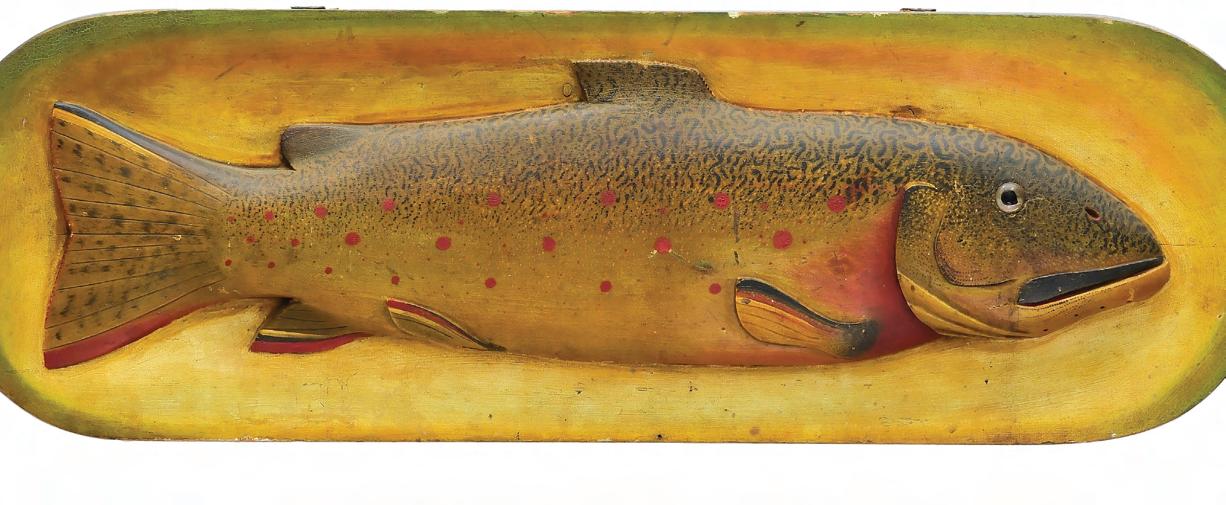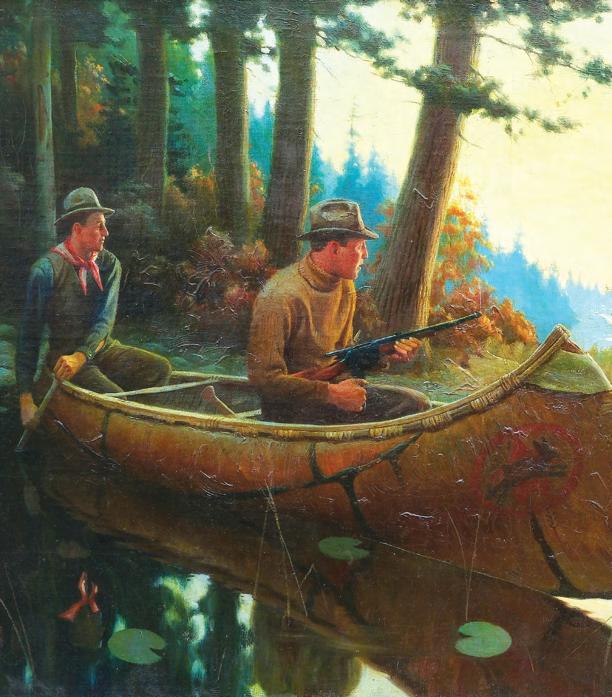
April 25 & 26, 2024
Featuring the collection of Alan and Elaine Haid Guyette
































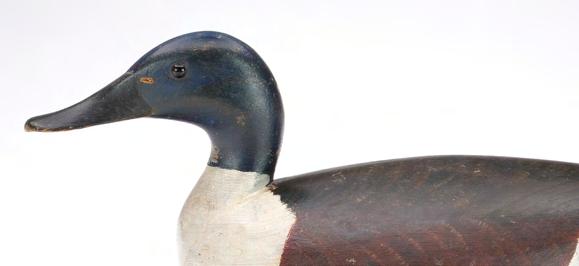











April 25 & 26, 2024
Featuring the collection of Alan and Elaine Haid Guyette










































Held in conjunction with the North American Decoy Collectors Association Show | April 23 - 27, 2024
The live auction will be held at the The Westin Chicago Lombard
70 Yorktown Center Lombard, Illinois 60148
Wednesday, April 24, 2024
Cocktail Reception and Preview
4:00 PM - 6:00 PM
Thursday, April 25, 2024
Preview 8:00 AM - 9:30AM
Auction 10:00 AM
Friday, April 26, 2024
Preview 8:00 AM - 9:30AM
Auction 10:00 AM
For questions during the auction call 410-745-0485
If you are interested in viewing a particular piece at the office, please call to be sure it will be available there at the time you plan to visit. We may also be in your area, and so a private viewing may be available. Please contact us for our schedule.
Catalog $45. Out of Country $70
Absentee, Phone & Online Bidding accepted call 410-745-0485 for arrangements
For free decoy appraisal contact:
Jon Deeter | jdeeter@guyetteanddeeter.com | 440-610-1768
Zac Cote | zcote@guyetteanddeeter.com | 207-321-8091
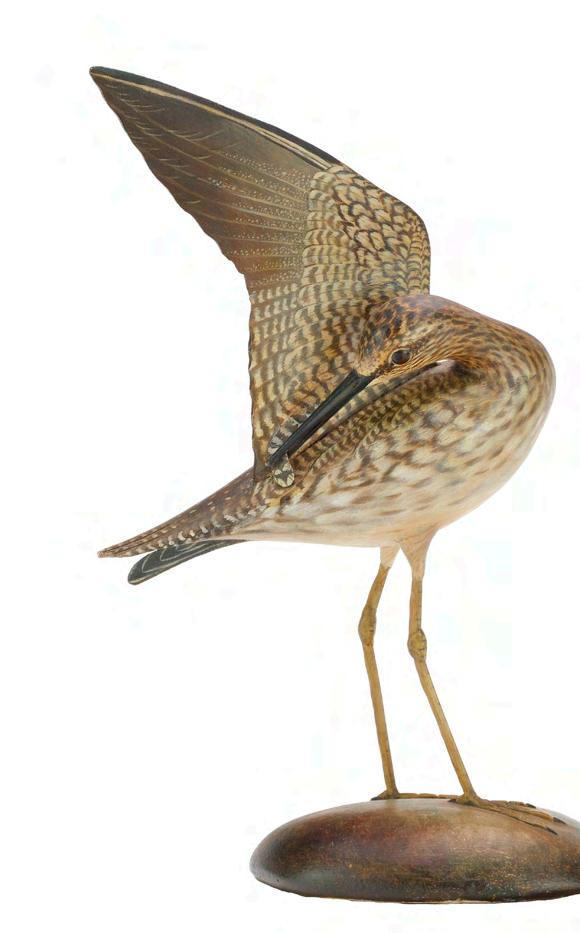
Cooper Rossner | cooper@guyetteanddeeter.com | 609-560-8028


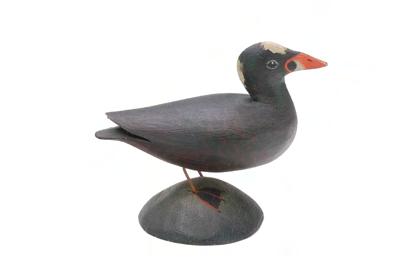
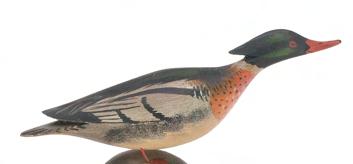

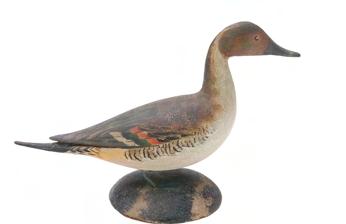
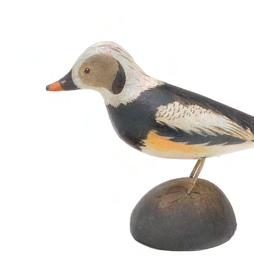


■ GUARANTEE - We have made a concerted effort to accurately catalog and describe the property to be sold. The decoys and paintings have guaranteed condition reports. Should the need arise, the auctioneer reserves the right to make verbal corrections and provide additional information from the block at the time of the sale. Absentee bids will not be executed on items that are found to be other than described in the catalog. Since opinions can differ, particularly in the matter of condition, the auctioneer will be sole judge in the matter of refunds. If we fail to identify a flaw that has an impact on the value, you can return the decoy.
■ DURATION OF GUARANTEE - Requests for a refund on an item purchased through a Guyette and Deeter, Inc. auction must be made within 3 days of the time you take physical possession of your purchases. Whether your items are shipped, delivered, or picked up at the auction site, it is still 3 days from date of possession. This guarantee is null and void if payment is received or mail is postmarked more than 30 days from the sale end date. The guarantee is also null and void if you choose to not take possession of your purchases within the 30 days. If you have paid for your purchases within the 30 days but Guyette and Deeter, Inc is unable to ship your item within the guarantee period, the guarantee will be extended until 3 days from the shipping delivery date. This policy protects our consignors by enabling us to make consignor payments in a timely manner.
■ Under no circumstances will we be responsible for damage to frames or glass, or damage caused by them. Paintings determined to be of high value or large size may be subject to special packaging at the buyers expense. Under no circumstances will we be responsible for damage to fragile decoratives. These items are marked in the catalog with an *.
■ Stands are not included with the decoys or weathervanes unless specified in catalog.
■ All duck calls have condition reports, but are sold “As Is”.
■ Trade Up Program - A limited number of decoys purchased may be paid for by consigning decoys. To participate, please contact our office ahead of time to discuss details.
■ Free appraisals are available with no obligation to consign and any correspondence is strictly confidential.
■ Pick up hours are 1pm – 5pm beginning May 1, or by appointment. Please call ahead so we can have your items ready.
July 26 & 27, 2024
Decoys, Sporting Art & Americana
The Country School Easton, Maryland
September 14, 2024
Fine Sporting Arms
Chesapeake Bay Maritime Museum St. Michaels, Maryland
November 9 & 10, 2024
Decoys, Sporting Art & Americana
In conjunction with the Easton Waterfowl Festival
The Country School Easton, Maryland


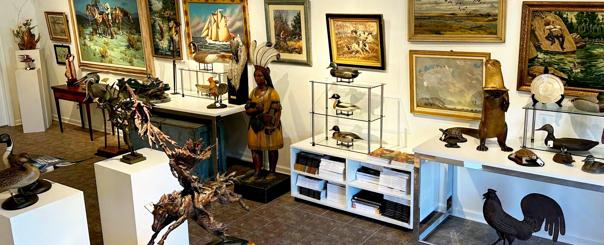

Jon & Leigh Ann Deeter
1210 S Talbot St, Unit A
St. Michaels, Md 21663
Tel: 440-610-1768
jdeeter@guyetteanddeeter.com



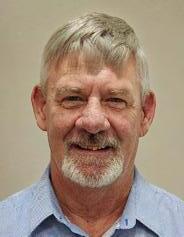

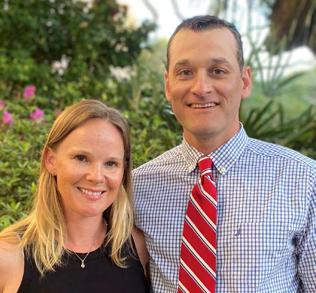
Lacey & Zac Cote
PO Box 347
Freeport, ME 04032
Tel: 207-321-8091
zcote@guyetteanddeeter.com
Mike Stevenson
Graphic Designer
St. Michaels, Maryland
Tel: 410-745-0485
michael@guyetteanddeeter.com

Allison Banks Office Manager
St. Michaels, Maryland
Tel: 410-745-0485
auction@guyetteanddeeter.com

A.J. Smith
Photography
St. Michaels, Maryland
Tel: 410-745-0485
photography@guyetteanddeeter.com

Mike Roberts
Shipping
St. Michaels, Maryland
Tel: 410-745-0485
Noah Christopher
Photography
St. Michaels, Maryland
Tel: 410-745-0485
Ed Kenney
Merchandise Manager & Shipping
St. Michaels, Maryland
Tel: 410-745-0485
shipping@guyetteanddeeter.com
Cooper Rossner
Weekly Auction Manager
St. Michaels, Maryland
Tel: 609-560-8028
cooper@guyetteanddeeter.com
Stormi Lind Office Assistant
St. Michaels, Maryland
Tel: 410-745-0485
billing@guyetteanddeeter.com
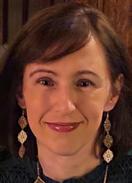

Megan Stroyan Clarke
Finance Manager
St. Michaels, Maryland
Tel: 410-745-0485
billing@guyetteanddeeter.com
Bill Lapointe
Decoy Consultant and Essayist
Swansea, Massachusetts
Tel: 774-644-9426
Weekly Online Auctions Ending Every Thursday Night at 7:00 pm
Guaranteed condition reports, multiple photos, quick shipping and quality items. Bid with confidence.

Guyette & Deeter’s growing and trusted online weekly auction platform continues to be the most active decoy and sporting art market place in the world.
Redhead, Cameron McIntyre. Sold! $17,400 - World record decoy for the maker
Go to bid.guyetteanddeeter.com for all upcoming sales. Including weekly online auctions, premier decoy and sporting art, and fine sporting arms sales.
OUR NEXT SUPER SALE WILL BE JUNE 27TH!
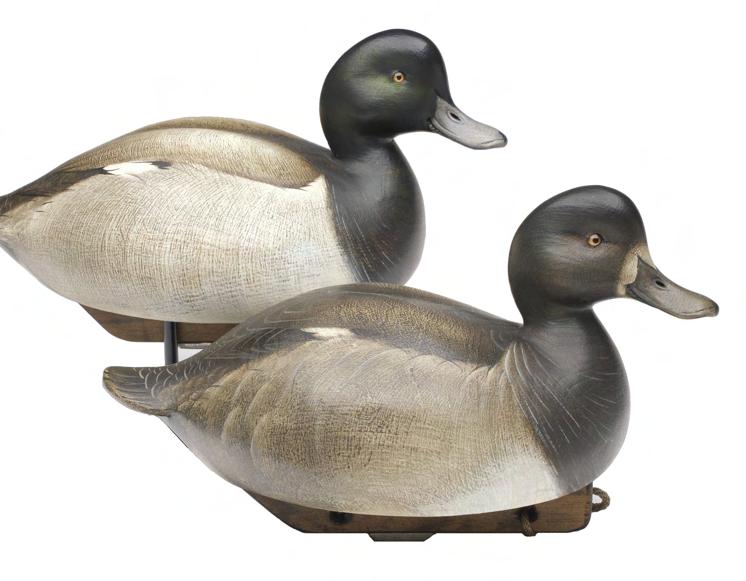
Ruffed grouse, George
$4680 -
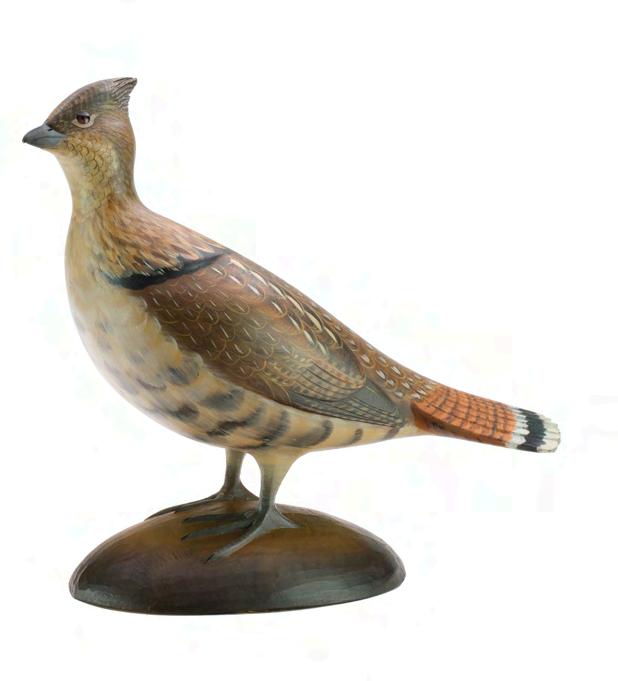
Pair of bluebills, Jim Schmiedlin. SOLD! $8,520
CALL COOPER TO CONSIGN TODAY.
The J. DEALLY fishing reel, No 10. Sold! $8,050
Duck call, Grady Taylor. SOLD! $3,480

Mallard hen, Bert Graves. SOLD! $4,320
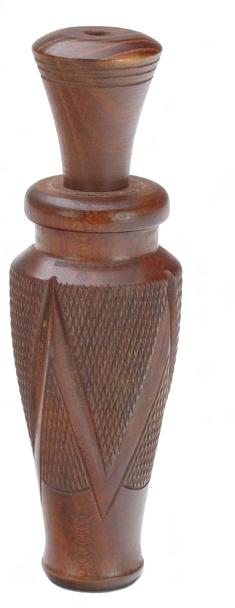
Box turkey calls, Neil Cost. Sold! $3,720

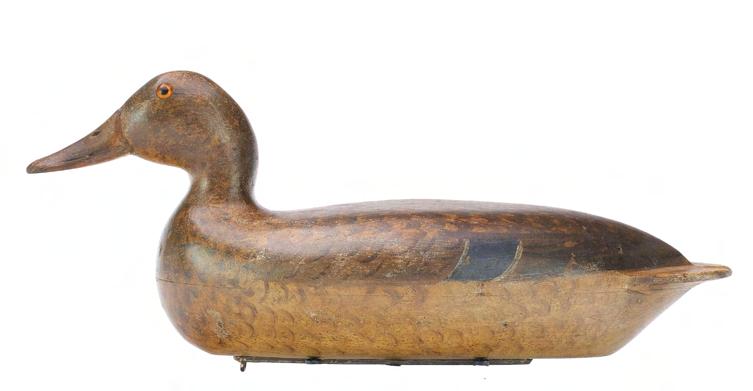
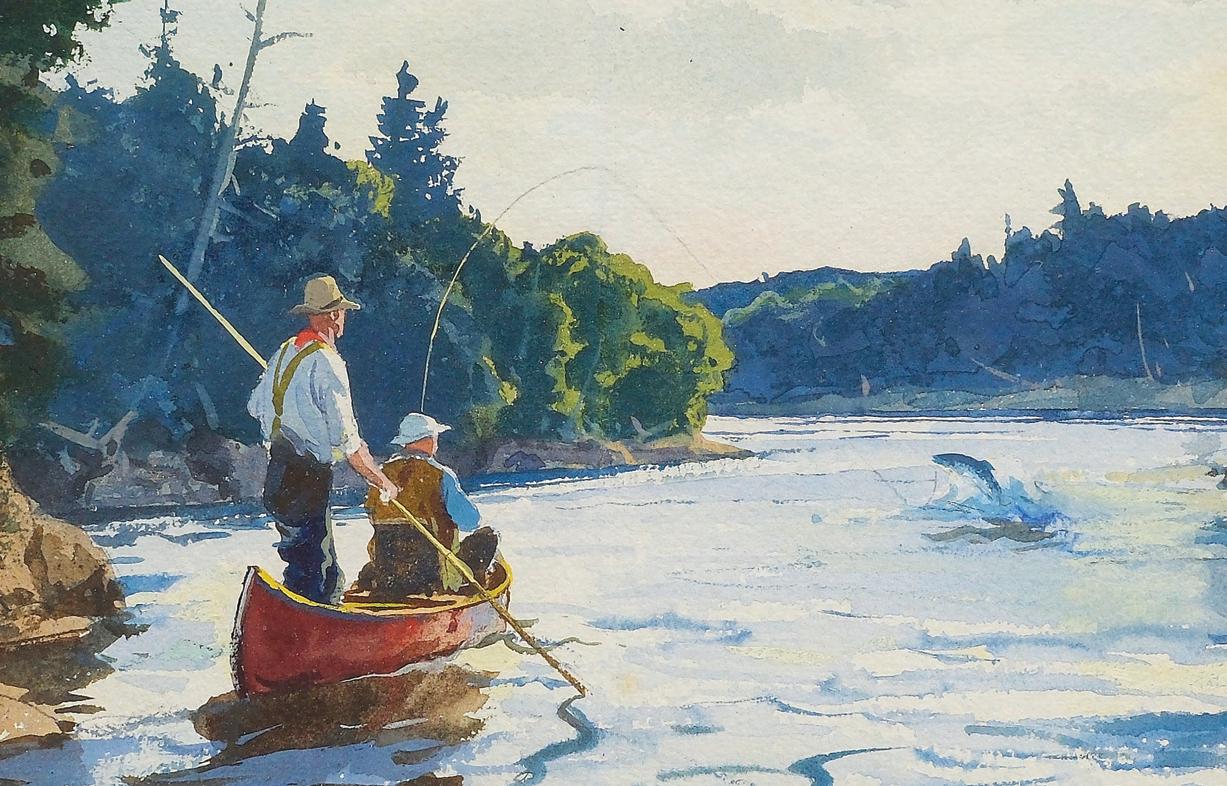

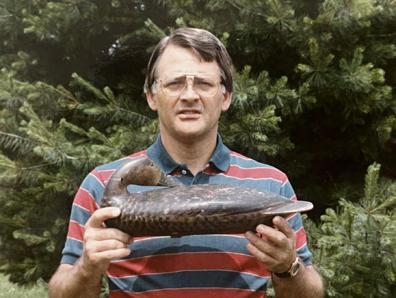


In 1967, Elaine Haid gifted her husband Alan a pair of miniature mallards by William Pratt of Joliet, Illinois. A fairly simple set of carvings by today’s collecting standards, but those miniature mallards sparked in Alan a desire to learn about and assemble a collection of the rarest examples by the most celebrated carvers in North America. This passion would define much of their adult lives and help shape the world of decoy collecting as we know it. Alan often said that “knowledge is power” and as a long-time decoy dealer, appraiser, author, and adviser to many fine collections, there are few collectors today that haven’t been empowered by some of the knowledge Alan accrued and so generously shared over the years.
As an employee of Champion International (now International Paper) for 40 years, Alan traveled extensively throughout the country and during duck season, many of those trips ended up being along the Mississippi flyway. He would often trade or purchase an old wooden decoy from the clubs he hunted and was always intrigued by the differences in construction and design in the decoys from Canada to Louisiana. After years of research and study, Alan undertook the serious scholarly effort of publishing a decoy reference book. Released in 1981, ‘Decoys of the Mississippi Flyway’ became an invaluable source for collectors of decoys from this part of the country.
Alan’s longtime friend and partner Russ Goldberger explains that “Alan and I met when we both lived in metropolitan Cincinnati 40 plus years ago. About that time, I spied an ad that Alan had run in a decoy publication, looking for good original paint decoys. Having recently purchased a Mason Premier mallard, of which I was particularly proud, I responded to the ad, and

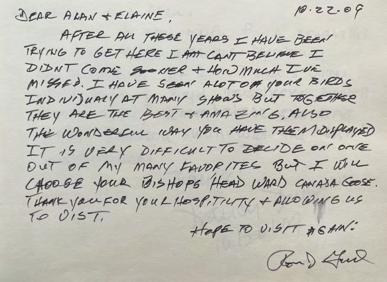
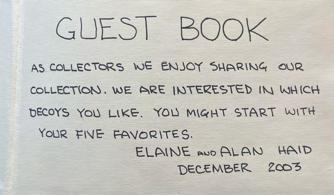




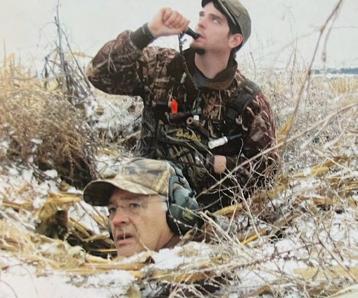
Alan suggested I bring it by his house. He took one look and let me down easy - it was an old repaint! Although I felt disappointed, that chance meeting began a long friendship.” In 1993, the two would jointly author ‘Mason Decoys a Complete Pictorial Guide’, followed by the ‘Expanded Updated’ edition in 2014.
Donna Tonelli, respected author of decoy and collectibles reference books, celebrated her and her husband’s half-century-long friendship with the Haids, which grew from their common love of hunting and decoys: “My husband Joe first met Alan Haid at the Midwest Decoy Collectors Show in Aurora, Illinois in 1971 and sold him a Bert Graves canvasback. Not long afterward, Alan arranged a trip to our home in Spring Valley with two of his friends, Tom Winstel and Bob Dyer; they were known as The Cincinnati Kids.” This first visit led to regular excursions into the field, in pursuit of quality decoys and their live counterparts. Both avid waterfowl hunters, supporters of waterfowl habitat conservation, and tireless decoy lovers, Alan and Joe would help one another source choice examples from around the country. Joe estimates that he sold no less than 500 decoys to Alan over the decades.
For nearly half a century, Alan and Elaine were fixtures at decoy shows and auctions across the country. Though Elaine battled long-term health issues, her boundless generosity and kind heart enriched the collecting community with warmth and grace. A wide smile and genuine interest in the wellbeing of one’s children and family could always be found at the Haid’s booth. Always the fierce competitor, Alan reveled in entering their decoys in vintage decoy competitions and brought home countless blue ribbon wins in various categories from the shows.
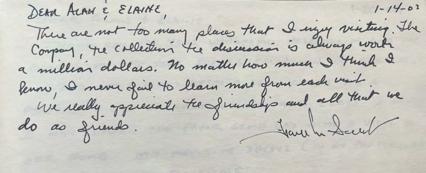




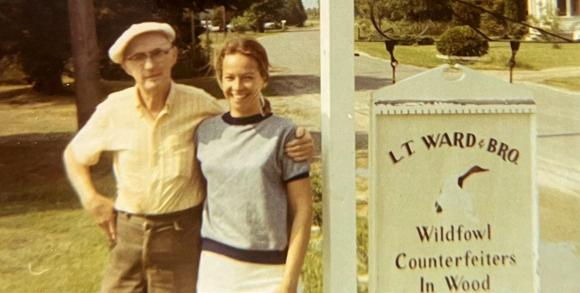
In the ongoing effort to not only grow their collection but to also improve the examples in their holdings, the Haids would often sell 4 or 5 more common or lesser condition decoys to acquire one, rarer and more desirable example. In 2006, the opportunity to acquire one of the finest carvings ever created by Elmer Crowell presented itself, and the Haid’s sold 36 important decoys to purchase it. At that time Alan explained that “it was a collectors dream to have an opportunity to collect a premier piece by the most famous maker, that’s what we live for.”
The Haids gladly opened their home in Darien, Connecticut to welcome new and seasoned collectors alike. These visits usually involved a pleasant lunch, study of the decoys, and stories or lessons given on one’s favorites. The pursuit of knowledge and passion for sharing that knowledge to further the art form was Alan’s greatest contribution to the collecting community and the Haids should rightfully be remembered as some of decoy collecting’s greatest champions.
Guyette and Deeter is honored to have been entrusted with the responsibility of disbursing the Haid collection to the next generation of passionate collectors. We have taken this important duty very seriously and have attempted to put as much thought, planning, and hard work into the divestment as Alan and Elaine put into the creation of this fabulous collection. We believe the Haids would get great enjoyment knowing that their cherished birds were going to be studied, pursued, enjoyed, and shared for generations to come.
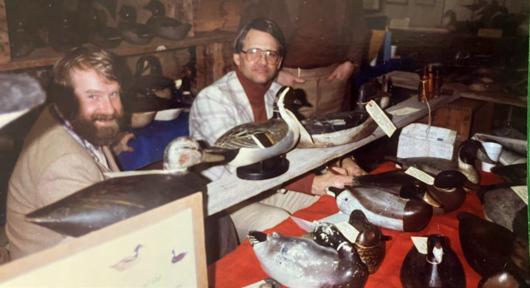
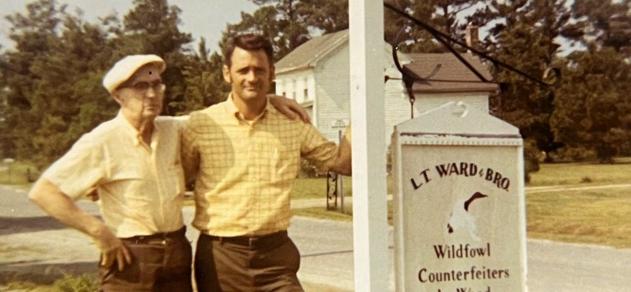

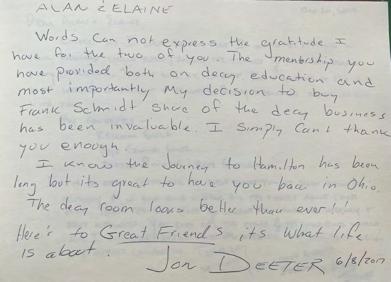
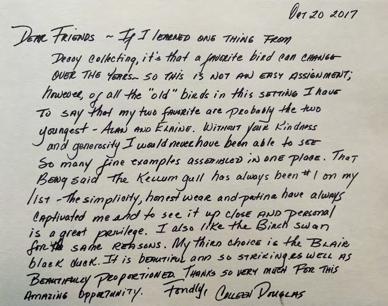
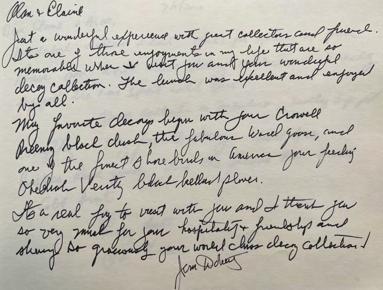
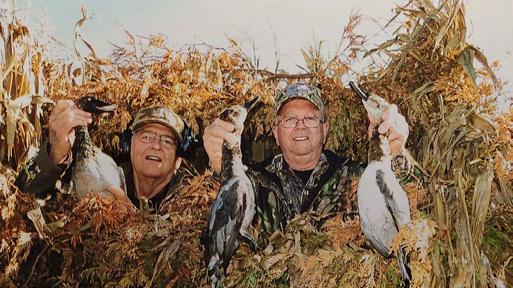
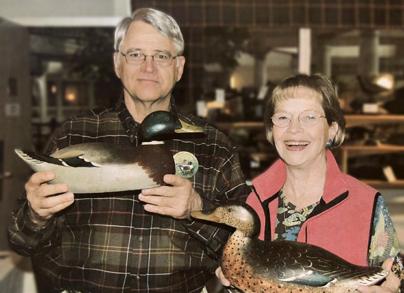

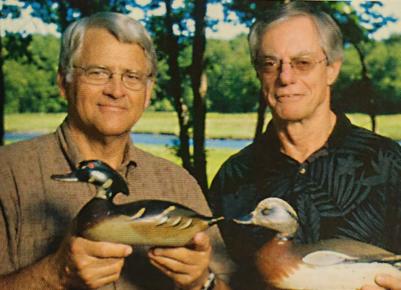



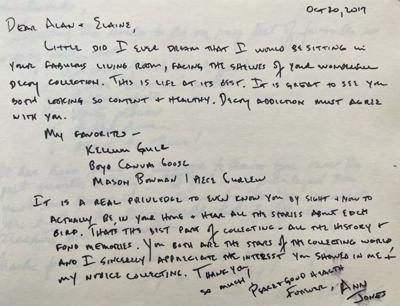

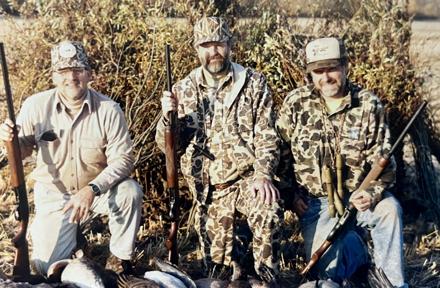
The items from the collection of Alan and Elaine Haid have been marked with the Haid collection ink stamp, a design inspired by their logo of the last 40+ years.

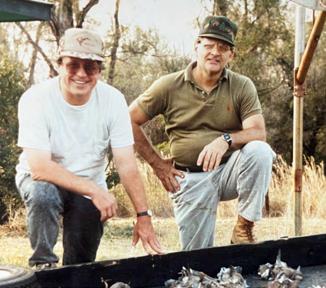
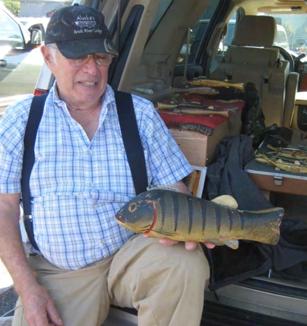
 Dave Fannon’s collection of Oscar Peterson objects are the result of a three-decade pursuit to seek the finest plaques, vases, and fish decoys. Many of the pieces being offered from his collection represent the finest of their category and have never been offered at public auction.
Dave Fannon’s collection of Oscar Peterson objects are the result of a three-decade pursuit to seek the finest plaques, vases, and fish decoys. Many of the pieces being offered from his collection represent the finest of their category and have never been offered at public auction.
I first met Jim at a gun club, 1985-1986. We were put together on a sporting clays shoot. We hit it off immediately (both enjoy shooting SXS’s) and shot together once or twice almost every weekend for two years.
One day after shooting a friend of Jim’s asked if he had found any new decoys lately. I said “Jim, you collect decoys”? “Yes, have for years”. I replied, ”I’m just starting”. The seasoned collector, without hesitation, invited the new collector to see his birds.
When Mari and I showed up we were greeted by Jim and Patti and ushered in to see their collection. Jim explained he used to collect Mason’s, got tired of them, sold them off and was now focused on Ben Schmidt. It was the first major collection I had seen and was blown away.
Over the many years to follow, I watched Jim pursue and purchase some of the finest Schmidt’s that exist. He was relentless. If he wanted it, especially at auction, he bought it.
My collection eventually went towards Ben as well. There were only a few of us that truly understood what a great Schmidt was, and we fought each other for everyone we could get while always supportive of the winner.
Jim wanted the best, and he got a lot of them!
Obviously, we had become great friends, spending time together not only at shows but at each other’s homes as well. Mari and I cherish the many summer weekends spent at their home in northern Michigan. It was a special place. Filled with special Schmidt’s and many other great carvings as well.
Jim was a gentleman in all respects. One summer evening sitting on his porch overlooking Lake Michigan and enjoying an “adult beverage”, he asked me to do him a favor. He had a friend that lived down state near me, had some decoys and wanted them appraised to buy a new shot gun. “No problem, Jim, what does he have that you want”?

When I arrived, I found about 60 decoys. Nothing special…..except one bird. A Schmidt Hooded Merganser drake. I bought them all.
Jim and Patti came to our home a couple months later for a decoy party. I was out getting ice when they arrived. Jim gave Mari a hug hello and said, “where is it”? As he stood looking at it on the shelf he blurted out “I F*****d up”! (I dropped the ball on that one!)?
There were never any hard feelings between us, I had done what he asked. But I knew he wanted that bird more than any other he had.
A deal was struck between us. He would pay for a decoy I wanted at auction, no matter the cost. In return I would give him the merganser with the provision I would get it back at a time of his choosing for the same amount as the decoy he paid for.
17 years later, he kept his word, and it is now back in my collection.
Jim collected some of the finest Schmidt and Michigan decoys ever assembled. He was educated, had a great eye, and wasn’t afraid to go after them.

I’m fortunate to have him as a friend all these years.
- Kenneth D. Cole
The Illinois River begins at the confluence of the Des Plaines and Kankakee Rivers just west of Chicago. From this point of origin, it embarks on a 273-mile trip southward, meandering diagonally across the State to ultimately join the Mississippi. Approximately one third of the way through its journey, the stream takes a hard turn south in the area of Princeton, an area known as the “Great” or “Big Bend”. This is the area where researchers have determined that three major waterfowl flyways join. In 1943, near Hennepin, biologist Frank Bellrose counted 1.2 million mallards and black ducks on Goose Pond alone. These great flights had been occurring since prehistory and, certainly, had not gone unnoticed by the region’s inhabitants.
Initially, this bounty was harvested by the native population, then by market gunners and, beginning shortly after the Civil War, sport hunters began to visit the region. These were affluent individuals from the Chicago area and beyond. At first, accommodations were probably quite rustic but soon hotels were built that offered room, board, and guides for the visiting gunners. By the late 1800’s, established clubs were organized and large tracts of land and water came under private control. Comfortable club houses were built, lands were managed, and guides and caretakers hired. The three oldest clubs in the State are all located in the area of the “Great Bend”. In 1883, Chicago hunters secured land and formed the Chicago Gun Club, the forerunner to the Swan Lake Gun Club. In1886, the Hennepin Shooting Club was established, and it is in operation today as the Senachwine Gun Club and, in 1887, the elite and very selective Princeton Game and Fish Club was formed .
In the beginning, the wooden decoys that were used in the area were widely supplemented with live birds and extensive baiting. When laws were finally enacted that eliminated these practices, better and better carved and painted decoys were needed to attract the ducks. A carving tradition had existed for some time along this stretch of the river as evidenced by the work of such early carvers as Charles Ruggles (1830 – 1897), Stephen Lane (1842- 1900) and others. These men had set the stage for a regional carving style well suited to the local conditions. Nicely executed two- and threepiece, hollow bodies topped with accurately rendered heads and meticulously painted plumage became the standard. With the rise in the number of duck hunting

clubs by the late 1800’s, the need for decoys rose accordingly and the club members demanded only the best. In response to this mandate, individuals along a roughly 50 mile stretch of the river in the area of the “Great Bend” began to produce high quality birds as a commercial venture. Four of the greatest of these were Robert Elliston, Bert Graves, Charles Walker and Charles Perdew. Their work became the hallmark of the “Illinois River Style” and set the basis against which all other of the region’s carvings would be judged. Others from the same area produced some outstanding decoys but just not in the same numbers as the three previously mentioned men. Charles Schoenheider Sr carved at least one rig for sale (which ironically was refused), but it is for his exceptional standing “ice ducks” that he has earned his place in the Illinois decoy carving hierarchy.
Every carving region has its celebrated carvers. Virginia has its Cobb’s, Maryland its Ward’s, New Jersey its Shourds, New England its Crowell’s and Wilson’s and Long Island its Verity’s. The Haid Collection represents some of the most iconic work from the Illinois River. These carvers represent the pinnacle of the region’s decoy excellence.

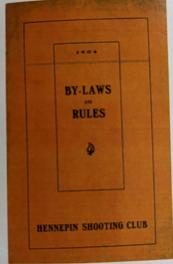

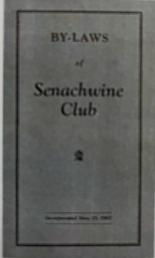
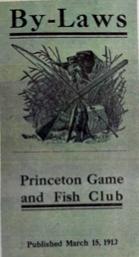
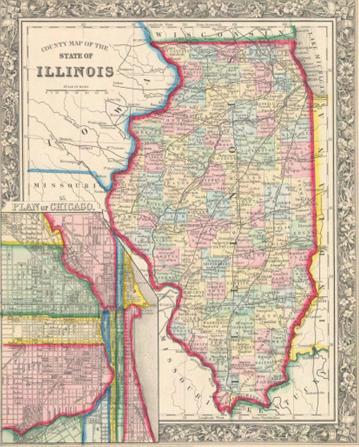
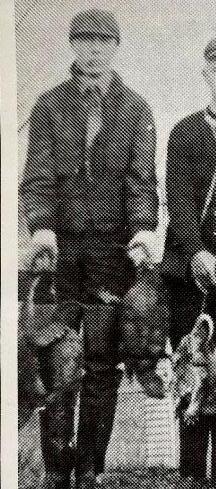
When attempting to rate the very best of the Illinois River’s finest carvers, Charles Walker must certainly rank near the top of the list. A lifelong resident of Princeton, Charles, armed with an 8th grade education, would earn a living by working at a variety of manual occupations throughout his life. While still single and living with his parents, blacksmith father, Charles, and mother Emma, he worked as a hostler in a livery stable. In 1900 he married Marie Anna Brems and the couple quickly had four children, Harold, George, Eunice and Forrest. With rising financial demands, he left the stable and worked the rest of his life describing himself as, variously, a “painter, “paper hanger”, “gardener”, “carpenter”, and “interior decorator”.
Throughout his life, his avocation was the outdoors. Plying the woods and waters around Princeton, Goose Pond and Lake Senachwine, he quickly developed a reputation as an outstanding hunter and fisherman. In 1902, he managed to procure membership in the local and selective Princeton Game and Fish Club with share #32. When the club needed to raise funds in 1910, it charged each member an assessment of $100 (equivalent to over $3200 today) which was too much of a financial burden on Charles and his young family and he was forced to relinquish his membership. He maintained an association with the club, however, which
ultimately proved to be very fruitful. He continued to hunt there as a guest and many of its members, recognizing the exceptional quality of his decoys, placed orders with him over the next 38 years (his last rig being carved for Cliford C Jolley in 1948).
He did not hesitate to capitalize on the wealth of the Princeton membership. He was charging about $100 a dozen for his decoys, when his contemporary in nearby Henry, Charles Perdew, was charging only $36. He did all his carving in a garage at his home which, for most of his last 20 years or so, was at 224 South Pleasant St, very much near the geographic center of Princeton and only a block or two off of Main St.
Of all the major Illinois River carvers, Walker made relatively few decoys, with his total lifetime production being estimated at no more than 300 birds. As noted, most of these were destined for members of the Princeton club where, if damaged, they were simply piled on the dock where the caretaker would gather them up at the end of the season and, rather unceremoniously, dispose of them. Others were repainted over the years and, surely, still others were simply lost to the ravages of time. As noted in the Peoria River Museum’s publication, “American Decoy – The Invention”, “Walker carved some of the most artistic and natural -appearing decoys ever used in the Mississippi flyway”

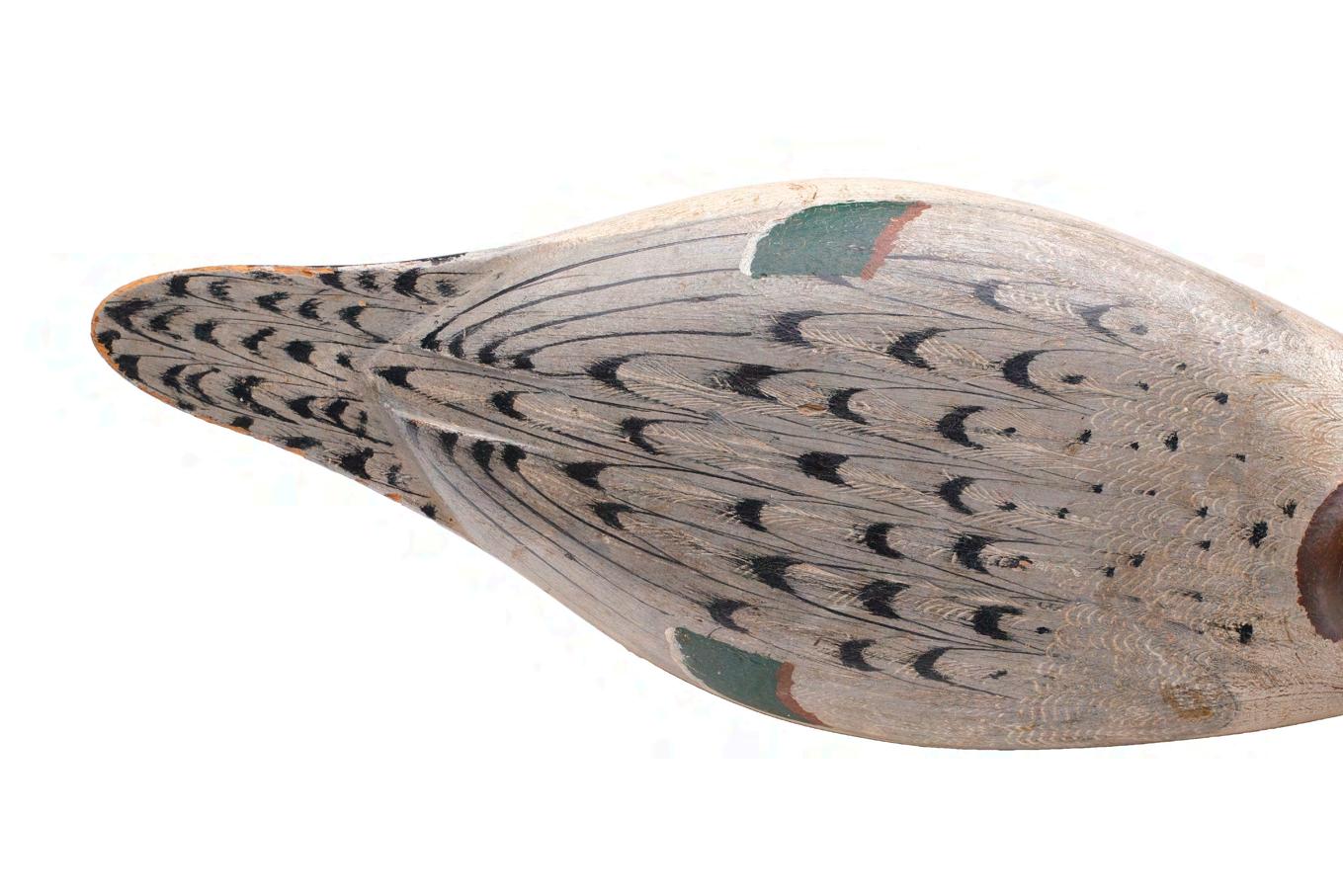




Dust jacket photo from “Decoys of the Mississippi Flyway,” with the author holding this Walker pintail.

Provenance:
Merle Brown rig.
Ted Vance rig.
1 Charles Walker (1873-1954), Princeton, Illinois. Hollow carved pintail drake with raised neck seat and alert head pose. Comb feather paint detail and ‘28’ on the underside for share number 28 at the Princeton Game and Fish Club, which belonged to Merle Brown. Charles Walker made only two pintails and a dozen mallards for the Brown rig. Merle Brown’s membership and decoys were eventually sold to Ted Vance. In the 1960’s early decoy collector Joe French purchased the two pintails and Joe Tonelli bought the dozen mallards. French eventually sold one pintail to Dr. James McCleery and this one to George Thompson. Measures 18.75” long. Original paint with minor wear; early repair to a crack in the neck; minor roughness on edge of tail.
Joe French collection.
George Thompson collection.
Alan and Elaine Haid collection.
Literature:
“Decoys of the Mississippi Flyway”, by Alan G. Haid, page 83 and front cover, exact decoy pictured.
“Fish and Fowl Decoys of the Great Lakes”, by Donna Tonelli, page 181, exact decoy pictured.
“Decoys: North America’s One Hundred Greatest”, by Loy S. Harrell Jr., page 60-61, exact decoy pictured.
(50,000 - 80,000)

July 28, 1955
Some of the earliest research pertaining to Robert Elliston was conducted by respected pioneering collector Joe French. In 1955 he contacted Mrs. Josephine Forbes, one of Elliston’s daughters and inquired about her father and his decoys. Her response provided the basis for much of what we know today.
“Dear Mr. French:”
“In answer to your letter of July 2, I will be happy to give you what information I can concerning my father, Robert A. Elliston and the events that influenced his going into the decoy business.
He was born July 2, 1849, and died December 29,1915. He was born in Kentucky but grew to manhood near Indianapolis, which was an immense forest in those days.
When he was eighteen he started to work at the Studebaker shops of South Bend, Indiana where he was employed for a number of years as a buggy and carriage body-maker. Having mastered the best of the work there, he had a desire to do finer work, and entered the factory of Henry Olds. From there he went to New York City, Philadelphia, and finally to the McLaren Hearse and Coach Manufacturing Company of St. Louis. Always having the desire to reach the top of his chosen trade, he became every skillful and retained a coveted position as Hearse designer for the above-mentioned firm.
He decided to leave the city and moved to Lacon, Illinois, where he worked in the Brereton Buggy Shop. Here, he married Catherine Cumminskey of St. Louis on December 10, 1878, who was to later play an important role in his business. To this union, eight children were born, five of whom are still living.
About 1888 they moved to Lake Senachwine, a few miles to the north of the Illinois River. Here Mr. Elliston conceived the idea of manufacturing decoys for many sportsmen congregated here during the hunting season – both spring and fall – as this was an ideal place for duck shooting. It was here he made his first decoys, and later the Elliston Decoy became famous among sportsmen.
During the autumn of 1889, he moved 1 ½ mile south of Bureau, Illinois, a location that proved ideal for an apiary and his work with bees. He carried on this work in conjunction with the making of decoys for the remainder of his life.
From the beginning, his wife, Catherine Elliston, did all the painting of the decoys, having perfected this by studying the coloring of live ducks. She became such an artist at this work that sportsmen solicited her work for years after her husband’s death.
As you see, Mr. French, I have written at length about my father. We are very proud of his achievements, and it makes us happy to know that his work is still remembered and that we still receive inquiries regarding “The Elliston Decoy”.
Very Truly Yours, (Mrs.) Joseph Elliston Forbes”

This early correspondence was certainly insightful in its day, but the passage of time and additional inquiry have pointed out some (presumably unintentional) inaccuracies and omissions.
A more recent interview with another Elliston daughter by Joe and Donna Tonelli, as well as research by others, indicated that Elliston was born in 1847, not 49. His first wife was Margaret Cumminskey, Catherine’s older sister. They married in 1875 and had one son but Margaret died in 1876 and Robert married Catherine in 1878, not 79. Mrs. Forbes stated that he made his first decoy in 1888 while, an 1882 article in “The Henry Republican”, when discussing the opening of the Undercliff Hotel on Lake Senachwine stated that “R.A. Elliston, a decoy maker of some fame” was in attendance.
The Tonelli’s have also revealed that Elliston, in addition to decoys, was an accomplished boat builder in Henry, Illinois. The decoy operation (see note 1), although very successful, provided only a portion of Elliston’s income. He and Catherine had a sizable plum orchard at their home in Leppertown and their bees were kept in a
large colony of hives at the orchard. He would harvest the fruit from the trees and gather the honey and wax from the hives and ship these valuable commodities to market. When the bees and trees went into dormancy or hibernation, Elliston would focus on his decoy production. At one point, Elliston lamented to a neighbor that he “didn’t want his children to be stuck on a farm like him”.
The letter to French concludes by noting that after Elliston’s death, Catherine was called upon to paint decoys for (local) sportsman. This may be true but, in reality, “Bert” Graves purchased Elliston’s remaining stock upon his passing and Catherine continued to paint decoys for him as well as teach his sister how to paint.
The passage of time and the lack of written family documentation can cloud memories and, sometimes, families have their “secrets” that they try to preserve (perhaps Robert’s first marriage to Margaret). Eventually the true story emerges and, ultimately, that is what matters.
What really matters, and is not in dispute, is that Robert Elliston can rest with the satisfaction of achieving the title of the “Father of the Illinois River Decoy Carving School”. His work strongly influenced those that followed, among them Bert Graves and Charles Perdew, and a host of others.
Notes: 1. He had a “factory in Henry, formally at Putnam”. He then made and sold his decoys at his home in Leppertown and, in 1909, his birds were offered in the Bullard & Gromley catalog in Chicago for $12 per dozen.

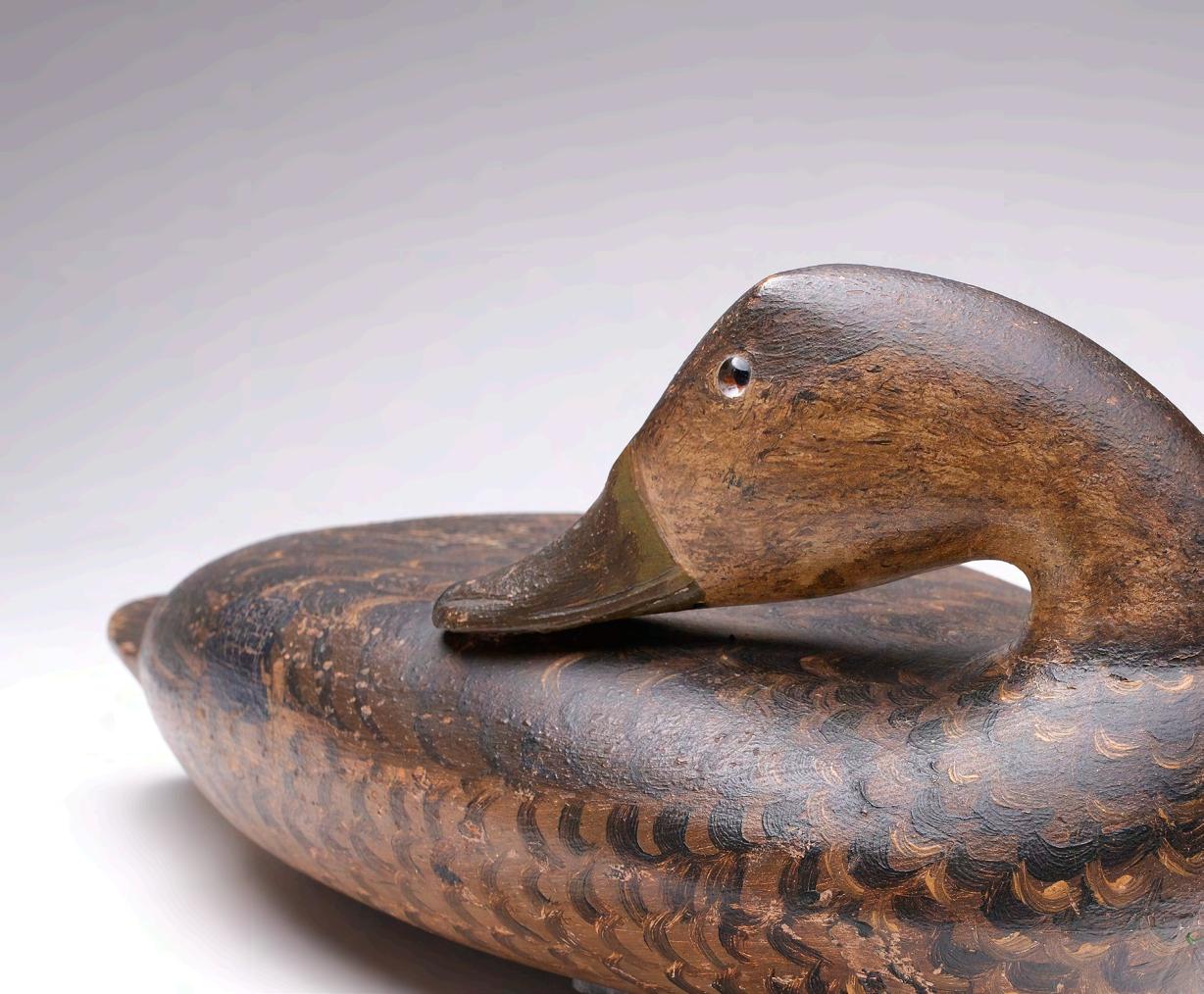
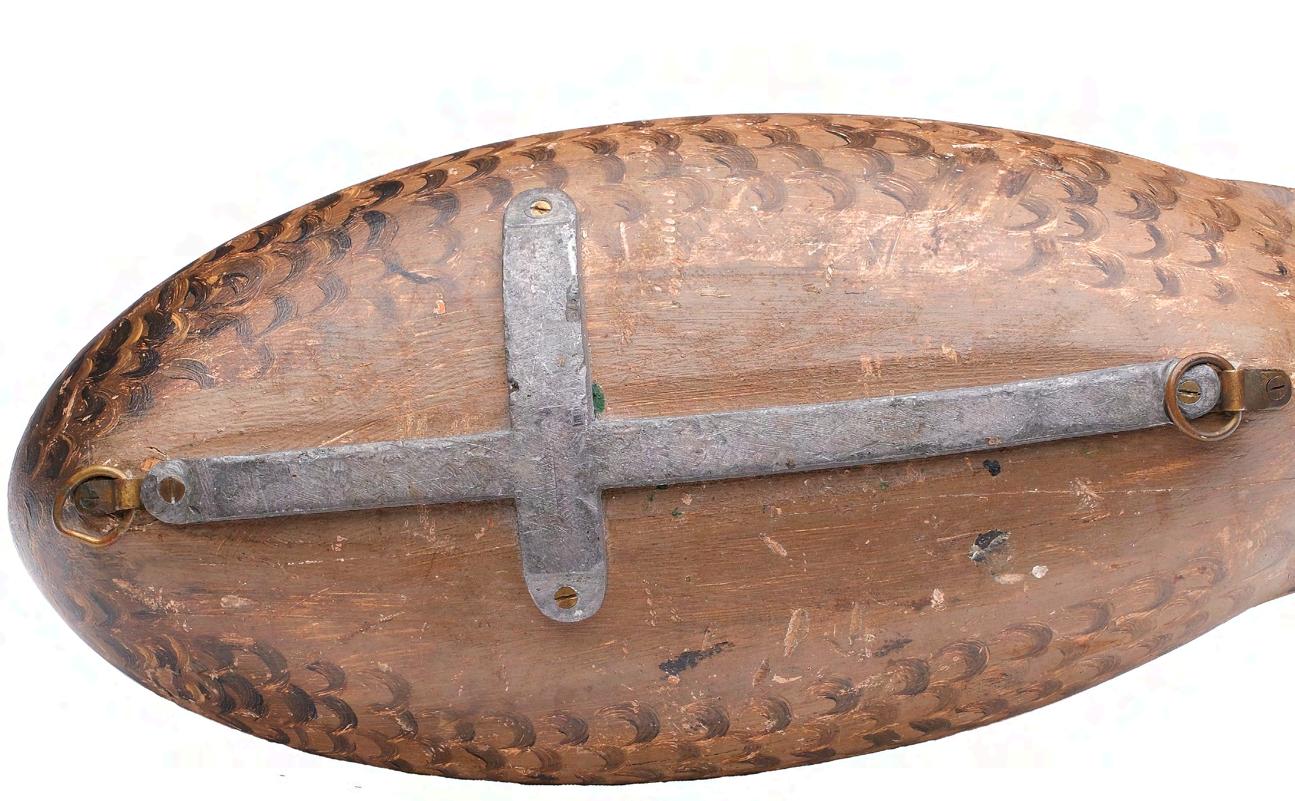
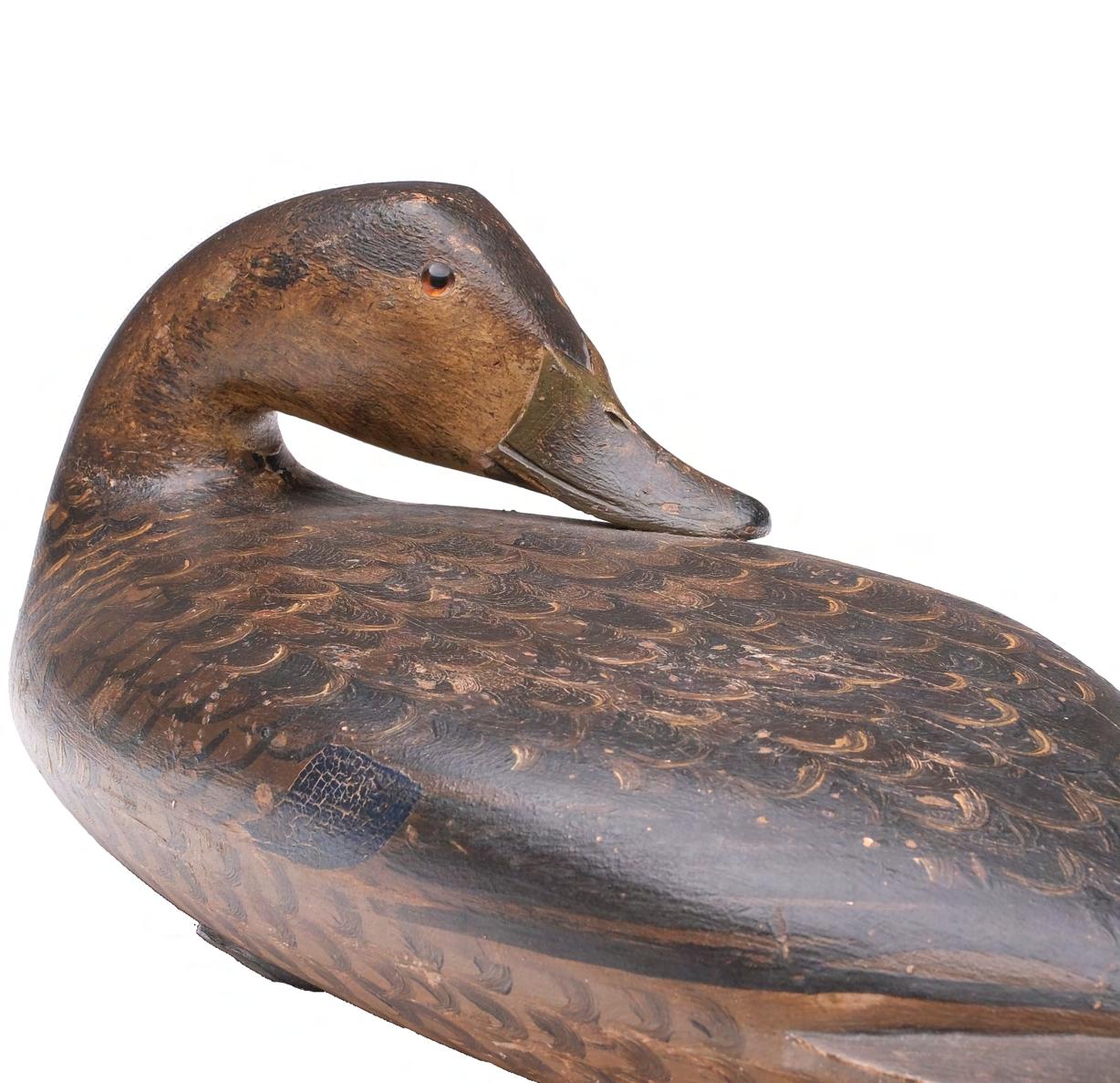
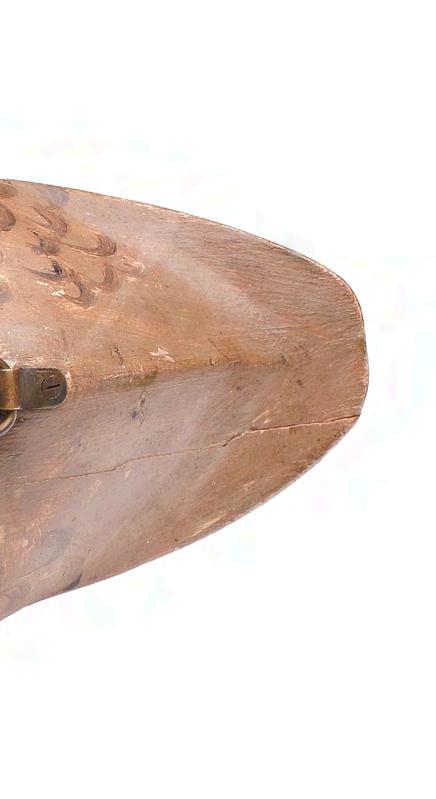
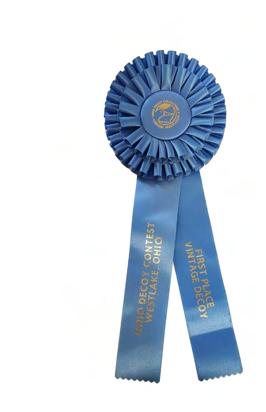

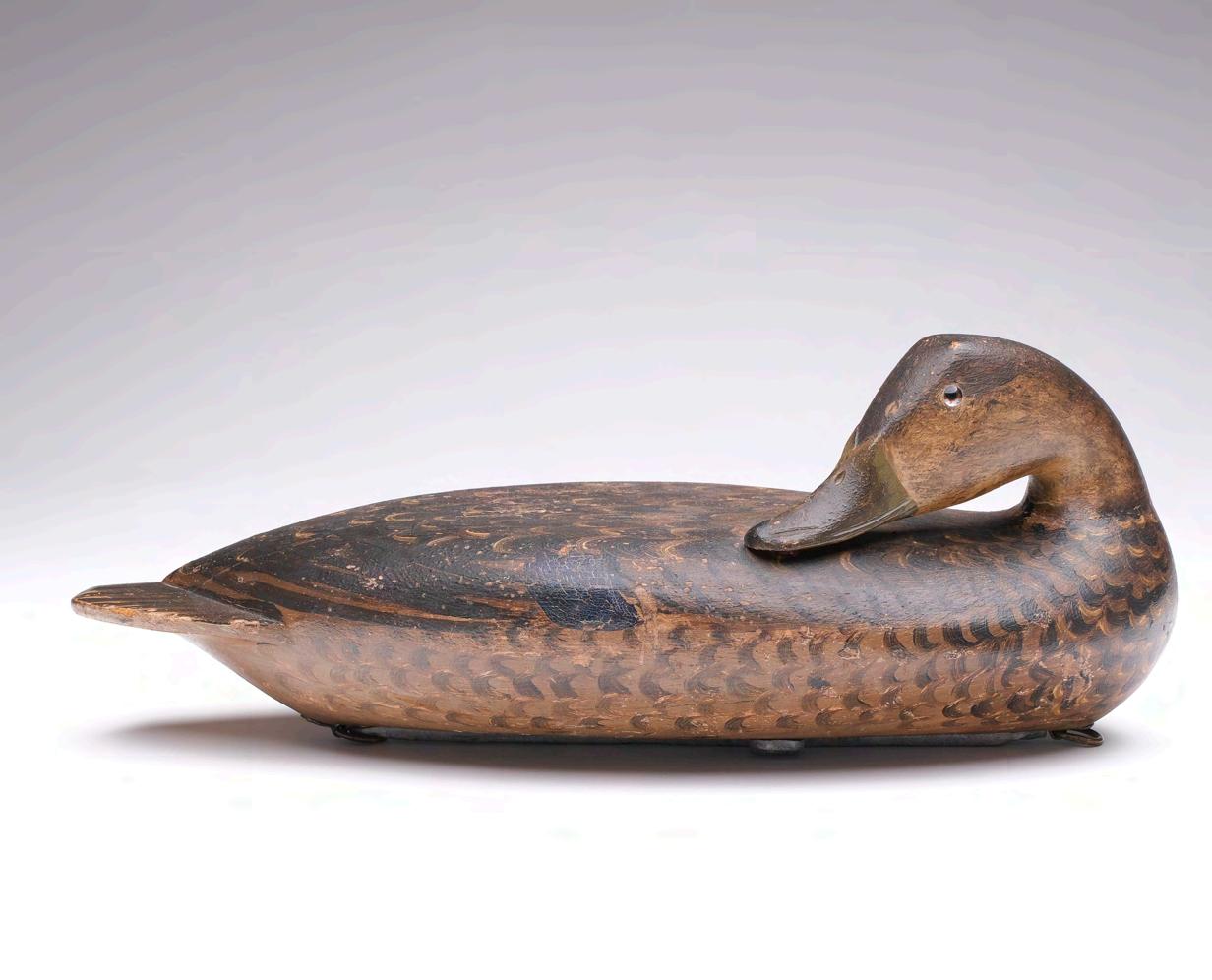

2 Robert Elliston (1847-1925), Bureau, Illinois.
Important and unique oversize black duck, circa 1880. Hollow carved in preening pose. Thick feather paint detail on back. Metal weight on underside to counter balance the turned head. Measures 17.25” long. Original paint with minor to moderate gunning wear; some flaking on back; hairline crack along the back and tail that runs along the underside as well.
Provenance:
Found by an antique collector at a New England flea market in the spring of 1984. Sold in the first ever Julia and Guyette auction that same year.
Alan and Elaine Haid collection.
Literature:
“Top of the Line Hunting Collectibles”, by Donna Tonelli, page 146, exact decoy pictured.
“Decoys: North America’s One Hundred
Greatest”, by Loy S. Harrell Jr., page 129, exact decoy pictured.
“Fish and Fowl Decoys of the Great Lakes”, by Donna Tonelli, page 113, exact decoy pictured.
”Perdew: an Illinois River Tradition”, by Ann Tandy Lacy, page 123, exact decoy pictured. (80,000 - 120,000)

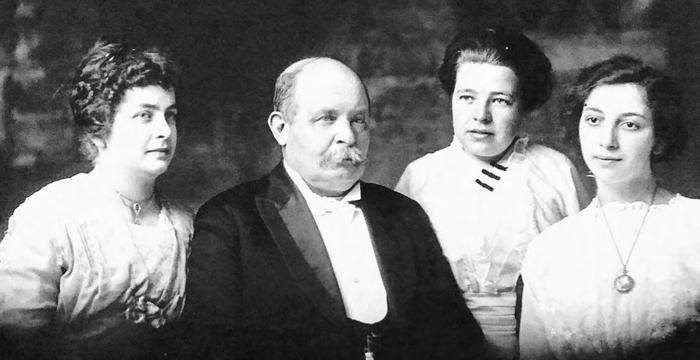

Robert and his three daughters.
3 Robert Elliston (1847-1925), Bureau, Illinois.
Exceedingly rare coot. One of only two known. Hollow carved with fine comb feather paint detail on back. Measures 9.5” long. Original paint with very minor wear; moderate flaking on back and underside; hairline crack through neck; 2” area of inpainting on back; some touch up to flaking at base of neck; 1/2 the bill is a professional replacement.
Provenance:
Ed DeNavarre collection.
Alan and Elaine Haid collection.
Literature:
“Decoys of the Mississippi Flyway”, by Alan G. Haid, page 78 and front cover, exact decoy pictured. (30,000 - 40,000)
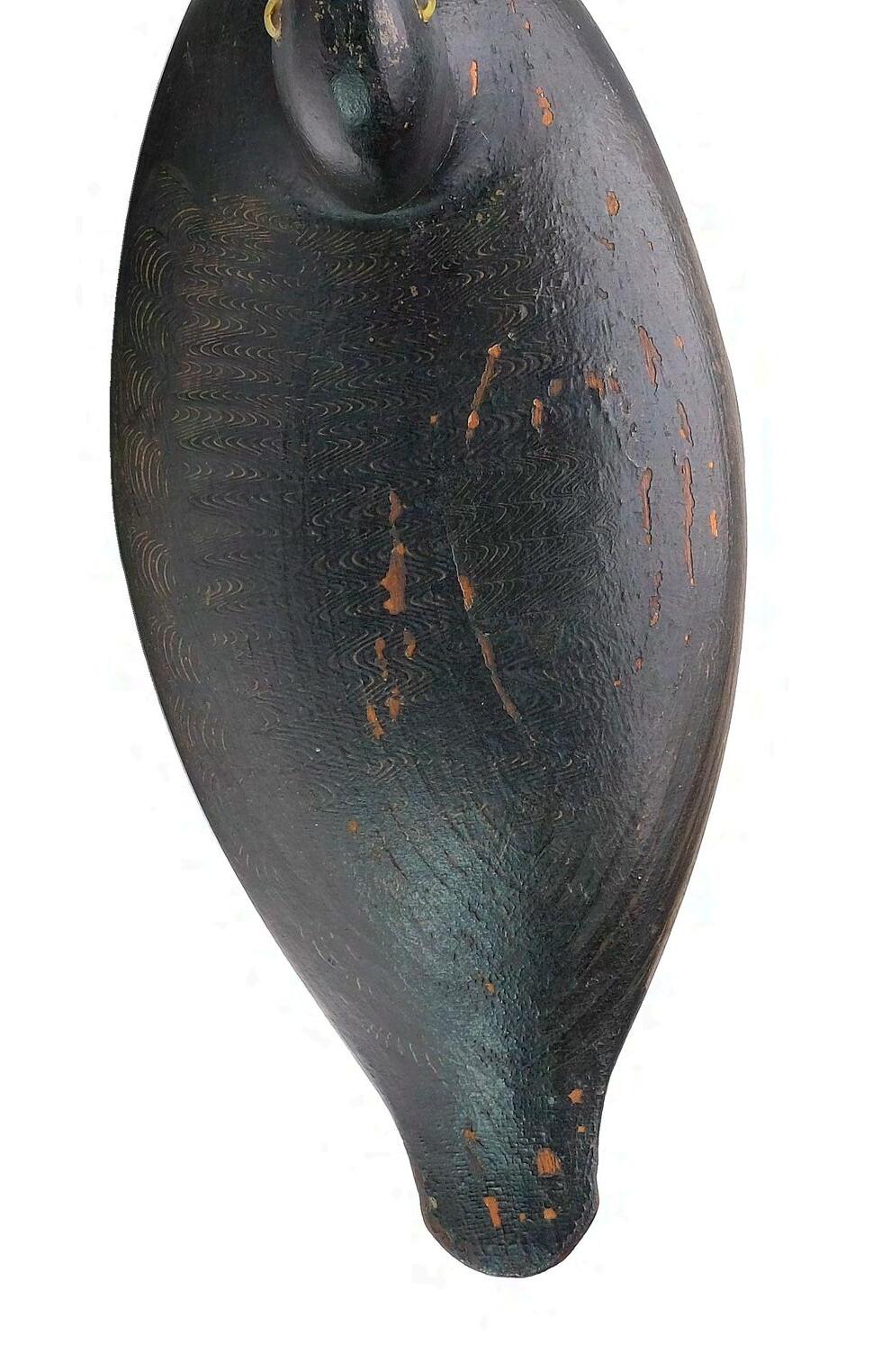
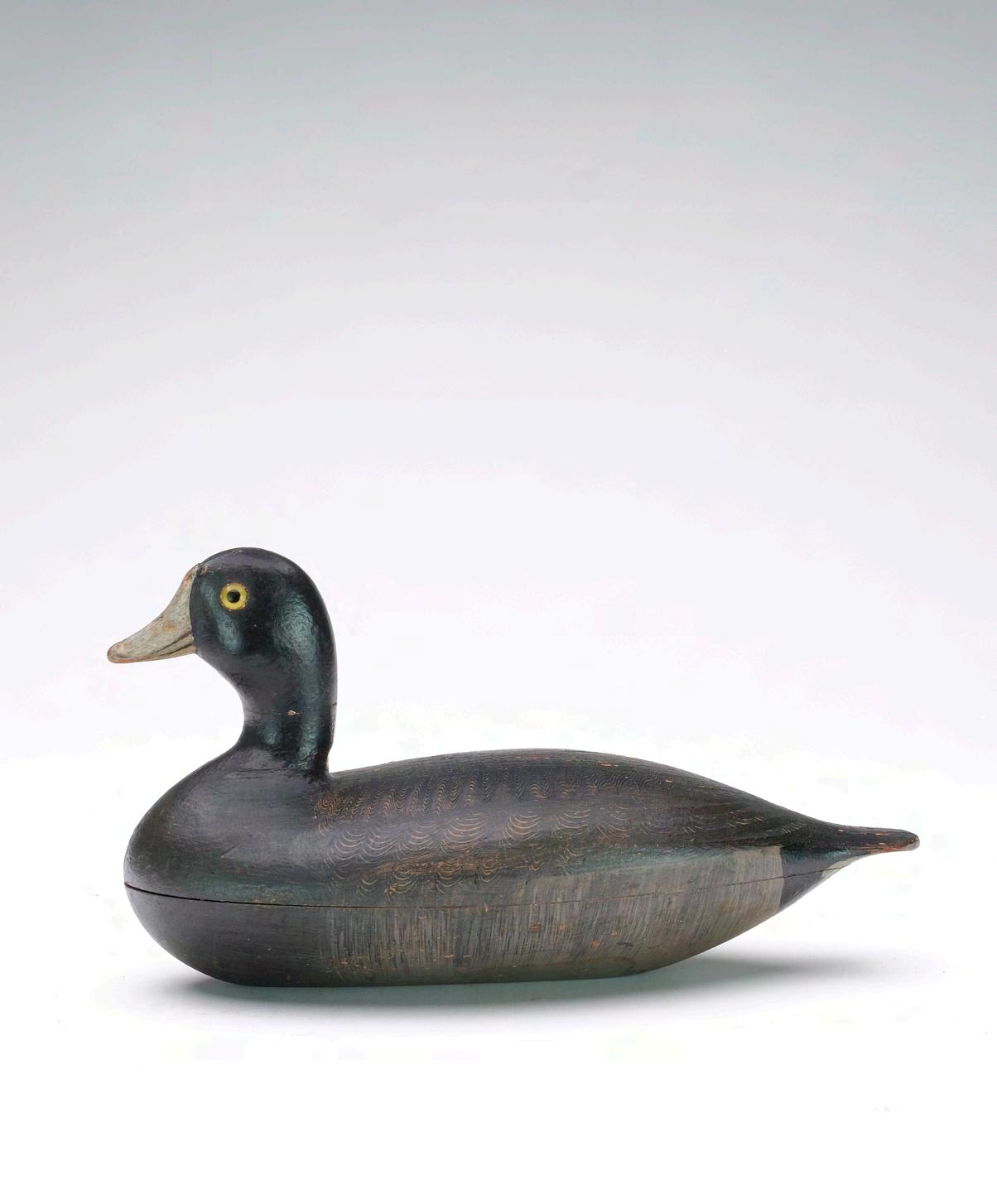

While residents of Chicago, the Dupee family owned a second home in Oconomowoc, Wisconsin. William H. Dupee and his father were both founding members and frequent shooters of the Diana Shooting Club on the Horicon Marsh located in south central Wisconsin. Dupee’s good friend, Charles Dearing, was also a member at the Diana club, and the two gentlemen often traveled and hunted together. (Elliston Decoys can also be found with his brand, “Dearing.”) In addition to the Diana Shooting Club, both gentlemen were also members of the Undercliff Shooting Association, which was the predecessor of the Schenchwine Duck Club in Putman, Illinois. The Undercliff Hotel is where these gentlemen stayed when shooting at the club. Coincidently, Robert Elliston moved to the hotel in 1886 and lived there for five years, until 1891. This is likely where W.H . Dupee first met Robert Elliston. The Dupee rig of decoys was likely ordered around 1900. The decoys are characterized by having fat round bodies, which indicate they are Elliston’s earliest period and most desirable style.

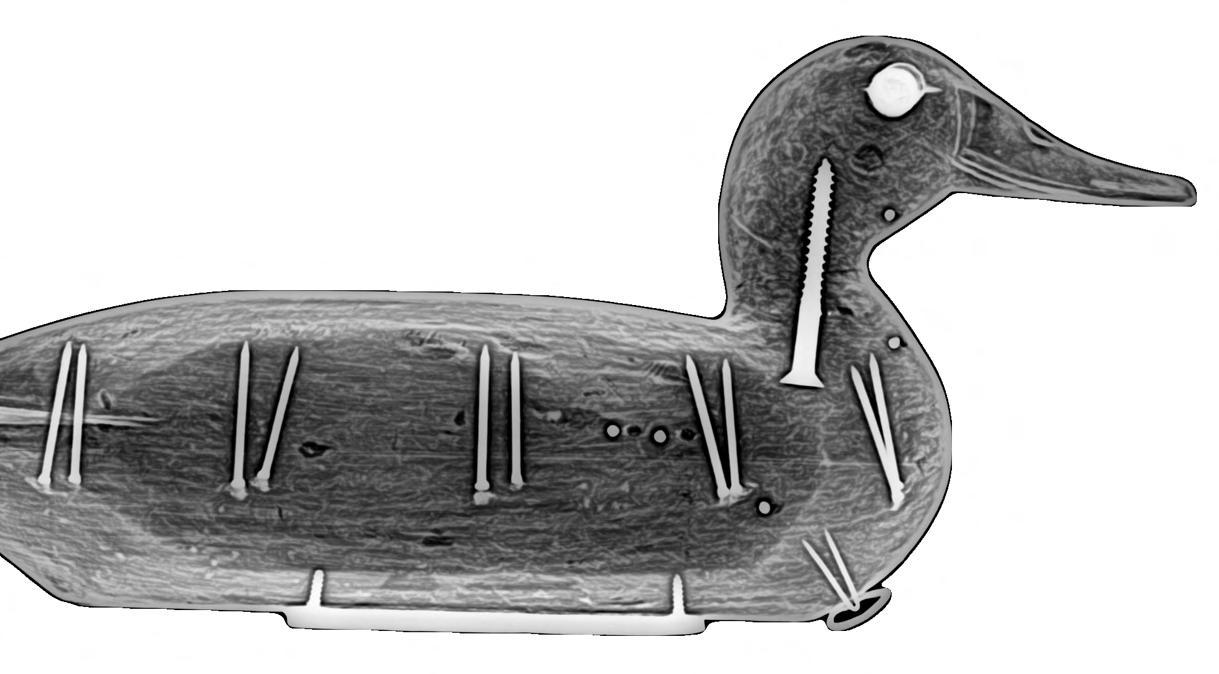
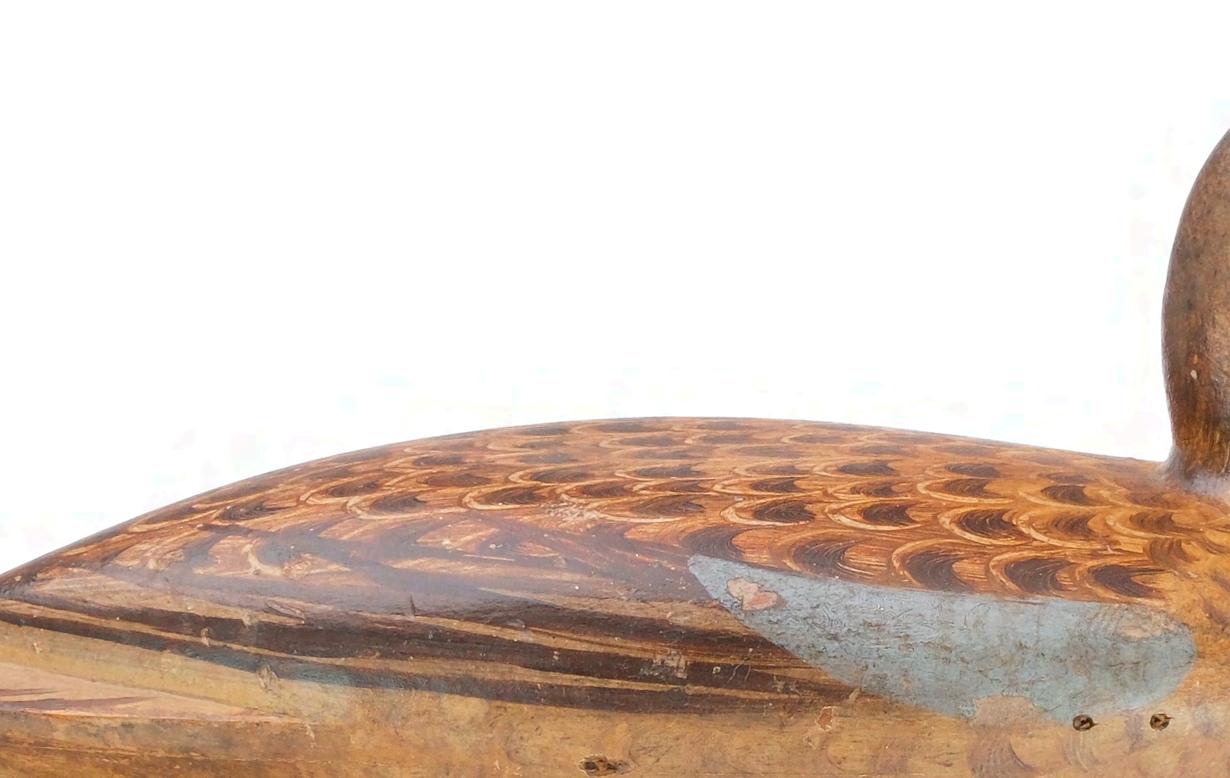
4 Robert Elliston (1847-1925), Bureau, Illinois. Excellent bluewing teal hen from the Dupee rig. Hollow carved with comb feather paint detail on back. Branded “WH Dupee” on the underside. Also retains the original Elliston weight. Measures 12.75” long. Original paint with very minor wear; lightly hit by shot in one side; otherwise excellent structurally.
Provenance:
Alan and Elaine Haid collection. (15,000 - 25,000)

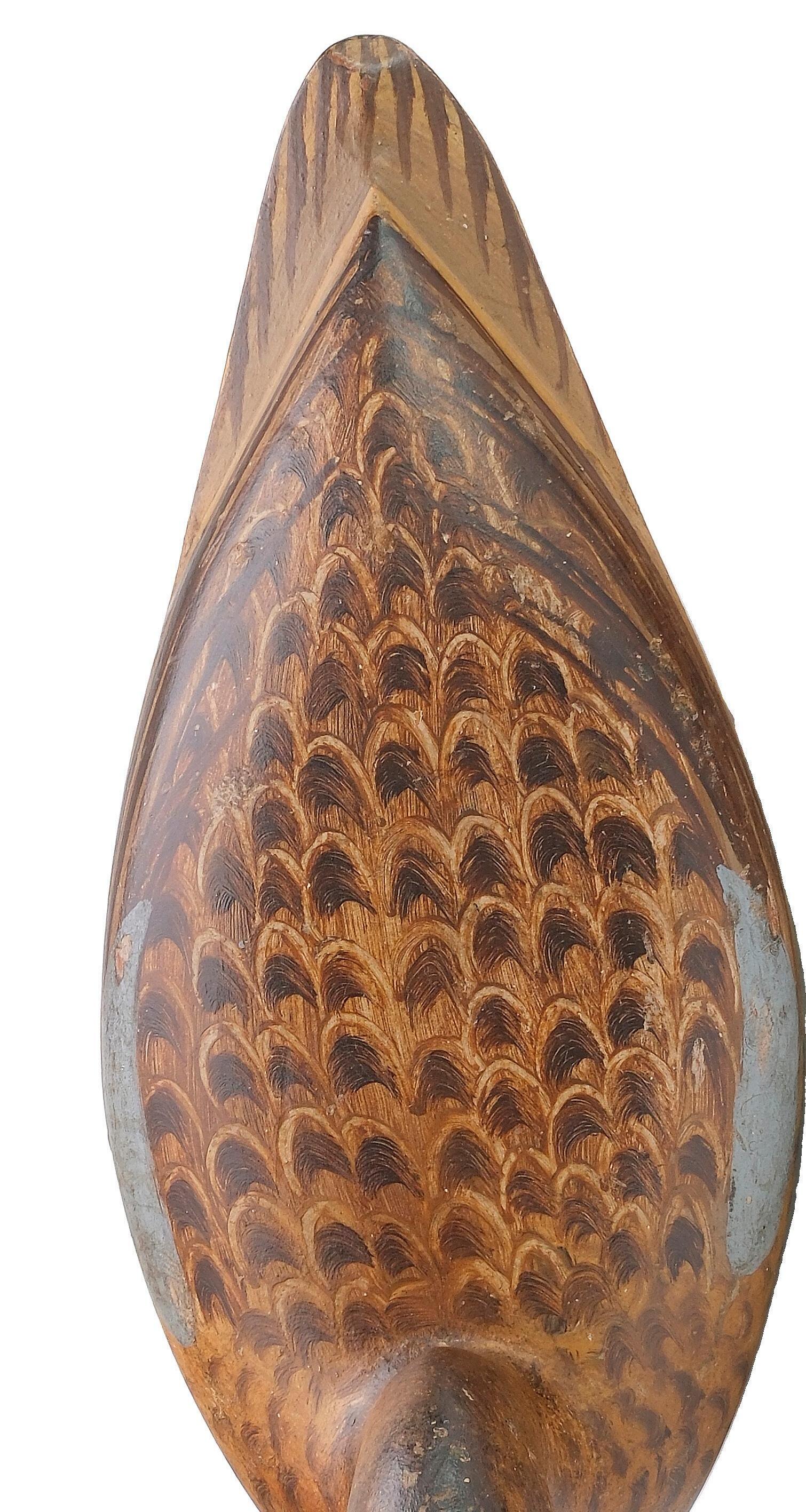
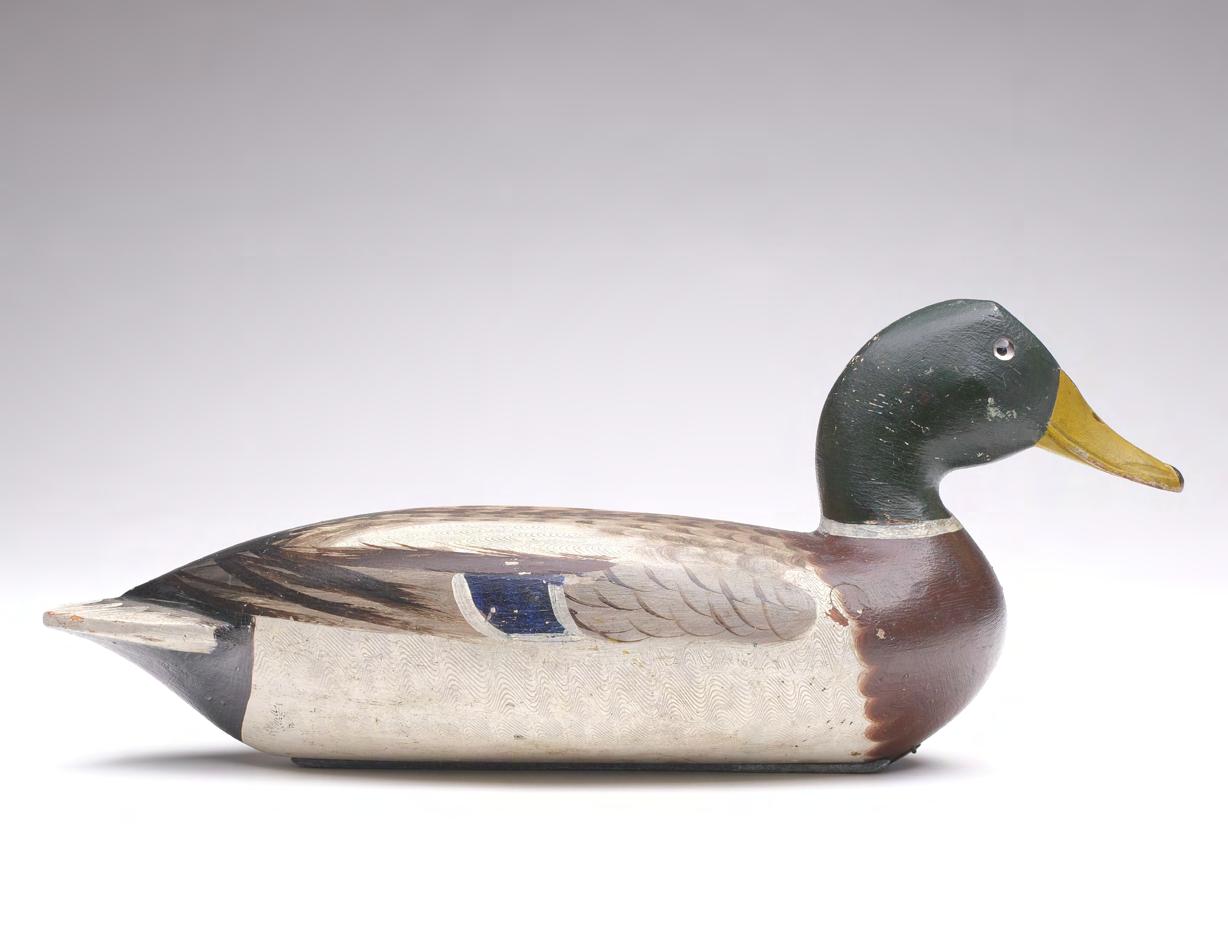
5 Robert Elliston (1847-1925), Bureau, Illinois. Excellent hollow carved mallard drake with comb feather paint detail and the original Elliston weight on the underside. Measures 17” long. Bright original paint with minor flaking and wear; excellent structurally.
Provenance: Alan and Elaine Haid collection. (7,000 - 10,000)
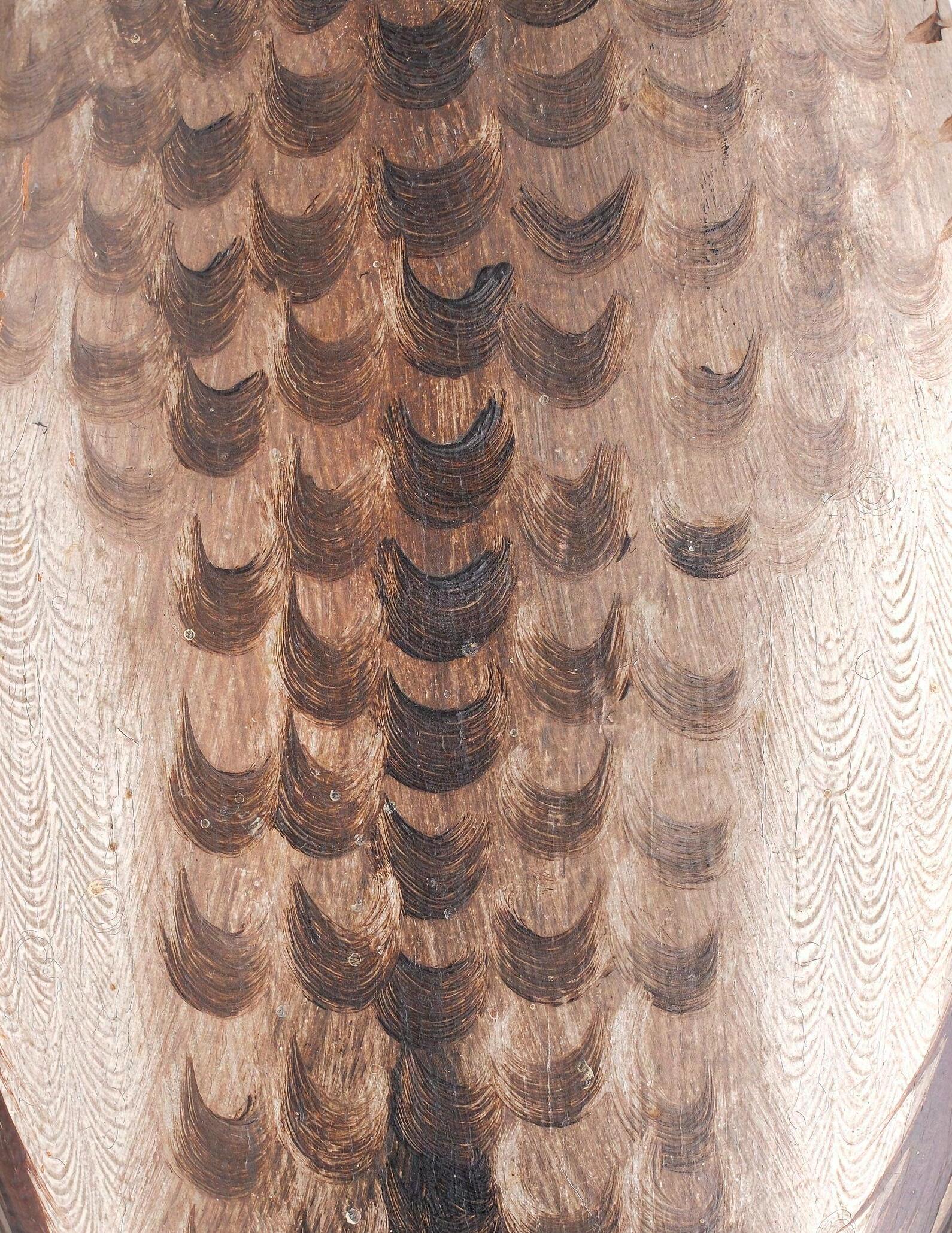

Charles was the third child in the very large family of German born Ferdinand Schoenheider and his wife Barbara. He was born in Poughkeepsie, NY, but at some date between 1865 and 1870, the family relocated to Peoria where the patriarch, Ferdinand, worked as a tailor and a retail grocer. Beginning with the 1880 census, Charles, age 24, began his lifelong career as a carpenter. As a young man, he supplemented this income by market hunting, working on neighboring Peoria Lake. In 1884, at age 29, he married 21-year-old Mary Barder in Peoria, and they would eventually have 11 children. After a long and productive career, Schoenheider passed away, not in 1944 as has been repeatedly cited, but in 1924. Mary predeceased him and they are both buried in the Springdale Cemetery in Peoria.
Charles’ carpentry and woodworking skills must have been noteworthy as evidenced by his building a number of houses in Peoria, including an entire block of homes on Vine St. This construction boom must have occurred around 1900 for, from that date until his death, the Schoenheider family is recorded as living at 113 Vine St. With his large family always a consideration, Charles must have constantly sought ways to simply pay the bills. As noted, early in life he gunned commercially. This would have required both boats and decoys. Initially, he fashioned both of these necessary items purely for himself, but eventually, the quality of his work must not have gone unnoticed by his fellow hunters for they, too, began to order his watercraft and sought to purchase his birds. As demand grew, he offered his decoys for
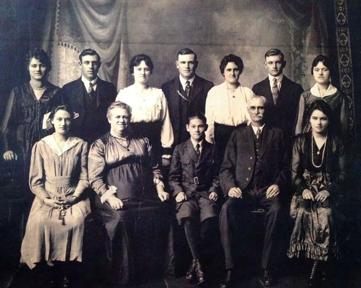
sale through the local Portman’s Sporting Goods and Hardware store in downtown, Peoria. The fact that he was supplying a retail establishment would indicate that Schoenheider must have carved a significant number of decoys representing the wide variety of species encountered when hunting on the river. Either recognizing his own artistic limitations, or as a way to speed up production, early references noted that Schoenheider utilized the skills of a local artist, Jack Franks, to paint his decoys. As one would expect, these decoys would have been constructed in the accepted local tradition, being hollow carved, full bodied, and nicely painted floaters. The observant and inventive Charles, however, went beyond the local norm and also produced a number of full size, standing examples meant to be used on the edges of the ice as it formed on the local waters.

Somehow Charles still found time to hunt. One of his favored locations was Duck Island which would ultimately house the Duck Island Preserve Club. One prominent, wealthy member of the Club, implement manufacturer, Daniel Webster Voorhees (1861 –1924), was obviously aware of these “ice decoys”. Reportedly, in 1918, he ordered a rig of a dozen, life size goose decoys from Schoenheider to include 10 standing examples. This particular lot was likely intended to be used as field decoys rather than on the ice. The story is well known that, when the rig was finally completed, Voorhees baulked at what he considered the outrageous cost of $125 dollars for the order and the decoys remained in the Schoenheider family until discovered by collector Joe French in 1966. As the story goes, “the rest is history” – or is it?


“Jack” Franks turns out to be John Casper Franks (1861 – 1914), not an “artist” as has occasionally been reported, but a painter in Peoria who was employed by the Fred Fueger Painting Company. Franks’ home was on South Adams St, only a few short blocks from Schoenheider’s home at 113
 John Casper Franks
John Casper Franks

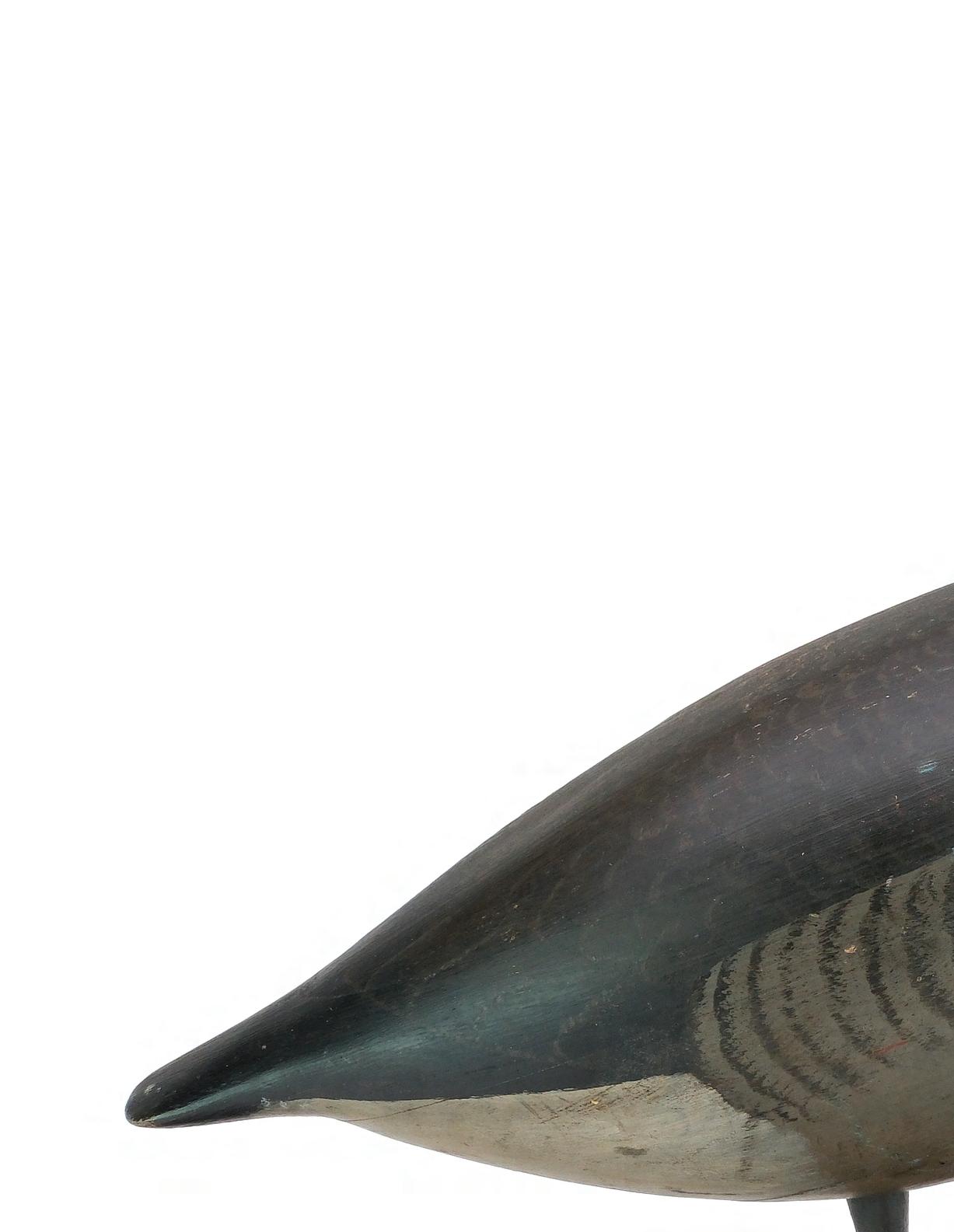

6 Charles Schoenheider Sr. (18541924), Peoria, Illinois. Very rare standing Canada goose. Hollow carved, laminate body, and three-piece vertically laminated head and neck. The original iron foot is mounted to a wooden base. Measures 27” long, and stands 22.25” tall. Excellent original paint with minor flaking, mostly on neck and one side of head; tiny chip in one side of bill was darkened long ago, possibly in the making; very slight separation at laminate seams.
Provenance:
Purchased by Joe Tonelli from Charles Schoenheider Jr. and sold to Bill Carr. Bill Carr collection.
Alan and Elaine Haid collection.
Literature:
“Top of the Line Hunting Collectibles”, by Donna Tonelli, page 160, exact decoy pictured.
“Fish and Fowl Decoys of the Great Lakes”, by Donna Tonelli, page 174, exact decoy pictured. (100,000 - 150,000)

“As I evaluated the classic carvers along the (Mississippi) Flyway, the importance of the Perdew name became evident”- Alan Haid

If any one name is synonymous with Illinois River Decoys, it must be that of Charles Perdew. Volumes have been written about the man, and his life and work are well known to almost anyone with an interest in decoys. He carved his first decoy as a young man of fifteen, and a letterhead of his indicates that he was producing decoys for sale by at least 1898. At one point, over 600 decoys per year left his shop located behind his home. His was a truly remarkable carving career that spanned over sixty years.
In about 1901, Charlie was operating a gunsmith store and making decoys and calls in Henry. At that time, a young woman named Edna Maude Haddon was hired to paint the decoys that Charlie produced. She had worked previously as a “compositor”, setting type for a printer, and her father was a painter and decorator by trade. The patience needed to accurately set type, coupled with what artistic leanings she may have inherited from her father, would have leant themselves to painting decoys. Charlie must have admired more than just her painting skills for, on Thanksgiving evening in 1902, the couple were wed in the home of her parents. He was 28 and she, only 20.
This would become the beginning of a loving relationship that would last for sixty-one years. Charlie would carve and, for over forty years, Edna would paint decoys. In “Perdew - An Illinois River Tradition”, Edna is described as “a quiet and strong woman, artistic, loving, and devoted
to Charlie” . As Charlie often commented – “they were a team – a two-some - - -” . Her painting abilities became legendary and, without a doubt, were a significant factor in the desirability of the Perdew’s finished product. They lived in a handsome home that Charlie and she had built for themselves in 1909 - 1910 on a bluff overlooking the river. In 1910, Edna presented Charlie with a son, Charles Haddon Perdew, who too, would eventually work in the family business. Oddly, Edna is rarely listed in any document as being involved with the decoy operation. Only in the 1940 census does she appear as “repainting decoys”. In the winter, the couple would read together, or Edna would listen as Charlie played his fiddle. In the summer, the couple raised a large vegetable garden as well as some flowers, fruit trees and a few bee hives. Eventually, Edna suffered the effects of lead poisoning and had to stop painting. A stroke in 1960 ended Charlie’s carving career and he passed away a few years later. Edna outlived her husband but, with failing memory, she died in a nursing home in El Paso, Illinois at age 92. This extraordinary couple are buried together in the Henry Cemetery in Henry.
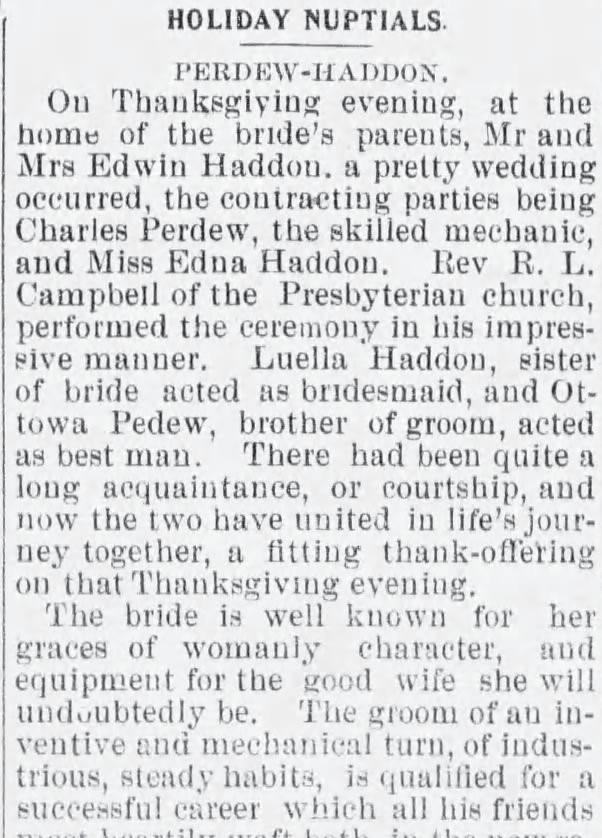

“Charles Perdew was a spare, rawboned, fiercely independent craftsman who earned a lofty niche in the pantheon of wildlife artistry.”
- Chicago Tribune
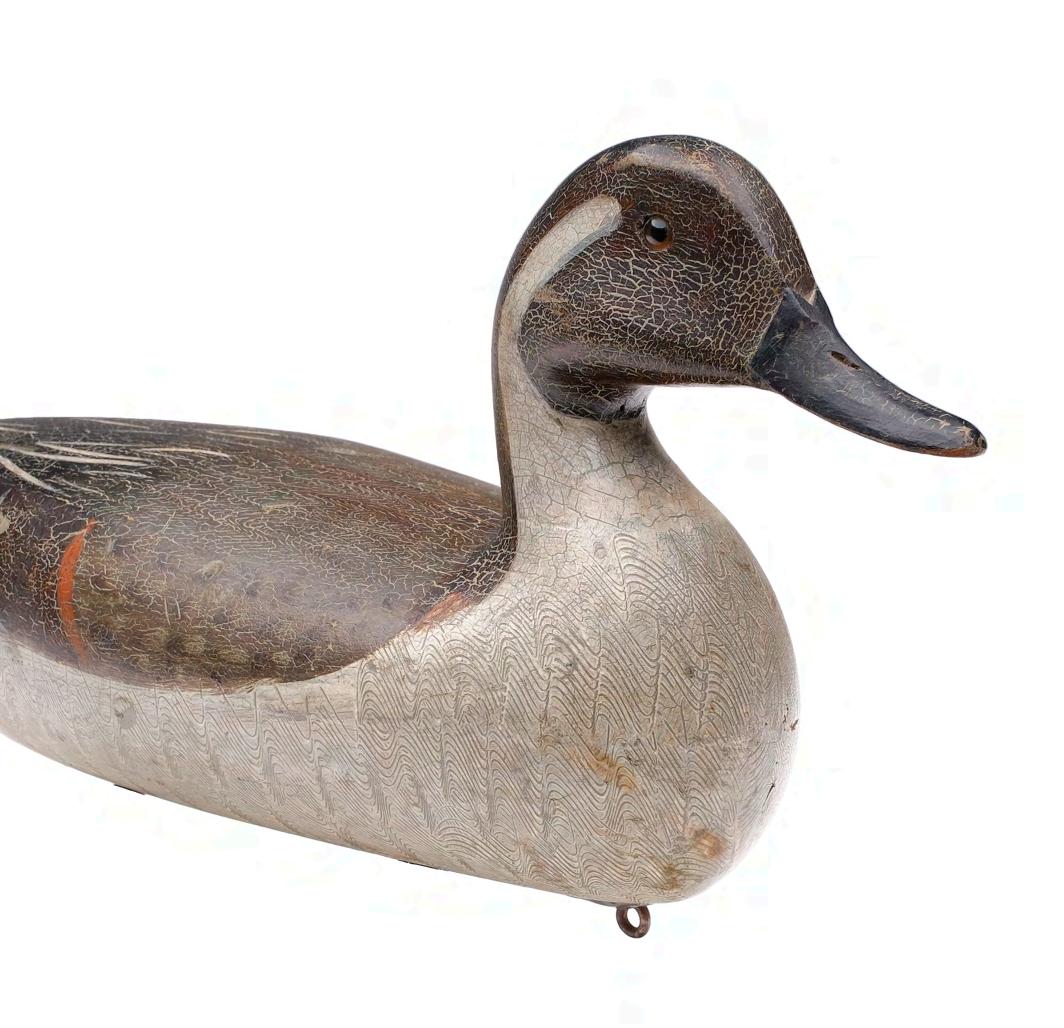




“Rarely has a man been so well suited both to craft and area as Charles Perdew was to the Illinois River”
- Ann Tandy Lacy, “An Illinois River Tradition”
7 Charles Perdew (1874-1963), Henry, Illinois. Very rare, three-piece black duck, circa 1910. Three piece body with sides angled much sharper than his later works. Subtle feather detailing along breast and sides by Edna Perdew. Measures 16.75” long. Original paint with minor to moderate wear; small dents and a few shot marks; old chip in underside of tail; very fine hairline cracks through neck.
Provenance:
Alan and Elaine Haid collection.
Literature:
“Decoys of the Mississippi Flyway”, by Alan G. Haid, page 82, exact decoy pictured.
“Fish and Fowl Decoys of the Great Lakes”, by Donna Tonelli, page 142, exact decoy pictured.
“Perdew: an Illinois River Tradition”, by Ann Tandy Lacy, page 142, exact decoy pictured. (15,000 - 25,000)


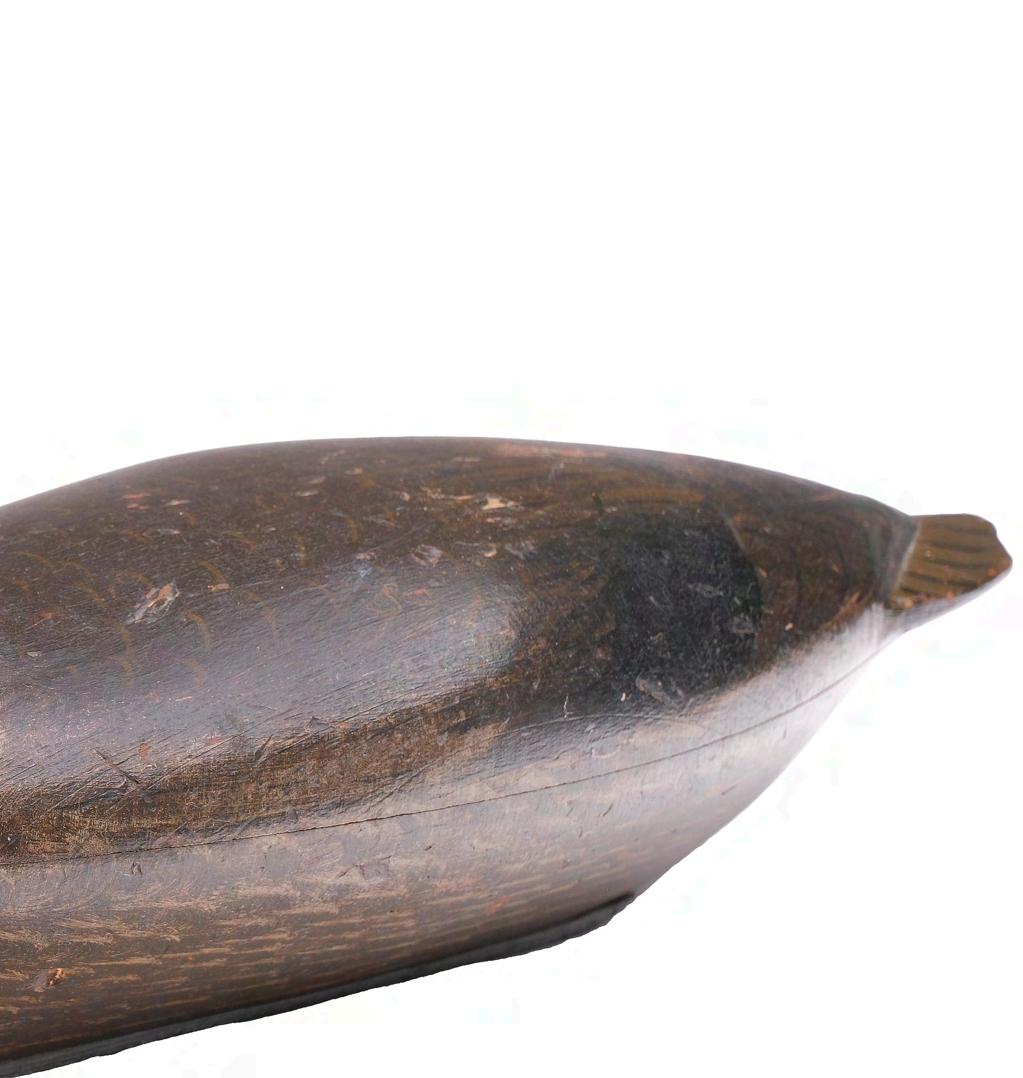

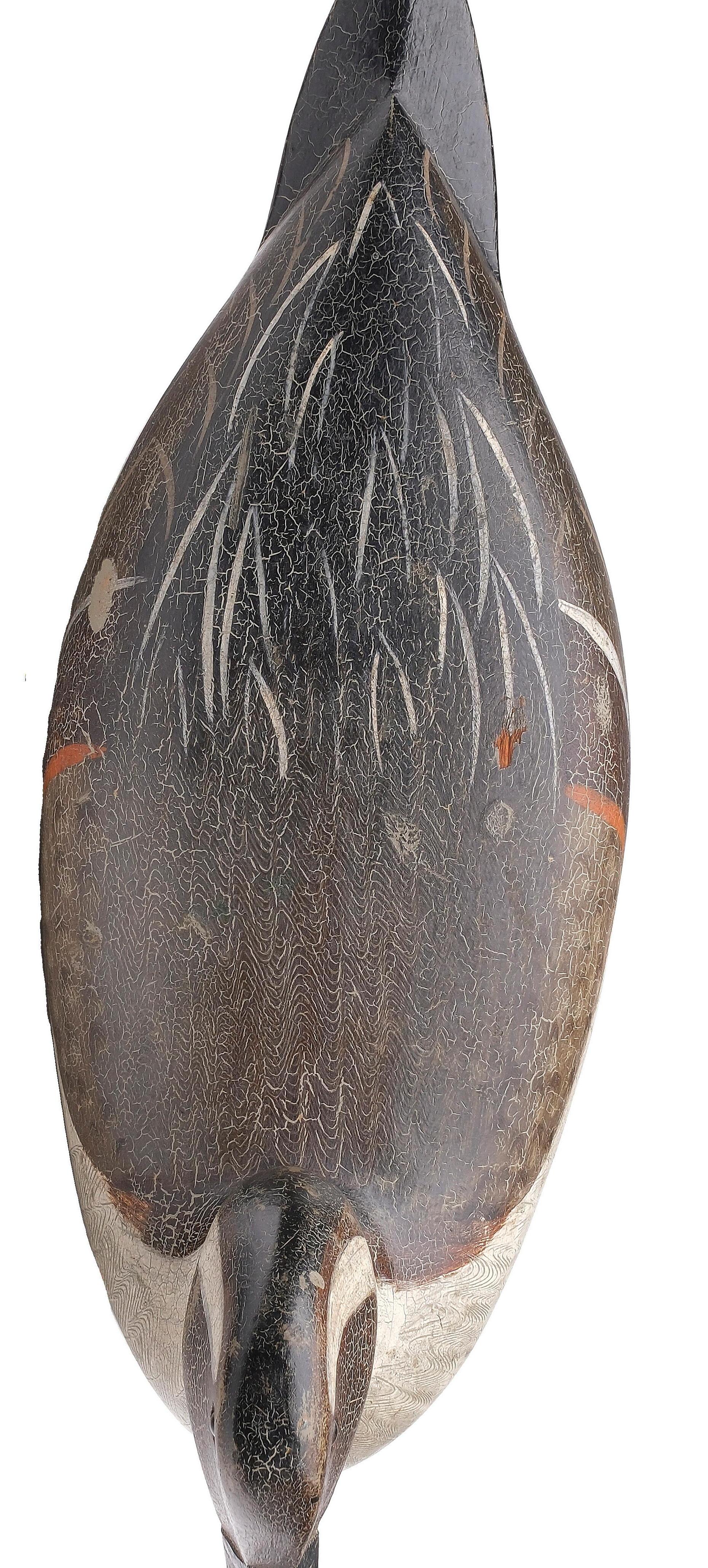
Charles Perdew (1874-1963), Henry, Illinois. Hollow carved pintail drake with comb feather paint detail and the original Perdew weight on the underside. Measures 16.5” long. Original paint with moderate to significant crazing that is tight and secure; minor paint rubs; the original bill was cracked down and professionally reset, otherwise excellent structurally.
Provenance:
Alan and Elaine Haid collection.
“Decoys of the Mississippi Flyway”, by Alan Haid, page 80, exact decoy pictured. (10,000 - 15,000)
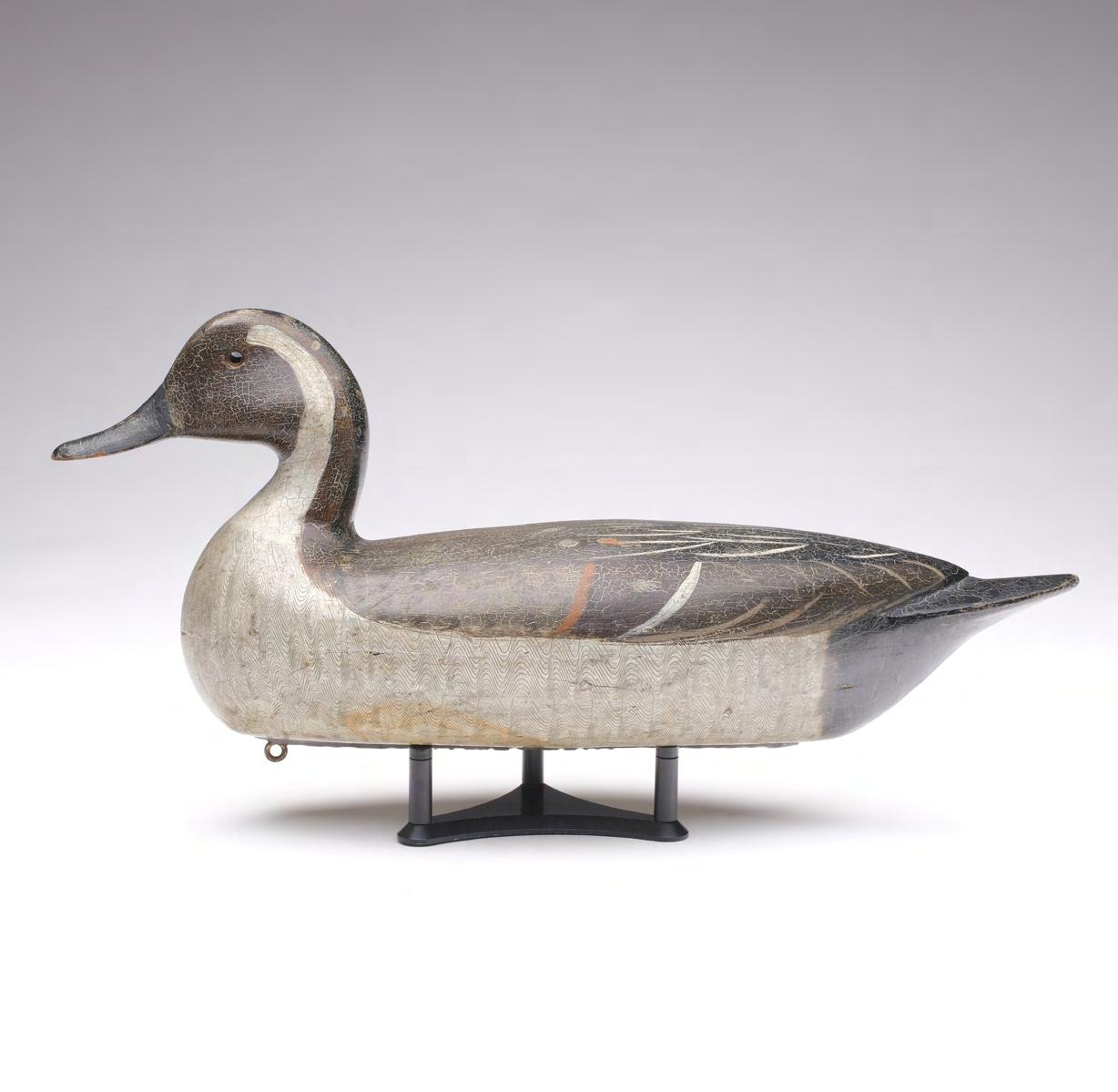
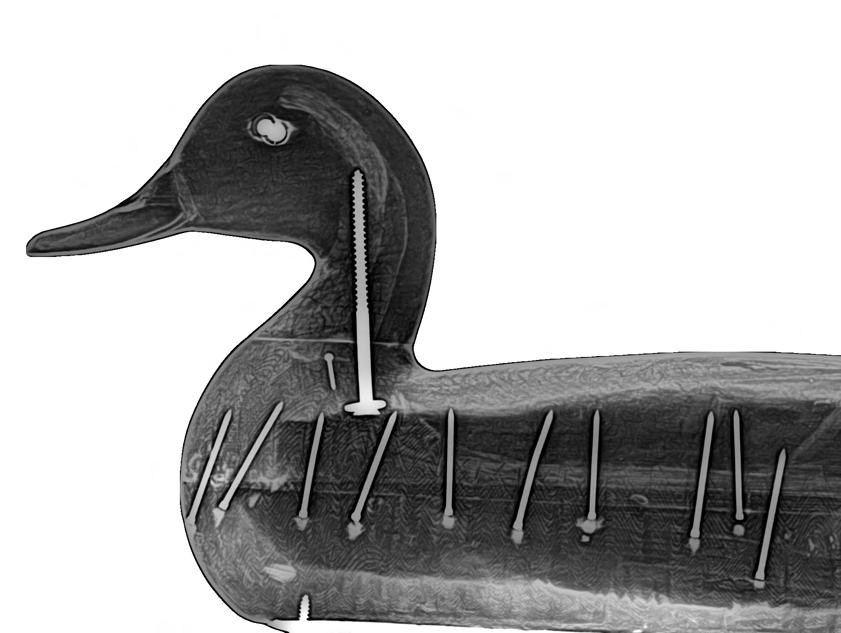


Founded in 1887, the Princeton Game and Fish Club is one of the oldest, most selective, and prestigious duck clubs in Illinois. The club was established “to promote the sports of hunting and fishing and to aid in the enforcement of Illinois game laws” . Membership has always been limited to fifty members, all of whom must be from Bureau County.
Some things have changed over the years. Members have come and passed, clubhouses have been rebuilt and landholdings have shifted based on changes to the river and the terms of leases. Over the past 136 years, however, one thing has remained steadfast –a commitment to the sport of duck hunting and its traditions. The Club lands are managed, and, at any given time, the majority of its properties are held in reserve as resting areas for the birds. Blind assignments are drawn on a daily basis, lottery style, so all members have equal shooting opportunities and club rules are often more stringent than those prescribed by law. Shooting hours are limited as are the number of days a member can hunt. Membership is highly coveted, and members often bequeath a membership to a son or grandson, but even this type of gift must be voted on by the members at large.
This is how it is today, and this is how it was in 1941 when Clifford Charles Jolley (1901 – 1971) was accepted into membership. Born in Ellsworth, Kansas, Jolley graduated from that State’s Agricultural College in 1922 with a degree in Civil Engineering. While at school, he
was active in theater groups, a member of Sigma Nu fraternity, a member of the National Society of Scabbard and Blade and an officer in the ROTC program. In 1933 he married Katherine Barrett of Princeton and the couple resided in Ottawa, Illinois while Clifford worked for the Continental Construction Company in Chicago. At some point they and their two children went back to Kansas where Jolley worked as a superintendent on a Natural Gas pipeline. By 1941 he returned to Bureau County where his work for the Texas Natural Gas Line Company was soon interrupted by WWII. During the war, Jolley served as a Sargent with the US Marines until he was discharged with the Good Conduct Medal in 1946. Upon returning from the War, he became the Owner/Manager of a lumberyard in Princeton. His grave is marked with a simple stone in the Oakland Cemetery in Princeton.
In 1948, soon after his return from the War, following a long-standing tradition among many of his fellow club members, Jolley chose to purchase his decoys from Charles Walker. By this time, Walker would have been seventy-five years old. Although still productive, Jolley’s rig was conceivably one of the very last, if not the last, that Walker would have produced. Birds from this rig are considered very desirable and are excellent examples of this talented carver’s work.
9 Charles Walker (1873-1954), Princeton, Illinois. Mallard drake from the Jolley rig with slightly turned head and relief wing carving. Flat bottom style with comb feather paint detail on back. “Jolley” written on the underside for the rig of Clifford Jolley, Princeton Fish & Game Club member. Measures 17” long. Strong original paint with minor gunning wear; three dents in back and one on the back of head were touched up and varnish added over those spots.
Provenance:
Alan and Elaine Haid collection.
(12,000 - 18,000)


An excellent summary of Bert’s life was published in a March/April 1997 issue of Decoy Magazine by Donna Tonelli. Subsequent scrutiny can add little or nothing to her research and most of what is presented here is a result of her article.
Graves was born in rural Magnolia, IL, somewhat removed from the east side of the river and approximately 45 miles NE of Peoria. Through at least his twenties, he, and his brother, like their father, worked as teamsters. This hard-working blue-collar lifestyle would remain with him for his entire life. Around 1905, he married the widow Anna Riley Corbin who brought her young son, Bransford, to the union and Graves would raise the boy as his own (see note 1). For a few years after the marriage, Bert would support the family as a carpenter in Peoria. By about 1915, he either bought or (more likely) built for himself and Anna, a comfortable home and workshop at 706 McReynolds St and this would be his address for the remainder of his life. For whatever reason, between at least the dates of 1918 and 1920, he lists his primary occupation as “fisherman - commercial” working at the “foot of Bridge St”. This was to be a shortterm venture, for between the dates of 1921 through 1949 he returned to describing himself as a “carpenter” or “contractor”. This was interrupted briefly when on the WWII draft registration, he states that he worked for the “City Hall Maintenance crew”. By 1950 he was unable to work and had applied for his social security benefits. He died one year later.
It is unclear when Graves began to carve decoys. We can only assume that he may have begun to carve a few for his own use while working on the river circa 1918. We do know that, upon the death of Robert Elliston, Graves approached his widow and purchased the remaining Elliston patterns, decoys, and orders. By the 1930’s he had printed, and was distributing, a business card advertising his decoys as well as boats, and this little piece of ephemera clearly lists “Elliston Pattern Decoys”. He did sell some of his carvings through the Portman’s Sporting Goods store and orders flowed in


from sportsmen around the country with quality rigs having been located throughout the Midwest, as well as Manitoba and elsewhere. At the pricey sum of between $75 and $100 per dozen in the 1940’s and 50’s, his decoys would have comprised a significant portion of Grave’s income.
The Graves decoy carving operation was based out of his garage and was, by all accounts, somewhat of a low keyed, factory type, operation. The work was



10 Bert Graves (1880-1956), Peoria, Illinois. Rare oversize mallard hen. Hollow carved with the original Graves weight on the underside. Measures 22.5” long. Original paint with moderate flaking and wear; lightly hit by shot; hairline crack in neck was reset; tight crack in back and tail; very thin wash of gray paint was cleaned off of lower part of decoy.
Provenance:
Alan and Elaine Haid collection. (8,000 - 10,000)
11
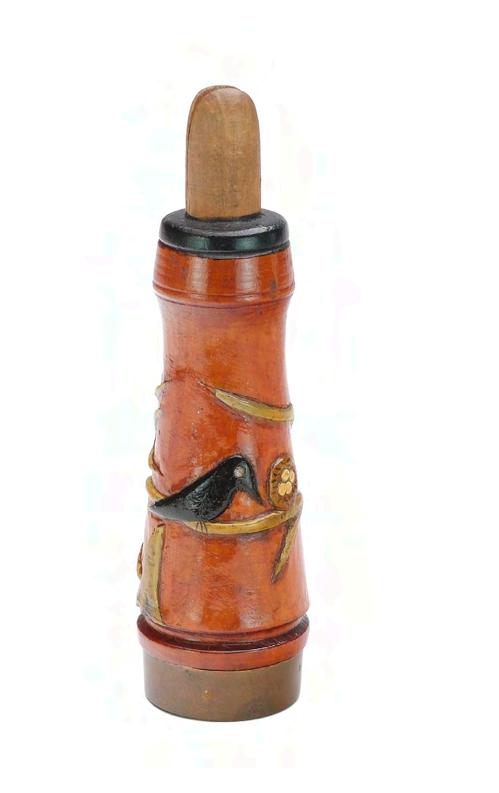
Charles Perdew (1874-1963), Henry, Illinois. A rare and desirable cedar carved crow call, first quarter 19th century. Wth a glass eye crow sitting with a nest that includes four eggs. 5.5” tall. Protected by a coat of varnish; very good and original.
Provenance:
Alan and Elaine Haid collection. Purchased from Joe Tonelli. (3,000 - 5,000)
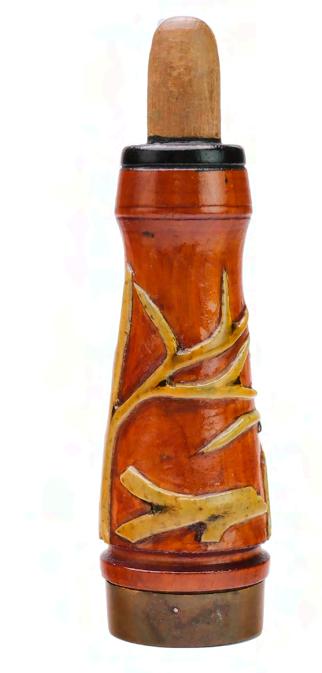

12
Charles Perdew (1874-1963), Henry, Illinois. Early carved cedar duck call with amber mouth piece. Three painted ducks with glass eyes protected by a coat of varnish with deeply carved initials “GEF”. Measures 6”. Metal reed is likely a replacement; a few cracks in amber mouth piece
Provenance:
Made for Glenn Fredrick, who owned a duck club in Hennepin, Illinois Alan and Elaine Haid collection. Purchased from Joe Tonelli. (2,500 - 3,500)

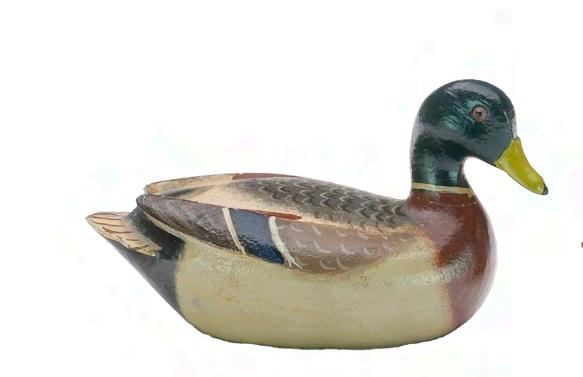
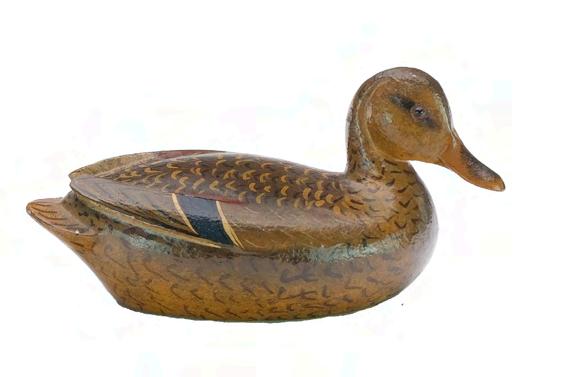
13 Charles Perdew (1874-1963), Henry, Illinois. Excellent pair of miniature raised wing mallards. Measure 4” long. Drake with a tiny tail chip repair, otherwise both excellent and original.
Provenance:
Alan and Elaine Haid collection. (1,200 - 1,800)
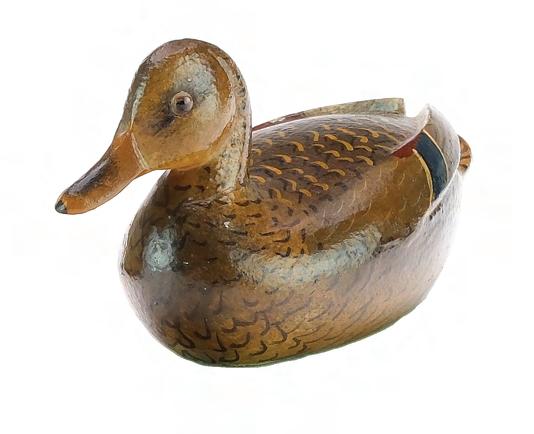

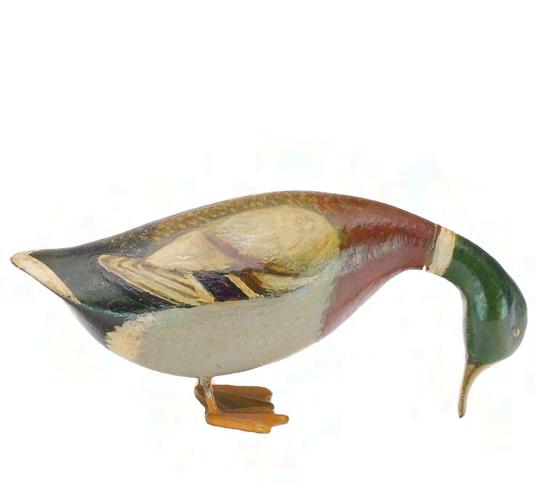
14 Unknown maker, early 20th century. Two miniature mallard drakes standing on metal feet. One in feeding pose, other looking skyward. Measure 4.25” and 4” long. Both protected under an early coat of varnish that has darkened slightly; uplooking mallard’s head was off and reattached with a reglued chip in one side.
Provenance:
Alan and Elaine Haid collection.
(1,500 - 2,500)

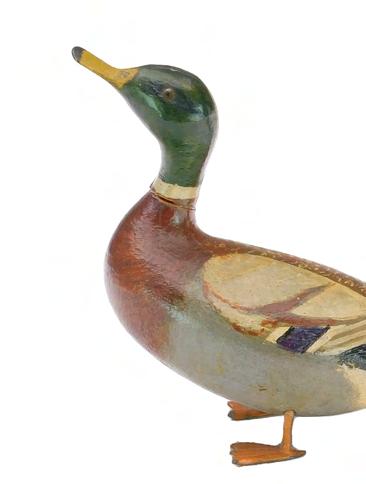
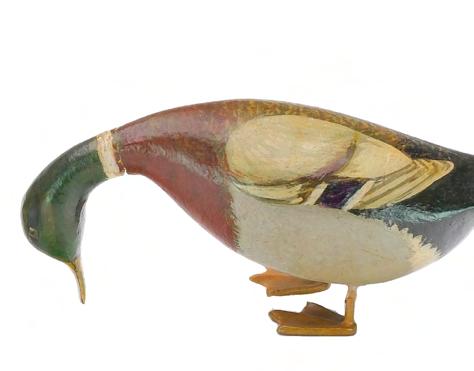
Long Island is renowned for its many fine decoy makers, especially those who crafted shorebirds. It is truly an enigma, however, that, even with the passage of many years of collector interest and numerous attempts at historic research, the life story of four of Long Island’s most celebrated carvers remains shrouded in mystery. What little that has been written is based, almost entirely, on distant mental recollections, verbal family tradition, or scribbled notations by unknown hands. Such sources, as we all know, should always be subject to suspicion.
Starting at the western end of the Island, we first encounter “Bill” Bowman. His story hinges on a conversation between Bill Mackey and a member of the Herrick family in downtown Manhattan. Mackey wrote that the Herrick family patriarch owned a group of wonderful shorebirds, whose maker, until then, had been unknown. Reportedly, the conversation revealed that the carver was an “Old Bill Bowman” who came to Lawrence each year and lived in a tent on the beach during shorebird season, then retreated to his home in Bangor, Maine. Numerous attempts to truly validate this story have proven fruitless. Reportedly, there is a photo of Bowman but this has apparently been misplaced. A search of the Maine census and newspaper records have found a William Bowman in Oldtown (near Bangor), but it cannot be proven beyond a doubt that this is the reclusive carver. Another theory exists that Bowman was not the carver at all, and the actual creator was a George S Bunn, a Shinnecock Indian from the completely opposite end of Long Island.
Moving eastward, we meet Obediah Verity. Once again, the birds were known in collections for years, but the carver’s identity remained unknown. Eventually, in the mid 1970’s, a group of shorebirds were shown to an ill and aged Andrew (“Grubie”) Verity in a nursing home on Long Island. He correctly identified birds with known makers then, when presented with a decoy by the “unknown maker”, proclaimed “Diah” - “Obediah”. With these few words, the search was on for the obscure “Diah”. The problem became apparent when it was determined that the Verity’s were a very large clan in Verityville, today’s Seaford. Research by Richard Baldwin determined that no fewer than 16 different men in the family carved decoys. In addition, various references have indicated that there were 6 or 7 men in the group with the name of either Obadiah or Obediah. Baldwin’s research led him to believe that the individual identified by “Grubie” was the son of John Henry Verity. This Obediah (1813 – 1901) apparently worked his entire life as a slow talking bachelor and bayman but little else about him has been uncovered.

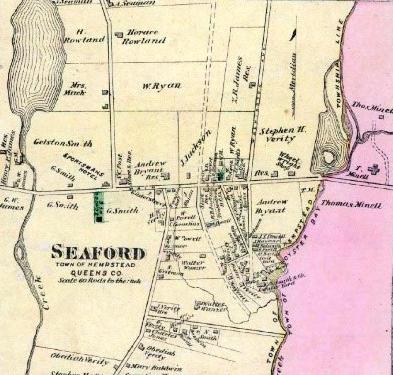
On the shore of Great South Bay lies Babylon. Here, in about 1933-34, pioneering collector Joel Barber, located a very fine decoy that was credited to Frank Kellum. Based on the wording of his comments in “Wildfowl Decoys” it appears that Barber received his information verbally from an undocumented informant. There is no record that the information was substantiated by others at the time and no record exists today that exactly matches Barber’s description of Mr. Kellum.
Finally, nearing the eastern end of the Island we find Quogue, the ascribed home of a John Dilley. As with the previous three men, the existence of exceptionally fine decoys by an unknown, elusive figure, had been known for years. Initially identified as being of New Jersey origin, these were finally assigned to John Dilley. This was largely due to occasional examples being found with the faint signature of “Dilley” written under the tail, and the reported finding of a box of the birds with the name “Dilley” on the end cap. In 1994, respected early collector Joe French reported that, in addition to the signature, some bore the identifier of “Henry Squires, NY”. Henry C Squires was a prominent sporting goods dealer on Broadway in downtown New York City. At that point, the trail ran cold and little, if anything, has been added to the story.
Dilley is not credited with carving duck decoys but the other three did. All four, however, carved shorebirds that are now considered icons of Long Island design. Verity’s influence was so significant that it formed the basis for an entire regional school of carved snipe. Kellum, in addition to his shorebirds, is recognized for producing one of the best confidence birds, a seagull, ever to emerge from the Island. The shorebirds produced by Bowman and Dilley are riveled in quality only by the early work of master artist A.E. Crowell and are universally applauded as representative of some of the finest of their kind in the entire country. All four individuals credited with the carvings, apparently led quiet lives that kept them out of the headlines and limelight. Apparently, Verity eked out an existence as a simple bayman, Bowman is said to have worked seasonally in the lumber industry in Maine, Kellum may have been a painter or carpenter as well as a part time guide and Dilley’s life is a complete conundrum. These men did not seek notoriety during their lifetimes, their decoys were produced in limited amounts, and it is very doubtful that their carvings ever earned them any great wealth.
Their work rests on its own merit. If no name was ever assigned to any of their decoys, they would still be admired and coveted. We constantly want to know more about the men or women who carved our decoys. Their life story adds to our enjoyment by placing the decoy into context with the person, as well as his or her community at a particular point in time. Perhaps, future study will eventually reveal some documentation that will allow us to learn the real story behind Messrs. Bowman, Verity, Kellum and Dilley or, in fact, if some of them even existed at all. In any event, the work of whoever made these Long Island treasures will remain as examples of some of the most outstanding decoys produced in America.





Information in the decoy literature concerning Mr. Kellum is, indeed, scant. What little that has been recorded is based, almost entirely, on what was written in 1934 by Joel Barber in his “Wild Fowl Decoys”. Barber (1876 –1952) was somewhat contemporaneous with Kellum so his information deserves to be considered. He wrote:
“Kellum was a well known and picturesque figure of the ‘nineties, and apparently very talented. So much so that a group of New York sportsmen of the old Wy-Wy-an-da Club became interested and made it possible for him to go to New York to study art. Many stories are told of this episode, but it appears that the idea didn’t work out. Kellum had always followed the water and soon came back to it. What he knew of guns and boats, decoys and the Great South Bay, was enough for any man. The art of schools meant nothing at all to him”.
Both “Gunners Paradise” and “The Decoys of Long Island” add slightly to Barber’s narrative by stating that he guided at the Wa-Wa-Yanda club on Captree Island off Babylon. Both references state that he was a “painter” and “The Decoys of Long Island” adds that he was a “carpenter”. No reference in the census can be found that lists a Frank Kellum (c1858 - c1930) as a “painter”. The 1880 Federal Census, however, does list a Frank Kellum, 22 years of age, living in Babylon and working as a house carpenter. Unfortunately, this Frank Kellum disappears from the record after that date. Much of Barber’s description of Kellum, based on his use of terms such as “apparently”, “stories are told”, “it appears”, etc, and the fact that he misspelled the name of the Wa-WaYanda club, would suggest that his material was based on information supplied to him verbally and oral history can often be notoriously inaccurate.
Needless to say, much more needs to be researched to elaborate accurately on the Frank Kellum of decoy fame. For the present we must simply enjoy the vague word-ofmouth stories about his life and, certainly, appreciate his superbly crafted decoys.



Illustration used as plate 93 in ‘Wildfowl Decoys’ by Joel Barber. Published in 1934.

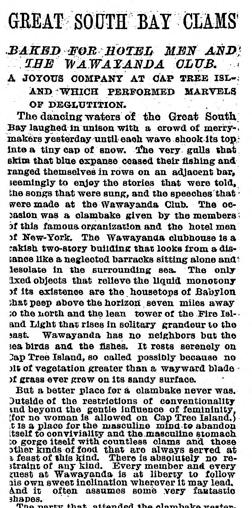

15 Frank Kellum (1858-1940), Babylon, Long Island, New York. Extremely rare, early herring gull. Two piece head and body with painted eyes. One of three known examples. Retains the collection ink stamps from Dr. George Ross Starr and Dr. James McCleery on the underside. Measures 21.5” long. Original paint with moderate flaking and wear; early coat of varnish has darkened slightly; vertical drying cracks in neck and head; four old nails in underside with rust discoloration in surrounding wood.
Provenance:
Made for and used at the Wa-Wa-Yanda Club, where Kellum was a guide.
Joel Barber collection.
Shelburne Museum collection.
Dr. George Ross Starr Jr collection.
Dr. James McCleery collection.
Alan and Elaine Haid collection.
Literature:
“Decoys of the Atlantic Flyway”, by Dr. George Ross Starr, page 34, exact decoy pictured.
“Top of the Line Hunting Collectibles”, by Donna Tonelli, page 9, exact decoy pictured in Joel Barber’s home.
“The Decoys of Long Island”, by Geoffrey K. Fleming, Alan G. Haid, and Timothy Sieger, page 54, 69, and back cover exact decoy pictured. (50,000 - 80,000)
Long Island attracted great numbers of shorebirds and thus, it was home to many carvers of decoys meant to attract them. Some of these men produced lures that were only fair, while others, produced exceptional birds. Many would argue that names at the very top of the list would include Gelston, Bowman, Dilley, and Verity. Ironically, of these, only Thomas Gelston has been thoroughly documented. The other gentlemen are either enigmatic or, at best, only vaguely understood. Among the Verity’s, the picture becomes particularly clouded when discussing the man that, today, most consider the master of the style attributed to the entire family, Obediah.
Uncertainty has surrounded the fine, distinctive decoys of this individual since their existence first became public. As early as 1965, writers William Mackey and Adele Earnest, proclaimed them to be the work of Bellport sportsman, Henry F. Osborne. Some Seaford residents already thought or knew differently. In 1969, George Weeks (1884 – 1977) wrote in “Recollections of Seaford” that “Diah was a great carver of decoys of which I have about a dozen”. In the mid 1970’s, Long Island collectors Bud Ward and George Coombs, with his son, George Jr., in an attempt to finalize the attribution once and for all, visited aged bayman

some of them with known carvers and then, picking up one of the (so-called) Osborne birds, he stated: “Diah, Obediah”. Even this news was slow to circulate in the decoy community and, as late as 1982, when they had now been assigned to the hand of Verity, his home was listed, erroneously, as being in Massapequa.
The Verity family in Seaford dates back generations to
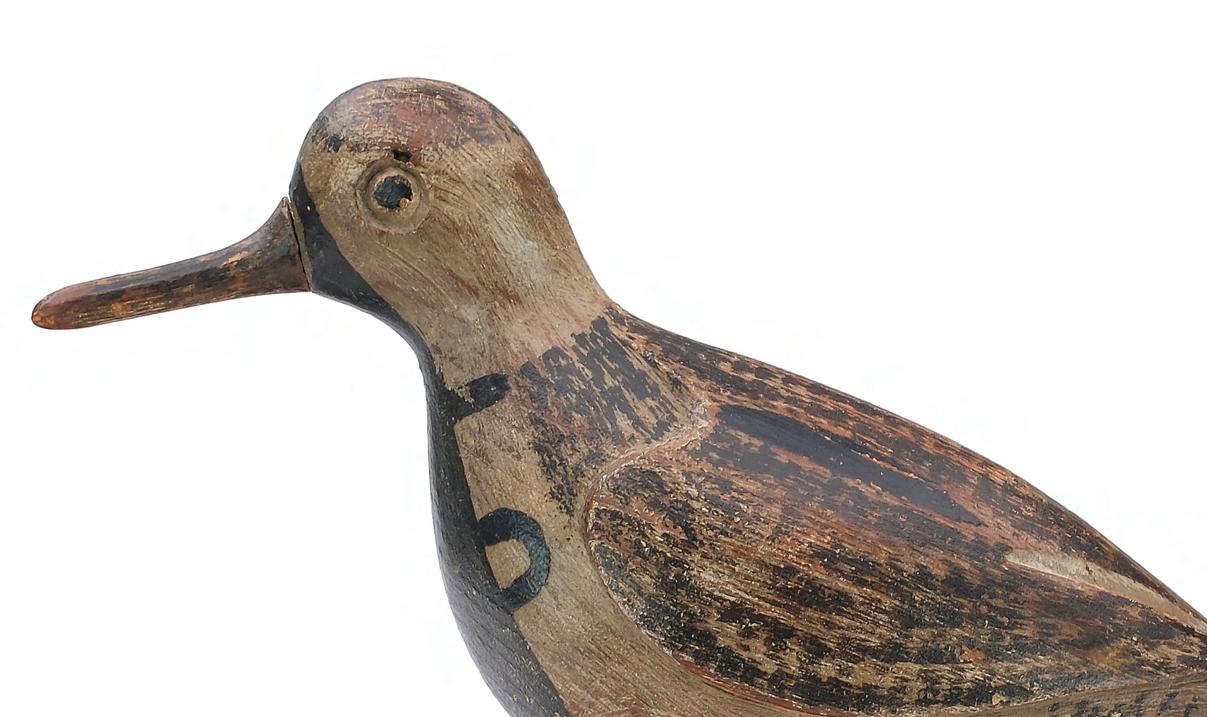 “Bay Snipe” by A.B. Frost 1895
“Bay Snipe” by A.B. Frost 1895
convincing case that the Obediah of decoy fame was the son of decoy carver John Henry Verity (1788 – 1866) and his wife Amy, and that his birth and death dates were (1813 – 1901). Further inquiry established that this Obediah worked his entire life as a slow talking bachelor and bayman, but has been unable to determine much else.
The decoys now credited to Obediah Verity represent some of the finest of the classic Seaford school that
he is credited with founding. They are represented in the majority of the finest museums, exhibitions and collections of decoys across the country. Obediah can rest with the knowledge that his work is now mentioned in the same breath, and held in the same esteem, as that of Boyd, Crowell, Lincoln, Shourds, Cobb, the Toronto Harbor artists, and the remainder of a very short list of the finest shorebird decoy makers from North America.



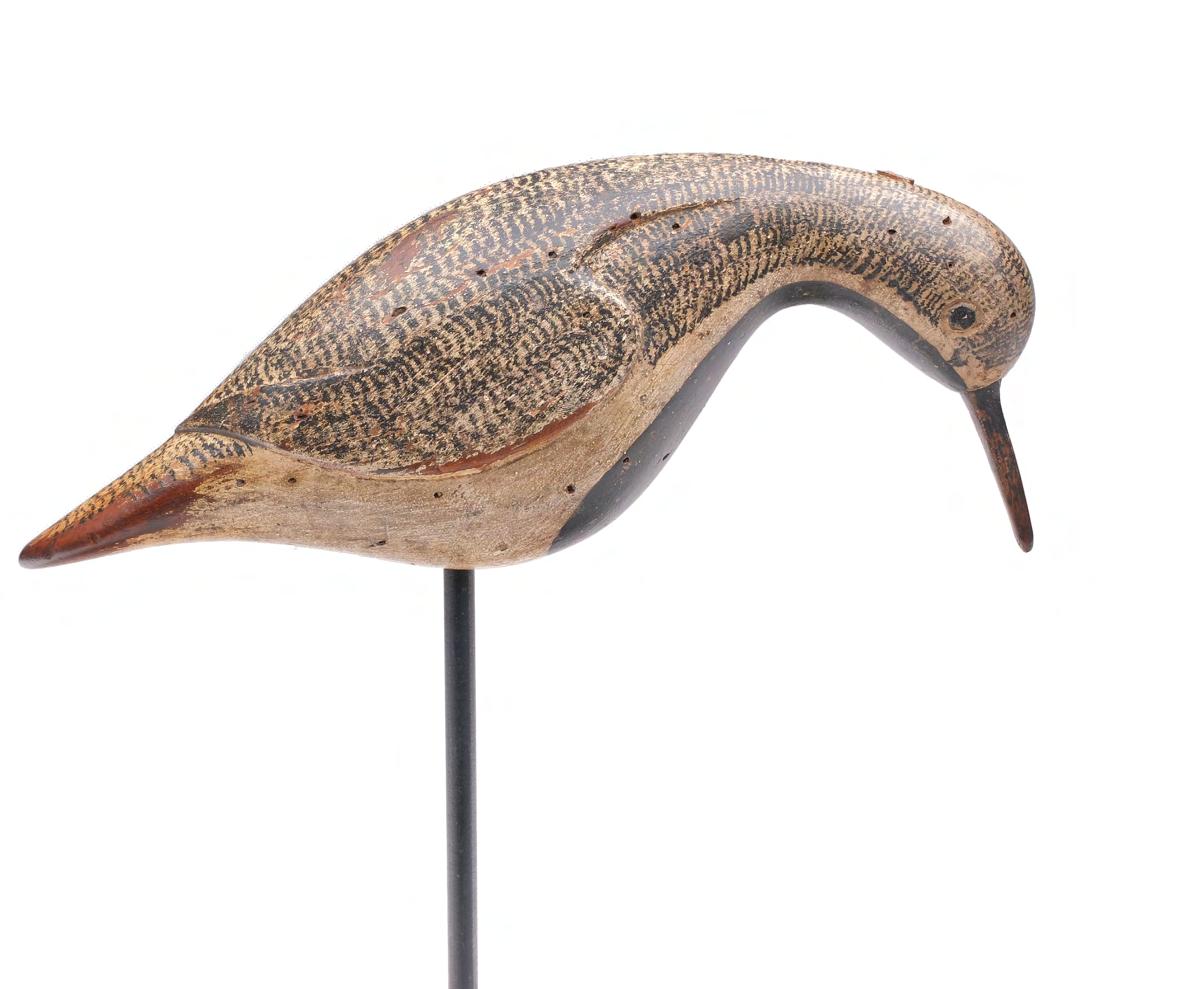
16
Obediah Verity (1813-1901), Seaford, Long Island, New York. Very rare feeding black bellied plover with relief wing carving and carved eyes. “W” scratched in the underside for the hunting rig of Willard Verity. This was Bud Ward’s logo bird. Measures 10.5” long. Original paint with minor to moderate wear; moderately hit by shot; old coat of varnish has darkened somewhat; very minor roughness on edge of stick hole.
Provenance:
Hunting rig of Willard Verity.
Bud Ward collection.
Alan and Elaine Haid collection.
Literature:
“Shore Bird Decoys”, by Henry A. Fleckenstein Jr, page 46 and 53, exact decoy pictured.
“Top of the Line Hunting Collectibles”, by Donna Tonelli, page 81, exact decoy pictured.
“Decoys: North America’s One Hundred Greatest”, Loy S. Harrell Jr., page 182-183, exact decoy pictured.
“The Great Book of Wildfowl Decoys”, by Joe Engers, page 101, exact decoy pictured.
“The Decoys of Long Island”, by Geoffrey K. Fleming, Alan G. Haid, and Timothy Sieger, page 33, exact decoy pictured.
(100,000 - 150,000)

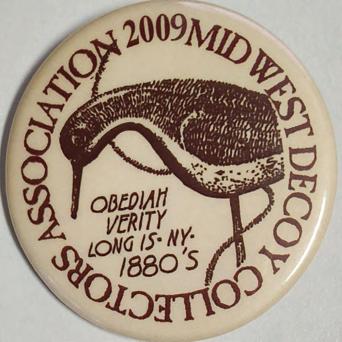
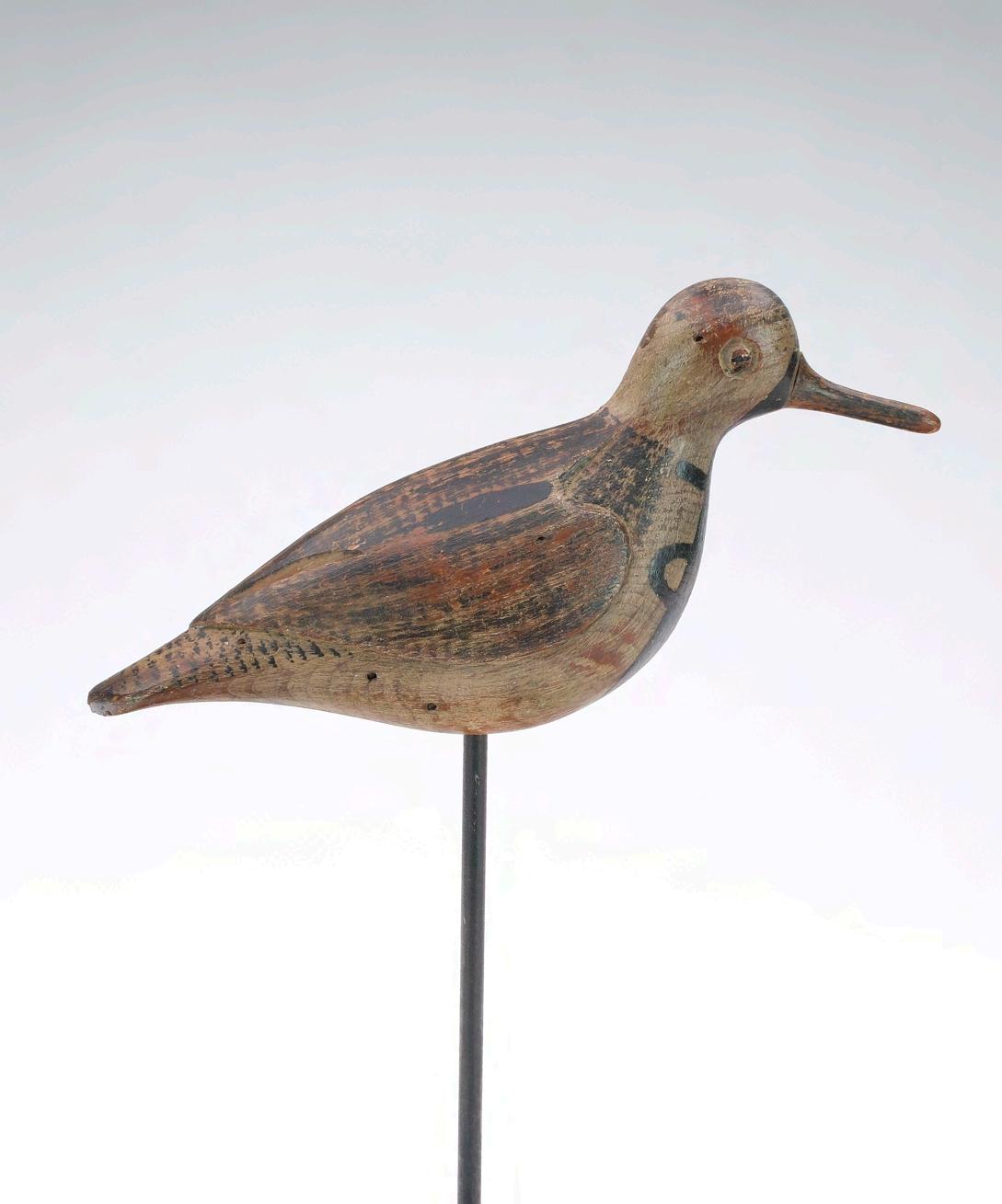
17

Obediah Verity (1813-1901), Seaford, Long Island, New York. Extremely rare ruddy turnstone circa 1890. In spring plumage with deep relief wing carving and carved eyes. Measures 9.25” long. Original paint with moderate gunning wear; lightly hit by shot; tight crack in tail with a small nail securing tiny chip from that area.
Provenance:
Frank Surace collection.
Russell A. Fink collection.
Alan and Elaine Haid collection.
Literature:
“Top of the Line Hunting Collectibles”, by Donna Tonelli, page 81, exact decoy pictured.
“The Decoys of Long Island”, by Geoffrey K. Fleming, Alan G. Haid, and Timothy Sieger, page 34, exact decoy pictured. (30,000 - 50,000)
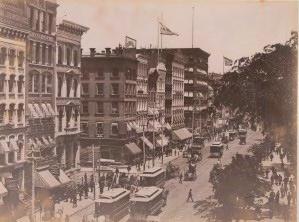

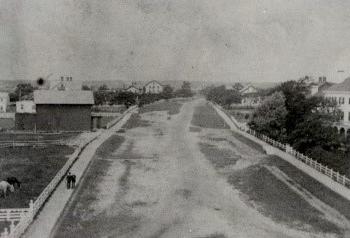
Strangely, two of Long Island’s most celebrated carvers, Bill Bowman and John Dilley, have escaped researchers’ efforts to elaborate on their lives.
The first written record of the shorebirds now credited to Dilley appeared in Bill Mackey’s 1965 “American Bird Decoys”. He related that he had acquired a small rig of very finely painted shorebirds from the widow of Jess Birdsall of Barnegat Bay, NJ. With all innocence, he credited Birdsall with their creation. Fairly quickly, however, due to the quality of the painted plumage, speculation centered around the possibility of Elmer Crowell from Cape Cod as the maker. Within a brief period of time, and with additional collectors entering the search, Mackey had to concede that his initial assumptions were incorrect. This was largely due to the fact that most of the “newly discovered” decoys seem to have been found on Long Island, not Barnegat Bay or Cape Cod and Mackey felt that their origin was, most likely, from the area of Quogue, on eastern Long Island. Early reports started to emerge that some had been found with a green stencil with the word “Dilley” and one collector stated that he had found six in a box with the name “John Dilley” on the box, suggesting that they were commercially available. Perhaps foolishly, some even went so far as to feel that the attribution stemmed from nothing more than someone seeing the birds and naively commenting “Boy – those are Dilleys” . Eventually, the true facts, meager as they are, started to emerge.
Examples began to surface with the sometimes faint but clearly legible signature of “Dilley” (usually under the
tail) and some had the species identified on the decoy as well. Skeptics felt that these signatures were applied since Mackey’s initial discovery and meant little. In truth, the signatures were under the paint, so it was impossible for a later collector to have added them. Respected early collector, Joe French, was finally able to track down an example with the signature that had been in a documented collection since before 1950, prior to anyone having ever heard of the name Dilley. Writing in the Jan/Feb 1994 issue of Decoy Magazine, he reported that he had also seen one example with the brand of “Henry and Squires, NY” . Henry C Squires was a respected sporting goods dealer on Broadway in downtown New York City. With that lead, an entry was finally located in an 1890 version of Squires’ catalog showing that he was, indeed, offering these decoys to sportsmen. At that point, the trail ran cold and nothing of significance, seemingly, has been added to the story.
What remains are the decoys themselves, almost universally acclaimed as being among the very finest of their kind from the entire flyway. Based on form alone, Gigi Hopkins has stated that: “ These decoys are ‘birdy’ – you don’t have to see the paint to know what shorebird is being represented” . The details in the painted plumage, however, are extraordinary and far exceeded the norm for the period. Carved as working vs mantel birds, the minute detail and perfectly blended surface clearly identifies each intended species.
John Dilley can rest with the confidence that his work is now so widely admired and accepted as the pinnacle of excellence in a working shorebird.

“The Best shorebird he (has) ever seen”
-Cleon Crowell, son of A.E. Crowell
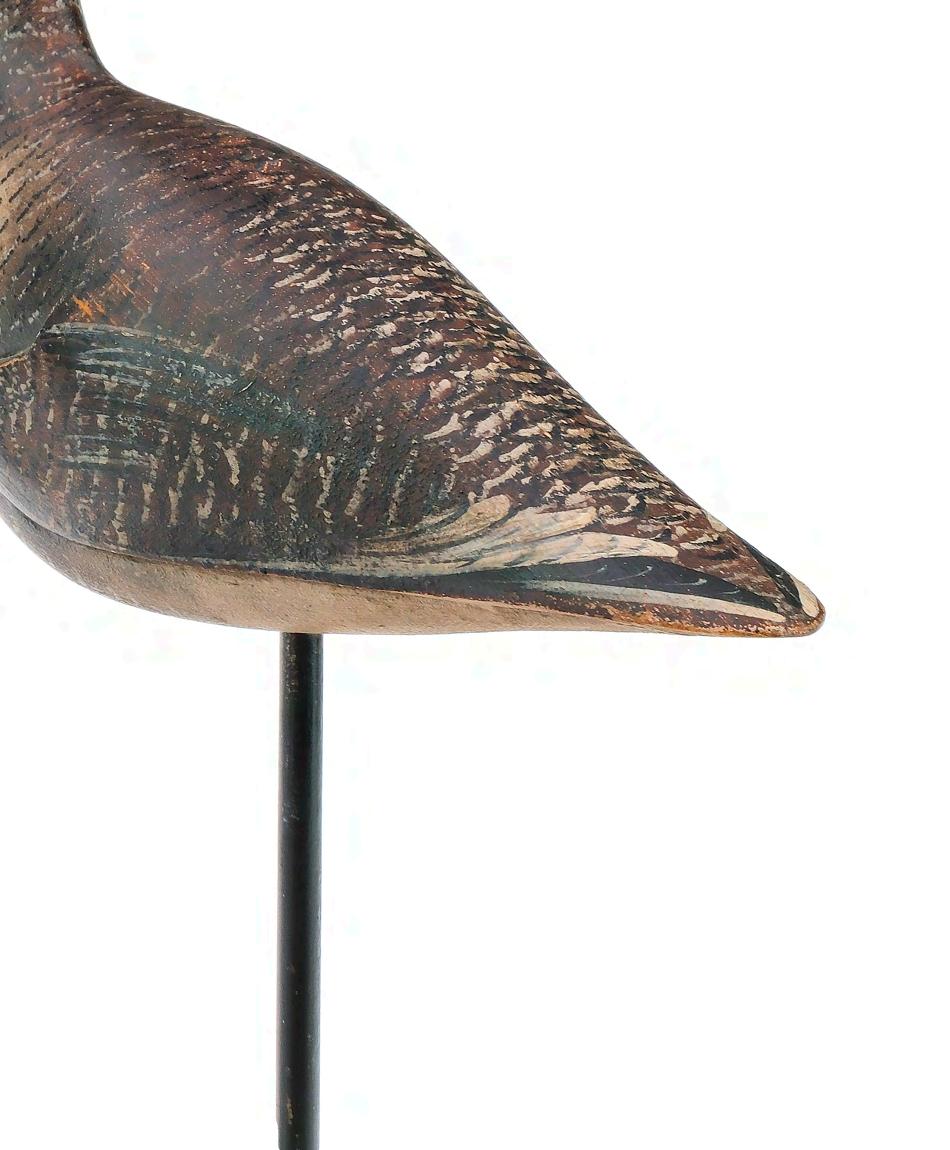

18

John Dilley (19th/20th century), Quogue, Long Island, New York. Very rare and outstanding ruddy turnstone in fall plumage, circa 1890. With relief wing carving and excellent paint detail. Measures 9.25” long. Excellent original paint with minor rubs on edge of tail and minor flaking on hardwood bill; excellent structurally.
Provenance:
Dr. Robyn Hardy collection.
Jim Cook collection.
Alan and Elaine Haid collection.
Literature:
“Top of the Line Hunting Collectibles”, by Donna Tonelli, page 77, exact decoy pictured.
“The Decoys of Long Island”, by Geoffrey K. Fleming, Alan G. Haid, and Timothy Sieger, page 47, exact decoy pictured. (70,000 - 100,000)

19 John Dilley (19th/20th century), Quogue, Long Island, New York. Outstanding dowitcher in spring plumage with relief wing carving and vibrant breast coloration. Measures 10” long. Very minor roughness on edge of tail; very minor flaking on hardwood bill; otherwise near mint.
Provenance:
Jim Cook collection.
Alan and Elaine Haid collection.
Literature:
“Top of the Line Hunting Collectibles”, by Donna Tonelli, page 77, exact decoy pictured.
“The Decoys of Long Island”, by Geoffrey K. Fleming, Alan G. Haid, and Timothy Sieger, page 48, exact decoy pictured. (30,000 - 50,000)
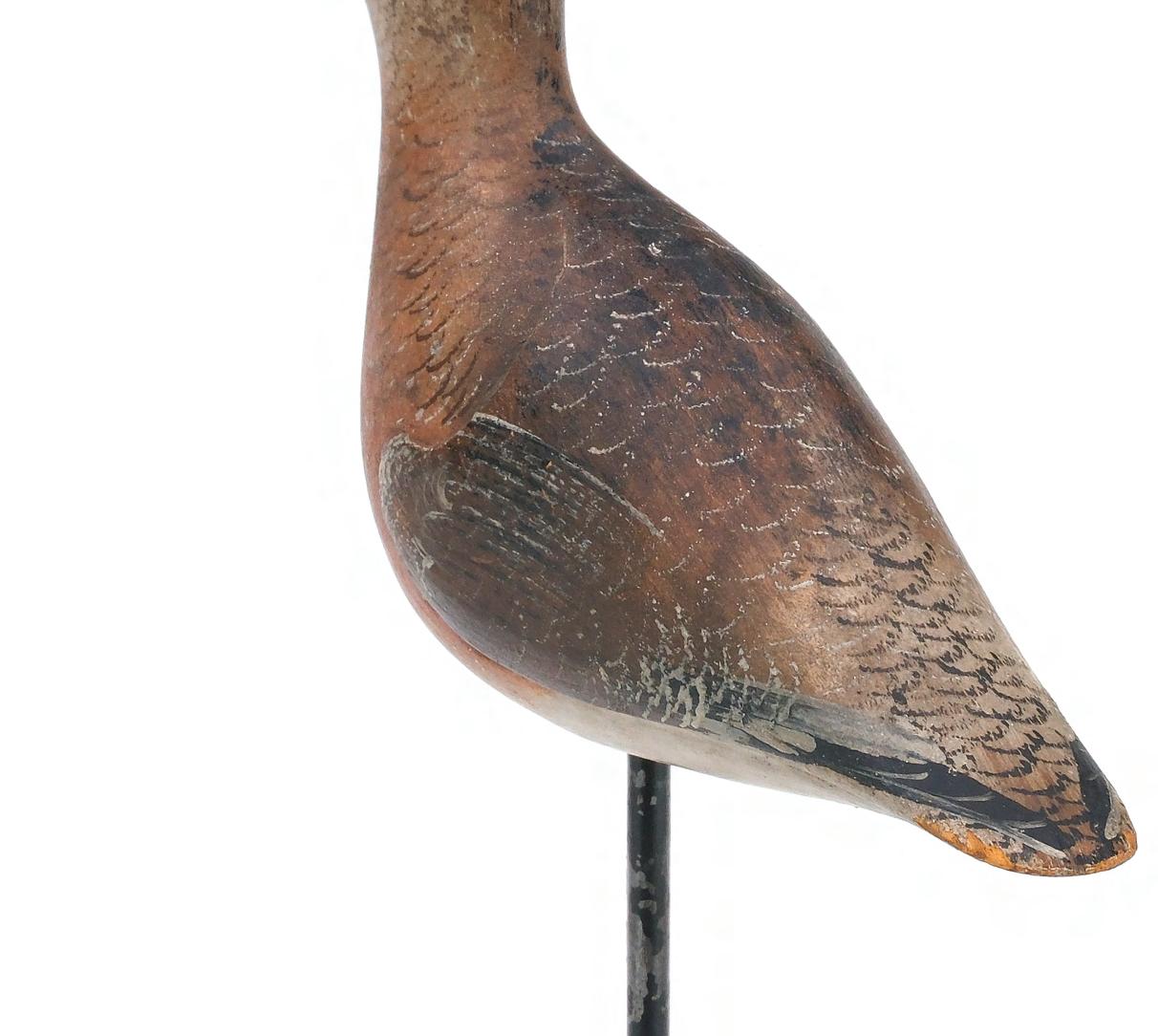


The mere mention of the word “Chesapeake” stirs the imagination of duck hunters across the country. Names such as Havre de Grace, “The Flats”, “The Eastern Shore” and others are legendary. The bay was a magnet for multitudes of migrating waterfowl annually. In turn, the ducks have attracted man for centuries, first for food and then for sport. Their pursuit of the ducks was relentless. They hunted the birds day and night using tools now outlawed such as night lights, bait, and the famous (or infamous) sinkbox. The guns ranged from fine sporting doubles to multi barreled “battery guns” and what were, basically, boat mounted small canons designed to spray immense charges of shot into a resting or startled flock. The massive numbers of ducks drew comparable hordes of men. Some formed large, comfortable club houses for the elite and affluent, groups of locals built simple shanties scattered across the marshes, and others made do with simple solitary blinds on remote points and inlets. All of this activity required decoys – lots and lots of decoys, and men throughout the Bay area rose to the task and began to carve. Obviously, some were more talented than others.
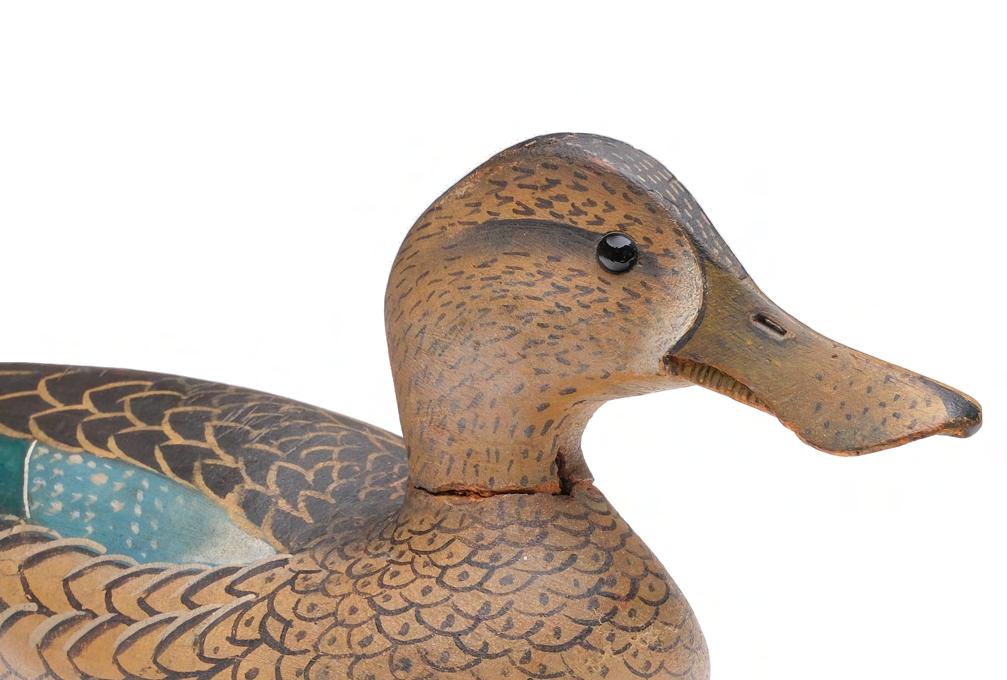
At the southern end of Maryland’s eastern shore, in Crisfield, the “town built upon Oyster shells”, two brothers, Lem and Steve, followed in their father’s footsteps and became barbers. Obviously not a get rich quick scheme in a small waterfront community of working baymen. Like many of their neighbors on their remote peninsula, they hunted ducks. This required decoys and they, like others, carved their own. Theirs, however, were different – they were better- much, much better. Word of the quality of their work began to spread, first among their neighbors and soon, far beyond tiny Crisfield. Orders for decoys began to flow in from both stores such as VL&A, clubs, and individuals, to the point where the barbershop was abandoned and transformed into their workshop.
Their work is remarkable in a number of ways. It was always outstanding but unlike other carvers, the men seemed to never be satisfied. Most makers would develop a style of their own and then stick with that design with perhaps only minor modifications for the remainder of their careers. Not so the Wards. They possessed boundless creativity and over time, they carved a dizzying array of styles, each
intended as an improvement on past efforts and always seeking the perfect decoy. These have been categorized in a number of ways, some based on form such as “fat jaw”, “Knot head” or “humpback”, others by the style created for a particular club such as “Bishop Head”, and some by the time frame in which they were made, with their “classic 36” being a good example.
With the passage of time, “modern” materials greatly diminished the demand for the working wooden bird. Fortunately for the Wards, this happened at a time when their reputation and talent was reaching its apex. For them, it was a simple process to transition from decoys meant for the water to birds destined for the mantel. This was largely due to the rapidly growing number of collectors who were now flooding the men with orders. Fortuitously, this gave the Wards the opportunity to create some of their finest and most stylistic and dynamic works. Carvings began to emerge from their small shop that were basically unknown by others at the time. The Ward’s began to produce birds in forms previously only glimpsed in nature.
The two men possessed a number of additional talents. They both loved to sing, write and recite poetry, and both were proficient with flat art. For all their lives, however, the brothers remained reserved and humble. They would often be seen riding their bicycles around Crisfield insisting that they were simply “two dumb old country boys”. The wider decoy community, however, knew better. They were often called upon to act as judges for the growing number of decoy carving contests nationally and, in 1974, the brothers were given honorary doctoral degrees by Salisbury State College. In 1979 Governor Hughes made Lem Ward a living state treasure for the contributions he made to American Art. He was
recognized in 1981 by President Ronald Reagan and, in 1983, Lem was named a National Endowment for the Arts Heritage Fellow. Today, a fine museum with a national reputation has been established in their name.
Lem was married to Thelma G Coulbourne and they had a daughter, Ida. Steve was a devout bachelor. Steve died in 1976 after a bout with cancer and Lem, heartbroken, slowly began to succumb to a number of


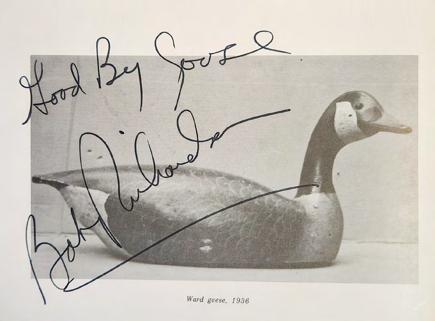
20 Lem Ward (1896-1984) and Steve Ward (1895-1976), Crisfield, Maryland.
Outstanding Bishop’s Head Gun Club model Canada goose. Head is turned and slightly cocked with typical humped bill and undertail carving. R.H. Richardson collection ink stamp on the underside. Believed by many to be the best of the Bishops Head style geese. Measures 24” long. Original paint with minor to moderate flaking and wear; hairline cracks in breast; a few tiny spots of touch up on top of head and at spot of filler at back of head.
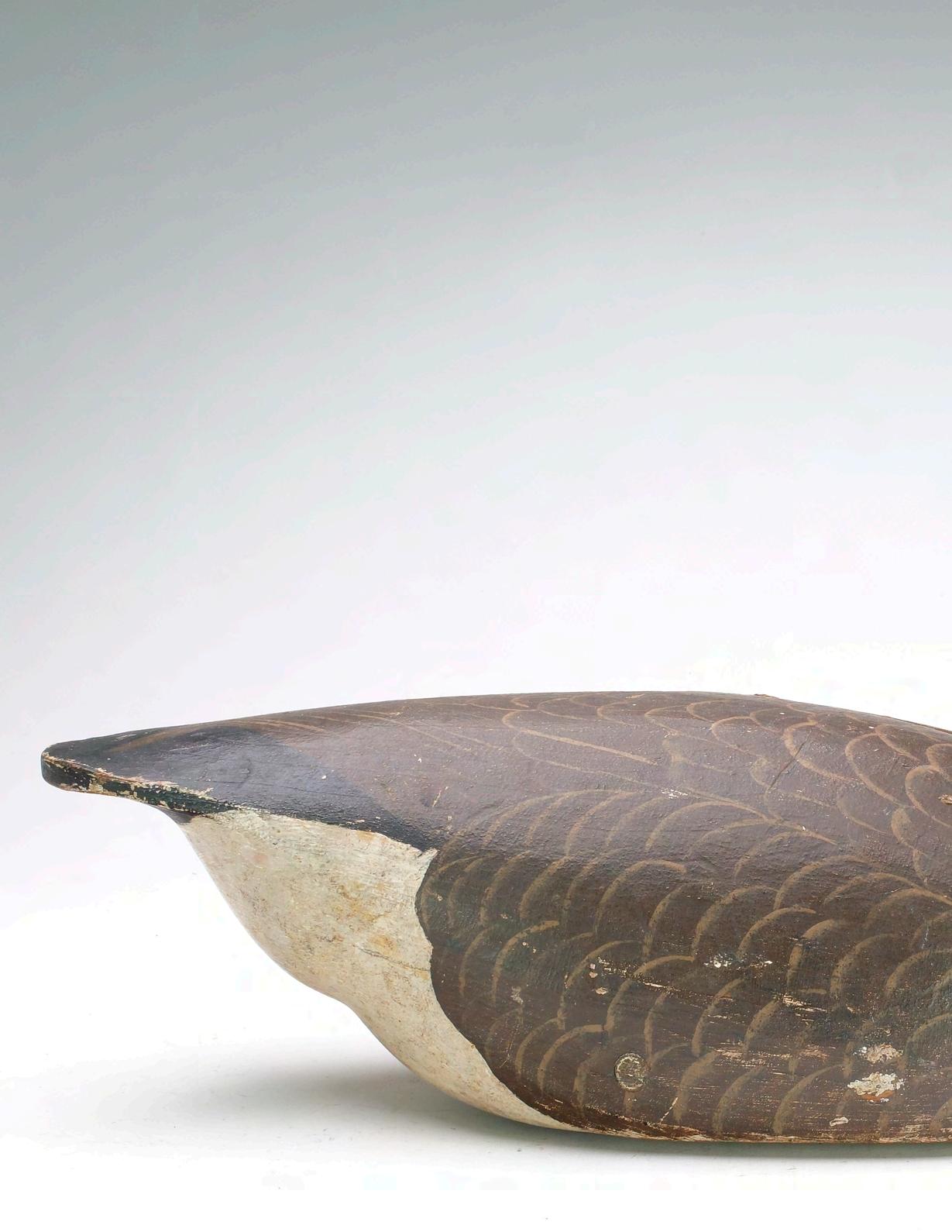
Provenance:
Bishops Head Fish and Gun Club rig. The Bishops Head Fish and Gun Club was founded by Albanus Phillips and W. Grason Winterbottom in the early 1920’s on a large point of land in southern Dorchester County, Maryland. Many of the decoys used at the club had been ordered from the Ward Brothers and made in a distinct style now known as the Bishops Head Gun Club style. Phillips and Winterbottom were two of the three founders of The Phillips Packing Company of Cambridge, Maryland. Establishing their first packing plant in 1902, the company grew to be the largest fruit cannery in the United States, the largest supplier of C-Rations during World War I and II, and the largest employer in Dorchester County.
Purchased by Bobby Richardson from the son of an executive of the Phillips Packing Company, who owned three Bishops Head geese.
Bobby Richardson collection.
Alan and Elaine Haid collection.
Literature:
“Timeless Treasures: Ward Brothers Decoys” by The Ward Museum of Waterfowl Art, pages 68, 74,and 75. “Chesapeake Bay Decoys”, by Robert H. Richardson, page 160, exact decoy pictured.
(70,000 - 100,000)
In 1933, the Ward Brothers received a decoy order from the Bishops Head Gun Club in Dorchester County, Maryland. This was not an unusual occurrence for them, but for some reason, whether at the request of the club’s owner, or perhaps creative inspiration, they decided to make several of the species in this order distinctive from others carved in the period. The pronounced apron under the tail, the notch behind the head, and the squared off tail are all identifying characteristics that separate this club’s special order from other Ward decoys made in the 1920s and 1930s.
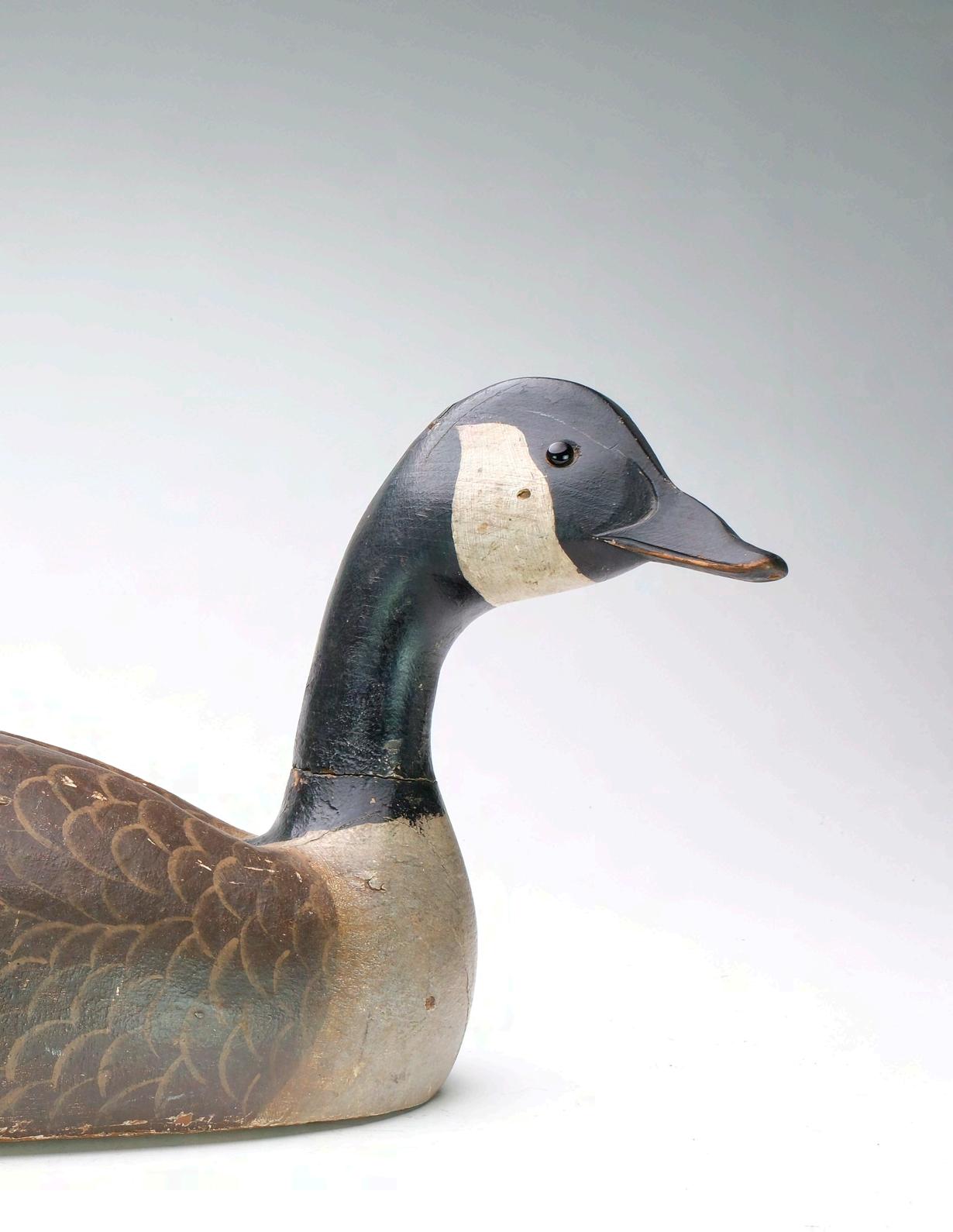

Lem Ward (1896-1984) and Steve Ward (1895-1976), Crisfield, Maryland. One of a kind, shoveler hen circa 1930’s. Slightly turned head with very wide bill carving true to the species. “LT Ward & Bro” ink stamp on underside. Also identified by the Ward Brothers on the underside. Measures 14.75” long. Original paint with very minor wear; many half inch long shallow dents along the center of back; minor separation at neck seat with some flaked filler; nostril area of bill with some restoration and touch up; also professional tail chip repair.
Provenance: Alan and Elaine Haid collection.
Literature:
“Decoys: North America’s One Hundred Greatest”, by Loy S. Harrell Jr., page 34-35, exact decoy pictured. “Timeless Treasures: Ward Brothers Decoys” by The Ward Museum of Waterfowl Art, pages 55 and 57. (30,000 - 50,000)


In the 1970’s, John Delph purchased this one-of-akind Ward Shoveler at one of the Muleskinner decoy shows. When he decided to part with it, he hired Alan to fly down to Texas to offer it to collector Dr. James McCleery, who was aggressively seeking rare and outstanding decoys. The doctor initially passed on the purchase and soon after returning home Alan received a phone call from McCleery, saying that he had changed his mind, and he would like to purchase the decoy. Alan simply replied that the decoy had sold. It has remained in the Haid collection since.
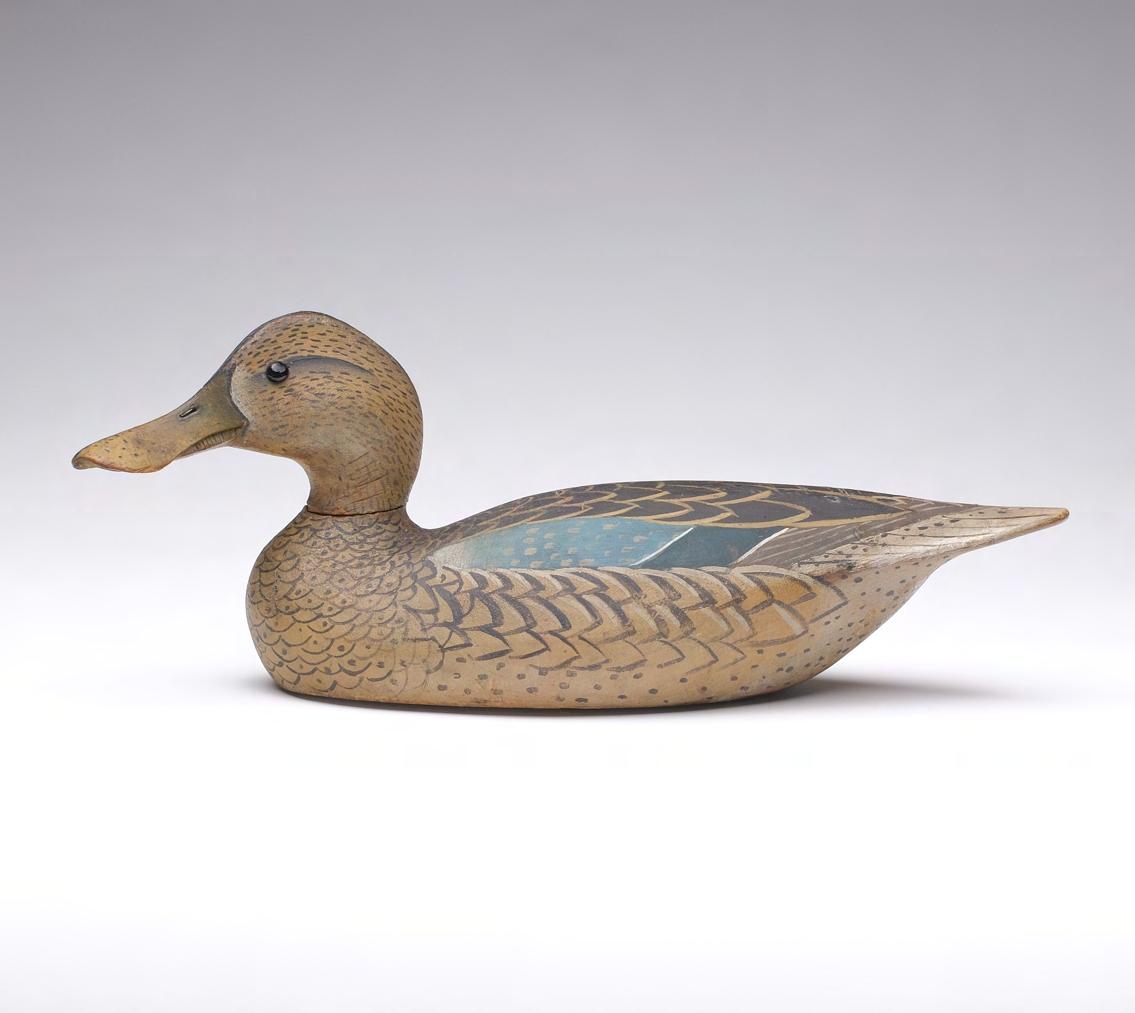
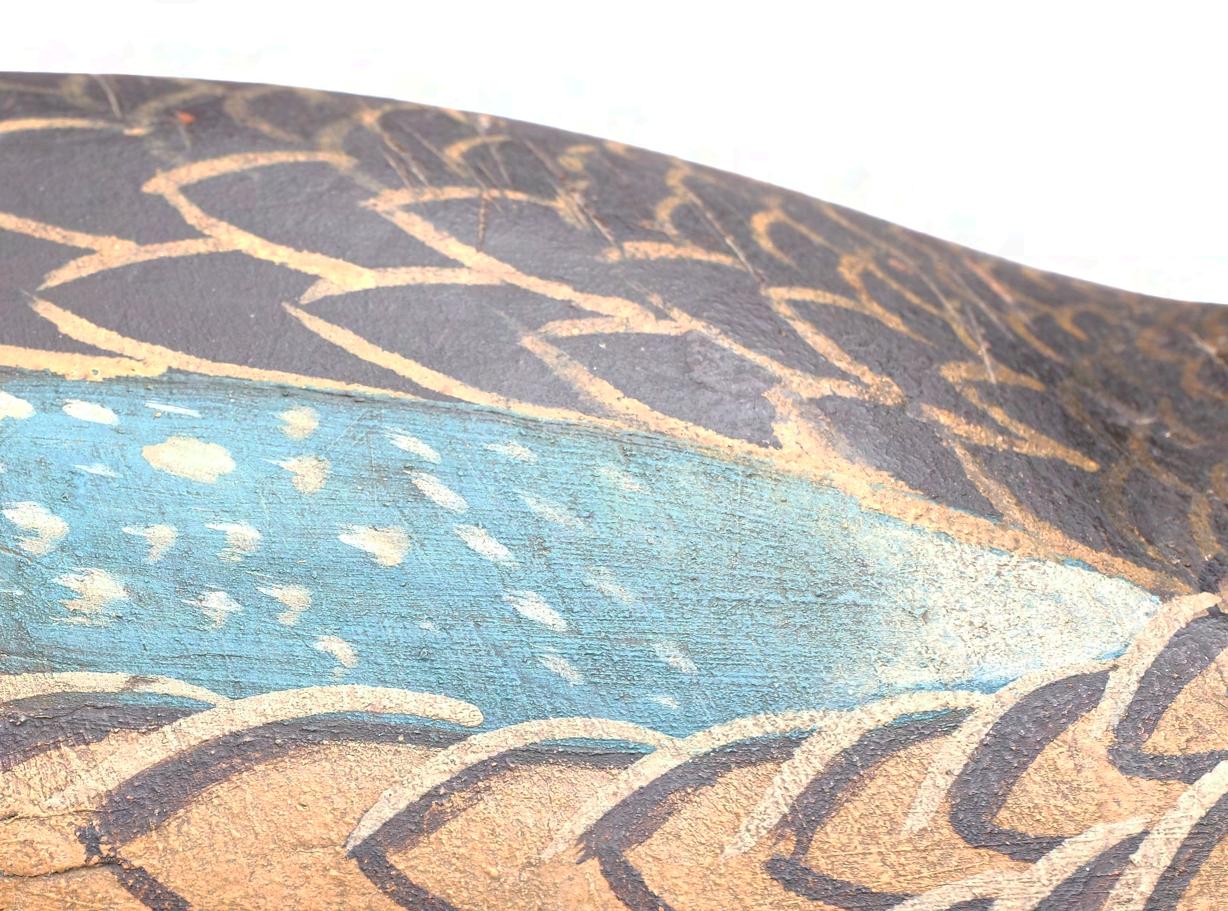
Decoys have always been an important tool in hunting waterfowl on the Upper Chesapeake. The identity of the earliest carvers from the region has long since been lost to time, but early oral histories indicate that lures were made by pioneering families with names such as Morgan, Knight, Barnes, and Bishop. The Hollys and the Howletts are among the early families that have received the most research and documentation. It is stated by many that the Hollys of Havre de Grace deserve the credit as being the innovators of the Harford County style of decoy.
The Holly family patriarch that was known to have carved decoys was John Holly (1818 – 1892). He is often referred to in the collecting world as “Daddy” Holly, apparently a nickname originally used by his family members. He produced decoys not only for his own use but for some of the more famous gunning scows and notable Upper Bay gunning clubs hosting hunting parties on the Susquehanna Flats. Articles published as early as 1853 reference him as one of the most respected duck hunters from Havre de Grace. He owned two large boats that may have served as accommodations for visiting hunters. These guests undoubtedly shot over decoys produced by “Daddy.” He and his wife Amanda had three sons – William, James T., and John W., Jr., and a daughter, Amanda. Census records indicate he was a “carpenter” and a “fisherman” – both occupations that would lend themselves to decoy production. While it is unclear how many decoys he produced both for himself and for others, there were, apparently, several unfilled orders upon his death. It is believed that these orders were completed by two of his sons; William and John, Jr. The extent of the carving beyond this by these two brothers is unclear and they seem to have scratched out an existence being employed primarily as painters and wall paperers.
His middle son, James, however, is well known as a somewhat prolific carver of decoys of exceptional quality and finish. He was also the most financially successful of the three brothers, having several stock investments and real estate holdings. His primary occupation was that of boat building, and he and George Howlett owned the two largest, best known boat yards in Havre de Grace. James is credited with making the most seaworthy, yet trim, bushwhack boat on the Flats, and his crafts were said to be unequaled in the water. Workers in his yards constructed boats for many of the well known hunters of the time, such as members of the Barnes, Poplar,
Heverin, and Heisler families. By 1901, a total of 197 boats had been produced under his supervision. In addition to boats, the yards also constructed a significant number of sink boxes for market hunters, guides, and clubs for use on the Flats. In fact, his obituary credits Jim as being the designer of the coffin shape for this device.
James Holly catered to all the needs of the local watermen and visiting sports with not only the necessary boats and boxes, but by supplying them with the large numbers of the decoys needed to complete the rigs. Some of his orders were for decoys purchased by “The Philadelphia Ducking Club,” “The Spesutia Island Club,” the “San Domingo Club,” and for members of the “Currituck Club”(3) among others. James and his brothers undoubtedly learned how to make decoys from their father and, at some point, it is very easy to imagine some form of collaboration by various members of the family. James, however, is often the son credited with being the most accomplished carver. According to Bob Shaw, “Jim Holly refined the style set by his father, making some of the most elegantly carved and painted decoys ever to ride American waters.”
James Holly’s artistic talents extended beyond the production of boats and decoys. He is known to have painted signs, and he produced one of the most famous of all paintings depicting sinkbox shooting on the Susquehanna Flats. He was also concerned with protecting this sport on his neighboring waters for, in 1884, he was listed in the court records as being a member of the Ducking Police for the Harford County side of the Flats. He, his wife, and two daughters lived on Market Street in Havre de Grace, a mere two blocks from the waterfront.
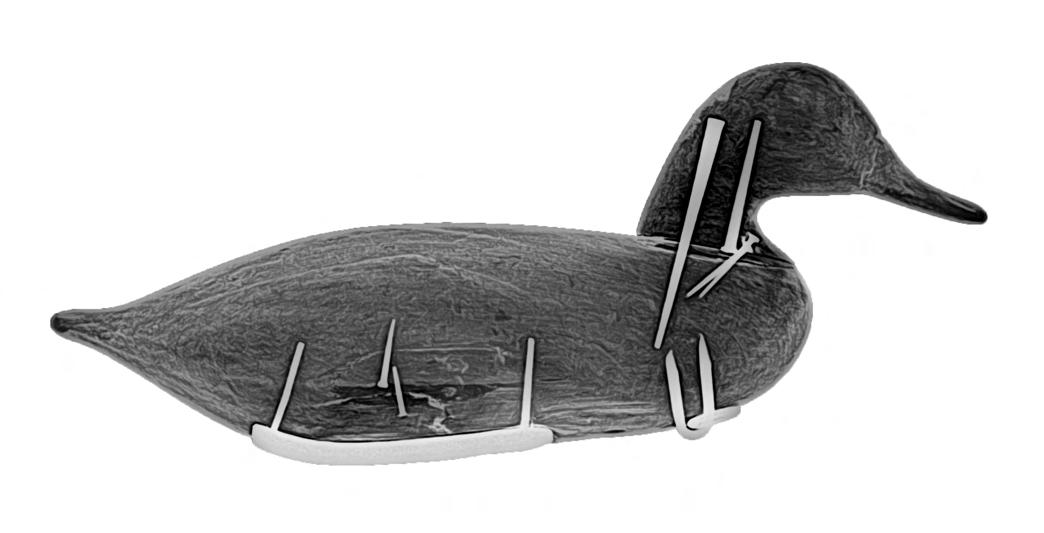
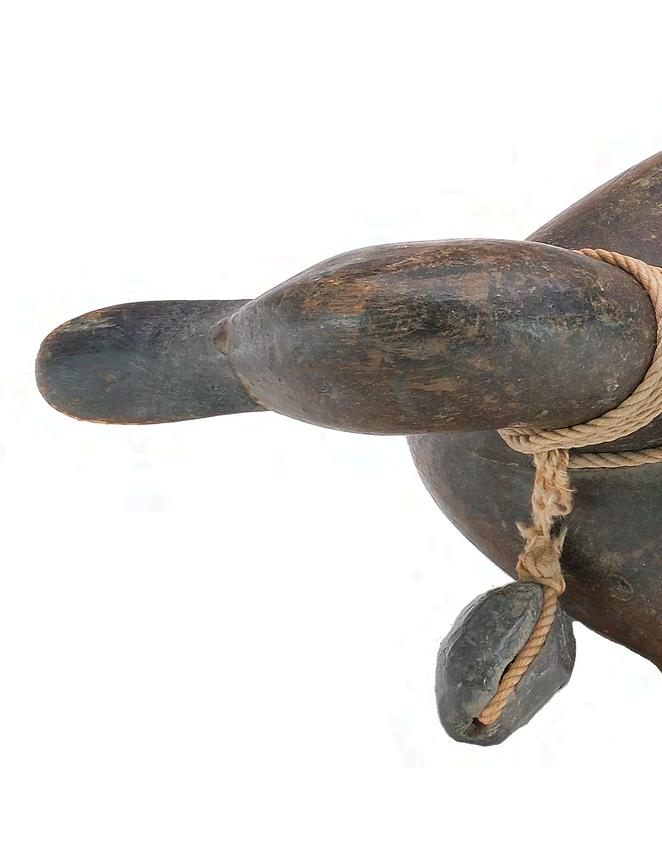
James T. Holly (1855-1935), Havre de Grace, Maryland. Rare bluewing teal hen in slight swimming pose with scratch feather paint detail. Decoy retains the original rigging just as it was used. Measures 12.5” long. Original paint with minor gunning wear; chip in underside where a small nail was added to secure a separation in the wood grain; slight separation to a small knot in underside.
Provenance:
Jim and Pat Doherty collection.
Alan and Elaine Haid collection. (15,000 - 25,000)


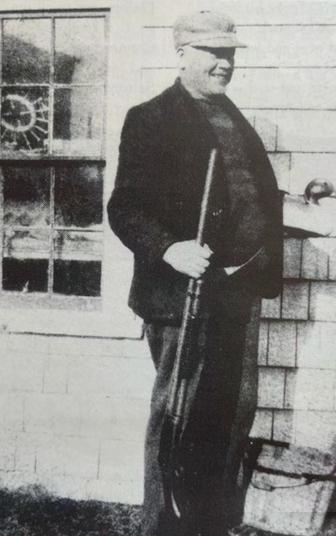
“But although the crude, old time decoy still is used, it is no longer necessary to use him. The modern wooden decoy, if he is intended to look like a goose, does look like one. If he is intended to look like a duck, like a duck he looks. And, I believe – yes I am sure – that, in our part of New England at least, the credit for this change from a caricature to a portrait is due to one man, Elmer Crowell”.
Elmer started to carve his first decoys as early as 1876 when he proclaimed “At fourteen my father bought a large tract of land on the south shore of Pleasant lake in East Harwich. I had only six live decoys that first season. I made nine block decoys and put them off about thirty yards in the lake” . This was to be the start of a long and fruitful career that would, ultimately, earn him the title of “Father of American Bird Carving”.
Until the 1890’s Elmer, like his father, listed himself as a “Mariner”, a common label on the outer Cape at the time. From the 1900 census through at least the 1920 Federal record he states that he was a “cranberry farmer”. What does not seem to appear in any genealogical record is that he was also a well-known market hunter and an exceptional trainer and handler of live decoys. These two skills brought him into contact with a number of wealthy sportsmen who sought him out to manage their private “Gunning Stands”. These were elaborate hunting clubs complete with a comfortable camp, extensive blinds, pens for live decoys and storage sheds. These operations required a full-time manager during the lengthy hunting season. Fortunately for Elmer, this schedule fit rather well with his cranberry farming.
Wooden decoys were certainly well-known during Elmer’s younger years and, in fact, one early author states that at an early age “He had made hundreds of decoys and he had orders to make more” . At some point around 1905,
however, he pondered, “Why not make some good ones and charge accordingly” . His creativity unleashed, he made birds with heads turned in a variety of poses, used better eyes and accurately imitated their natural plumage and coloring. When finished, he shipped the order to a wealthy customer explaining why the amount of his bill was considerably greater than his former bills had been. “The result was that almost immediately, he received orders for more decoys of that kind from that customer and more and still more from that customer’s friends” . Starting around 1898, these early affluent customers would include such well known names as John C Phillips at his Wenham Lake and Oldham Pond stands, “The Three Bears”, Charles Ashley Hardy, H Windeler and L Underwood at their stand on Pleasant Lake and Horatio duMont at his Cliff Pond stand. As his fame and influence spread, the number of stand locations and names expanded to include a long list of influential men from New Hampshire to the Massachusetts - Rhode Island border, including names such as Cunningham, Nickerson, Long, Williams, Willard, French and scores of others.
These patrons demanded (and could afford) the finest of hunting accoutrements, including decoys, and it was for these individuals that Elmer produced some of his very finest carvings. These exquisite early works, however, were labor intensive. By 1920 demand for his decoys had become explosive. Crowell was now listing his occupation as “manufacturer of decoys”. The increased workload
forced him to eliminate much of what made these early carvings so special, and he was compelled to simplify his designs. His groundbreaking early works are best exemplified by his so called “chip carved birds”. These were only made for a very short period of time around 1905 - 08 and were destined for only a select group of his very best customers. Some, undoubtedly were treasured items, left to adorn a favored mantel place. Most, however, were actually gunned over and it is extraordinarily rare to find examples in pristine, original condition.
At the time of Elmer’s death, his fame had spread nationwide with his obituary being printed in distant locals such as Minneapolis MN, Washington DC, Bangor Maine, and others. A deserving tribute.

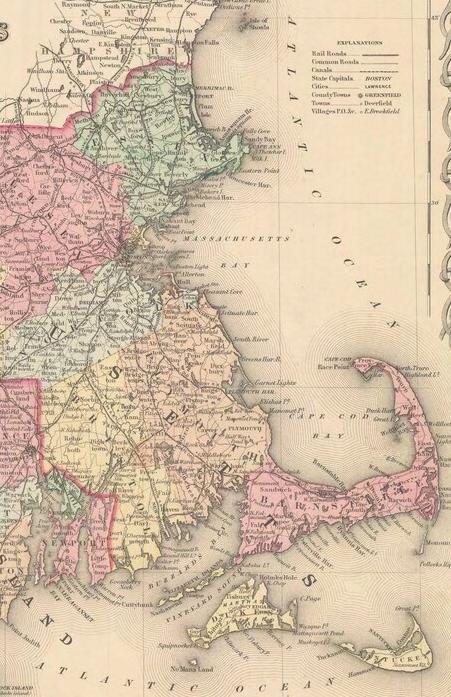
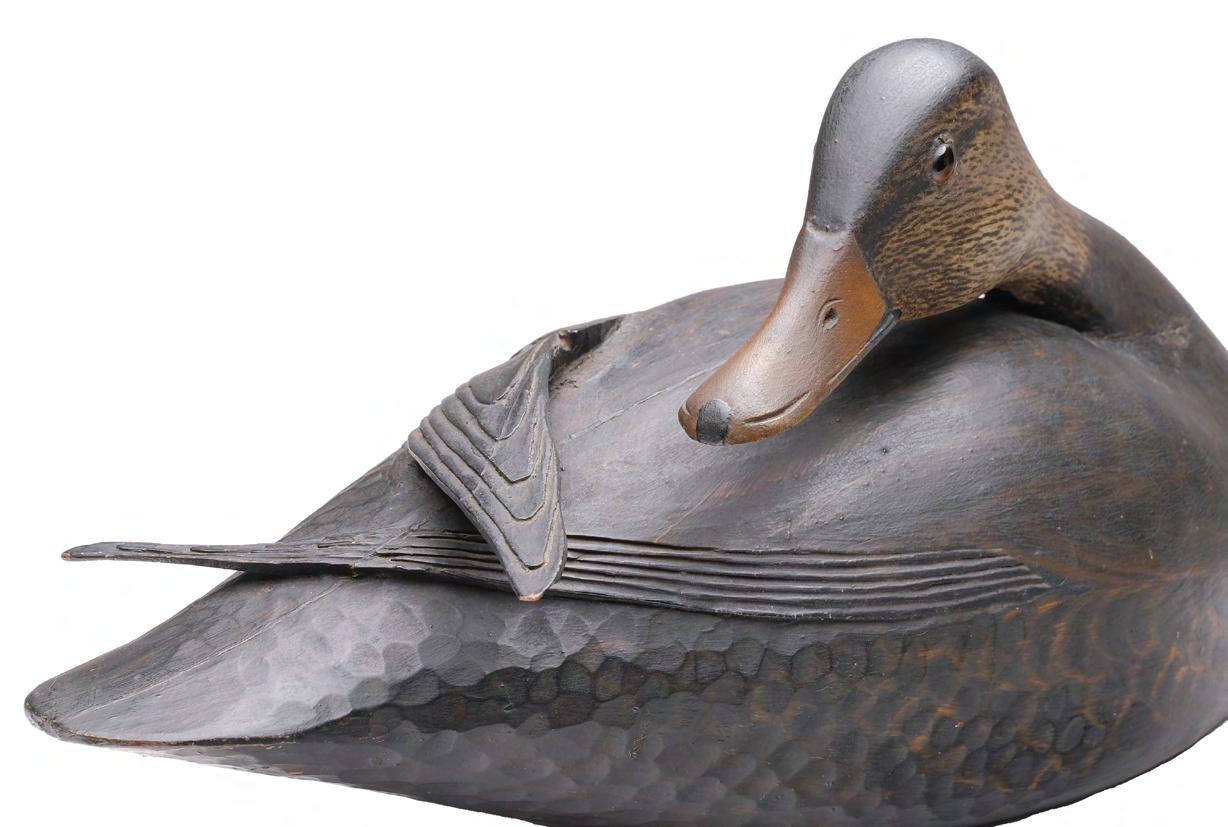 Great Bay
Wenham Camp
Pleasant Lake
Oldham Pond
Cliff Pond
Great Bay
Wenham Camp
Pleasant Lake
Oldham Pond
Cliff Pond
23
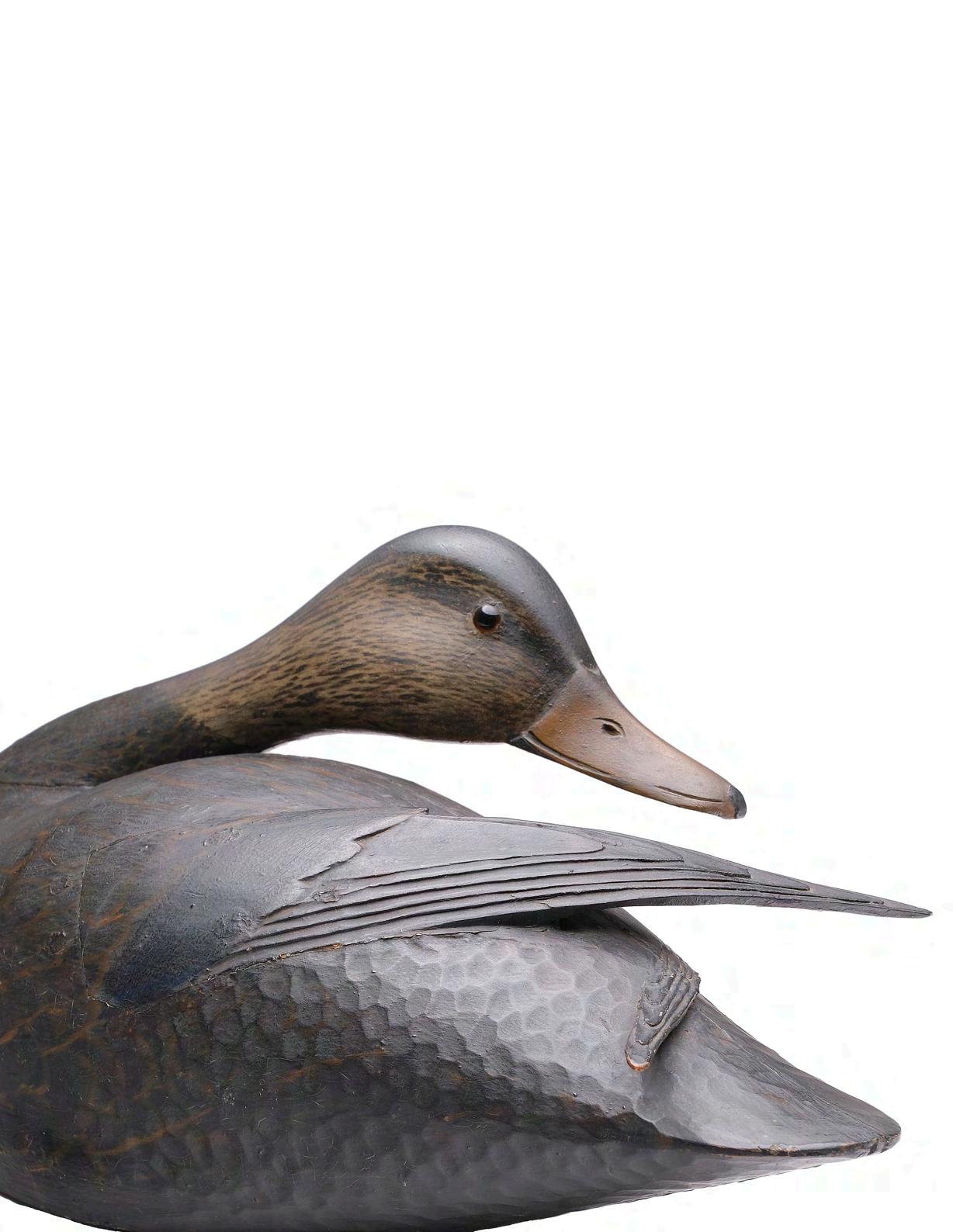
A. Elmer Crowell
East Harwich, Massachusetts. Exceedingly rare and outstanding, preening black duck, circa 1905. With head turned back to preen two inserted and crossed wing tips. Relief feather carving on raised wing tips. Chip carving on tail area, as seen on the artists earliest black ducks. Made for one of Crowell’s important patrons, Stanley S. Smith. Believed by many to be Elmer Crowell’s finest achievement. A series of numbers in invisible ink on the underside. Measures 16.5” long. Excellent original paint under an early coat of varnish; tight filled crack along the back from when the decoy was made; tightly reset chip in larger raised wing with small amount of touch up at seam; a spot of flaked filler on one side where raised wing is inlaid into body with old touch up; drip of varnish on one side.
Provenance:
Passed down in the Smith family. Alan and Elaine Haid collection.
Literature:
“New England Decoys”, Shirley and John Delph, page 114, exact carving pictured.
“Massachusetts Masters: Decoys, Shorebirds, and Decorative Carvings”, Ward Museum of Wildfowl Art exhibit publication, front cover and page 71 and 72, exact carving pictured.
“Elmer Crowell: Father of American Bird Carving”, by Steven B. O’Brien, Jr. and Chelsie W. Olney, page 27 and 233, exact carving pictured. (300,000 - 500,000)

1869 – 1941 | Boston And So Orleans, Mass.
Born in Boston, Stanley was accustomed to the finer things in life. His father was a successful leather manufacturer with a home in the prestigious community of Back Bay. The family enjoyed the services of three servants and, for a brief period, maintained a home in Cohasset, a coastal suburb of Boston.
As an adult, Stanley too was comfortable. He is listed in the census as a salesman in a note brokerage, a property investor, and a banker. In 1916 he married Irish born Nora Kathleen Johnstone (1887 – 1972). He was 47 and she 29. Like his parents, he too lived in the Back Bay and, according to the 1930 census, employed a governess, a cook, and a waitress.
Photos record him hunting on Cape Cod, presumably in Orleans, very close to Crowell’s shop in Harwich, as early as 1901. After his marriage he and his family summered on the Cape with a home in So. Orleans.
He hunted with a number of early Crowell patrons and, like them, relied on Elmer for his decoys.

Like his early working duck decoys, Elmer Crowell’s earliest shorebirds exhibit relief carved primary feathers along the wings. This extra detail would certainly add to the amount of time it took to complete a carving and fill an order. As Crowell’s popularity grew and demand for his work increased, he abandoned this extra, time-consuming detail.
As the Haid’s began refining their collection, Alan decided to focus on Elmer Crowell’s earliest and much more rare, carved wing shorebirds. Selling off a few later examples to purchase one with carved primaries. The following two lots are outstanding examples of Elmer Crowell’s earlier works.
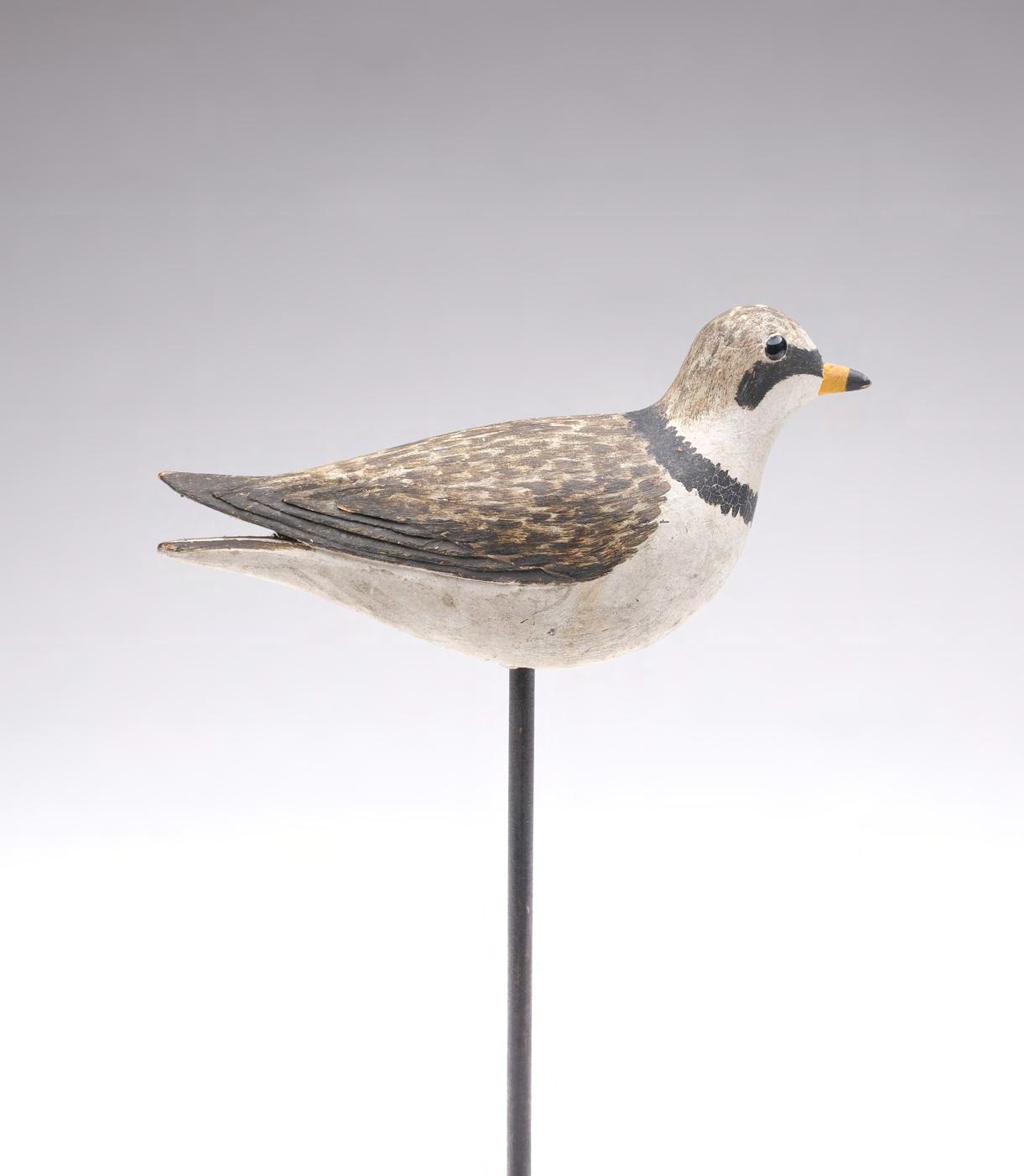

24
A. Elmer Crowell (1862-1951), East Harwich, Massachusetts. Exceedingly rare semi palmated plover with split tail carving and relief carved primaries. Circa 1910. This is the only known semi palmated plover with carved primaries. Measures 7.25” long. Excellent original paint with almost no wear; small amount of tight crazing on neck and breast; tiny paint flake at tip of bill and raised wingtips.
Provenance:
Russ and Karen Goldberger collection. Alan and Elaine Haid collection. (70,000 - 100,000)

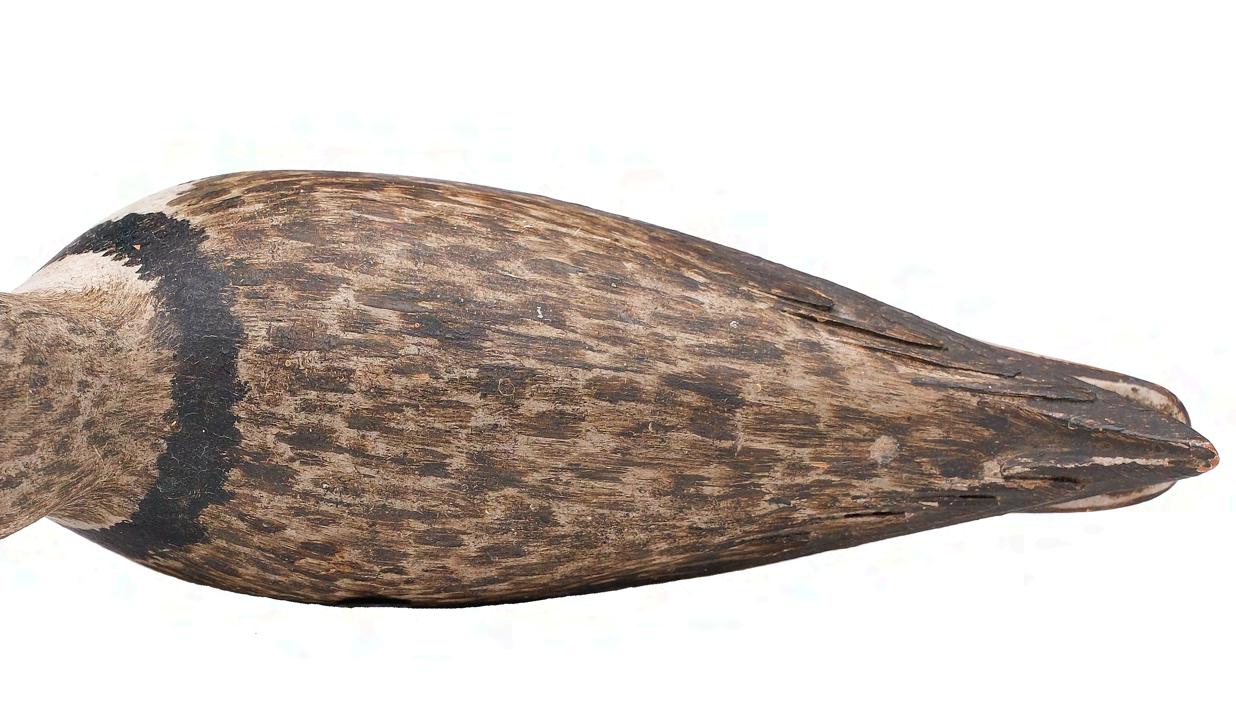
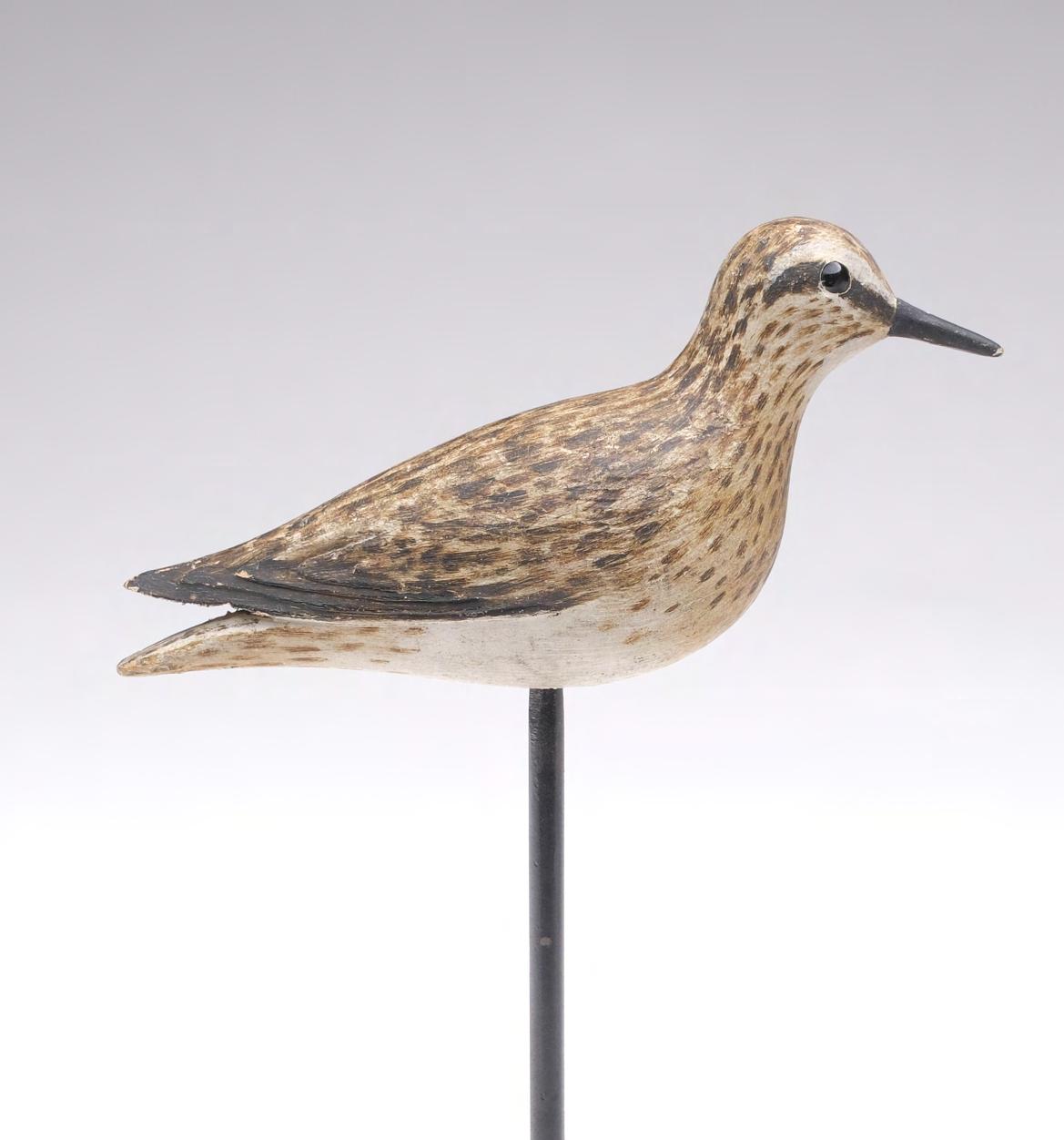

25
A. Elmer Crowell (1862-1951), East Harwich, Massachusetts. Outstanding least sandpiper with split tail carving and relief carved primaries. Circa 1910. A tiny working shorebird at only 6.5” long. Excellent original paint with very minor wear; paint flake at tip of bill and raised wingtips; excellent structurally.
Provenance:
Alan and Elaine Haid collection. (60,000 - 90,000)



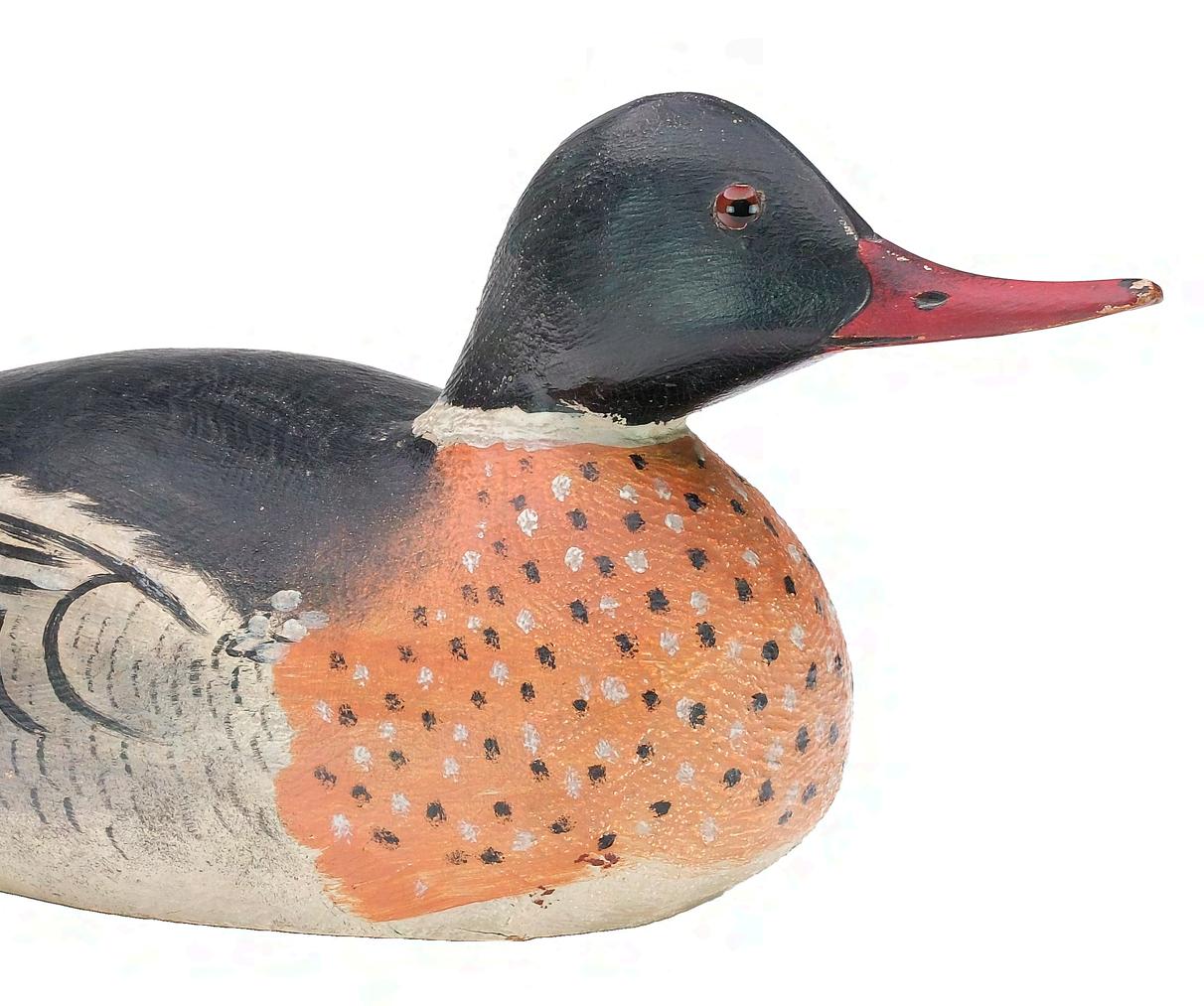
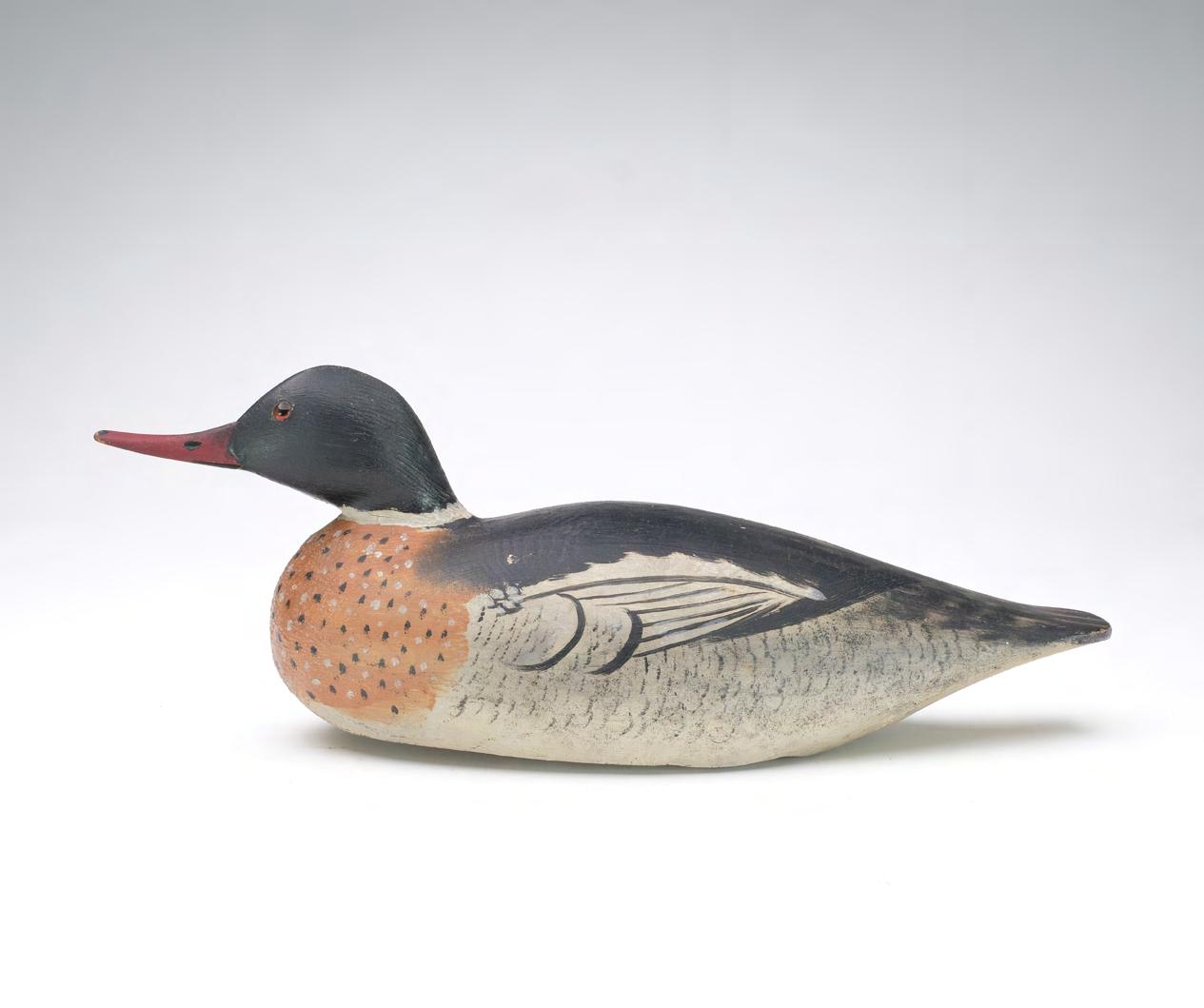
26

A.
Red-breasted
circa 1905. Pre-brand example with head in slightly tucked and forward head pose. From the rig of Frank Gilbert Hinsdale (1874-1940), Mattapoisett, Massachusetts. Measures 18” long. Original paint with almost no wear; hairline separation in one side of neck seat; tiny amount of flaking on tip of bill and tail.
Provenance:
Ted and Judy Harmon collection. Tom Winstel collection.
Alan and Elaine Haid collection.
Literature:
“New England Decoys”, Shirley and John Delph, page 118, exact decoy pictured.
“Top of the Line Hunting Collectibles”, by Donna Tonelli, page 86, exact decoy pictured. (40,000 - 60,000)
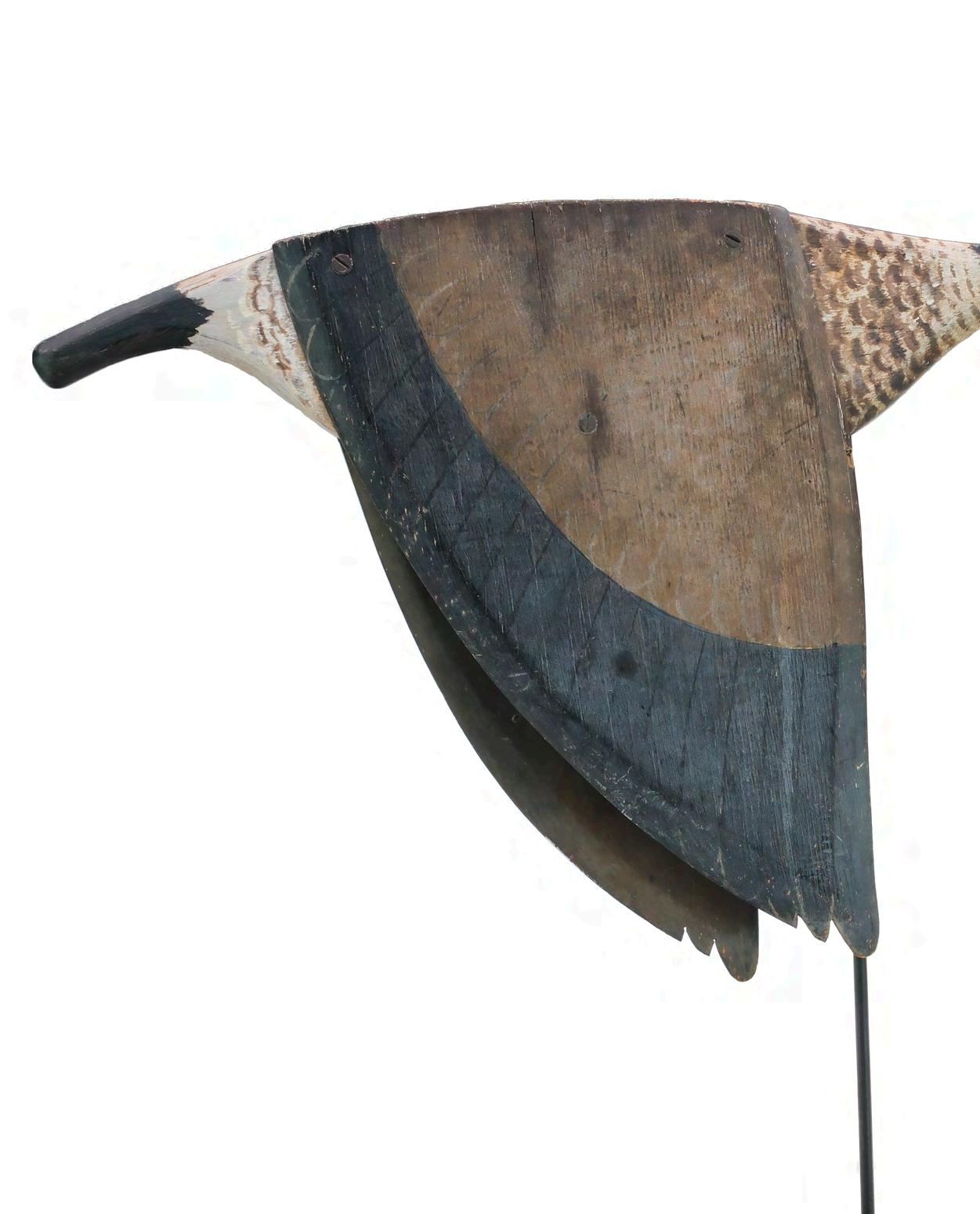
A.
East Harwich, Massachusetts. Rare flying Canada goose weathervane. With applied wings, tack eyes, and metal grommet at stick hole. Measures 29” long. Original paint with minor wear; hairline cracks in top of wings; some filler
of one wing that was used in the making has flaked some.
Provenance:
Alan and Elaine Haid collection. (20,000 - 30,000)
27 Elmer Crowell (1862-1951), on edge
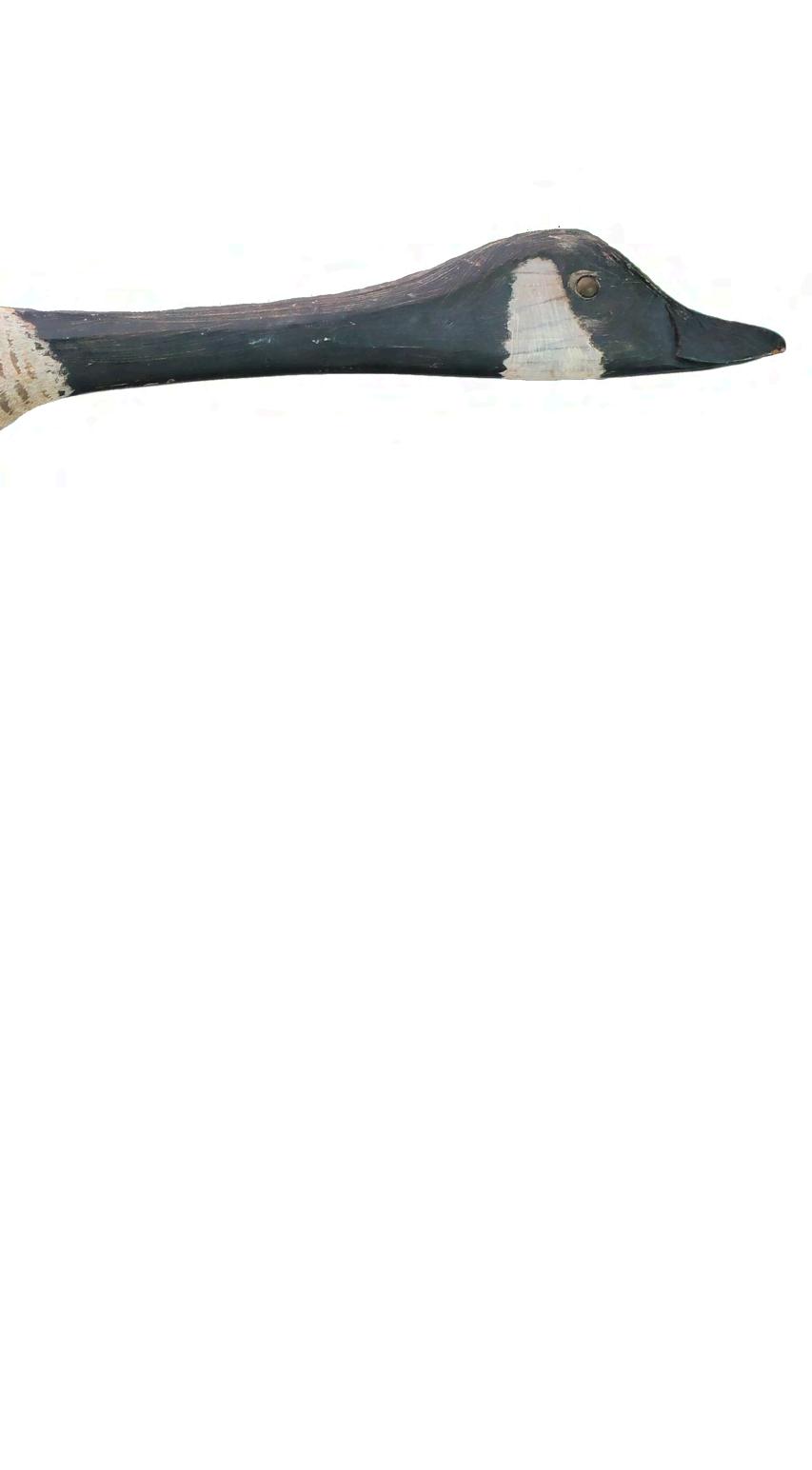
Shang Wheelers artistic efforts were many and, seemingly, entirely self-taught. He was an accomplished artist and carver of both waterfowl and fish. His decoys were particularly exquisite for their day. He followed the lead established by his predecessors, Albert Laing (1811 – 1886) and Ben Holmes 1843 – 1912), however, it was a classic case of the student surpassing the teacher. He went on to win almost every decoy carving contest of his day, beginning with the Bellport (NY) Decoy Show in 1923 and continuing with a lengthy string of multiple year ribbons at the National Sportsman’s Show in New York City, culminating with his taking the grand prize there in 1947. He voluntarily stopped entering, claiming “it’s time to give someone else a chance”. He became the undisputed leader in the “Stratford School” of carvers that were to follow. Numerous individuals sought his advice and went on to produce many fine decoys in their own right – some are credited with producing decoys equal to that of Wheeler. Shang carved purely for his own enjoyment and is not known to have ever sold a decoy. In fact, he once turned down an offer by auto magnate William Chrysler of $15,000 (worth well over $100,000 today) for thirty pair of his waterfowl. Normally, if a friend admired one of Shang’s decoys, he would give it to them.
28
Charles E. ‘Shang’ Wheeler (1872-1949), Stratford, Connecticut. Extremely rare and outstanding canvasback hen. In preening pose with excellent detailed head carving and slight relief wing tips. Hollow carved with comb feather paint detail, including on the underside. Retains the original leather line tie and Stratford style “tear drop” weight. Measures 14” long. Very minor paint flakes on top of head and edge of tail, otherwise excellent and original.
Provenance:
Connecticut Audubon collection.
Jack Mitchell collection.
John Delph collection.
Alan and Elaine Haid collection.
Literature:
“Decoys: North America’s One Hundred Greatest”, by Loy S. Harrell Jr., page 146-147, exact decoy pictured.
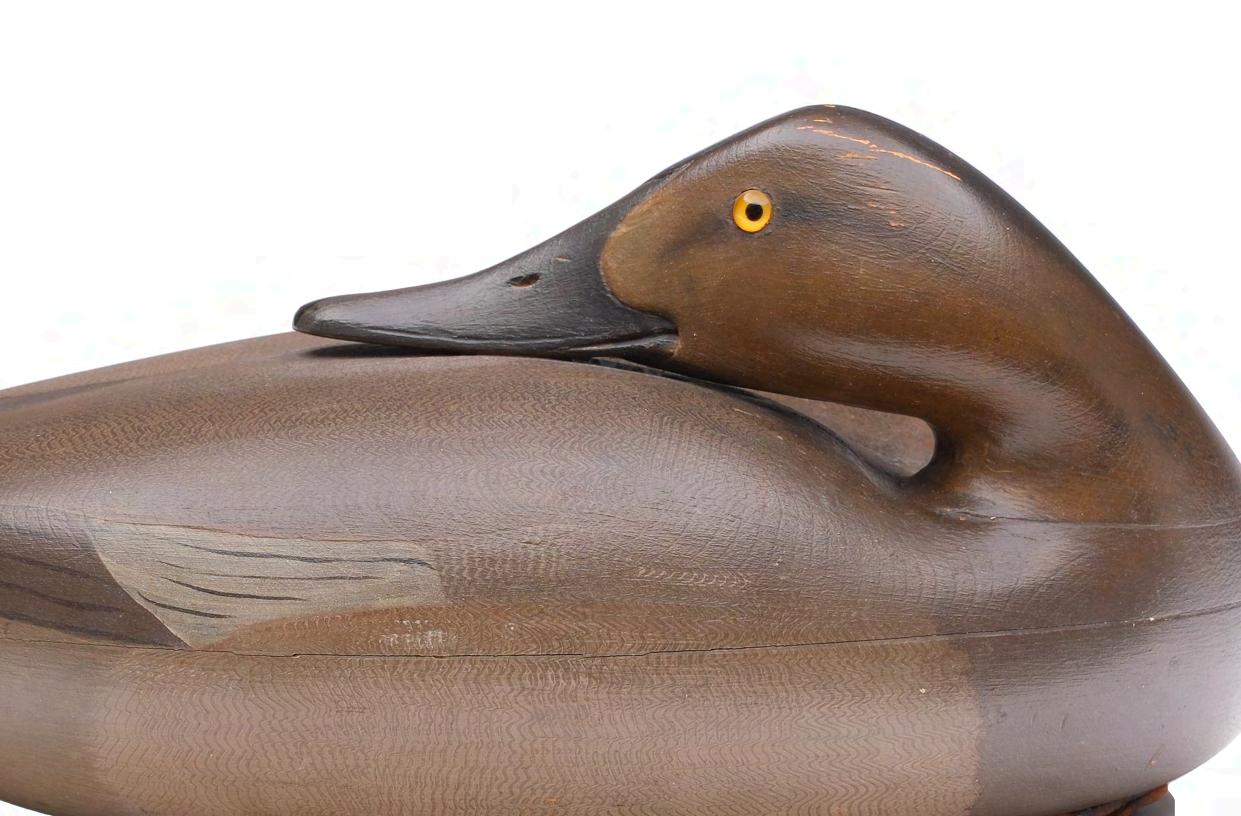


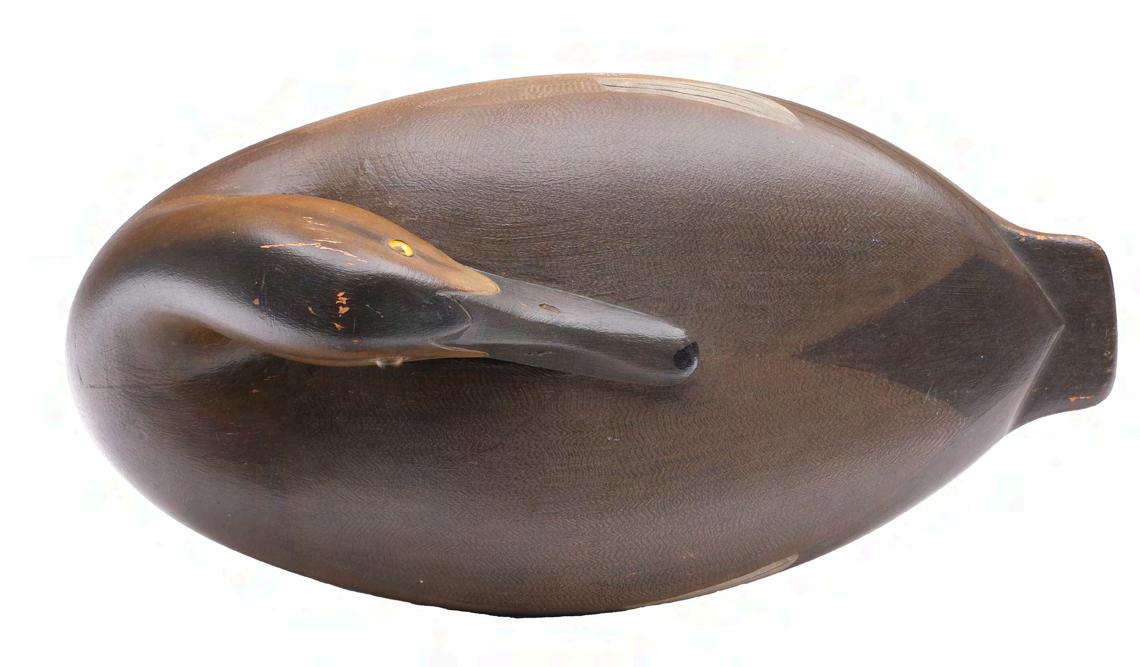
Milford, CT is located at the mouth of the Housatonic River directly opposite its more famous neighbor, Stratford. It was here, in 1847, that George Trent Smith (1824 – 1894), a former blacksmith from Fairfield, CT decided to build a resort hotel at the end of a long, deserted spit of oceanfront land bordered by Long Island Sound to the south and the extensive tidal marshes and islands at the mouth of the river to the north. Known as the Milford Point Hotel, the property prospered, catering to affluent guests from across the state, New York, and beyond, providing seaside accommodations, fine dining, and shore dinners while patrons simply lounged by the water, played lawn games, sailed, fished, or hunted.
The hotel was a family operation with Cassius’ mother, Sarah (1827 – 1909), overseeing the kitchen and household staff which included her daughters Mary and Louisa. Cassius and his younger brother, George Jr (1868 – 1912), served as assistant managers, as did their uncle, William Minor (aka Minor) Smith (1831 –1905). Ultimately, each man would serve as manager upon the death of George Sr. The hotel was Cassius’ life. He never married and was apparently active in the local sporting and social scene. A number of newspaper articles of the day indicate that he and George Jr were avid participants in the local sailing circles. One of their boats was named “Gold Leaf”, suggesting that it was quite well appointed. Cassius was a known hunter as indicated by an April 17, 1883 article in New Haven’s Mourning Journal – Courier which reported that “Cassius Smith of the Milford Point Hotel shot two wild geese today”.
Men in the family served as guides, hunted to provide game for the hotel tables and, they made decoys. A number of birds, stylistically very similar, yet showing an evolution in design and workmanship, have been attributed to various family members. Some bearing the “S&S” brand were said by Bill Mackey to be the work of brothers George Sr and Minor. Some sport the clear “C. Smith” brand, while still others carry brands such as “D.A. Young”, a Long Island (NY) collector. Which of the four men, George Sr, Minor, Cassius, or George Jr made which bird or did collaborations take place over the years, is open to debate. Shang Wheeler, reporting in Connett’s “Duck Shooting Along The Atlantic Flyway” stated that in the 1870’s “Men such as Captain George Smith and Clark Baldwin of Milford came onto the picture with new fangled - - - guns. These men were capable gunners. Their decoys too were by now much better- - - “ . Which “Captain George” he was speaking of, George Sr. or Jr., is not clear. What is clear is that the work of these men had a profound influence on the decoys to emerge later on the opposite shore of the river and classified as the Stratford school of carving.

Chitwood chose to celebrate the family by using two Smith birds for the cover of his book, “Connecticut Decoys”. Time has anointed Cassius as the premier carver in the family, but the passage of over one hundred and ten years has undoubtedly cast a cloud over the possibility of a positive identification. Whether they are labeled today as the work of a particular individual or, simply, referred to as the “Milford Hotel rig” or “Smith family”, the decoys themselves represent some of the Nutmeg State’s finest carvings.
29

Attributed to Cassius Smith (1847-1907), Milford, Connecticut. Exceedingly rare red-breasted merganser. Thinly hollowed with extended crest and carved eyes. Long rounded neck seat with slight ice groove carving behind neck seat. Branded ‘D.A. Young’ on the underside. Measures 15.25” long. Original paint with moderate flaking and wear; small dents, flaked filler above a few screws at body seem where restored; thin line of touch up to flaking at body seam.
Provenance:
Private Museum in Mattituck, Long Island, New York.
Bud Ward collection.
Alan and Elaine Haid collection.
Literature:
“Connecticut Decoys”, by Henry C. Chitwood, page 77 and 135, exact decoy pictured.
“Top of the Line Hunting Collectibles”, by Donna Tonelli, page 82, exact decoy pictured.
“Decoys: North America’s One Hundred
Greatest”, by Loy S. Harrell Jr., page 74-75, exact decoy pictured.
(30,000 - 50,000)

Maine is known for its many independent, talented carvers. Each saw no reason to copy the work of a neighbor and, instead, produced decoys that were, strikingly, their own. This was certainly the case with “Gus” Wilson.
Born in the tiny fishing village of Tremont on Mount Desert Island in Downeast Maine, his father was a carpenter who became the lighthouse keeper at the nearby Bass Harbor Head Light. As a young man, Gus, like so many of his neighbors, became a fisherman. In 1887, he married Mary S Hopkins in Southwest Harbor, and they had one child, a daughter, Celia. Sadly, Mary died in 1909. By 1915, probably in order to properly care for his child, Wilson decided to forgo the hazardous job of fishing and sought a more stable position. Following his father’s lead, he became the assistant keeper of the Goose Rock Light on small Fox Island in East Penobscot Bay. In 1917, he was transferred further south along the Maine coast and took a very short-term position as 3rd assistant keeper at the Two Lights Station in Cape Elizabeth. Later that same year, he secured a position as assistant keeper at the Spring Point Light at the mouth of Portland Harbor. In 1919, he remarried, this time to Edna M Snow and the two enjoyed a happy marriage for the next 17 years while Gus worked at the light. Ultimately he became keeper, replacing his brother in that position. He retired from the Light House service in 1934 and once again, fate was not kind, with Edna passing away just two years later. Lonely and depressed, he remarried for a third time in 1938 when he wed Fayette Gertrude Berry in Portland. While with the Lighthouse Service, Gus and his wives always boarded in local homes or resided at the Light Station. Upon his retirement, he finally purchased a home of his own in Grey, Maine. Eventually, after a short stay in a local hospital, he died and is buried near his birthplace in Southwest Harbor on Mount Desert Island.
In true frugal Yankee fashion, Gus utilized only basic hand tools. Never using patterns, he preferred to draw out each new batch of carvings on paper, which was then discarded. He made his decoys wide, stable, bold, and durable. Heads and necks were inlet into the bodies for strength and paint patterns were simple, yet totally effective. The bottoms of his birds were often left unpainted, and the eyes were carved. Gus apparently saw no need to waste paint or purchase expensive, and what he saw as unnecessary, glass beads or buttons. His choice of wood was determined by what was available. Blemishes and knots, as well as the occasional small split were simply worked
around. He sold his birds to local gunners with the option of being unpainted (reportedly 75 cents) or painted (1 dollar). He is one of the very few Maine makers to sell his decoys through a commercial outlet, offering some of his carvings through the large Edwards and Walker Hardware Store in Portland.
Wilson’s carvings cover the widest array of forms of any of the State’s talented makers. It is difficult to imagine what a rig of his birds would have looked like afloat. His flock would have included decoys looking in almost every conceivable direction, wings were carved, and some would have one or both wings raised. Heads would be rocking, some would be feeding with a carved mussel or leather “fish” in their mouths, and some would appear to be either calling, preening, or sleeping. The total effect would have truly been that of a raft of content, live birds which would have been a siren to incoming waterfowl. The decoy being offered today comes from his “middle period” and represents Wilson at his creative peak.
In addition to some of the best of Maine’s working decoys, Wilson also carved a wide variety of local and exotic wildlife, ranging from songbirds to rattlesnakes and tigers. His work is included in elite private collections as well as in the collections of numerous important museums such as the Smithsonian American Art Museum and The Brooklyn (NY) Museum’s Decorative Arts and Design Collection.
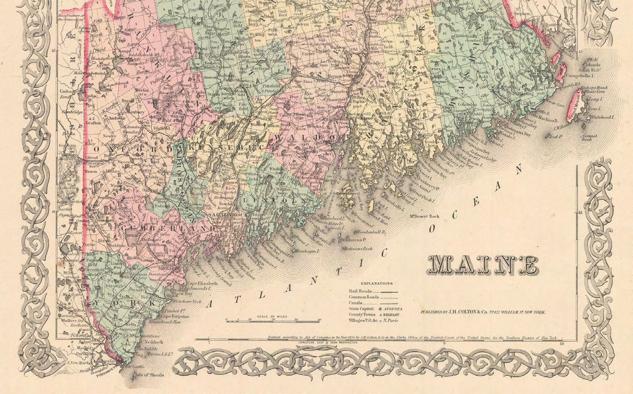


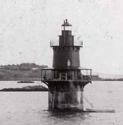
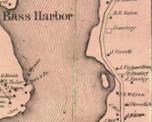

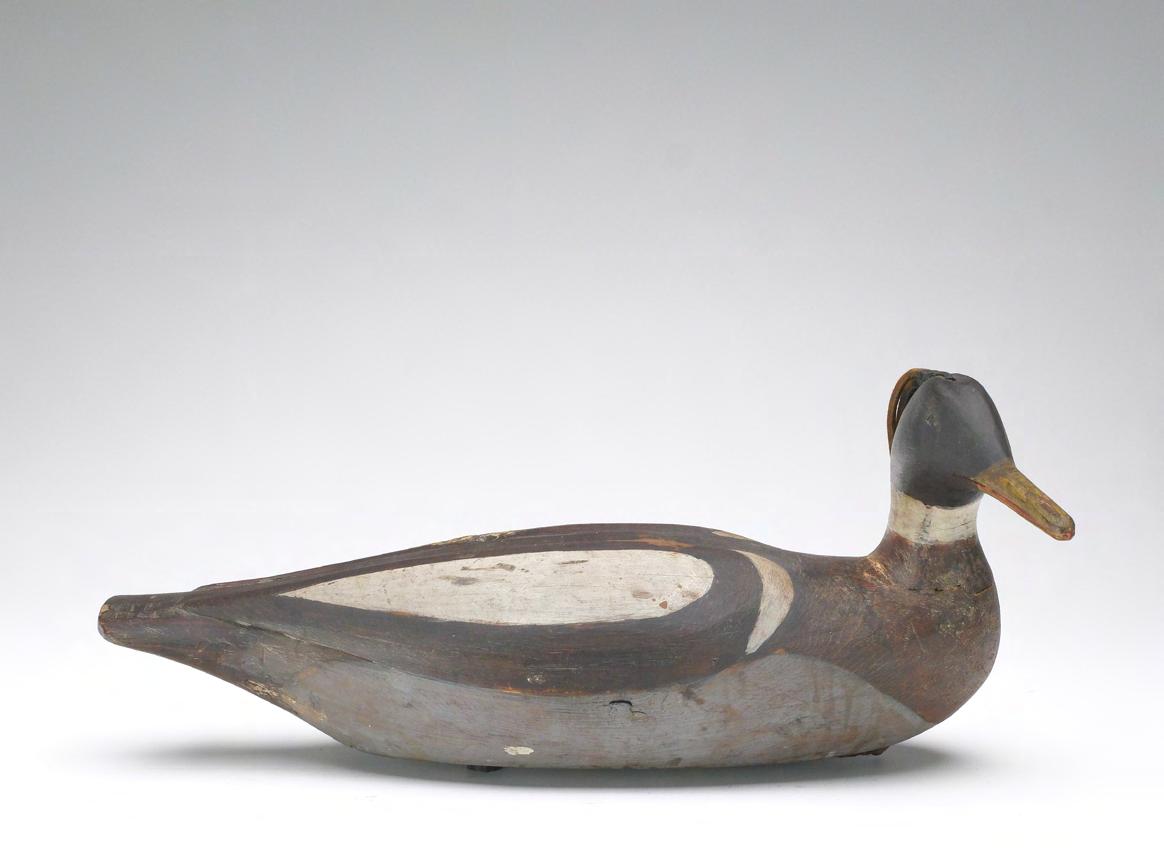

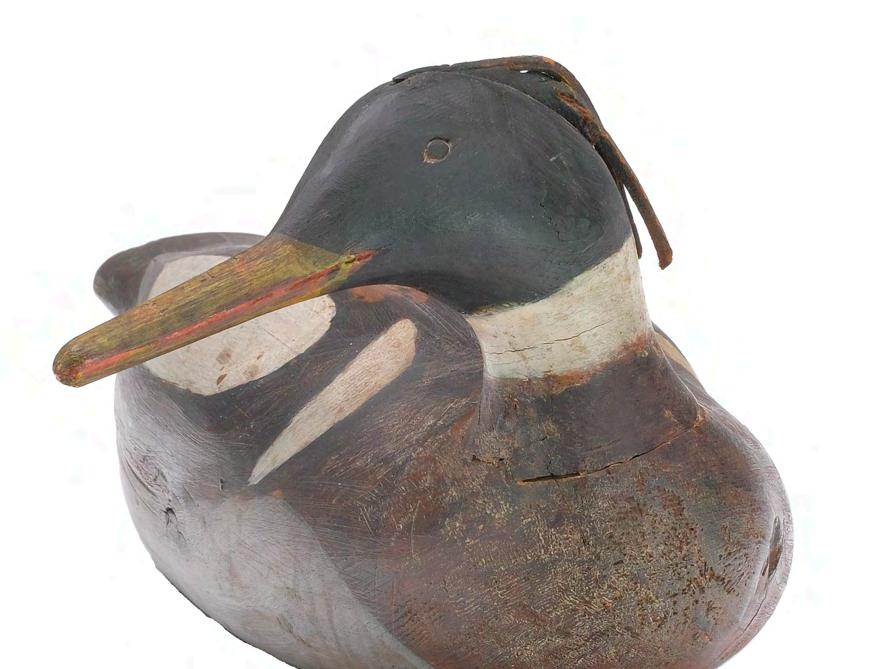
30 Augustus Aaron Wilson (1864-1950), South Portland, Maine. Redbreasted merganser drake with head turned almost 90 degrees. Relief wing carving and applied leather crest. Measures 17” long. Original paint with minor discoloration and wear; minor separation at knots in body; fine hairline crack in one side of neck; small amount of filler and touch up around neck seat.
Provenance:
Owen Earnshaw Collection.
Alan and Elaine Haid collection.
Literature:
“New England Decoys”, Shirley and John Delph, page 35, exact decoy pictured.
“Top of the Line Hunting Collectibles”, by Donna Tonelli, page 58, exact decoy pictured. (12,000 - 18,000)

In Harry’s lifetime, Tuckerton was, literally, at the end of the line. Located along Tuckerton Creek which flows into Little Egg Harbor Bay, it was at the terminus of the small Tuckerton railroad. Few roads linked the hamlet to the rest of the State and life was tied to the water. Many of Harry’s neighbors were recorded in the census as working as an “oysterman”, “bayman”, or a similar occupation and his father was a “yachtsman”. For whatever reason, Harry chose the path of working as a carpenter or a painter, at least that is how he described himself in every census record that can be located. Ironically, the man that is most famous as one of New Jersey’s premier carvers, never formally listed himself as a decoy maker. Born in 1861, he married a local girl, Mary Agnes Bartholomew in 1884 (see note 1) and the couple would have five children, one of which tragically died at age two. The family home was located on Water Street, directly on Tuckerton Creek, which gave Harry ready access to the Bay, its islands, and its marshes.
One can imagine that there must have been relatively little demand for a house painter in the small, hardworking community of Tuckerton which had only about 250 families in the 1900 Federal census. Harry quickly realized, however, that there did exist a need for a significant number of decoys, both locally and beyond, and his carpentry and painting skills certainly would have enabled him to enter into full-time production to meet the demand.

Surprisingly, very little has been written about this famous Garden State carver. Like with so many other makers, initial information was often erroneous. As late as 1975, authors Bill Mackey and Dr Starr both referred to him as “ Shourdes ” and spelled his middle name as “ Van Nuckson ” . No one seems to be sure when he made his first decoy, but in 1965 Mackey wrote that “ From his shop flowed decoys by the hundreds of dozens and this continued for over twenty years ”. Assuming that this statement is true, then his initiation into commercial decoy carving would have occurred at some point in the late 1890’s. Mackey continues to discuss Shourds’ output when he states that he (Shourds) “ was the largest shipper on the railroad serving Tuckerton ”. These few meager statements would suggest that his lifelong production may have amounted to something in the neighborhood of 4000 – 5000 decoys. This would place him as one of, if not the most prolific New Jersey carver. Mackey stated that “ Nuck did not make the first decoys used in these parts - - - he did not make any significant changes in decoy design or construction. He simply made them as good or better than the other makers ”. All writers since have echoed his remarks. Joe French proclaimed that Shourds’ decoys were “ - - - the finest of New Jersey carvings ” and, more recently, Jim Doherty, too, felt that “ - - - he (Shourds) produced many of New Jersey’s finest carvings ”.
Being in the business of selling decoys, Harry concentrated his efforts on those species most in demand, these being blacks, geese, brant and bluebills. Beyond these four, his numbers fell off rapidly with birds such as buffleheads and red-breasted mergansers being considered scarce and rare. Practically all of Shourds’ decoys carried the head in the standard “straight forward” position. Swimmers, such as the Haid goose presented here, are very rare. Meant as confidence birds, his working Herring Gull decoys, of which only two are known, must be considered among the greatest of decoy treasures. The Shourds decoys in the Haid collection certainly represent some of his very finest work.
Notes: 1. Harry referred to her as both Mary and Agnes.



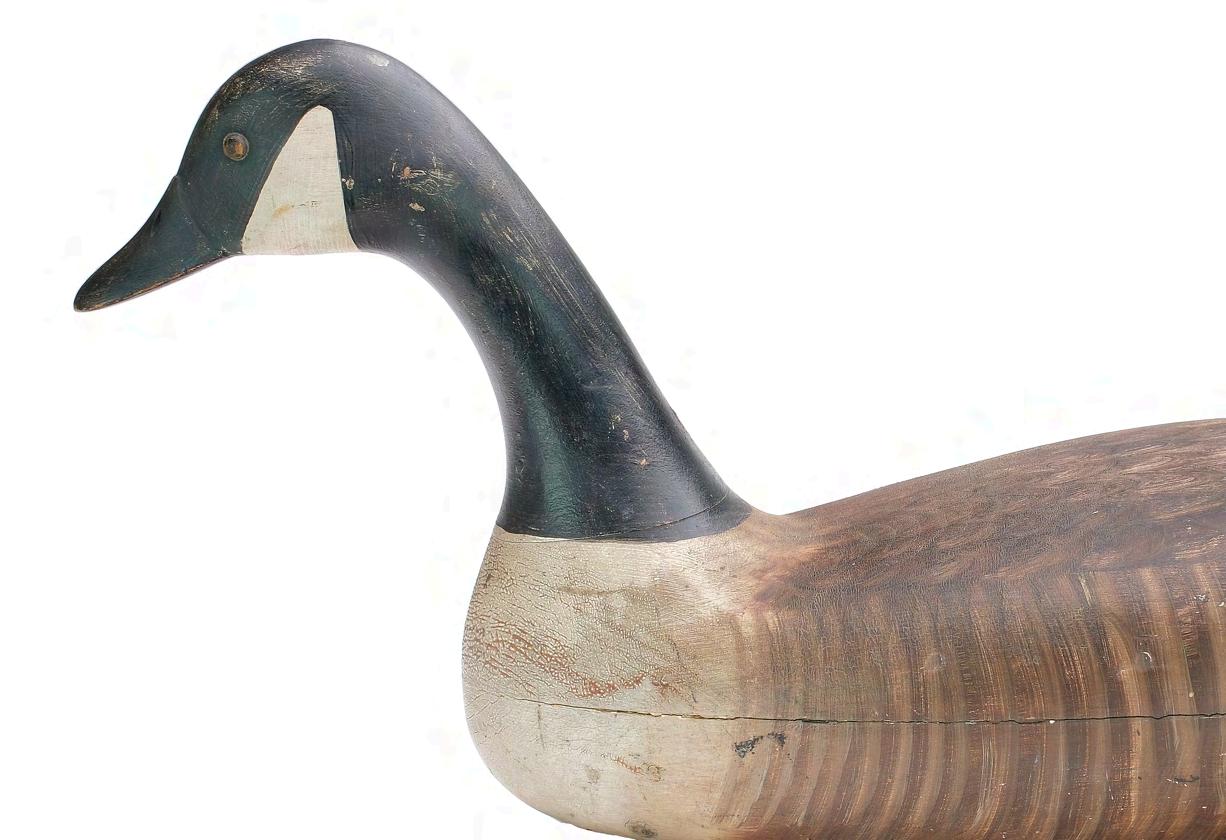


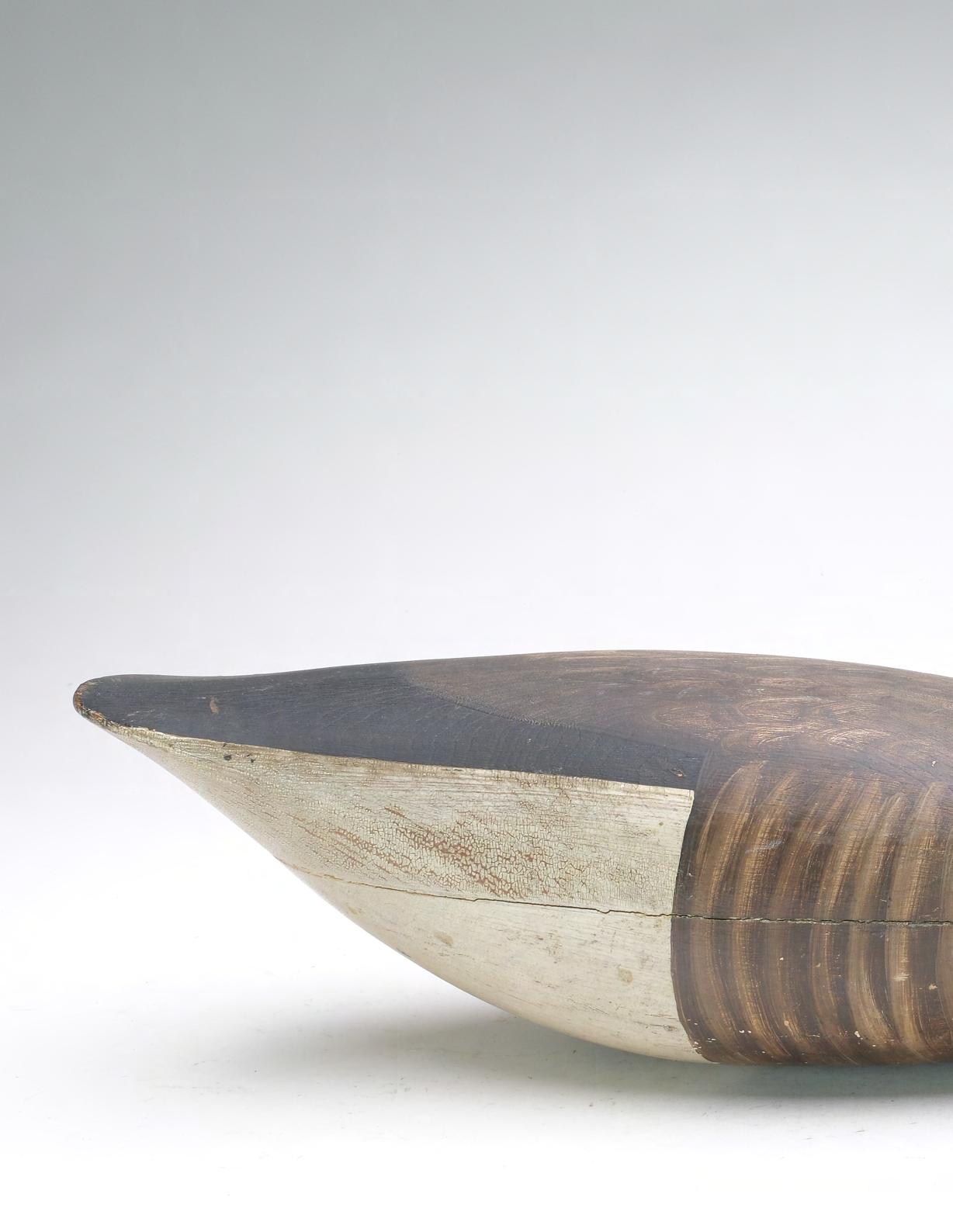
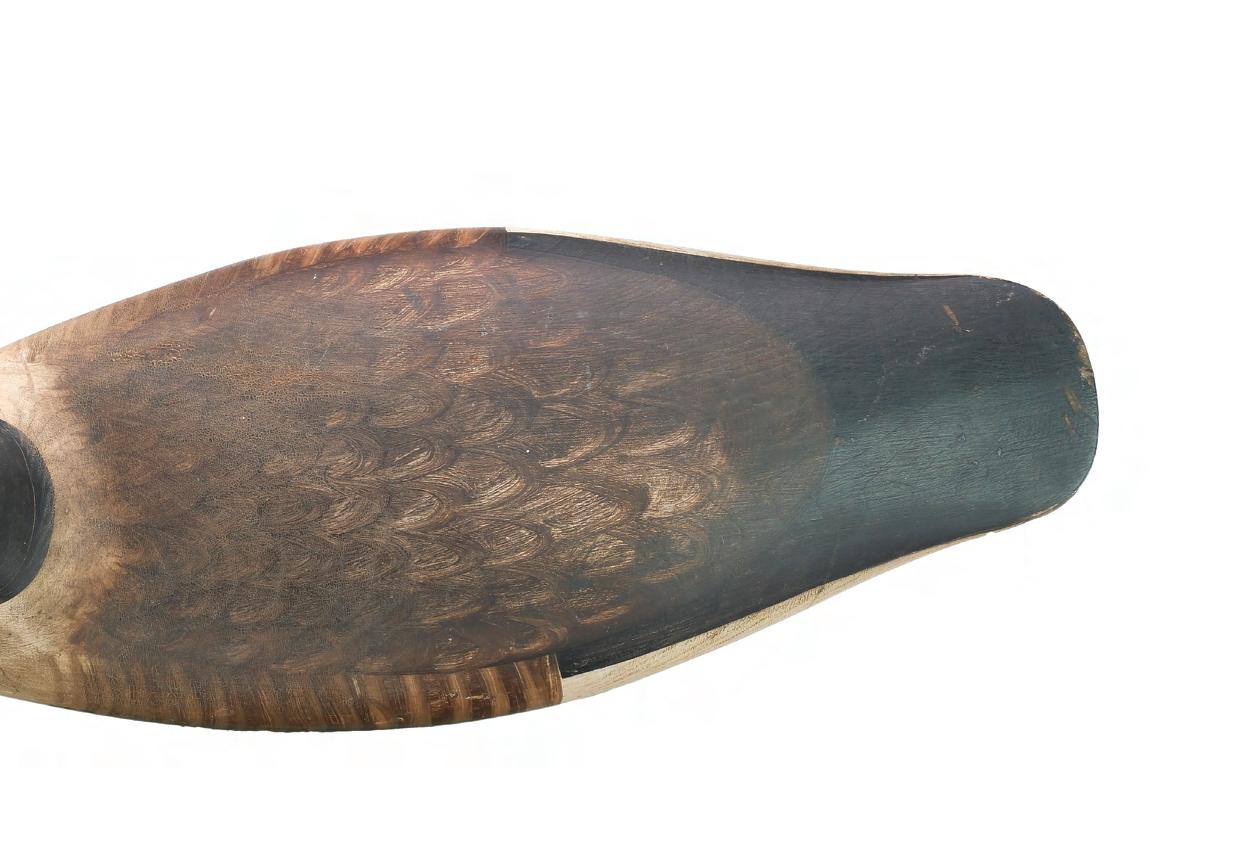
Harry V. Shourds (1861-1920),
Tuckerton, New Jersey. Exceedingly rare swimming Canada goose. One of only two known in swimming pose. Hollow carved with tack eyes and inlaid lead weight on underside. Measures 25.5” long. Excellent original paint with moderate crazing on body; fine hairline crack in tip of bill was tightened with small amount of touch up.
Provenance:
Malcolm J. Fleming collection.
Alan and Elaine Haid collection.
Literature:
“Top of the Line Hunting Collectibles”, by Donna Tonelli, page 5 and 60, exact decoy pictured.
“Classic New Jersey Decoys”, by James R Doherty, page 34, exact decoy pictured. (90,000 - 120,000)


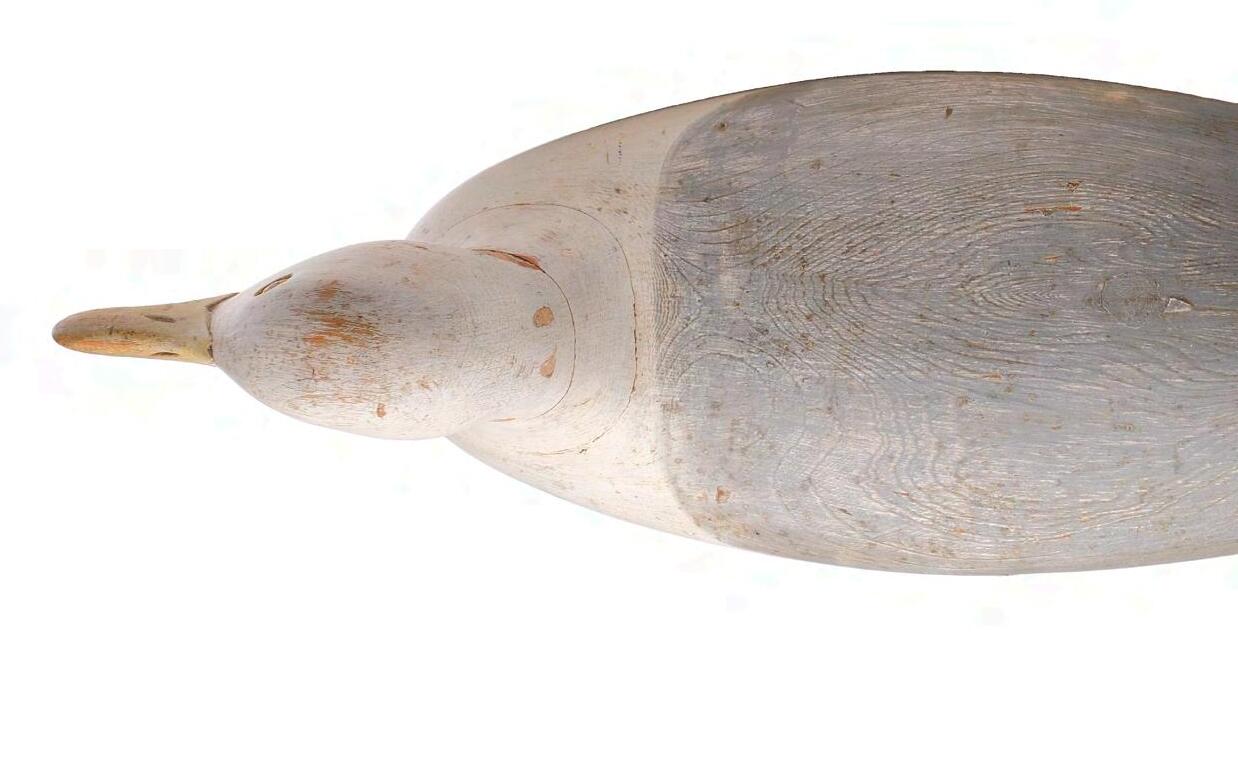
31a Harry V. Shourds (1861-1920), Tuckerton, New Jersey. Extremely rare herring gull. Hollow carved with raised and separated wing tips, raised neck seat, and carved eyes. One of only two known to exist. Mackey collection ink stamp on the underside. Decoy was used as both a floater and a stick up decoy. Measures 19” long. Original paint with minor wear and discoloration; crack through neck, with a filled chip at one side; minor roughness on raised wingtips; crack and minor roughness on one side of tail.
Provenance:
William J. Mackey Jr. collection. Alan and Elaine Haid collection.
Literature:
“Decoys: North America’s One Hundred Greatest”, Loy S. Harrell Jr., page 86-87, similar decoy pictured. (90,000 - 120,000)
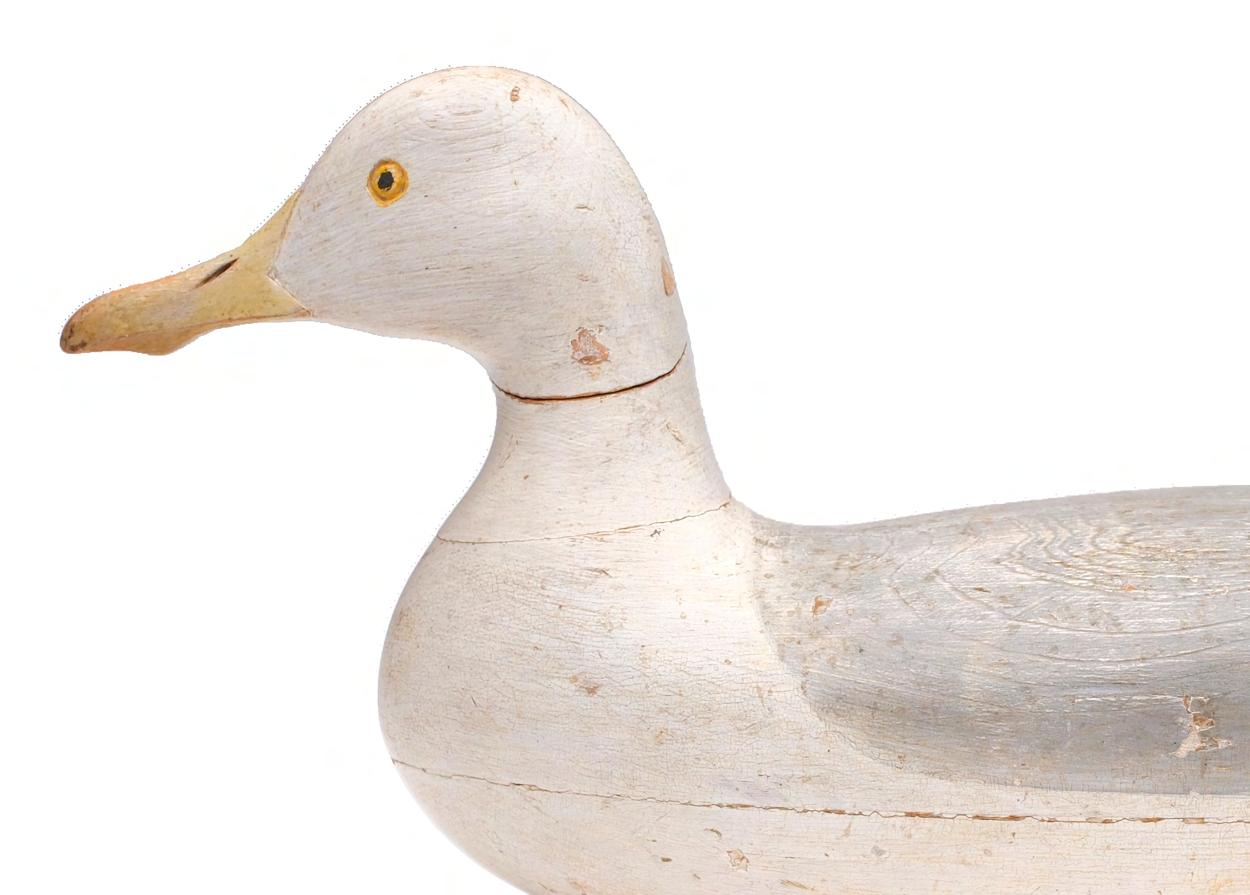

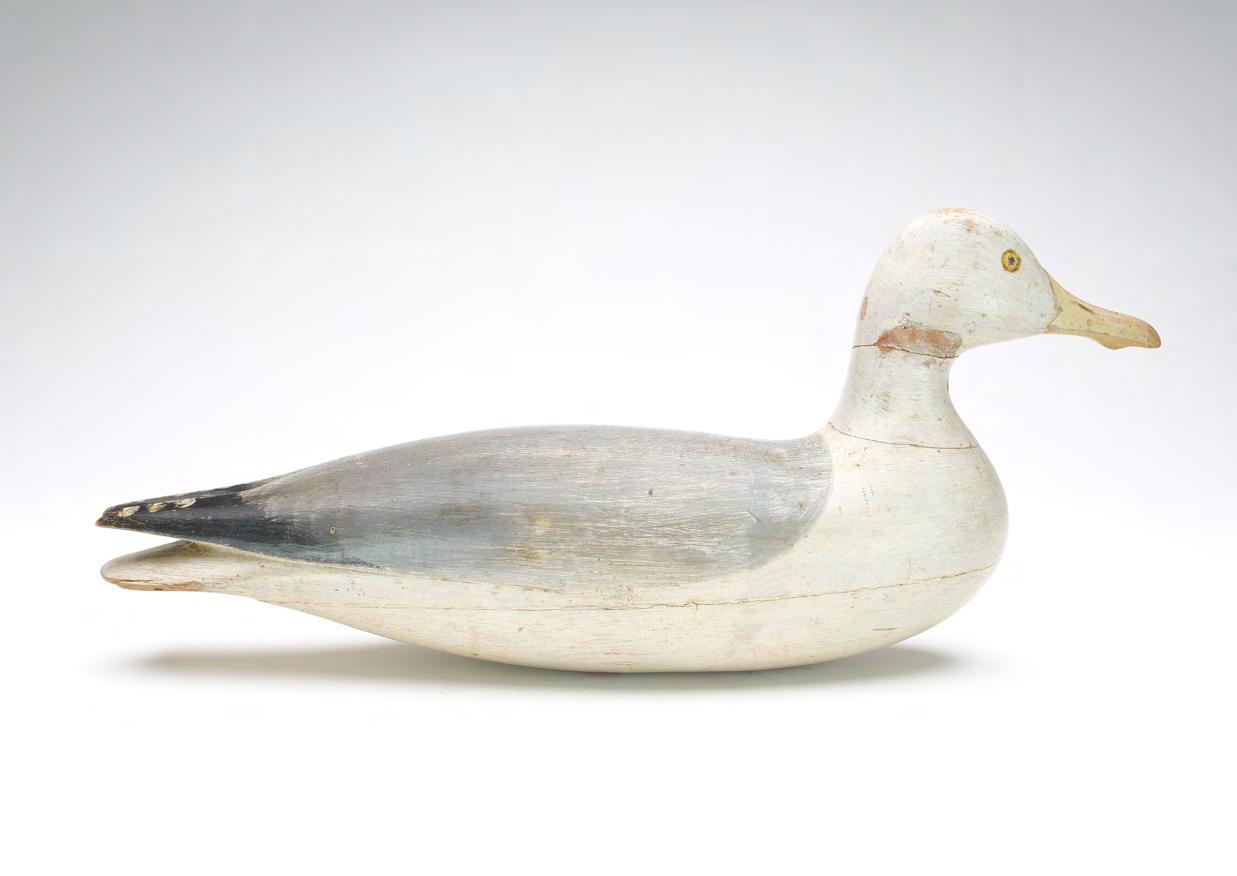

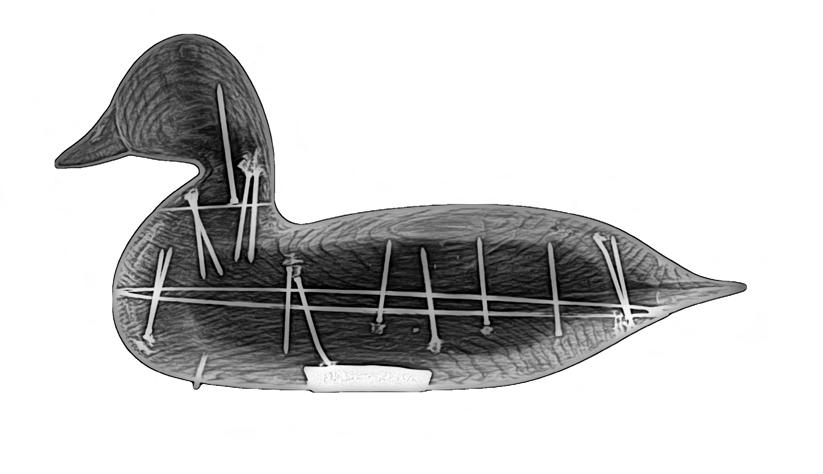
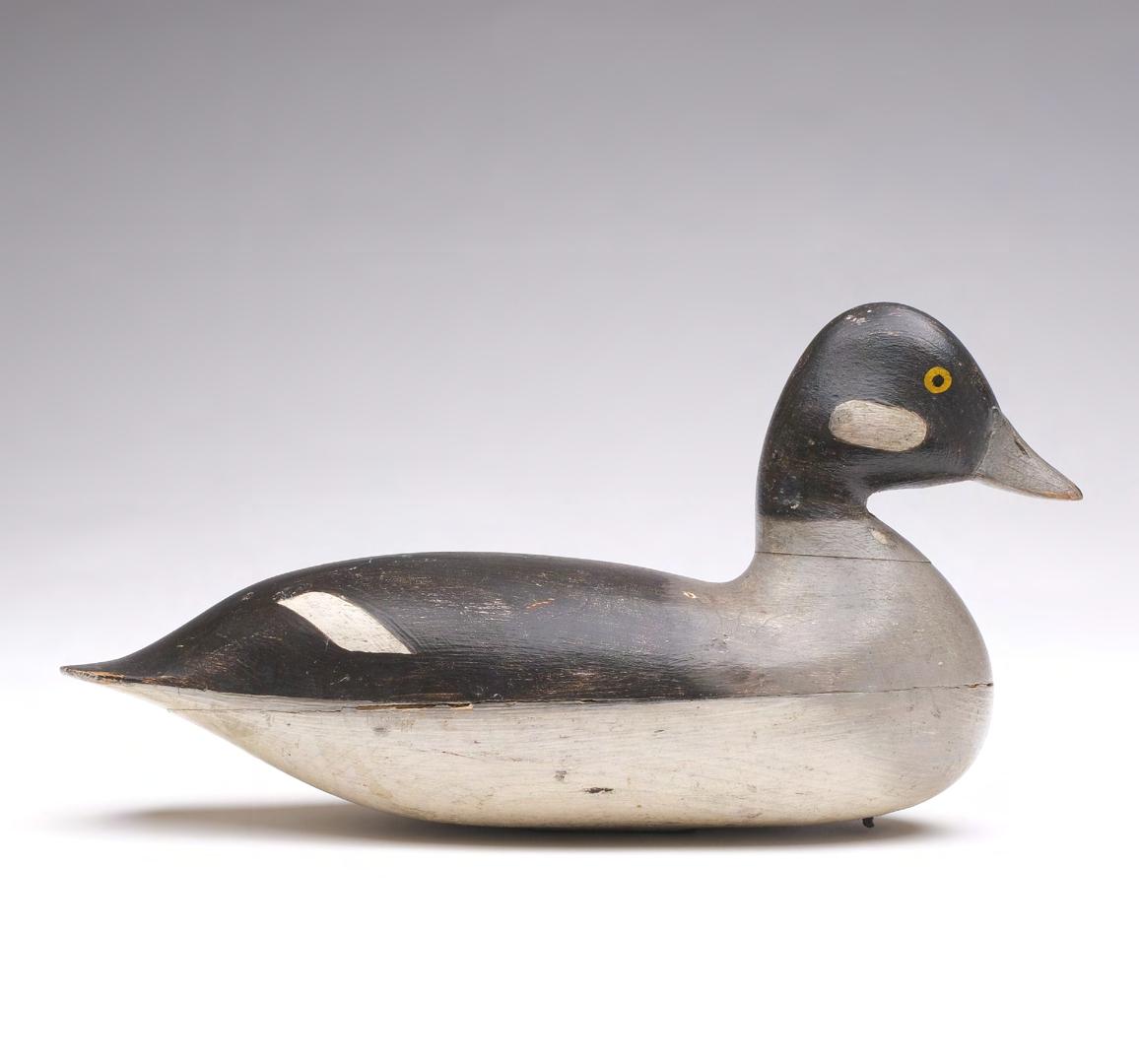
32 Harry V. Shourds (1861-1920), Tuckerton, New Jersey. Very rare bufflehead hen. Hollow carved with raised neck seat and inlaid rectangle lead weight on the underside. Mackey collection ink stamp on the underside. Measures 11.75” long. Excellent original paint with very minor wear; minor flaking and separation at body seam; spot of touch up at a paint pull near one wing patch.
Provenance:
William J Mackey Jr. collection.
Jim Keegan collection.
Alan and Elaine Haid collection.
Literature:
“Top of the Line Hunting Collectibles”, by Donna Tonelli, page 61, exact decoy pictured.
“Classic New Jersey Decoys”, by James R Doherty, page 58, exact decoy pictured. (30,000 - 50,000)


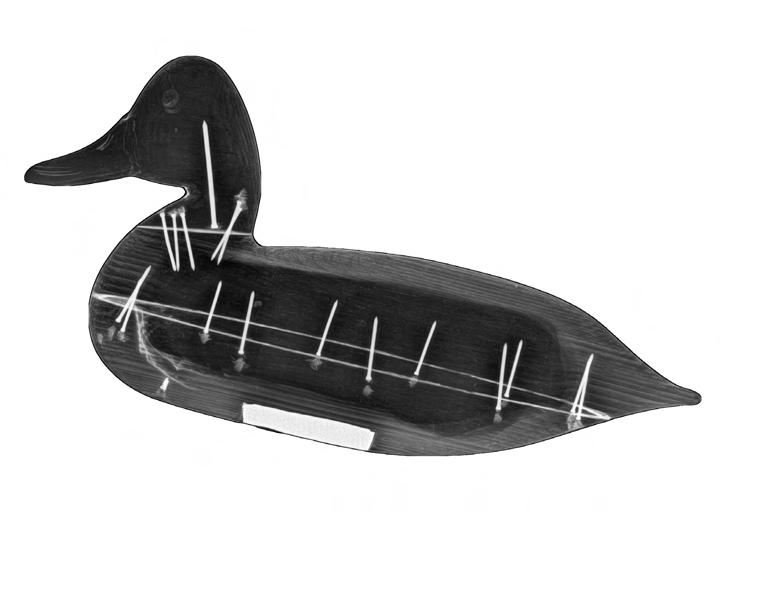

Provenance:
Alan and Elaine Haid collection.
Literature:
“Top of the Line Hunting Collectibles”, by Donna Tonelli, page 61, exact decoy pictured.
“Classic New Jersey Decoys”, James R Doherty, page 50, exact decoy pictured. (20,000 - 30,000)

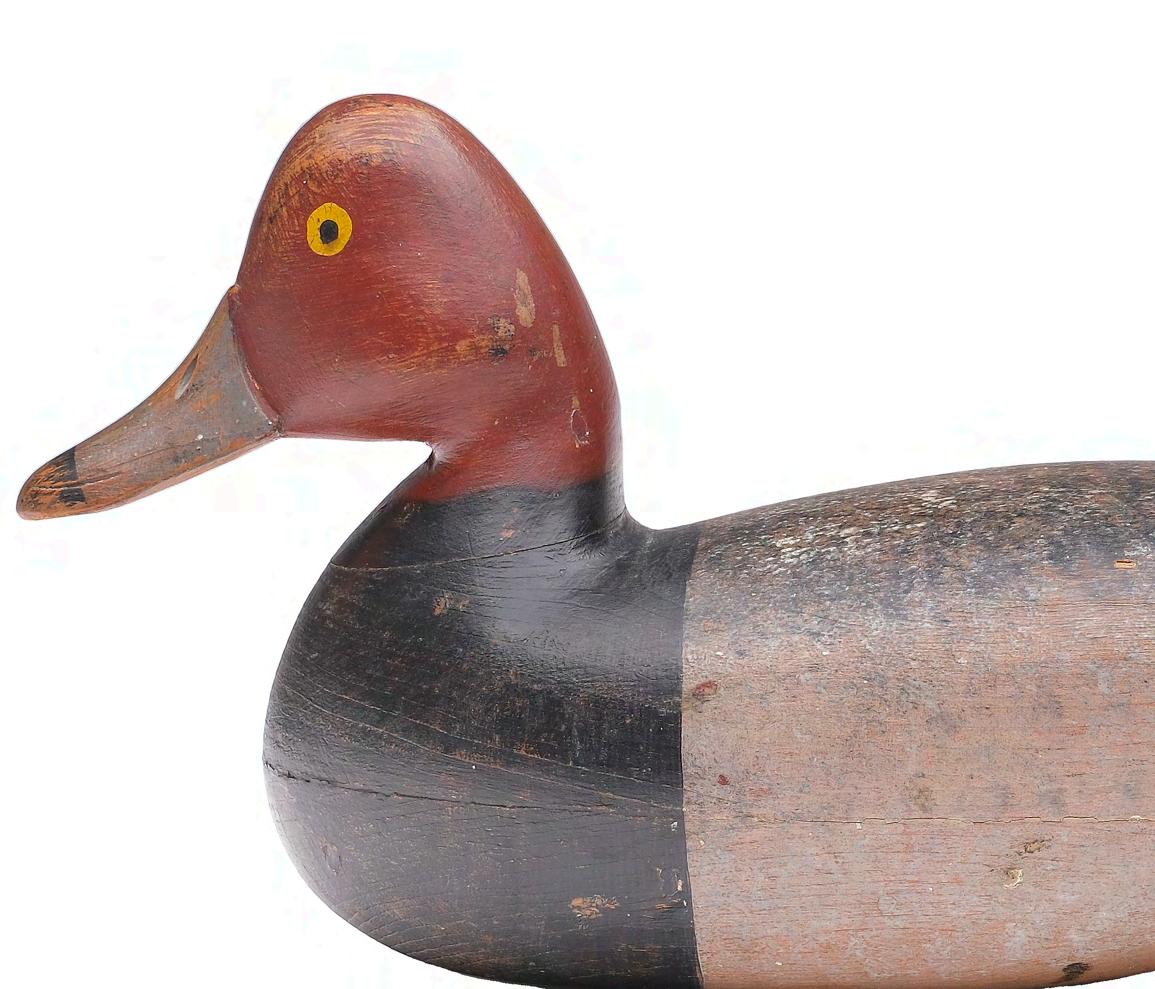

Leffingwell may very well have been describing decoys made by Jasper Newton Dodge at his peak (see note 1) . In the Detroit area, Dodge’s commercial decoy operation was predated only by George Peterson whose production period spanned the dates of 1873 – 1884
Jasper was born in 1829 in Watertown, upstate New York, not far from the St Lawrence seaway and the eastern end of Lake Ontario. By the age of twenty, he was listed as a boarder in the home of Warner and Elizabeth Failing and working as a grocer. When he was twenty-seven he married Charlotte Augusta Wright (born 1836) in nearby Cape Vincent and the young family remained there through 1860. By the time of the Civil War, the couple had moved to Pamilia, NY where Jasper continued to work as a grocer. For some unexplained reason, by the mid 1860’s, Jasper and Charlotte along with two children, Leonora and Charles, moved to Michigan, residing in Kalamazoo, with Jasper, once again, employed as a grocer. Unfortunately, Charlotte died while giving birth in 1879 and the following year, Jasper, his two children and a servant, were residing on Pine Street in Detroit with Jasper working as a “clerk in store”. This store was John E Long’s gun store where Jasper had worked since 1878 along with Willam Mason of future decoy fame.
Jasper was apparently quite familiar with the sporting scene. An article published in the April 1902 issue of “The Sporting Goods Dealer” and reprinted in “Detroit Decoy Dynasty” by Sharp and Dodge states that “Mr. J.N. Dodge, of Detroit, Michigan, who has been a gentleman sportsman and identified with the sporting goods trade since his childhood - - - (emphasis added) ” would indicate that he was hunting and fishing while in New York. An
“My decoys are the best I could buy -perfect in shape, faultlessly painted, and artistic and real in every way.”
- William Leffingwell 1888, “Wildfowl Shooting”
1866 article in the Detroit Free Press notes that he was participating in large fox hunts in Kalamazoo and was a founding member of the “Michigan Field Sporting Club” whose objective was “- - - the cultivation of field sports as a diversion, and for conducting hunting in an honorable and gentlemanly way” . Obviously, Dodge knew a number of sportsmen in the Kalamazoo – Detroit area and must have been aware of the need for decoys. References indicate that he was producing these at his home on Pine St prior to 1883 with some suggesting a date as early as 1880 while he was working at Long’s store. He must have envisioned a thriving future in this endeavor for, in 1883, he purchased the business and equipment of the George Peterson decoy factory in Detroit.
There has always been some confusion identifying the early work of Dodge. Initially, there must have been a transitional period in terms of design between Peterson and Dodge and, to add to the confusion, one of Jasper’s main marketing strategies was that he advertised that he offered “Decoys made like any pattern furnished, without extra charge”. Eventually the business expanded, to include additional sporting items, then the production of oars and, finally, canoes. Upon Dodge’s death, the factory decoy market was basically controlled by William Mason who would carry on the crafting of wooden decoys through 1924.

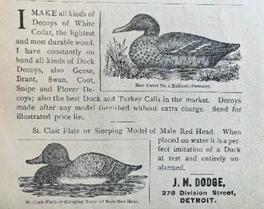
Jasper Dodge died in Bay City, Michigan in 1909 of “debilities due to old age” the Woodmere Cemetery in Detroit.
Dodge, like Mason to follow, advertised his wares widely and the company was very successful. His mass marketing meant that his decoys are apt to appear anywhere ducks are hunted. Certainly, species with a wide distribution, such as mallards, would have been common orders. Likewise, others must have experienced far smaller demand and still others, undoubtedly, only ordered rarely. The Dodge swans most certainly would have fallen into the latter category. They were large, hard to ship and, at $72 per dozen as advertised in 1892 (almost $2500 in todays dollars), they would have represented a substantial investment for the average hunter or club. The fact that any have survived is astonishing, especially any in original paint and condition. The Dodge swan in the Haid collection was a personal favorite of Alan and Elaine and was carefully selected as their “logo bird”. This iconic carving truly represents one of the decoy collecting community’s greatest rarities and finest treasures.
See Detroit Decoy Dynasty by Rob Sharp and Bill Dodge for a det discussion of Jasper Dodge and the Dodge factory. Notes: 1 It is known that Leffingwell was using Dodge decoys in 1866 advertisement

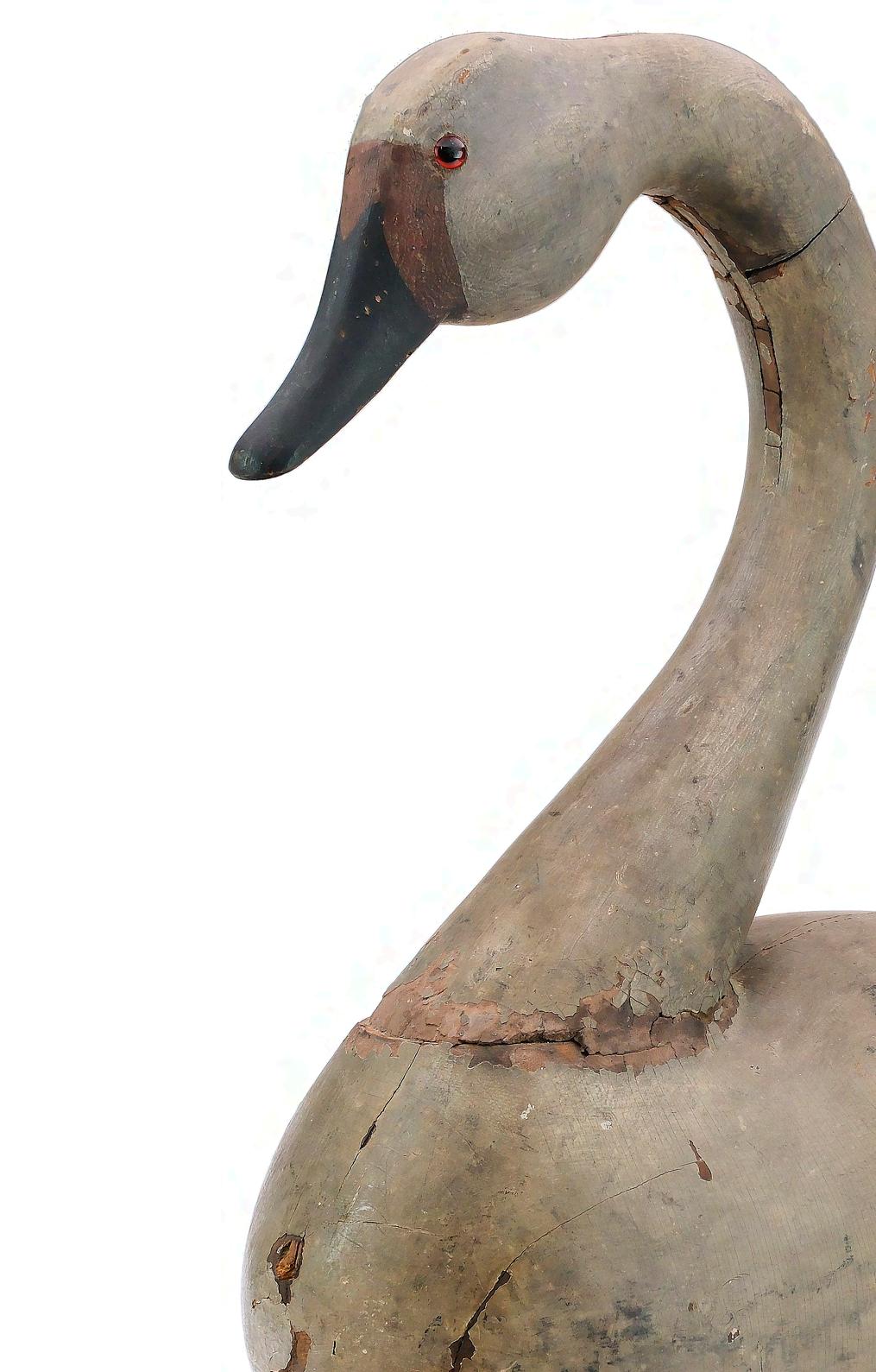
34 Dodge Decoy Factory (1872-1894), Detroit, Michigan. Rare and outstanding working swan. St. Clair Flats style body is thinly hollowed with 1/4” bottom board and elegantly carved, two-piece head and neck. Branded ‘F.H. Walker’, for the rig of Franklin Hiram Walker, St. Clair Flats Shooting Company member from 1890-1914. One of only a handful known to exist and believed to be the only one in original paint. Measures 21” long, 18.5” tall. Original paint with moderate flaking and wear, mostly around neck seat, where most of the original filler has flaked away; surface is mellowed to a pleasing patina with age; minor separation at neck seam; crack with small amount of filler added in upper neck; hairline cracks in breast and one along the back.
Provenance:

Rig of Franklin Hiram Walker, St. Clar Flats Shooting Company member.
Purchased from the St Clair Flats Shooting Company by Bernard Crandell and Judge Harry Seitz, circa 1970.
Alan and Elaine Haid collection.
Literature:
“Decoys of the Mississippi Flyway”, by Alan G. Haid, page 65, exact decoy pictured. “Waterfowl Decoys of Michigan and the Lake St. Clair Region”, by Clune Walsh and Loweel G. Jackson, color plate 9 and 17, exact decoy pictured.
“Top of the Line Hunting Collectibles”, by Donna Tonelli, page 113, exact decoy pictured.
“Decoys: North America’s One Hundred Greatest”, by Loy S. Harrell Jr., page 100-101, exact decoy pictured.
“Detroit Decoy Dynasty - The Factory Decoys of Petersen, Dodge, and Mason”, by Ron Sharp and Bill Dodge, pages 122 and 123, exact decoy pictured. (80,000 - 120,000)
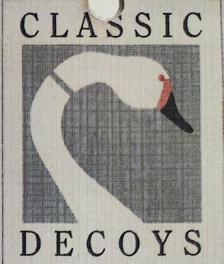
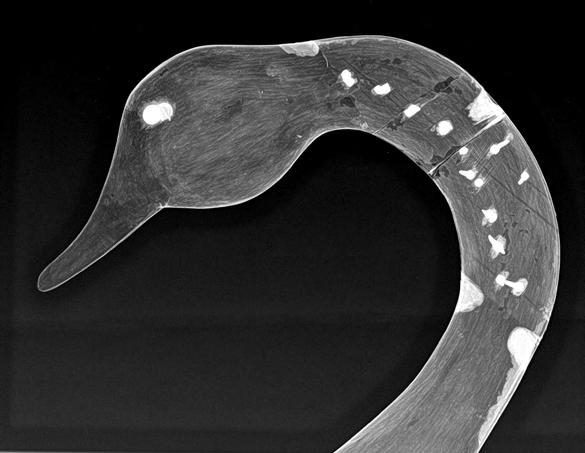

Between 1896 and 1924, one would have been hard pressed to walk into a sporting goods or hardware store anywhere in the country and not see Mason decoys offered for sale. This was the golden age of shotgunning, and waterfowling was a widely popular pastime with hunters of all ages. Hand crafted decoys by commercial makers were certainly available, but their use was somewhat localized, being concentrated primarily in areas near the carver’s home. Unfortunately, not all of these birds exhibited quality construction and/or paint and, finally, not every hunter possessed the time or talents to carve his own lures. Enter William James Mason (1846 – 1905).

Factory manufactured decoys were not a new idea and examples had been produced for some time, notably the work of George Peterson, Jasper Dodge and others. What elevated Mason above his predecessors, however, was not only the quality of his product but his marketing genius. He advertised widely, utilizing a number of popular printed formats. Ads such as those in The Sporting Goods Dealer were aimed at both large and small retail establishments while those in publications such as Field and Stream targeted individuals and clubs. For a period, his birds were sold through the large chain outlets, Sears Roebuck and Co and VL&A in Chicago. Marketing promotions were established with other companies such as Outers Book . Mason had much to be proud of and his birds offered what others did not. They were exceptionally well made and finished, using only the best materials, and they carried some of the very finest painted plumage in the industry. The number of species offered ran the gamut
of practically all the types of waterfowl and shorebirds pursued anywhere in the country. The company also proclaimed that it would replicate any decoy on a special-order basis, and shorebirds that mimic east coast makers are known, such as those carved by Bill Bowman and Charlie Thomas. His profusely illustrated and informative catalogs went through at least seven different editions and often included enticing reviews by customers such as “ They astonish our customers, who are not accustomed to such fine goods ” and “ Perfection itself. Never expected to see the natural bird so closely imitated ”. Astutely, Mason offered his decoys in multiple grades, intentionally meant to be sold at specific price points and to be attractive and affordable to sportsmen at every social and economic level.
From its humble start at his home, through a series of factory locations, the Mason Company exhibited both growth and prosperity. In 1908, Sears Roebuck was advertising the painted eye standard grade decoys for the astonishing sum of $2.85 per dozen. By 1913, the company catalog offered hollow, premier grade models at $8.75 per dozen with prices rising over the years to $21.00 per dozen. Upon the death of its founder, the reins were assumed by his sons and, finally, solely by Herbert Mason. The company’s closure in 1924 was due in part to competition from less expensive decoys and Herbert’s interest in other avenues of business.


Mason decoys have always been extremely popular. The story of the factory has been documented in no fewer than six books dealing either wholly or in part with the company. Pertinent articles have been included in every decoy periodical dating back to at least 1963, with at least ten articles appearing in Decoy Magazine alone. The magnum opus , however, would surely be Mason Decoys by Russ Goldberger and Alan Haid. This book has probably enticed more collectors into the Mason story than any other. Very few individuals have handled and studied as many examples as Alan and Russ, and some of the finest and scarcest Masons known have passed through their hands. Alan and Elaine’s connoisseurship has allowed them to selectively choose a small number of only the very best to retain in their personal collection. Their Masons include some of the earliest work from the factory, as well as some of the very rarest examples. Their Mason decoys have been pictured in untold publications and have been featured in numerous, nationally acclaimed exhibitions. The Alan and Elaine Haid Masons must certainly be considered the pinnacle of their kind. The sale of their collection offers an extremely rare opportunity to own some of the finest Mason decoys known.

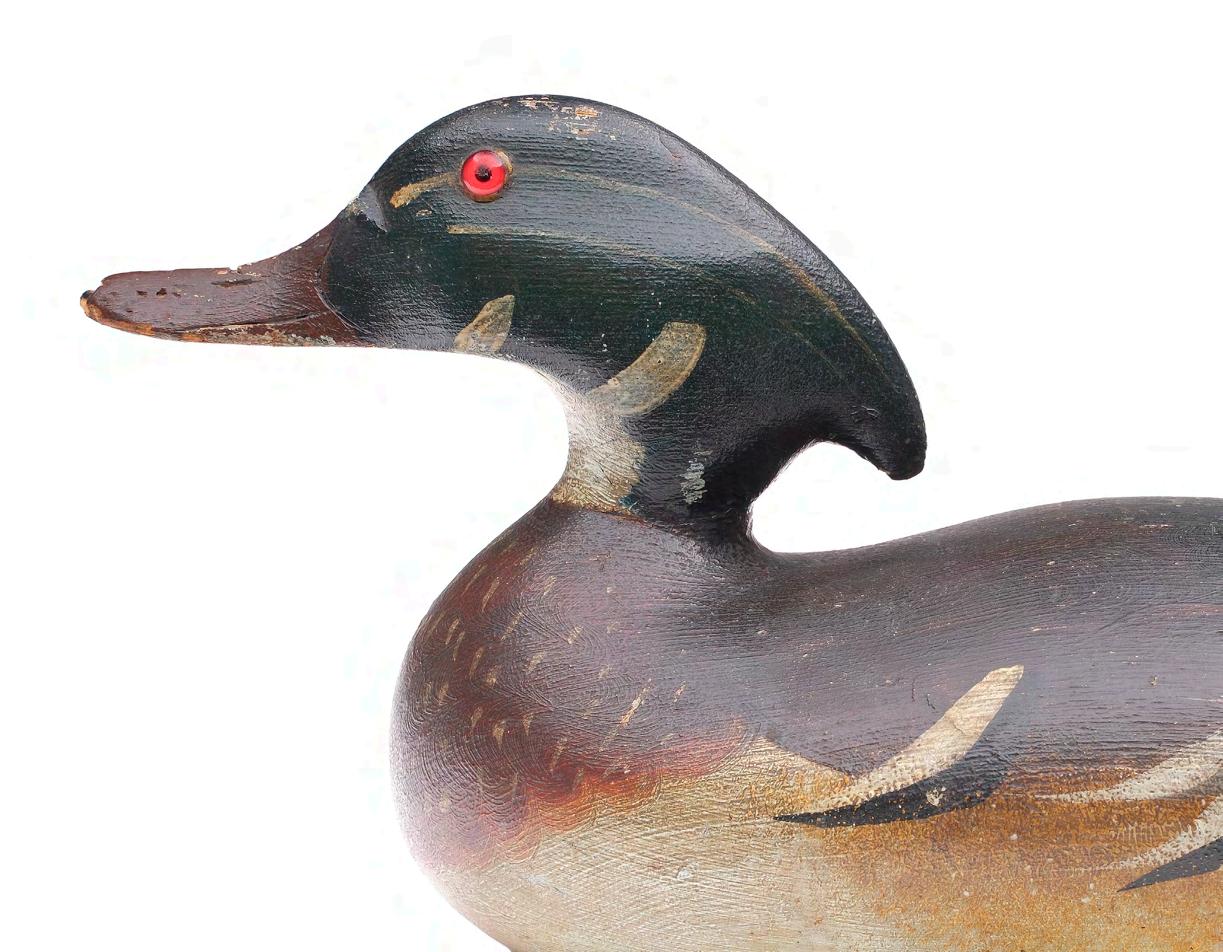 William J. Mason
William J. Mason
35 Mason Decoy Factory (1896-1924), Detroit, Michigan. Extremely rare and outstanding wood duck drake. Solid body Premier grade with relief bill carving and snakey head style. Excellent paint pattern true to the species. Decoy was never rigged or weighted. Measures 12” long. Original paint with minor flaking and wear; surface has darkened nicely with age; hairline crack in top of bill; puppy chews and minor roughness on tip of bill.

Provenance:
Bud Ward collection.
Alan and Elaine Haid collection.

Literature:
“Mason Decoys A Complete Pictorial Guide”, Russ Goldberger and Alan Haid, page 86, exact decoy pictured.
“Mason Decoys A Complete Pictorial Guide –Expanded Edition”, Russ Goldberger and Alan Haid, front cover, exact decoy pictured.
“Top of the Line Hunting Collectibles”, by Donna Tonelli, page 115, exact decoy pictured. (80,000 - 120,000)

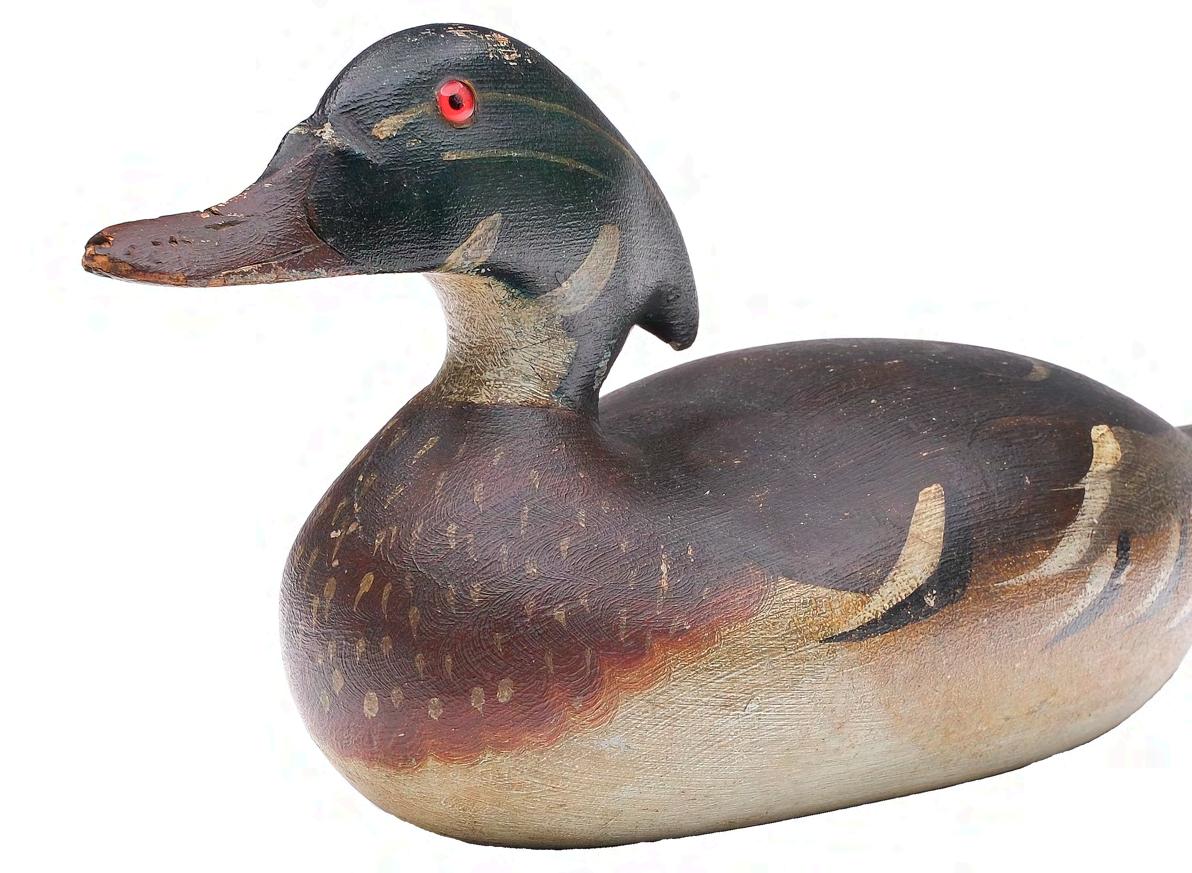
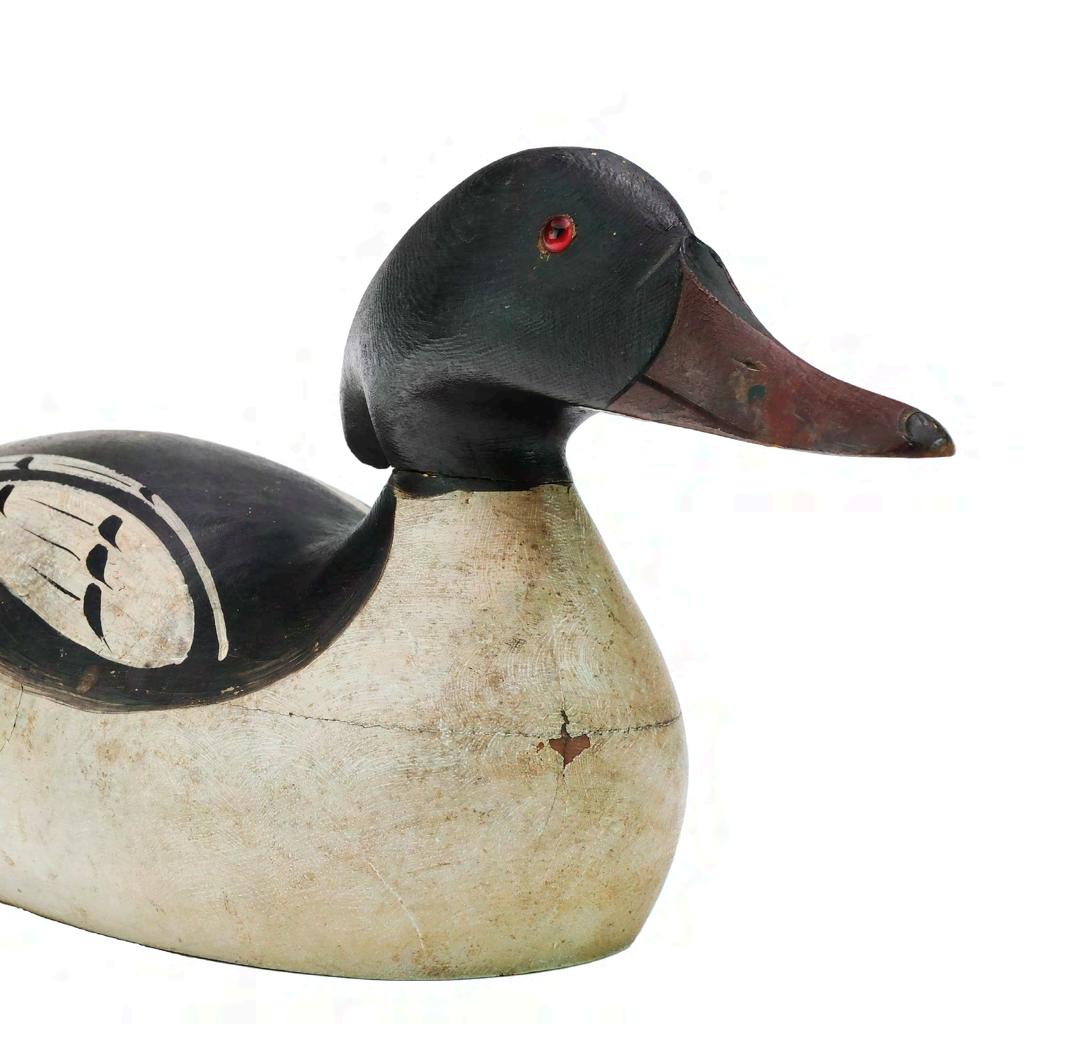


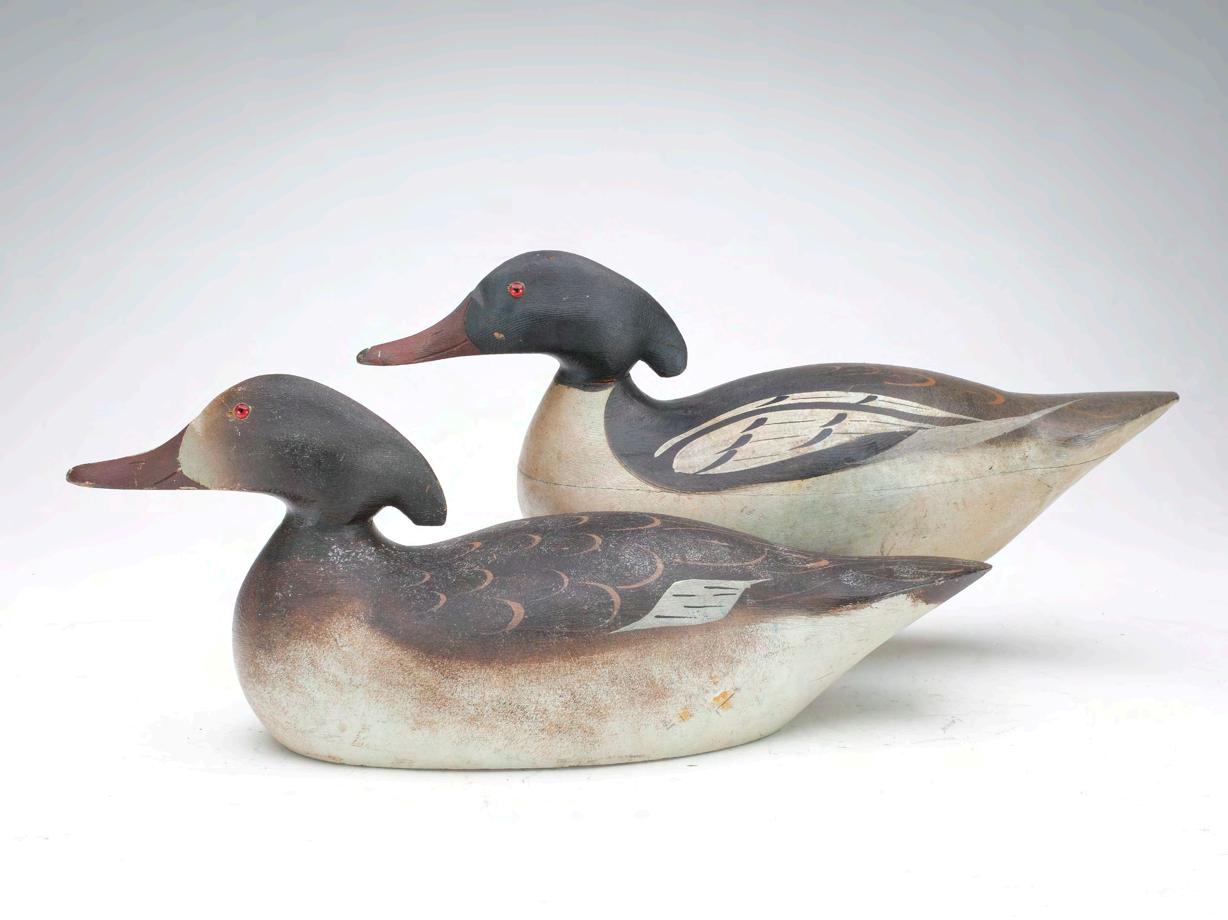
36 Mason Decoy Factory (1896-1924), Detroit, Michigan. Outstanding and very rare, rigmate pair of American mergansers. Hollow carved premier grade with extended crests and relief bill carving. Hen with detailed feather looping on back. Measure 18.25” long. Excellent original paint with very minor flaking and wear; each with ink print from being wrapped in newspaper on lower side; head is very slightly loose on drake; drake with spots on edge of underside where paint is missing and blunting on tip of tail.
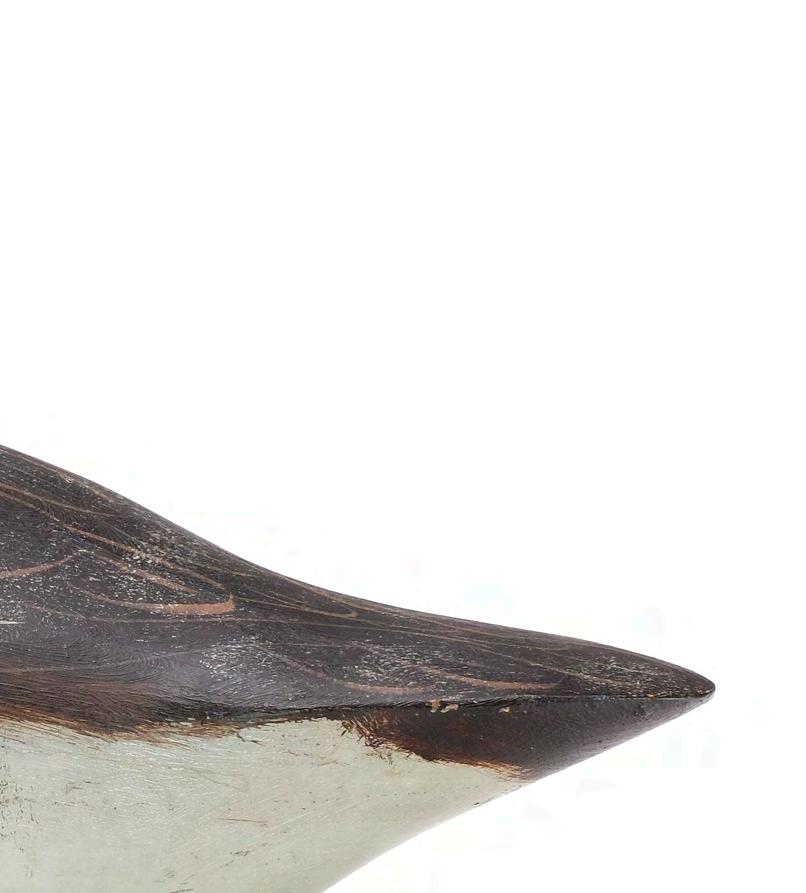
Provenance:
Alan and Elaine Haid collection.
Literature:
“Decoys of the Mississippi Flyway”, by Alan G. Haid, drake on page 72 and front cover, exact decoy pictured.
“Mason Decoys”, Russ Goldberger and Alan Haid, pair on page 72 and front cover, exact decoys pictured. (50,000 - 70,000)
History is resplendent with records of the abundance of the wild or passenger pigeon in the United States. As late as the early nineteenth century, mile long migrating flocks that “blocked the sun” were commonplace. More recently, ecologists have estimated their population numbers as between 3 and 5 billion individuals. Perhaps the most numerous bird in the world, at one point they comprised upwards to 40% of the total worldwide avian population. To the early settlers, the birds, like so many of the other resources of their day, seemed inexhaustible. Eventually, however, a mounted specimen with a small label was displayed at the Smithsonian Institute. The simple sign read:
“Martha
Last of her species, died at 1 P.M.
1 September, 1914, age 29, in the Cincinnati Zoological Garden EXTINCT”
The scientific name of the bird begins to explain what happened. Its Genus name means “moving about” or “wanders”, and migratorius means to migrate. Unfortunately, the species had a narrowly defined niche, that being the vast, undisturbed eastern mixed hardwood forest where it fed on forest mast (acorns, beechnuts, chestnuts, seeds, and berries).
The birds were totally dependent on these woods for food, resting, roosting, breeding and nesting. Their extensive feeding could actually have a short-term negative impact on forest reproduction while, at the same time, their droppings spread seeds and replenished the nutrients in the soils below. As one area became drained of food for the birds, they would simply locate to other suitable locals (thus “wandering”). Their vast numbers and flocking behavior had an ecological advantage. There was safety in numbers in terms of natural predators and, when some birds in the flock found food, the remainder, too, benefited. Breeding and brood raising likewise was communal and offered species advantages.
Recent genetic information (taken from the toe pads of mounted specimens) indicates that the birds represented what ecologists term “outbreak species” meaning that their numbers could represent boom or bust cycles. The species demonstrated a very low reproductive rate with pairs only breeding once a year (some evidence suggesting occasionally twice) with the female laying a single egg in the fragile simple twig nest. At the same time, adults were capable of a high longevity rate. Under normal circumstances, the survival strategy worked.
The aboriginal human population of North America would have certainly harvested birds for their own use and consumption but, unlike the birds, their individual numbers were relatively low, their villages sparse, and their needs minimal. Enter the European settlers. As the white man’s numbers grew, expansion became necessary, and the great Westward migration began. The forests were viewed as both a blessing and an obstacle. The trees were needed for shelter, food and fuel but also needed to be removed for agriculture. The great deforestation of America began. Massachusetts alone would be a typical example. Once almost 90% covered in forest, by the late 1800’s, 85% of the State was considered to be in some form of open field agriculture. The same would
apply to other states reaching out to the great plains. This was the very area and habitat upon which the passenger pigeon relied. As the human expansion spread west, thousands of new mouths had to be fed. At first, the killing of the pigeons would have had a minimal effect on the birds. However, as with other forms of market hunting, so well-known in the waterfowl community, the birds were soon being slaughtered by whatever means necessary to feed the large and expanding urban centers. The spread of the telegraph alerted trappers and hunters to the bird’s movements and the expanding railroad network allowed for ready transport. The extent of the plunder is astonishing. In 1869 in Hartford Michigan, three railroad cars of pigeons were shipped daily for forty days. Birds were fed to hogs and thousands were lived trapped to provide targets for shooting contests.
It was the perfect environmental, ecological, and biological tsunami for the birds, one which the animals could not adapt to fast enough to avoid oblivion. As the forests were cut, the birds were funneled into the areas that remained. This put added stress on their food source and made them more concentrated for the hunters. As the population shrank, the bird’s low reproductive rate could not adequately replenish those that were lost. Eventually, the numbers shrank to the point where, because of their communal courtship practices and stress, the birds were not able to reproduce.
By the third quarter of the 19th century some began to take notice of the declining number of birds and legislation was implemented to provide some protection for the species. The concept of extinction was not well understood at the time, and these efforts were largely ignored and led to naught. The last recorded nest and egg in the wild were collected in 1895 near Minneapolis. The last reported capture of a bird in the wild took place in 1900 in Pike County, Ohio and the last fully authenticated record of a wild pigeon was when one was shot and stuffed near Oakford, Illinois in 1901. In 1909 the American Ornithologist Union was offering a reward of $1,500 for anyone finding a nesting colony or even a single egg. Although raised to $3,000 in 1910, the reward was never paid out.
Why the Mason decoy factory ever saw fit to offer decoys specifically for the species is confounding. The factory is recognized as first coming into large scale factory production by 1902. By this time the species was, for all practical purposes, already extinct. Mason was producing decoys prior to that period, with some suggesting a date as early as 1894, a time when the pigeons were exceedingly rare. One can only assume that any decoy produced by the factory specifically meant to target a passenger pigeon would have had to have been a special order in the very earliest years of production. Perhaps it was from a sportsperson who remembered the abundance of the birds from their youth and hoped for a return of those earlier days. The miniscule number of Mason pigeon decoys that have survived would place them as one of the company’s greatest rarities.
37 Mason Decoy Factory (1896-1924), Detroit, Michigan. Exceedingly rare passenger pigeon. Glass eye model with metal

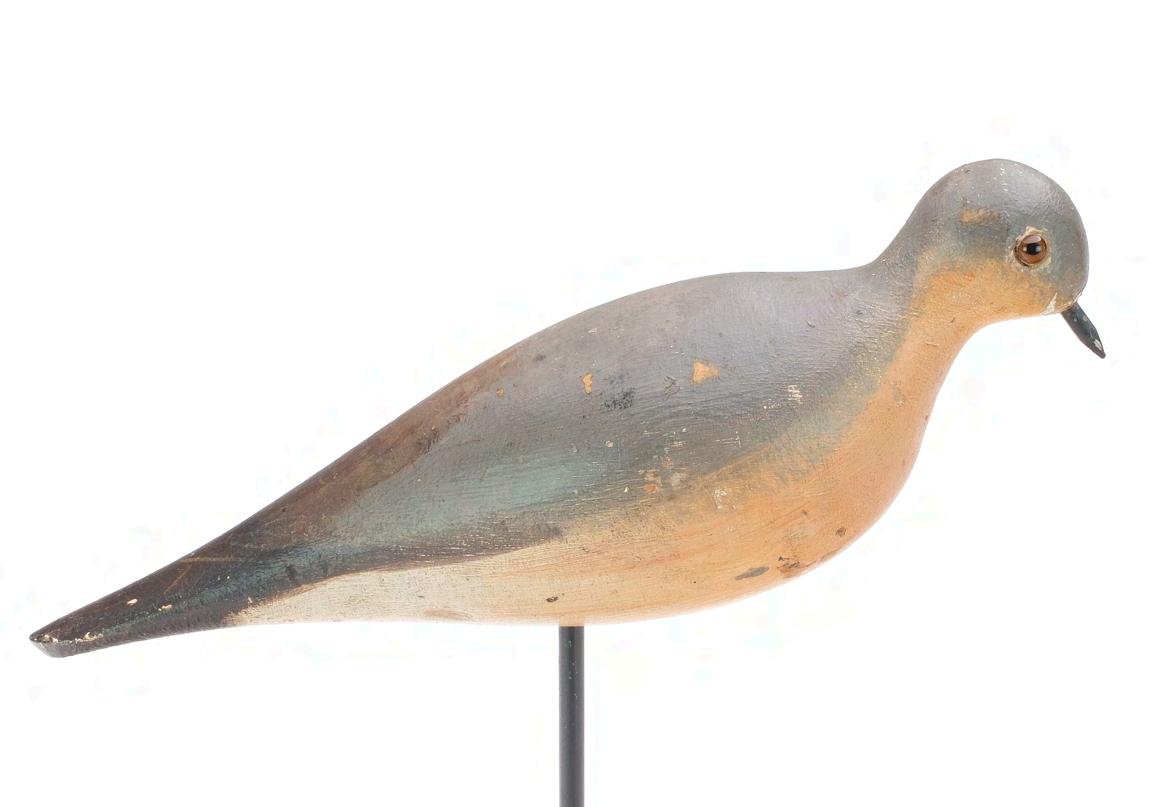
38 Mason Decoy Factory (1896-1924), Detroit, Michigan. Two-piece curlew, circa 1900 with glass eyes and iron bill. Excellent paint detail. Measures 17.75” long. Original paint with minor gunning wear; tiny chip at stick hole and at tip of tail where a small knot has fallen out, otherwise excellent structurally.
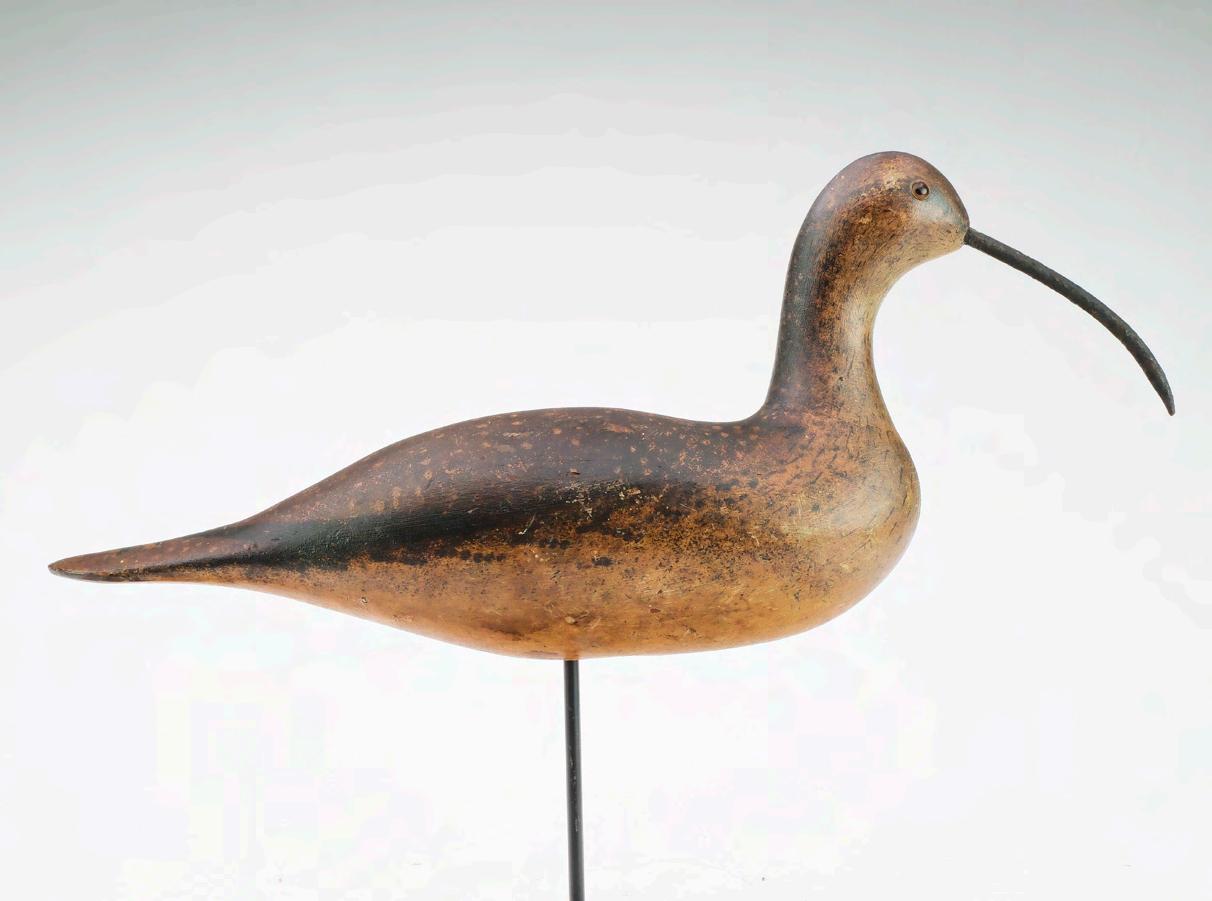

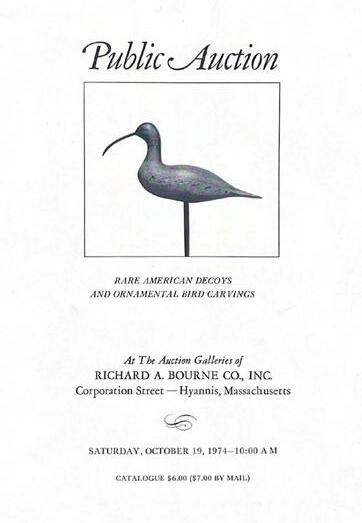
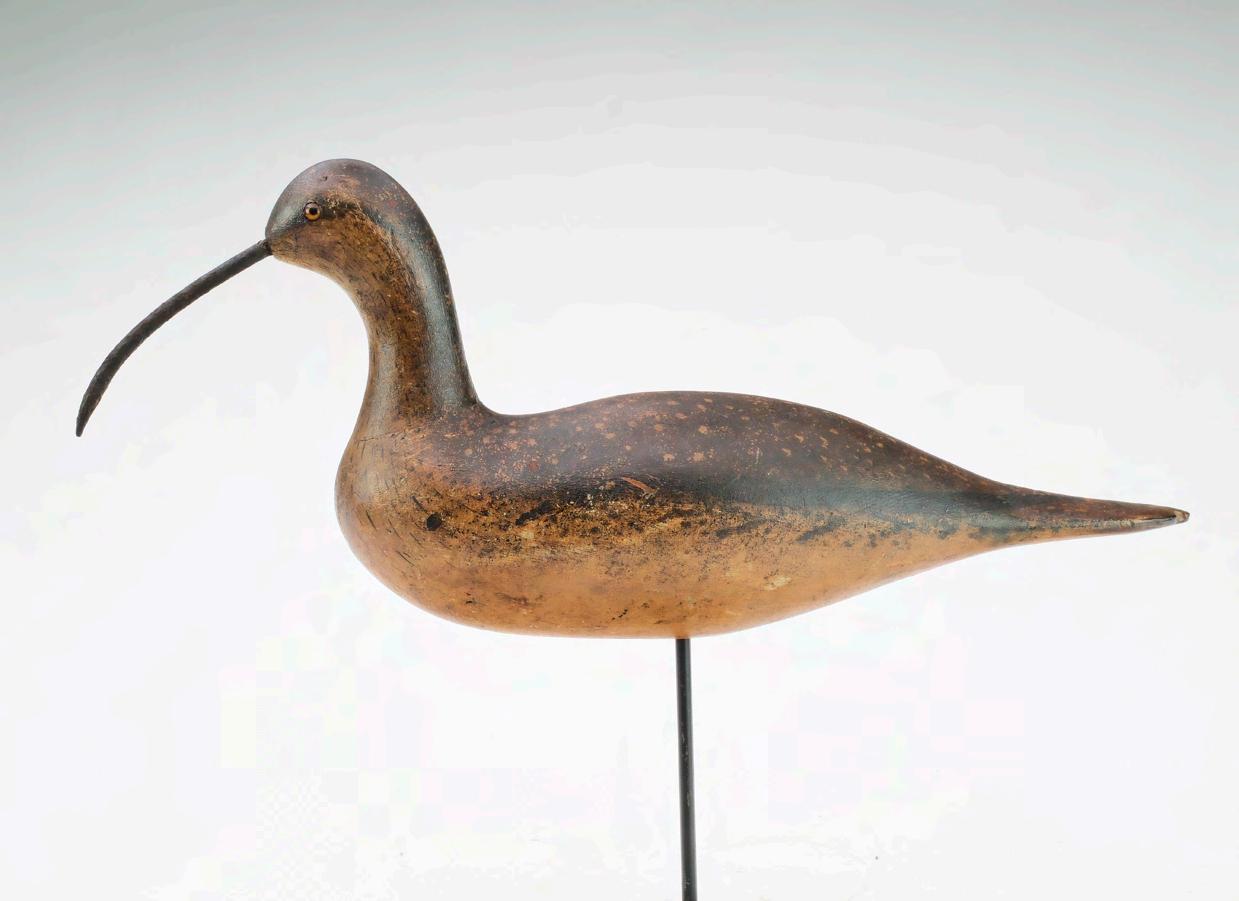
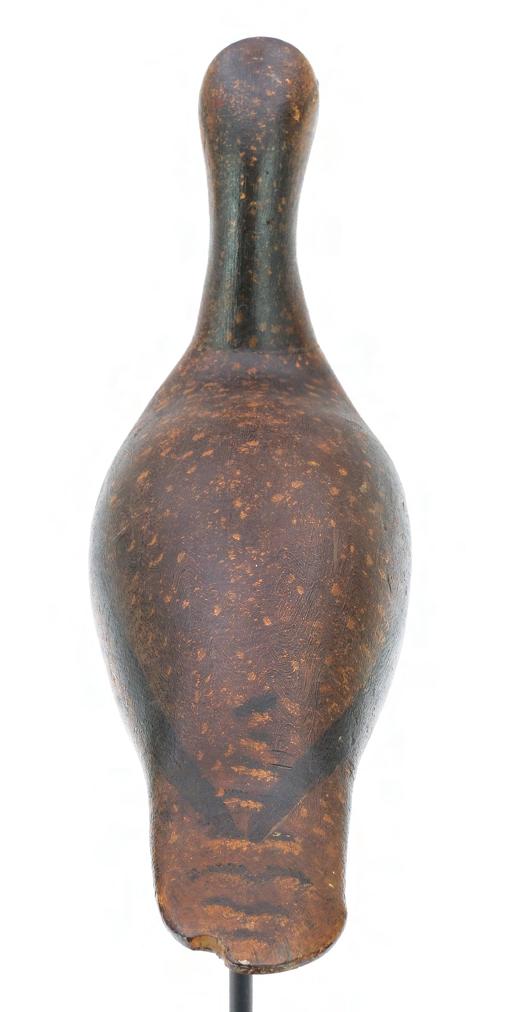
Provenance:
Dr. Robyn Hardy collection.
Jim and Diane Cook collection.
Alan and Elaine Haid collection.
Literature:
“Mason Decoys: A Complete Pictorial Guide”, by Russ J. Goldberger and Alan G. Haid, page 97, 107 and back cover, exact decoy pictured.
“Top of the Line Hunting Collectibles”, by Donna Tonelli, page 122, exact decoy pictured.
“Fish and Fowl Decoys of the Great Lakes”, by Donna Tonelli, page 51, exact decoy pictured. (30,000 - 40,000)
39
Mason Decoy Factory (1896-1924), Detroit, Michigan. Premier grade Canada goose with relief bill carving, glass eyes, and detailed sponge paint. Measures 24” long. Original paint with minor to moderate gunning wear; minor roughness on edge of bill and top of head; small dents in body; drying split along underside with small nails added to secure; in factory filled defect on top of tail area with minor flaking.
Provenance:
Alan and Elaine Haid collection.
Literature:
“Decoys of the Mississippi Flyway”, by Alan G. Haid, page 74 and back cover exact decoy pictured. “Factory Decoys”, by John and Shirley Delph, front cover and pages 45 and 46, exact decoy pictured.
“Mason Decoys”, by Russ J. Goldberger and Alan G. Haid, page 79, exact decoy pictured. “Fish and Fowl Decoys of the Great Lakes”, by Donna Tonelli, page 50, exact decoy pictured. (20,000 - 30,000)



40 Mason Decoy Factory (1896-1924), Detroit, Michigan. Challenge grade bluewing teal drake with snakey head style and double blue wing pattern. Measures 12” long. Original paint with very minor wear; tight crack along the underside; small amount of filler restoration with touchup on neck seat.
Provenance:
Alan and Elaine Haid collection. (6,000 - 9,000)
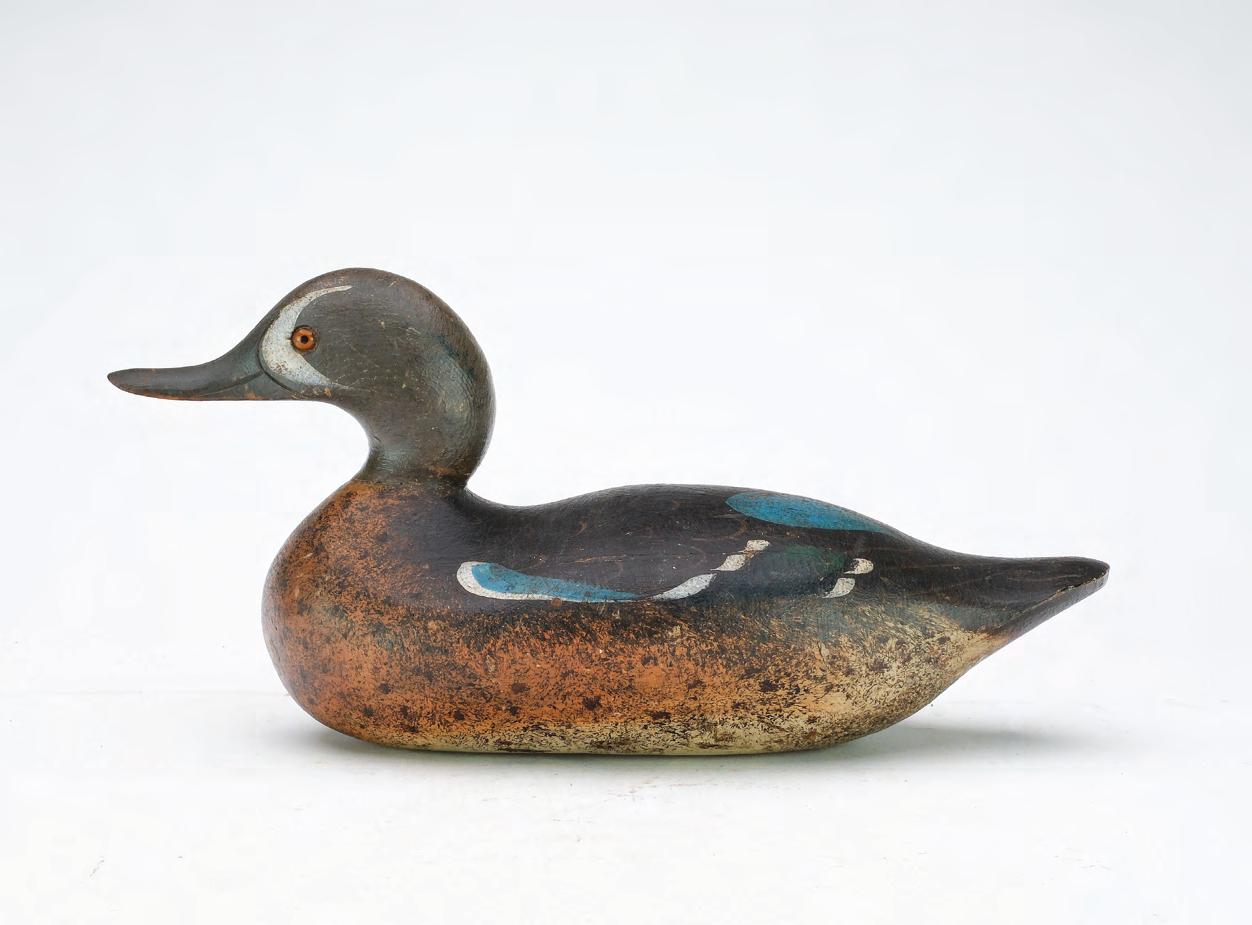
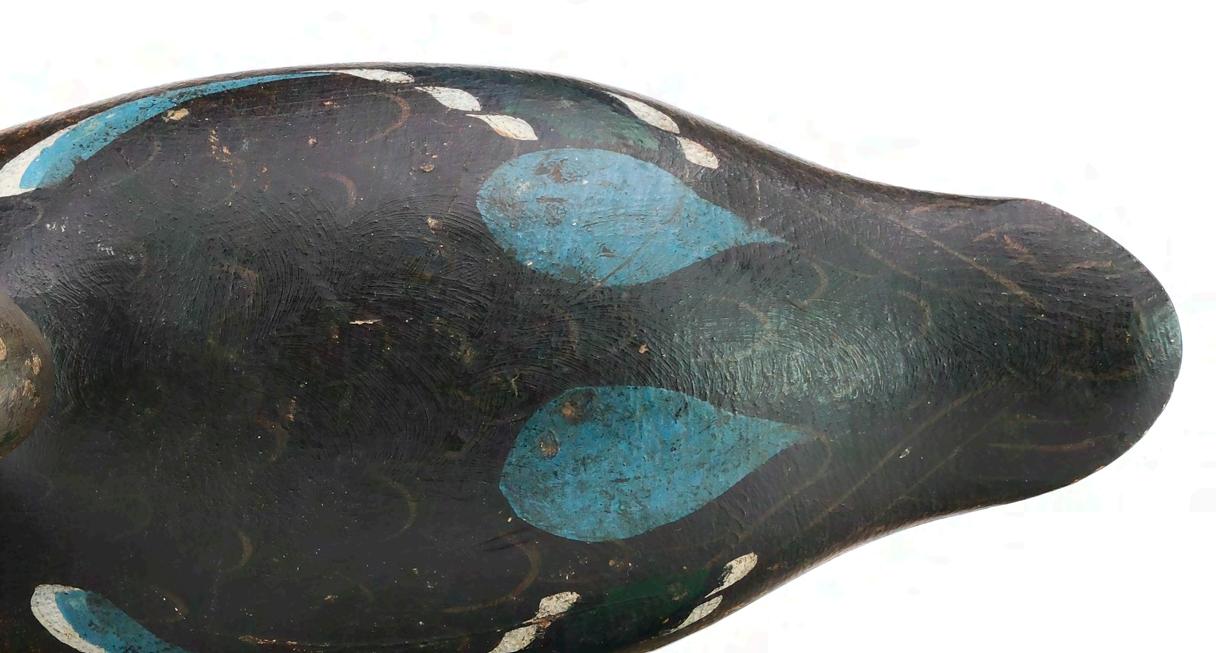


41 Mason Decoy Factory (1896-1924), Detroit, Michigan. Early plover with glass eyes and wooden bill. Measures 12” long. Original paint with minor wear; bill is a professional replacement; underside had been planned down to sit flat on a shelf, with that area professionally restored.
Provenance:
Alan and Elaine Haid collection. (3,000 - 5,000)
42 Mason Decoy Factory (1896-1924), Detroit, Michigan. Glass eye plover with iron bill. Measures 11.25” long. Original paint with very minor wear; two small spots of rust stain in one side; small ring of touchup where bill meets face.
Provenance:
Alan and Elaine Haid collection. (3,000 - 5,000)

Bach was born in Switzerland and is reported to have been trained as an architect and draftsman although he listed his education as ending after three years in high school. This is a relatively insignificant detail, since art and creativity, as was to become apparent, can often be innate. After serving 6 years in the Swiss Infantry, he left his homeland and traveled to Denmark where he boarded the Hellig Olav and set sail for the United States. He was fluent in several languages, but not English and, upon his arrival to the States, he settled briefly in a German speaking community in Pennsylvania. Here, he polished his English and bought his first book in this country – one on the American Indian. This formed a fascination with the Native Americans that would remain with him for his entire life.
By 1917/18, he had migrated to Michigan where he is listed as a “draftsman”. Here he began to live in two separate and distinct worlds. He yearned for, and dreamt of, a life in the rugged north woods. However, even though he wielded a pen and not a wrench, for the remainder of his working life, he would be embroiled in the smoke and grit of Detroit’s renowned “motor city”. He found employment, first as a draftsman, and ultimately, head designer for a number of that city’s largest automobile manufacturers in their heyday including Studebaker, Rickenbacker, Chrysler and Dodge. In 1929, he married Margaret K Watson and lived in a very blue-collar neighborhood with her parents. They had a son, also named Ferdinand, but the union was dissolved in 1936 with Margaret being granted an (uncontested) divorce on the grounds of “nonsupport and extreme cruelty”. Ferdinand had to briefly pay alimony until Margaret remarried later that same year. Strangely, they must have remained somewhat friendly since she is listed as the person to notify in his 1942 WWII draft registration. Until this time, Bach had been living as a “lodger” or “boarder”. By the late 1940’s, however, he had purchased his own suburban home on Kramer St in St Claire Shores, a suburb of Detroit, and only a stone’s throw from Lake St Clair. Here he transformed his surroundings into a miniature interpretation of a north woods cabin, complete with its own tiny birch and evergreen forest. He had always enjoyed the outdoors, including hunting and fishing. Early in his life he traveled to the West to study the Native Americans and later, would
annually make an extended pilgrimage to Golden Lake, Ontario to live among the Pikwakanagan members of the First People. He mastered a number of rural skills such as snowshoe making and basketry, but he particularly excelled at the construction of Birch Bark Canoes. He died unexpectedly when his body was found floating in the waters near his home.
His decoy carving was limited but, as one would expect from someone with his design background, always of the highest standard, both in terms of form and finish. As early as the 1920’s, he carved a small rig of detailed black ducks for a local policeman whose territory included the Detroit riverfront where the men may have met. He would later carve at least one other rig for an automotive associate. Other than these two known rigs, Bach carved only for his own use. His first rig was finished by the 1930’s but these were all lost in a tragic boat house fire. Undeterred, he set out to carve a second rig for himself and these have since been crowned his “classics”. These are muscular with and without detailed wing tips and designed to be visible to high flying flocks. He achieved a great deal of realism in this rig by utilizing 44 different head patterns in their construction. His work is usually identified with his name either signed or carved with a flourish on the bottoms, often with a conjoined “c” and “h” in “Bach”. History had taught him a painful lesson and he lavished great care on his new creations.
Bach exhibited his talents in a number of ways. Not only did he carve majestic decoys, but he also produced some miniatures, classic birch bark canoes (both in museum displays and today, recognized as some of the finest of their kind), duck boats, sailboats, skiffs and at least one miniature boat model complete with decoys. In addition, at least one piece of attractive, impressionistic, flat art is signed by him.
His decoys are now included in a select few private collections and have been described as “powerfully stylized” and “possessing both freshness and spontaneity”.
Bach did live in two worlds, the industrial complex of downtown Detroit and the wild, open freedom of the northern woods. We must assume that he far preferred the latter.

43
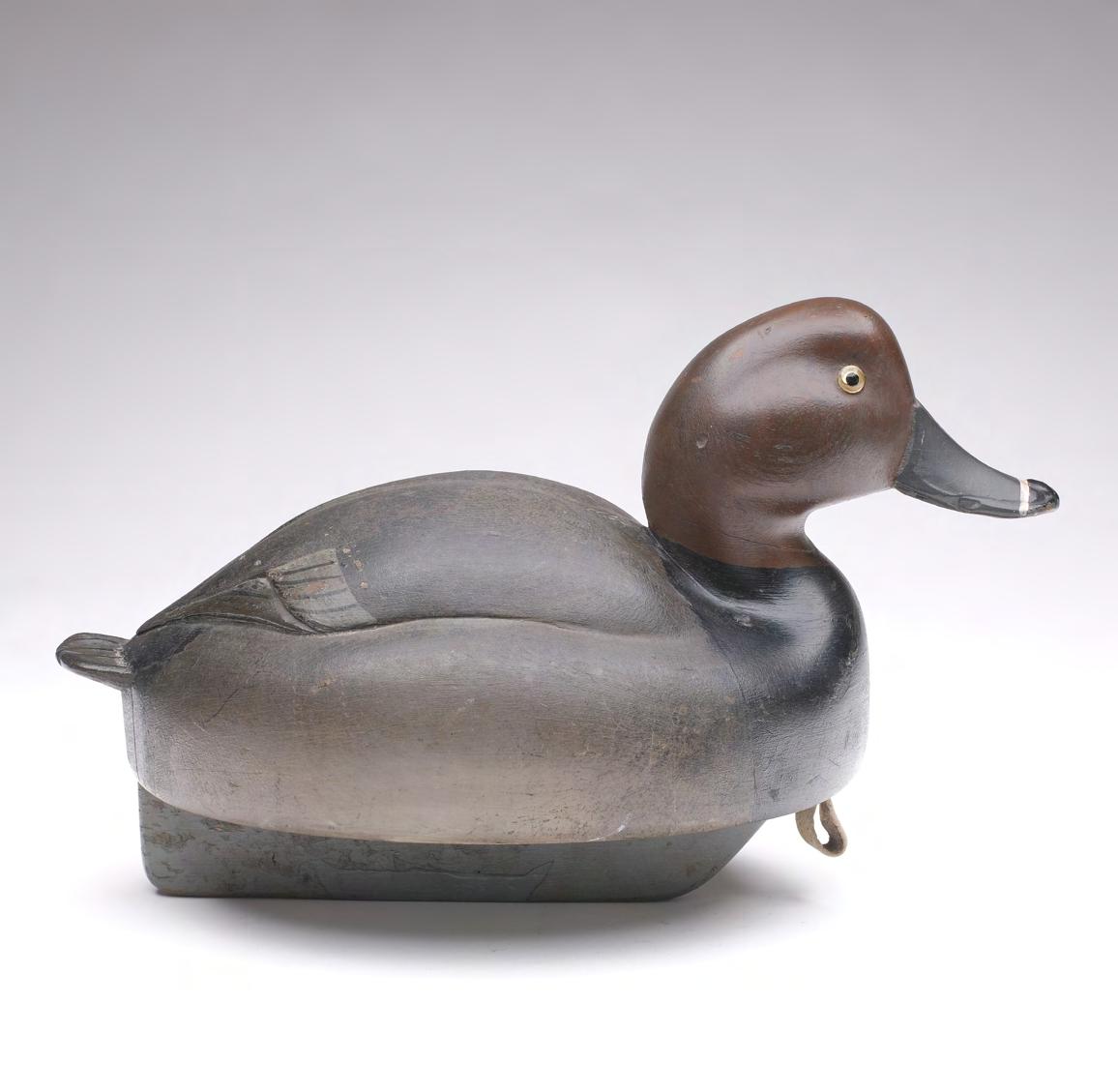
Ferdinand Bach (1888-1967), Detroit, Michigan. Very rare redhead with wide body and relief wing carving. “F.B.” carved on the underside for the personal rig of the maker. One of three known redheads by Bach. Measures 15” long. Original paint with minor gunning wear; lightly hit by shot; chip in one side of tail was touched up; hairline crack through neck; dent in one side of bill.
Provenance:
Jim Foote collection.
Alan and Elaine Haid collection.
Literature:
“Decoys of the Mississippi Flyway”, by Alan G. Haid, page 68 and front cover, exact decoy pictured.
(30,000 - 40,000)
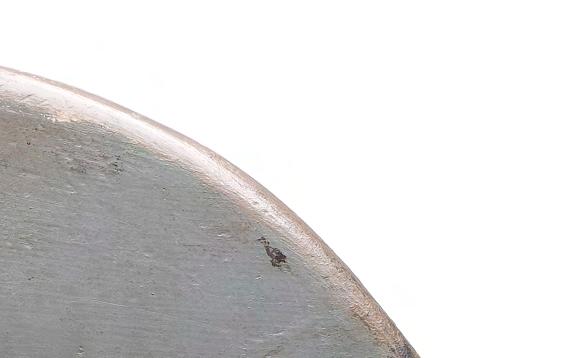
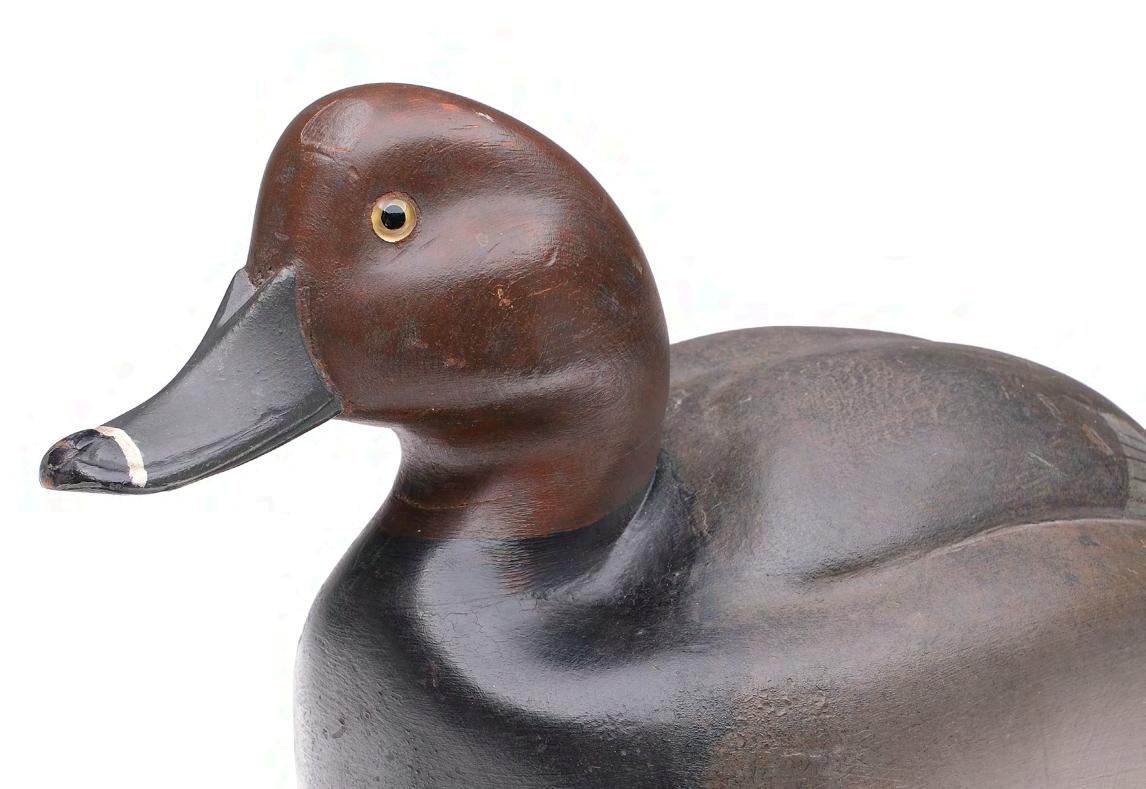
The son of a Scottish immigrant, John initially became a plumbing contractor like his father, Stewart. At the age of 26 he married Mary Ironside, and they would raise one son and three daughters. At some point in the 1890’s, he left the plumbing trade and, with a background as an avid waterfowler and trapshooter, found employment with the R.A. McCready Sporting Goods store in Toronto. In 1904, he transitioned again, this time to work at the Aykroyd Brothers Boat Shop at the foot of York St on the Toronto waterfront. He would remain with this prestigious small boat builder for the next 43 years as the firm switched locations along the shorefront. He would grow with the company, ultimately becoming the head carpenter and shop foreman. The yard was famous for their 14 ft sailing dinghy, a small craft which was to become a beloved icon for countless amateur sailors. Boat building requires a very high degree of carpentry skill and this, coupled with his prior background in plumbing, clearly demonstrated that John was accustomed to working with his hands. The boatyard gave him ready access to a variety of tools and materials, and his background in waterfowling undoubtedly led him to carve decoys - and carve decoys he did! His birds are among the finest of their kind to emerge from the Toronto area. He hunted with Tom Chambers, another highly respected decoy craftsman, and the two men undoubtedly shared design and construction ideas. Well’s decoys have been found associated with a number of prestigious Canadian ducking clubs, one of these being the private and selective Oak Lake Shooting Club in far off Manitoba. He is known to have made the decoys for a number of the members, including Joseph Blythe Whitehouse who shot over a rig which contained a few spoonbills. It is unlikely that Wells made more than 6 of this species in his lifetime.



In 1905 a group of 12 wealthy sportsmen from the Brandon, Manitoba and surrounding areas purchased 5,275 acres at the south end of Oak Lake, in the southwestern portion of the Province. A comfortable lodge was constructed and a gamekeeper, Walter Jiggens, lived in a separate cottage on the property. Strict bylaws were created which mandated daily bag limits and limited the number of guns on the marsh at any given time. Gambling was prohibited and drinking was not allowed during daytime hours. Many of the members shot over decoys carved by John R Wells of Toronto and each man identified their personal rigs with their initials. The club enjoyed very good shooting with records indicating that, in 1907, the members shot 53 geese and 2,319 ducks on the club grounds. Prominent among the founding fathers was Brandon resident, Joseph Blythe Whitehouse (J.B.W.) (1865 – 1941).
Whitehouse was typical of the affluent members of the club. Born and raised in Blyth, Ontario, he was educated at Tilson, Ontario and St John’s College in Winnipeg. In 1894 he married Edythe H Christie (1869 – 1959) and they had three children. His early employment was at the Western Union Telegraph company as a bookkeeper. He left that job to accept a position at the Merchants Bank in Brandon and, shortly thereafter, was appointed treasurer of the City of Brandon. In 1903, he and three other men, acquired the Brandon Sun Newspaper and Whitehouse became the managing editor. In 1905 he bought out his partners, securing control of the business. His success made the Sun one of the most influential newspapers in the west.
Active in the civic and social affairs of Brandon, he was a Mason, a member of the Brandon Board of Trade, The Brandon Club, and the Canadian Press Association. He and Edith are buried in the Brandon Cemetery.

It is unknown how the club members became aware of the decoys carved by Wells, located in far off Toronto. Some have conjured that since Whitehouse and Wells were contemporaries, perhaps they met during Whitehouse’s early years in Toronto. Others have suggested that members of the club may have had business interests that required them to travel to Toronto where they may have met Wells while he was employed at McCready’s Sporting Goods. Whatever the reason, The Oak Lake Shooting Club enjoyed the privilege of gunning over some of Canada’s finest decoys.

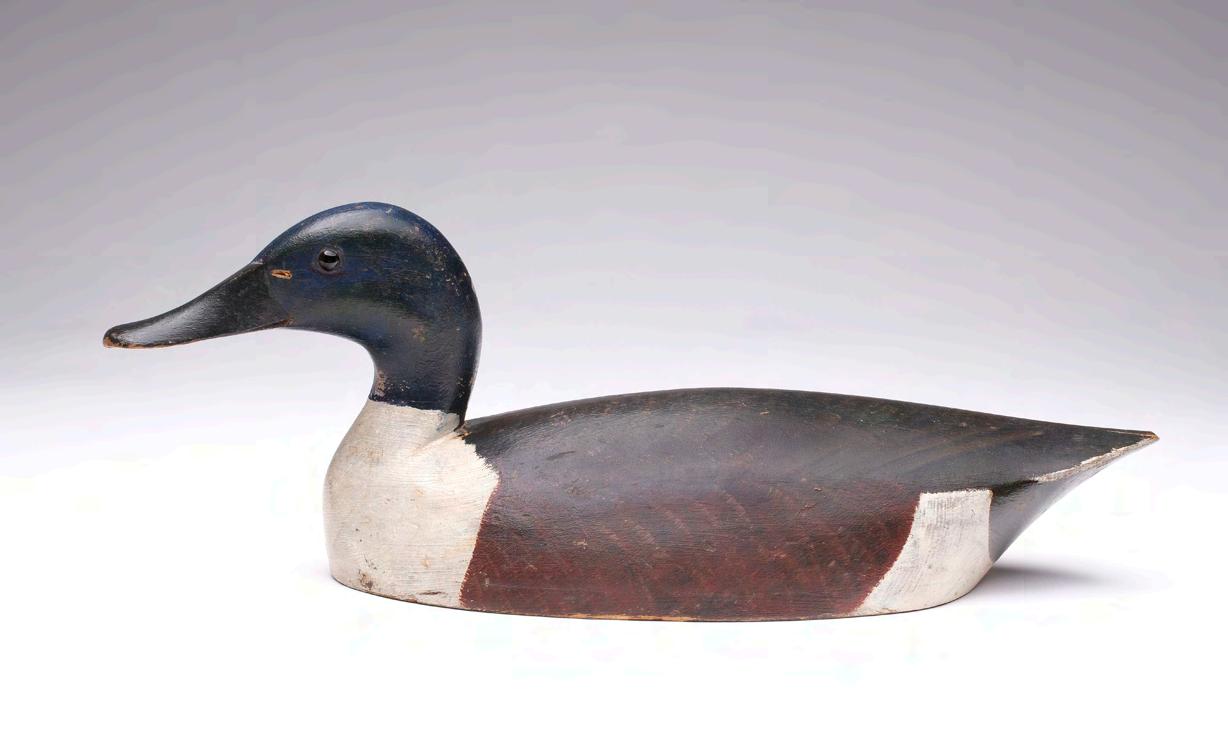
44 John R. Wells (1861-1955), Toronto, Ontario. Very rare and outstanding shoveler. Thinly hollowed with 1/4” bottom board, comb feather paint detail, and wide bill carving. Branded ‘JRW Maker’ on the underside. ‘J.B.W.’ on the underside for Oak Lake Shooting Club member Joseph Blythe Whitehouse. Measures 16.75” long. Original paint with minor gunning wear; small dents and shot marks; tiny chip in tip of tail; professional repair to a thin chip on one side of bill.

Provenance:
Alan and Elaine Haid collection. (20,000 - 30,000)
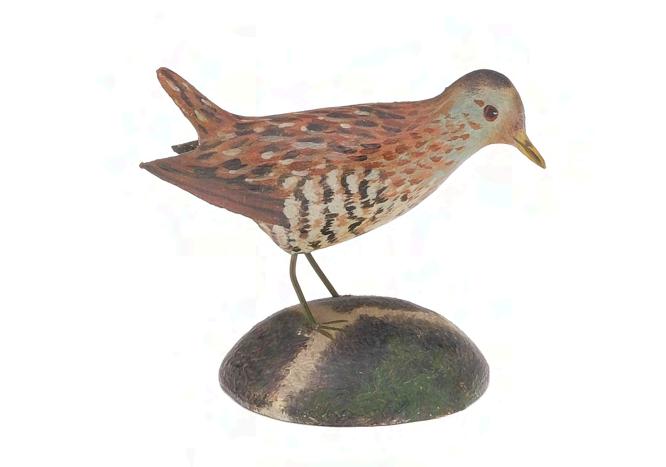

45 A. Elmer Crowell (1862-1951), East Harwich, Massachusetts. Very rare miniature sora rail with extended wingtips and upswept tail. Mounted on maker’s mottled base with unmarked underside. Sotheby’s auction sticker on the underside of base. Measures 3.25” long. Excellent and original.
Provenance:
Alan and Elaine Haid collection. (3,000 - 4,000)
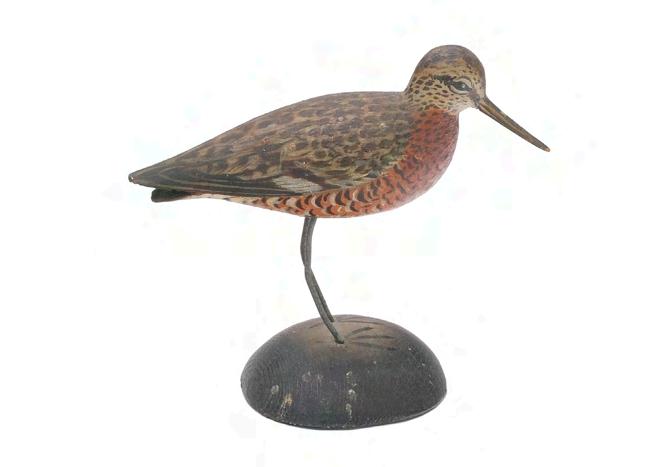
46 A. Elmer Crowell (1862-1951), East Harwich, Massachusetts. Miniature godwit with split tail carving. Underside of base is unmarked. Measures 3.5” long. A few tiny paint flakes on bill and a fine hairline crack in bill, otherwise excellent and original.
Provenance:
Alan and Elaine Haid collection. (2,000 - 3,000)
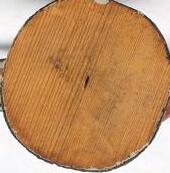

47 A. Elmer Crowell (1862-1951), East Harwich, Massachusetts. Miniature surf scoter. Raised wing tips and slightly up-looking head pose. Maker’s blue paper label on the underside. Measures 3.75” long. Excellent and original.
Provenance:

Alan and Elaine Haid collection. (2,000 - 3,000)
48
49
A. Elmer Crowell (1862-1951), East Harwich, Massachusetts. Early miniature feeding canvasback drake with split tail carving and fine paint detail. Mounted on chip carved mottled base, that is unmarked on the underside. Measures 5” long. Very minor flaking on base, otherwise excellent and original.
Provenance:
Alan and Elaine Haid collection. (2,000 - 3,000)
50
A. Elmer Crowell (1862-1951), East Harwich, Massachusetts. Rare miniature shoveler drake. Relief wing tips and maker’s blue paper label on the underside of base. Measures 5” long. Excellent and original.
Provenance:
Alan and Elaine Haid collection. (2,000 - 3,000)
A. Elmer Crowell (1862-1951), East Harwich, Massachusetts. Miniature longtailed duck drake. Raised wing tips and extended tail. Earlier example with unmarked base. Measures 4” long. Excellent original paint protected by a thin, slightly uneven coat of varnish.
Provenance:
Alan and Elaine Haid collection. (1,500 - 2,500)
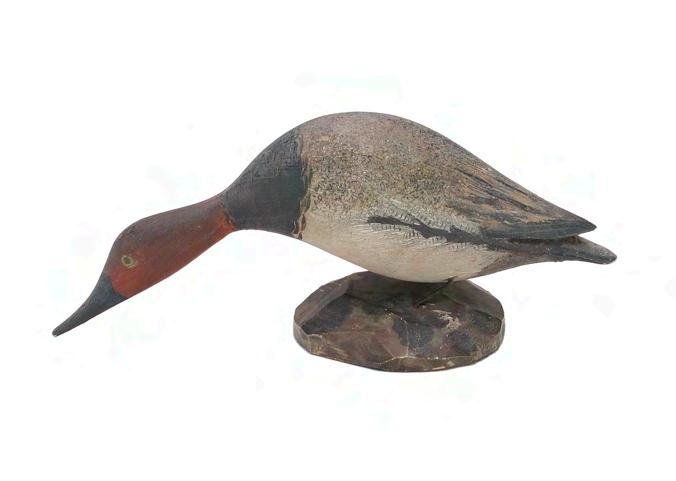
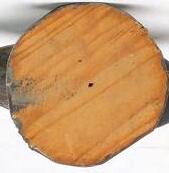


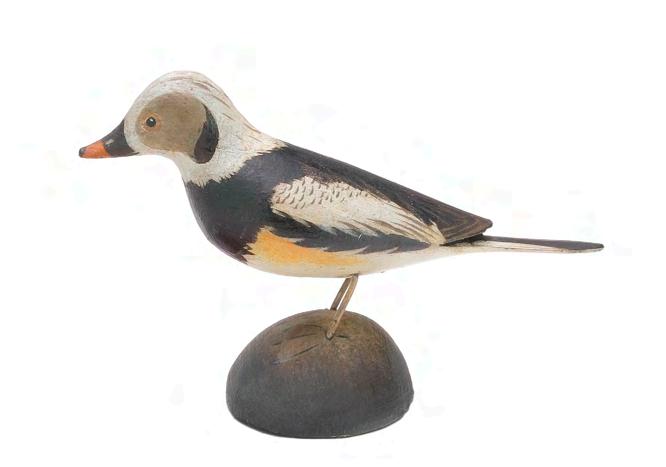



51 A. Elmer Crowell (1862-1951), East Harwich, Massachusetts. Miniature, running red-breasted merganser drake. Raised wing tips and extended crest feathers. Earlier example with white painted underside and excellent feather paint detail. Measures 5.5” long. Very good and original.
Provenance:
Alan and Elaine Haid collection. (1,500 - 2,500)

52 A. Elmer Crowell (1862-1951), East Harwich, Massachusetts. Early miniature redhead drake. Raised wing tips and fine paint detail. Maker’s mottled base with unmarked underside. Measures 4.25” long. Excellent and original.
Provenance:
Alan and Elaine Haid collection. (2,000 - 3,000)
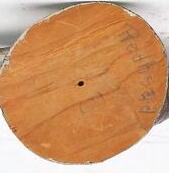
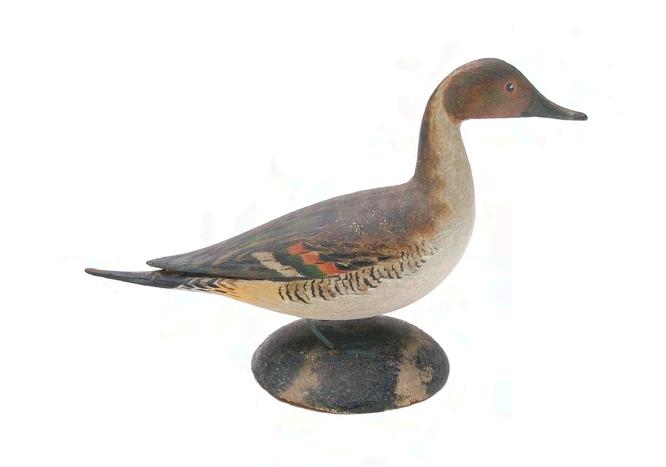

53 A. Elmer Crowell (1862-1951), East Harwich, Massachusetts. Early miniature pintail drake. Split tail carving and extended tail sprig. Standing on mottled base with unmarked underside. Measures 4.75” long. Professional neck crack and tail chip repair, otherwise very good and original.
Provenance:
Alan and Elaine Haid collection. (1,200 - 1,800)
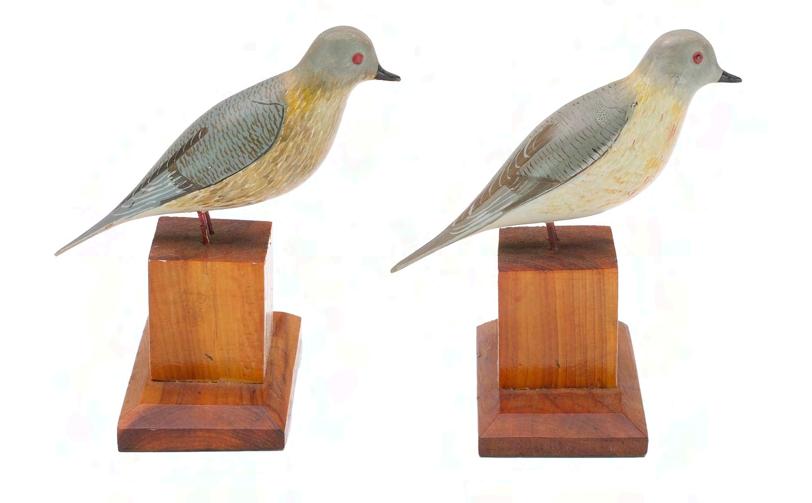
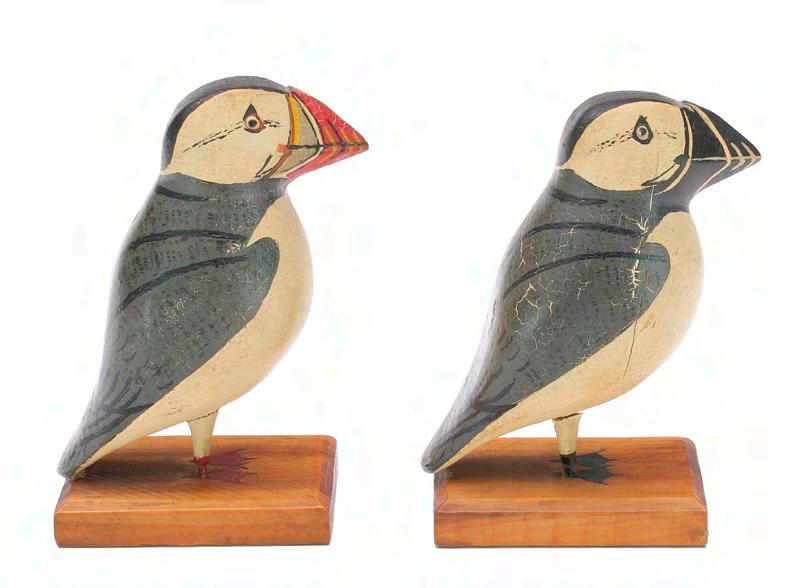
55 George Boyd (1873-1941), Seabrook, New Hampshire. Extremely rare pair of miniature puffins. Standing on wooden bases with chamfered edges. Stand 3.5” tall. Fine vertical hairline crack on one side of one; very fine crazing, otherwise excellent.
Provenance:
Alan and Elaine Haid collection.
Literature:
“Finely Carved and Nicely Painted”, by Jim Cullen, for history on Boyd miniatures. (6,000 - 9,000)
Provenance:
Alan and Elaine Haid collection.
Literature:
“Finely Carved and Nicely Painted”, by Jim Cullen, for history on Boyd miniatures. (4,000 - 6,000)
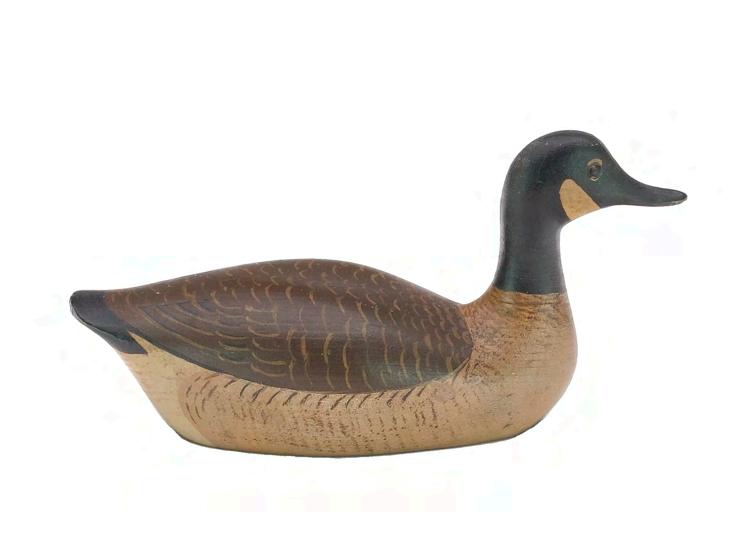
Provenance:
of tail; otherwise excellent and original.
Alan and Elaine Haid collection. (1,000 - 1,500)

Provenance:
Alan and Elaine Haid collection. (3,000 - 5,000)
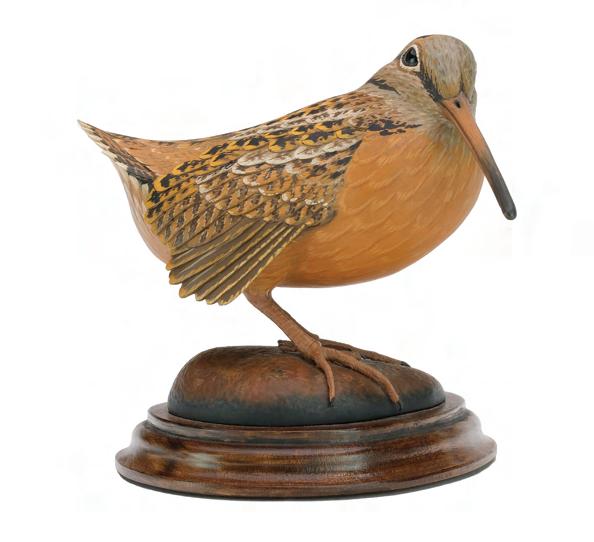
59 Eddie Wozny (b.1959), Cambridge, Maryland. Full size, decorative woodcock with turned head and dropped wingtips. Relief feather carving on wings and tail. Signed and identified on the underside of hardwood base. Measures 7” long. Excellent and original.
Provenance:
Alan and Elaine Haid collection. (800 - 1,200)
60
Unknown artist, 19th century, American. Oil on canvas laid to board of one perched and four flying passenger pigeon. Illegibly signed lower right. Image measures 18.25” x 13.5”. Painting appears to have been cleaned; areas of inpainting on lower half and in clouds of sky, mostly on right side.
Provenance:
Found in Maine.
Jim Cullen collection.
Alan and Elaine Haid collection. (2,000 - 3,000)
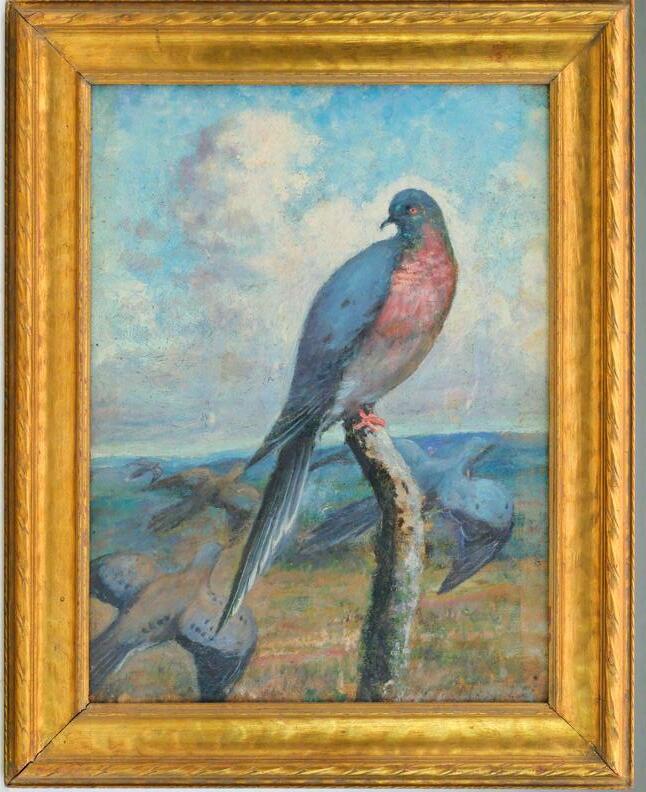
“- - - the overall effectiveness of his skill gave duck hunters just about the all-American working decoy”.
(Wm. Mackey 1970)
Ben was born into the large, blue collar, working family of Willam and Susan Schmidt. His parents had 11 children during their marriage and the family was supported by his father working as a lather in the housing trades, applying the wooden cleats to the walls upon which the finish plaster would be applied. The whole family was called upon for support and Ben dropped out of school after only the 6th grade to enter the work force. He and many of his brothers apprenticed under their father as lathers. For a brief period around 1900, he was employed as a “brush maker”, but soon returned to his father’s craft, except for a brief period during WWI when he worked as a welder at the Packard Motors plant in Detroit.
In 1910, Ben married Florence M Rasch who was working as a domestic at the time. The couple had


By the time of the Great Depression, the housing market and its associated industries fell into decline. It was during this period that Ben entered into the commercial decoy business as an adjunct to whatever lathing work he could obtain. He had hunted alongside his father since he was 16 and had made decoys for his own use beginning about 1914 when he shot for the market (see note 1) . His favored hunting area at that time was off Belle Isle where the Detroit River meets Lake St Clair. He must have also sold some decoys to fellow sportsmen during that period, the success of which persuaded him to begin large scale production at his home, beginning in 1934. In the early years of the business, he worked alongside his older brother, Frank (1879 – 1960). His peak production period occurred during the 1940’s and 1950’s when he was selling large numbers of his decoys through selected local sporting goods stores, including the huge Hudson’s Department store in downtown Detroit. By 1950, he and Florence had moved to Centerline, a suburb of Detroit, where he is listed in the census as “retired”. A 1955 article in the “Detroit News”, however, describes him as still actively carving at “a frame shop” on Van Dyke St in Centerline (see note 2) . His daughter, Virginia, estimates that her father made about 14,000 decoys in his lifetime. As Ben aged, the years took their toll. In 1968, a terminally ill Ben Schmidt took his last trip to the


with kindness and respect by all that knew him. One of Michigan’s most prolific, best liked, and talented carvers passed away just three days later.
Notes:
1.The date of his first decoy varies widely by author.
2.The same article also states that he had been carving for more than 60 years which would have meant that he carved his first decoy prior to 1895 at age 11.
 Point Mouillee Waterfowl Festival where he was met
Point Mouillee Waterfowl Festival where he was met
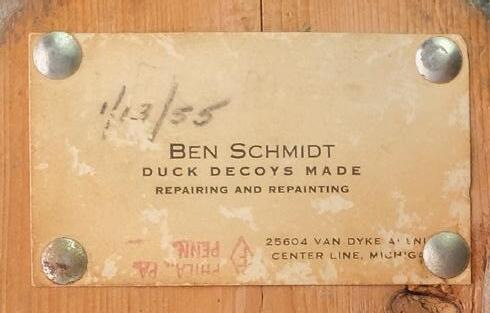
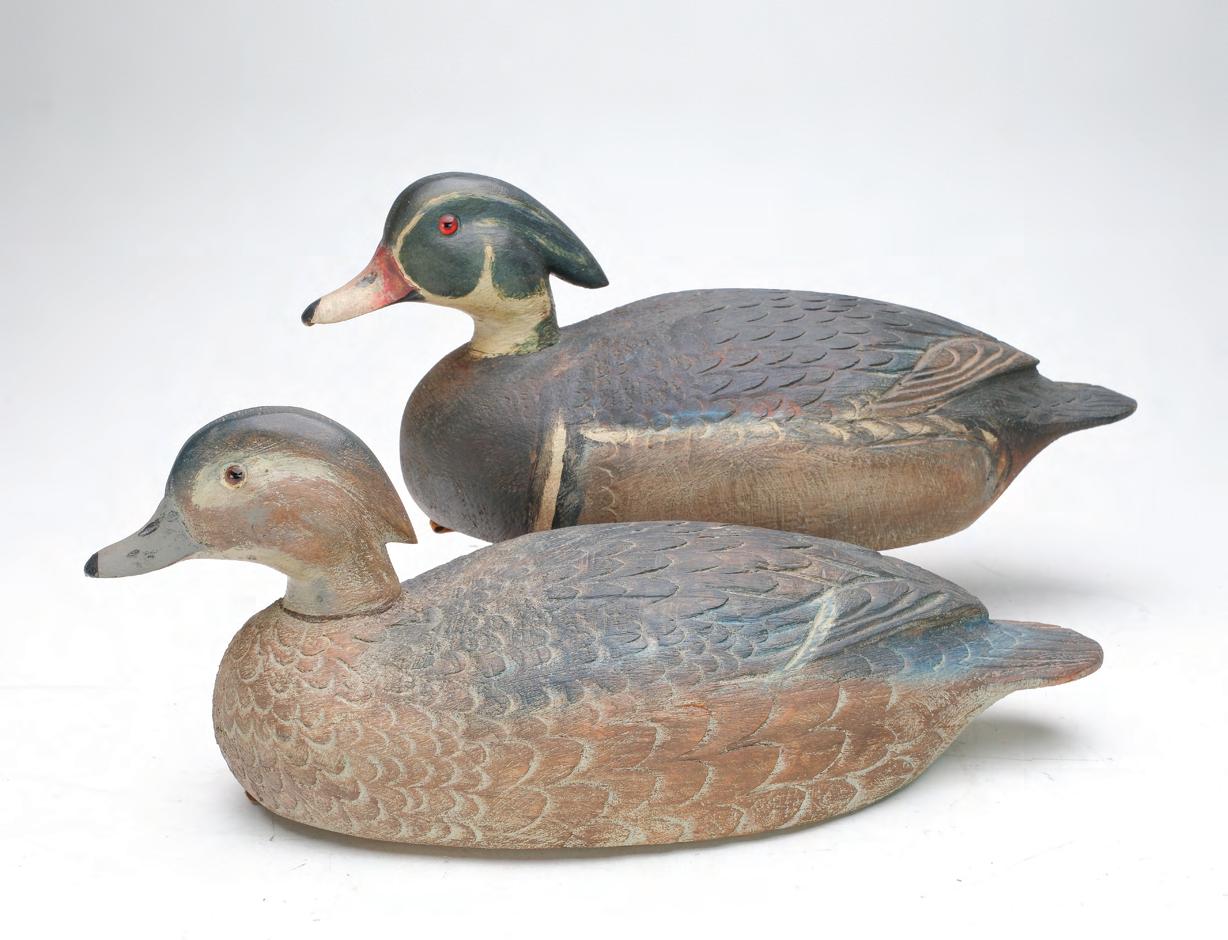
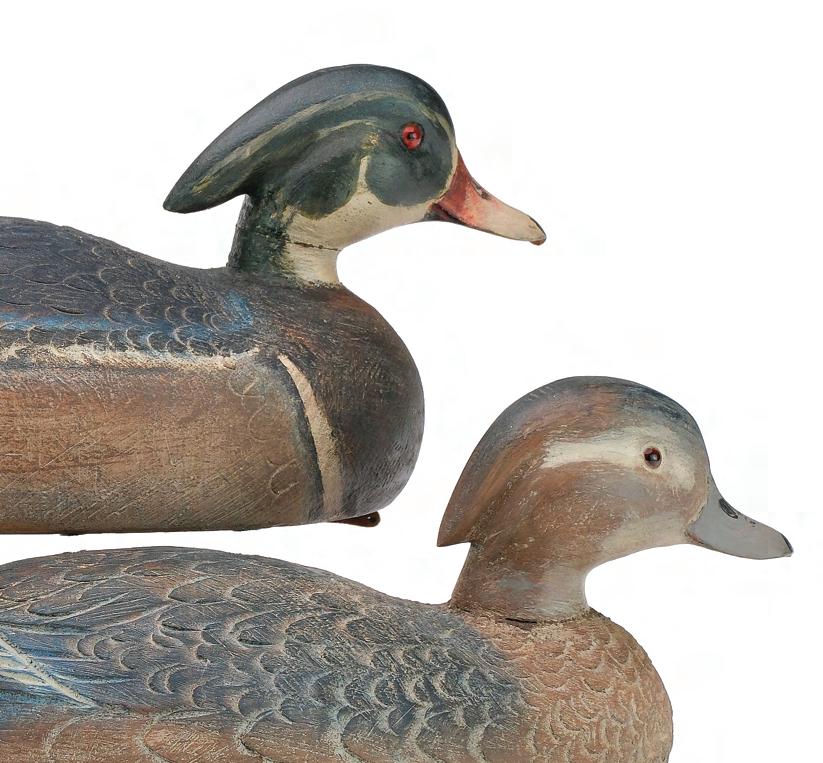
61 Ben Schmidt (1884-1968), Detroit, Michigan. Excellent rigmate pair of wood ducks with extended crests and extensive feather carving. Drake with the maker’s business card tacked to the underside. Both stamped “SGH” for the collection of Somers Headly on the underside, also dated 1955. Measure 15” long. Tight crack in one side of drake’s neck; small amount of old glue visible at hen’s neck seat; otherwise excellent and original.
Provenance: Somers Headley collection. Jim and Patti Aikin collection. (6,000 - 9,000)
62 Ben Schmidt (1884-1968), Detroit, Michigan. Excellent rigmate pair of pintails. Relief wing tip carving and feather stamping. Slightly raised heads and upswept tails. Signed and dated 1955 on the undersides. both stamped “SGH” for the collection of Somers Headly. Measure .5” and 18” long. Excellent and original.
Provenance: Somer Headley collection. Jim and Patti Aikin collection. (3,000 - 5,000)

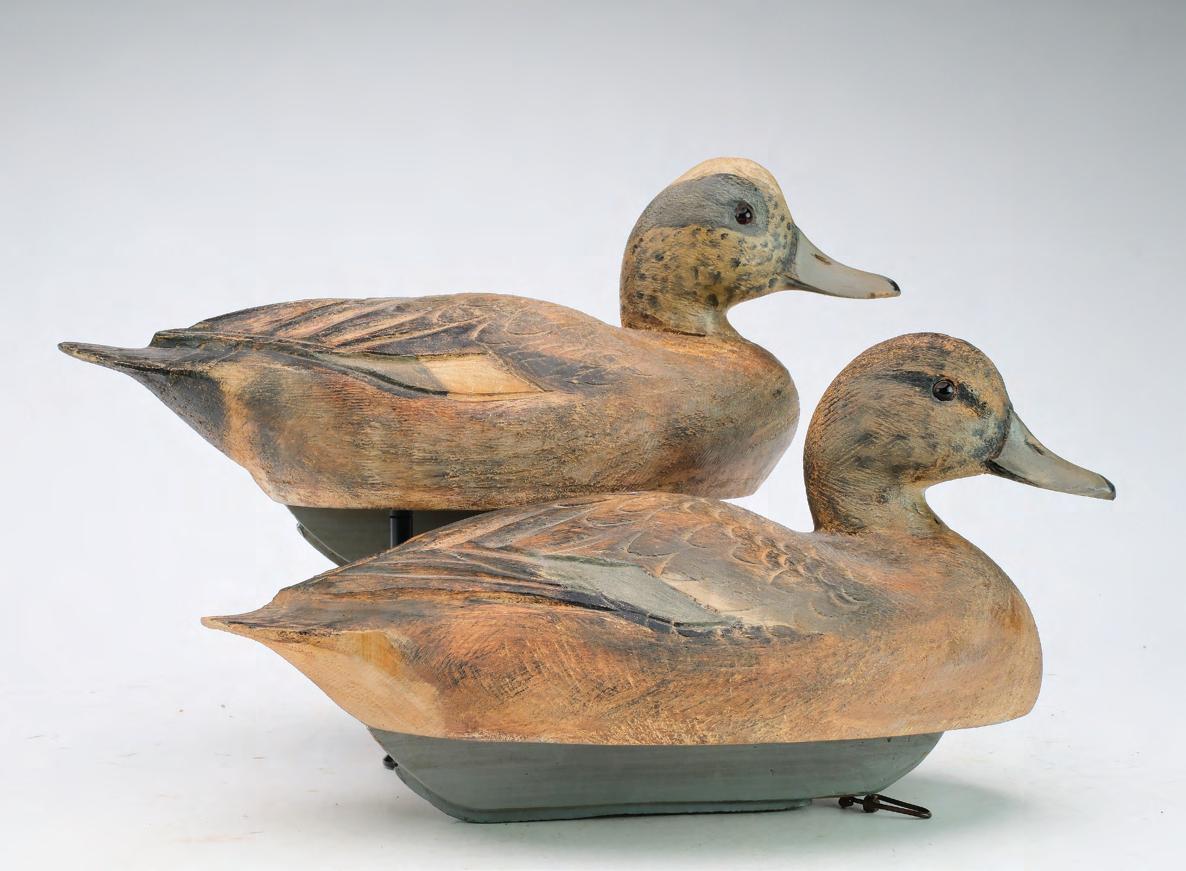
63 Ben
Detroit, Michigan. Rigmate pair of widgeon with slightly turned heads and deep relief wing feather carving. Measure 13.5” and 14.25” long. Both in excellent original condition; each has a spot on one side of upper bill that fluoresces under black light, but does not appear to have been repaired or repainted.
Provenance: Jim and Patti Aikin collection.
Literature: “Saginaw Bay Waterfowl Hunting and Decoy Carvers,” William A. Stout, p. 330 exact decoys. (2,000 - 3,000)


Hollow carved blue goose with slightly turned head. “E” carved in the underside. Decoy was hollowed from the underside with the keel being removed at some point. Measures 22.5” long. Original paint with minor gunning wear; lightly hit by shot; flaking and minor separation at neck seat.
Provenance: Jim and Patti Aikin collection. (5,000 - 8,000)
64 Ben Schmidt (1884-1968), Detroit, Michigan.65 Ben Schmidt (1884-1968), Detroit, Michigan. Greenwing teal with simple style feather stamping on back. Measures 13.75” long. Original paint with minor to moderate flaking and wear; minor roughness on edge of tail and bill; shallow dents in one side of body and head.
Provenance: Jim and Patti Aikin collection. (600 - 900)


67 Ben Schmidt (1884-1968), Detroit, Michigan. Ringneck with relief wing carving and feather stamping. Keel was removed at some point. Measures 14.25” long. Original paint with very minor gunning wear; old chipping at tip of tail, otherwise excellent structurally.
Provenance: Jim and Patti Aikin collection. (800 - 1,200)
66 Ben Schmidt (1884-1968), Detroit, Michigan. Goldeneye hen and drake. Drake with relief wing carving and slightly turned head. Body is hollow carved from the underside. Hen with feather stamping. Measure 13.5” long. Both are excellent and original.
Provenance: Jim and Patti Aikin collection. (1,200 - 1,800)



Provenance: Jim and Patti Aikin collection.
Literature: “Saginaw Bay Waterfowl Hunting and Decoy Carvers,” William A. Stout, p. 333 exact decoys.
(2,000 - 3,000)
Provenance: Jim and Patti Aikin collection. (800 - 1,200)

70 71

71 Ben Schmidt (1884-1968), Detroit, Michigan. Oversize black duck with relief wing feather carving. “EWC” branded on the underside. Feather stamping and carving on body. Measures 20.25” long. Original paint with very minor wear; small flake to filler on one side of neck seat; otherwise excellent structurally.
Provenance: Jim and Patti Aikin collection. (1,200 - 1,800)
Provenance: Jim and Patti Aikin collection. (1,200 - 1,800)
72 Christie Brothers (early 20th century), Saginaw Bay, Michigan. Extremely rare merganser hen with extended crest carving and comb feather paint detail. One of two known. Measures 19” long. Original paint with minor flaking and wear on body; head and neck with moderate flaking; minor roughness on edge of crest feather; some flaking to filler at a small knot in back.
Provenance: Ed Denavarre collection. Jim and Patti Aikin collection.
Literature: “Saginaw Bay Waterfowl Hunting and Decoy Carvers,” William A. Stout, p. 251 and back cover exact decoy. “Waterfowl Decoys of Michigan and the Lake St. Clair Region”, by Clune Walsh and Lowell Jackson, page 150, exact decoy pictured.
(4,000 - 6,000)
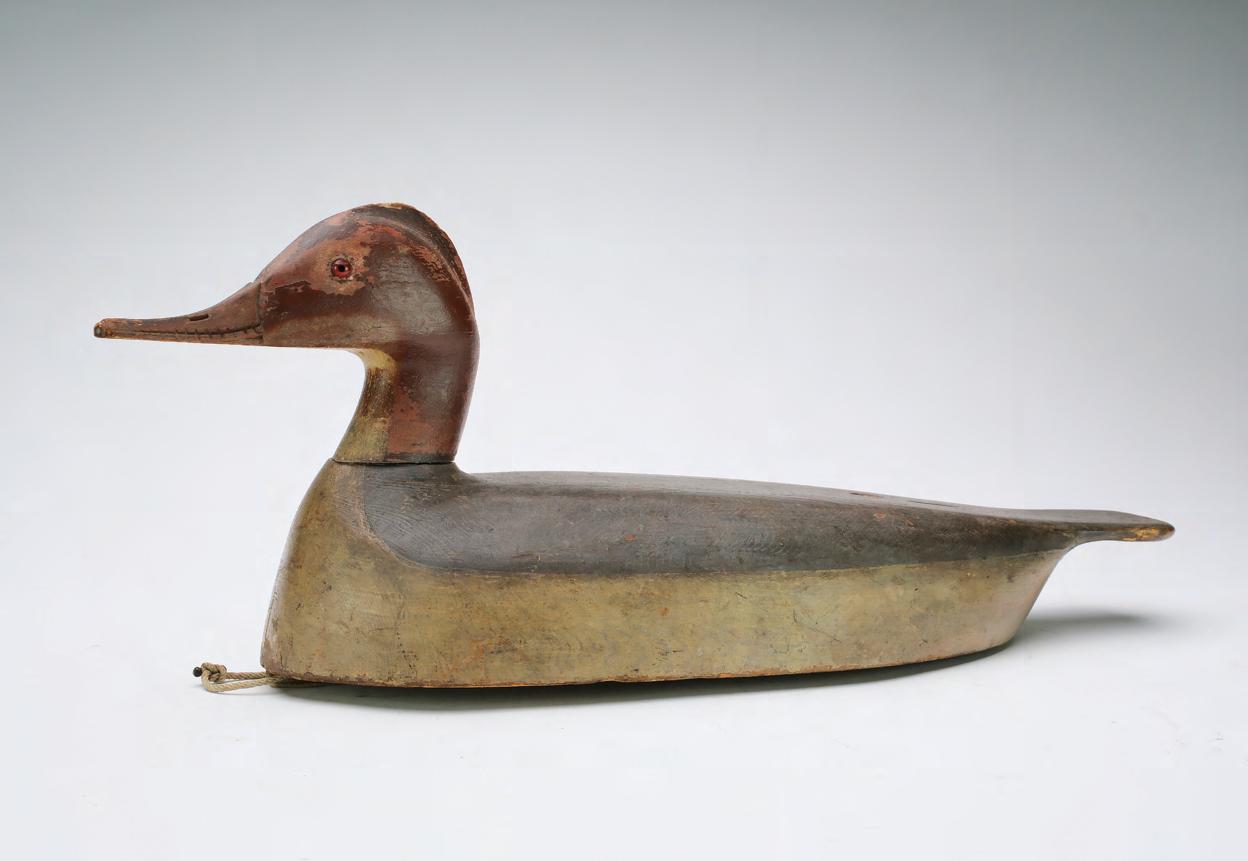

The bachelor brothers came from a very large family of seven children sired by Swiss born tailor, Joseph. All three sons bore the middle name of their father. The three young men began life in Detroit and when their father died in 1888, The eldest son, Bernard, (aka “Bernie” & “Barney”), assumed the role of head of household. The three brothers were living with their mother through the 1910 census, working at a wide variety of jobs ranging from “painter”, “sailor”, “screw machine hand” and “machinist”. Their father must have had a great love of the outdoors as is evidenced by his uniquely carved granite headstone in the form of a tree trunk and we can only assume that much of his admiration rubbed off on his sons. By the 1920 census the boys and his wife had moved to rural Sims, MI near where Saginaw Bay meets Lake Huron. Here Bernie became a farmer with his brothers working as farm laborers. By the 1940’s both Bernie and Henry had seemingly retired, and William is recorded as a “hunting and fis hing guide”. The three are credited with combining their talents to produce a small but fine rig of decoys, well suited to the local waters.
The Christie Brothers Bernard J (1866 – 1942), Henry J (1869 – 1949) William J (1884 - 1945) Detroit and Simms, Michigan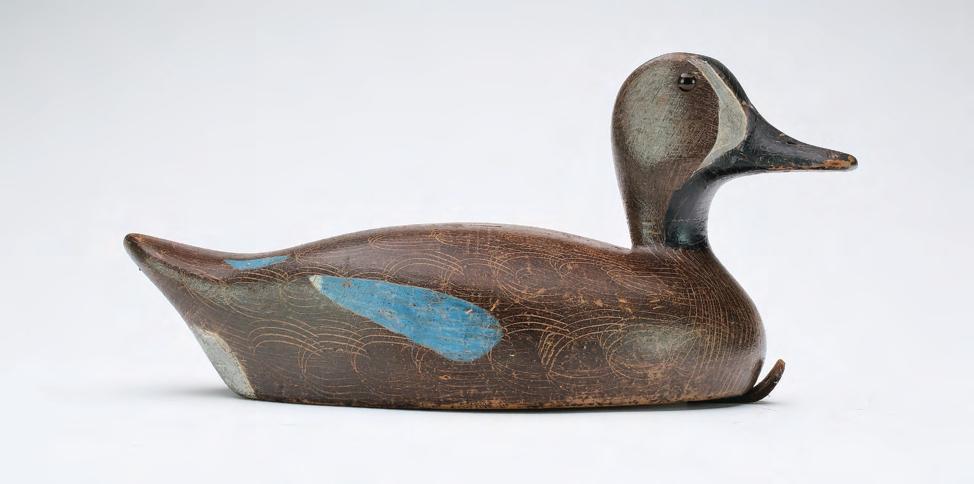
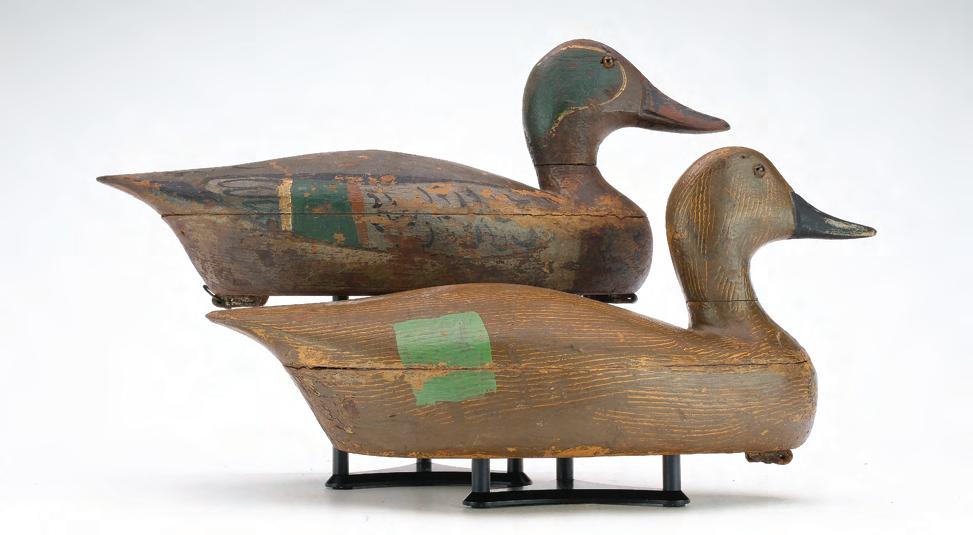
73 William Finch (20th century), Port Huron, Michigan. Hollow carved bluewing teal drake with slightly turned head and comb feather paint detail. “WF” carved on the underside. Measures 12.5” long. Original paint with very minor wear; a few small dents, otherwise excellent structurally.
Provenance: Jim and Patti Aikin collection. (2,000 - 3,000)
74 Unknown maker, 2nd quarter 20th century, Saginaw, Michigan. Hollow carved hen and drake greenwing teal, from the rig of Chris Smith. “CC” stamped on the underside for ChrisCraft. Possibly by William Finch. Comb feather paint detail on hen. Measure 14.25” long. Early paint appears original with moderate flaking and wear down to bare wood; small dents and hairline cracks; minor separation at body seams.
Provenance: Jim and Patti Aikin collection.
Literature: “Saginaw Bay Waterfowl Hunting and Decoy Carvers,” William A. Stout, p. 251 and back cover exact decoy.



75 Ed “One Arm” Kellie (18831955), Monroe, Michigan. Rigmate pair of canvasbacks. Measure 13.75” long. Original paint with minor flaking and wear; very minor roughness on tips of bills; hairline cracks in hen’s body.
Provenance: Jim and Patti Aikin collection. (1,200 - 1,800)
76 Ralph Reghi (1910-1995), Detroit, Michigan. Pair of canvasbacks with weighted wooden keels. Feather rasping throughout. Measure 14.5” and 16” long. Original paint with minor wear; hen was hit by shot on one side; fine seam through hen’s head and neck where it was tightly reset; some roughness on drake’s lower edge and tail; fine hairline crack along one side of drake.
Provenance: Jim and Patti Aikin collection. (1,000 - 1,500)
77 Jon Jones (b.1955), Algonac, Michigan. Early working greenwing teal with slightly turned head and relief wingtip carving. “J.E.J. 77” carved on the underside. Also signed by the maker at a later date. Measures 12.25” long. Original paint with very minor gunning wear; under a thin coat of early varnish; excellent structurally. (600 - 900)

1896 - 1924 | Detroit, Michigan
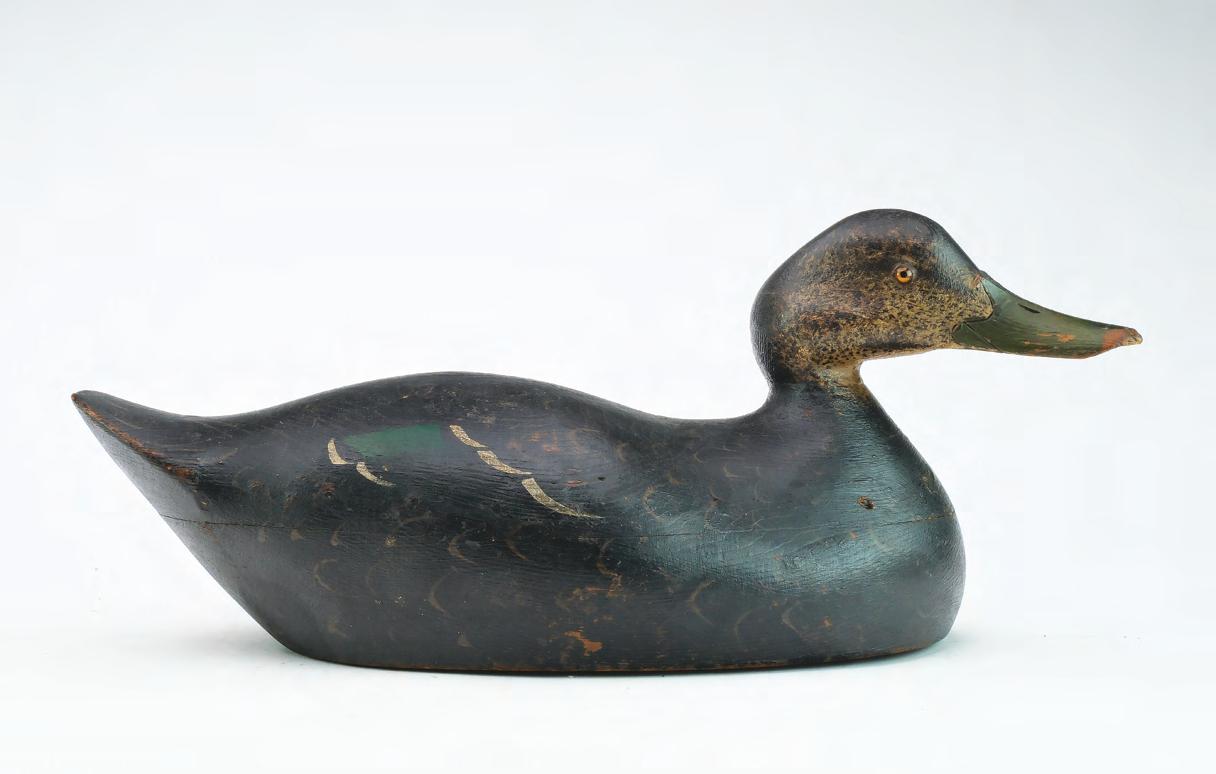
78 Mason Decoy Factory (1896-1924), Detroit, Michigan. Early slope breasted black duck with slightly turned head. Hollow carved premier grade with relief bill carving and upswept tail. This exact decoy is pictured on the cover of “Mason Decoys: A Complete Pictorial Guide”, expanded edition, Russ J. Goldberger and Alan G. Haid. Measures 16.75” long. Original paint with minor flaking and wear; very lightly hit by shot; some of the small spots of filler above nail holes at body seam have flaked away; hairline crack in breast and along one side of back;
(8,000 - 12,000)


79 Mason Decoy Factory (1896-1924), Detroit, Michigan. Outstanding early pintail, circa 1900. Hollow carved premier grade with thick swirl paint. Rigmate to the one pictured on p. 33 of “Mason Decoys: A Complete Pictorial Guide”, expanded edition, Russ J. Goldberger and Alan G. Haid. Measures 19.5” long. Excellent original paint with almost no wear; fine hairline crack in each eye; minor roughness on edge of bill tip; professional repair to a 3/4” chip at the tip of tail.
(10,000 - 15,000)

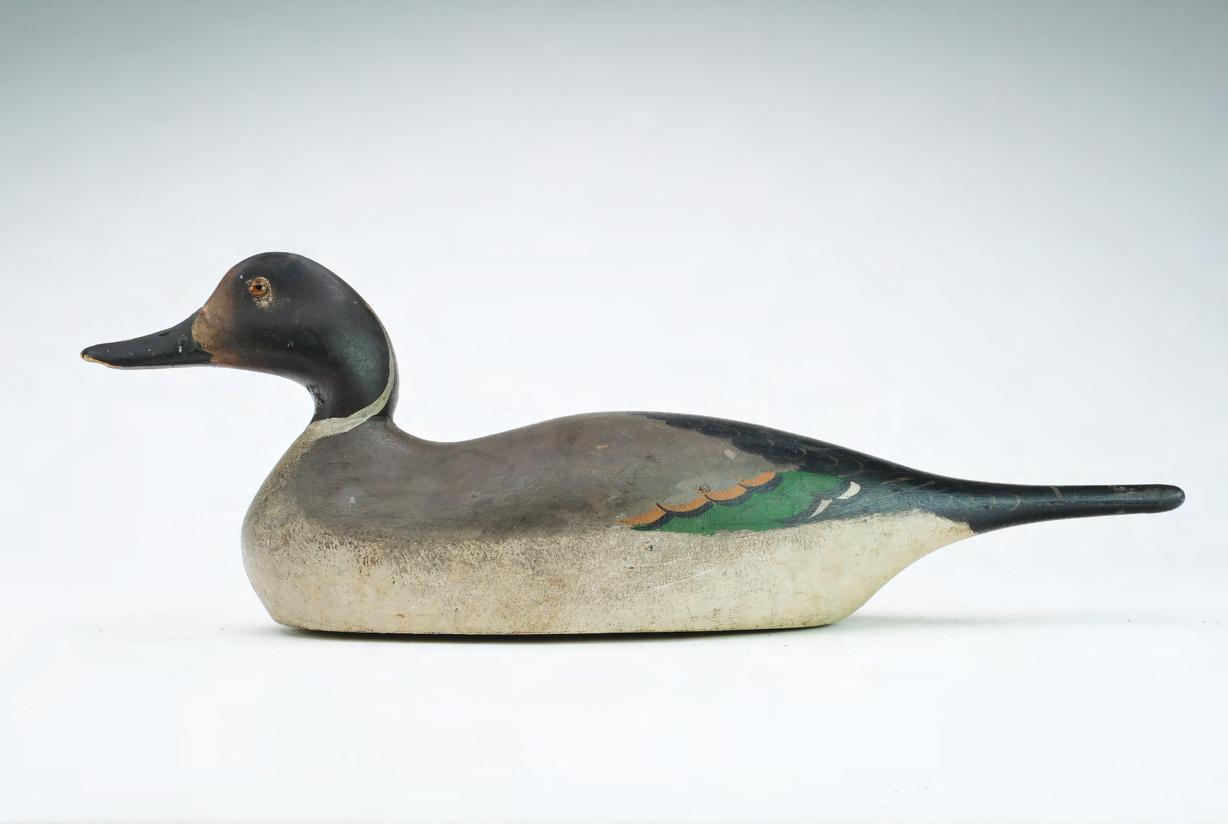
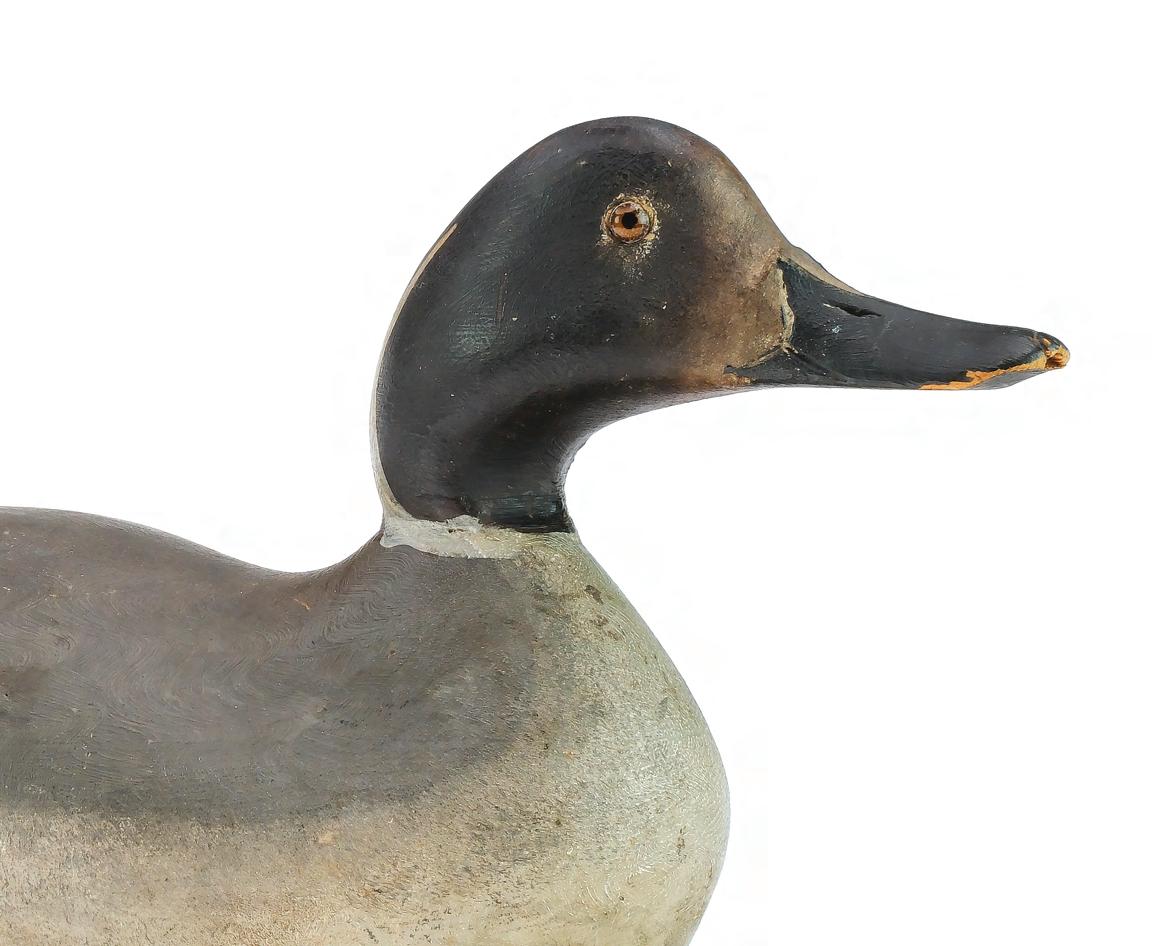
80 Mason Decoy Factory (1896-1924), Detroit, Michigan. Hollow carved premier grade bluewing teal with double blue paint pattern. Measures 12.25” long. Original paint with minor flaking and wear; mostly along bottom 1” of decoy; professional repair to the tip of bill, otherwise excellent structurally.
Provenance: Randy Rall collection. (4,000 - 6,000)
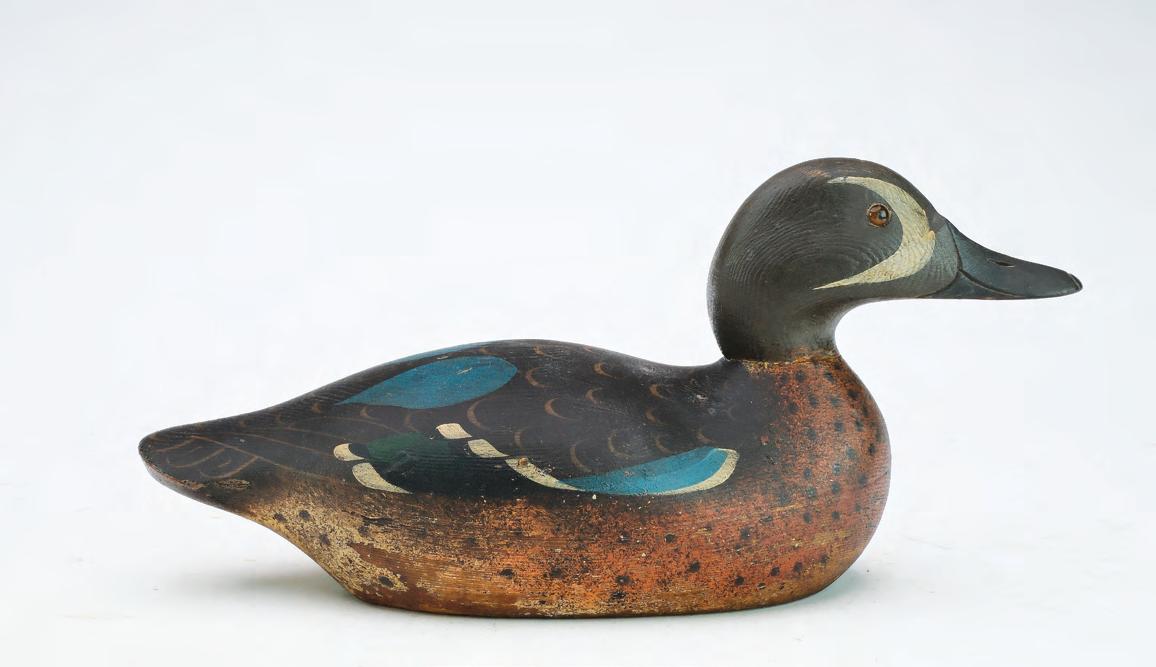
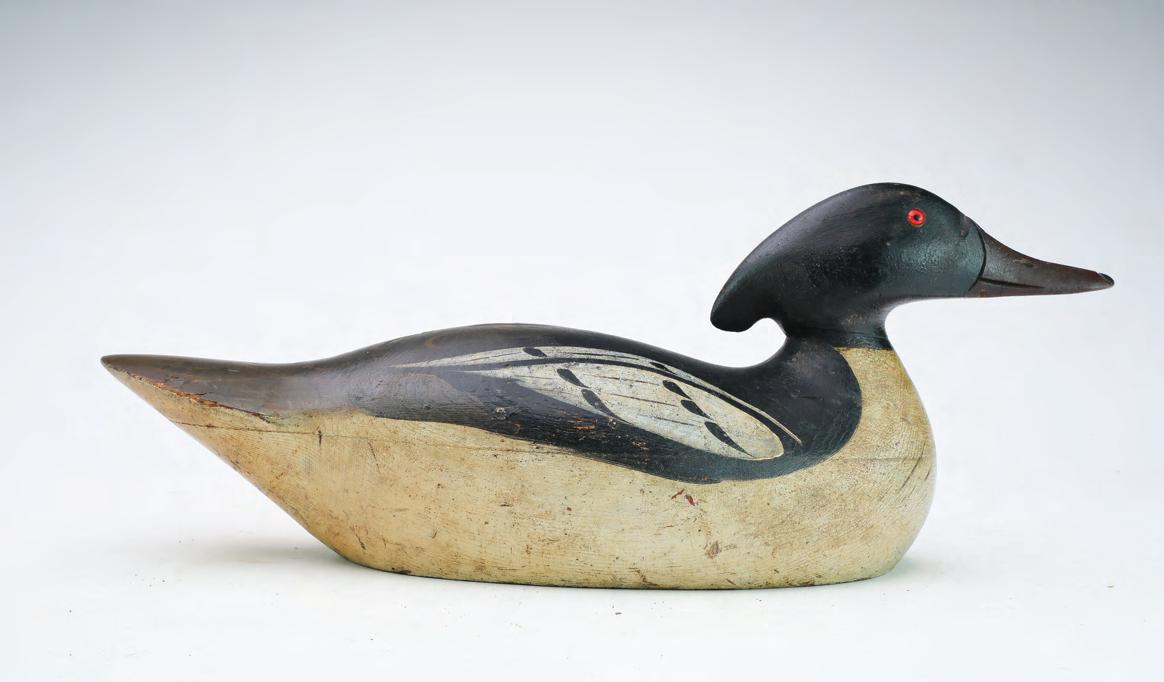
81 Mason Decoy Factory (1896-1924), Detroit, Michigan. Hollow carved premier grade merganser drake with extended crest. Measures 18.25” long. Original paint with moderate wear; professional bill crack repair with touch up on bill; neck filler restoration; some early paint restoration on top of tail. (5,000 - 8,000)
82 Mason Decoy Factory (18961924), Detroit, Michigan. Near mint pair of mallards. Painted eye models with thick sponge painting on hen. Measure 16” long. Excellent original paint with almost no wear; some discoloration on drake from age; retain 99% of their original neck filler; likely never used.
Provenance: Purchased from Al Nyberg at the St. Charles show, 1984. Private southern collection.
(2,000 - 3,000)

83 Mason Decoy Factory (18961924), Detroit, Michigan. Excellent rigmate pair of bluebills. Painted eye models with “RAH” branded on the underside. Measure 13.5” long. Original paint with very minor wear; drake with very minor flaking to original neck filler; hen retains 90% of the original neck filler with a small amount restored; brown area on one side of hen’s tail and back from something added to surface long ago, does not appear to be paint.
Provenance: Purchased from Al Nyberg at the St. Charles show, 1984. Private southern collection.
(1,200 - 1,800)
84 Mason Decoy Factory (18961924), Detroit, Michigan. Standard grade redhead with painted eyes. Measures 13.5” long. Original paint with minor to moderate wear; most of the neck filler is missing, what remains is original; two small chips and roughness on edge of tail; flaking at a knot near tail.
Provenance: Jim and Patti Aikin collection. (200 - 400) 82
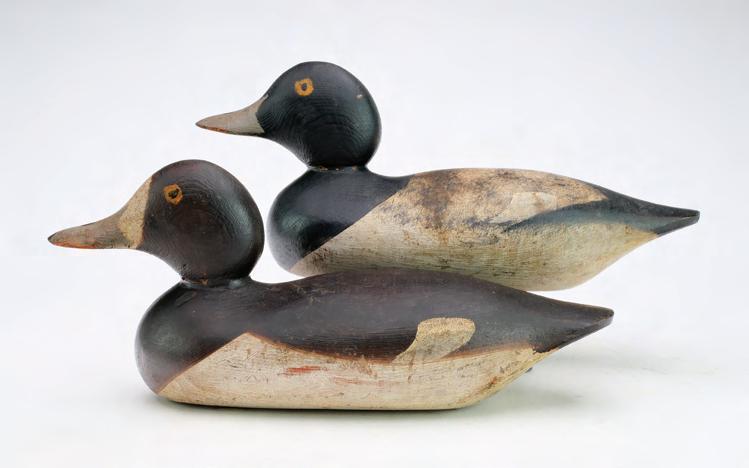
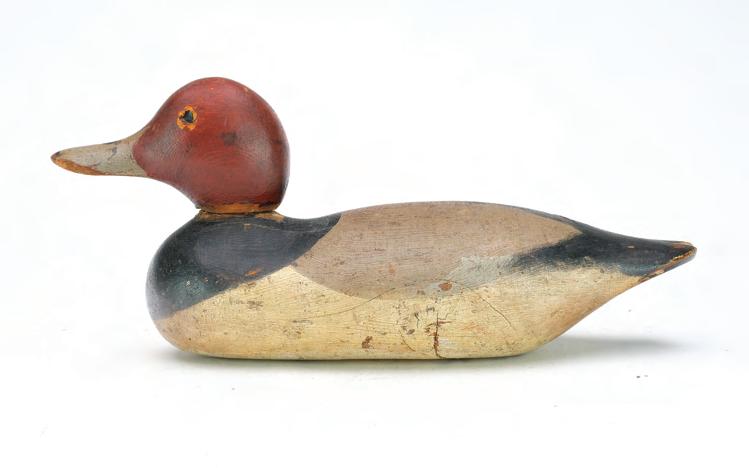

86 Mason Decoy Factory (18961924), Detroit, Michigan. Very early slope breasted premier grade model black duck. Hollow carved with slightly turned head. “F.B.G.” branded on the underside. Measures 15.25” long. Original paint with moderate flaking and wear under an early coat of varnish; neck filler has flaked away; tight drying cracks in breast; old chip on tip of tail.
Provenance: Jim and Patti Aikin collection. (1,200 - 1,800)
85 Mason Decoy Factory (18961924), Detroit, Michigan. Very early mallard drake with slightly turned head. Measures 14.75” long. Original paint with minor discoloration and wear; some flaking to filler on the underside; bill is a professional replacement.
Provenance: Randy Rall collection. (2,000 - 3,000)


87 Mason Decoy Factory (18961924), Detroit, Michigan. Early slope breasted challenge grade model with upswept head and tail. Measures 16” long. Original paint with moderate flaking and wear; professional restoration to neck filler and a chip at tip of bill.
Provenance: Randy Rall collection. (1,200 - 1,800)
88

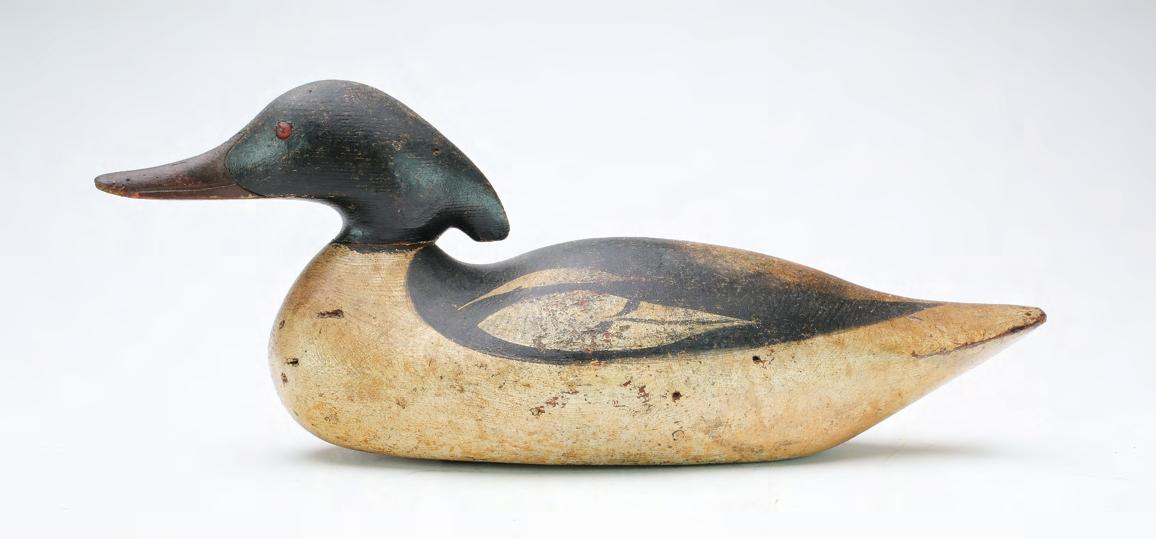
89
Mason Decoy
(1896-1924), Detroit, Michigan. Challenge grade merganser drake with extended crest. Measures 17” long. Original paint with moderate gunning wear under an early coat of varnish that has darkened with age; lightly hit by shot; minor roughness on tip of bill; small amount of glue visible at neck seat.
(3,000 - 5,000)
(5,000 - 8,000)

George was a young man in his twenty’s when his family immigrated to Canada from England. The group, including George’s brother, James, and his wife Sarah, settled in Toronto. In need of work, they found ample opportunities on the city’s thriving waterfront, teaming with business’s catering to the boating industry. Large commercial craft plied the waters of Lake Ontario and recreational boating was extremely popular. Smaller boats were in demand by canoeists, fishermen, sailors, and hunters. Racing of all sorts was a particularly fashionable pastime. By 1868, George is found in the city directory, listed as a “boat builder” (his younger brother James is similarly listed as early as 1863). Both men were talented craftsmen, and this trade would sustain them for the remainder of their lives. Both found employment with a boat building company owned by Bob Renardson and, by 1876, they had bought the company from him while retaining Renardson as an employee. The new company became “G & J Boatbuilders”. Both brothers applied for, and were granted, a number of Canadian patents for various improvements they made in the industry, George for a “Warin’s shooting skiff” and James for an “Improvement in oars”
among others. George himself was a very talented rower and was the person who taught Ned Hanlon who would go on to become five-time world champion. Hanlon was subsidized by well-known Toronto decoy maker David Ward (1838 – 1912), so Warin was very likely familiar with him and his decoys.
George was, for the longest time, a bachelor who boarded with his brother, his wife, children, and a “servant”. When James died in 1884, George married Sarah a short three years later. He was 57 and she, 33. Sarah had five children with James and would go on to have an additional five with George, resulting in the obvious necessity of the large home which they owned on 116 Seaton St.
George was an avid duck hunter and, apparently, a very good one. He became one of the founding members of The Saint Clair Flats Shooting Company in 1874 and, in 1901, was selected to guide, and supply the decoys for, the Prince of Wales (who became King George V) and his party on a trip to Lake Manitoba. Unfortunately, one of his hunting trips involved an accidental gun discharge resulting in the loss of his left hand and portion of his lower forearm.

Being a master woodworker and boatbuilder, Warin obviously possessed the skills, tools, and materials necessary to carve his own decoys. He sold a few of his decoys locally, but most found their way into the rigs of wealthy sportsmen at the prestigious clubs of the day, such as the Saint Clair Flats Club and the Long Point Club. His birds closely adhered to the accepted local standard, both in form and construction. His, however, with their finely applied painted surfaces, are considered among the best.
His success allowed him to enjoy a comfortable life. In addition to his large, nicely appointed home in Toronto, he maintained a fine retreat at Hanlan’s Point on Toronto Island in Toronto Harbor where he enjoyed his later years. He named his home on the Island, “Fort Warin” and it was there that he passed away.
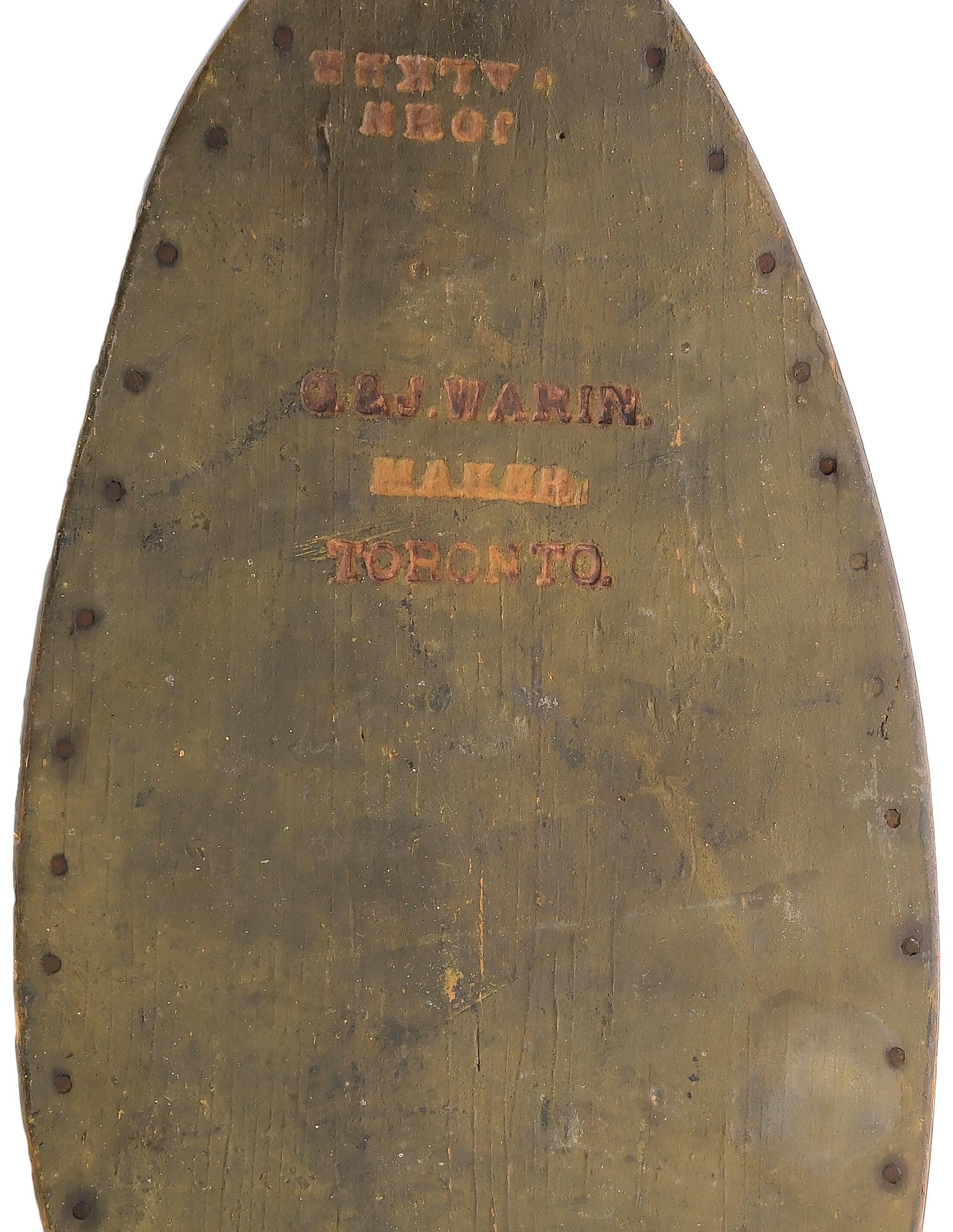
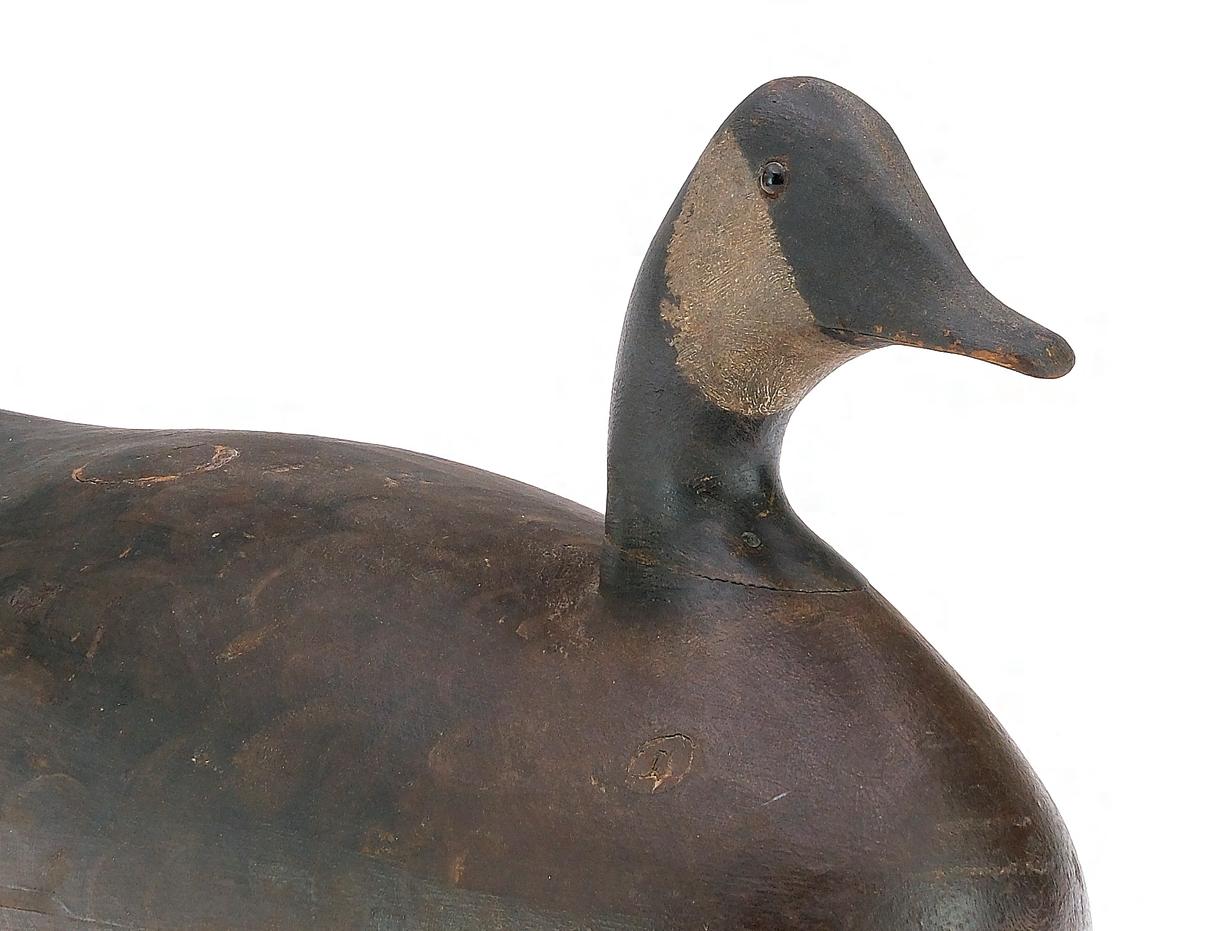
Exact decoy used for 2008 show pin.
90
George Warin (1830-1904), Toronto, Ontario.
Outstanding hollow carved Canada goose. Branded “G. and J. Warin. Maker Toronto”. Also branded “John Walker”. Excellent subtle feather paint detailing. Measures 21.5” long. Excellent original paint with minor flaking and wear; minor separation at a knot in the back; professional repair to a tight crack in lower part of neck; otherwise excellent structurally.
(40,000 - 50,000)

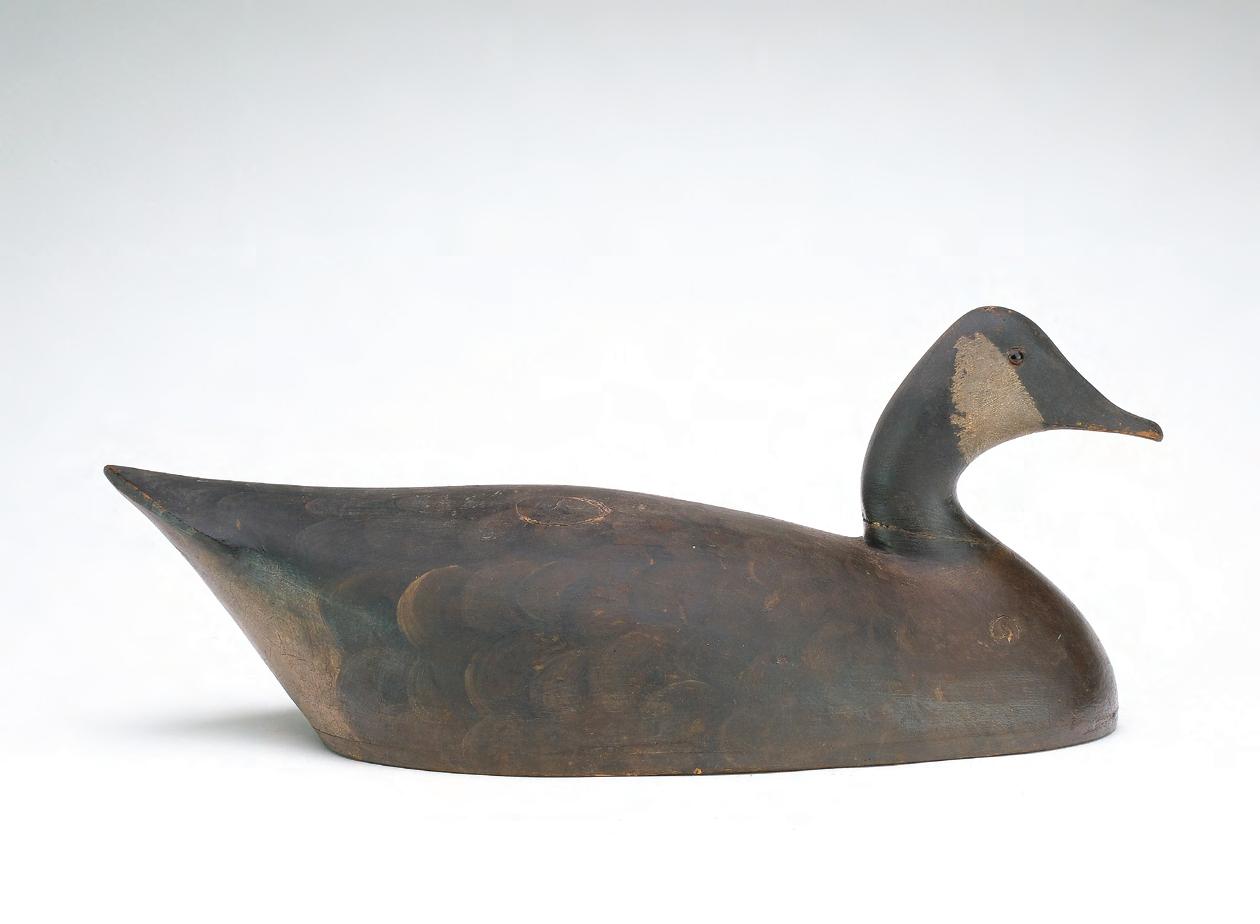
Col. John Walker - Industrialist, 1832 – 1889, London Ontario, Member St Clair Flats Shooting Company 1886 – 1889
Walker was born in Scotland. He was chosen by a group of Scottish investors to develop their agricultural and oil interest in Canada, and this resulted in his immigrating to Bothwell, Ontario in 1864. He soon adapted to the community, quickly becoming a Magistrate. He moved to London, Ontario in 1867 where he established a chemical plant and a very successful oil refining business. His credentials are typical of the wealthy and influential members of the St Clair Flats Club.
*Co-Founding Director Imperial Oil.
*Vice President Canadian Pacific RR
*Lieutenant Colonel, Canadian Militia
*Member of the Canadian Parliament 1874
*President of the School of Art and Design
*President of the Mechanics Institute and the St Andrews Society
*Co-Founder London, Ontario Protestant Orphans Home
A group of fine, Toronto style, decoys dubbed “The Markham Rig” are well known to collectors, but their story is a puzzling one. The label is the result of the fact that they were first discovered by collectors when, in 1969, three barrels or crates full of the birds were offered in an estate auction in Markham, Ontario, a city northeast of Toronto. The story relates that they had been stored for many years in a local barn. Some of the decoys were unfinished and, of those that were finished and painted, many had never been rigged (see note 1). The group contained decoys from more than one carver with some today suggesting up to 4 or possibly even 5 different makers. All of the birds possessed a surface and patina that suggested a c1900 date of origin. Many of the decoys in the group share certain similarities such as being hollow carved with a thin, (usually) brown painted bottom board, a pronounced high back profile, and detailed bill carving that is quite distinctive.
Over the last 50 plus years, numerous attempts have been made to sort out the story. It appears that the barn where they had been found was once the property of the Morley family. It has been suggested that a brick manufacturer, Walker T Morley (1833 – 1922), or perhaps one or more of his sons, Walter, George, William, Henry, and Alfred were the makers of at least some of the rig. Walker lived in nearby York, roughly halfway between Markham and the Toronto waterfront. The name George Laing has also been bantered about. To


add to the confusion, birds by the same hand(s) have since appeared at additional locations. Conceivably, different family members or associates gunned over all or portions of the rig at various times and locations and, at some point prior to 1969, shipped them to the Morley barn in Markham for storage. At this juncture, only the decoys themselves know the full story.

Notes: 1.Some have voiced the opinion that rather than ”unfinished”, they had been “stripped” by an antique dealer who purchased them at auction.
**(Guyette and Deeter wishes to thank Paul Brisco and David Ness for their knowledge and access to articles published in The Canadian Decoy and Outdoor Collectibles Association Newsletter, “The Rig” for information used in this writeup.)
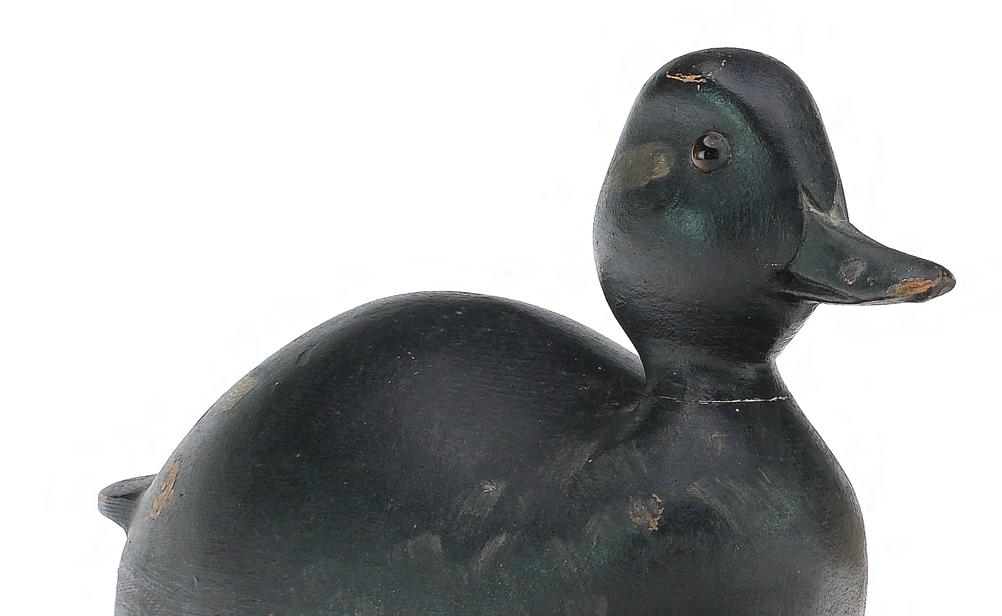

91 Unknown maker, circa 1900, Markham, Ontario. Outstanding and extremely rare rigmate pair of bufflehead from the Markham rig. These decoys were found in Markham, Ontario in 1969 with decoys of other species all carved by the same talented maker. Thinly hollowed with .25” bottom boards and detailed bill carving. One of only a few drakes known, the hen is the only example known. Measure 10” long. Original paint with very minor flaking and wear; small dent on the top of drake’s head; otherwise excellent structurally.
(20,000 - 30,000)
92
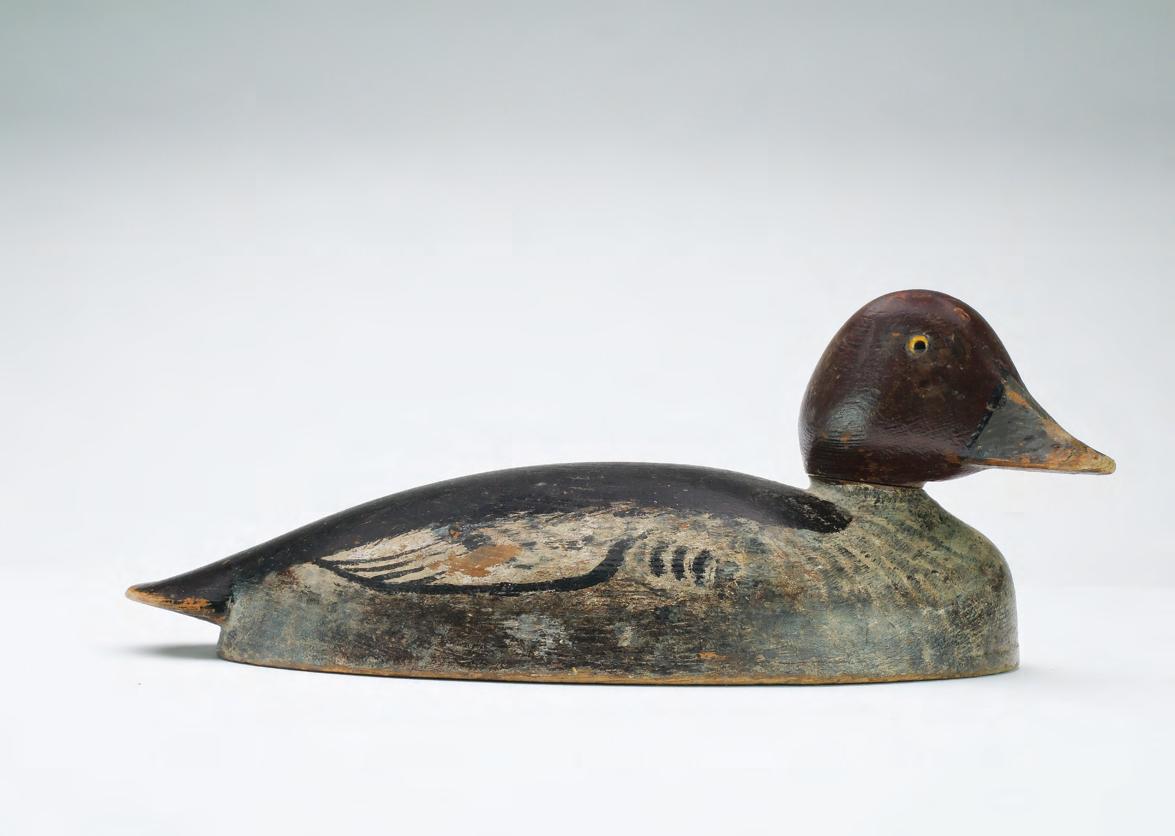
James Harper (1857-1948), Hamilton, Ontario. Extremely rare hollow carved goldneye hen with head turned 45 degrees. “H” stamped in lower breast. Believed to be the only known goldeneye hen by this maker. Measures 13.25” long. Original paint with moderate gunning wear under a thin coat of varnish; hairline crack along one side of head and on tail.
(4,000 - 6,000)
Unfortunately, even with the passage of time and multiple research attempts, little is known about Mr. Harper. He was born in Hamilton to his salesman father, William, and his wife, Sarah Davis, both of whom had immigrated to Canada from England. One reference indicates that he may have been a sign and carriage painter, but the first documentation of his working life is the 1881 census where he is listed as still living with his parents and employed as a “plumber”. In 1883, he married local girl Maggie Rolston and is referred to as being an “Agent” (perhaps postal agent?). The 1886 Canadian Civil Servant List records him as a “Mail Transfer Agent”, being first appointed to that position in 1884. He remained in the Postal Service until his retirement in 1907. He was very active in the Ontario West Division of the Grand Orange Lodge, serving as its Grand Treasurer at the time of his death.
His decoys followed in the Hamilton tradition where the hunters enjoyed a shooting method known as “screening”. In this technique, decoys were set well off the beach and when the birds alighted in the rig, the gunners would skull out to them. Attention to detail was paramount.
He is known to have only made one rig of decoys and only a few of these have survived. He possessed a certain artistic talent as evidenced by some of his sketches. His decoys are finely painted, being influenced by Alexander Pope and his work is regarded as inspiring the carvings of his contemporary and neighbor, Ivar Fernlund.

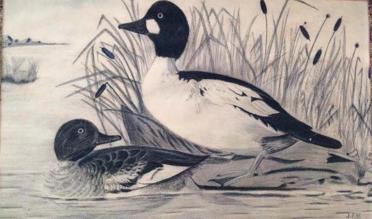
Howard Graves Meredith – British Consulate and Railroad interest
1856 – 1934, Detroit, MI.
Member St Clair Flats Shooting Company 1894 - 1935
Howard was born in Port Hope, Canada to Irish immigrants. By 1871, he had found employment as a railroad cashier. Immigrating to the United Sates in 1875 he, once again, served in that capacity. In 1890 he married into wealth when he met and wed socialite Helen Newbold in Detroit. He was appointed vice consulate to England in 1908, advancing to full Consulate by 1924. During his lifetime he served in various capacities with the Grand Trunk as well as the Western and Michigan Central Railroads. His wife died in 1917 and Howard lived out his life comfortably with a staff of three, including a cook, housekeeper, and butler. He is remembered as a prominent member of Detroit society, retiring to his private lake and 500-acre wild bird and game sanctuary near Detroit.

Harry Norton Torrey – Physician and Surgeon, 1880 – 1945 | Detroit, MI.
Member St Clair Flats Shooting Company 1935 – 1946
Born in Ceston, Iowa, Torrey was trained at Kent College, The University of Michigan and John Hopkins University before establishing his medical practice in Detroit. During WWI he served as a major with the Harper Hospital field unit and saw front line duty while attached to the British, French, and Italian armies. Returning from the War, he became a highly successful and respected practicing surgeon, associated with the Michigan Mutual, Charles Goodwin Jennings and Harper Hospitals, all in Detroit. Torrey was a noted sportsman, actively participating in fishing, golf, and racquetball. He was particularly well known as an excellent wing shot and he made at least one trip to Africa on safari. He maintained a winter residence at Ossabaw Island, Georgia where he entertained President and Mrs. Calvin Coolidge. He resided at affluent Grosse Pointe where he is remembered as a prominent member of society.
93
Unknown maker, circa 1900, Toronto, Ontario. Very thinly hollowed redhead hen from the St. Clair Flats Shooting Company. One of six redheads purchased by Harry Seitz and Barny Crandall from the St. Clair Flats Club circa 1970. Branded “Meredith” for Howard G. Meredith Club member 1894-1935. Also branded “HNT” for Harry N. Torrey, Club member 1935-1946. Measures 13.25” long. Original paint with minor flaking and wear; some over paint at the wing patches was taken down to the original surface; two small dents in one edge of tail, otherwise excellent structurally.
Provenance: Howard G. Meredith rig. Harry N. Torrey rig. Harry Seitz collection. Roger Young collection. Private New England collection. (5,000 - 8,000)
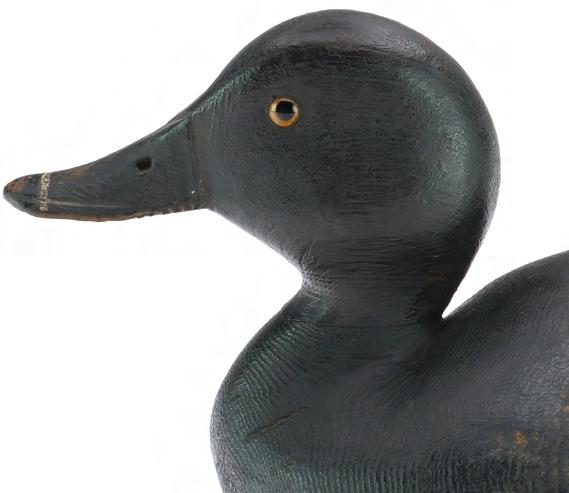

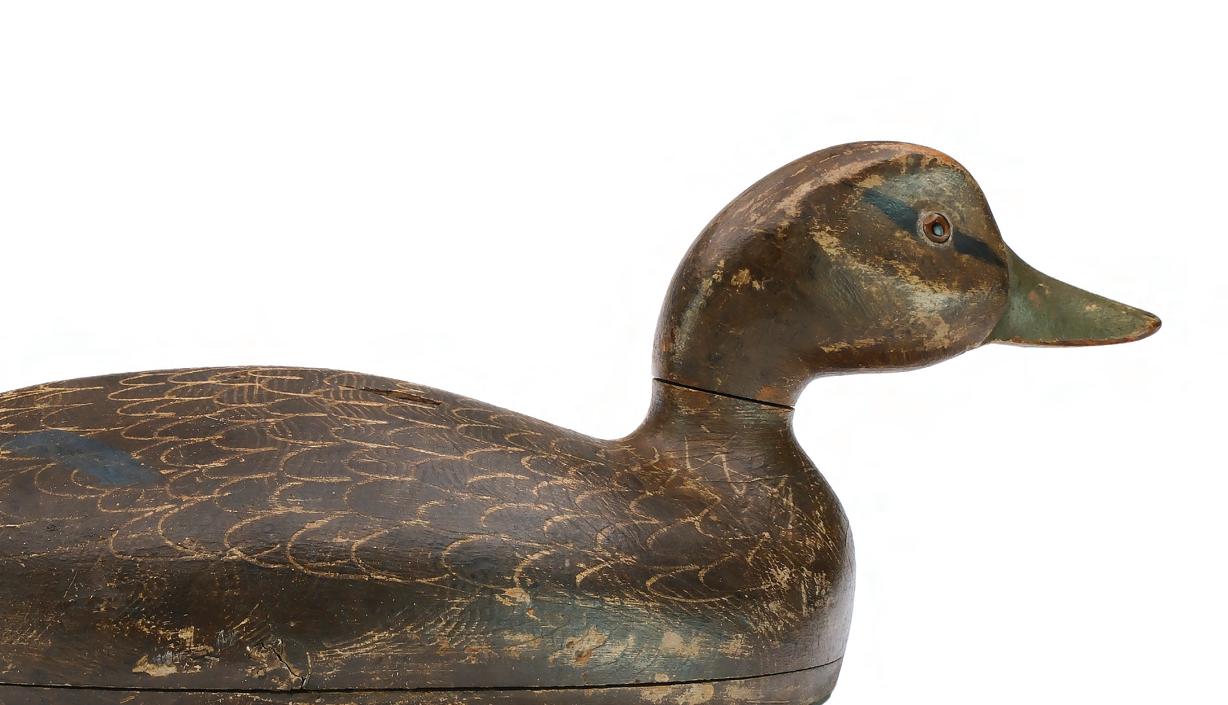
Unknown maker, Prescott/Ogdensburg area of Ontario, circa 1900. Very rare hollow carved black duck in a swimming position with head tilted forward. Hollow with bottom board. Comb painting on back with upswept tail. 15.5” long. Strong original paint with very light gunning wear; dent in back and some roughness at tail.
Literature: “Decoys of the Thousand Islands,” Jim Stewart and Larry Lundman, p. 165, exact decoy. (5,000 - 8,000)
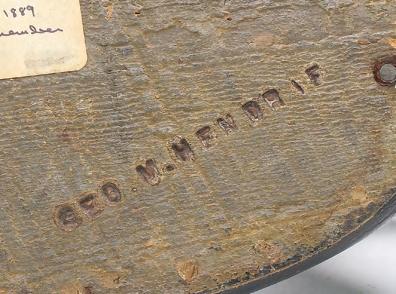
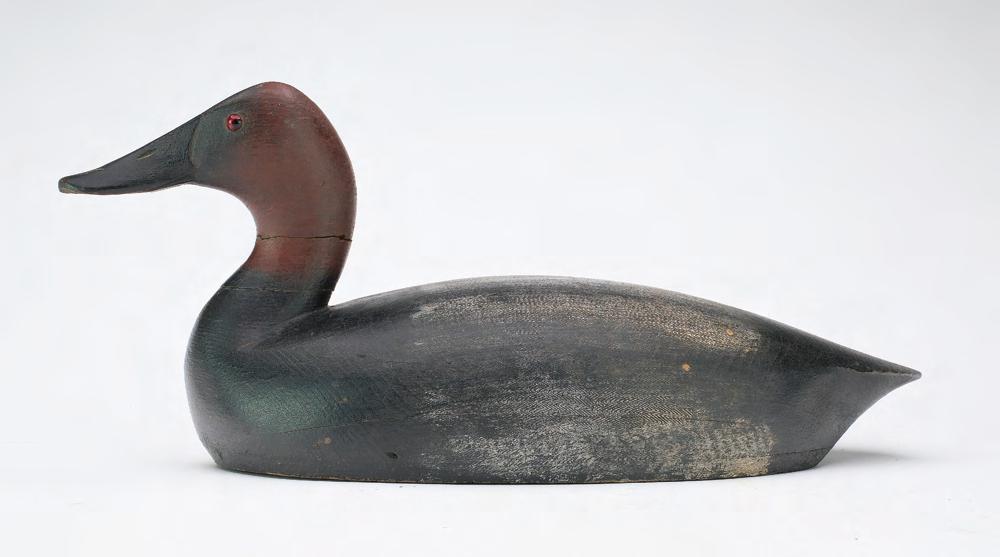

95 Thomas Chambers (1860-1948), Toronto, Ontario. Long body style canvasback drake. Branded “Geo. M. Hendrie” for St. Clair Flats member George M. Hendrie, club member from 1889-1943. Measures 17” long. Original paint with minor wear; crack through neck; very lightly hit by shot; a few small dents on top of bill.
Provenance: Peter Brown collection. Randy Rall collection. (3,000 - 4,000)

96 Thomas Chambers (1860-1948), Toronto, Ontario. Hollow carved redhead drake. Branded “HMJ” and “WLM” for Harry M. Juette, and William L. McMillan. Both Long Point Club members. Measures 16.25” long. Original paint with minor wear; touchup on top of bill.
Provenance: Randy Rall collection. (2,500 - 3,500)

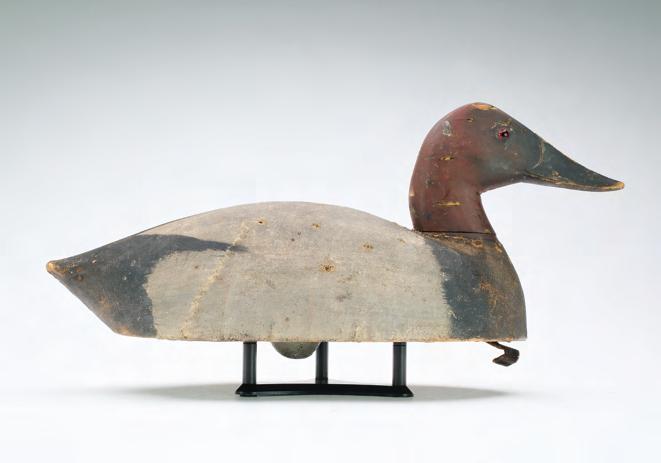
98 Charles Reeves (1872-1941), Long Point, Ontario. Hollow carved canvasback with “WW” painted on the underside. Donal C. O’Brien collection ink stamp on the underside. Measures 15.5” long. Original paint with moderate gunning wear; lightly hit by shot; minor roughness on tip of bill.
Provenance: Donal C. O’Brien Jr collection. Randy Rall collection.
Literature: “Decoying: St. Clair to the St. Lawrence”, by Bernard W. Crandell, page 87, exact decoy pictured. (1,200 - 1,800)
97 Charles Reeves (1872-1941), Long Point, Ontario. Solid body model canvasback with added canvas. “A. Cochran” branded on the underside. Measures 15.75” long. Original paint with minor gunning wear; hit by shot mostly in one side; minor roughness on tip of bill. (1,500 - 2,500)


99 Morris Boat Works (1874-1972), Hamilton, Ontario. Hollow carved redhead with .25” bottom board and excellent form with wide cheek carving. Likely carved by John Morris, last quarter 19th century. Measures 12 1/2” long. Original paint with moderate wear; early and thin wash to black areas; lightly hit by shot; roughness on tip of bill and edges of tail; head swivels; losses to paint and wood on top of head.
Provenance: Peter Brown collection. Randy Rall collection.
Literature: ‘Ontario Decoys II’, Bernie Gates, page 48. (600 - 900)
100 Ken Anger (1905-1961), Dunnville, Ontario. Rare pair of decorative mallards with relief wing carving and raised, extended wingtips. Hen with slightly turned head. Inserted tail sprig on drake. Likely carved for a competition. Ken Anger won the 1949 International Decoy Contest in New York City with a sleeping redhead. This pair of mallards was purchased directly from Anger in 1960. Measures 16.5” long. Very minor blunting at tip of drake’s tail, otherwise excellent and original. (4,000 - 6,000)

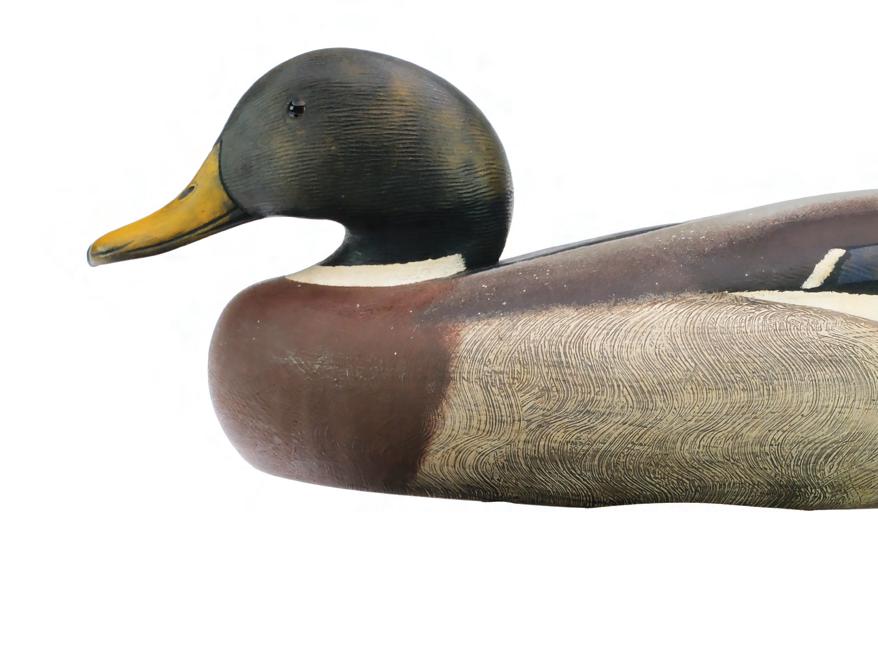

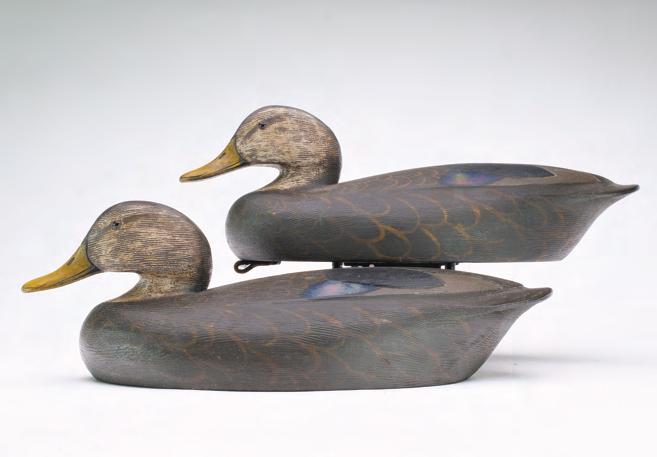
101 Ken Anger (1905-1961), Dunnville, Ontario. Pair of hollow carved black ducks with relief wing and incised feather carving. Measure 16” long. A few very minor paint rubs, otherwise excellent and original.
Provenance: Randy Rall collection. (1,200 - 1,800)
102 Ken Anger (1905-1961), Dunnville, Ontario. Pair of redheads with relief wing and incised feather carving. Measure 14” long. Original paint with minor flaking and wear; minor blunting to tip of hen’s tail, otherwise very good structurally.
Provenance: Randy Rall collection. (1,000 - 1,400)
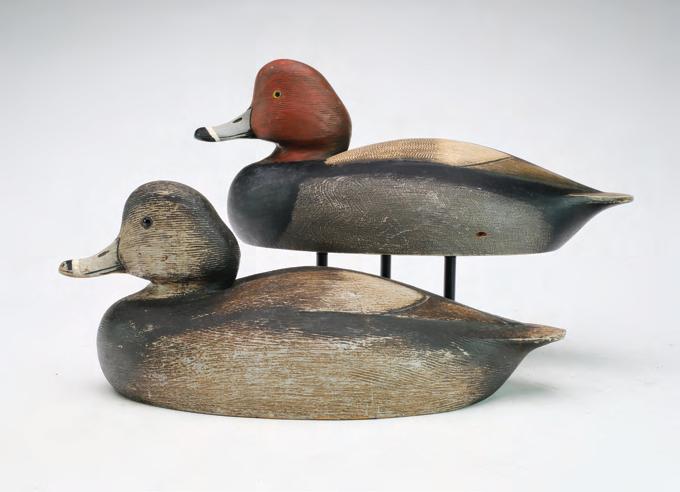

103 Ken Anger (1905-1961), Dunnville, Ontario. Pair of bluebills with original swing weights. Drake is stamped “GW Lowry, Hamilton, Ontario” on the underside. Measure 14.5” long. Original paint with minor gunning wear; very good structurally.
Provenance: Randy Rall collection. (1,200 - 1,800)
104
David W. Nichol (1859-1949), Smiths Falls, Ontario. Pair of greenwing teal with relief wing tip carving and scratch feather paint detail. Drake is signed on the underside. Measure 11.25” and 11.75” long. Excellent original paint that has darkened with age; small spots of discoloration from basement storage.
Provenance: Randy Rall collection. (1,200 - 1,800)
105 David W. Nichol (1890-1977), Smith Falls, Ontario. Ring necked drake with relief wing and incised feather carving. Measures 13” long. A few tiny dents and paint rubs, otherwise excellent and original. (400 - 600)

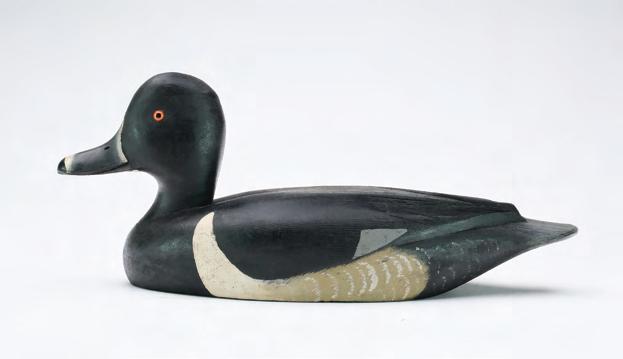
106 David W. Nichol (1890-1977), Smith Falls, Ontario. Hooded merganser drake with relief wing and incised tail feather carving. Extended crest and comb feather paint detail on sides. Identified and signed on the underside. Measures 12.75” long. Very minor paint rubs and discoloration, otherwise excellent and original. (400 - 600)

107
David W. Nichol (1890-1977), Smith Falls, Ontario. Loon written on underside, “1/2 natural size. D.W. Nichol Smith Falls Ontario”. Carved tail feathers, raised wingtips. Measures 15” long. Strong original paint; structurally excellent; white area of breast was intentionally stained reddish brown, does not appear to have been a sap bleed. (600 - 800)
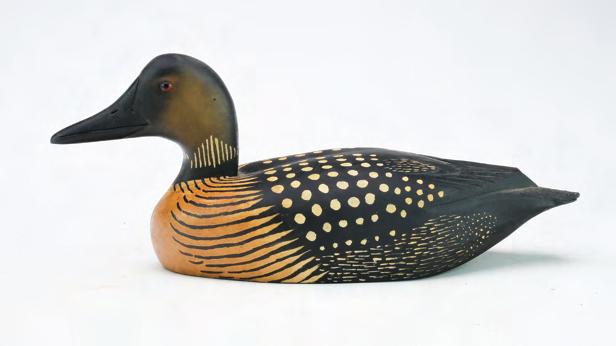
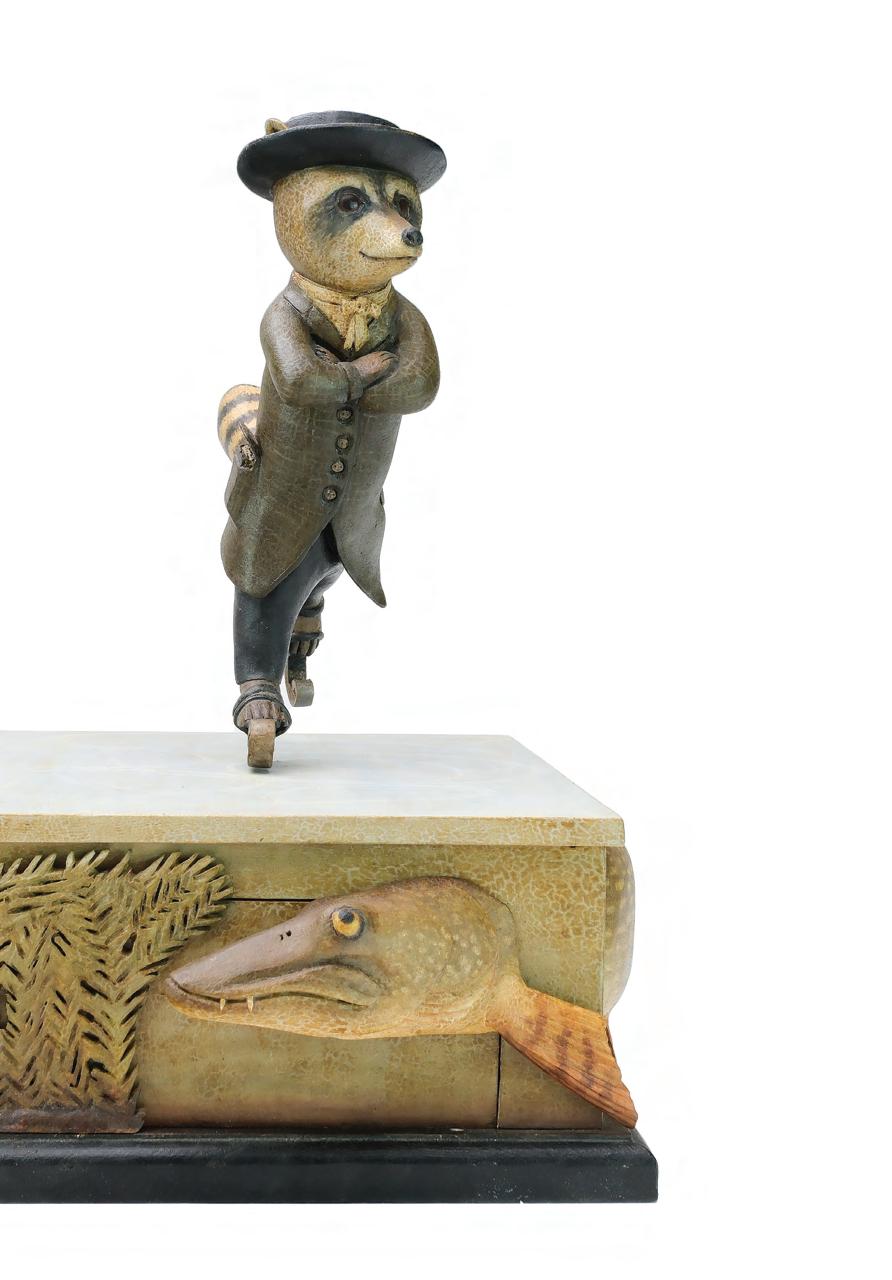


108 Frank Finney (b.1947), Cape Charles, Virginia. This is the most elaborate keep sake or memory box that we have ever seen. Finney’s imagination never ceases to amaze. A full length drawer extends, when the swimming northern pikes head is pulled. The pike is swimming under the ice among a school of northern yellow perch and fresh water plants. All unnoticed by the serious, yet content skating raccoon. All carved and painted wood, with the raccoon displaying glass eyes, upswept tail, and vintage ice skates. The traces from his time on the ice have created loops and swirls on the painted surface of the top board. Truly an amazing folk art box. Measuring 11” x 19” x 18”. Excellent in all respects.
(10,000 - 15,000)



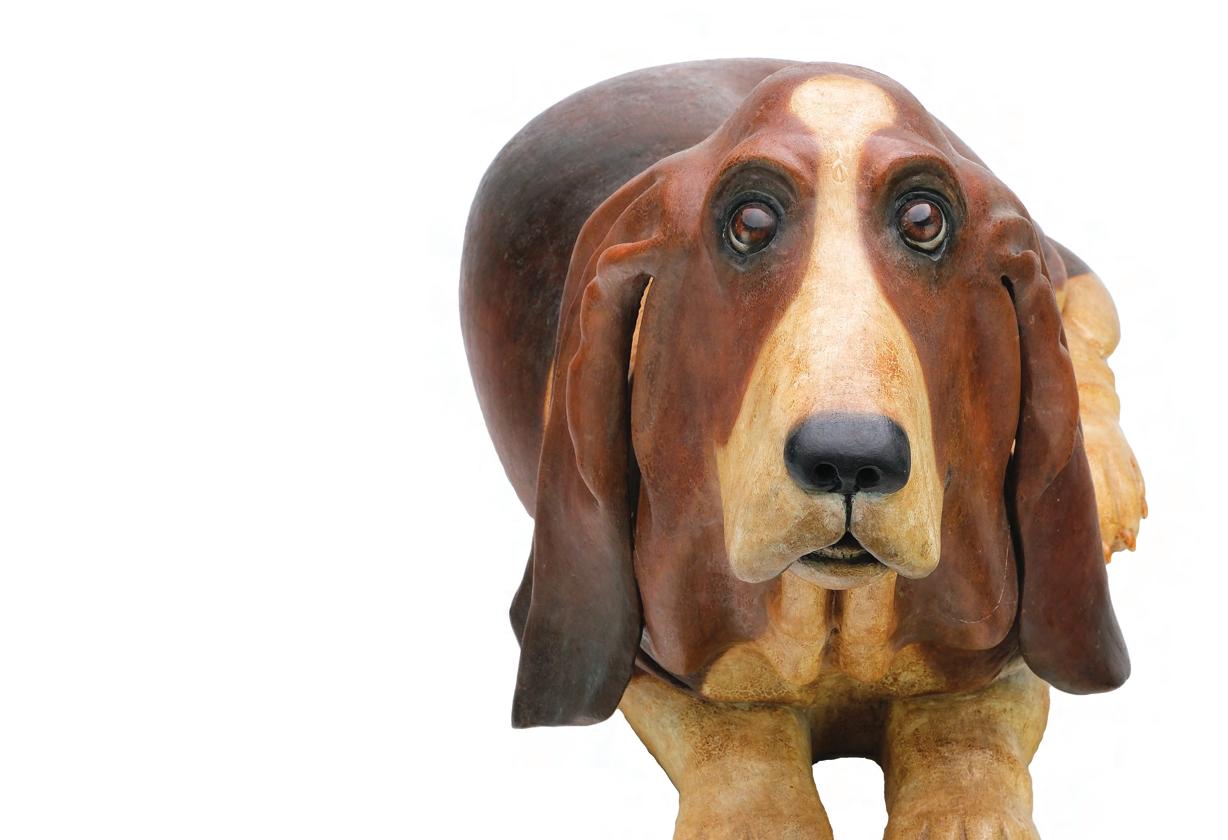 109
Frank Finney (b.1947), Cape Charles, Virginia. A loveable full size hollow carved basset hound. The well fed pooch is gazing perhaps into his best friend’s eyes. Frank’s fancy “F” carved in the underside. Measures 29” long x 15” high. Strong original paint; excellent condition with very tight seam separation around area of neck. (8,000 - 12,000)
109
Frank Finney (b.1947), Cape Charles, Virginia. A loveable full size hollow carved basset hound. The well fed pooch is gazing perhaps into his best friend’s eyes. Frank’s fancy “F” carved in the underside. Measures 29” long x 15” high. Strong original paint; excellent condition with very tight seam separation around area of neck. (8,000 - 12,000)

110

111

111a
111a Frank Finney (b.1947), Cape Charles, Virginia. Hummingbird perched on bent branch of a decorative flower. Mounted on dowel base which is stamped “F Finney” twice. Hummingbird has glass eyes, carved raised wingtips, and carved tail. 11” tall. One small smudge of white paint on white base, otherwise very good and original. (4,000 - 6,000)
110 Frank Finney (b.1947), Cape Charles, Virginia. Excellent, larger size miniature turkey in walking pose with slightly turned head and relief feather carving. Maker’s initials carved on side of base. Measures 11.5” long, stands 6.5” tall. Original turkey beard is mostly missing, otherwise excellent and original.
(1,500 - 2,500)
111 Frank Finney (b.1947), Cape Charles, Virginia. Calling mallard duck call with open bill and carved tongue. Makers initials painted on the underside. Measures 7” long. Excellent and original. (600 - 900)
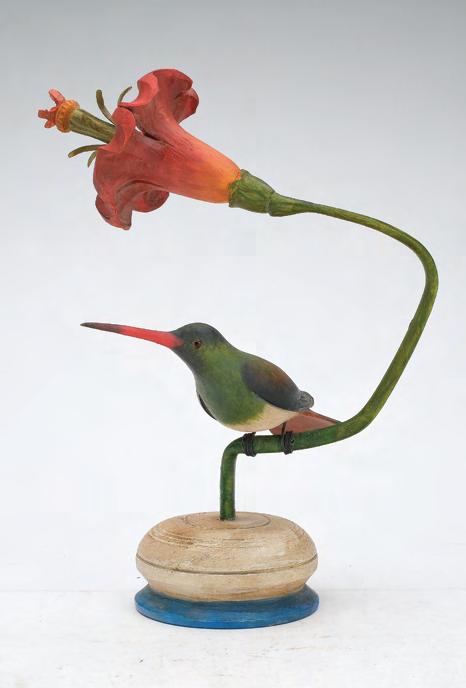
“The Kellum gull was made over 20 years ago in the prior Lake shop. I was amazed at the original owned by Alan and Elaine Haid.
Their original example was brought to a major Decoy contest in Ohio , and I was able to view it closely in person and handle it several times.(if I recall correctly, I judged that event with two others and the seagull won the event). The simplicity and form of this particular gull is on its own level of craftsmanship and form.
Upon returning home, and looking through old reference material, I found several pictures of the seagull, and it inspired me to make a facsimile of this wonderful form. This is one of two that were made. They were both solid construction with a root head and handcarved with traditional tools and methods.
When making these a carver can grow by learning to work out of the box that his personal style demands. Making these vintage facsimiles broadens a makers mind to try new things, although they are a minority In my body of work, They serve a purpose to learn about form surface and creativity for me.”
- Marty Hanson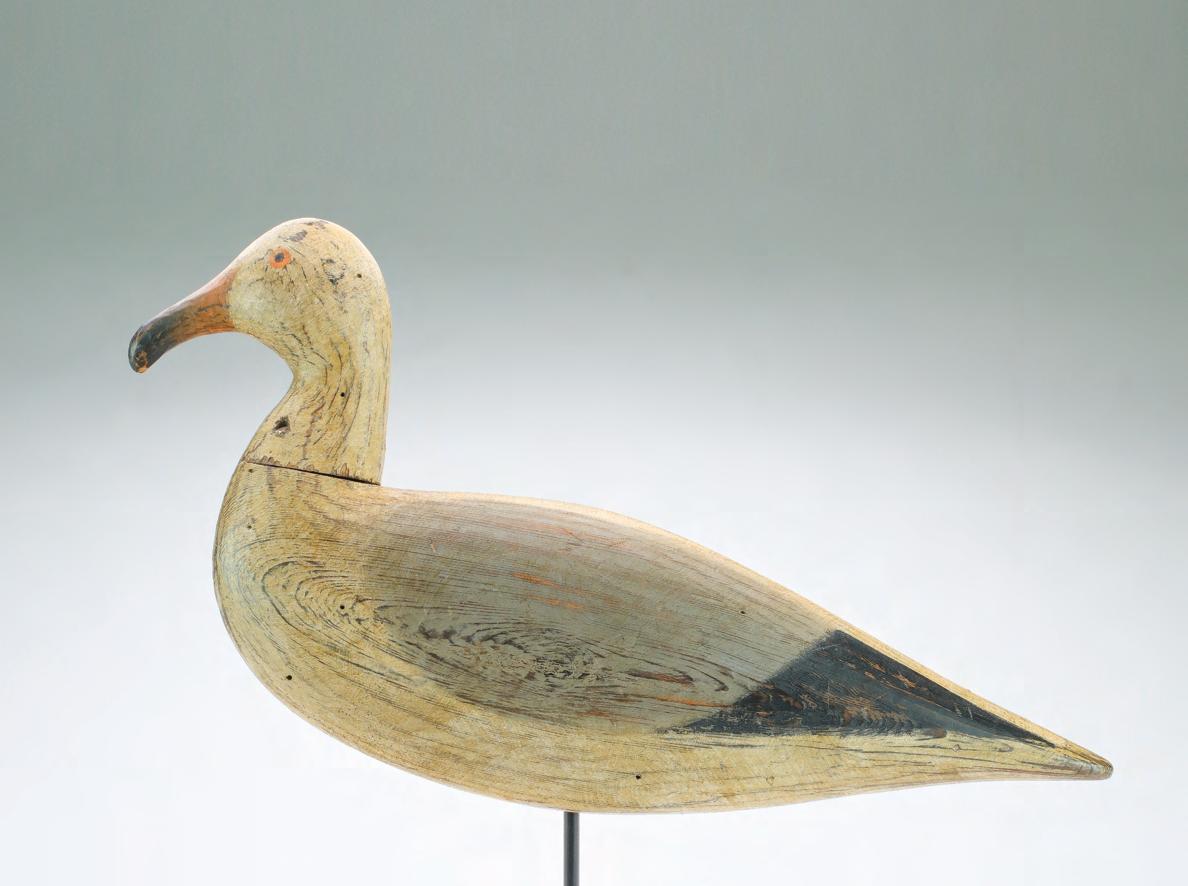

112 Marty Hanson (b.1965), Hayward, Wisconsin. Gull carved in the style of Frank Kellum. With root head and painted eyes. “MH” carved on the underside. Measures 21.25” long. Excellent and original. (3,000 - 5,000)
113 Marty Hanson (b.1965), Hayward, Wisconsin. Hollow carved curlew with relief wing carving and scratch feather paint detail. Copper tack eyes and long hardwood bill that is splined to back of head. “MH” carved near stick hole. Measures 19.5” long. Made to look older, excellent and original. (1,200 - 1,800)

113
114 Marty Hanson (b.1965), Hayward, Wisconsin. Hollow carved greater yellowlegs in the Massachusetts style. With metal tack eyes, extended wingtips, and dropped tail. “MH” carved in underside. Three piece body and applied tail are affixed with square hardwood dowels. Measures 14.5” long. Made to look older with small shot marks; excellent and original. (800 - 1,200)

114
“The shorebird is influenced by the Burr family. After viewing and owning several of these examples by the burr family, I decided to make them to highlight the carpentry that went into making these pieces. They are very skillfully crafted with many pieces of wood and hollowed. This particular Bird has 12 different pieces of wood in its construction. The center was cut out and hollowed with applied wings on the side and pegged in by hardwood pegs. The Bill is splined hardwood.”
- Marty Hanson115 Marty Hanson (b.1965), Hayward, Wisconsin. Excellent dove with slight relief wing carving and outstanding scratch feather paint detail. Detailed hardwood bill is splined through back of head. “MH” carved near stick hole. Measures 11.5” long. Excellent and original. (800 - 1,200)
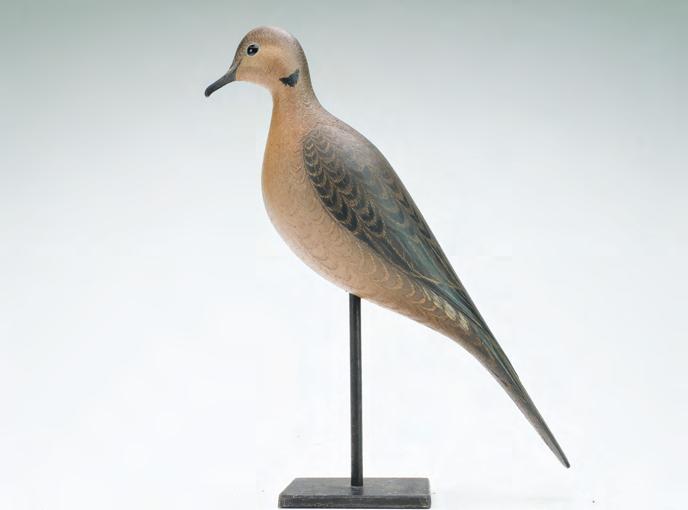
115


116 Jim Schmiedlin (1945-2015), Bradfordwoods, Pennsylvania. Very rare rigmate pair of hooded mergansers. Hollow carved with extended crests and relief wingtip carving. Hen in slight swimming pose. Each is dated 2/2013, branded “JAS”, and with Jim’s Reward for Return label on the underside. Measure 16” and 17” long. Near mint.
Provenance: Jim and Patti Aikin collection. (12,000 - 18,000)
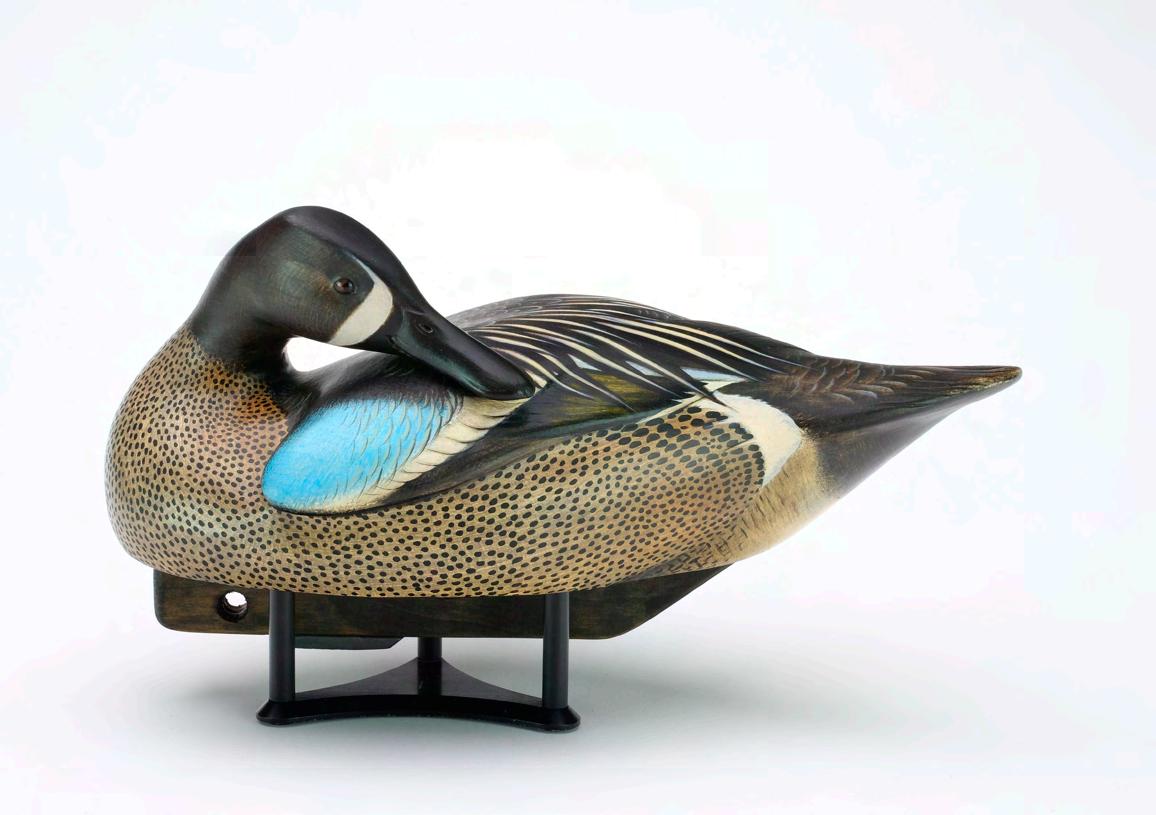
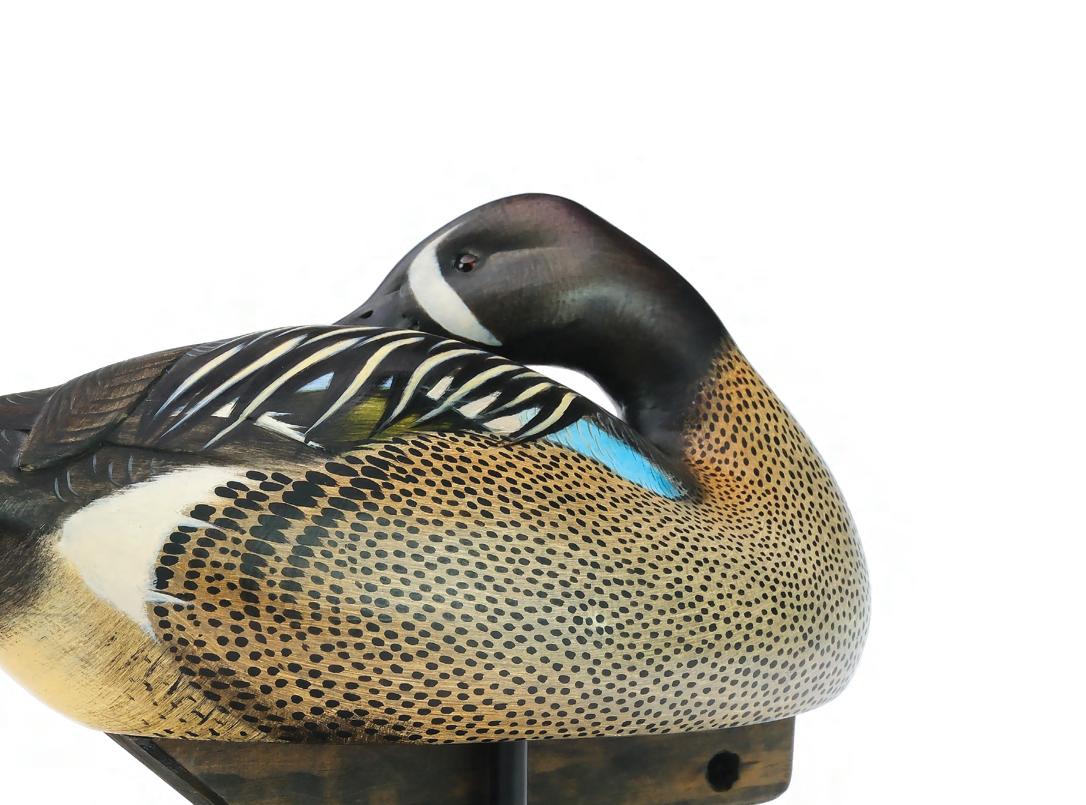
117 Jim Schmiedlin (1945-2015), Bradfordwoods, Pennsylvania. Excellent preening bluewing teal with one partially raised wing and relief carved wingtips. Dated 4/2009, branded “JAS”, and with Jim’s Reward for Return label on the underside. Inscription “To Jim and Patti Aikin” with the maker’s signature on the underside. Measures 13.5” long. Excellent and original.
Provenance: Jim and Patti Aikin collection. (8,000 - 12,000)
118

118
Jim Schmiedlin (1945-2015), Bradfordwoods, Pennsylvania. Excellent rigmate pair of bluebills. Both with tucked, turned, swimming heads. Branded “JAS” on underside, with Jim’s Return for Reward label. Drake is marked “9/2000. Kelley Isle, Ohio” and “Erie, PA” where it was hunted. Hen is marked the same, in addition to “Presque Isle Bay, Erie, Pennsylvania”. Measure 15.5” long. Both are in excellent original paint.
Provenance: Jim and Patti Aikin collection. (8,000 - 12,000)


119

120
119 Jim Schmiedlin (1945-2015), Bradfordwoods, Pennsylvania. Hollow carved gadwall with head turned 45 degrees. Dated 10/01, branded “JAS”, and with Jim’s Reward for Return label on the underside. Measures 15.75” long. Original paint with minor flaking and gunning wear; hairline crack in breast; thin wash of white on lower edge of sides.
Provenance: Jim and Patti Aikin collection. (3,000 - 4,000)
120 Jim Schmiedlin (1945-2015), Bradfordwoods, Pennsylvania. Decorative wood duck with slightly turned head and raised, crossed wingtips. Relief back and tail feather carving. Extended crest feathers extend almost to back. Identified, signed, and dated 1980 on the underside. Measures 15” long. Excellent and original. (3,000 - 4,000)




121 Oscar Peterson (1894-1951), Cadillac, Michigan. The tallest of the known Peterson fish vases. With four different species deeply carved in relief from one piece of wood. A northern pike, bluegill, perch, and a brook trout. All with carved eyes. Measures 11.5” tall. Excellent original paint protected by a coat of varnish; some moderate crazing; small area of paint loss in the negative space between the fish tails that is not visible; three tiny areas that appear to be varnish voids that can be misread as restoration, but they are not.
Provenance: David Fannon collection. (30,000 - 40,000)
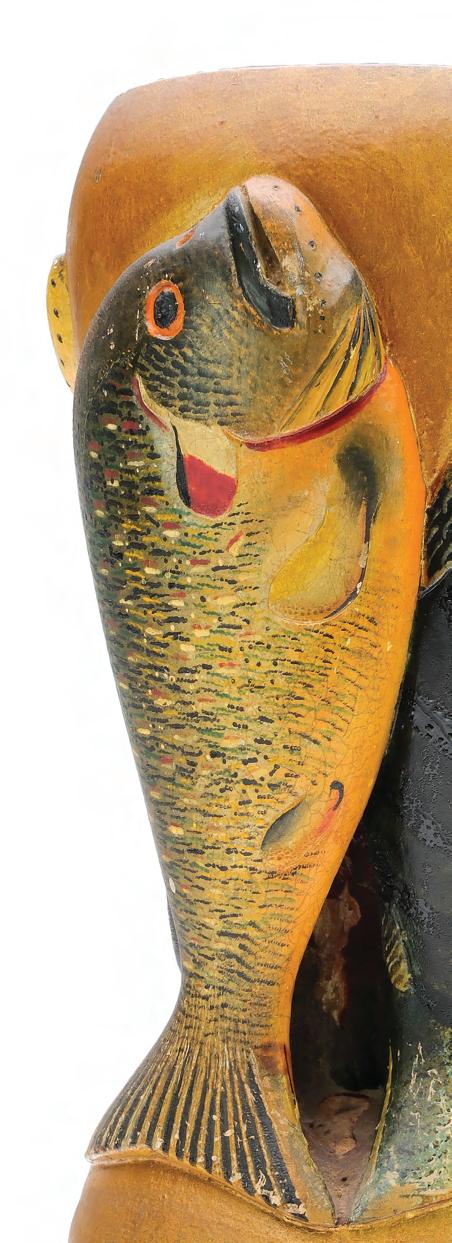

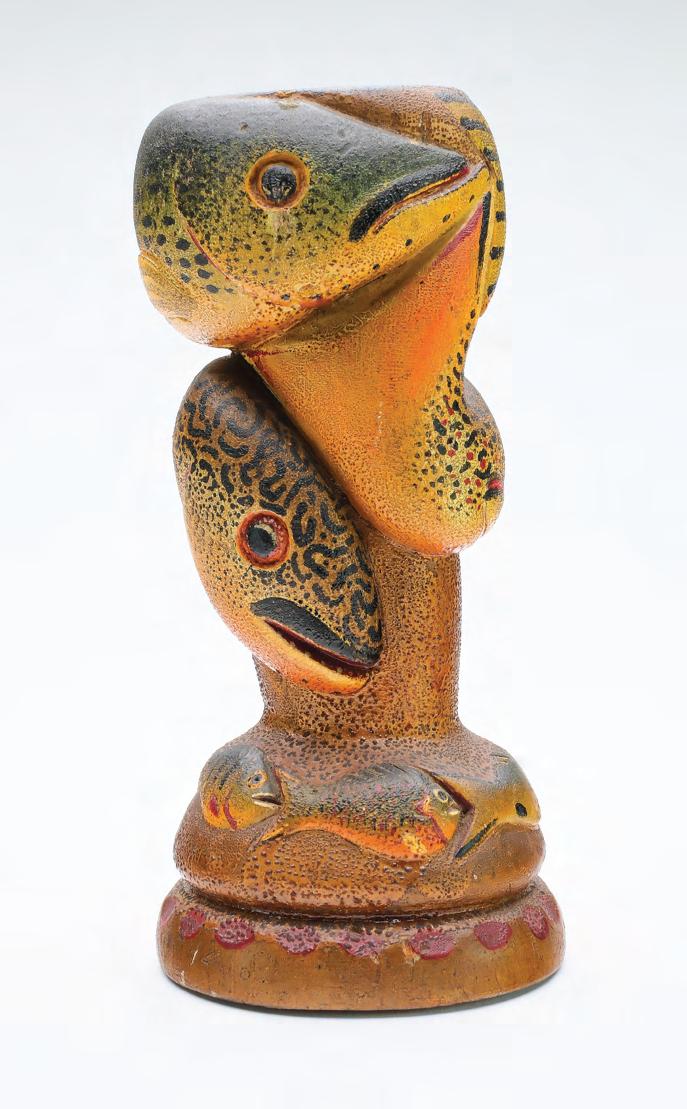
122 Oscar Peterson (1894-1951), Cadillac, Michigan. One of the most highly decorative vases ever offered at auction. A musky and brook trout with carved eyes. The base is adorned with five smaller relief carved fish and fluted bottom edge. Measures 7.5” tall. Original paint protected by a coat of varnish; that is crazed to create a wonderful patina; a few small dents and scratches.
Provenance: David Fannon collection. (20,000 - 30,000)
Cadillac, Michigan’s pre 1950 restaurant and bar scene was fertile ground for the distribution of Oscar Peterson’s fish spearing decoys and folk art carvings. Oscar and his brother George were both well known amongst the locals for trading product for food and drink. Plaques and spearing decoys were sold for cash, of course, but quite frequently they were traded or bartered for basic necessities or used to pay social debts. Both the Peterson brothers reportedly had a weakness for alcohol. They were well known in most of the area’s bars and eateries for cadging food & drinks and then offering to pay with fish decoys or other trinkets. The standard rate of exchange in the Peterson economic system was 1 spearing decoy = 1 shot of whiskey. The price of a shot in the local bars also pretty much determined the wholesale price of a standard 6”-7” fish decoy to Oscar’s retail outlets such as hardware stores, bait shops, etc. This system inadvertently worked to Oscar’s advantage by exposing his artwork to an audience far beyond the spear fishing fraternity. A non-fisherman bar patron might come home after an evening out with some Peterson fish decoys acquired in trade. Recognizing their decorative appeal he often put them on display in his home or summer cottage where they were seen and eventually appreciated by fishermen and non-fishermen alike. Restaurant and bar owners who received items from Peterson via purchase or barter would often use them for décor or put them up for sale in their establishments. This practice gave increased exposure to Oscar’s artwork within the bar or restaurant’s clientele which often included tourists and seasonal residents from well beyond Cadillac proper.

123 Oscar Peterson (1894-1951), Cadillac, Michigan. The only known relief carved jaguar by Peterson, circa 1930. One of three Peterson plaques in this sale that are associated with the Busy Bee bar in Cadillac, Michigan. Carved wooden teeth with glass eye and extended tongue. The paint pattern is similar to what Peterson used on his muskey fish spearing decoys. Jaguar is perched in a tropical tree and is carved from a board that is nearly 1.5” thick. Peterson’s metal strapping has been applied to the back of the board to keep it from warping. Measures 14” x 30” x 1.5”. Original paint with a few very minor rubs along edges and around glass eye.
Provenance: Estate of Flora Mae Norlock, past owner of the Busy Bee Cafe. David Fannon collection. (30,000 - 40,000)

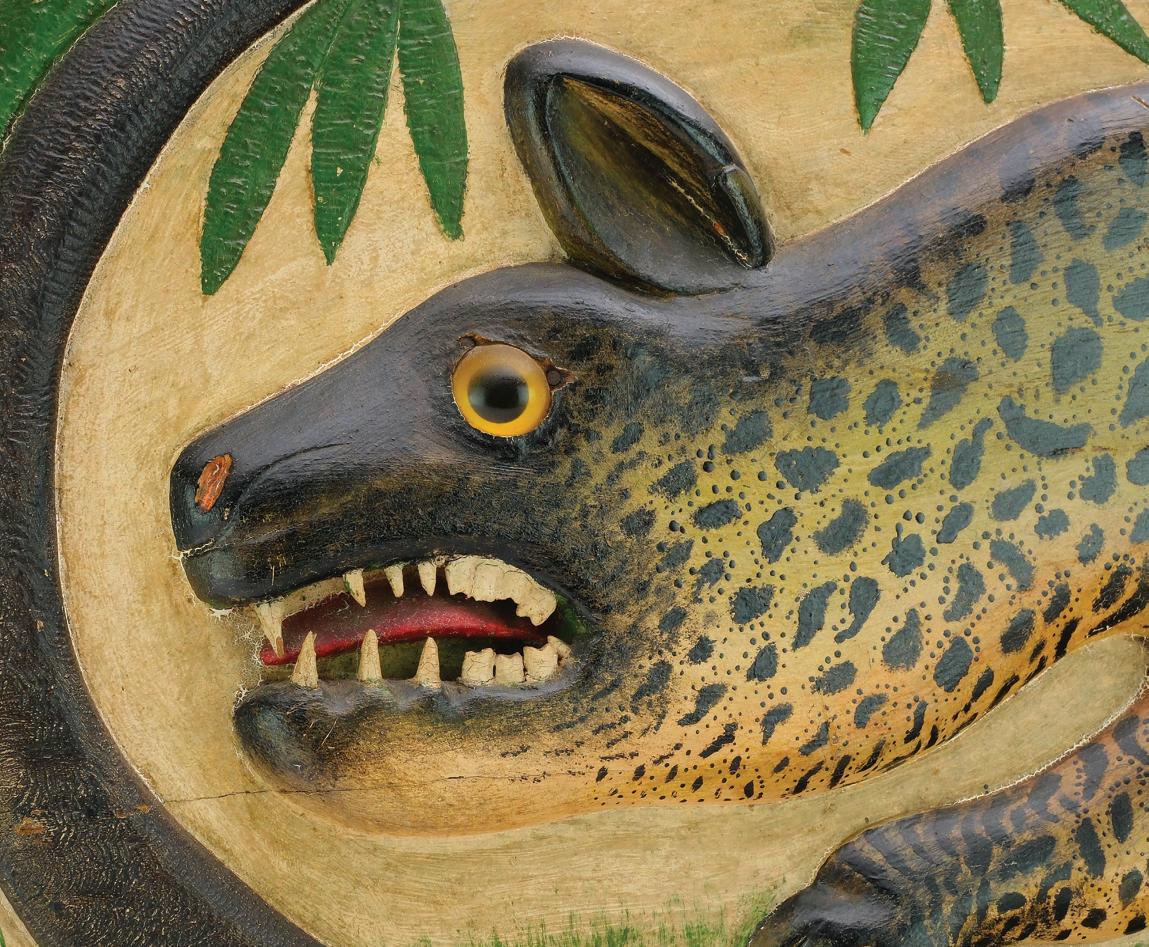
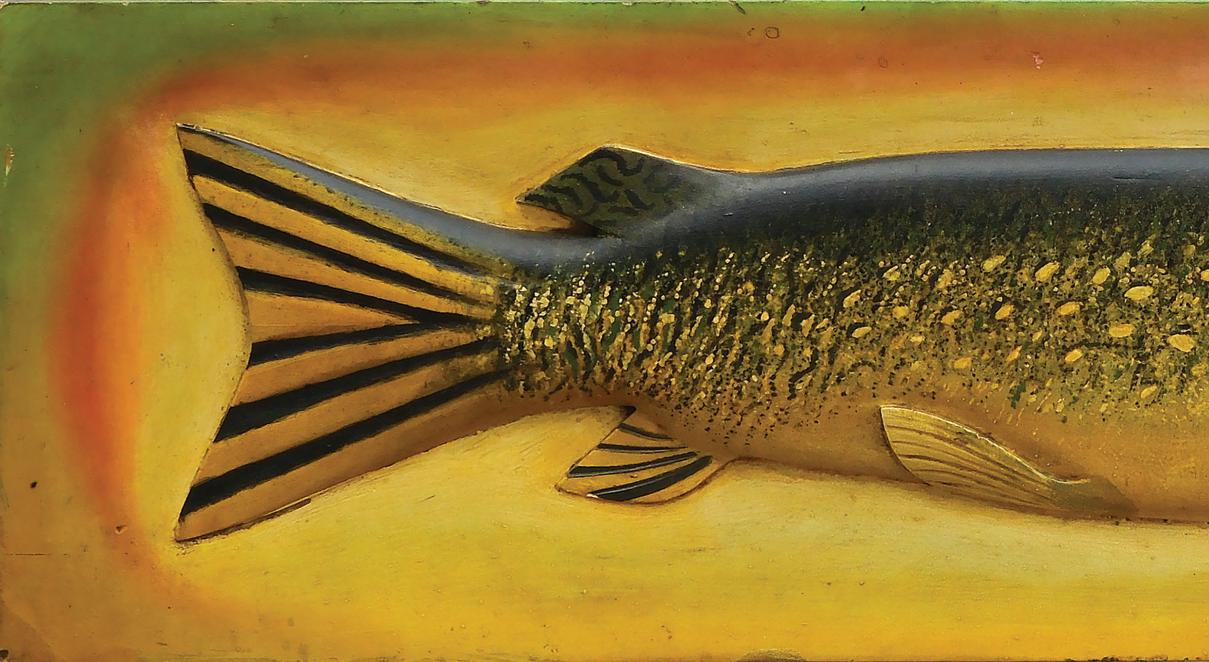
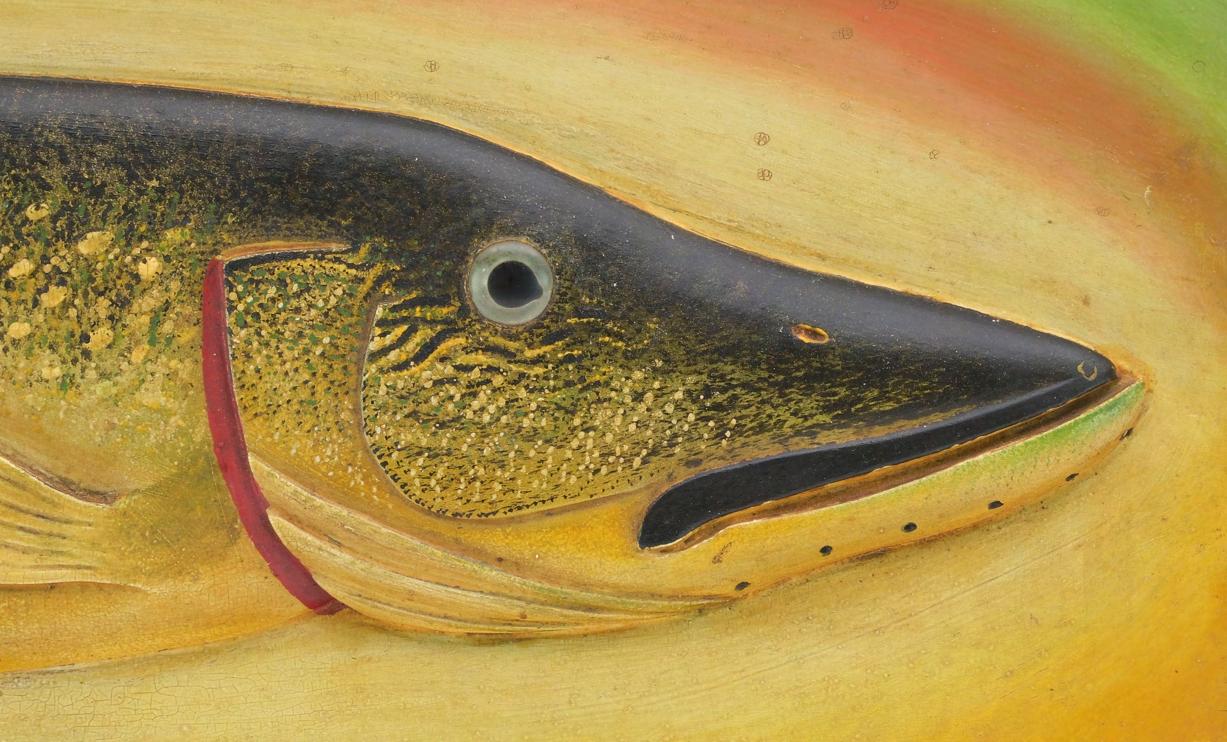

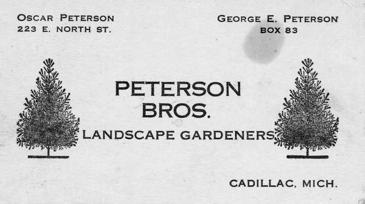
124 Oscar Peterson (1894-1951), Cadillac, Michigan. Exceptional relief carved plaque of a northern pike, circa 1930. One of three Peterson plaques in this sale that are associated with the Busy Bee bar in Cadillac, Michigan. Glass eye and a scooped out board with multi color, almost rainbow halo effect around the fish. Excellent multi colored and almost textured surface on side of the fish, with use of small spots of gold paint to give it an almost iridescent look. Peterson’s metal strapping has been applied to the back of the board to keep it from warping. Measures 10” x 36” x 1.25”. Plaque remains in excellent condition; a few small rubs at edges.
Provenance: Estate of Flora Mae Norlock, past owner of the Busy Bee Cafe. David Fannon collection. (30,000 - 40,000)
One of Oscar’s favorite hangouts was the Busy Bee Café at 507 N. Mitchell St. in Cadillac. The town had lots of drinking establishments and I’m not exactly sure what the particular attraction was for Oscar at the Busy Bee but I suspect that the most important factor was its location just 2 ½ blocks from Oscar’s home at 223 E. North St. This was important as Oscar nor any of his family owned or drove a car. In a 1984 letter Oscar’s nephew related as how back in the early 1920s the Petersons were big time fox and muskrat trappers using as many as 5 motorcycles to help in the business. “Oscar’s motorcycle once caught fire while he was driving it and that was the last time he ever rode one.” He escaped without major injury but thereafter “when it came to motor vehicles Oscar would rather walk or take a cab wherever he went.” Taxi drivers and others who gave him rides were often gifted decoys and other carvings.
In the mid 1980s the late Gloria McPherson inherited a cottage on Lake Cadillac from her grandmother, Flora Mae Norlock. Amongst the cottage’s furnishings were several plaques by Oscar Peterson. Flora Mae had for a period in the mid 1940s been the owner of the Busy Bee Café in Cadillac. It’s not known exactly how, when, where or under what circumstances Flora Mae acquired the plaques but it’s a logical assumption that it would have been either directly or indirectly through her association with Oscar as a frequent patron of the Busy Bee Café.
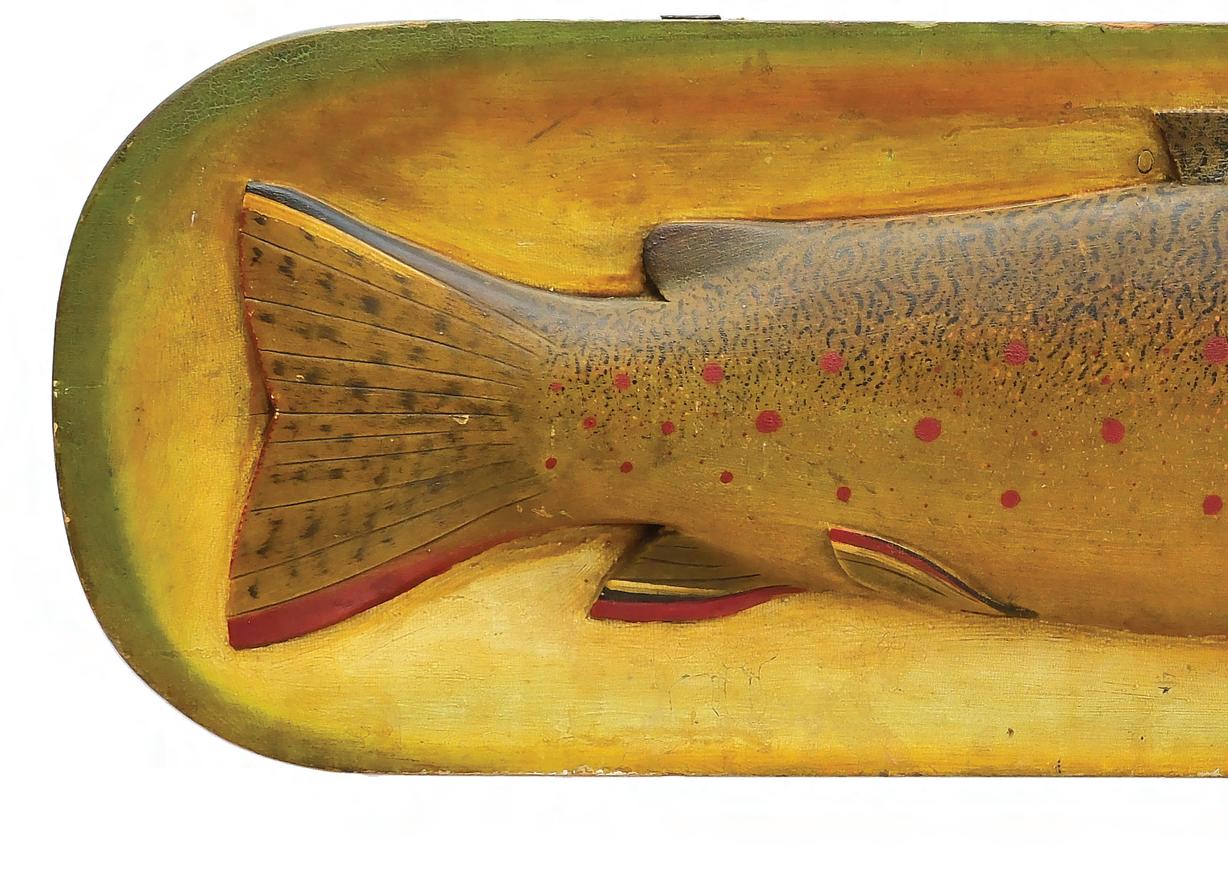
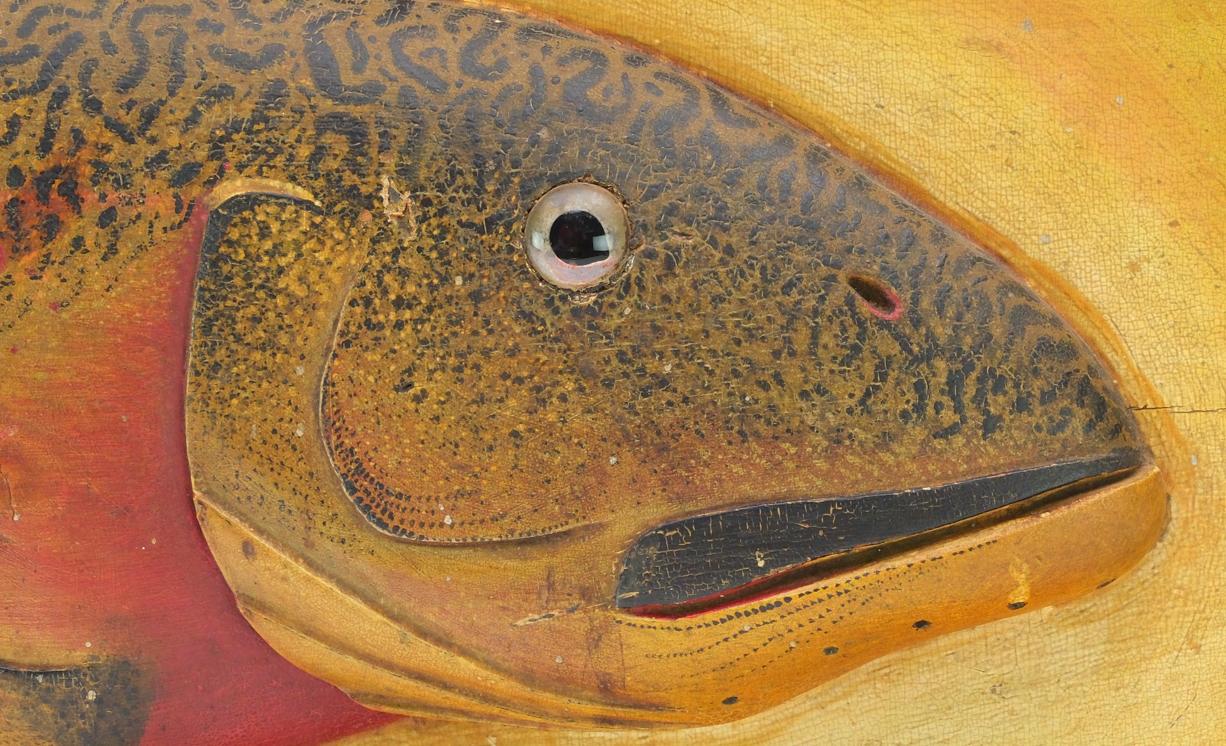

Alas, the Busy Bee is no more. Sometime after Oscar’s passing in 1951 it was relocated to the opposite side of N. Mitchell St. In 1983 it was incorporated as the “Busy Bee Bar, Inc.” After multiple ownership changes and a series of legal issues the Bee lost its license and was permanently closed in 2022. The building is currently for sale.
125 Oscar Peterson (1894-1951), Cadillac, Michigan. Early and well executed brook trout plaque. One of three Peterson plaques in this sale that are associated with the Busy Bee bar in Cadillac, Michigan. This is a spawning brook trout, indicated by the red dots on the side. A scooped out board with a painted halo effect on the fish. Carved gill detail, fins, and glass eye. Peterson’s metal strapping has been applied to the back of the board to keep it from warping. Measures 12” x 36.5” x 1.5”. Excellent original paint with a scratch at mid body; pleasantly crazed surface; a few spots of discoloration and some edge wear.
Provenance: Estate of Flora Mae Norlock, past owner of the Busy Bee Cafe. David Fannon collection. (30,000 - 40,000)
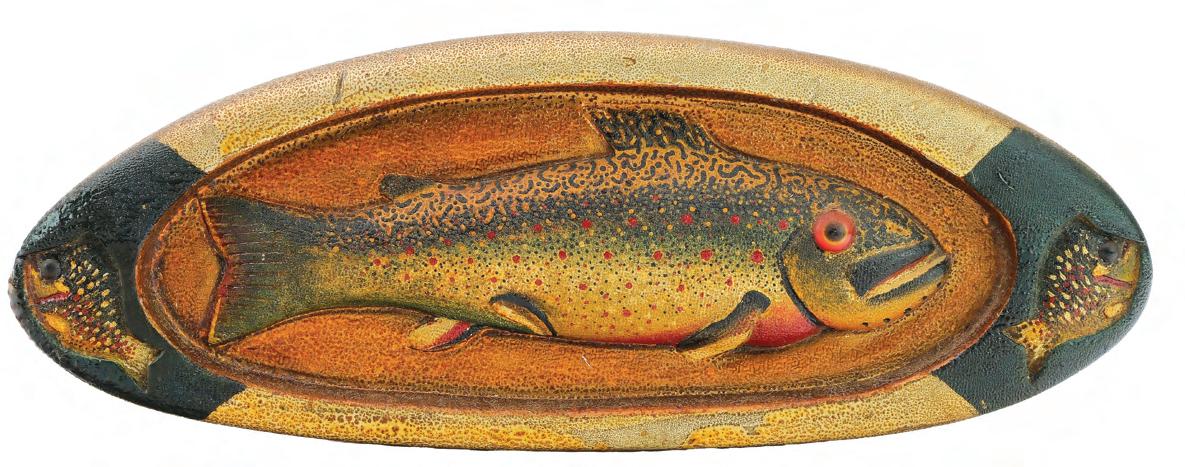

126 Oscar Peterson (1894-1951), Cadillac, Michigan. A rare and highly detailed, small size, carved brook trout plaque. Deep relief carving and glass eyes. Plaque is decorated with two additional glass eye bluegills at each end. Wonderful folk art appeal. Measures 10.25” long x 1.75” tall x 1” deep board. Highly detailed paint pattern covered by a coat of varnish that has crazed to create an appealing patina; a few very small dents, otherwise excellent.
Provenance: David Fannon collection. (6,000 - 9,000)


127 Oscar Peterson (1894-1951), Cadillac, Michigan. Very rare carved alligator stick. Carved from a single piece of wood with carved eyes, open mouth, and incised carving detail to feet, tail, and back. Probably made as a git for a young boy. Measures 12.5” long. Excellent original paint that has mellowed nicely, structurally good.
Provenance: David Fannon collection. (10,000 - 15,000)

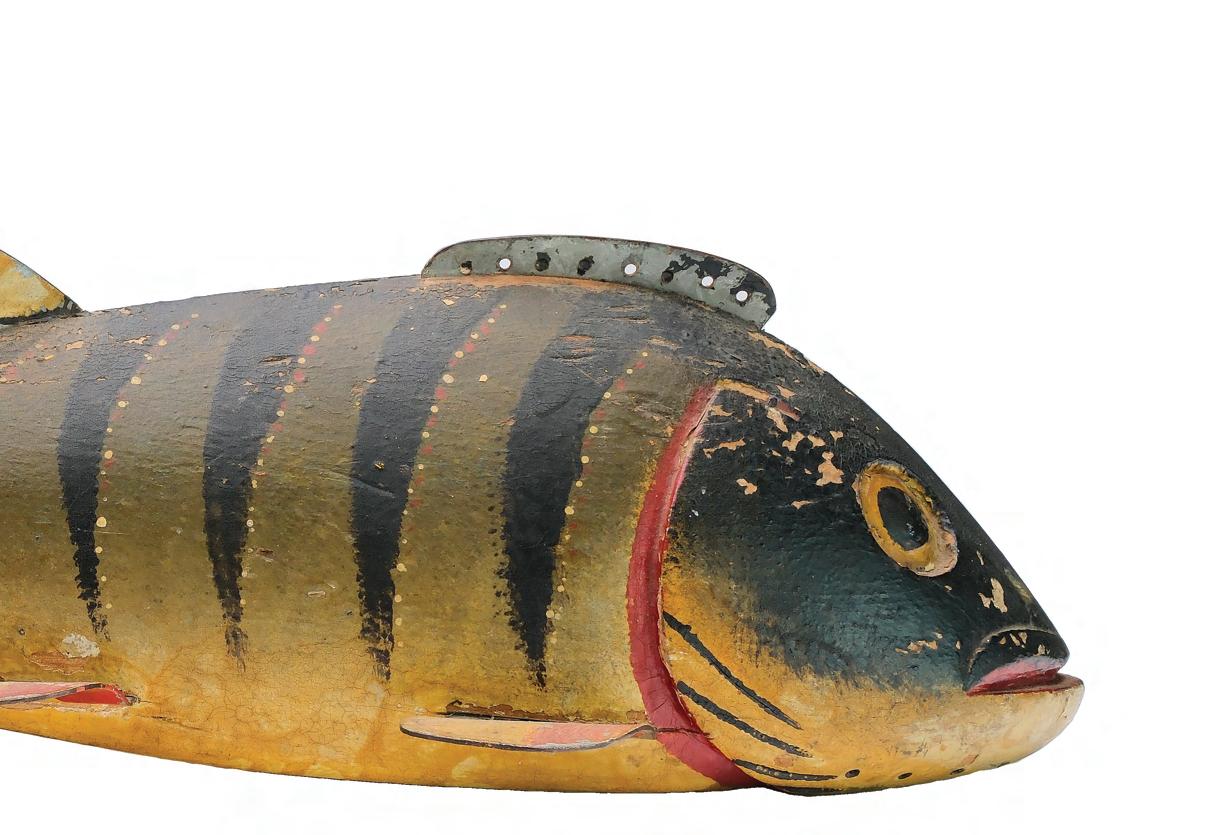
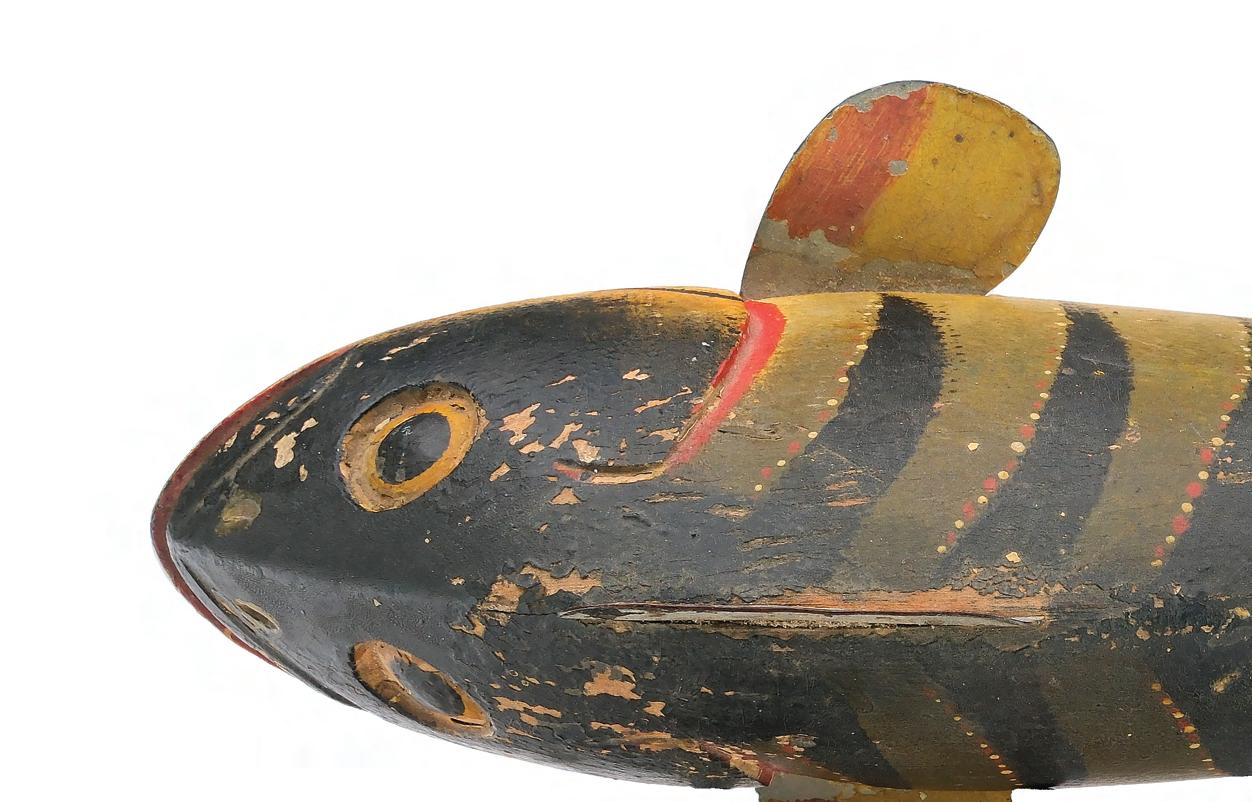
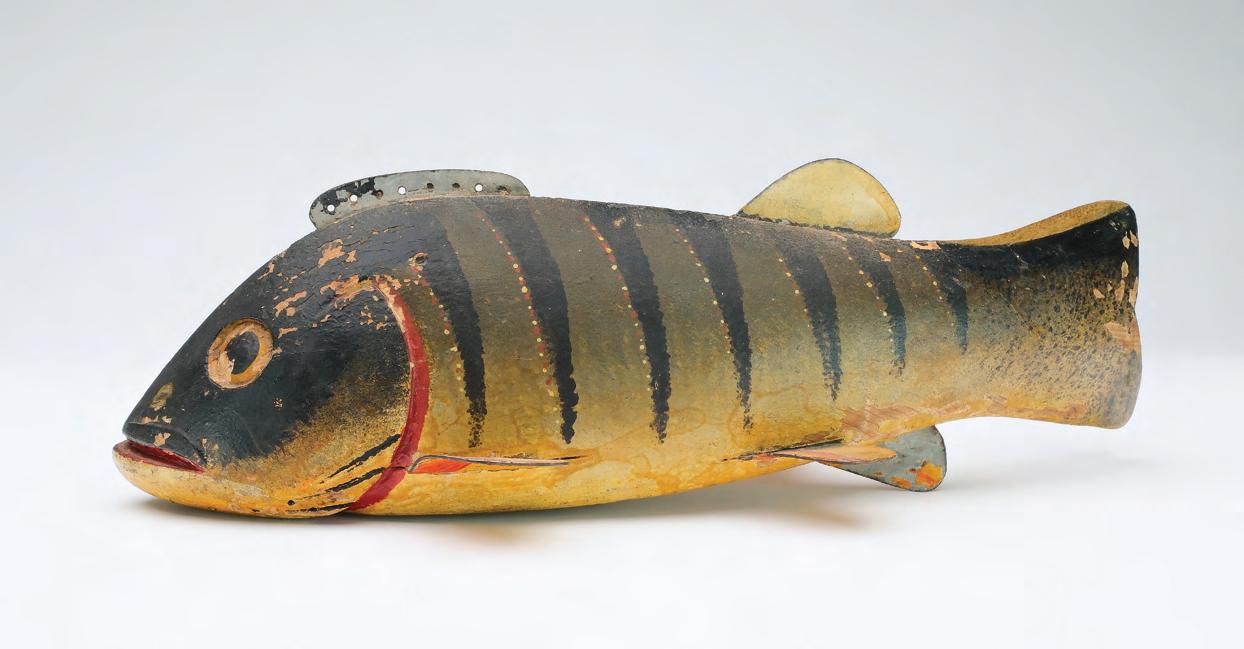

128 Oscar Peterson (1894-1951), Cadillac, Michigan. The second largest known perch fish spearing decoy. Carved eyes and detailed gill carving up into the underside of the mouth. Measures 15” long x 4” tall x 3.5” wide. Original paint protected by a coat of varnish; small areas of flaking that have exposed bare wood; professional paint restoration to the top area of the tail; professional repair to a chip in bottom part of tail.
Provenance: David Fannon collection. (30,000 - 40,000)

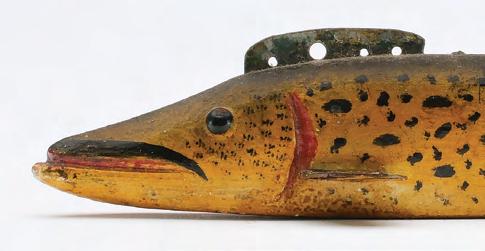
129 Oscar Peterson (1894-1951), Cadillac, Michigan. Very rare and early musky fish spearing decoy, 1st quarter 20th century. Tack eyes and unusual paint pattern with small dots forward of gills. Measures 8.75” long. Excellent original paint protected by a coat of vanish; a few tiny flakes and a chip at top of tail that was secured a long time ago with a finish nail; small dent at one side of mouth.
Provenance: David Fannon collection. (3,000 - 4,000)

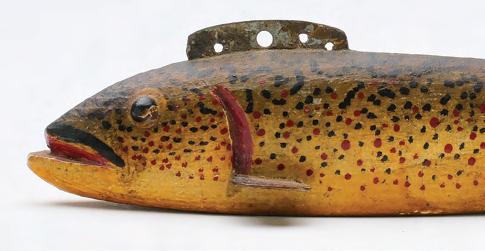
130 Oscar Peterson (1894-1951), Cadillac, Michigan. Brook trout fish spearing decoy in an unusual spawning phase with extra dots and color along sides. Tack eyes. Measures 7.5” long x 1.25” tall x .75” wide. Original paint protected by a coat of varnish; small amount of paint loss at belly weights.
Provenance: David Fannon collection.
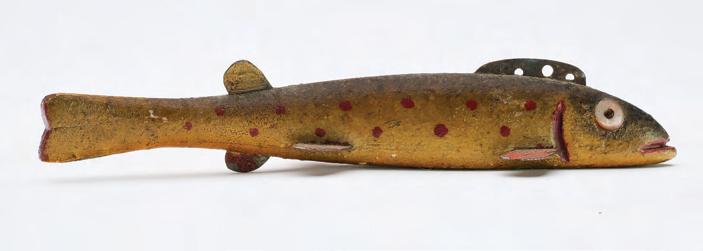
(3,000 - 4,000)

131 Oscar Peterson (1894-1951), Cadillac, Michigan. Rare and early brown trout fish spearing decoy with pearl eyes, 1st quarter 20th century. A very rare paint pattern. Measures 7.25” long x 1” tall x .75” wide. Strong original paint protected by a coat of varnish that has mellowed; some paint loss at fins and near bottom side of tail.
Provenance: David Fannon collection.
(2,000 - 3,000)


132 Oscar Peterson (1894-1951), Cadillac, Michigan. Early and rare rainbow trout fish spearing decoy with painted eyes. Very unusual paint pattern. Measures 10” long x 1.5” tall x 7/8” wide. Strong original paint protected by a coat of varnish; some line tie marks around middle of body.
Provenance: David Fannon collection. (3,000 - 4,000)
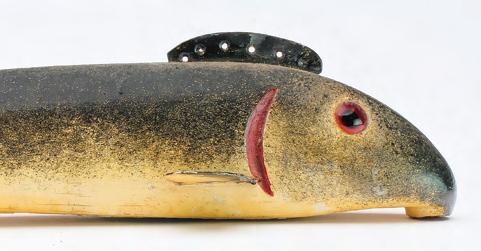
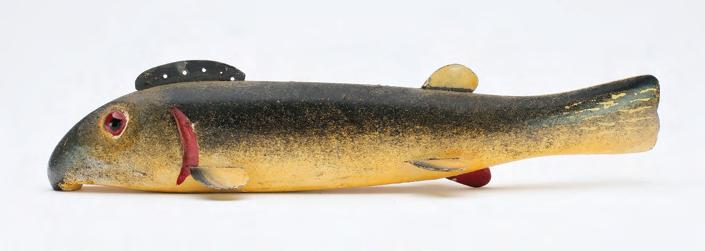
133 Oscar Peterson (1894-1951), Cadillac, Michigan. Large sucker fish spearing decoy with glass eyes. Glass eye fish are rare among Peterson’s work. Measures 9.5” long x 1.75” tall x 1.25” wide. Retains strong original paint protected by a coat of varnish; small chip at bottom of tail; some paint loss to fins; loss of putty around one eye.
Provenance: David Fannon collection. (4,000 - 6,000)
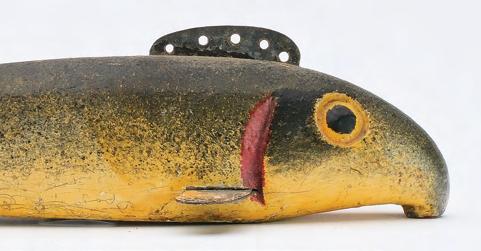
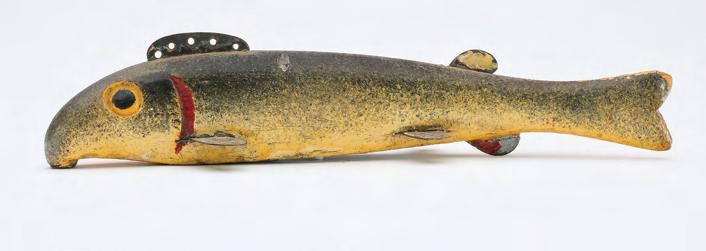
134 Oscar Peterson (1894-1951), Cadillac, Michigan. Rare sucker fish spearing decoy with carved eyes. Measures 9” long x 1 1/2” x 1 1/8”. Original paint protected by a coat of varnish; dent near top of back; some paint loss at fins; loss of paint around belly weights; crack separation from forward belly weight to underneath eye; very tiny chip at top of tail.
Provenance: David Fannon collection. (2,500 - 3,500)

135 Oscar Peterson (1894-1951), Cadillac, Michigan. Pike fish spearing decoy with tack eyes. Bear paw paint decoration and extra fancy paint lines forward of gills. Measures 9” x 1” x .75”. Strong original paint protected by a coat of varnish; small areas of paint loss at fins; a few small spots on body, including a spear hit at tail.
(2,000 - 3,000)

136 Oscar
(1894-1951), Cadillac, Michigan. Brown trout fish spearing decoy with glass eyes. Measures 7.5”. Original paint protected by a coat of varnish; a few tight cracks; paint missing from fins; small gouge at center of body; tail has been broken and reset with in painting, probably a working repair. (500 - 800)

137
Cadillac, Michigan. Pike fish decoy. Measures 10” long x 7/8” wide x 3/4” tall. Dome tack eyes. Strong original paint with areas of paint pops or flaking, mostly along lower edge and few spots in head where paint primer is visible. (2,000 - 3,000)

138 Oscar Peterson (1894-1951), Cadillac, Michigan. Perch fish spearing decoy with tack eye. Measures 7” x 1.25” tall x .75” wide. Excellent original paint protected by a coat of varnish; shows very little wear. (1,500 - 2,000)

139 Oscar Peterson (1894-1951), Cadillac, Michigan. Shinner fish spearing decoy. Measures 6.75” x 1” x .5”. Paint feels to be textured in some way; original with a coat of varnish; small chip at bottom of tail. (800 - 1,200)

140 Oscar Peterson (1894-1951), Cadillac, Michigan. Perch fish spearing decoy with carved eyes. Measures 9.5” x 1 .75” tall x 1” wide. Original paint protected by a coat of varnish that has crazed along the lower edge; white paint on underside of decoy has been exposed to heat or something that changed its surface; area of paint loss at tail, as well as a chip at top and bottom; adipose and anal fin have been replaced. (1,500 - 2,500)
141

141
Horace “Bart” Perkins, New Baltimore, Michigan. Large perch fish spearing decoy with carved mouth and gill detail. Classic grooves in curved tail. Measures 11” long. Original paint on body shows great age with a wonderful crazed surface; white area below midline has been hit with a second coat; spearing scars to both sides of body; one eye is possibly a replacement; typical paint loss around belly weights on underside.
Provenance: George and Miriam Van Wallegham collection. (5,000 - 10,000)

142
142
Unknown maker (last quarter 19th century), Lake Chautauqua, New York. Early fish spearing decoy. Carved gill and tack eyes, metal fins, and classic leather tail. Mearures 7” long. Original paint that appears to have been strengthened by a coat of white along underside; leather tail has been strengthened with glue around edges and possibly reattached.
Literature: “Beneath the Ice,” Steven Michaan, p. 58, exact fish pictured. (3,500 - 5,500)

143
143 Long fish decoy, Lake Chautauqua, New York, last quarter 19th century. Trout with tack eyes, carved mouth, and gills. Quite long for Chautauqua fish. Measures 12” long. Excellent original paint; little flaking at tail and a few small rubs from light wear. (3,000 - 5,000)

143a Rare jigging stick by Faue. Known as the kissing croppie. 2nd quarter 20th century. One piece carved oak. Both fish have bead or glass eyes. The natural finish has been varnished. Measures 32” in length. Structurally good.
Literature: ‘Fish and Fowl Decoys of the Great Lakes’, by Donna Tonelli, page 254, similar jigging sticks pictured. (800 - 1,200)
144 A.J. Downey, Newberry, Michigan. Brook trout fish spearing decoy. Maker’s stamp in weight on underside. Iridescent paint with muscle structure carving on side of fish. Mouth is open. Measures 10” long. Very good and original. (300 - 500)
145 A.J. Downey, Newberry, Michigan. Herring fish spearing decoy. Maker’s stamp in weight in underside. Measures 11” long. Some rust discoloration at fins; and paint loss at top fin.
(300 - 400)
146 A.J. Downey, Newberry, Michigan. Northern pike fish spearing decoy. Maker’s stamp in weight on underside. Measures 13” long. Original paint; good structurally.
(300 - 500)
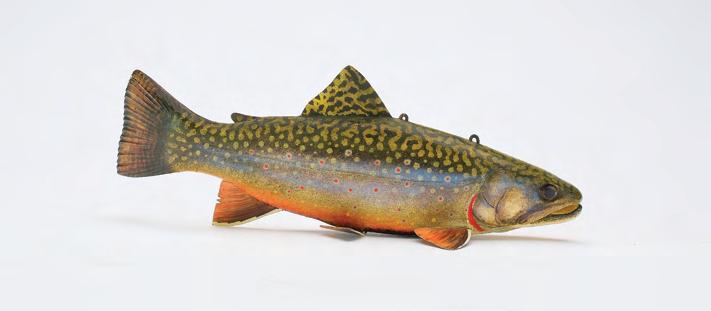
144
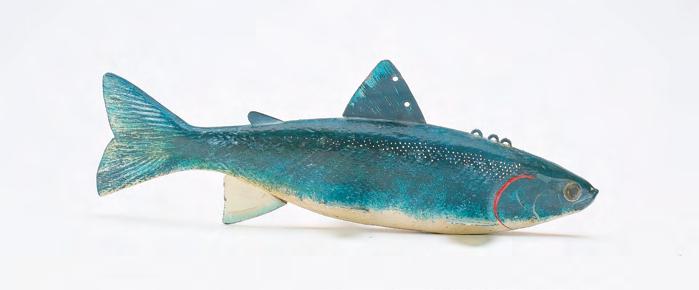
145
147 A.J. Downey, Newberry, Michigan. Herring fish spearing decoy. Measures 10.5” long. A few small scratches, otherwise excellent.
(300 - 400)
148 A.J. Downey, Newberry, Michigan. Grayling fish spearing decoy with carved gill texture and iridescent paint. Measures 12” long. Original paint; tip of tail has been broken and reset; small amount of damage at tip of head and one dent near top fin.
(300 - 500)
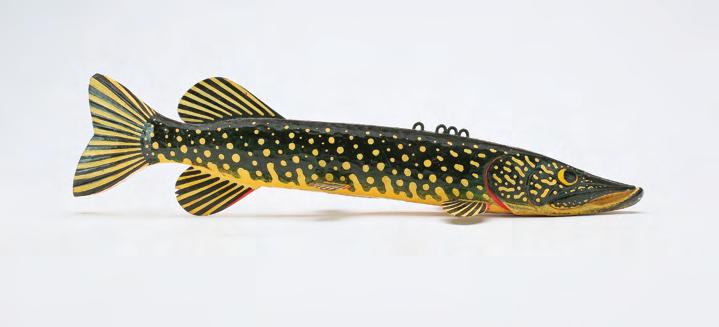
146

147
148
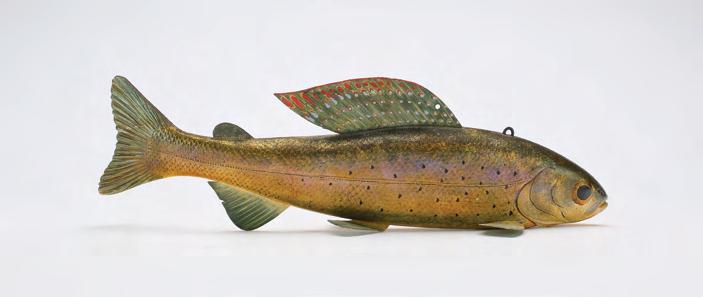
(300 - 400)
149 A.J. Downey, Newberry, Michigan. Frog spearing decoy. A bull frog with line tie at edge of one mouth. Carved wood with metal feet. Maker’s stamp in lead weight at underside. Measures 10.5” long. Excellent and original.
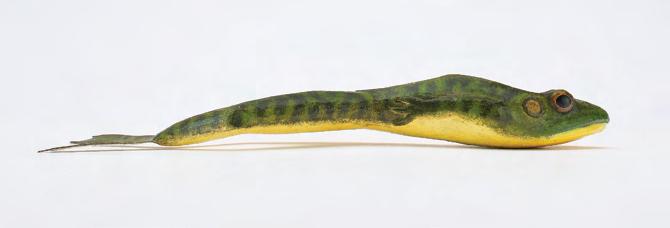
149

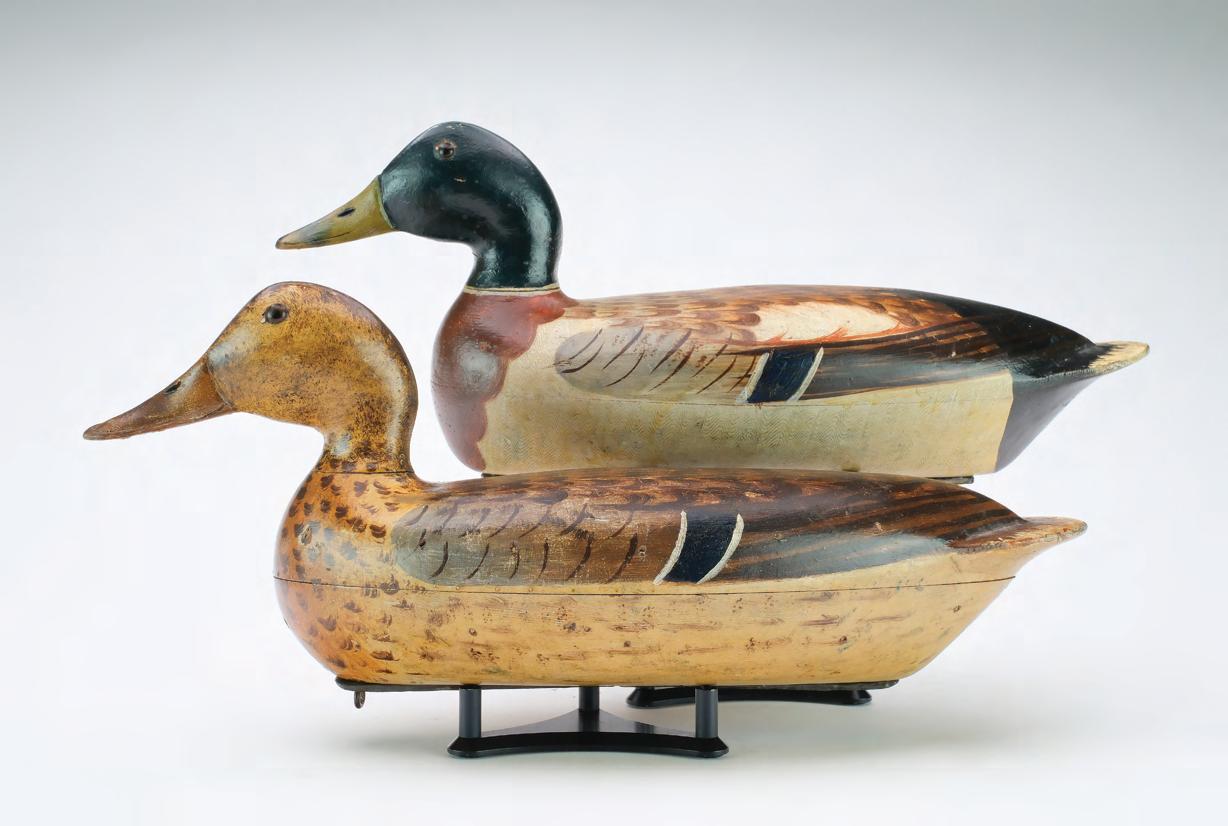

150 Bert Graves (1880-1956), Peoria, Illinois. Outstanding rigmate pair of mallards from the Caswell rig. Branded “CJC” on the undersides for the rig of Charles Justin Caswell, Peoria, Illinois. Both retain the original Graves weights. Measure 17” long. Excellent original paint with a few very minor rubs; a few tiny dents on hen; both protected under an early coat of varnish. (12,000 - 18,000)

Born into poverty on a small Island in Finland, his given birth name was Karl Evert Reinhold. His father died when he was only 8 years old, and his mother had to give him up to a neighbor in order to survive. By age 12 he was serving as a sailor in the Finnish navy. At the age of 18, he and a few neighboring young men immigrated to the United States with the advice of an elderly neighbor - “Work hard boys and you will survive” He paid close attention to the advice! Arriving in Iowa and Minnesota, he learned the English language and discovered his carpentry abilities. By the 1890’s he had moved to Chicago, where he bought himself a used set of carpenter’s tools, changed his name to Charles Edward (C.E.) Carson and went into business for himself. In 1891 he married Swedish born Anna Hallgren and they had 4 children, 2 of which survived infancy.
The C.E. Carson Construction Company flourished, and the firm was awarded some of the largest and most prestigious projects of the day in and around Chicago, including bridges, the High School, hospital buildings, the Garfield Park Observatory, and many others. In addition, he did marine construction work on the Ohio
and Mississippi Rivers. He became wealthy and was quite philanthropic, sending sums of money back to the church in his birthplace whenever it was required.
Charles could, obviously, afford membership in the better duck clubs in the area. By 1910, he was the secretary – treasurer of the Hennepin Shooting Club and a member of the Undercliff Sportsmen’s Association. He would ultimately become the president of the Senachwine Club.
A true “rags to riches” story, Carson’s wealth allowed him to purchase the finest hunting gear. He wisely chose bluebills by Robert Elliston for his personal rig.


151
Robert Elliston (1847-1925), Bureau, Illinois. Hollow carved bluebill with comb feather paint detail and retaining the original Elliston weight. “Carson” branded twice on the underside. Also branded “FSH”. Measures 14” long. Original paint with very minor wear; very minor roughness on edge of bill; thin 2” line of filler and touchup at body seam in one side; minor discoloration at a knot on the other side.
Provenance: Jim and Patti Aikin collection.
(6,000 - 9,000)
 Charles Edward (“Chas”) Carson, 1864 – 1951, Chicago, Illinois
Charles Edward (“Chas”) Carson, 1864 – 1951, Chicago, Illinois
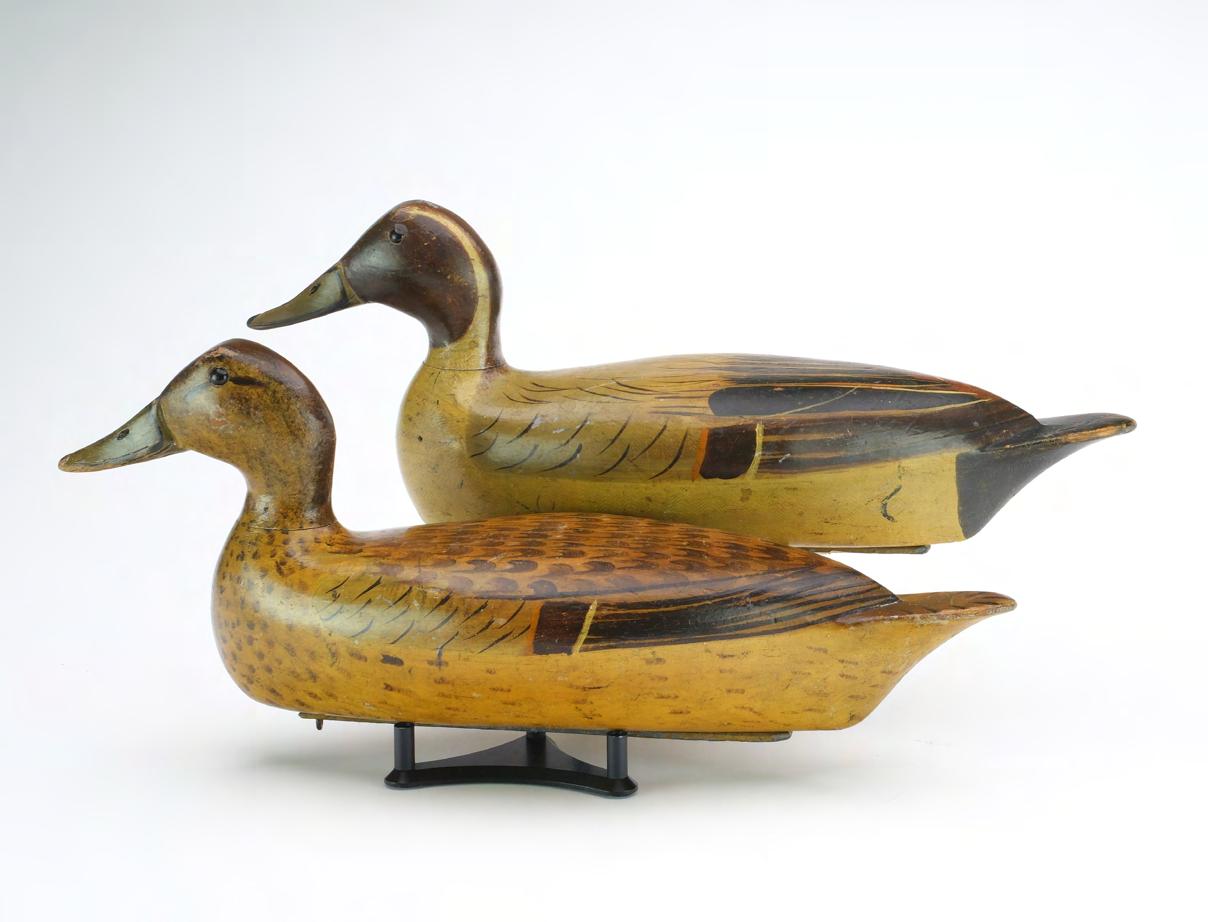
152 Bert Graves (1880-1956), Peoria, Illinois. Rigmate pair of pintails. Hollow carved with comb feather paint detail on drake. Paint by Catherine Elliston. Both retain their original Graves weight. Both are branded “J.L.S.” on the underside. This exact pair is pictured on p. 8 of “Decoys and Decoy Carvers of Illinois,” Parmele and Loomis. Measure 18” long. Original paint with minor gunning wear; protected under a thick coat of early varnish that has darkened with age; minor flaking and scratches to varnish layer; very minor roughness on edge of tails; small bill chip repair on one side of drake’s bill.
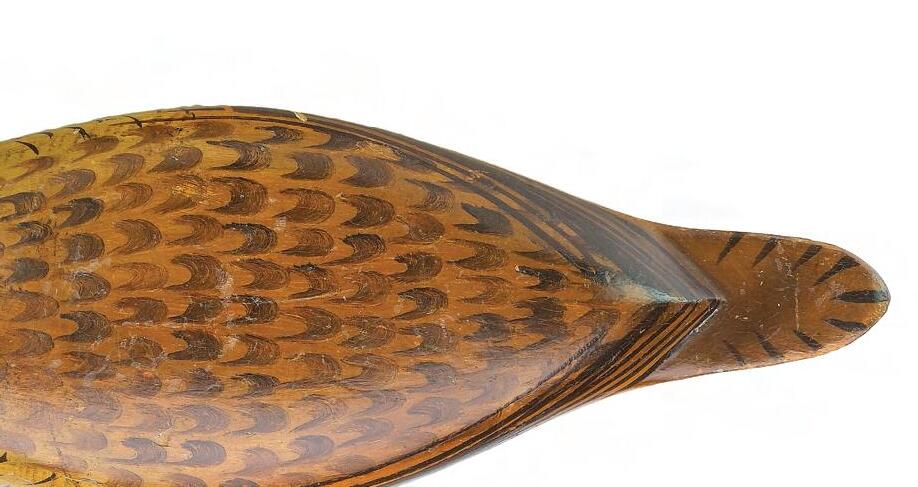
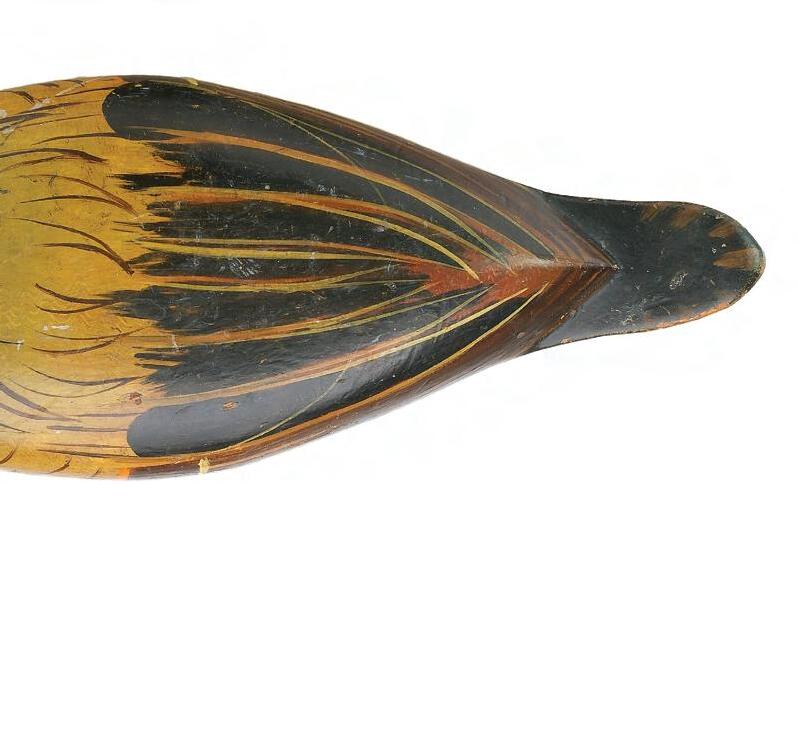
(10,000 - 15,000)
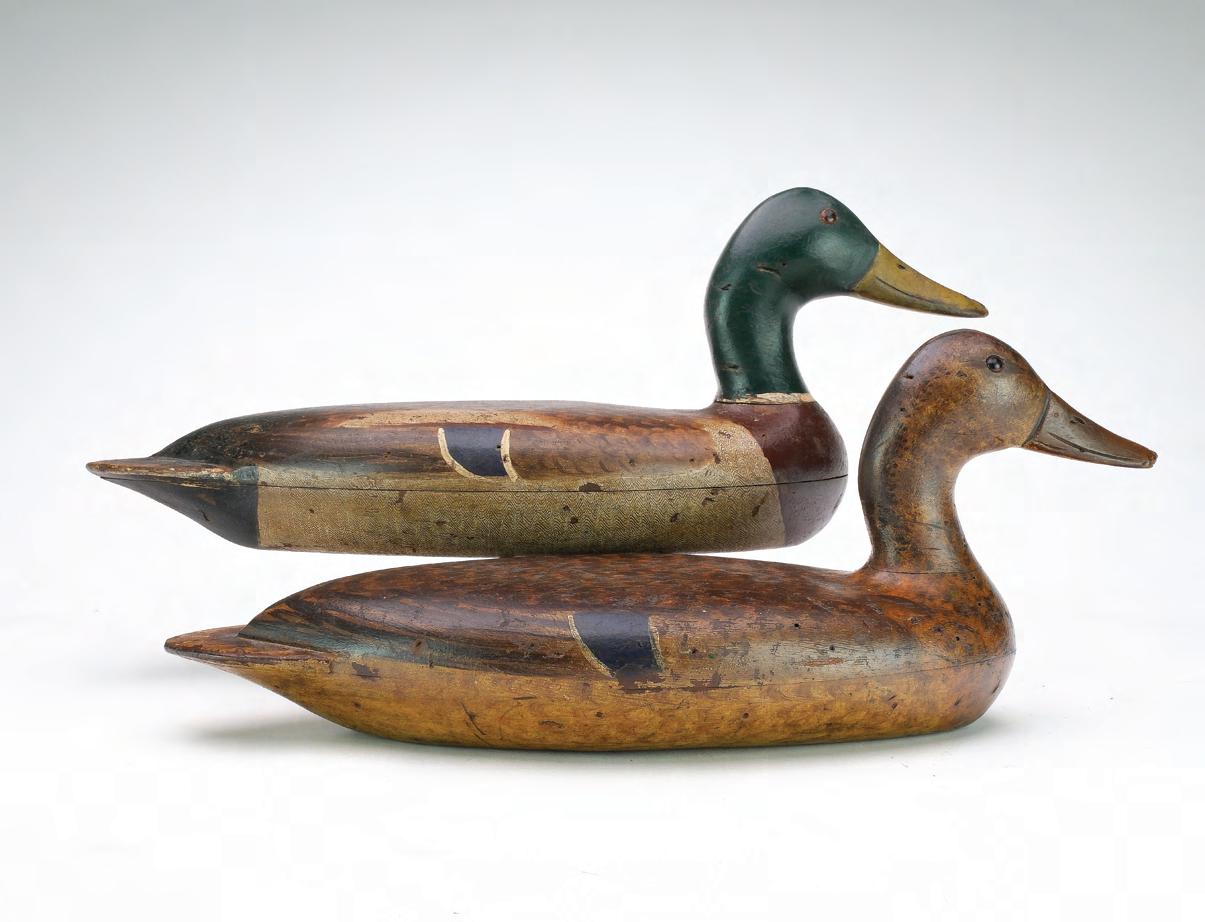
153
Bert Graves (1880-1956), Peoria, Illinois. Rare rigmate pair of oversize mallards. Both have fine swirl feather paint by Catherine Elliston. Both are branded “JVC”. Made for John V. Crawford of Chicago, Illinois and used at the Carte Island Gun Club in Bath, Illinois where he was a member. Purchased by Joe French from the Carte Island Gun club superintendant, Arthur Graff in 1956. Measure 22.5” long. Hen has original paint and minor wear,and has been lightly hit by shot; hairline crack in neck and very minor roughness on the tip of the bill; drake has original paint with minor wear and working touchup on the head, neck, and speculums; it is also been lightly hit by shot.
Provenance: Rig of John V. Crawford. Joe French collection. Private southwestern collection. (8,000 - 12,000)



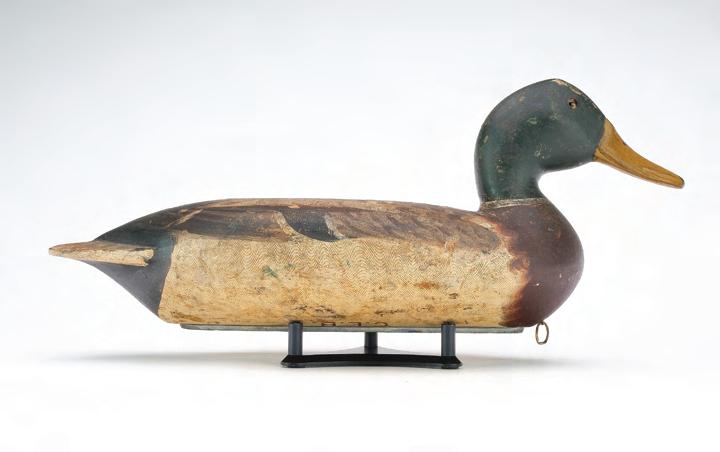
154 Bert Graves (1880-1956), Peoria, Illinois. Hollow carved canvasback drake with comb feather detail. Measures 16.5” long. Original paint with minor discoloration and wear; three tiny shot marks on one side; minor roughness on edge of bill; hairline crack in one eye; professional repair to a crack in upper part of neck.
Provenance: Randy Rall collection. (3,000 - 4,000)
155 Charles Perdew (1874-1963), Henry, Illinois. Early three-piece mallard drake with “E.L.” carved on the underside. Retains the original Perdew weight. Measures 16.5” long. Original paint with moderate flaking and wear; protected under an early coat of varnish; hairline crack through neck; spot of green paint near rig initials. (3,000 - 5,000)
156 Robert Elliston (1847-1925), Bureau, Illinois. Hollow carved mallard with comb feather paint detail. Retains the original Elliston weight. “C.E.B.” branded on the underside. Also branded “F.W. Stanley”. Measures 17” long. Original paint with moderate discoloration and wear; spot of sap bleed at a knot near tail; professional bill crack repair with repaint on the bill.
Provenance: Jim and Patti Aikin collection. (2,500 - 3,500)

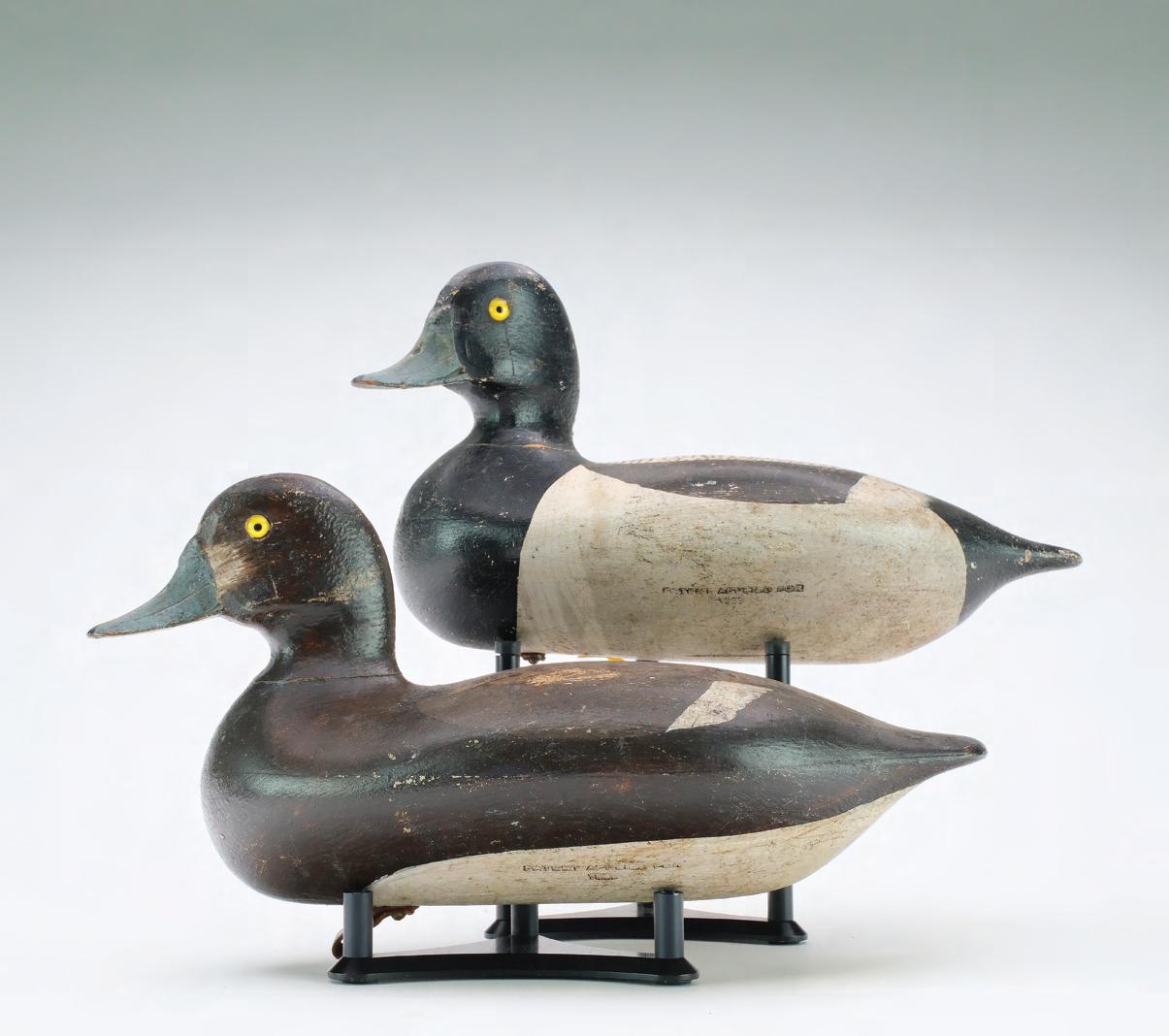
157 George Sibley (1861-1938), Chicago, Illinois. Rare and outstanding rigmate pair of bluebills. Hollow carved with slightly turned heads and typical inlaid bills. Each retain the patent applied for ink stamp on side. Measure 11.75” and 11.25” long. Excellent original paint with minor rubs and wear; structurally excellent. (10,000 - 16,000)

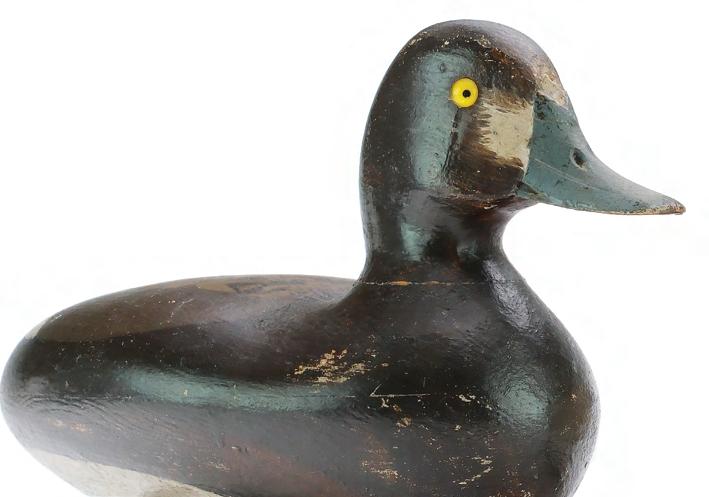

158 Gus Moak (1852-1942), Tustin Wisconsin. Excellent hollow carved canvasback with raised and slightly turned head. “CB9” and “Kangas” branded on the underside. Measures 18.25” long. Original paint with very minor discoloration and wear; a few tiny shot marks and a fine hairline crack on edge of tail, otherwise excellent structurally.
(6,000 - 9,000)

159 Gus Moak (1852-1942), Tustin Wisconsin. Hollow carved canvasback with chamfered bottom board. “J Stransky” painted on the underside. Measures 17.25” long. Original paint with minor wear and moderate discoloration; slight separation at neck seat, otherwise excellent structurally.
Provenance Pudge Bishop collection. (2,000 - 3,000)
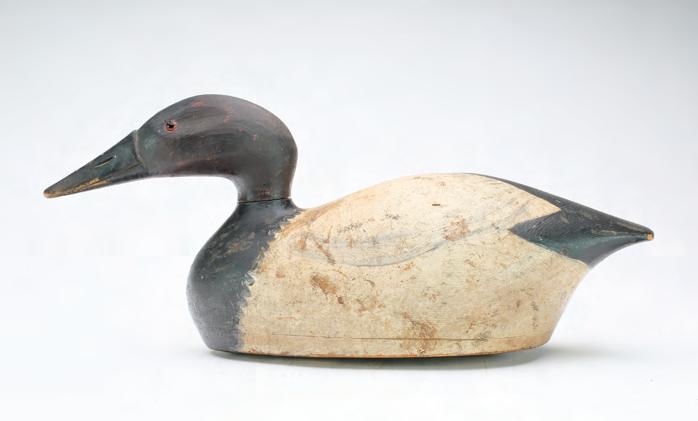
159
160 Gus Moak (1852-1942), Tustin Wisconsin. Hollow carved canvasback hen with chamfered bottom board. Measures 17” long. Original paint with moderate discoloration and wear under an early coat of varnish that has darkened slightly; much of the paint on underside has flaked away; separation at neck seat with an old nail added in the back of neck; minor blunting on tip of tail.
Provenance: Pudge Bishop collection. (2,000 - 3,000)
161 Gus Moak (1852-1942), Tustin, Wisconsin. Hollow carved canvasback hen with slightly turned head. Measures 16” long. Original paint with minor gunning wear; old puppy chews and roughness at tip of bill.
Provenance: Pudge Bishop collection. (2,000 - 3,000)
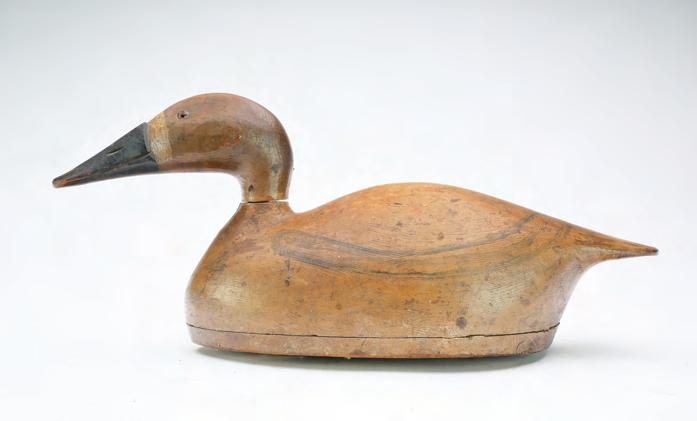
160
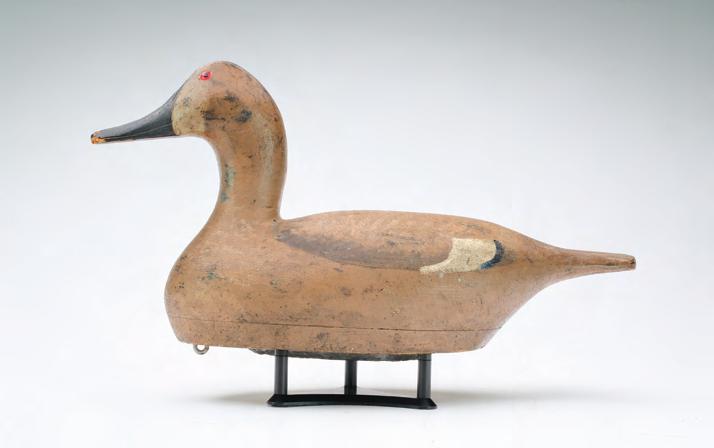
161

162 Unknown maker, Wisconsin, early 20th century. Snow goose with two-piece body and high head pose. Great folk art appeal. “Bay Club” stamped in the underside. Measures 18” long, stands 17” tall. Thick paint appears to be a mix of original and early in use touchup; minor to moderate gunning wear and crazing; structurally good.
Provenance: Part of a small rig found by Dave Spengler in Door County Wisconsin in the 1970s. This is the only one with the “Bay Club” brand. Bob Timberlake collection. David Meyer collection. James and Lyda Madden collection.
Literature: “The Great Book of Wildfowl Decoys,” Joe Engers, page 257, rigmate pictured.
(12,000 - 18,000)
163 Mandt Homme (1905-1964), Stoughton, Wisconsin. Hollow carved canvasback drake with plump body and relief wing and tail carving. Raised crossed wingtips and comb feather paint detail. Head is turned slightly to one side. Measures 16.25” long. Thick original paint with minor flaking and wear; hairline crack in one side of neck; small dent in one edge of tail.
Provenance: From the hunting rig of Dr. Ansley Thomas Shearer.
(6,000 - 9,000)

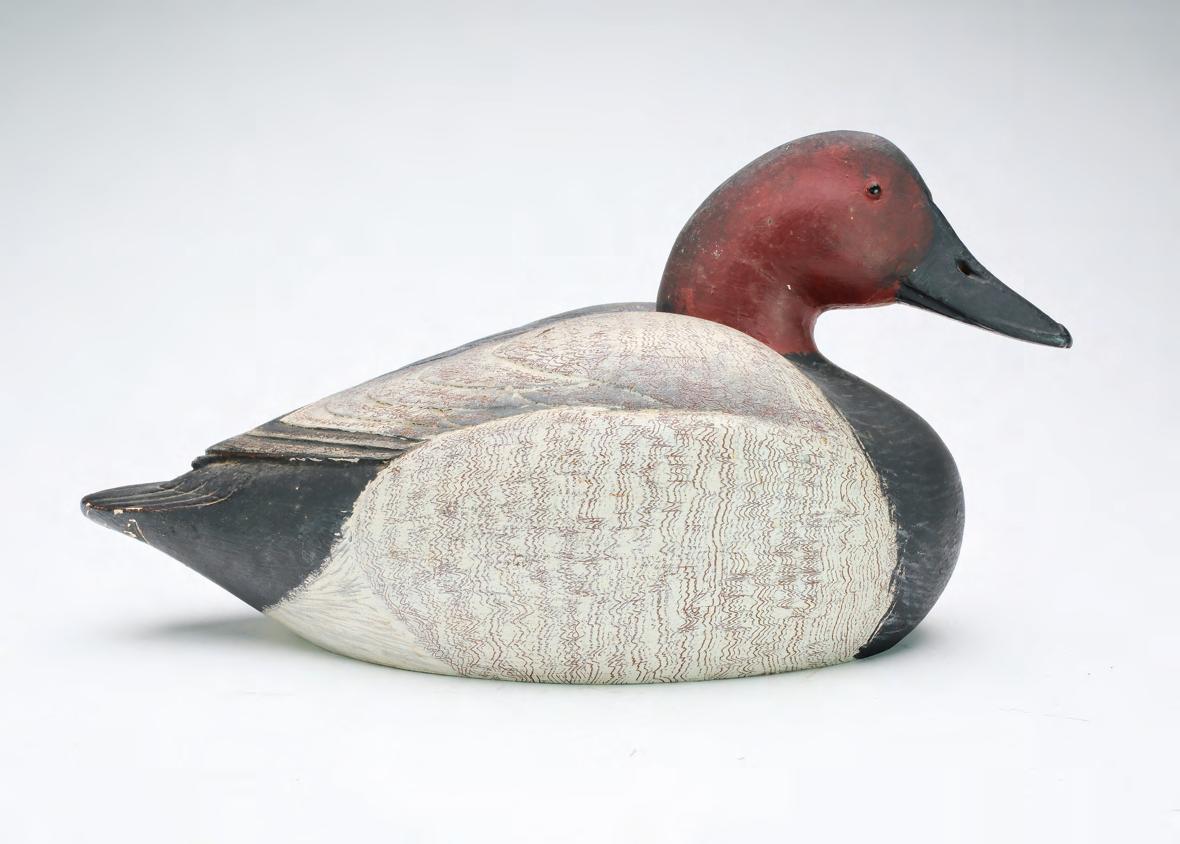
164 Otto Weinert (1893-1979), Oshkosh, Wisconsin. Pair of bluewing teal with slightly turned heads and detailed feather painting. Hen with front and side line tie staples. Drake with rear line tie staple recessed under tail. Measure 10.25” and 10.75” long. Original paint with very minor wear on each; drake with drying cracks in one side and small dents in body; slight yellowing to varnish on drake; white bars at hen’s wing patches have a second coat over the varnish, but likely done in the making.
Provenance: Herb Desch collection. (6,000 - 9,000)
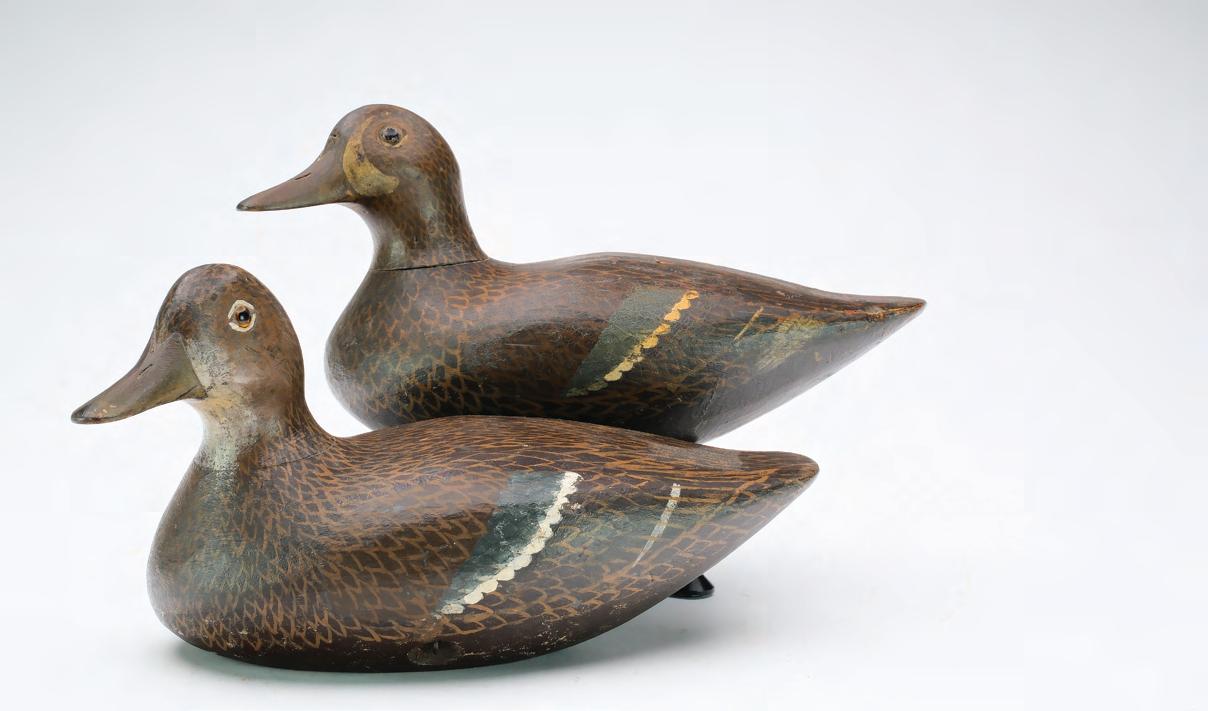

165 Walter Pelzer (1911-1998), Milwaukee, Wisconsin. Widgeon drake with slightly turned head and relief wing carving. Inlaid lead weight and line tie staple on the underside. Measures 15.5” long. Original paint with moderate gunning wear under a thick coat of varnish that has darkened with age; small dents and shot marks; chipping and roughness on tip of bill; old chip at tip of tail; drying cracks along one side of body.
Provenance: Pudge Bishop collection. (2,000 - 3,000)
166 Ferd Homme (1901-1963), Stoughton, Wisconsin. Mallard hen with tucked and turned head with detailed wingtip and tail carving. Two piece hollow body with intricate feather painting. Measures 16” long. Excellent original paint with virtually no wear; underside appears to have been repainted when the rigging was removed; a hole in the back has been plugged, as decoy was probably a lamp at one time.
(1,500 - 2,500)
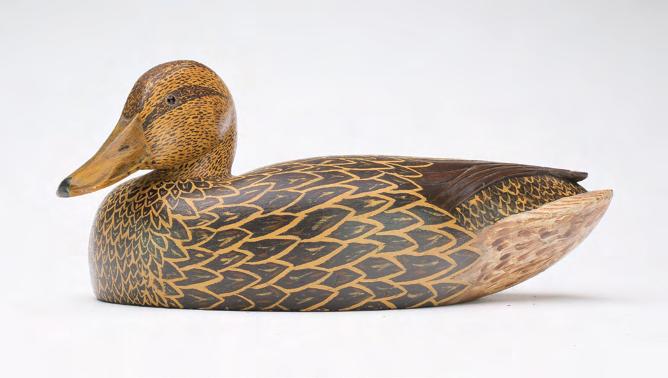
166
167 Marvin Strahota (1903-1977), Marquette, Wisconsin. Cork body goose with scratch feather paint detail and wooden bottom board. Measures 24” long. Original paint with very minor wear; a few small dents, otherwise excellent structurally.
Provenance: Ron Koch collection. Private Tennessee collection. (1,200 - 1,800)
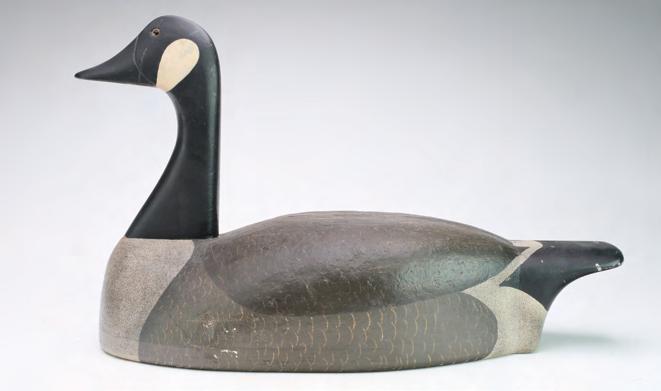
168 Evans Decoy Factory (1921-1932), Ladysmith, Wisconsin. Pair of mammoth grade canvasbacks. “H” carved in the underside of hen. Measure 17.5” long. Original paint with minor wear under a thin coat of varnish; crack through hen’s neck was tightened; repair to a crack and dent in drake’s bill; flaking at drake’s neck seat.
Provenance: Pudge Bishop collection. (500 - 800)
169 Evans Decoy Factory (1921-1932), Ladysmith, Wisconsin. Mammoth grade mallard hen with scratch paint. Evans stamp on underside. 18” long. Original paint with light wear; small gouges; a piece of wood near knot in top of back; filler loss at one side of neck. (400 - 600)
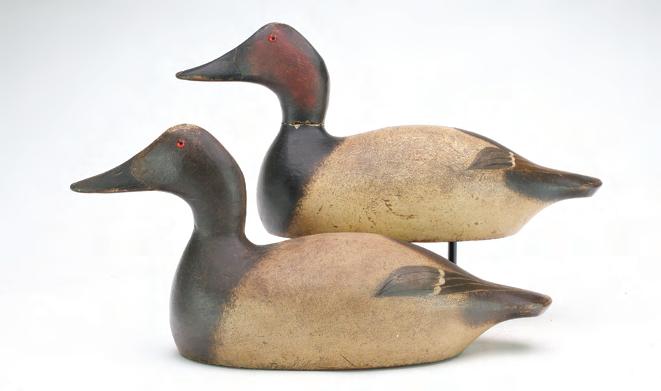
168
167 169
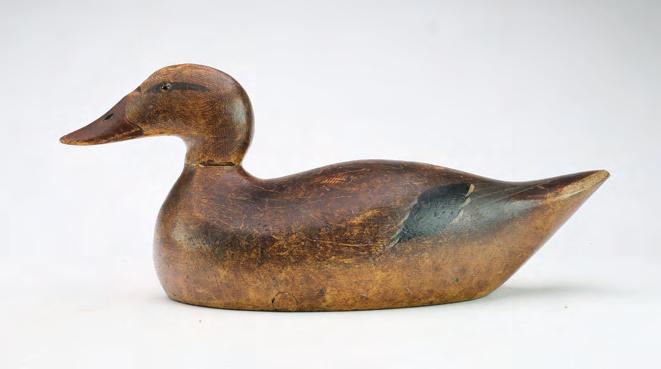

“The artistry of Nicole Vidacovich has stood the test of time. The eye that watched the cupped wings and the heart that thrilled to the whistle of the wind have left a lasting memorial to our wetland heritage” (Charles W Frank Jr. “Wetland Heritage”)
Nichole’s father, Johanne, immigrated to the United States from Yugoslavia and he and his wife, Charlotte, along with their eight children settled in Sunrise. References refer to him as a skilled woodworker or cabinet maker, but various census records indicate that he was a farmer. Louisiana authority Charles Franks states that, by the1860’s, he was working both as a planter and in the oyster industry. As was the socially accepted norm in much of the south at the time, he had a total of six slaves and was considered an affluent resident of the Parish.
Receiving only a second grade education, young Nicole grew up frequenting the vast marshes surrounding his home. By the age of fifteen he was carving his own decoys and, at an early age, became a respected hunter. For a period, he is known to have gunned for the market. In 1881, he married Marie Bulot and they, like his parents, had nine children of their own. Through the 1910 census he lists his official occupation as a truck farmer. His skill afield, however, did not go unnoticed by the wealthy members of the local duck clubs and, between 1890 and 1915, he found ready employment guiding at both the prestigious Delta Duck Club and the Chateau Canard owned by Chicago resident, Joseph Lieter.
A massive hurricane swept southern Louisiana in 1915 with devasting results. Hunting clubs suffered major losses and the hamlet of Sunrise was washed into history. Nicole had moved his family to New Orleans prior to the storm and returned afterwards to salvage what few belongings he could. Returning to New Orleans, at age 62, he began to carve in earnest. The 1920 census documents him as a “wood designer” renting a home at 3826 Tulane Ave., and the city directory of the same year proclaims his occupation as “decoys”. By 1930 he had no stated occupation but his son, Nicole Jr who was
living with him, is listed as working in a “Decoy shop” and one can logically assume that Nicole Sr played a role in the shop’s activities.
Sadly, his wife passed away in 1938 and, by 1940, Nicole age 87, had bought a home of his own on Dumaine St where he had no stated occupation and was living with four of his adult children. People who knew him remember him as a “traiteur” (faith healer) and a quiet, humble man, always recognizable by his trademark derby hat.
During his lifetime Nicole Vidacovich produced some of the very finest of Louisiana’s decoys. His skill and artistry in accurately depicting the various species was unsurpassed. He utilized his own hand selected and harvested cypress roots, embellished the carvings with finely carved detail, and finished the creations with taxidermy quality glass eyes and fine artist oils. The 1915 hurricane was certainly not the last to overpower Louisiana and the storms to come claimed many of Nicole’s decoys. Finding one today in fine original condition is a great rarity to be prized.


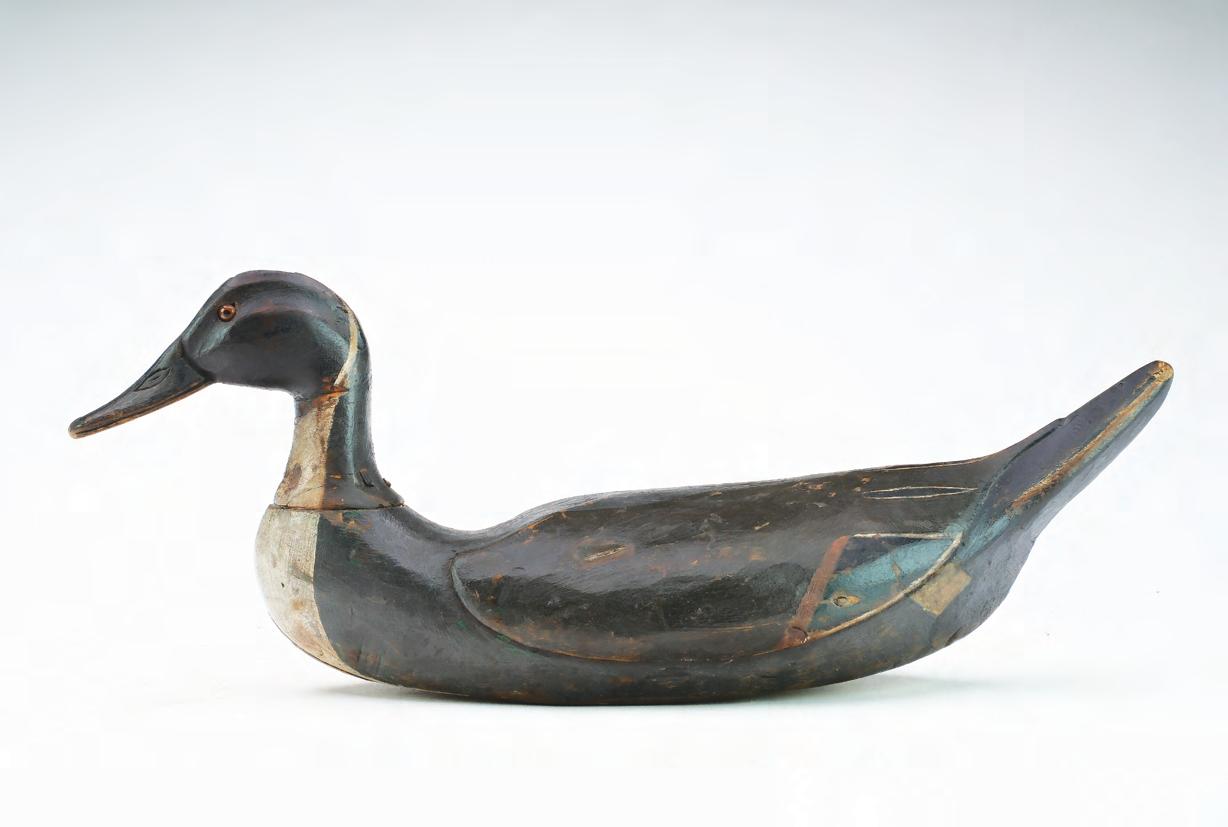
170 Nicole Vidacovich (1853-1945), New Orleans, Louisiana. Pintail drake with upswept tail and relief wing carving from the Benedict rig. Measures 17.5” long. Original paint with moderate gunning wear; long wooden patch on underside; professional neck crack repair with touch up and some tight cracks still visible; repair to a chip in one side of neck seat with small amount of glue visible in that area; early second layer of white on the underside runs partway up the breast.
Provenance: David Fannon collection. Tom O’Key collection. Private southwestern collection.
(12,000 - 18,000)

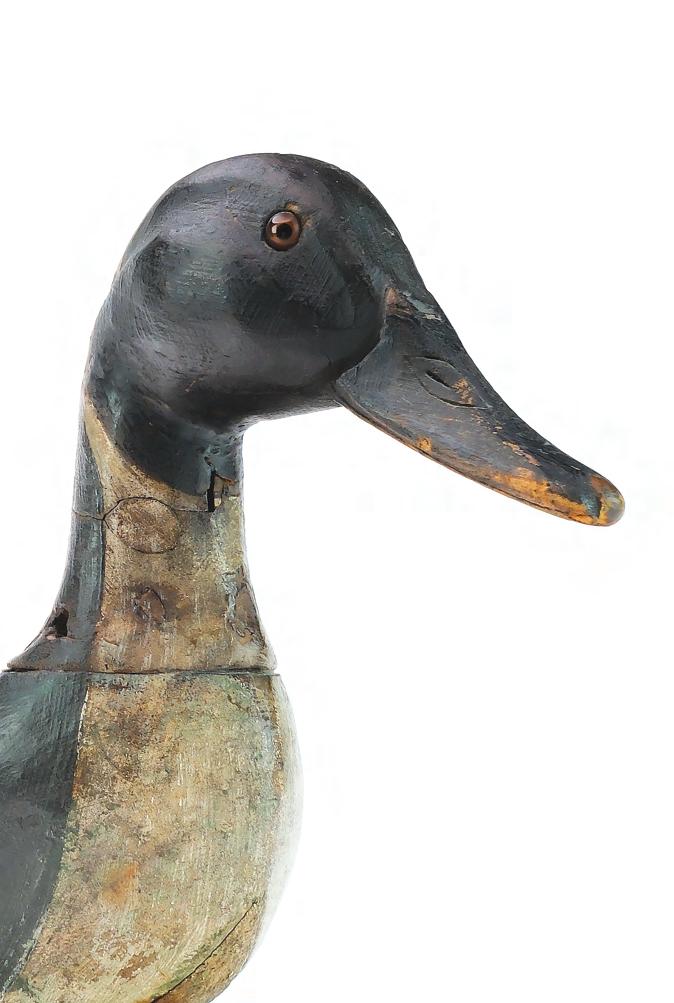
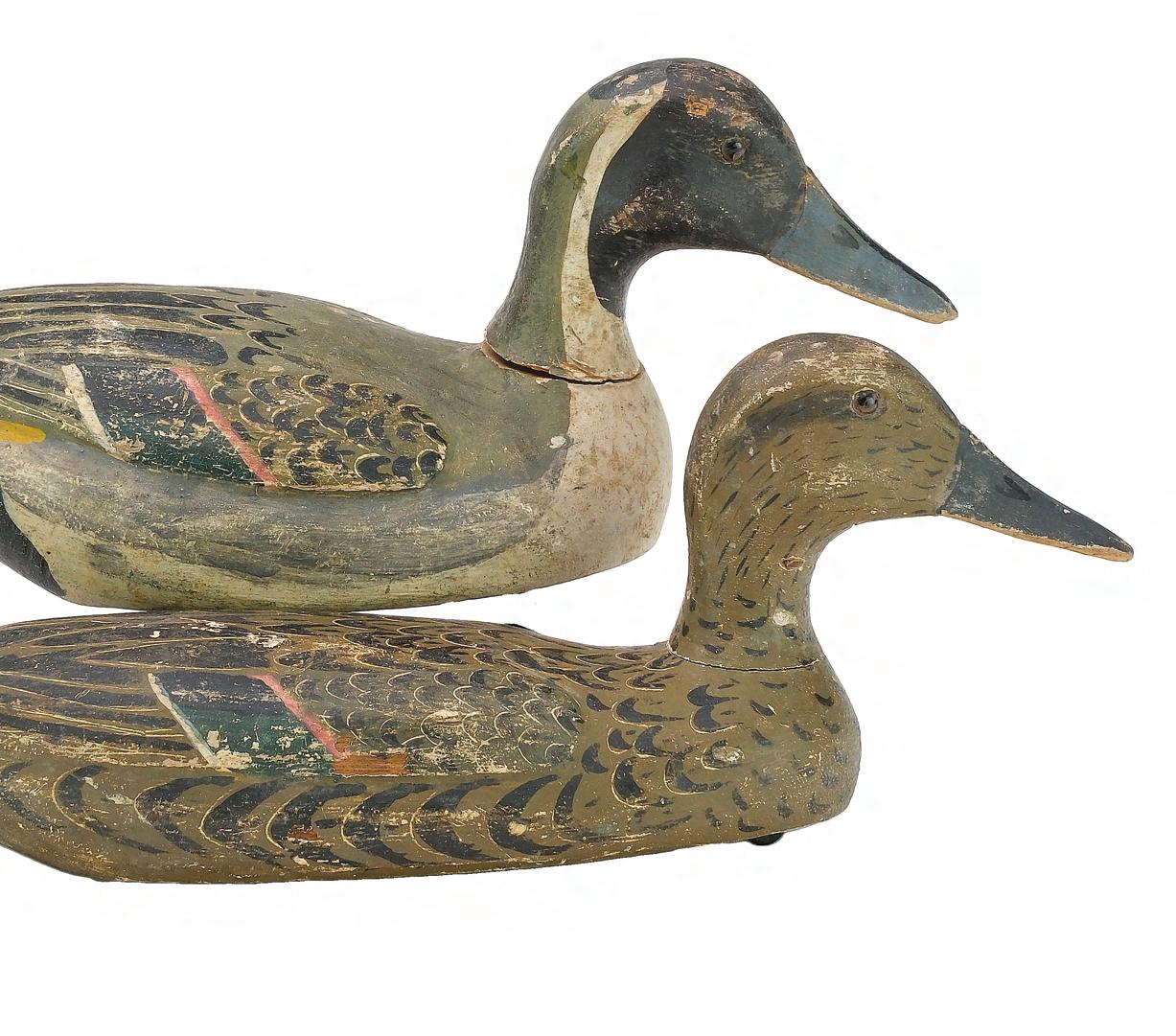
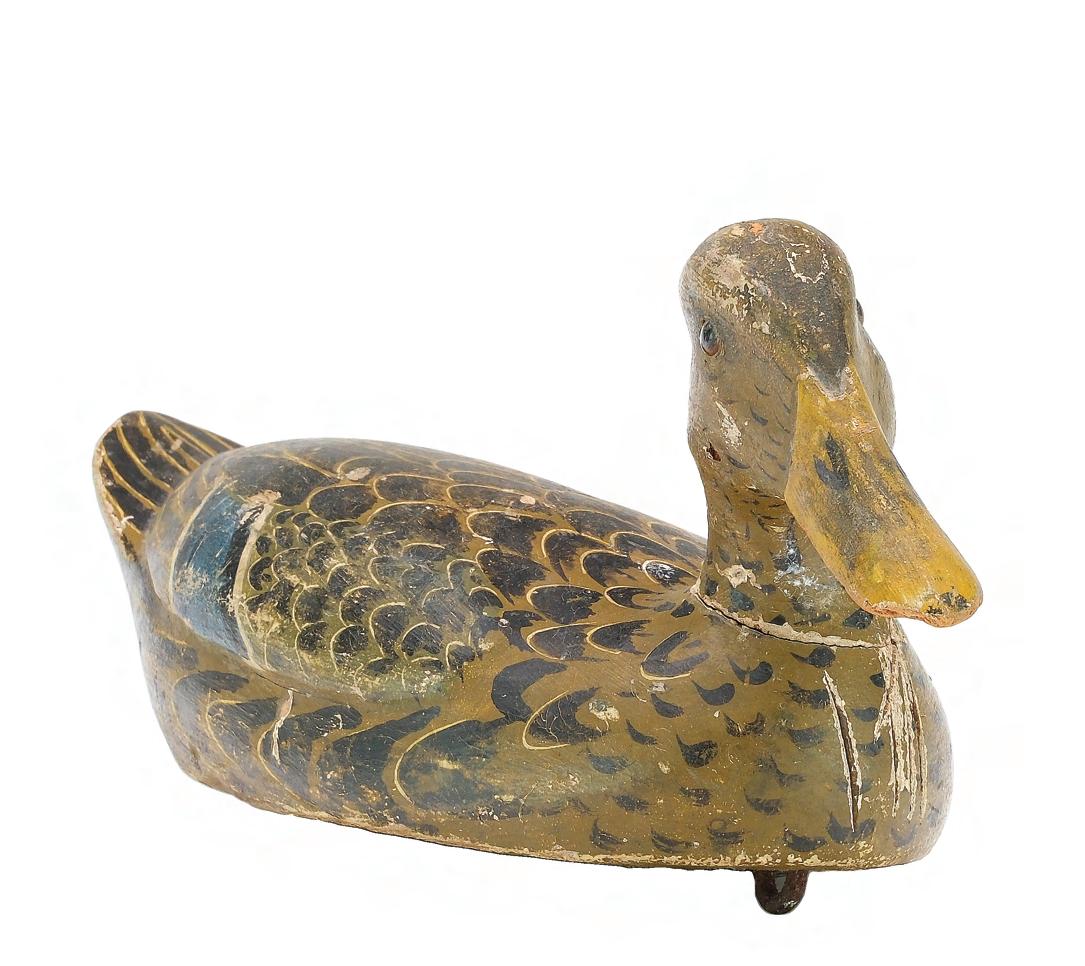
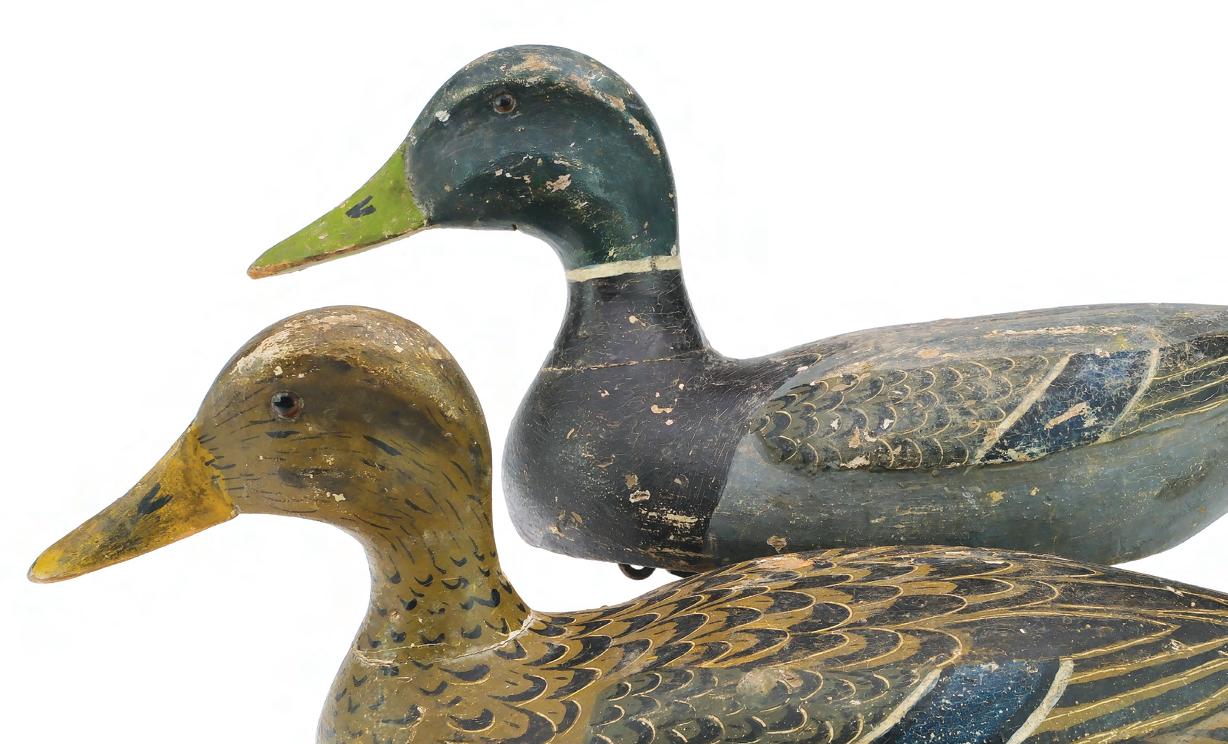
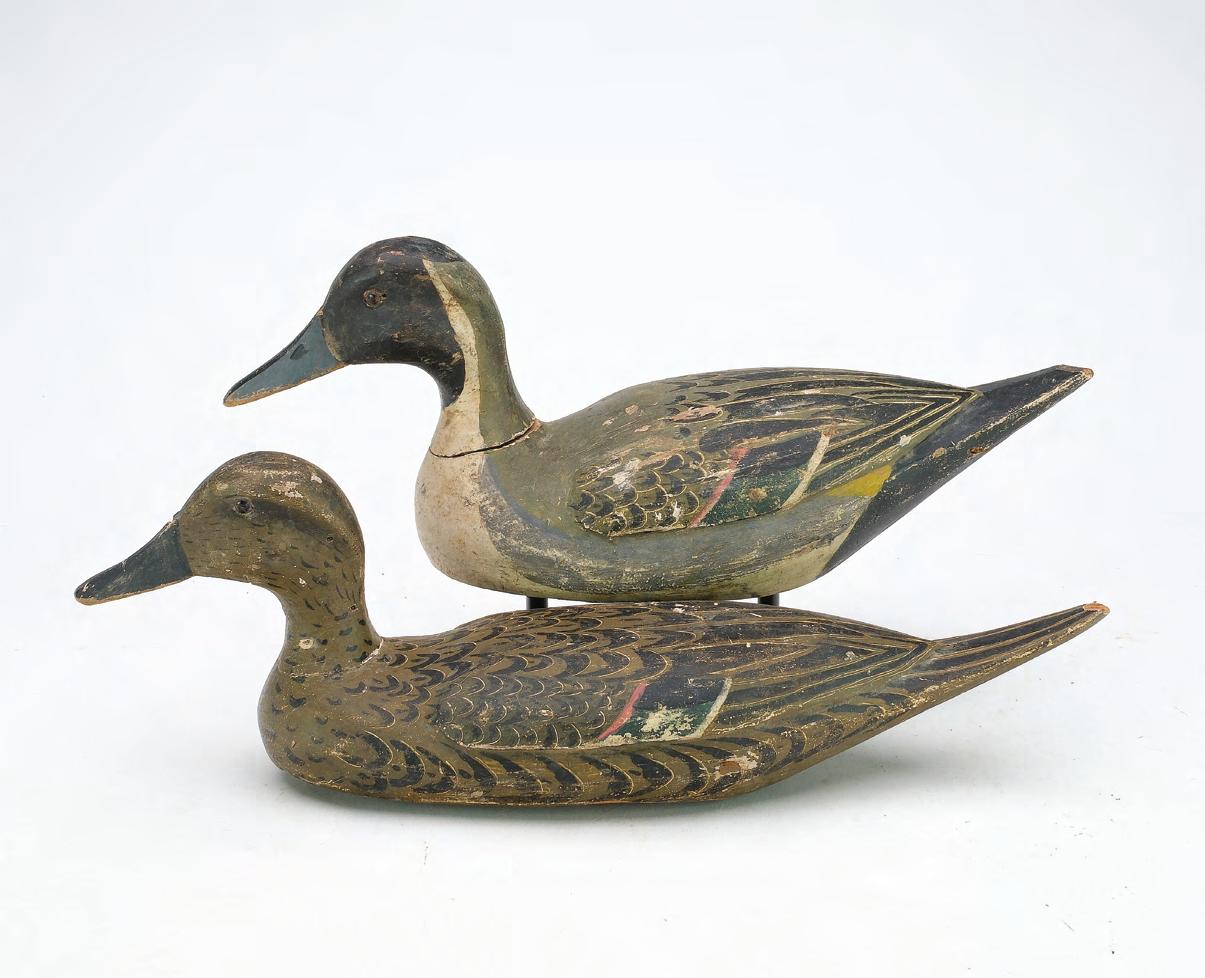
Provenance: Rig of Marks Labat, a friend of Lafrance from Bay St. Louis, Mississippi. Used at Pointe a la Hache, Louisiana. By descent in the Labat family.
(12,000 - 16,000)
172


173
172
Mitchell Lafrance (1882-1979), New Orleans, Louisiana. Early rigmate pair of mallards with relief wing carving and scratch feather paint detail. This pair is new to the collecting market, and have never been offered at auction. Measure 16” long. Original paint with moderate gunning wear; scattered dents and shot marks; old chip in tip of drake’s tail; tight cracks in one of hen’s eyes.
Provenance: Rig of Marks Labat, a friend of Lafrance from Bay St. Louis, Mississippi. Used at Pointe a la Hache, Louisiana. By descent in the Labat family.
(8,000 - 12,000)

173 Mitchell Lafrance (1882-1979), New Orleans, Louisiana. Excellent little mallard hen with cocked head. Relief wing carving and scratch feather paint detail. Head is turned and tilted to one side. This decoy has never been offered at auction. Measures 14.25” long. Original paint with moderate gunning wear; hairline cracks in eyes; tiny chip in tip of bill; drip of white paint on back of head was partially removed; appears to have been hit by boat prop in breast.
Provenance: Rig of Marks Labat, a friend of Lafrance from Bay St. Louis, Mississippi. Used at Pointe a la Hache, Louisiana. By descent in the Labat family.
(6,000 - 9,000)
174 George Frederick Jr. (1907-1977), Davant, Louisiana. Pintail with slightly turned head and relief wing carving. Measures 16.75” long. Original paint with moderate to significant wear; white on breast and lower part of body is an early second coat; tight crack in bill; separation at neck seat.
Provenance: Rig of Marks Labat, a friend of Lafrance from Bay St. Louis, Mississippi. Used at Pointe a la Hache, Louisiana. By descent in the Labat family. (1,500 - 2,500)
175 Mark Whipple (1888-1961), Bourg, Louisiana. Bluewing teal with reared back head. Measures 10.75” long. Original paint with minor gunning wear; thin varnish layer with moderate flaking; repair to a chip on one side of top of head; otherwise good structurally.
(4,000 - 6,000)
176 Mark Whipple (1888-1961), Bourg, Louisiana. Coot. Measures 9” long. Original paint with minor gunning wear under a thin coat of varnish; separation at knots or wood patches in breast and under tail; hairline crack in bill.
(2,000 - 3,000)

174 175

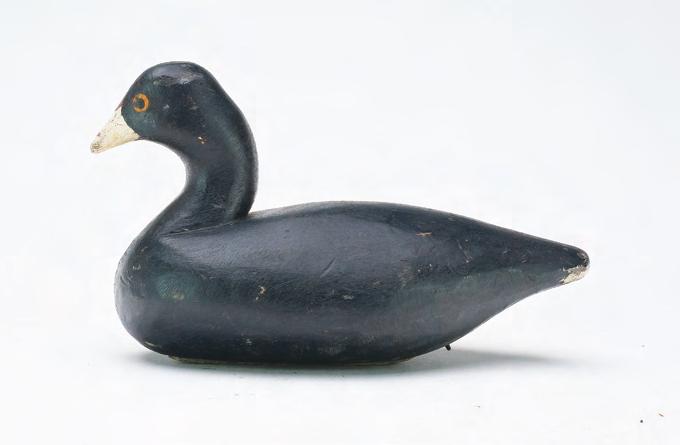

177

178
(5,000 - 8,000)

179

180
Provenance: Jim and Patti Aikin collection. (1,500 - 2,500)
180 Unknown maker, last quarter 19th century, Ohio. Black duck with laminate construction and inlaid neck seat. Measures 16.5” long. Original paint with moderate wear; minor roughness on edge of tail; a few small drops of black paint on back and one side.
(600 - 900)
180a
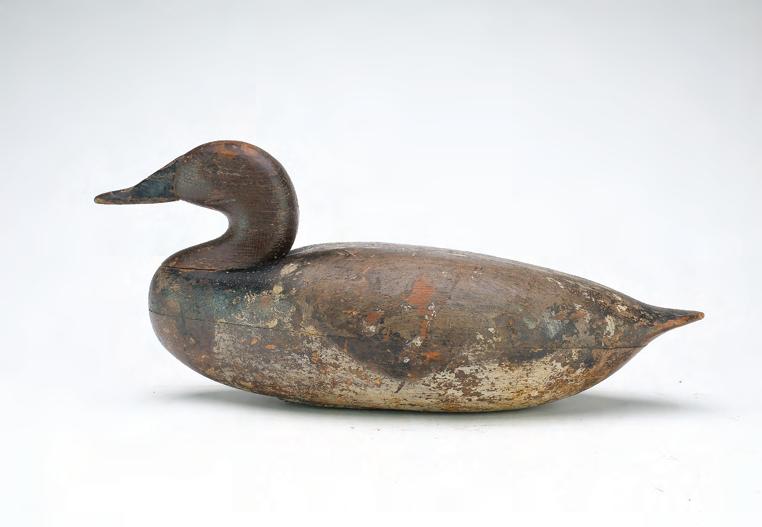

180b
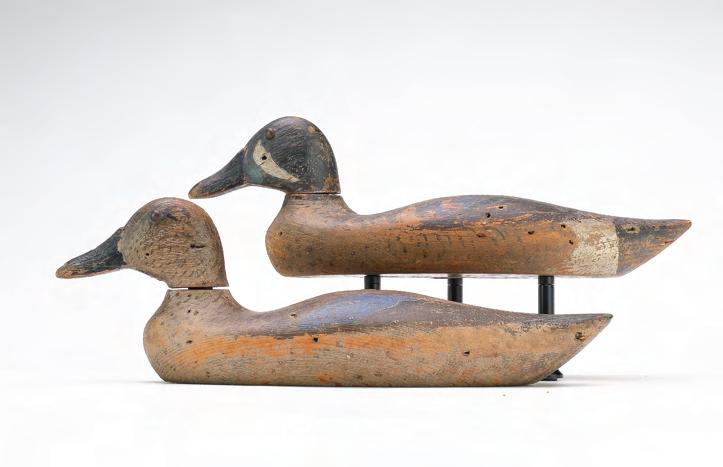
180c
180a Ned Hauser, Port Clinton, Ohio. 3rd quarter 19th century. Two piece hollow body with carved eye. Initials “HEB” carved in underside. Measures 17” long. Multiple coats of old paint; tight crack in bill; rough area at one side of tail.
Provenance: Gene and Linda Kangas collection. (2,500 - 3,500)
180b William Pepper, Rocky River, Ohio. Early and desirable Ohio decoy. Stamped “BB 15” on underside. Pepper’s unique manufacturing process allows for the bills to be replaced as they were dove tailed separately in to the head and are removeable. 14” long. Original paint with crazing evenly over back and head; what appears to be a neck crack is actually a raised shelf; light in use wear with a few scuff marks.
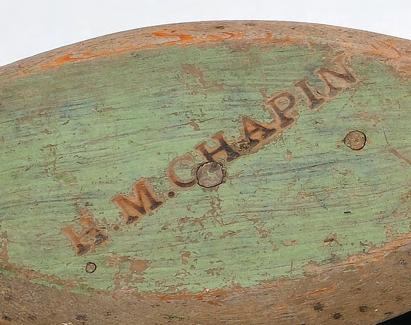
Provenance: Gene and Linda Kangas collection. (1,500 - 2,500)
Unknown maker, Ohio. Pair of bluewing teal. Blair style. Branded “H.M. Chapin” on both. Tack eyes with raised neck seat. Measures 12” long. Both show heavy in use wear; original paint has worn to expose natural wood surface; both have shot scars; hen has had lower portion of bill reset.
Provenance: Gene and Linda Kangas collection. (1,000 - 1,500)
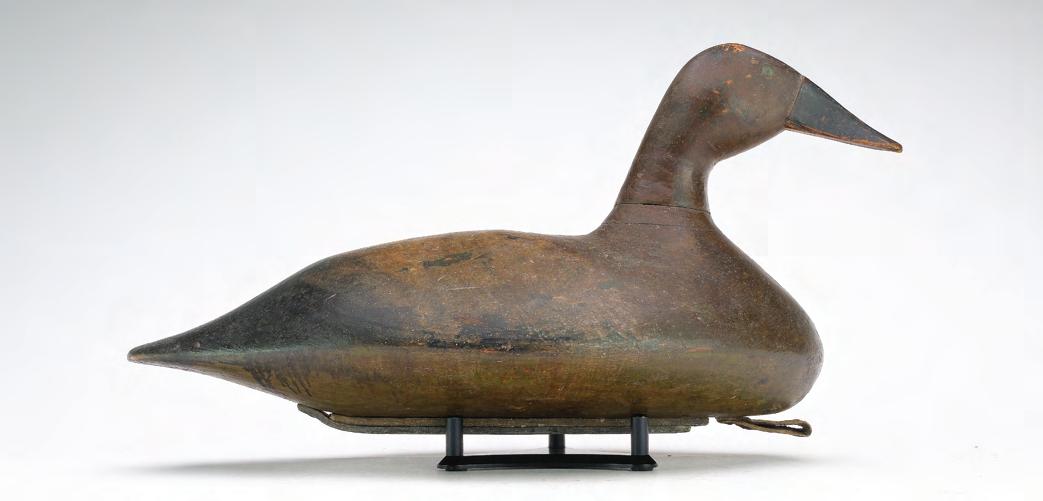
180d
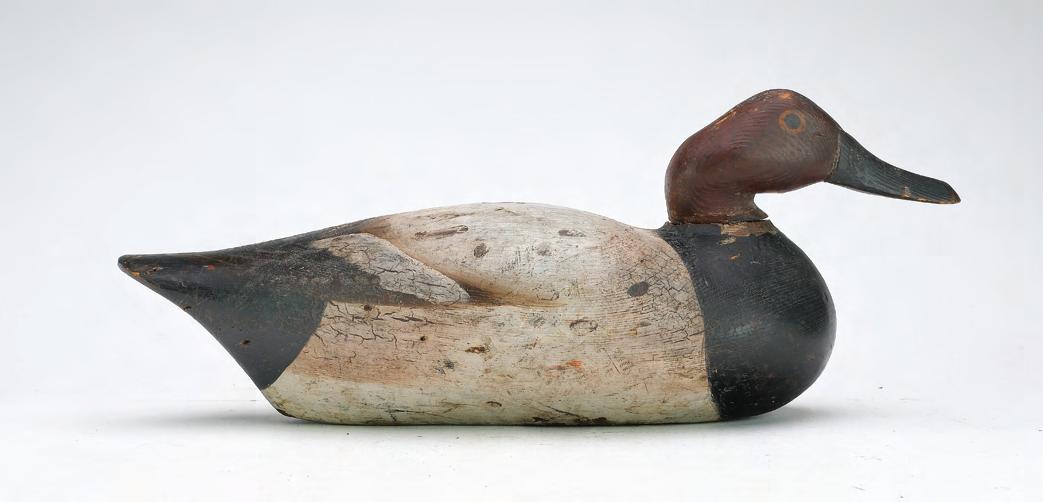
180e
180d Ollie Gunderson, Minnesota. Swimming canvasback hen with cut glass eyes and raised neck seat, circa 1900. Measures 16” long. Original paint with a green base or primer coat showing through in some areas; contemporary restoration to a crack in the neck.
Provenance: Gene and Linda Kangas collection. (4,000 - 6,000)
180e Peterson Decoy Factory, Detroit, Michigan. Canvasback drake, 4th quarter 19th century. With painted eye. Branded twice “E.G. Gardner” and “C.C.Bolton”. Both early Ohio club members. Measures 16” long. Strong original paint; moderate in use wear; neck filler missing; a few shot scars; rubs and small dents.
Provenance: Gene and Linda Kangas collection. (1,500 - 2,000)
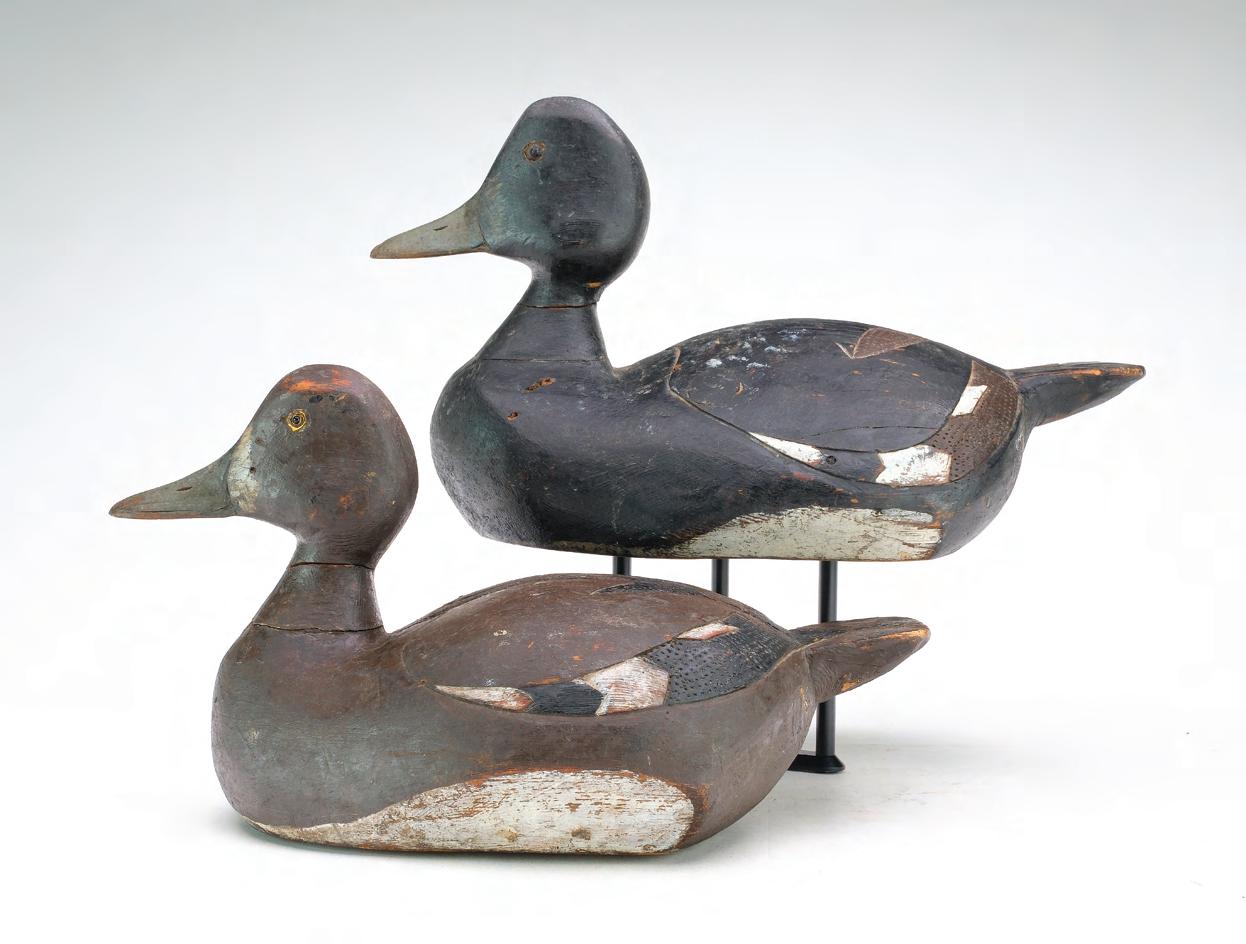


180f Frank Buchner, Erie, Pennsylvania. Rigmate pair of bluebills, 1st quarter 20th century. Classic Buchner style with anchor carving in back and decorative tail motifs. Owner’s copper tags in underside “J.F. Buchner, Erie Pennsylvania.” 15” long. Original paint with light gunning wear; both have cracks in neck; hen has a very well done professional bill replacement.
Provenance: Gene and Linda Kangas collection. (6,000 - 8,000)
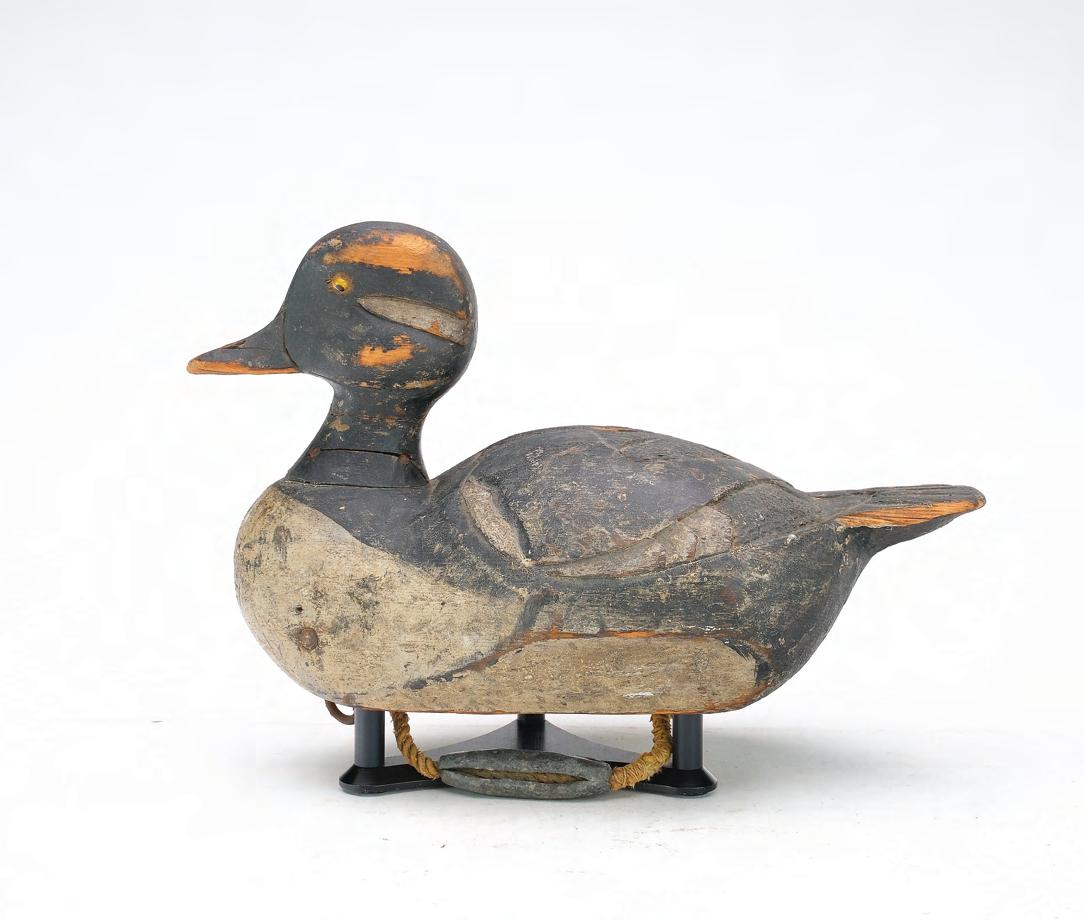
180g Frank Buchner, Erie, Pennsylvania. Bufflehead hen, 1st quarter 20th century. Owner’s copper tag with Anthony Staub Erie, Pennsylvania on underside. Classically carved anchor and sunburst on tail. Glass eyes. 10” long. Original paint with moderate gunning wear; neck crack; natural wood exposed where paint is missing; tight crack in bill and one side of tail partially worn off; two cracks in neck.
Provenance: Gene and Linda Kangas collection. (5,000 - 8,000)
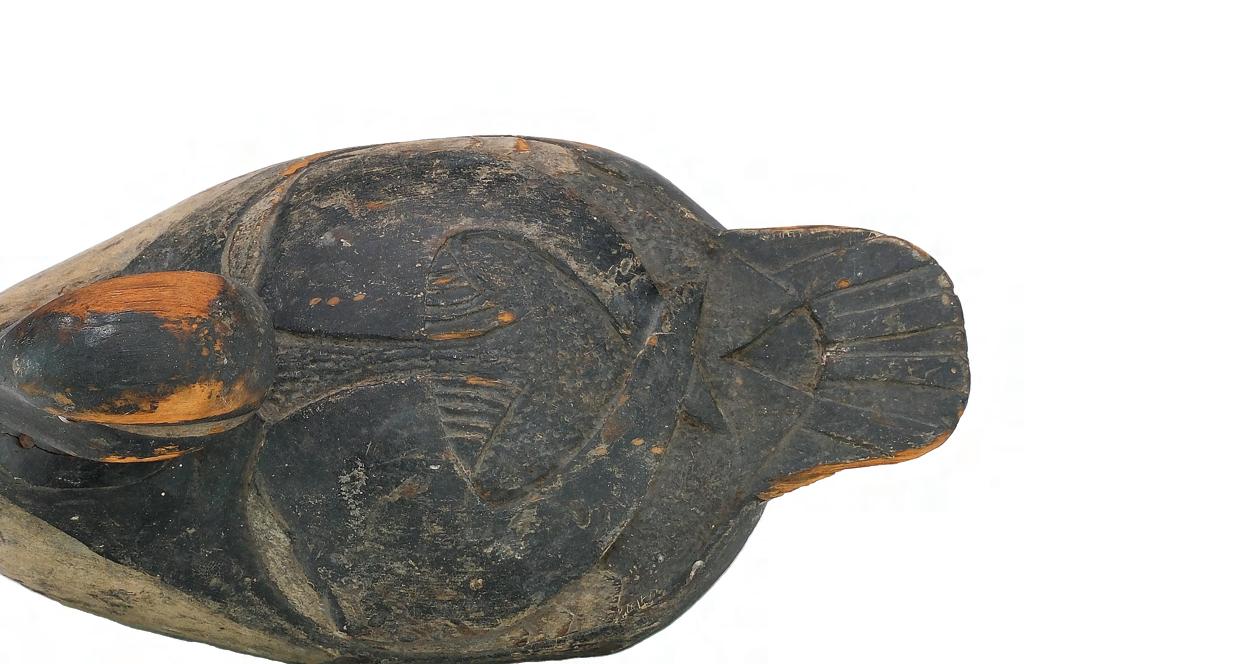
Edmund Osthaus was a German-born American painter known for his realistic depictions of dogs, particularly hunting dogs, as well as his landscapes and portraits. Osthaus was born in Hildesheim, Germany. His family moved often: after fleeing Germany for Mexico and later the United States, they returned to Germany for some time, only to permanently settle in Wisconsin. Osthaus attended art classes in New York City and in Düsseldorf, Germany, and studied with Peter Janssen the Elder, Andreas and Karl Müller, Julius Roeting and Eduard Gebhardt. His greatest influence, however, was animal painter Christian Kroener. Osthaus focused on depicting hunting breeds in particular in oil, watercolor, and pencil, and became a celebrated painter of sporting art. He served as the Director of the Toledo Academy of Fine Arts in Ohio, where he also taught.
Osthaus became known in particular for his dog portraits, which were sold on calendars, postcards and lithographs by the DuPont Gunpowder Company from Wilmington, Delaware. As an illustrator he has worked for various newspapers and magazines such as the Saturday Evening Post, Field & Steam, Collier’s, McCall’s, the Literary Digest and Cosmopolitan.
Osthaus’ paintings are in the collections of the Toledo Museum of Art, the Oshkosh Public Museum, the Washington County Museum of Fine Arts, Hagerstown, Maryland, the Port Huron Museum, the Canton Museum of Art, the Butler Institute of American Art, and the American Kennel Club. He was an avid hunter and fisherman and bred dogs.
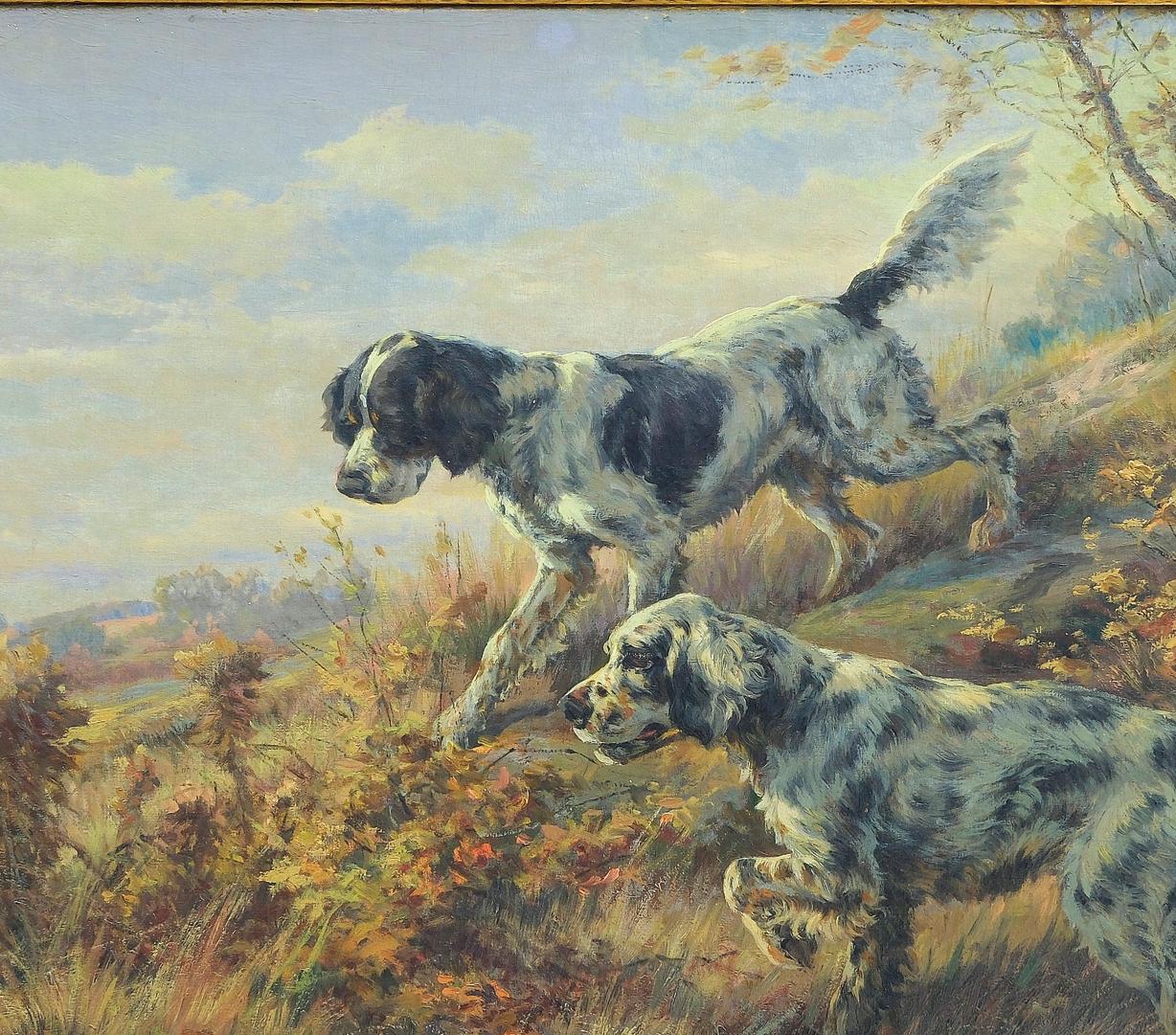
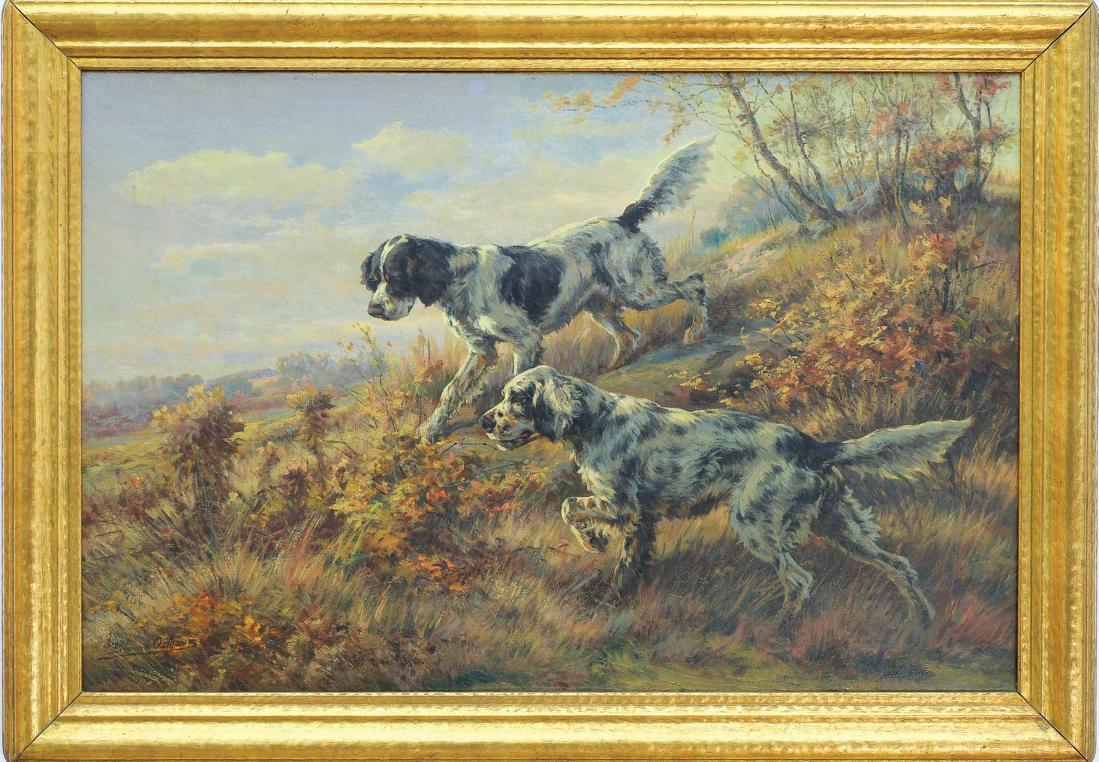
Provenance: David Fannon collection. (25,000 - 35,000)
1884 - 1966

(10,000 - 15,000)

183 Ogden Pleissner (1905-1983), watercolor. Signed lower right. Professionally framed and matted. Red Fox Fine Art Gallery sticker on verso, as well as Deeley Gallery, Manchester, Vermont. This exact painting was used as the cover for volume two of an important sporting and painting sale with Peter Villa Fine Art and Red Fox Fine Art. Image measures 8” x 10”. Very good and original.
Provenance: David Fannon collection. (12,000 - 18,000)

184 Hy Sumner Watson (1868-1933), oil on board. Signed lower left. Likely used as an illustration for advertising or a story as Watson was a popular illustrator in this time period. Image measures 24” x 33”. When viewed under UV light, a .25” tear has been inpainted between man on right and fish; otherwise in perfect condition.
Provenance: David Fannon collection. (6,000 - 8,000)
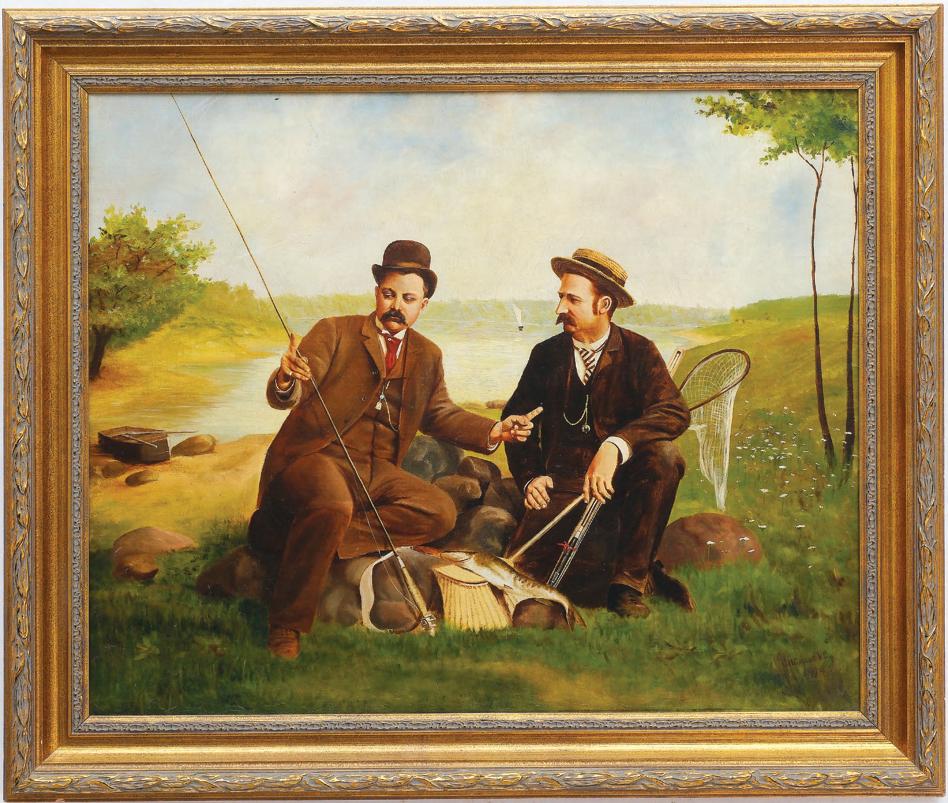
185 C.H. Gallup & Company, oil on canvas. Signed. Fishermen discussing the one that got away. Professionally framed. Featured on the front cover of a Richard Oliver High Rollers sale, February 24, 1989. Image measures 22” x 27”. Cleaned and relined. (5,000 - 8,000)

186
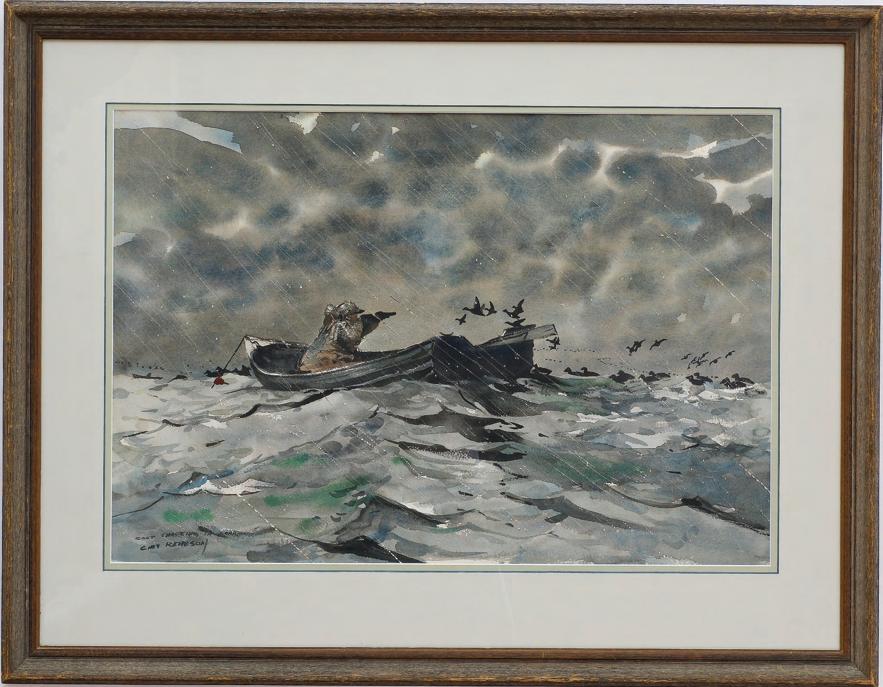
187

Professionally framed and matted. Image measures 18” x 28”. Remains very good and original.
and original.
Provenance: Randy Rall collection. (2,000 - 3,000)
Provenance: Randy Rall collection. (2,000 - 3,000)

In 1848, William Machen’s family immigrated from Germany and settled in Toledo, OH. He was a naturalist by inclination and studied extensively in that area. In his lifetime, William Machen completed more than 2700 oil paintings, watercolors, drawings, and sketches. He maintained a single register of his works
which is now preserved in the Archives of American Art at the Smithsonian Institution in Washington. He exhibited his work at the Pennsylvania Academy, the 1876 Centennial Exposition in Philadelphia, and the Detroit Museum of Art.
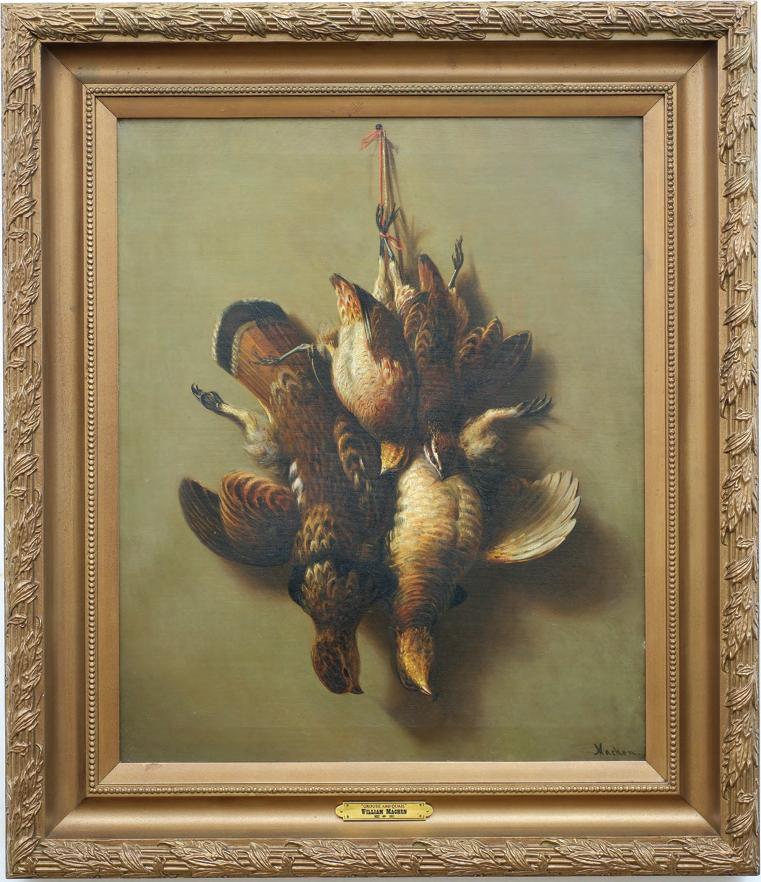
Provenance: David Fannon collection. (3,000 - 4,000)
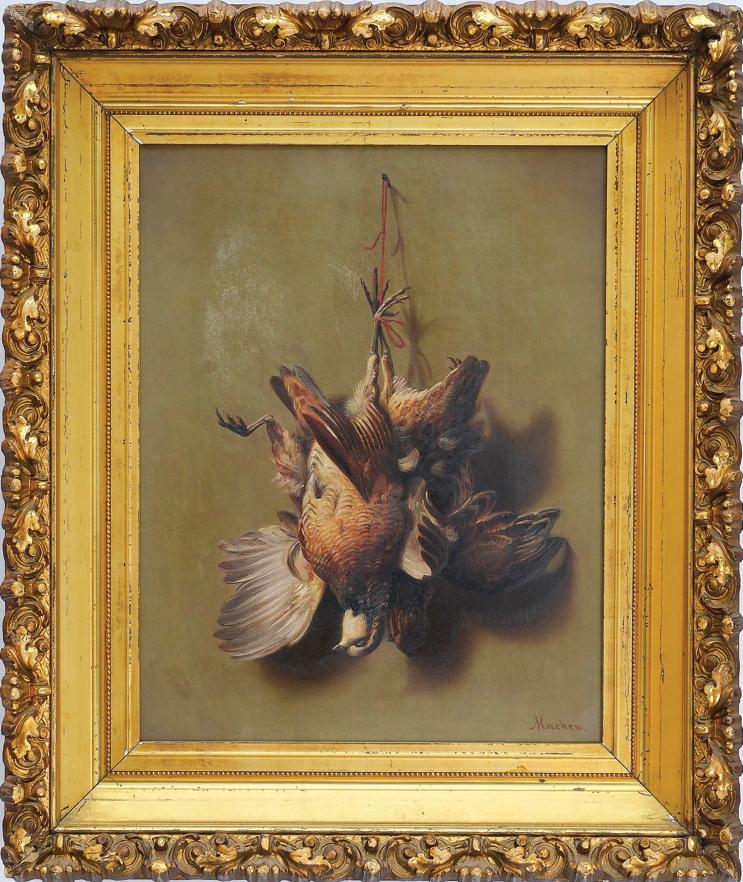
Provenance: David Fannon collection. (2,000 - 3,000)

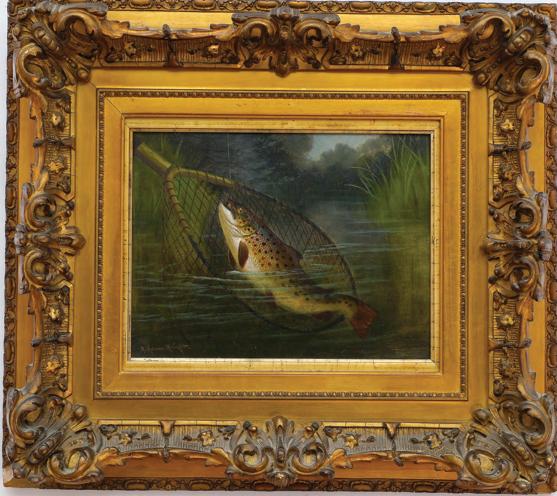
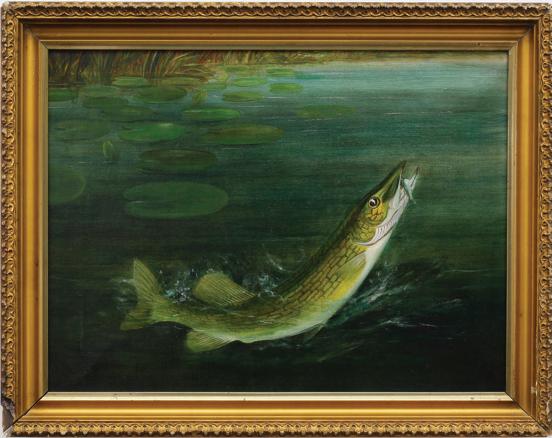
191 Carl Ivar Gilbert (1882-1959), oil on canvas. Signed lower right. Fly fisherman in canoe with name plaque mounted to lower part of frame. Gallery sticker on back from Grande Central Art Galleries Inc., New York, New York. Image measures 24.5” x 30.5”. Under UV light an expected amount of light crazing, otherwise very good and original. (1,500 - 2,000)
192 Roland Knight (1879-1921, British), oil on board. Brown trout in landing net. Signed lower left. Image measures 9” x 11.5”. Professionally framed in very ornate high style frame 19” x 21”. As viewed under black light image remains excellent and original. (800 - 1,200)
193 Harry Driscole (1861-1924), oil on canvas. Signed lower left. Depicting jumping northern pike. Image measures 14.5” x 19.5”. As viewed under black light image remains excellent and original. (1,250 - 1,750)
x 45”. Signed. Double framed with a fly box mounted below the painting. Total measurement is 39” x 59”. As viewed under black light painting remains excellent and original. (4,000 - 6,000)
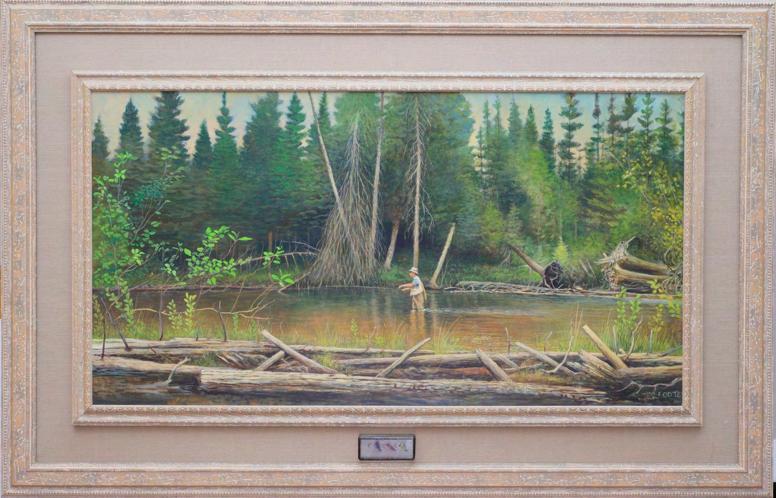
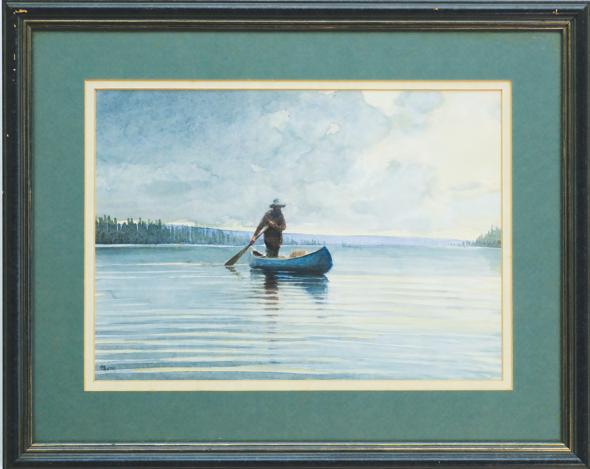

197
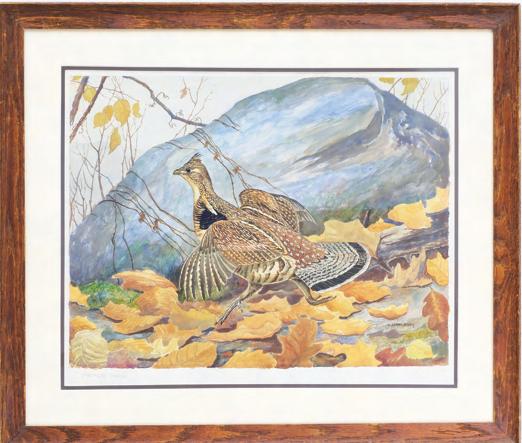

199
198


200
200 Roland Clark (1874-1957), watercolor. Canvasbacks dropping in against sunset. Signed lower left. Professionally framed and matted. Image size 13” x 9.5. Excellent. (1,000 - 1,500)




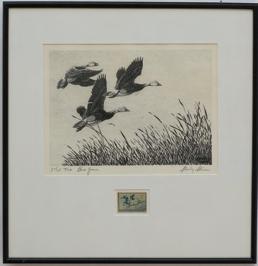
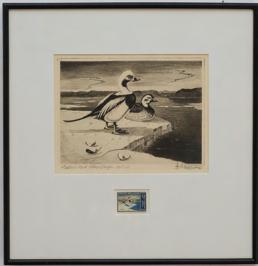
201 Tara Moore (b.1950), oil on canvas. Family of swans. Signed lower right. Image measures 17.5” x 23.5”. Professionally framed, measures 26” x 32”. As viewed under black light image appears excellent and original.
(500 - 1,000)
202 Maynard Reece (1920-2020), etching and stamp. “King Buck” duck stamp print and stamp. Titled “Labrador Retriever” and dated 1959. This is the only winning stamp design in the programs history depicting a dog and the only waterfowl stamp depicting dead waterfowl. Plate measures 6.5” x 9”. Slight waving at top of sheet; minor toning and mat burn.
(1,000 - 1,400)
203 Group of framed Federal duck stamp prints. A group of four Federal duck stamps by various artists, including: Maynard Reese for the 1949 stamp, etching is signed and dated by the artist. Aiden Lassell Ripley, 1943, signed and dated etching. 1951 signed and dated etching by Maynard Reese. 1955 signed and dated etching by Harvey Sandstrom. All show a little bit of darkening with age but are in good condition.
(800 - 1,200)
204 Group of framed Federal duck stamp prints. Four prints by various artists. One with a signed numbered print by Stanley Sterns 1955. Second Les Kouba, signed and dated 1968. Pintails by Edward Morris, 1963. Canvasbacks by Ron Jenkins 1965. All are professionally framed, matted, and in good condition.


(800 - 1,200)
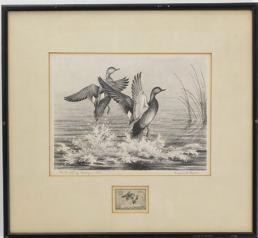


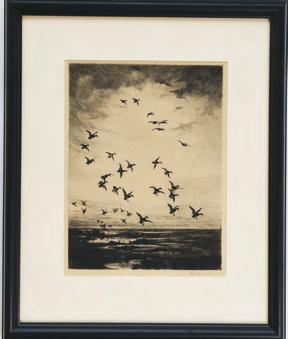

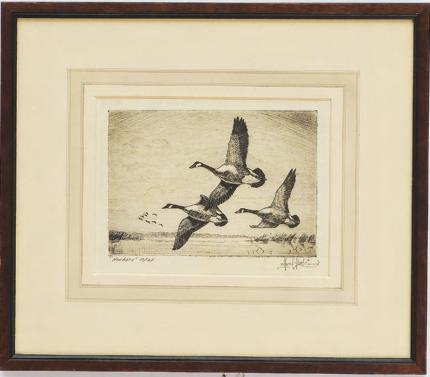
205 Frank Benson (1862-1951), drypoint etching. ‘Duck Blind’ etching, 1925. Paff 245, an edition 150. Image measures 7.75” x 10.75”. Signed lower left. Professionally framed and matted. Very good and orignal. (600 - 800)
206 Roland Clark (1874-1957), two etchings. Two professionally framed etchings. Each image measures 11.75” x 8.75”. Both are signed lower right. Both are images of puddle ducks landing in marsh. Very good and original. (400 - 600)
207 Les Kouba (1917-1998), drypoint etching. Titled “Honkers”. Signed. Image measures 5.25” x 7.5”. Professionally framed and matted. (200 - 300)
208 Walter E. Bohl (1907-1990), drypoint etching. Of a setter’s head. Titled “Our Freckles”. 24/75. Image measures 9.5” x 8.25”. Signed. Professional framed and matted. Some very small spots of discoloration around margin. (200 400)
209 Roland Clark(1874-1957), drypoint etching. Widgeon. Signed. Image measures 9.5” x 7.5”. Professionally framed and matted. (200 - 300)
208
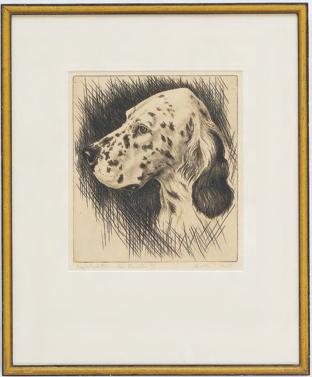
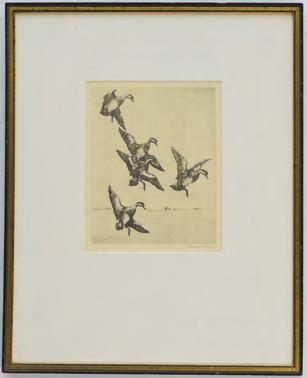
209
Born in Pointe Coupee Parish, Louisiana, Rosseau’s father was killed in the Civil War and his mother died shortly thereafter. The family farm was destroyed by the Union Army and Percival and his sister were rescued by a slave then raised by a family friend in Kentucky. He tried his hand at being a cowboy, cattle driver, and timberman, ultimately owning a brokerage business in New Orleans. This venture prospered allowing him to travel to France to study art and paint the human figure. In 1903 he execu ted a portrait featuring two wolfhounds, which met with much critical acclaim. This, and similar paintings soon to follow, catapulted him into the spotlight and launched him on a career as a sporting and animal artist. He was a member of the Pennsylvania Academy of the Fine Arts, the Lotos Club in New York City, and the Lyme Art Association. His work hangs in many of the most prestigious museums and galleries throughout the country.

211 An early and well made copper caribou head. Hollow construction is pieced and soldered. Surface is verdigried showing excellent age, likely 1900 or earlier. Structurally good with some holes around the end of the neck that over the years have secured it to various boards. Height is approximately 44”, 34” wide. Good and original.
Provenance: Al Marzorini collection. (5,000 - 8,000)


212 Cow weathervane, circa 1900. Full body copper with zinc ears and horns. Extra wide body. Bar measures 31”, stands 21” tall. Surface has been painted white, probably around 1940. Several dents and bullet holes.
Provenance: Michael Whittimore collection. Al Marzorini collection. (5,000 - 8,000)

213

Rooster weathervane, Rochester
Iron Works. Two piece cast iron body. Approximately 23” tall. Some toes missing from one foot; surface is rusted but appears natural; structurally good.
Provenance: Al Marzorini collection. (3,000 - 4,000)

215 An early, large and impressive, carved wooden fighting cock. Stands 27.5” tall. Chip carved base with feather detail carving. Retains leather guards on feet. Metal post is driven through base and into roosters body for stability and done at time of making. Surface is old and crazed and original.
Provenance: George Quay collection. (4,000 - 6,000)

215
213
Danz Company ad published circa 1890.
Once a prevalent species throughout the Midwest, the sandhill crane population began a steady downhill spiral in the 19th and early 20th centuries. Aldo Leopold predicted in his noteworthy 1937 essay, “Marshland Elegy,” that loss of wetlands would ultimately lead to the demise of the species. He lamented that the day was approaching when, “…the last crane will trumpet his farewell and spiral skyward….”
Habitat loss or destruction was certainly a factor in the decline in numbers of the birds, but, ultimately, it was the unrestricted hunting of the cranes that had the most dire consequences. They were eagerly sought by the market hunters of the period due to their culinary reputation as the “ribeye of the sky.” In addition, they were despised by the farmers for their appetite for the small grain crops which were expanding across the Midwest.
Hunting was relentless, and the greater sandhill crane disappeared as a breeding bird from Illinois in 1890, Iowa in 1905, South Dakota in 1910, Ohio in 1926, and Indiana in 1929, and it was nearly extirpated throughout the rest of the upper Midwest until, that is, the protection conferred by the Migratory Bird Treaty of 1916 and the Migratory Bird Treaty Act of 1918 (which implemented the 1916 treaty with Canada). These acts ended the uncontrolled killing and allowed cranes and other migratory birds to begin a recovery. This was to

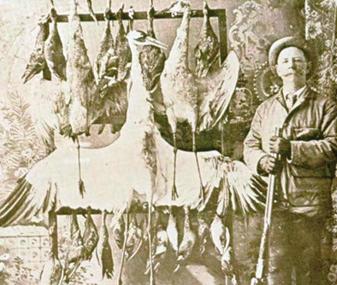
be a slow process due to the fact that the cranes do not reach sexual maturity until about four years of age; breeding pairs raise, at most, one or two young per year, and relatively few pairs succeed in raising young at all. Fortunately, the cranes do live a long time and their survival strategy which emphasizes longevity over reproduction has proven to be their salvation.
Fortunately, unlike the passenger pigeon, due to timely foresight and appropriate conservation practices, the sandhill crane population, like the wood duck and other species, have made a remarkable rebound. Today, the “North American Waterbird Conservation Plan” lists the birds as a species of low concern. Currently, under strict guidelines, sandhills can, once again, be legally hunted in numerous states along the central flyway.
The Jocob Danz Co. of St. Paul Minnesota (c. 1881 –1915) was one of the extremely few, if not the only, commercial makers of decoys for sandhill cranes. Their production of these items must have been remarkably limited.
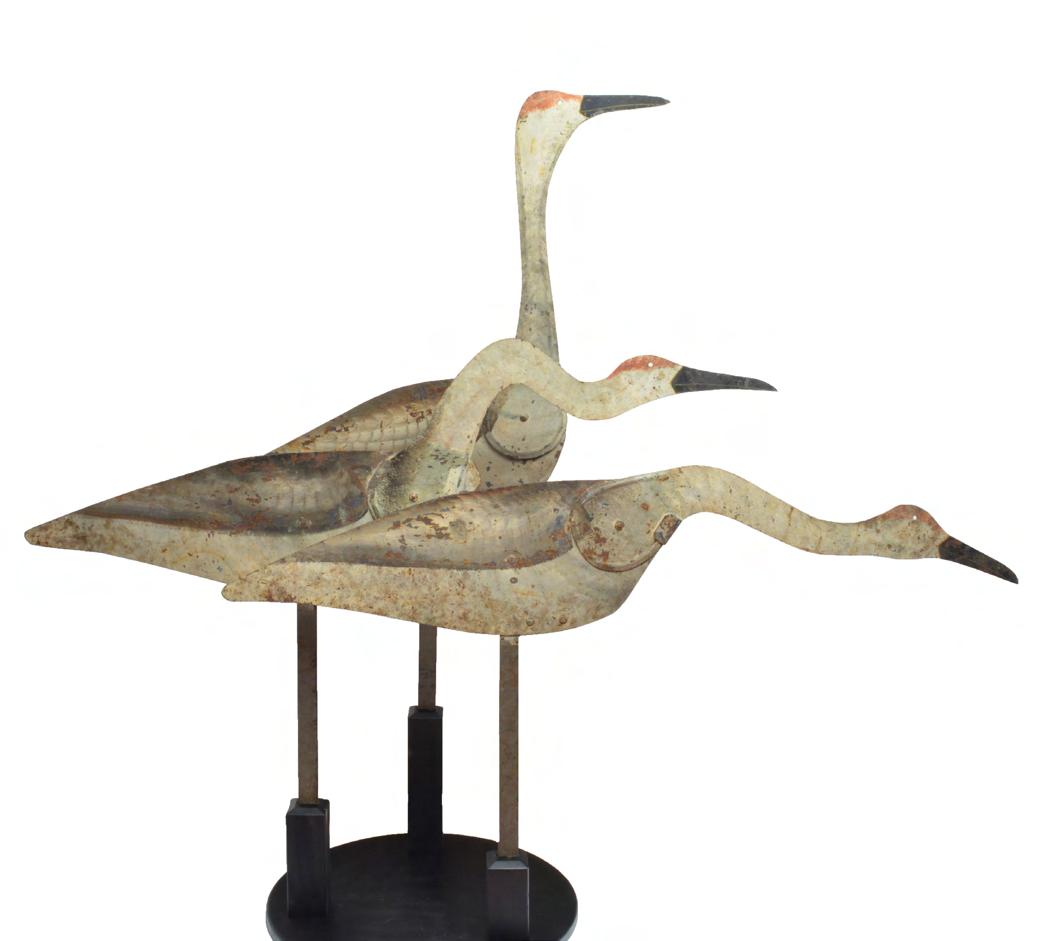
215a Danz Manufacturing Company, St. Paul, Minnesota. Three very rare and important sandhill crane decoys. Found at a small auction in Minnesota. It was known that the Danz company offered crane decoys, but until this date none have been found. Each of these three has a different head position. All three have metal stakes and fold up to a smaller profile. Original paint with some flaking and stains; display base was made by Russ Allen, and is included.
Provenance: Al Marzorini collection. (7,000 - 9,000)
215b
Rigmate to the group of three in this sale. Stands approximately 48” tall. Comes with modern base. Original paint that has flaked showing missing paint and rust.
Provenance: Al Marzorini collection. (1,500 - 2,000)

216 Shop of Thomas Brooks (1828-1895), New York, New York. Cigar store Indian tobacconist trade sign, circa 1870. A large and imposing figure of a princess holding a bundle of cigars and a box of opened cigars. Large and deeply relief carved bow at the waist is typical of Brooks’ carvings. Stands 79“ tall including base. In “as found” condition; multiple coats of old paint with chips missing; some older repairs to top of headdress; cracks at left ankle and one side of skirt; some losses to wood base.
Provenance: Mark Goldman collection.
(20,000 - 30,000)
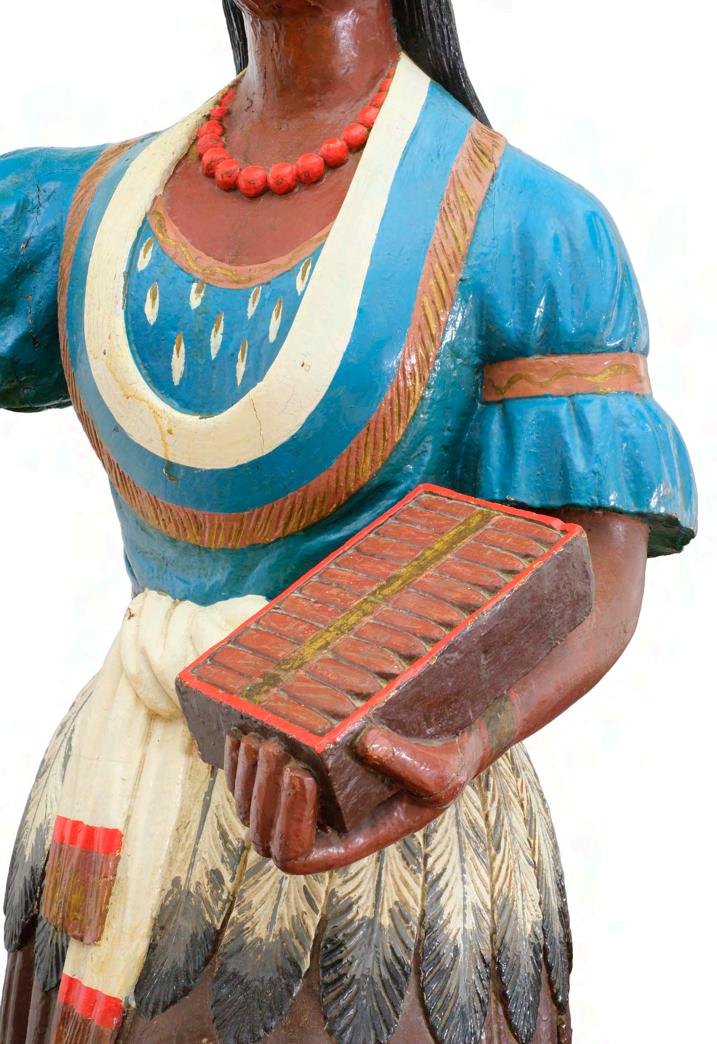

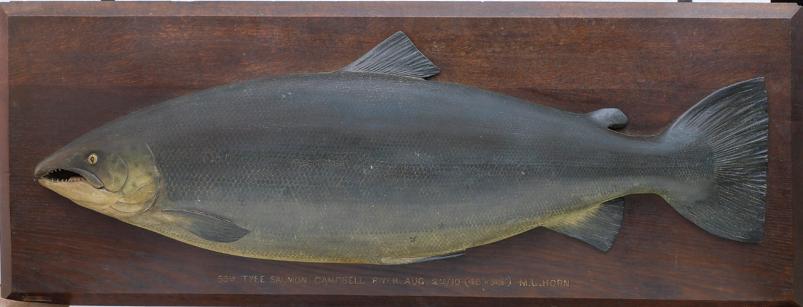
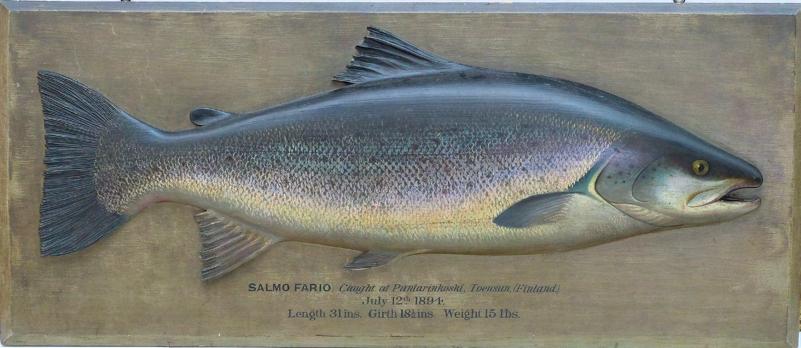

218 Hardy Company Fish Plaque. Extremely rare and possibly the largest known by this important maker. Weighing in at 53 lbs “Tyee salmon Campbell River, 1910 48” x 31.5”. Caught M. L. Horn.” The bone plaque is missing from the lower left hand side. Incredible detail with carved and painted teeth. Superior painting with scale texturing. Board measures 54”. Original paint that has crazed to create an appealing surface.
Provenance: George Quay collection. (8,000 - 12,000)
219 Farlow and Company. Trophy fish, Atlantic salmon. Carved wood with detailed scale painting. Board reads
219
219a
219a Attributed to Phillippe Sirois (1892-1979), Arrowsic, Maine. Lake trout fish plaque. Plaque measures 13” x 35”. Excellent detail in mouth with teeth. Original paint with one replaced fin; restoration to rear fin and small spot of varnish touched up on body. (1,200 - 1,500) 218
“Salmo Fario caught in Finland July 12 1894. Length 31” girth 18.5” weight 15 lbs”. Retains bold stamp on back reads “C Farlow Fishing Rod manufactures 191 Strand London”. Board measures 15” x 35.5”. Strong original paint; structurally good. (4,000 - 6,000)

220 Lawrence Irvine (1918-1998), Winthrop, Maine. Jumping lake trout mounted on board. With open mouth, painted eye, wooden fins. Fish measures 33”. board is 16” x 39” Excellent original paint; good strucutrally.
Provenance: David Fannon collection.
(1,500 - 2,000)
221 Leander Allen Plummer II (1857-1914), New Bedford, Massachusetts. Relief carved plaque of a leaping trout. Relief gill carving and applied fins. Unsigned. Plaque measures 11.5” x 6.75”. Varnish layer has darkened with age; minor wear at edges; all three fins are professional replacement.
(3,000 - 5,000)

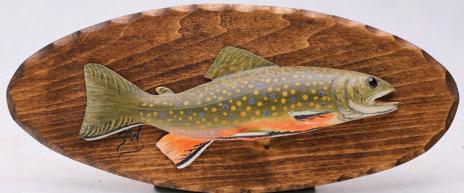
221b
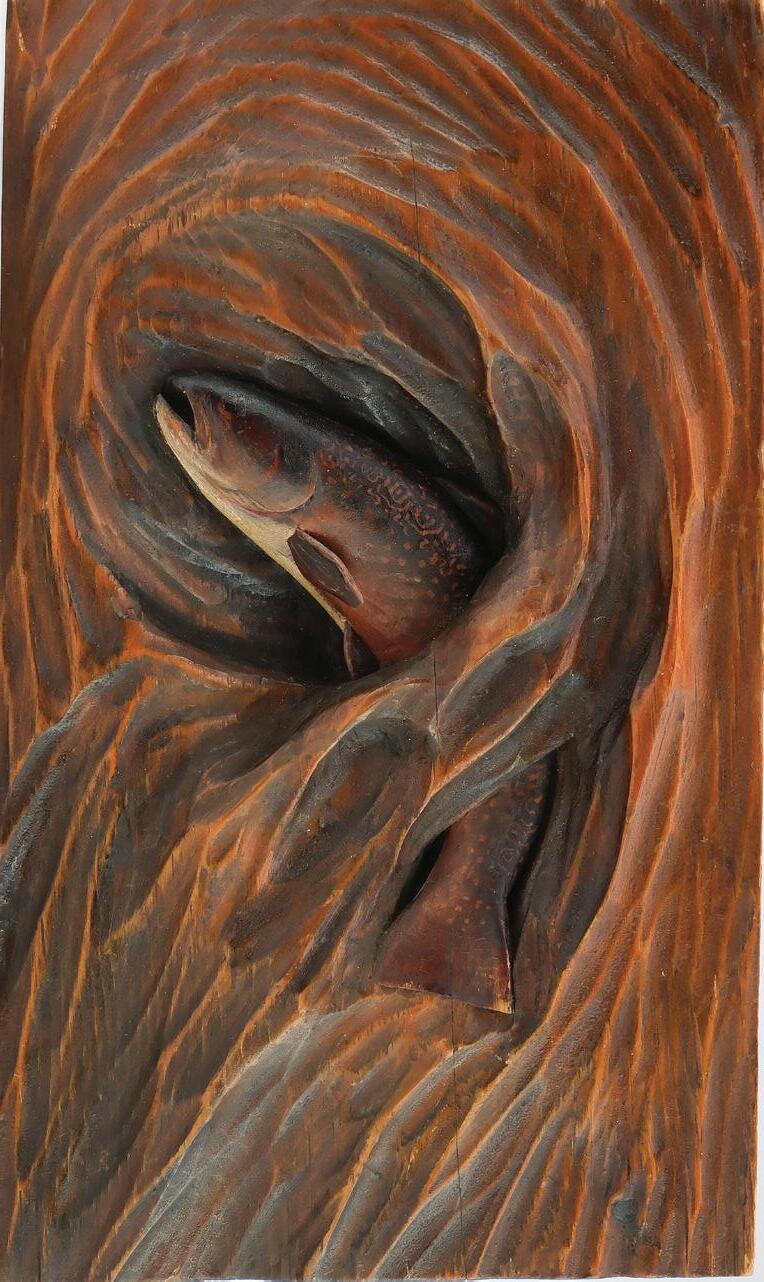

221a Steve Weaver (b.1950), Cape Cod, Massachusetts. Miniature Pimlico Pond perch. With relief gill and feather carving. Identified and signed on the back of fish. Maker’s initials on backboard. Fish measures 5.25” long, plaque 7”. Miniature Santuit River brook trout. With open mouth and relief gill and fin carving. Identified and signed on back of fish. Maker’s initials in wooden backboard. Trout measures 5.75” long, plaque 8.25” long. Excellent and original. (3,000 - 4,000)
221b A.J. Dando (1885-1956), Philadelphia, Pennsylvania. Two excellent miniature bass with open mouths and relief gill carving. Appealing paint detail. Metal hangers are inlayed in to the back for hanging on a wall. Measure 5.5” and 6” long. One pectoral fin was tightly reset, otherwise both excellent and original. (800 - 1,200)
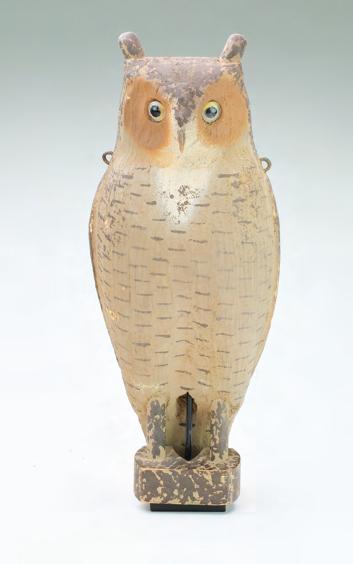

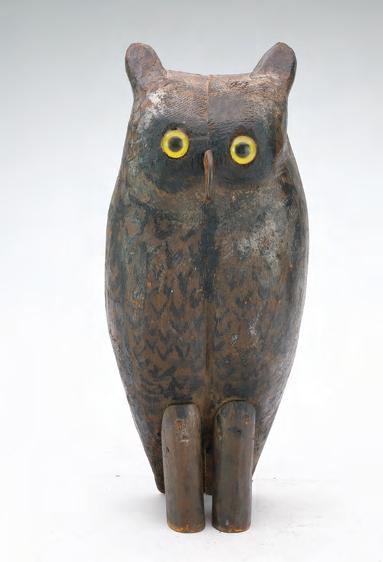
221c Herters Decoy Factory, Waseca, Minnesota. Great horned owl with large glass eyes and bear claw bill. Relief wing carving and raised wingtips. Measures 20” long. Original paint with very minor wear; small dents and minor roughness along raised edges of wings.
(1,200 - 1,800)
221d Herters Decoy Factory, Waseca, Minnesota. Balsa body owl with deep relief wing carving and applied bear claw beak. Stands 19” tall. Outstanding near mint, with minor paint rubs at lower tail and typical tiny chipping on upper part of ear tufts.
(3,000 - 4,000)
221e Unknown maker. Working owl decoy. Body is comprised of two parts. Large yellow eyes with bear claw attached at face to emulate owl’s beak. Applied wooden legs. Measures 16.5”. Paint is original; a few drill holes; wood loss at back of ears.
Provenance: Al Marzorini collection. (400 - 600)
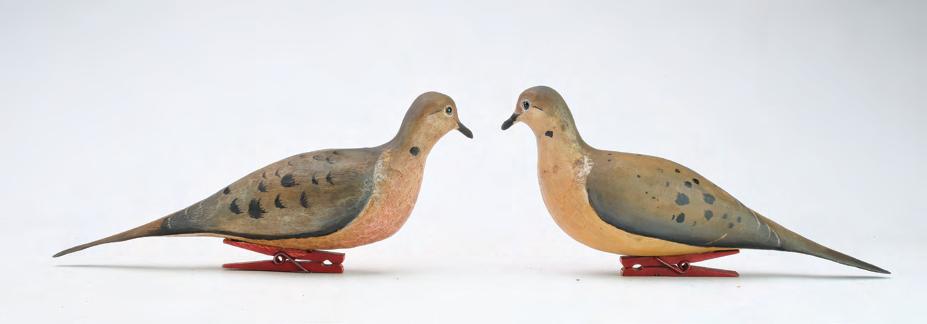
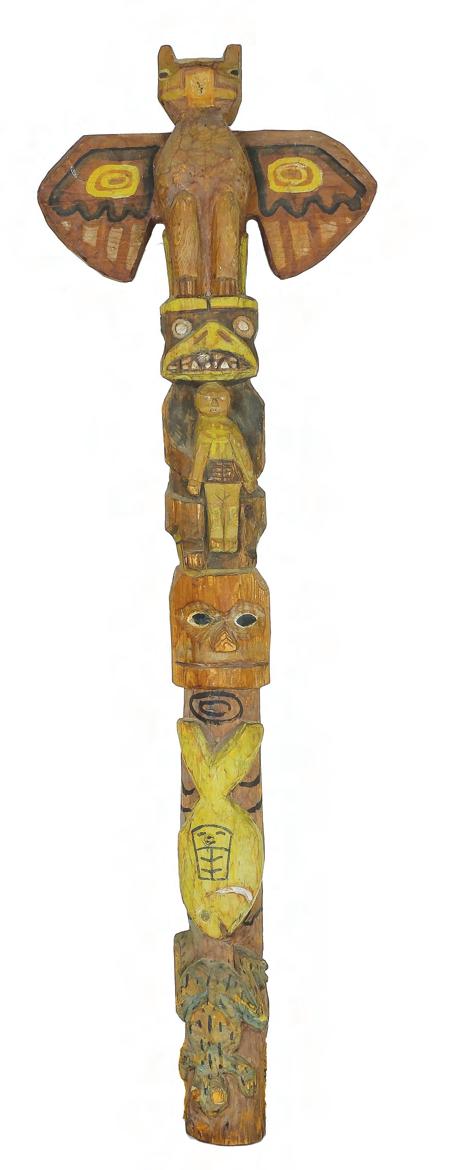
221f Don Vulcani. Pair of mourning dove with relief wing carving and slightly turned heads. Signed and initialed on the underside. Measure 11.5” long. Excellent and original. (400 - 600)
221g Hand carved totem pole. On wings of owl written in ink “Totem pole carved by Eugene Anderson in Canada 1935”. Measures 36.5”. Original paint; most of the high spots have some wear; five figured owl wings are a separate attached board. Beak on owl is missing
Provenance: Mark Goldman collection. (400 - 600)
221f 221g222

222 Seth Wyman Steward (1844-1934), Monson, Maine. Early painted souvenir paddle. With a red canoe on handle and a trout chasing dry fly’s on paddle. Signed on backside of handle “S.W.Steward, 1901 Monson, Maine”. Paddle measures 45” long. Old varnish has crazed with age; minor flaking; small chip on one edge of paddle.
Provenance: John Delph collection. Private southern collection. (1,200 - 1,800)


223
223 Two painted souvenir paddles from Maine, 1st quarter 20th century. Longer paddle attributed to Seth Steward has “Katahdin” on handle. Measure 27” and 38.5” long. Varnish has crazed with age; some flaking, scratches, and dents.
Provenance: John Delph collection. Private southern collection. (800 - 1,200)

224

224 Pair of carved canoe cups. One with relief carved moose and carved cabin handle. The other with relief carved trout with “W Godin” painted on cup. Measure 5.25” and 5.5” long. Both are excellent and original.
(500 - 800)



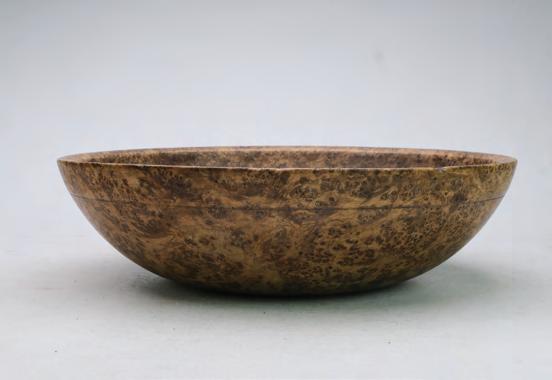

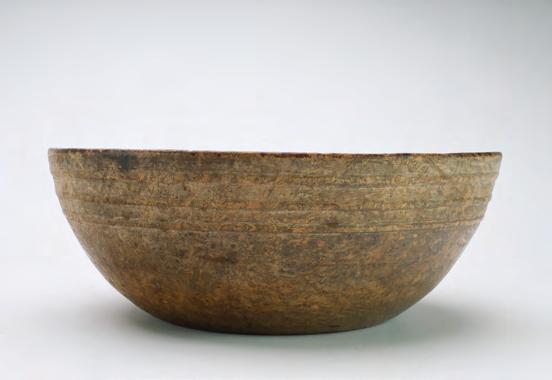
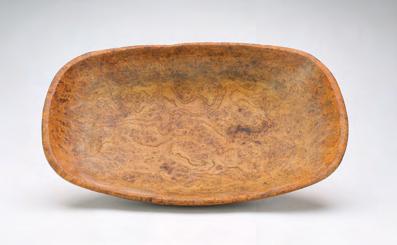
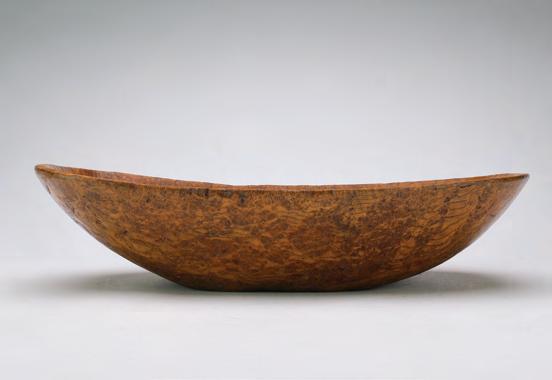
Slightly
Provenance: Randy Rall collection. (2,000 - 3,000)
13.5”.
Provenance: Randy Rall collection. (800 - 1,200)
227 Early burl bowl. With additional turnings around lip. Garth auction tag on underside. Measures 14”. Some splitting at bottom of bowl from dryness but does not go through both sides.
Provenance: Randy Rall collection. (600 - 800)
228 Early rectangle shaped bowl. With Miller & Miller auction tag on underside. Measures 12.5” x 20” Some separation from cracking along the underside but does not go through to the inside of bowl.
Provenance: Randy Rall collection. (1,500 - 2,000)
229
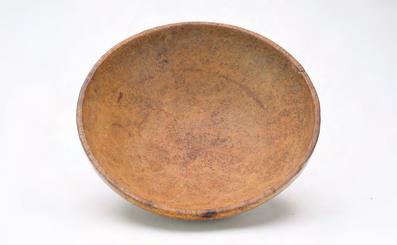
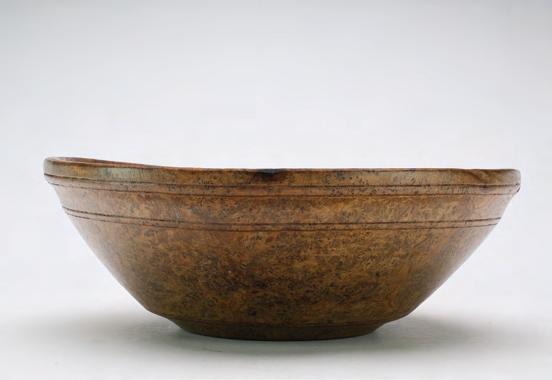
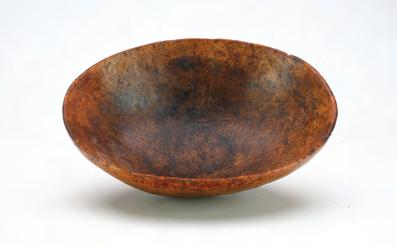
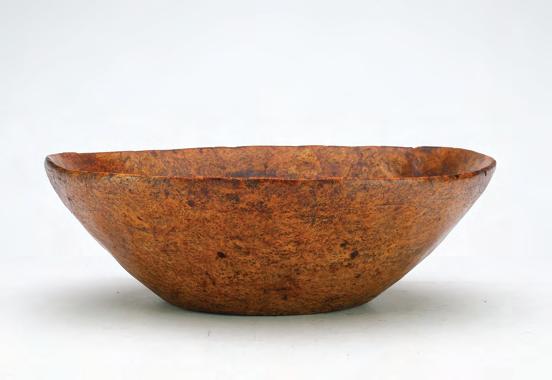
230
Provenance: Randy Rall collection. (800 - 1,200)


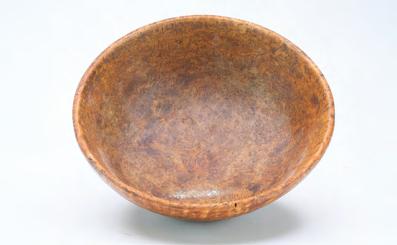
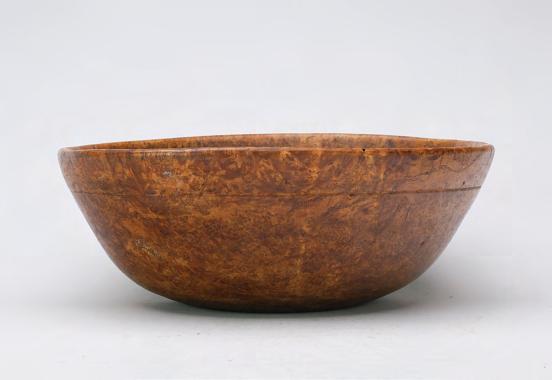
231 Early burl bowl, circa 1900 or earlier. Slightly footed. Measures 12”. Very dry on the inside.
Provenance: Randy Rall collection. (800 - 1,200)
232 Early burl bowl, circa 1900 or earlier. Slighlty footed. Measures 11.5”. No visible damage.
Provenance: Randy Rall collection. (800 - 1,200)
Provenance: Randy Rall collection. (700 - 900)

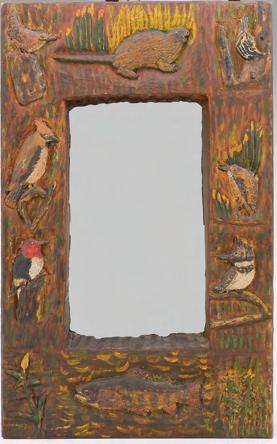

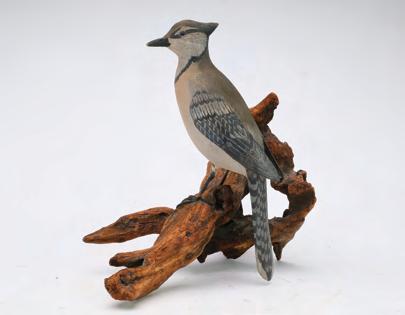

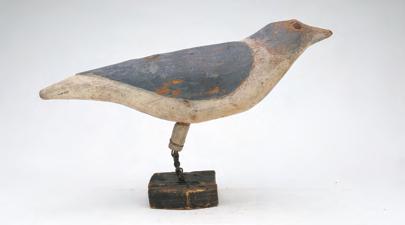
Unknown
New York, circa 1920s. Thick frame mirror with relief carved animals on face and one side. Includes a beaver, trout, kingfisher, woodpecker, house wren, and others. Also a relief carved eel running the length of one side. Inset mirror on back is held in with swiveling wood holds. Measures 24” x 15”. Very good and original with minor roughness at corners. (600 - 900)
235 Charles Waterfield (1881-1973), Knotts Island, North Carolina. Full size carved bluejay mounted on driftwood piece that hangs on wall. Pencil reads “C. Waterfield
and Son, Knotts Island, North Carolina 1975”. Blue jay is approximately 11” long. Slightly turned head. Extended wingtips and dropped tail. One wingtip has been reset; tip of beak missing paint and very tiny chip missing from crest at back of head; tight crack near neck. (800 - 1,200)
236 Albert Zahn (1864-1953), Baileys Harbor, Wisconsin. Full size decorative flicker with relief wing carving and metal legs. Measures 12” long. Original paint under a thick coat of varnish that has darkened slightly; early hole drilled in one side, possibly for an early mounting, otherwise structurally excellent.
Provenance: Al Marzorini collection. (1,500 - 2,500)
236a Albert Zahn (1864-1953), Baileys Harbor, Wisconsin. Famous folk artist from Door County, Wisconsin. Tack eyes with wood and woven wire legs. Carved wing relief with thick original paint. 18” long. Thick original paint shows age and some wear from being outside.
Provenance: Al Marzorini collection. (1,000 - 1,500)
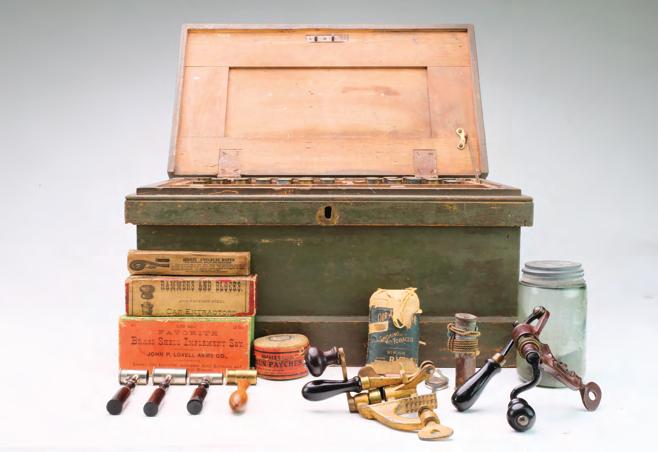
237

238

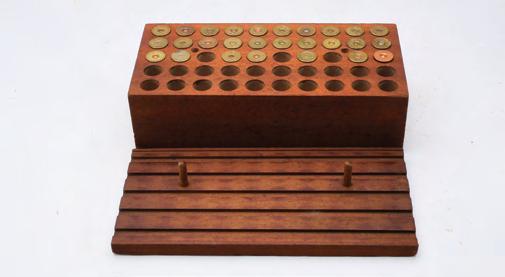
237 A fancy and elaborate gunning box. In original green paint. Numerous contents inside, including 52 brass shells from various companies, mostly Winchester. Primer boxes, measuring tools, cleaning patches, cap extractors in original boxes. Boxes of wads from various companies, and a mason jar full of lead pellets. An excellent display piece for any gun room. Box measures 12” x 20.5” x 11” high. (1,500 - 2,500)
239
238 Vintage gunning box. With a mix of paper and brass shells, some of which are full. A copy of the 1939 New Jersey Game Law. 1955 and 1952 New Jersey resident hunting tags. Gun powder tin, measuring tools, a 1929 and 1928 New Jersey license pin back. Measures 9.5” x 18” x 4”.
(800 - 1,000)
Three vintage boxes. A green fishing box with handle missing, that measures 6.25” x 14.25” x 6.75” high. A shell holder built for 50 12 gauge shells, and about 25 shells are filled. And a green painted gunning box with some powder bags and three shot dispensers, plus 2 empty four gauge paper shells. Gunning box measures 7” x 13” x 9”. In original green paint showing good age.
(400 - 600)

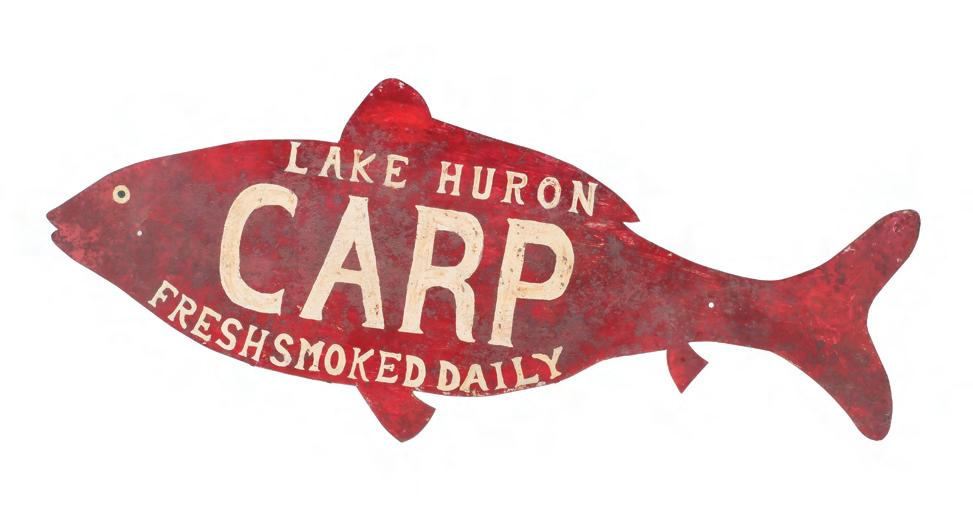
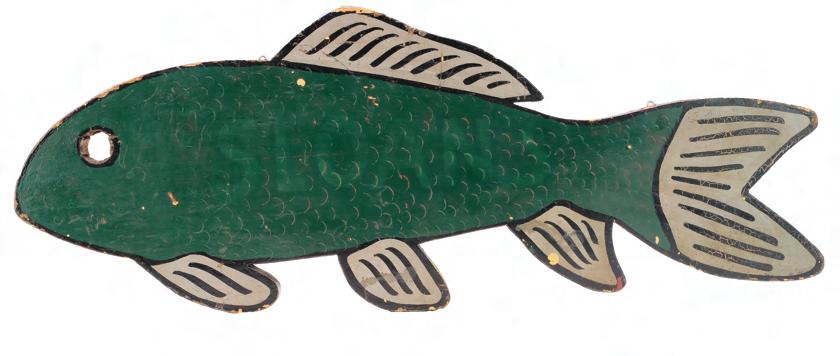
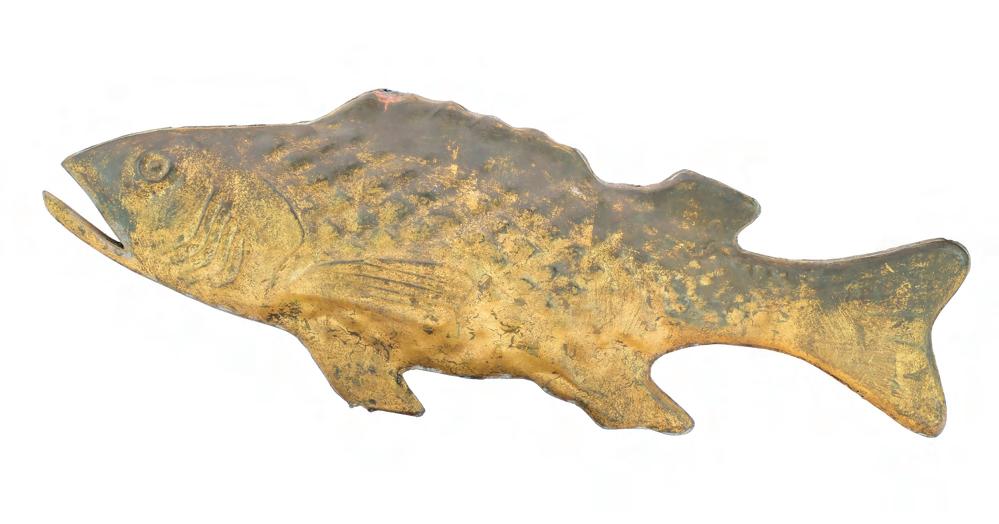
Provenance: Al Marzorini
(700 - 1,000)



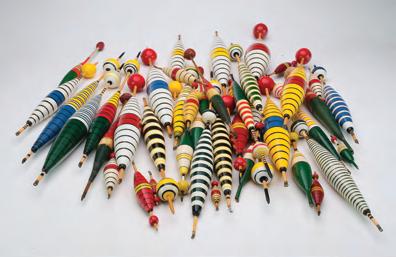



243 Musky fishing spear, made by Hans Janner, Mt. Clemens, Michigan, circa 1930. A telescoping mechanism to extend the length of the spear. Heavy lead in front to secure spear tine, of which there are nine. Length of tines is 11”.
Provenance: Obtained by Roberta Holcomb from Hank Hennings, a friend of Hans Janner. Al Marzorini collection.
(3,000 - 4,000)
244 A large and heavy sturgeon fish spear. With heavy lead wrapped at base and stamped “20 lbs”. Appears to have been made in the 2nd half 20th century. Measures 69”.
Provenance: David Fannon collection.
(250 - 350)
245 Fish spear. Forged five tine spear, with the name “M. Morhardt” stamped twice on the side of the blade. Spears made with maker’s names are very rare. Spear is weighted with an early piece of wood that has nice surface. Total length is 57”.
(600 - 800)
245a Extra long fishing spear. With 12’ long oak handle that is fitted with high quality brass threaded coupling. Possibly a salmon gaff for fishing around a tall bank. Spear appears to be circa 1900 or earlier.
Provenance: David Fannon collection. (800 - 1,200)
246 A collection of 42 fishing floats Longest of floats measures 22”. Many by the Ideal Bobber Company. All in very good to excellent condition.

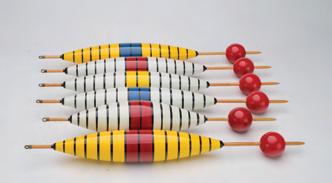
Provenance: David Fannon collection. (5,000 - 8,000)
246



247 Lloyd Cargile (b.1938), Baltimore, Maryland. Excellent carved walking stick with water detail carved along the shaft of the stick, with relief carved oysters at bottom and six relief carved fish. A lighthouse and the maker’s initials “LC” at top of shaft. A perched frog as handle. Relief carved panel on one side titled “Chesapeake Bay”. Measures 40.5” long. Minor rubbing to paint, otherwise excellent. (2,000 - 3,000)
248 Lloyd Cargile (b.1938), Baltimore, Maryland. Carved walking stick bust of a male native American for handle. Flowing bannerettes with the names of different tribes on shaft. Measures 35.5” long. Excellent and original. (2,000 - 3,000)
249 J.P. Kohlbach Folk art carved walking stick, dated 1901. Reads “By J.P. Kohlbach” in a banner on the lower side. Covered in a honey comb pattern with decorative objects carved from top to bottom including: horse head, dog with collar, honey bees, butterfly, rabbit, a rattlesnake which would indicate it was made in America, turkey, a rooster, dog, set of vines. Decorative silver cap. Measures 36”. (1,000 - 1,500)


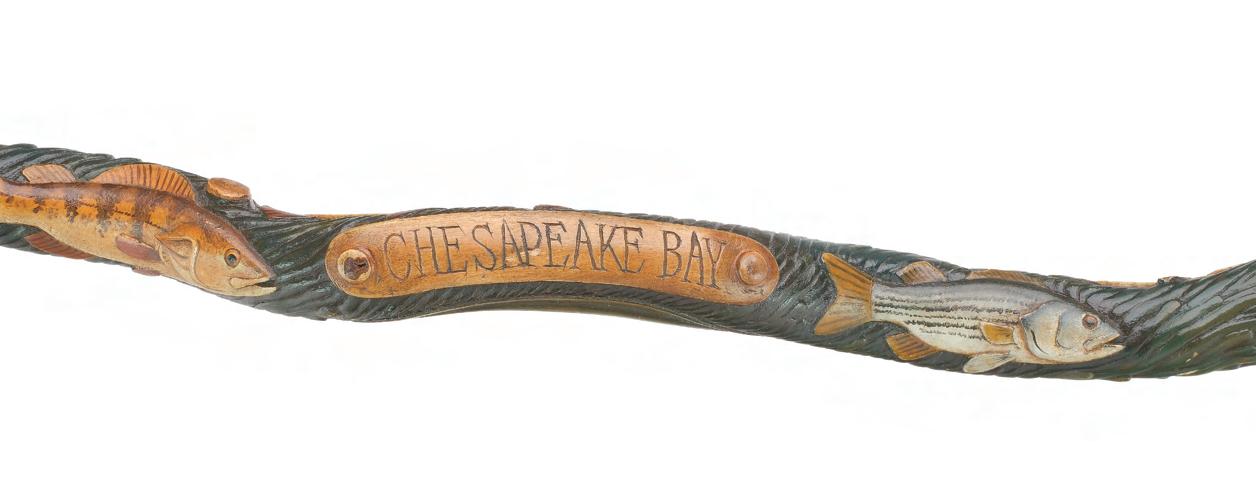
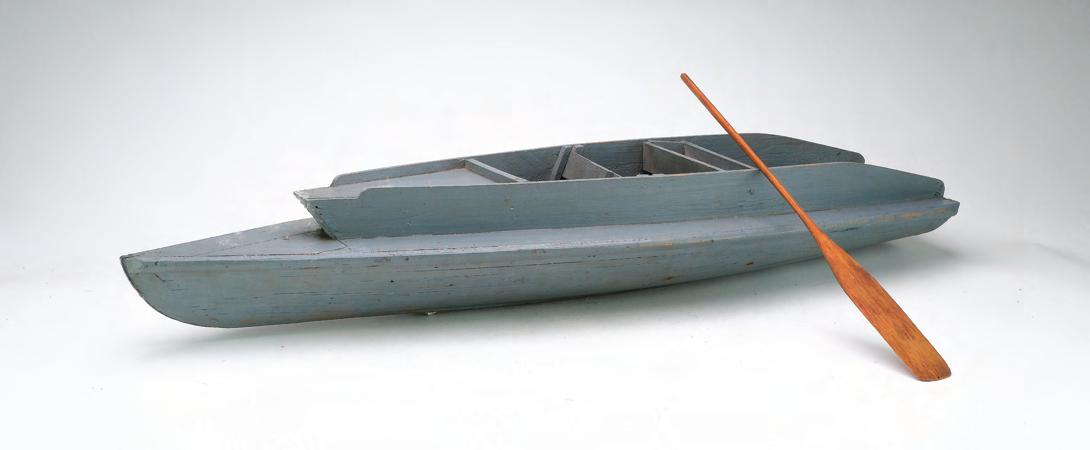

250 Scale model of a sculling boat, probably 2nd quarter 20th century. Original gray paint. Includes a paddle. Measures 43” long. Some areas have missing paint; shrinkage from age at some of the board joists, otherwise good and original. (600 - 900)
251 America’s Uncle Sam. Carved and painted wood figure standing 42” tall. Original paint with removeable top hat; appears to be 50-60 years old; body is made from one piece of wood, has split on both sides; structurally sound. (800 - 1,200)

252 Gerald “GD” Devereaux Kinney, Memphis, Tennessee. Exceptional duck call and rare example from this important maker. Four raised panels with an exaggerated collar at top of barrel. Copper reed. A bone mouth piece with “WSK 21” carved in one side, made by Scott Kinney, GD’s grandson, in 2021. Measures 6.5”. Call remains in good condition with the exception of two cracks and one very small area of missing wood near mouth piece.
(12,000 - 15,000)
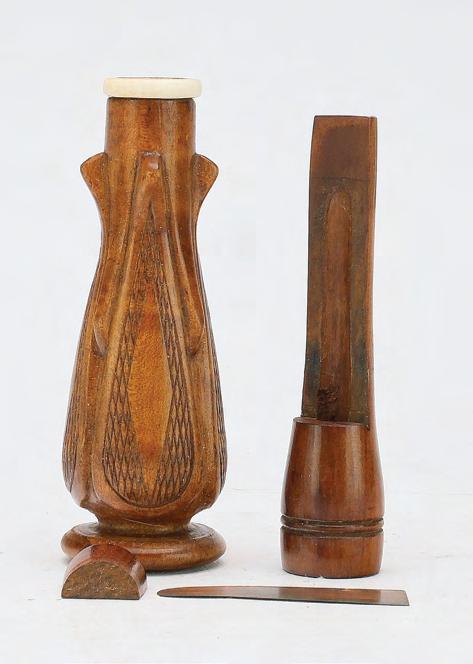
253

253 Kinney and Harlow, Norwalk, Ohio, circa 1900. Rare and desirable duck call. Mallard hen with shot shell in mouth. Made with a reelfoot style insert. Call is wrapped in leather with glass eyes. Less than 20 of these important examples are known. Measures 6”. A slightly crazed surface from varnish that covers the leather; one very small area near mouth piece appears to have a patch or repair.
(8,000 - 12,000)
254 Benjon, Memphis, Tennessee. Duck call. Retains strong water label on barrel. Paper insert reads “Purchased by Tom Currie in early 1950s. He called in limit of ducks for Thomas Currie and buddy Moses in 1952 on Goose Pond close to Swan Lake with this call. Given to Danny 11/8/88.” Measures 5.5”. Shows a few small rubs and one scratch from light wear.
(800 - 1,200)



255 James T. Beckhart, Big Lake Arkansas. Raised checkered four panel duck call with “JT. Beckhart”. Measures 6.25”. All parts appear to be original; structurally good.
(10,000 - 12,000)
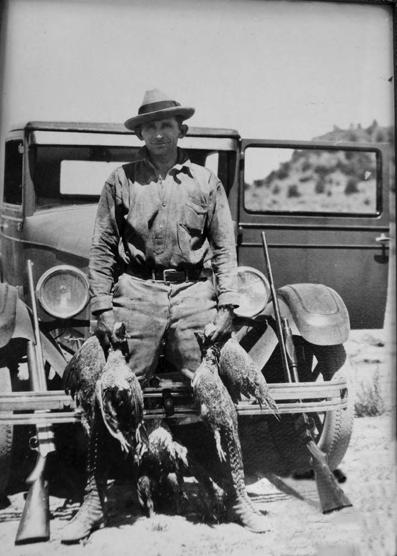
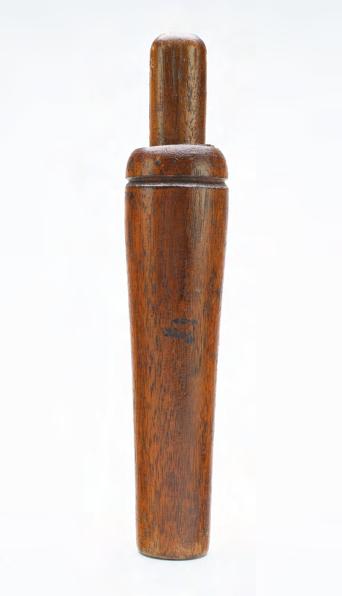
256 Slinn Brothers, Chillicothe, Illinois, last quarter 19th century. Hard rubber barrel duck call with animal decoration. Manufacture stamp below middle ring. Measures 4.5”. Wedge and reed block are probably replaced; structurally good with one very small crack at mouth piece.
(1,500 - 2,000)
257 Danny Golden. Smooth barrel duck call with reelfoot style reed. Measures 6.5”. All parts appear to be original; some varnish wear and imperfections in wood; call has been lightly used. (400 - 600)
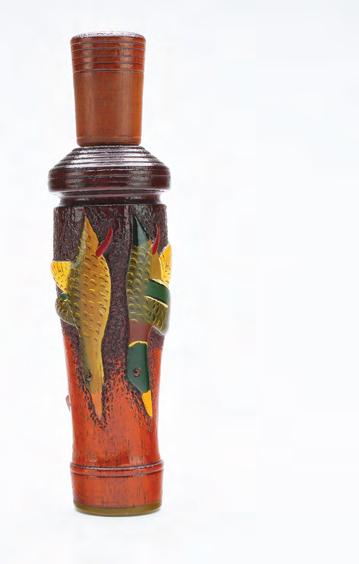
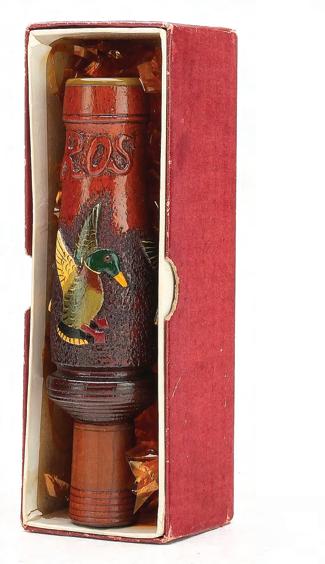


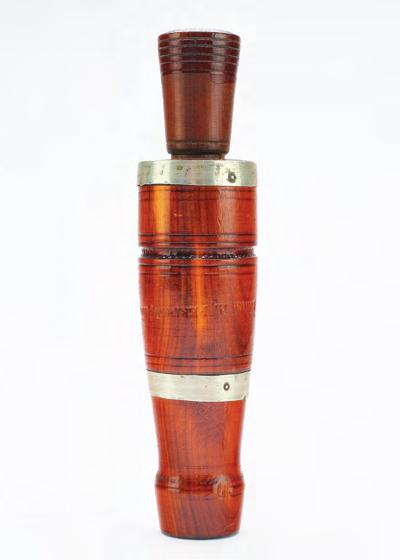


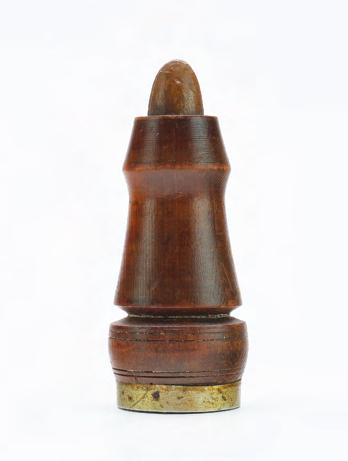

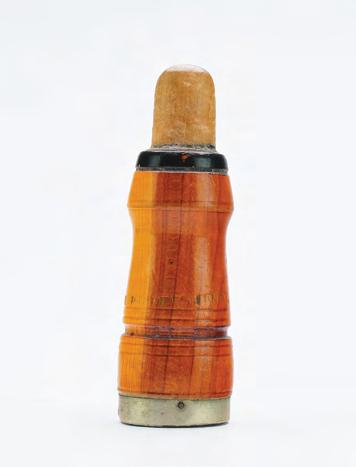

265 Charles Perdew (1874-1963), Henry, Illinois. Small size cedar crow call. Measures 3.5” long. Remains in very good condition. (500 - 800)
266 Charles Perdew (1874-1963), Henry, Illinois. Rare small size crow call appears to be made from walnut. No stamping on barrel. Measures 3.5”. (500 - 800)
264 Charles Perdew (1874-1963), Henry, Illinois. Crow call. An exceptional example beautifully crafted of cedar wood with “Patented November 2 1909” stamped in top of barrel. Measures 5.25”. Exceptional. (400 - 600)
267 Charles Perdew (1874-1963), Henry, Illinois. Crow call, rare early size with “MFG by Chas H Perdew”. No metal bands. Measures 4.25”. In use wear, especially around mouth piece. (400 - 600)
268

269 Frank A
(1918-2002), Sioux Falls, South Dakota. Goose call. Personalized “Jimmy Thynne - The Mallard Toller, a Heidelbauer call” “A hail call for Canada geese, 1978”
Provenance: Consigned by the god-son and family friend of the maker.
(400 - 600)
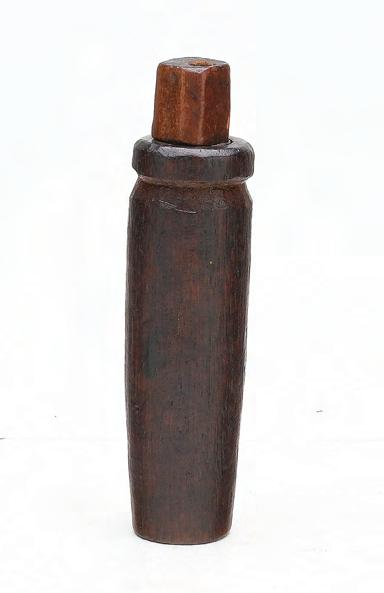
270
269
268 Frank A Heidelbauer (19182002), Sioux Falls, South Dakota. Duck call. Personalized “Jimmy Thynne - The Mallard Toller, 1972 a Heidelbauer call”. Measures 5”. Excellent condition with original laynard.
Provenance: Consigned by the god-son and family friend of the maker. (400 - 600)

270 Unknown maker. Duck call. Appears to be from Illinois. Reelfoot style stopper. Hand carved with a wedge block and reed that are probably replaced. Measures 4.75”. (400 - 600)

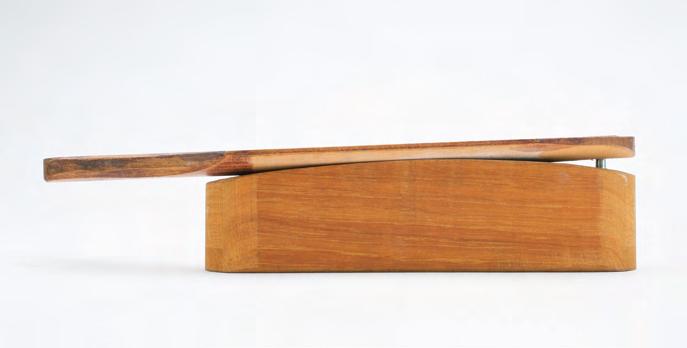


271 Kent Freeman, Kennett, Missouri. A turkey callers complete set included with decorative box. Including an elaborate box call, which is signed on underside. A slate call. Chalk holder. Whole set includes nine pieces plus Ken’s business card. Box measures 13” x 15” x 3.5”. Excellent. (1,500 - 2,000)
272 Tom Turpin, Memphis, Tennessee. Box turkey call. Measures 11”. From the collection of Earl Mickel. (1,500 - 2,000)
273 Tom Turpin, Memphis, Tennessee. Box turkey call. Measures 11.5”. Remains in very good condition. (1,500 - 2,000)
274 A.M. Bowles, Little Rock, Arkanasas. Two turkey box calls. One is stamped by maker twice on underside. Longest measures 9.5” other is 9”. Both are in good condition and show light wear. (800 - 1,200)
275 Eugene Upward, Hazel Green, Wisconsin. Two box turkey calls. Longest measures 14” and is number 63, made in June 2002 and signed by maker. This one is titled “The Long One”. Made from bone, horn, maple, walnut, and cedar. Smallest says number 361/500, second series double call. Has a hand painted scene of a turkey and barn, measures 10”. Both in excellent condition.
(500 - 800)
276 Dan Searcy, Eminence, Missouri. Group of three unused turkey box calls in mint condition. All three with decorative carving on top paddle, and one with side decoration. Each measures approximately 14”. One is signed and dated 1995. Mint. (400 - 600)


277 Lamar Williams.
turkey box calls. Both signed by maker, one on top paddle and one on bottom of box. Longest call was made in 1999. Other was made September 2003. Each is personalized with the type of wood it was made from. Both come with letters of authentication, personalized by Mr. Williams. Excellent. (300 - 500)
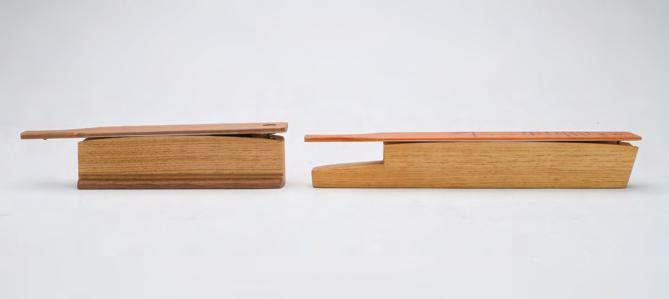
279
turkey box calls. Longest is signed and dated 1995. Measures 12”. Other is personalized to Earl Mickel and made as a limited edition, measures 9.5”. Both come with letter of authenticity. Excellent condition.
(400 - 600)

high style box calls made for Earl Mickel. One is signed and dated 1998, other is also dated 1998 and signed inside box. Beautifully crafted from decorative woods. Longest measures 12”, other 9”. (600 - 800)

“In 1990 I was inspired to make a flying Canada goose weathervane, since the farm where I was living at the time was a major wintering area for many thousands of migratory geese. The weathervane flew proudly on my second story chimney for many years. Having turned down numerous offers to sell it, I decided to design a new and more graceful version in 2009. I liked the new one enough that I made three or four in that style over the next few years. This is one from that group. I tried to capture the wild and restless spirit of those wonderful birds.”
- Cameron McIntyre
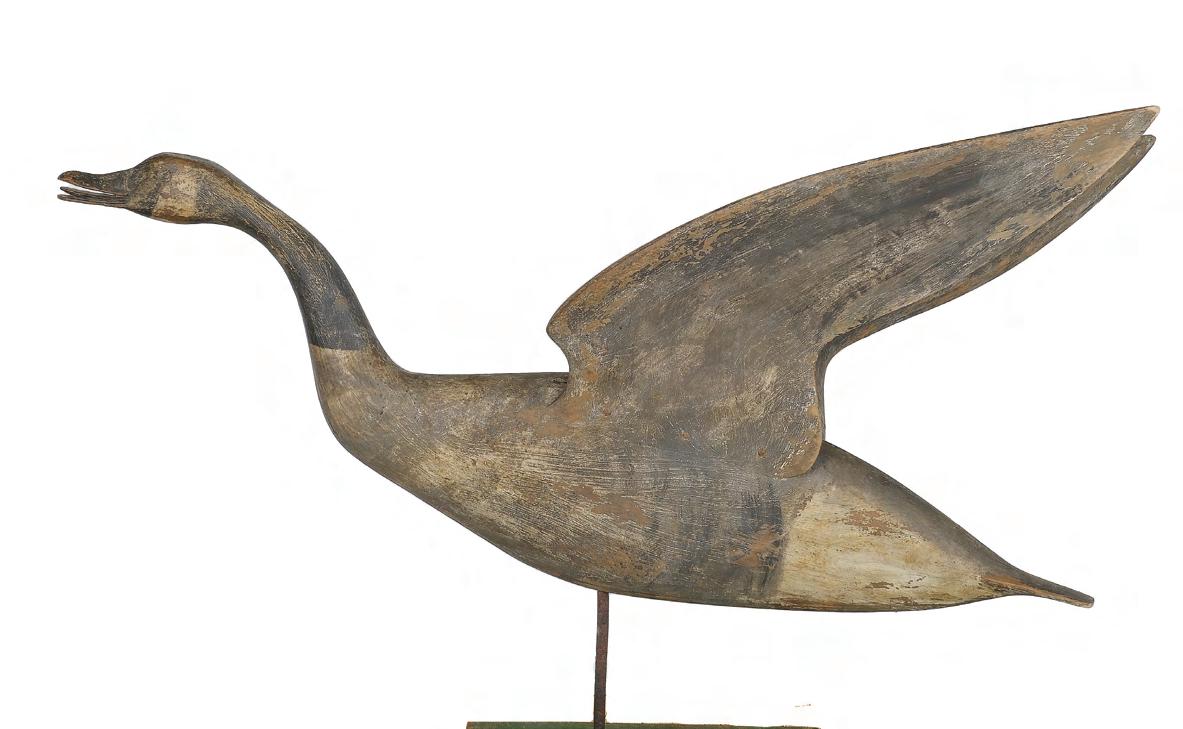
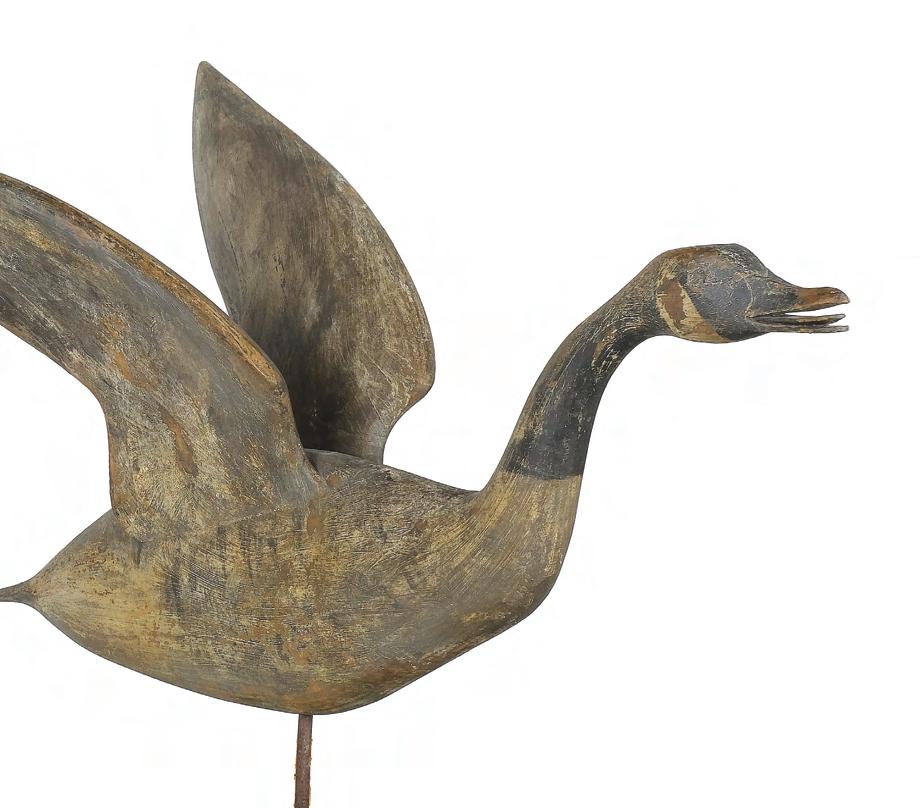
280 Cameron McIntyre (b.1968), New Church, Virginia. Stylish and impressive double lifted wing Canada goose weathervane. Mounted to decorative base. Carved eye and mouth, as if calling. The original paint surface has been stressed to create the appearance of age. 36” long, 23” tall. Excellent and original.
Provenance: James and Lyda Madden collection. (8,000 - 12,000)
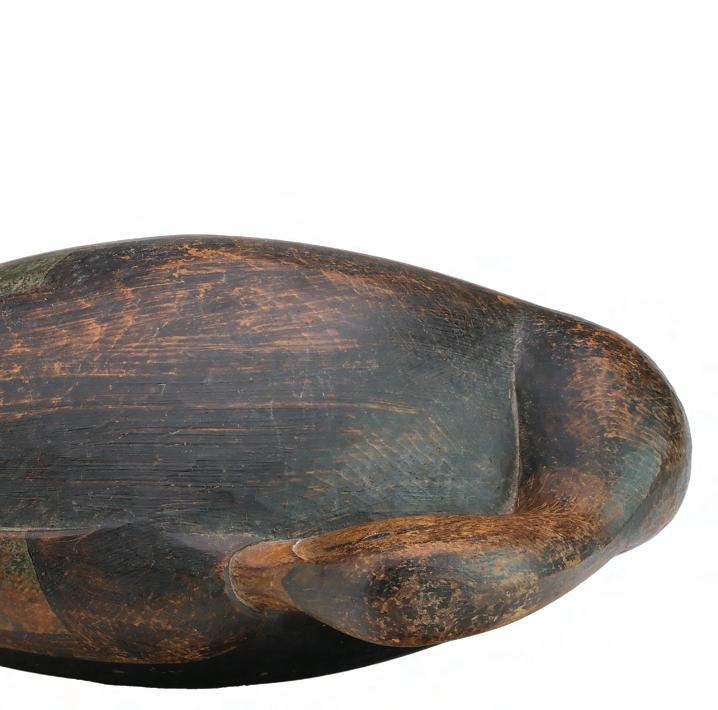
“The sleeping Blackduck was commissioned from a collector in 2010 who had underbid a similar one by an unknown 19th century carver. He asked if I would make a reproduction of the bird. I said I truly admired the original, but would only want to make my own version- loosely inspired by it- but not a true copy. This was my interpretation which the collector enjoyed for many years. The head, neck, and back are carved from a single block of white cedar.”
- Cameron McIntyre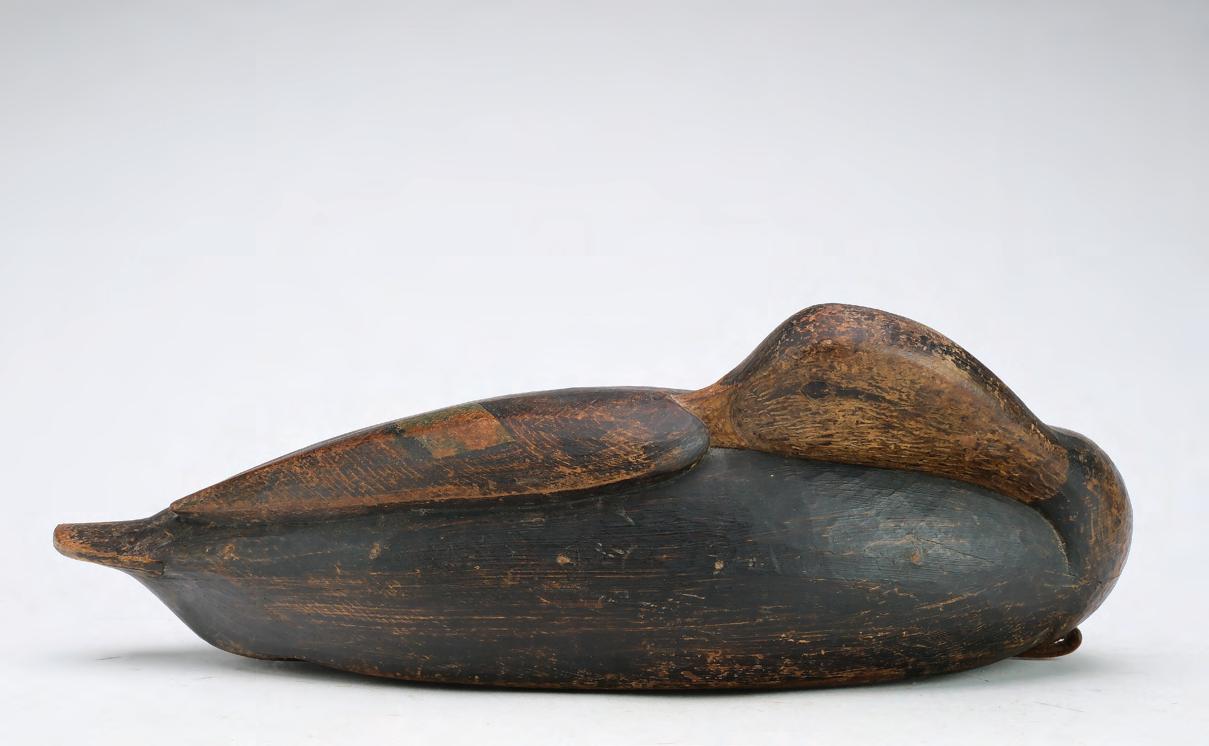
281 Cameron McIntyre (b.1968), New Church, Virginia. Excellent hollow carved sleeping black duck. Head is turned with bill buried under one raised wing. “CTM” carved on the underside. Carved eyes and scratch feather paint on head. Measures 17.5” long. Excellent and original. (2,000 - 3,000)


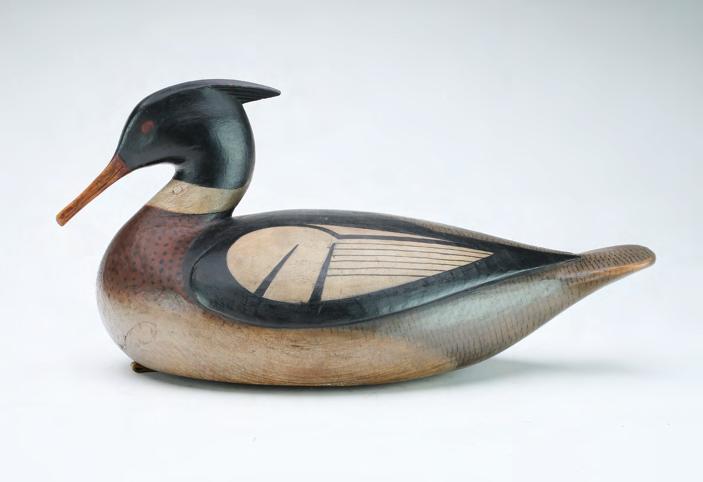
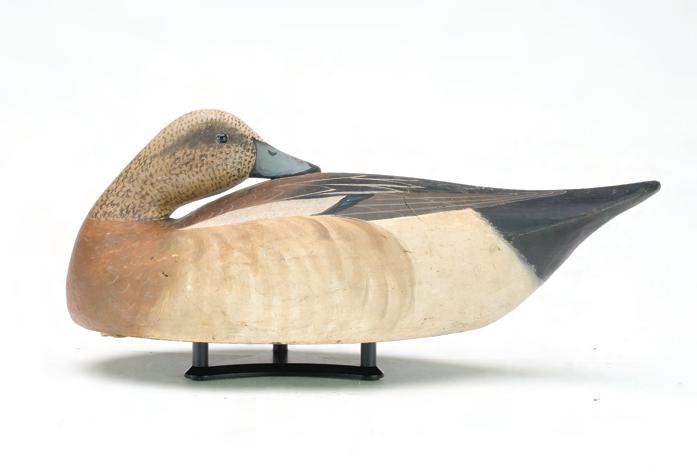
282 Mark McNair (b.1950), Craddockville, Virginia. Hollow carved wood duck with slightly turned head and extended crest. Scratch feather paint detail and raised wingtips. Maker’s name carved in the underside. Measures 12.75” long. Excellent and original. (2,500 - 3,500)
283 Mark McNair (b.1950), Craddockville, Virginia. Red breasted merganser with extended crest and carved eyes. Relief wing carving and hardwood bill. “McNair” carved in the underside. Measures 16.25” long. Hairline drying cracks in body from before the bird was painted; very good and original. (2,000 - 3,000)
283a Mark McNair (b.1950), Craddockville, Virginia. Back preening gunning widgeon drake. “McNair” carved in underside, as well as the Walsh brand for Clune Walsh, Detroit, Michigan, who ordered this early rig from McNair. 14” long. Very light gunning wear; a few rubs; otherwise very good and original.
Provenance: Clune Walsh rig. (2,000 - 2,500)
284 Mark McNair (b.1950), Craddockville, Virginia. Early preening widgeon. Hollow carved with comb feather paint detail on back. “McNair” carved in underside. Measures 12.5” long. Very good and original. (1,500 - 2,500)
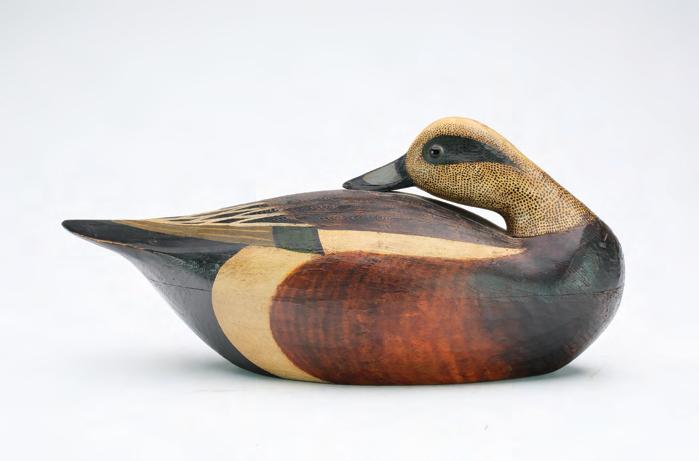
285 Mark McNair (b.1950), Craddockville, Virginia. Early pintail drake in the Delaware River style. Hollow carved with slightly turned head, raised V wingtips, and inserted hardwood tail. “MSM” carved on the underside. Measures 19” long. Very good and original. (1,500 - 2,500)
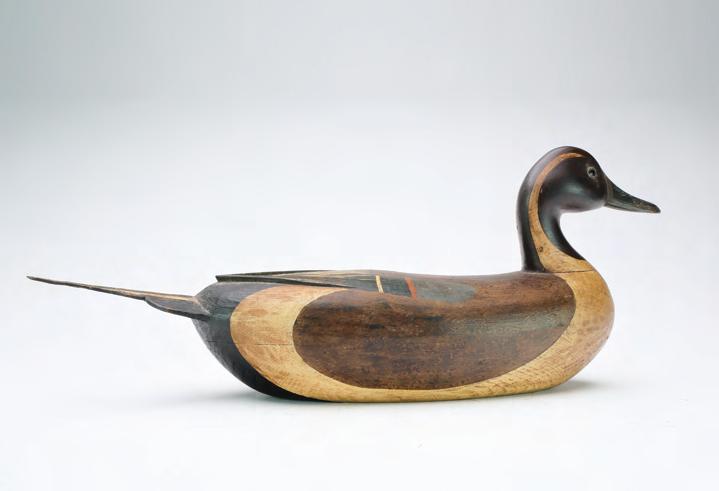
286 Mark McNair (b.1950), Craddockville, Virginia. Early pintail drake with slightly turned head and fine comb feather paint detail. ‘Walsh’ branded on the underside for the rig of the late collector Clune Walsh. Measures 18” long. Original paint with minor rubs and wear; hairline crack in tail, otherwise very good structurally.
Provenance: Clune Walsh rig. (600 - 900)
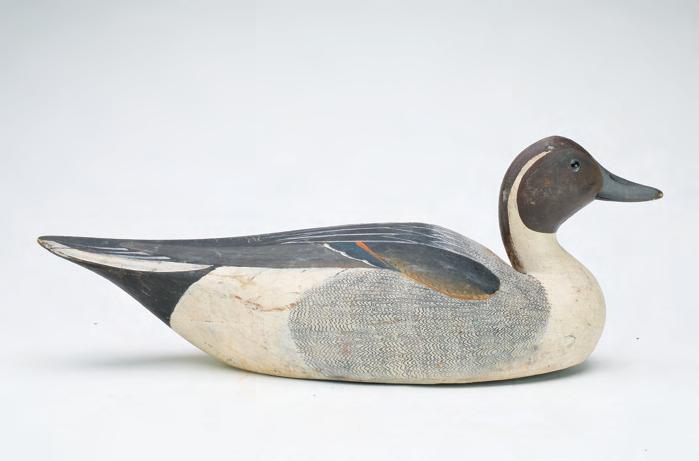


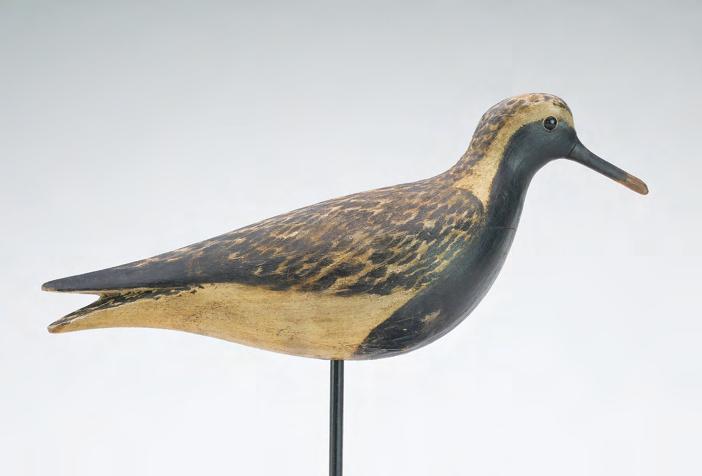
287 Mark McNair (b.1950), Craddockville, Virginia. Hollow carved golden plover with relief wing carving and raised wingtips. Excellent paint detail. Maker’s name carved in the underside. Inlayed bone escuthen at stick hole. McNair hardwood stand included. Measures 12” long. A few very fine drips of white paint on back and head, otherwise excellent. (1,200 - 1,800)
288 Mark McNair (b.1950), Craddockville, Virginia. Very thinly hollowed running yellowlegs. Relief wing carving and raised wingtips. Inlaid bone escutcheon at stick hole. “McNair” carved in the underside. Measures 15.5” long. Excellent and original. (1,500 - 2,500)
289 Mark McNair (b.1950), Craddockville, Virginia. Black bellied plover with glass eyes and split tail. Dry brush paint style, similar to Crowell. “McNair” carved in underside. Measures 11.5” long. Wear has been added at tail and under belly and bill to create the appearance of age. (600 - 800)
290 Mark McNair (b.1950), Craddockville, Virginia. Preening curlew with relief wing carving and raised wingtips. “McNair” carved in the underside. Accompanied with the catalog where it was last purchased. Measures 12.75” long. Excellent and original. (2,000 - 2,500)
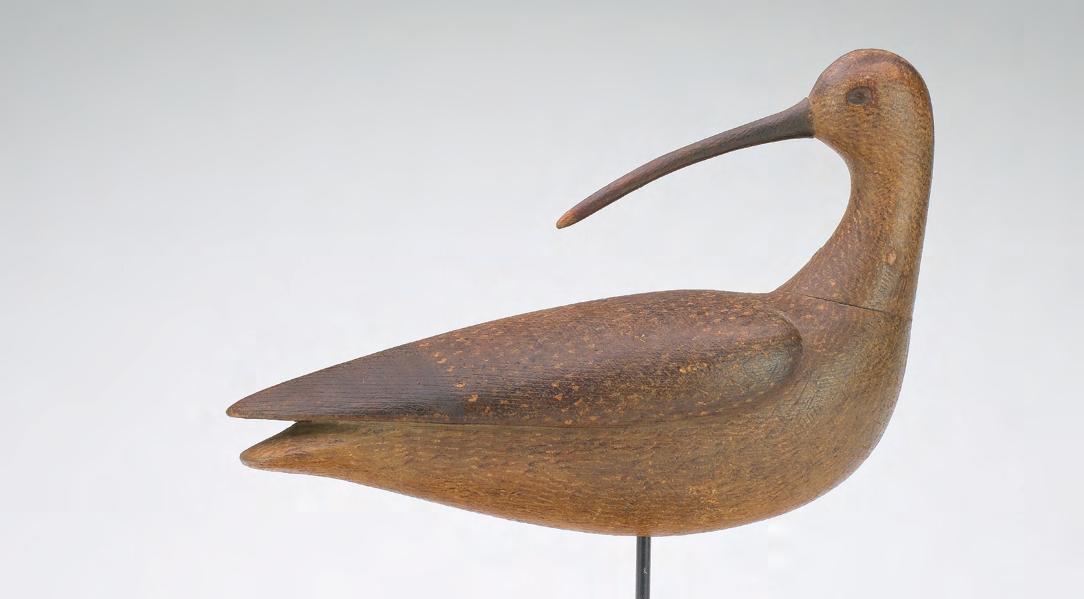
290

291

292

293

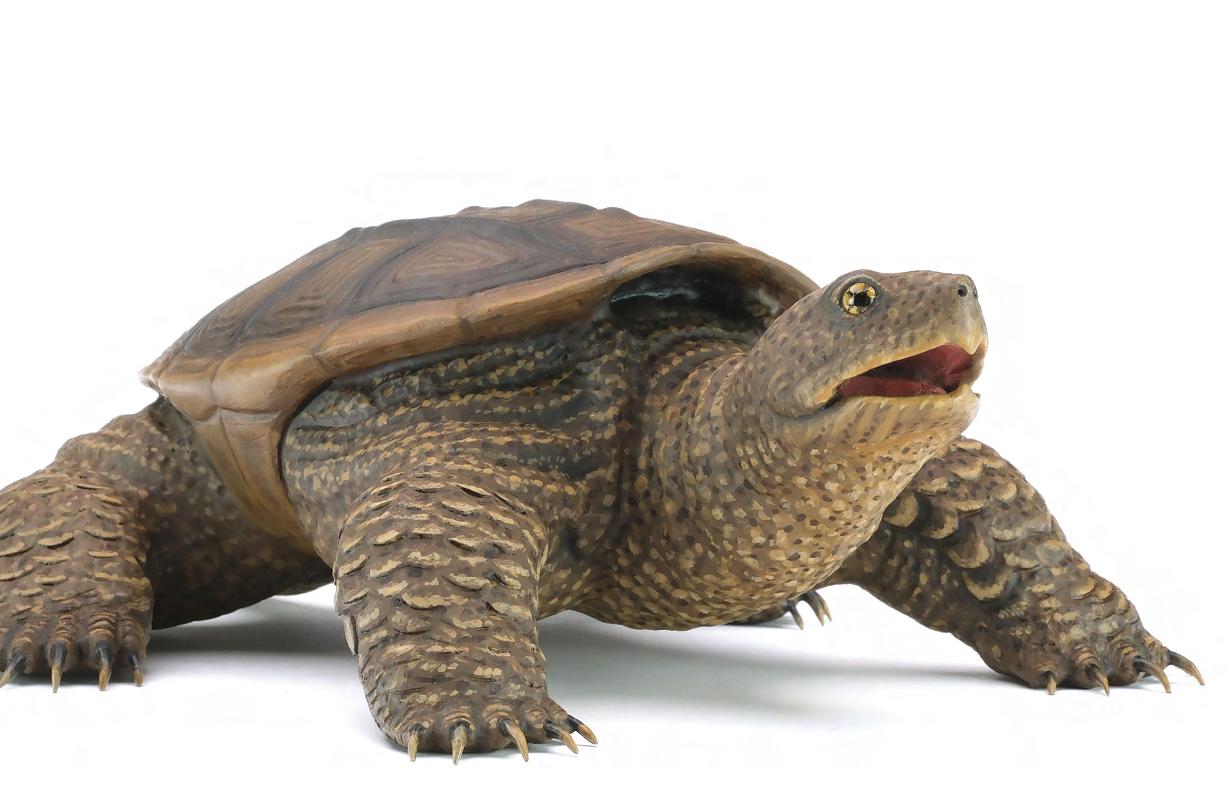
294 Eddie Wozny (b.1959), Cambridge, Maryland. Common snapping turtle with open mouth and detailed skin carving. Inserted metal claws. Identified and signed on the underside of front feet. Measures 16.5” long. Excellent and original. (1,500 - 2,500)
Eddie Wozny (b.1959), Cambridge, Maryland. 1/4 size turkey with turned head and relief feather carving. Identified, signed, and dated 2001. Measures 12” long, stands 11.25” tall including base. Excellent and original. (1,200 - 1,800)
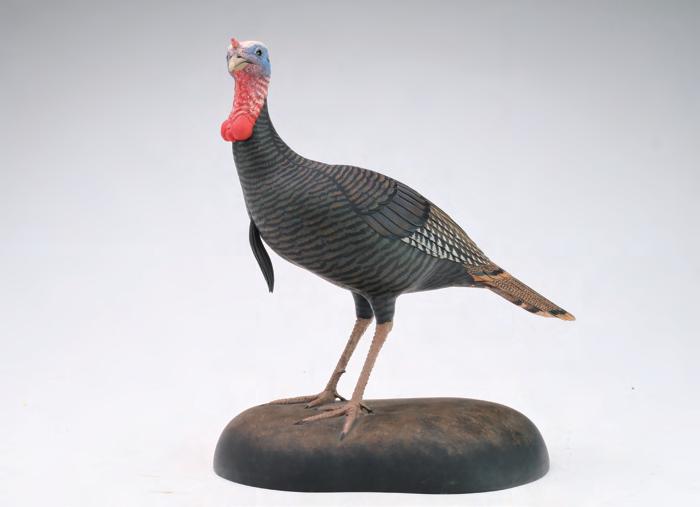
adults and two chicks.
with relief wing feather carving. All standing on carved wood base that is signed and dated 2015 on the underside. Chicks measures 1.5”
full size 6.25”
and original. (1,200 - 1,800)

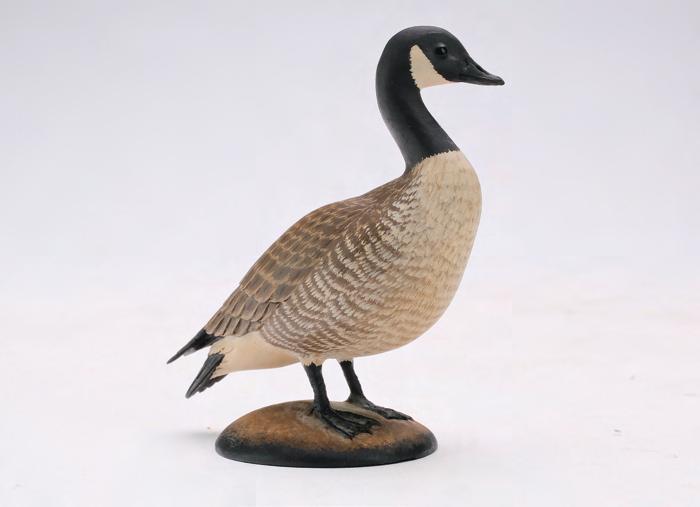 296
297 Eddie Wozny (b.1959), Cambridge, Maryland. Miniature sandhill crane family with two
All
long,
tall including base. Excellent
298 Eddie Wozny (b.1959), Cambridge, Maryland. Miniature standing Canada goose with relief feather carving and raised, crossed wingtips. Head is slightly turned with very detailed bill carving. Signed and dated 2003 on the underside. Stands 3.5” tall. Mint. (400 - 600)
296
296
297 Eddie Wozny (b.1959), Cambridge, Maryland. Miniature sandhill crane family with two
All
long,
tall including base. Excellent
298 Eddie Wozny (b.1959), Cambridge, Maryland. Miniature standing Canada goose with relief feather carving and raised, crossed wingtips. Head is slightly turned with very detailed bill carving. Signed and dated 2003 on the underside. Stands 3.5” tall. Mint. (400 - 600)
296
299

Finney
Cape Charles, Virginia. Large hollow carved swan with raised neck seat and slightly turned head. Relief bill and eye carving. Unsigned. Measures 32” long. Made to appear older with dry and flaked paint; excellent and original. (3,000 - 5,000)
Excellent and original. (1,200 - 1,800)

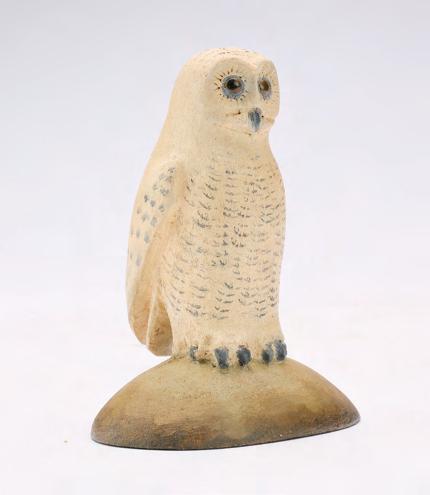
800)

William Gibian (b.1946), Onancock, Virginia. Decorative black tailed godwit with outstretched wings and relief feather carving. Slightly turned head with open bill. Carved clam shell on base. “Gibian” carved on the underside of bird. Maker’s business card on underside of base. Titled “Black tailed godwit taking flight” and numbered 1. Signed and dated 2021. Bird measures 15” long, 21.75” tall including base. Excellent and original. (7,000 - 10,000)
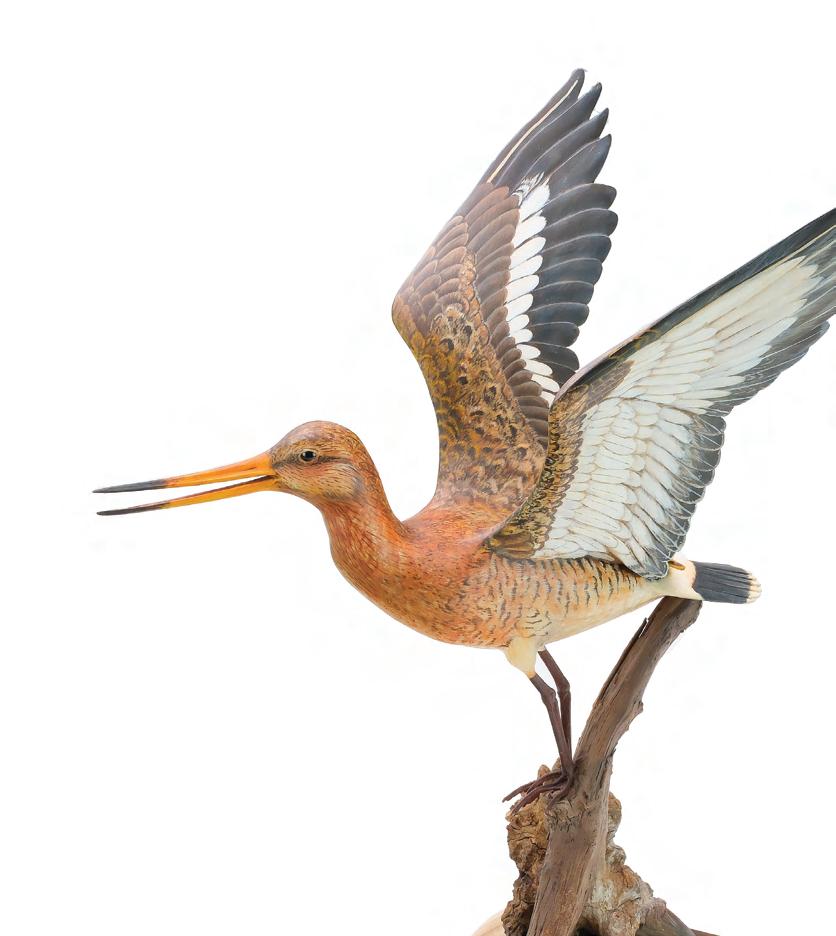 301a
301a
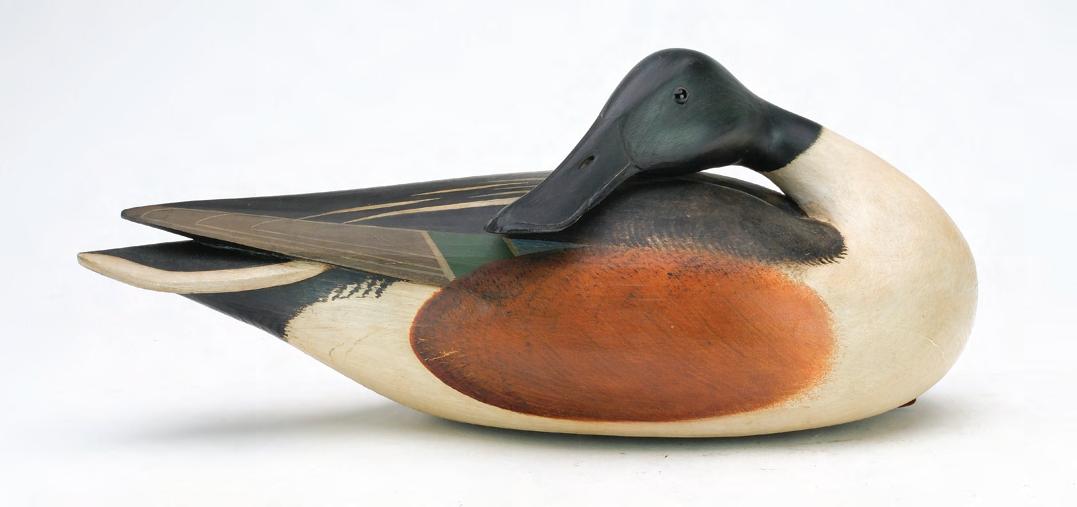
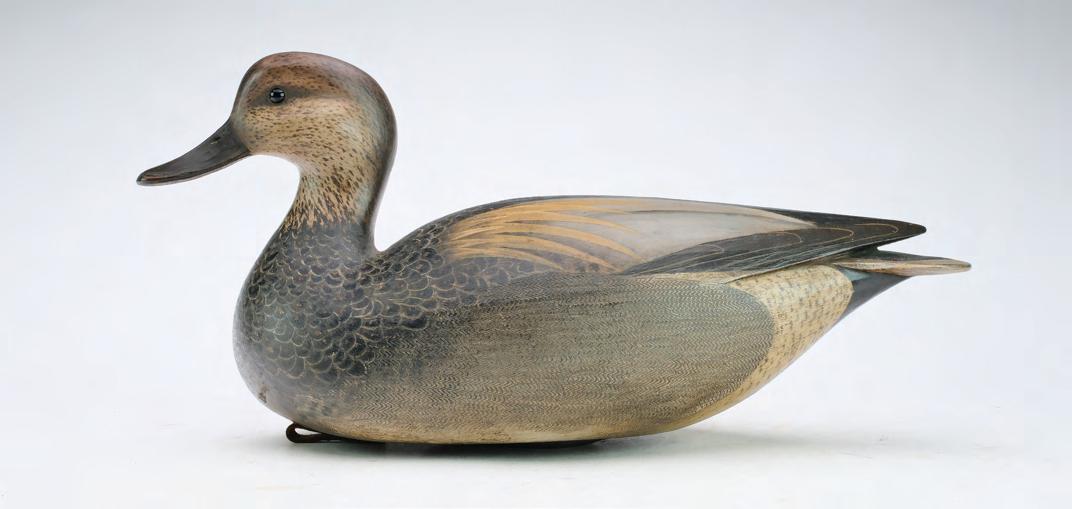
A few tiny dents, otherwise excellent and original. (800 - 1,200)
302
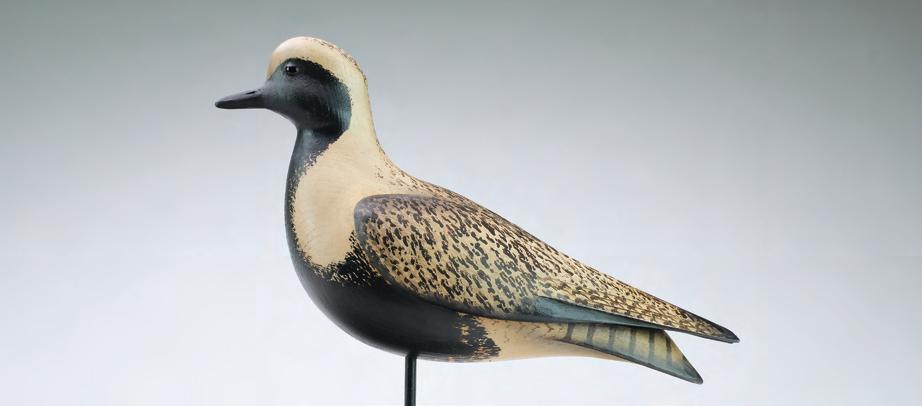


Virginia. Large, feeding curlew with deep relief wing carving and raised wingtips. “Gibian” carved in the underside. Measures 25.5” long. Very minor sap bleed and a hairline crack in one side, otherwise excellent and original. (1,000 - 1,400)
303 William Gibian (b.1946), Onancock, Virginia. Large black bellied plover with deep relief wing carving and raised wingtips. “Gibian” carved in the underside. Measures 12.5” long. Minor blunting on the tip of wingtips, otherwise very good and original. (500 - 800)
304 William Gibian (b.1946), Onancock, Virginia. Ruddy turnstone with slightly turned head, relief wing carving, and raised wingtips. “Gibian” carved in underside. Measures 11.25” long. Very good and original. (500 - 800)
305 William Gibian (b.1946), Onancock, Virginia. Feeding dunlin. “Gibian” carved in underside. Glass eyes, carved wings, and carved separated wingtips with dropped tail. Measures 6” tall. Very good and original.
Provenance: Randy Rall collection. (400 - 600)
303 302a 304 305 302a William Gibian (b.1946), Onancock,306 Ward Brothers, Crisfield, Maryland. Classic 1942 style black duck with slightly turned head. Signed by the Ward Brothers on the underside. Bobby Richardson collection ink stamp and McCleery collection ink stamp on the underside. Measures 16” long. Original paint with very minor wear; a few small dents on head; very minor roughness on edge of bill; old drying crack along the underside and a hairline crack on one side of neck seat; an excellent example.
Provenance: Norris Pratt collection. Bobby Richardson collection. Jim McCleery collection. Private Tennessee collection.
Literature: ‘Call to the Sky,” Bob Shaw, page 79, exact decoy pictured. “The Ward Brothers Decoys: A collectors guide,” page 79, exact decoy pictured. “L.T. Ward and Brother Wildfowl Counterfeiters,” page 45, exact decoy pictured. (15,000 - 25,000)

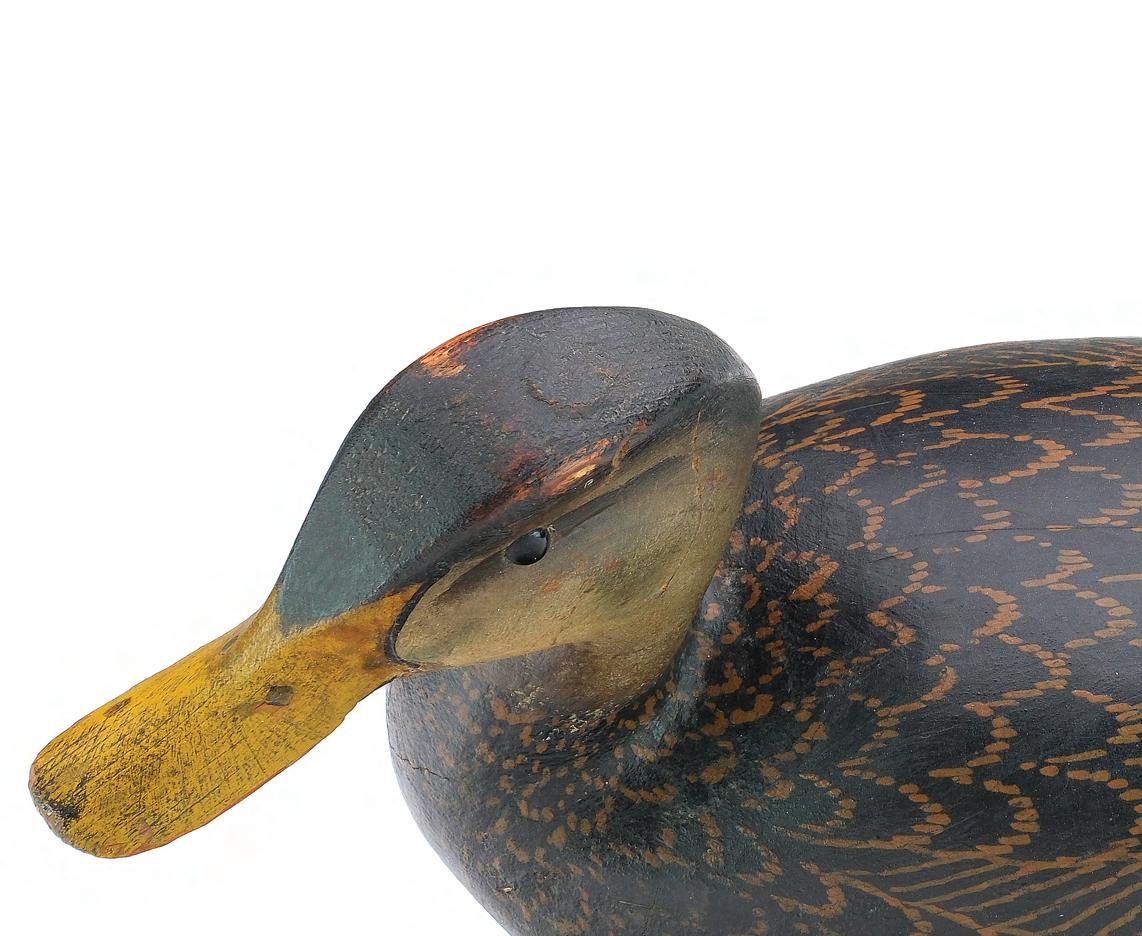

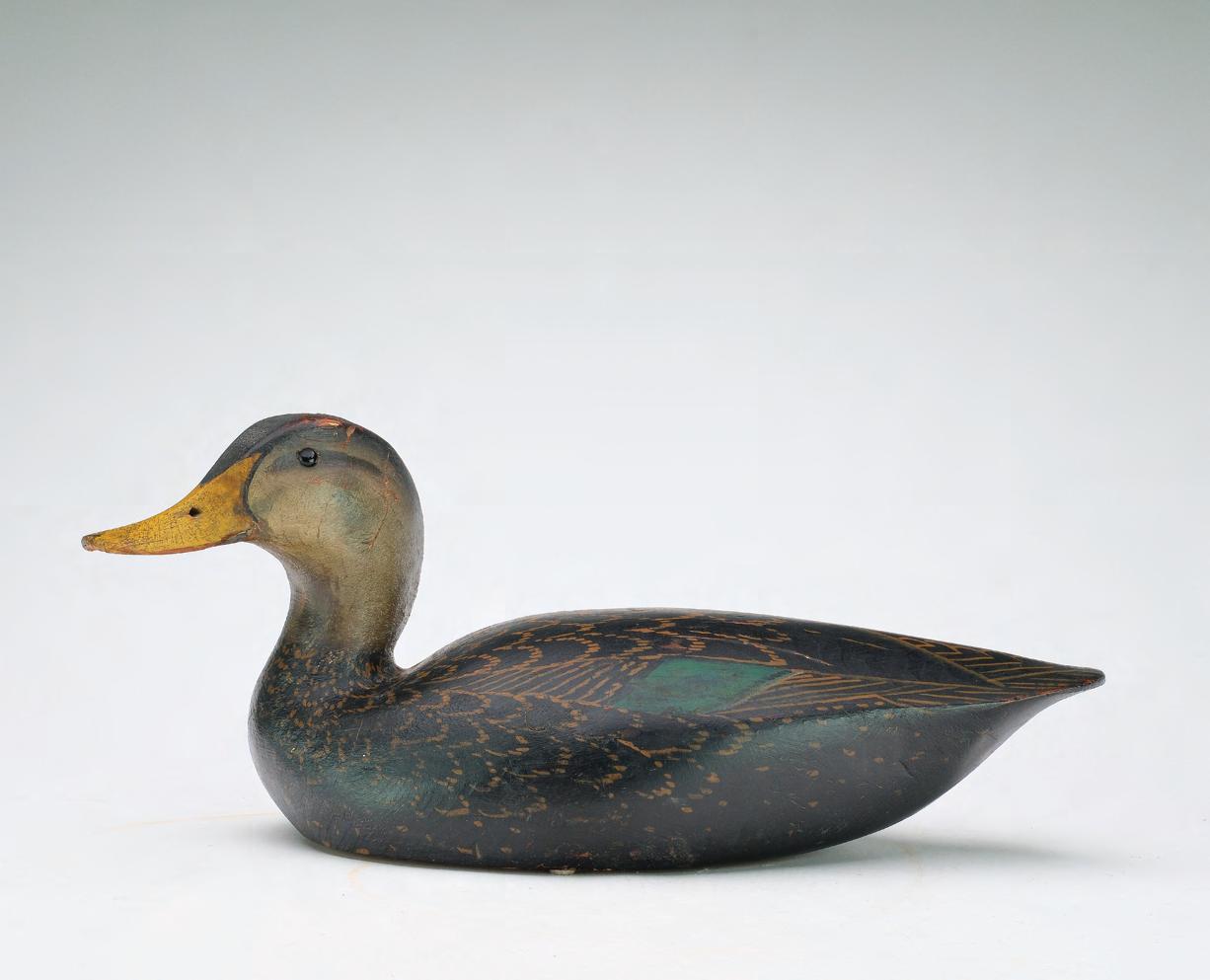
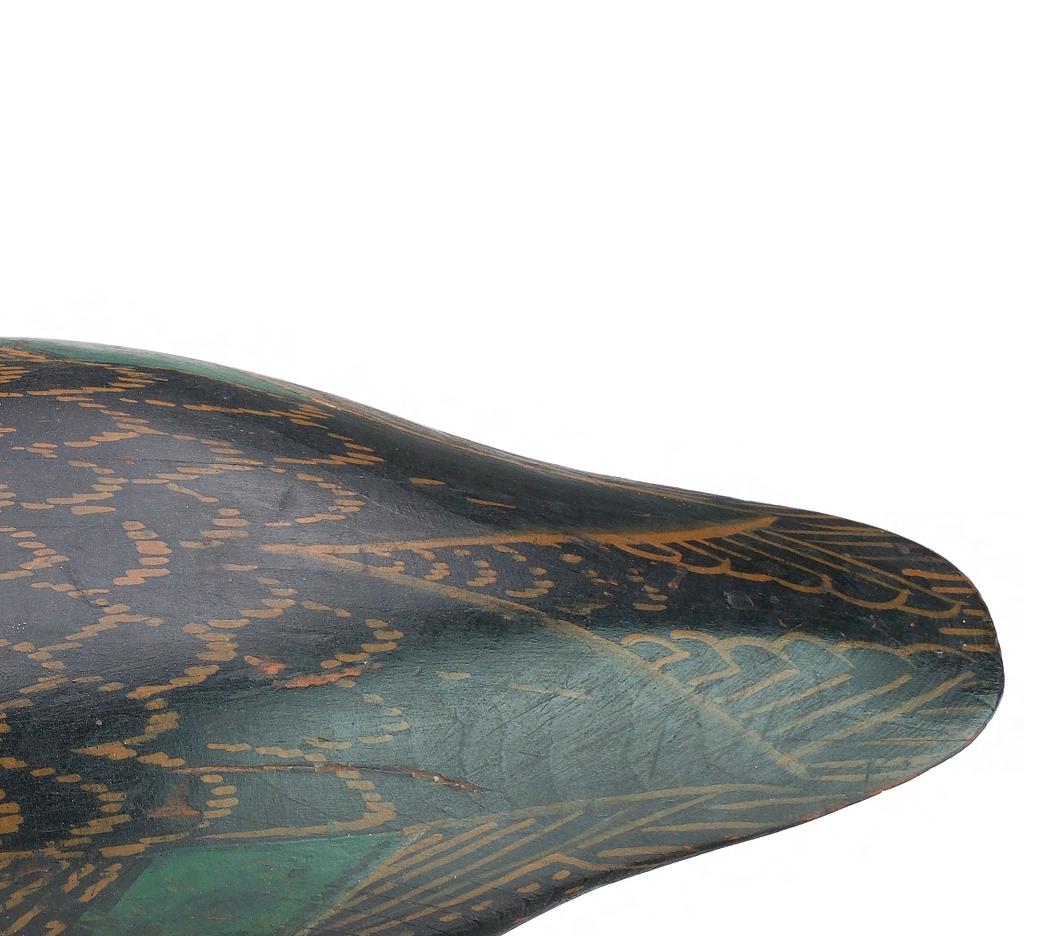
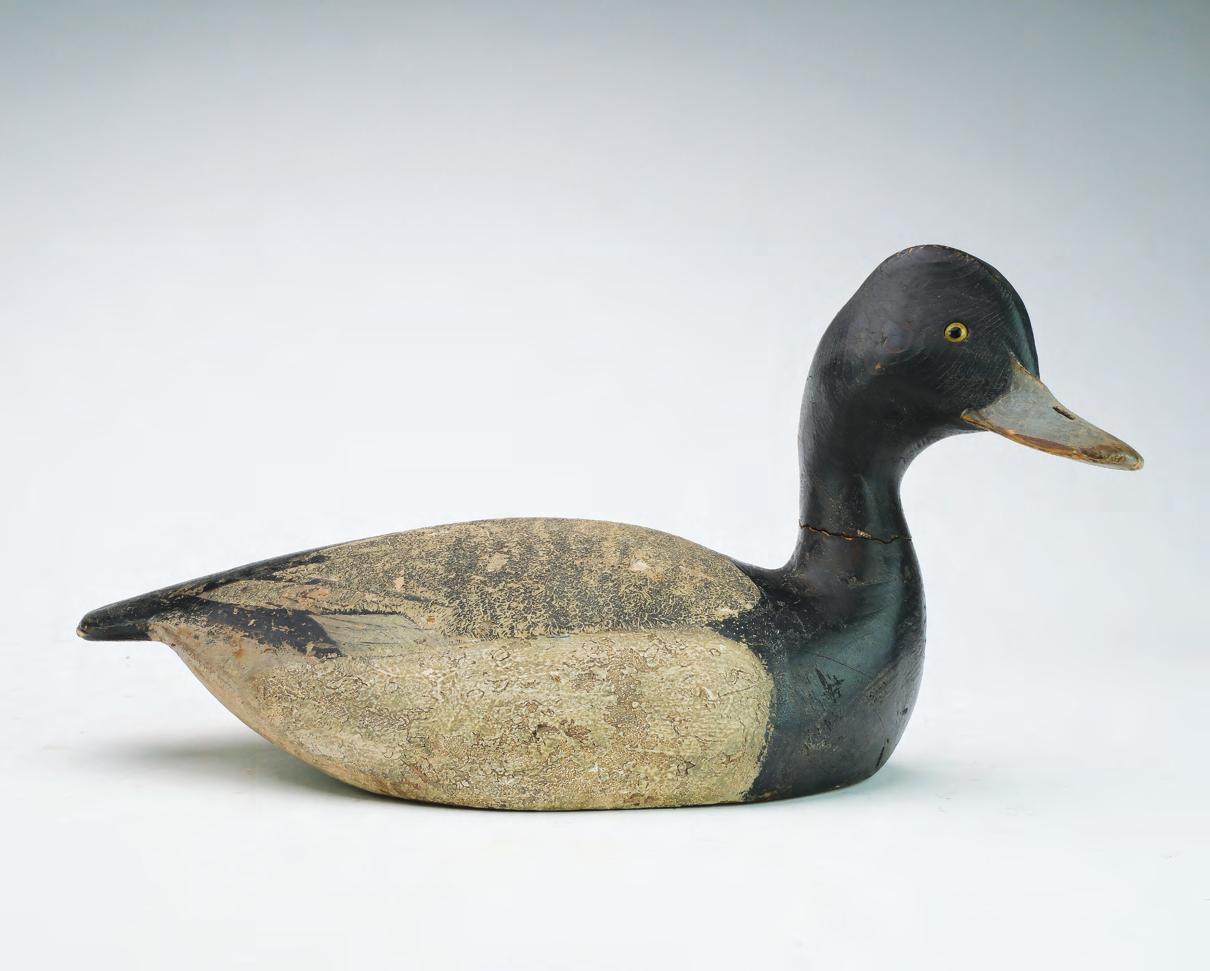
307 Ward Brothers, Crisfield, Maryland. Rare high-head broadbill in slight swimming position. Head is turned, cocked, and slightly forward. Thick stipple paint on body. Signed by the Ward brothers on the underside. This was reportedly Bud Ward’s favorite Ward Brothers decoy. Measures 16” long. Mix of original and early working Ward paint showing moderate gunning wear; lightly hit by shot; very minor roughness on edge of bill; slight separation at filler in neck seat.
Provenance: Bobby Richardson collection. Donal C. O’Brien collection. Private southern collection. (18,000 - 22,000)


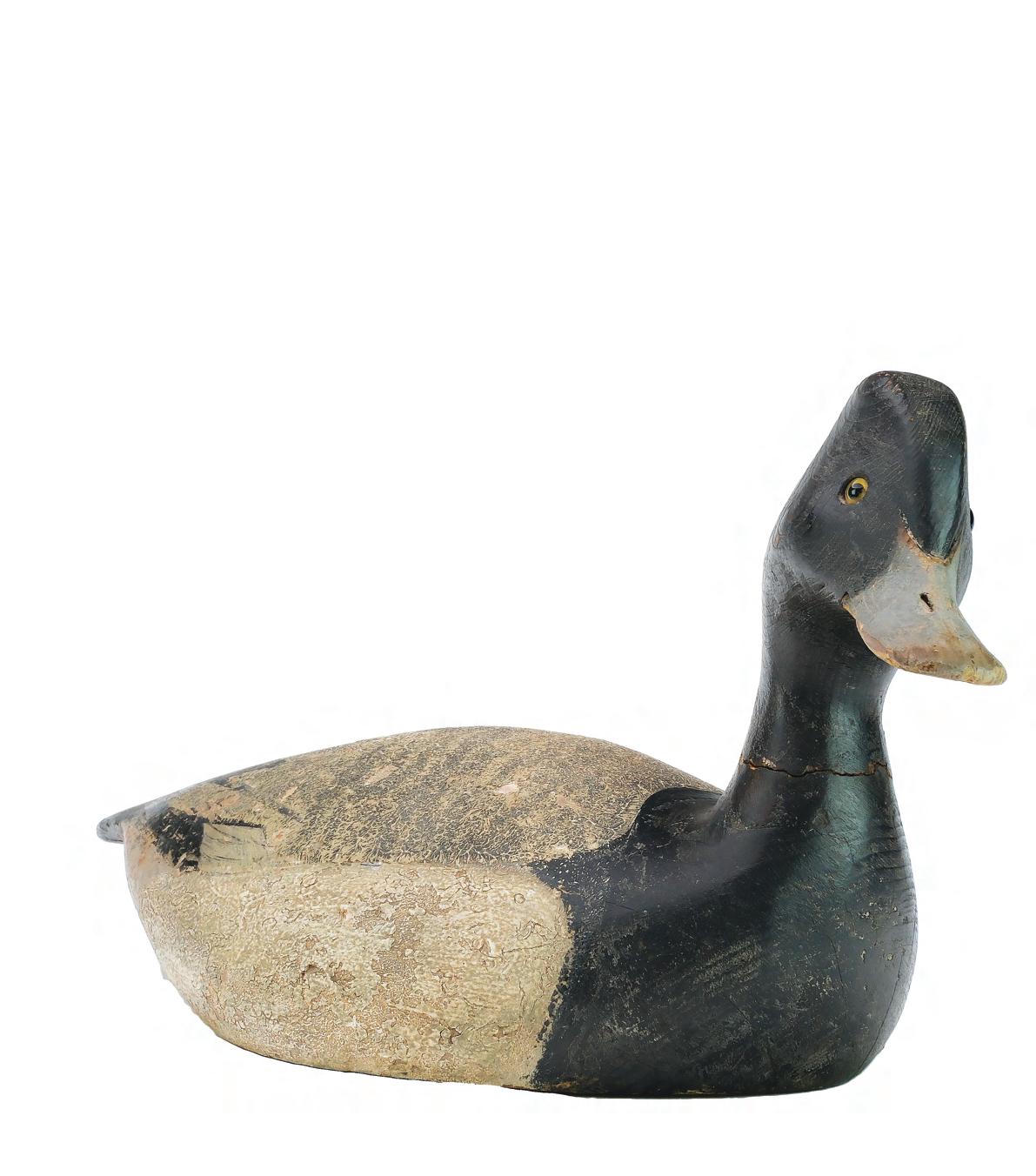
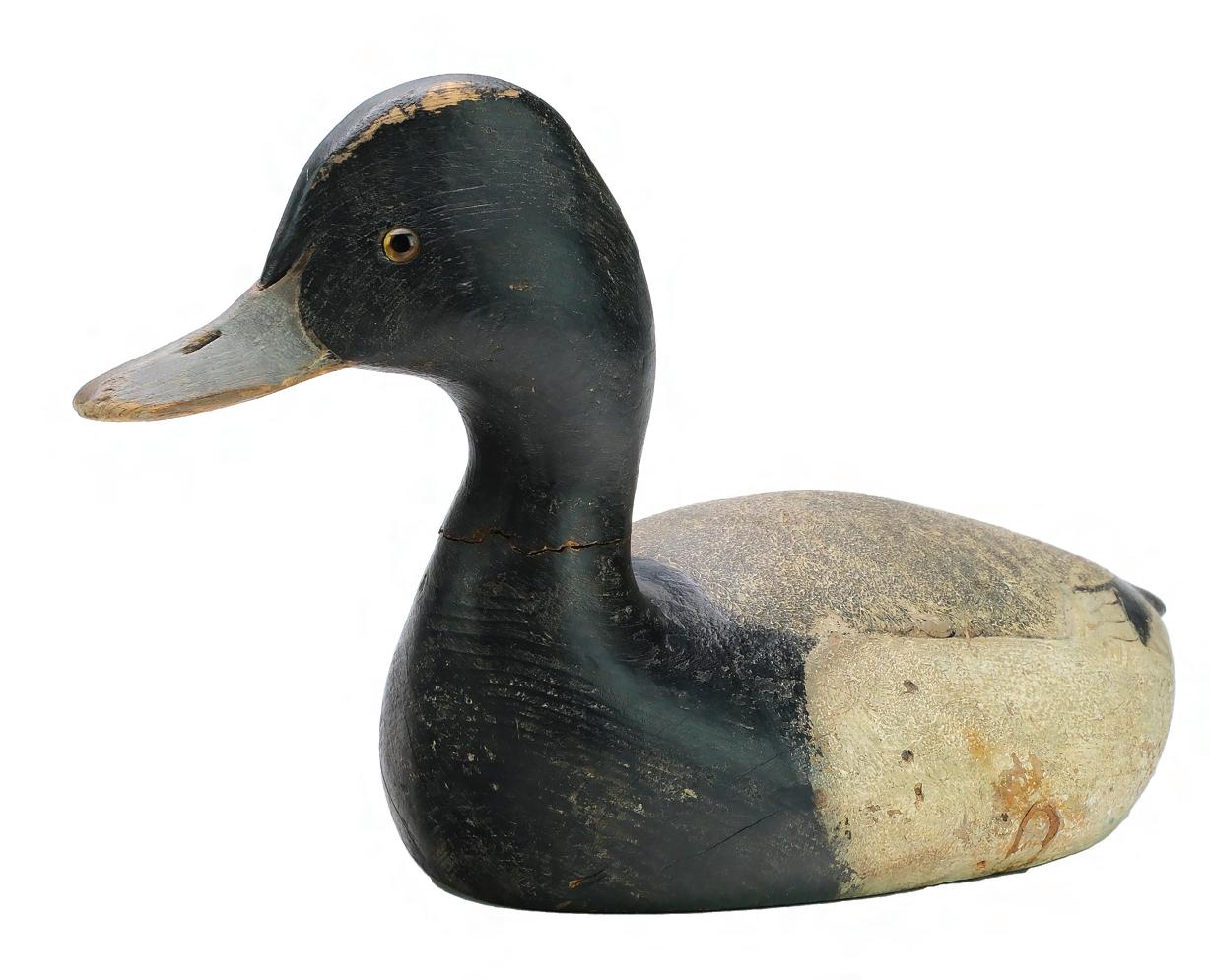
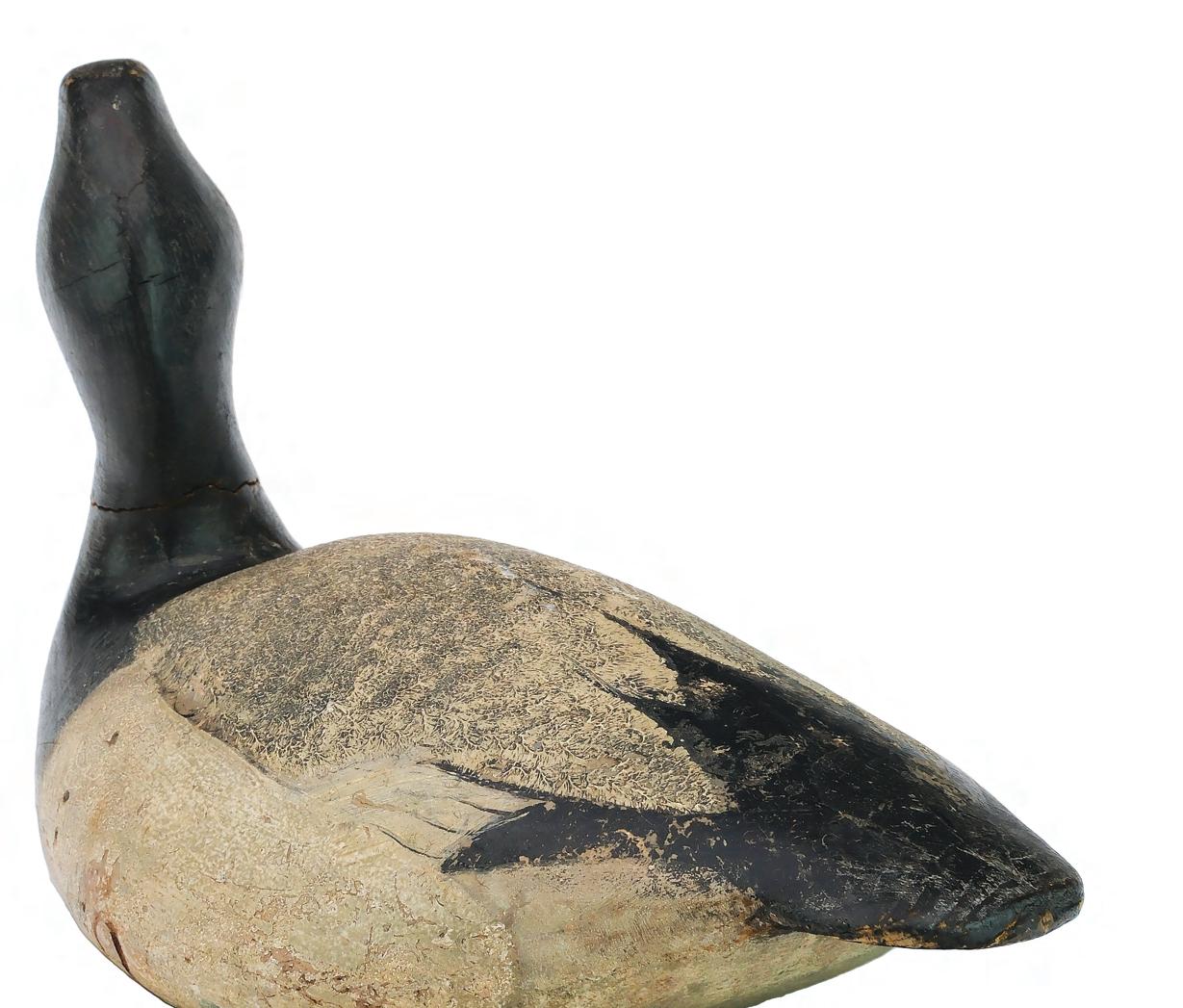
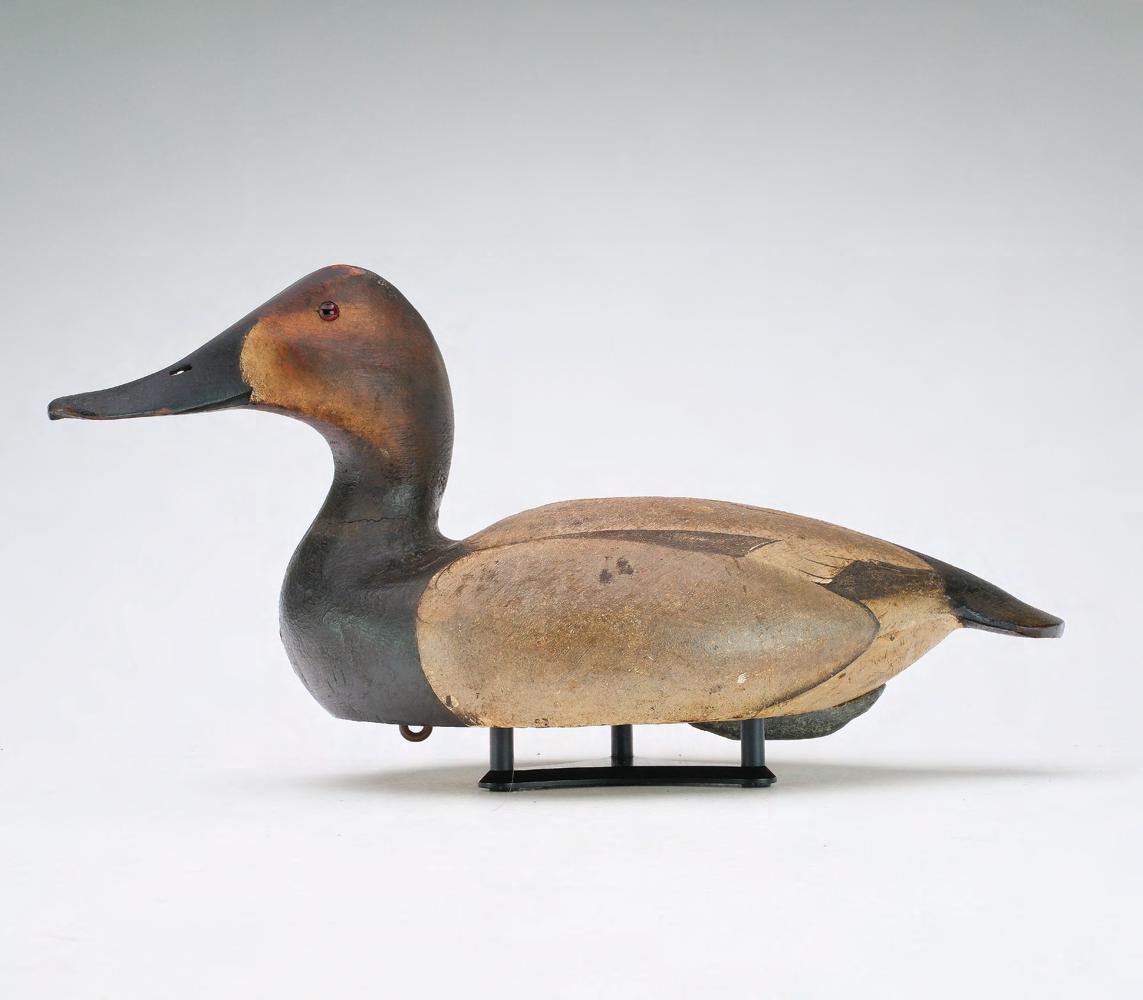

308 Ward Brothers, Crisfield, Maryland. 1936 style canvasback hen with slightly turned head. Signed and dated at a later date on the underside. Bill Purnell brand on the underside. Measures 16.5” long. Original paint with moderate wear under an early coat of varnish; spots of discoloration along one side; filled split with touchup along the back; small chip in one side of bill tip; restoration to the filler at neck seat.
Provenance: David Fannon collection. (6,000 - 9,000)
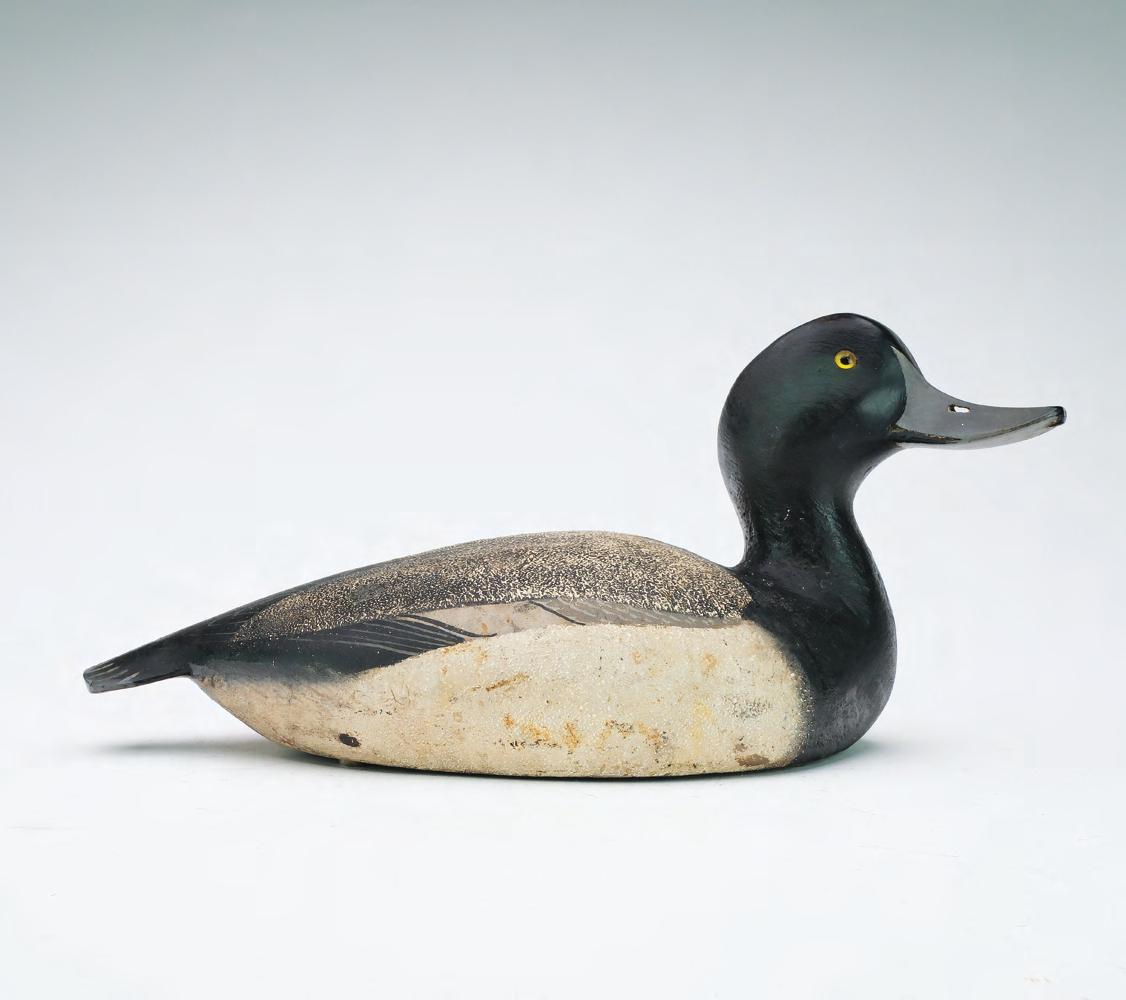
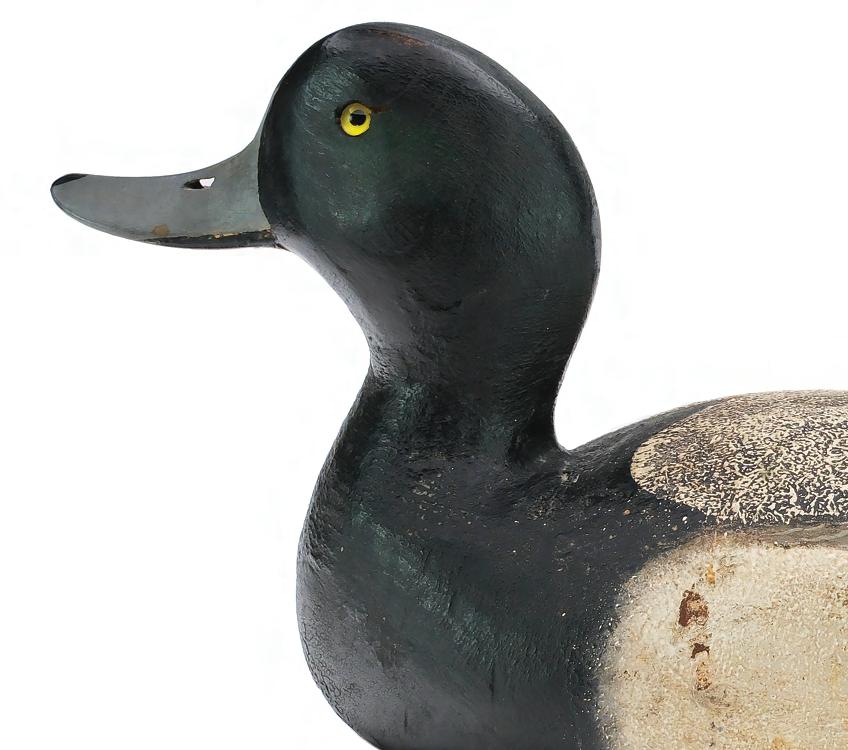
(6,000 - 9,000)
309 Ward Brothers, Crisfield, Maryland. Excellent 1936 style bluebill with slightly turned and upswept head. Thick stipple paint on body. Signed on the underside. Measures 15.75” long. Original paint with minor discoloration and wear; bill is an early professional replacement.
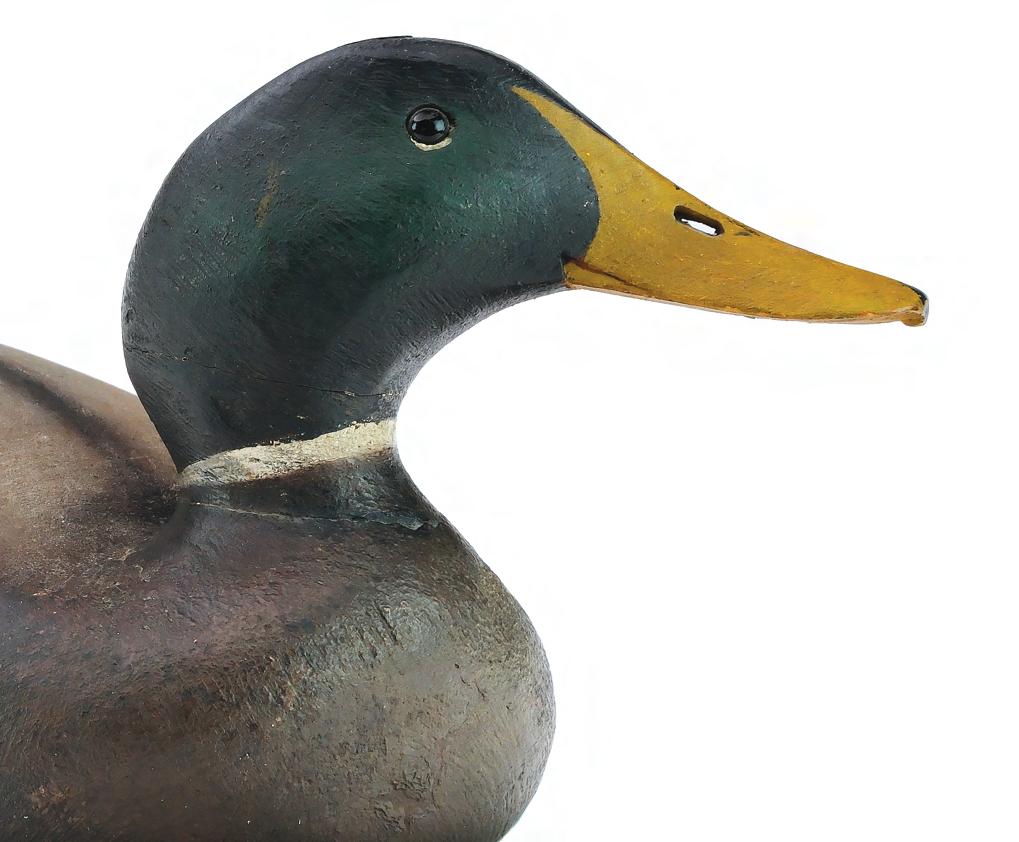
310 Ward Brothers, Crisfield, Maryland. 1936 style mallard with head turned 45 degrees. VL&A ink stamp on the underside. Decoy was never rigged or weighted. Measures 16.5” long. Original paint with minor flaking and wear; hairline crack through neck with minor flaking; hole in back was plugged with area of touchup in that area; professional repair to a chip behind neck seat with touchup in that area.
Provenance: David Fannon collection. (6,000 - 9,000)
311 Ward Brothers, Crisfield, Maryland. Shooting stool model merganser with head turned 45 degrees. Hollow carved with extended head feathers. Signed and dated 1965 with a poem on the underside. Measures 16” long. Very good and original. (3,000 - 5,000)
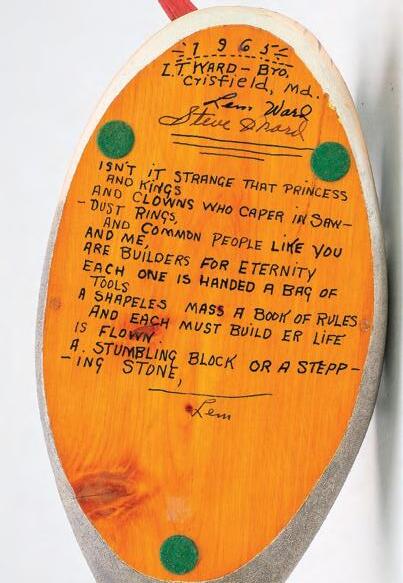
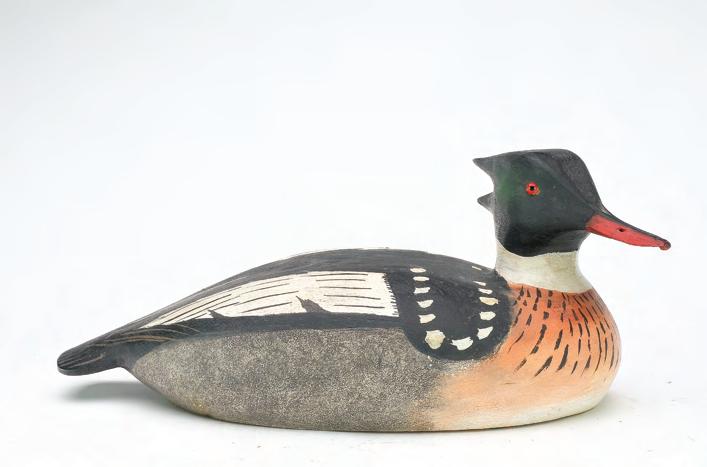
312 Ward Brothers, Crisfield, Maryland. Canvasback hen with balsa body and slightly turned head. Signed by Lem Ward on underside. Made and painted in the 1936 style. Measures 16” long. Very good original paint; two small rough areas at tip of bill; some wear with paint loss around tail; tight crack in wood filler near neck seat.
Provenance: Randy Rall collection. (2,500 - 3,500)
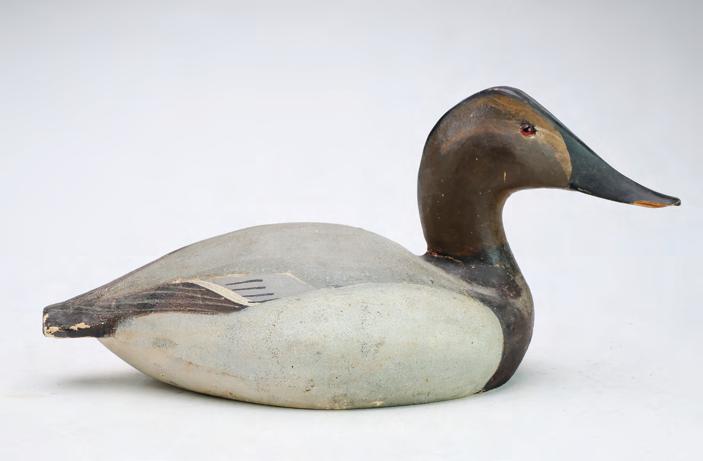
313 Ward Brothers, Crisfield, Maryland. Canvasback with deep ice groove behind neck seat. Typical thick stipple paint on back and sides. Museum inventory number in ink on the underside. Also signed “Robt Staniford” twice. Measures 15.5” long. Original paint with moderate gunning wear; bill is a professional replacement; thin wash of black on the breast and face done when the bill repair was made.
Provenance: Recently deaccessioned from an East Coast Museum. (2,500 - 3,500)

314 Ward Brothers, Crisfield, Maryland. Decorative hollow carved wigeon with slightly turned head. Deep relief wing and tail feather carving. Signed and dated 1967 on the underside. Measures 12.5” long. A few very minor paint rubs, otherwise excellent and original.
(5,000 - 8,000)



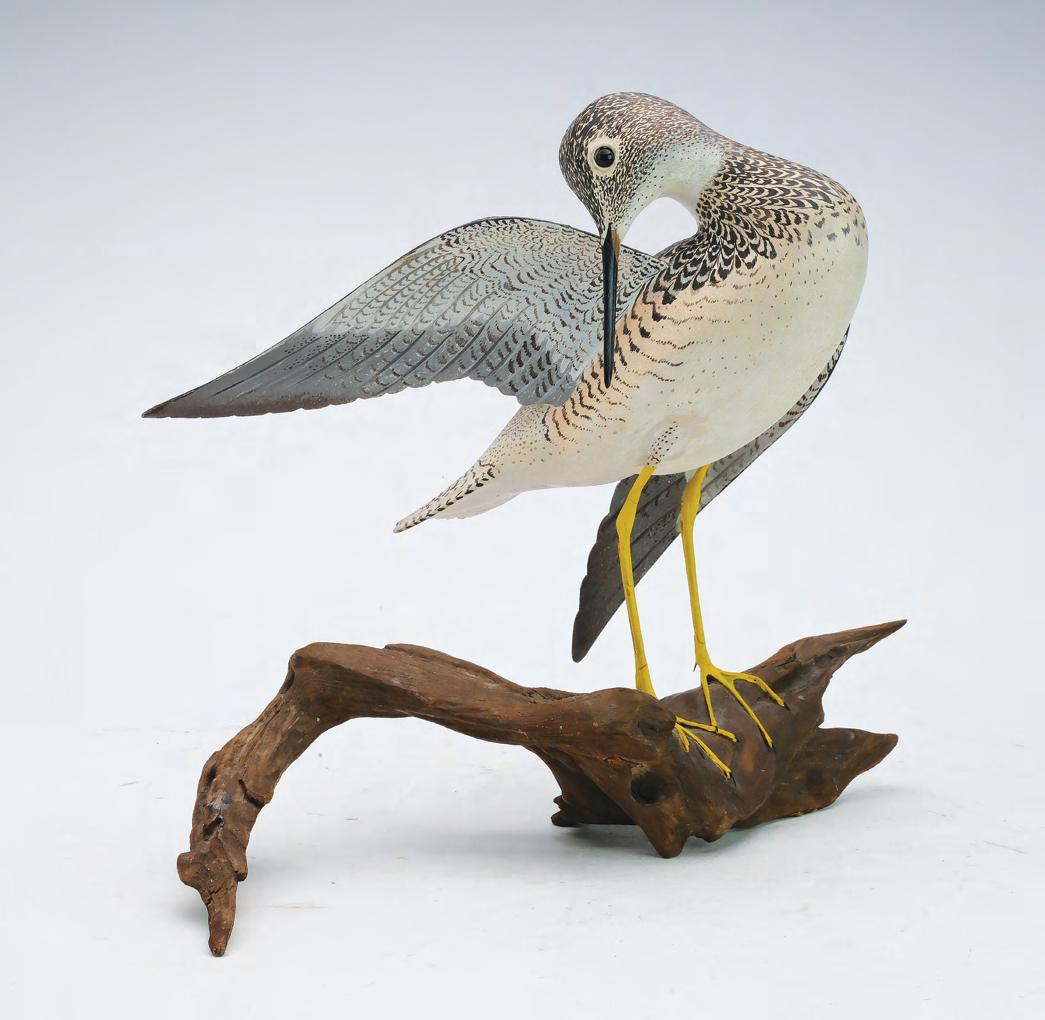

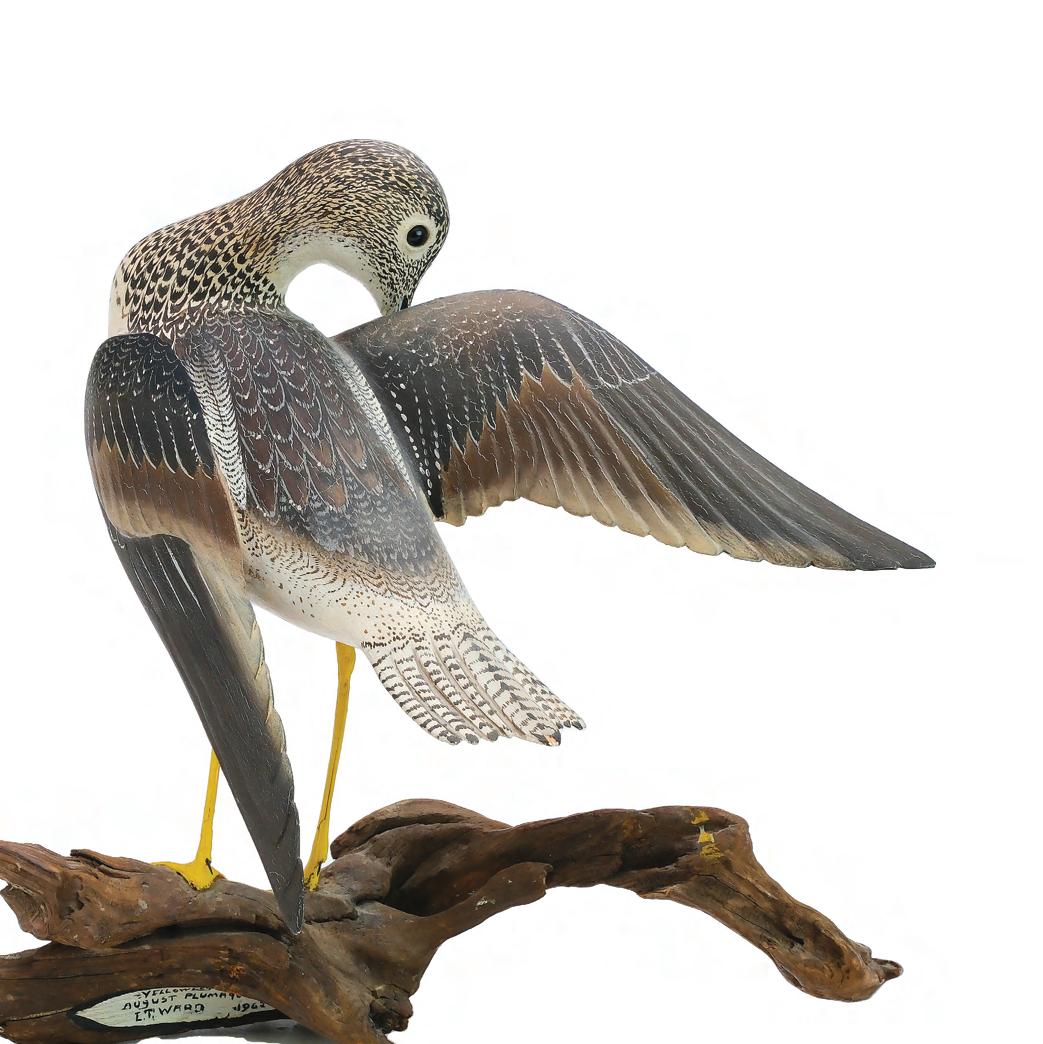
315 Ward Brothers, Crisfield, Maryland. Rare decorative yellowlegs in preening pose with one dropped and one raised wing. Relief wing and tail feather carving. Identified, signed, and dated 1962 on the underside of base. Stands 12” tall. Tiny chip at tip of center tail feather; fine hairline cracks in legs and thighs, otherwise excellent and original. (6,000 - 9,000)



(6,000 - 9,000)
317 James T. Holly (1855-1935), Havre de Grace, Maryland. Very rare goldeneye. “SS” stamped on underside of weight. Measures 14” long. White overpaint on body was cleaned down to the original surface showing moderate flaking and wear; drying crack along the underside; small dents and shot marks.
(4,000 - 6,000)
318 Ward Brothers, Crisfield, Maryland. Greenwing teal hen. Signed and dated 1952 on the underside. Also stamped 471. Measures 12.5” long. Original paint with minor wear; professional repair to a chip in each side of tail; bill is a professional replacement; minor roughness at tip of tail; in the making filled crack on the underside has opened slightly. (3,000 - 5,000)
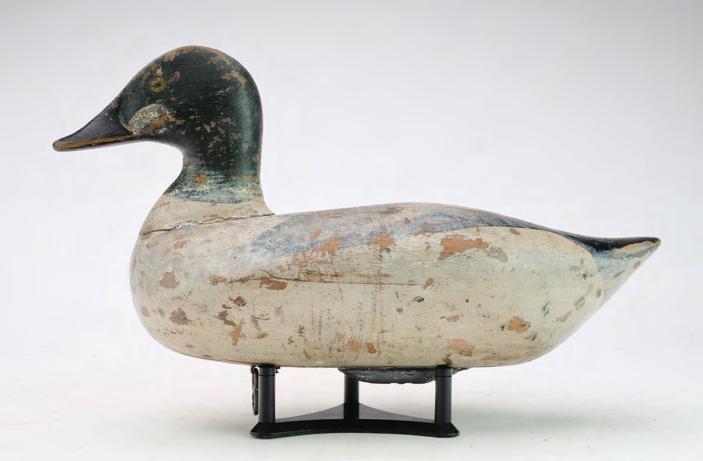
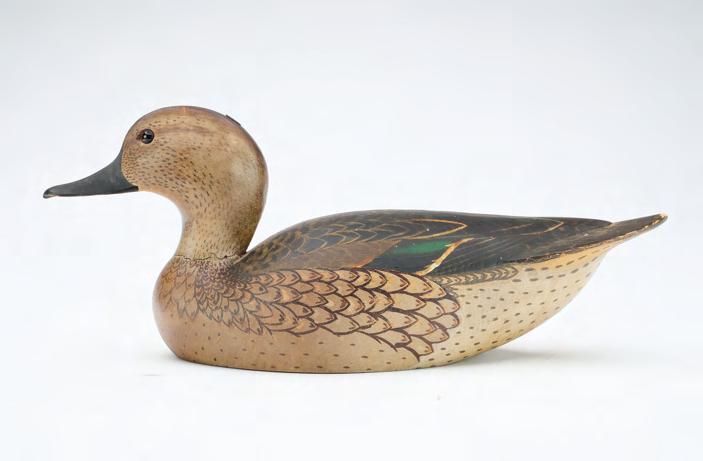
319 Unknown maker, Crisfield, Maryland, 2nd quarter 20th century. Mallard hen or gadwall with tucked head and deep relief wingtip carving. Chuggy collection ink stamp visible under UV light on underside. Measures 14.25” long. Original paint with minor flaking and wear under a thin coat of varnish; head is removable; inserted cedar tail is a professional replacement.
(2,000 - 3,000)
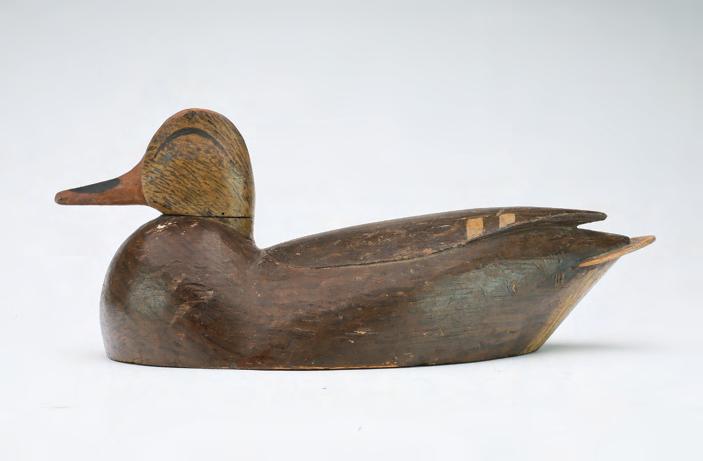

From the mid 19th century into the early 20th century, the Eastern Shore of Virginia produced some of the finest early waterfowl hunting anywhere in North America. Many of the decoys produced during that period are highly sought after by today’s collectors. Names that include the likes of Ira Hudson, Nathan Cobb, Charles Clark, Dave Watson, and Walter Brady to name but a few, produced decoys for both the market hunter and, later, the sport hunters that frequented the Eastern Shore.
Willis Wharf, located on Virginia’s Eastern Shore, was the home of Charles Birch. Birch moved from Maryland to Willis Wharf shortly after the turn of the century, and was employed as a waterman and commercial decoy maker. He produced nearly every species of waterfowl that were commonly sought after by hunters in that area, including black ducks, brant, geese, redheads, bluebills, and pintails. Birch made both solid and hollow decoys. While his paint patterns were simplistic, his decoys exhibited exceptional form with serpentine necks and very fluid lines.
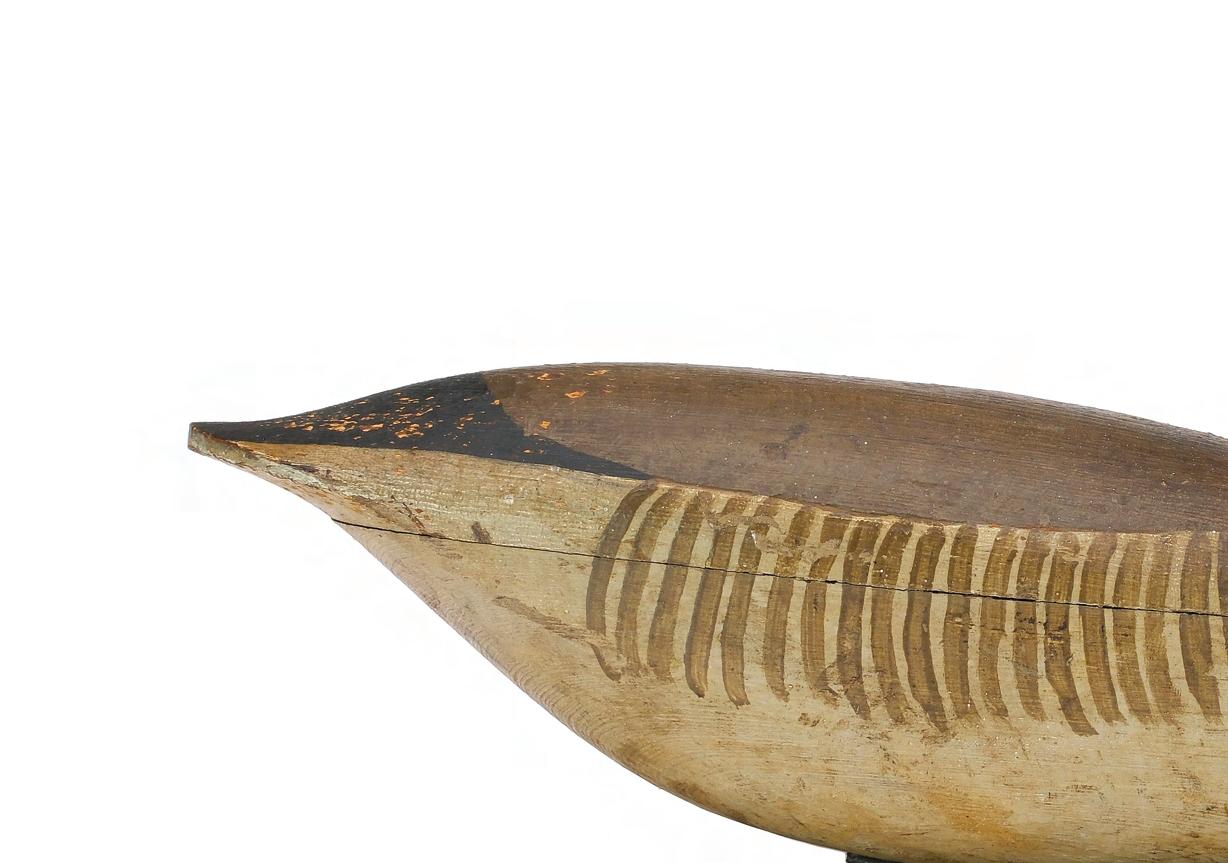
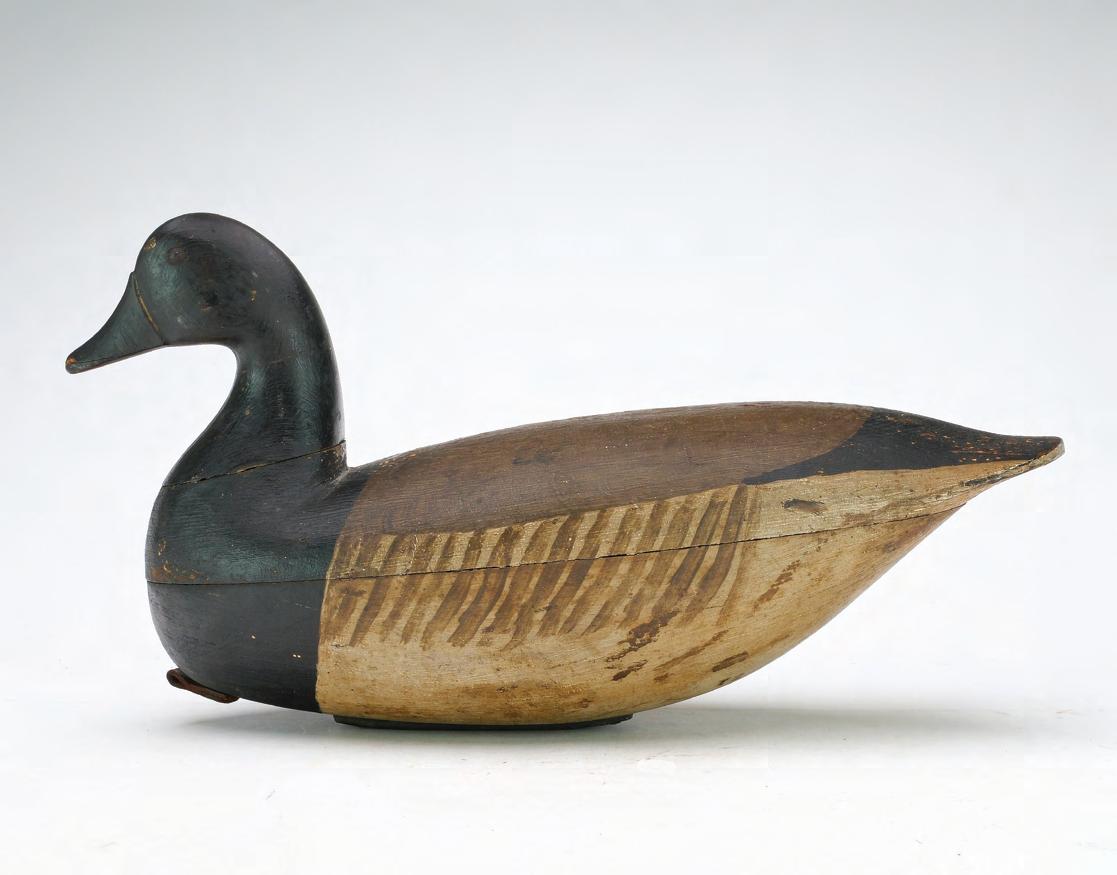

320 Charles Birch (1867-1956), Willis Wharf, Virginia. Excellent hollow carved brant with tack eyes and appealing paint detail on sides. Measures 17” long. Original paint with minor flaking and wear, mostly on back and tail; hairline crack in neck was tightened; minor blunting and a hairline crack in bill. (22,000 - 28,000)
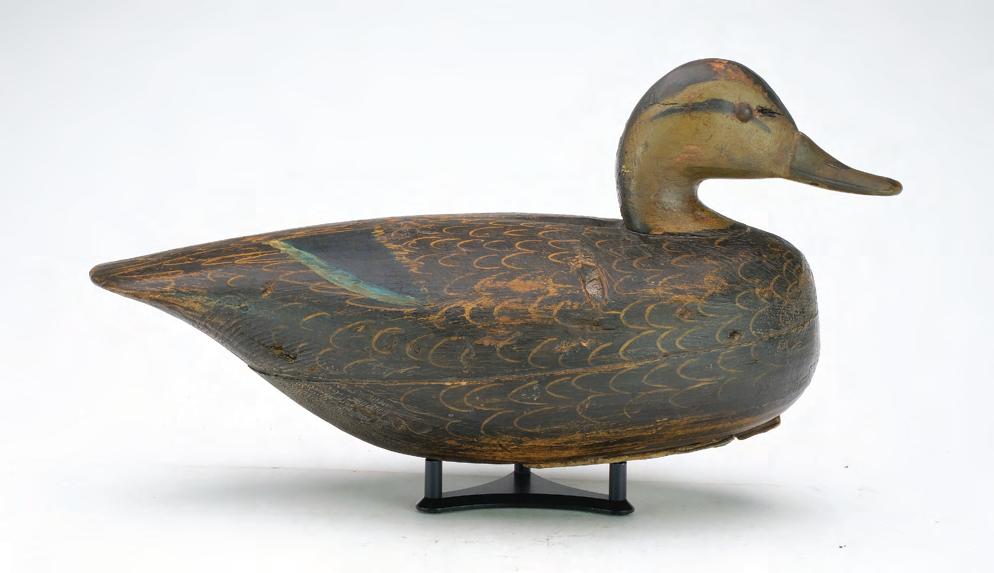
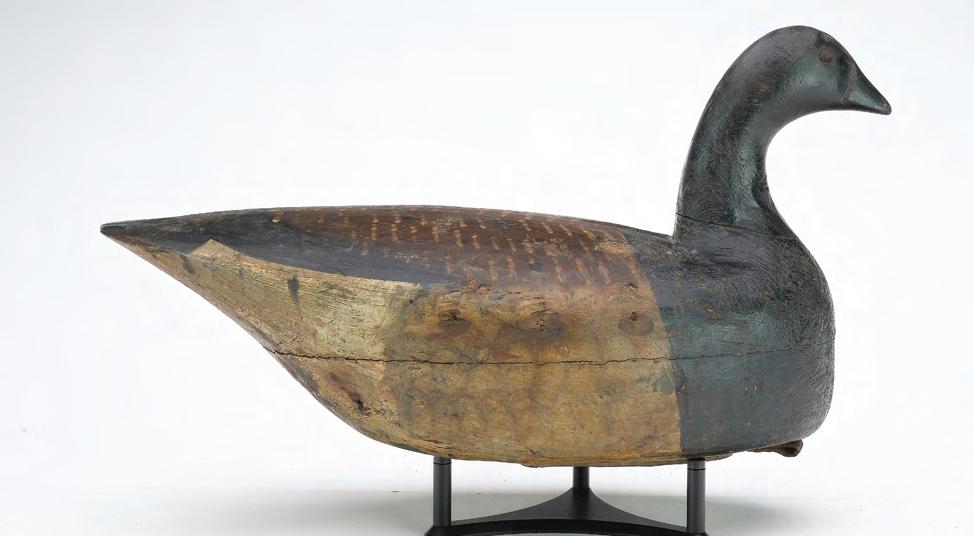
Provenance: Al Marzorini collection. (2,000 - 3,000)
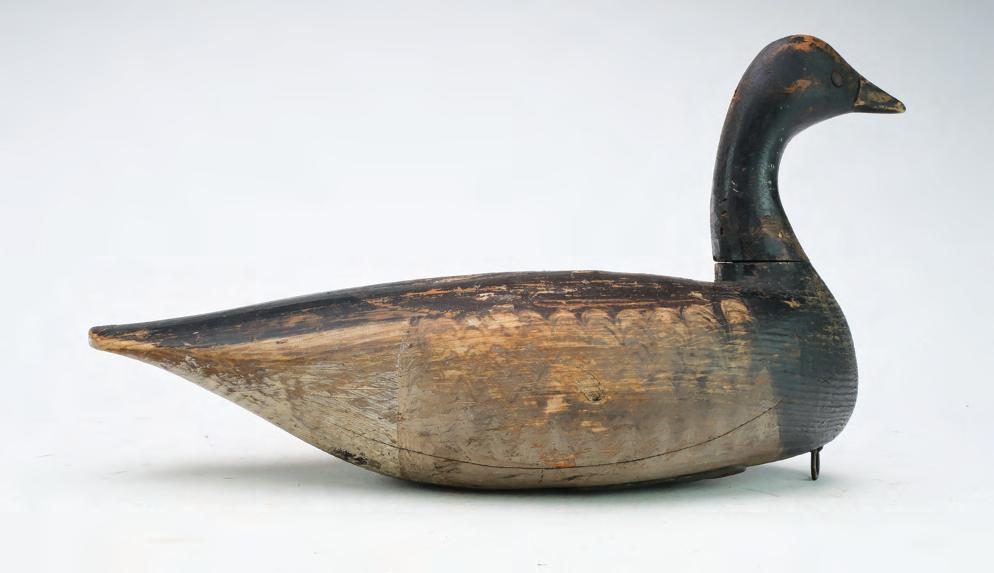

(3,000 - 4,000)
(2,500 - 3,500)
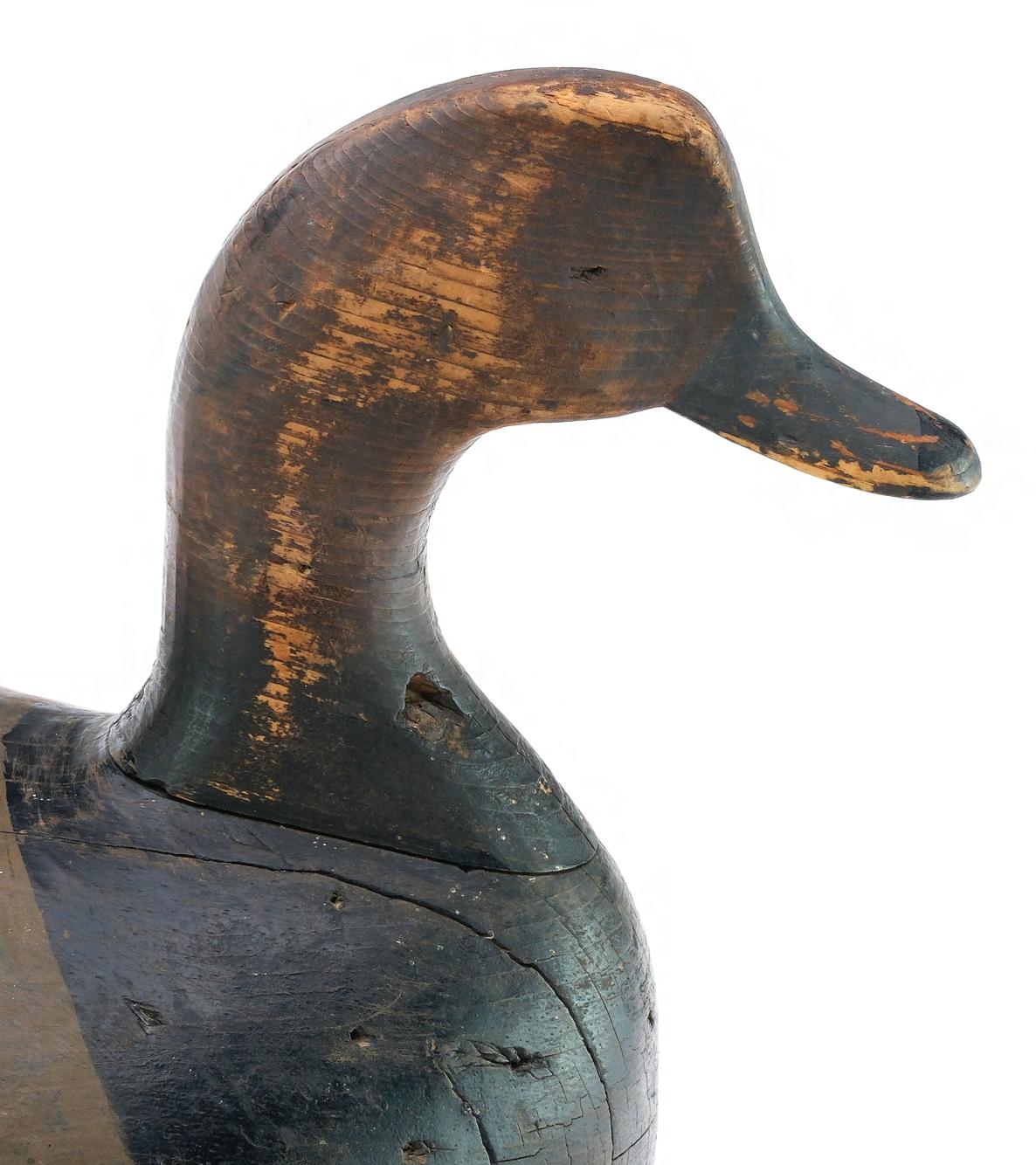 James Best
1866 - 1933 | Kitty Hawk, North Carolina
James Best
1866 - 1933 | Kitty Hawk, North Carolina
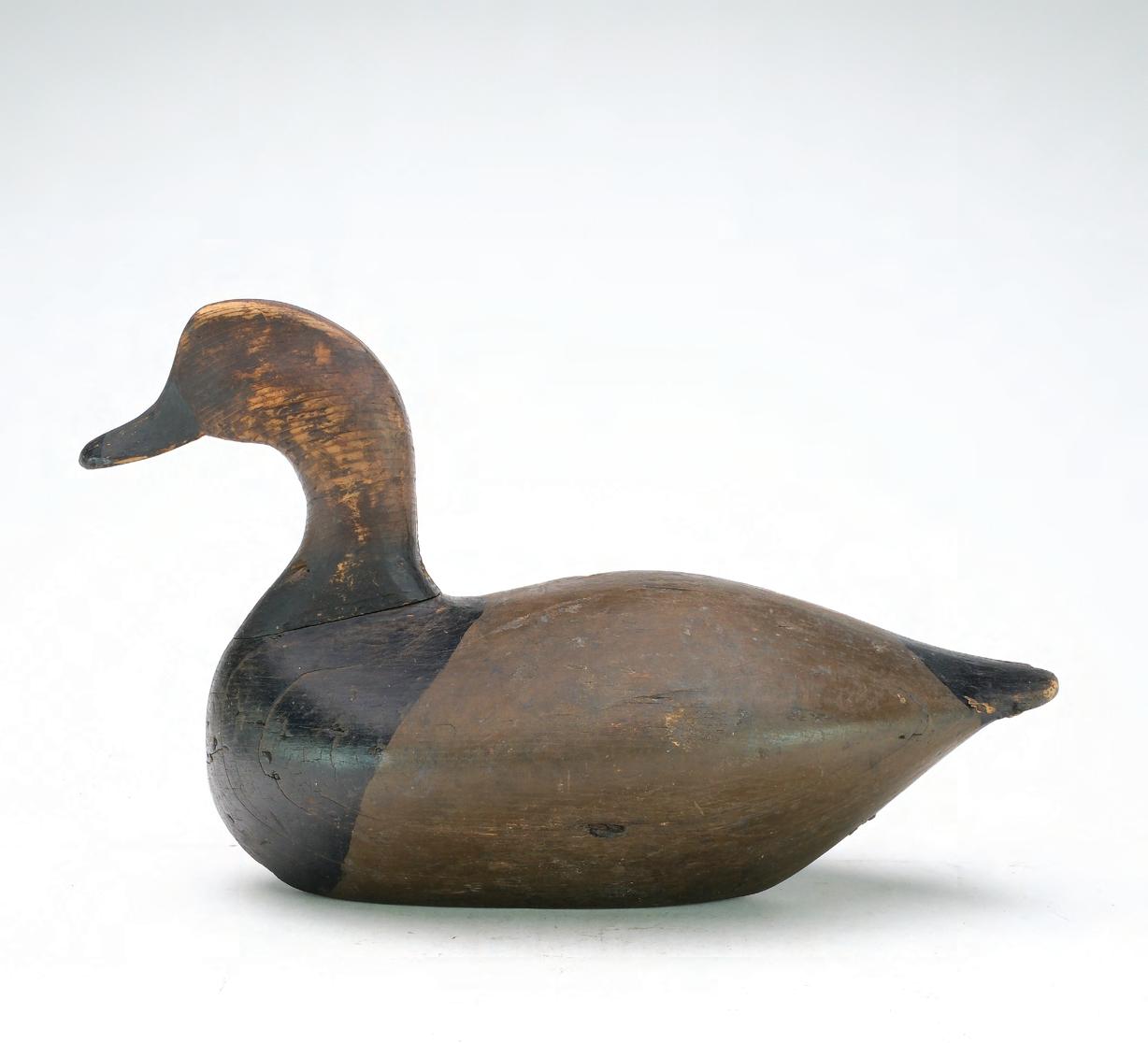
323a James Best, (1866-1933) Kitty Hawk, North Carolina. High head redhead drake. A sharp carved crown at top of head with slightly elevated neck seat, which is slightly slanted. Hard chine lines on sides of body with a sculptural carved transition from bottom of neck through breast. Measures 16” long. Thin original paint with light gunning wear; areas worn to bare wood; tight cracks in body and a hairline crack in neck; rough spot near tail.
Provenance: Private southern collection.
Literature: “Gunnin’ Birds”, by Kroghie Andresen, page 302, similar decoys pictured. (30,000 - 40,000)
323b Rufus Roberts, (1897-1954), Church’s Island, North Carolina. Redhead drake. Charlie Hunter tag on underside. Also a tag on the underside indicates this decoy sold in a Bourne auction August 21, 1986. Measures 16” long. Original paint that is subtle and muted; light gunning wear mostly to edges; some paint loss at top of back which has exposed ealry gray primer.
Provenance: Charlie Hunter III collection. Private southern collection. (7,000 - 10,000)
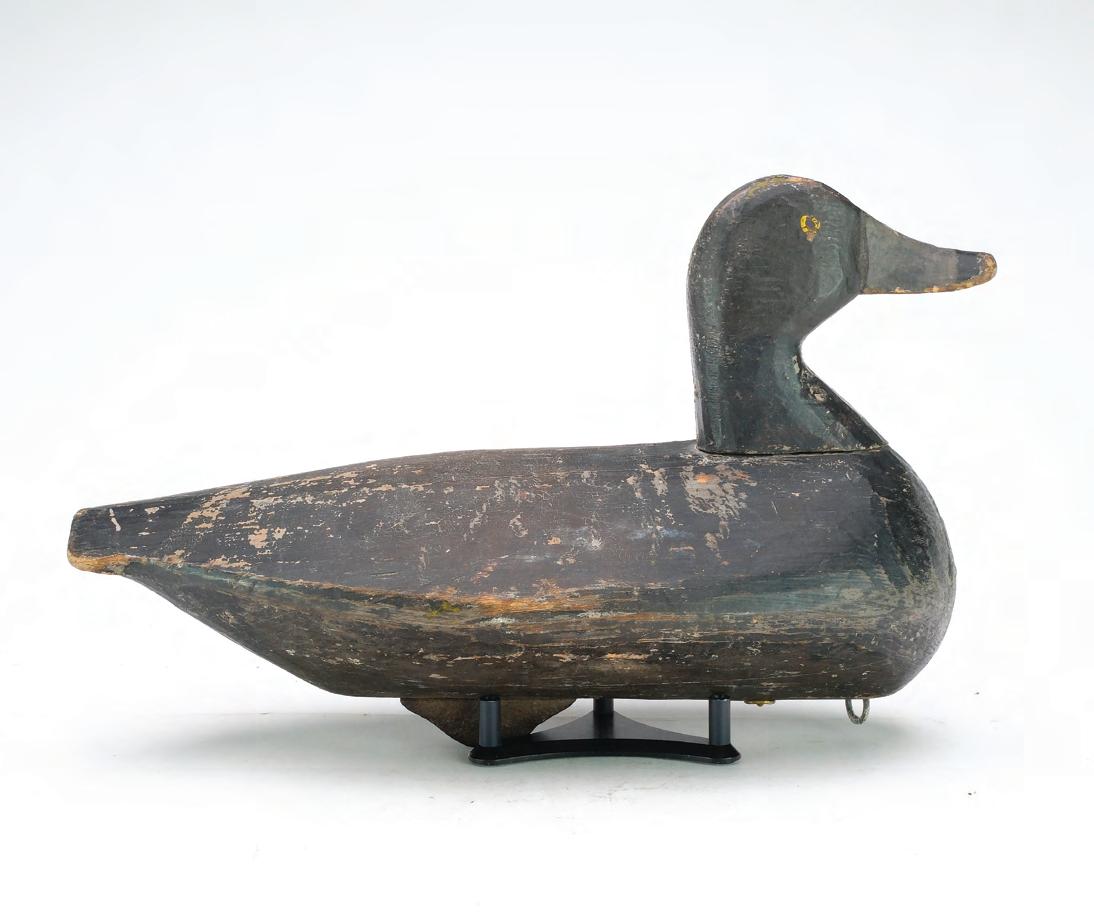


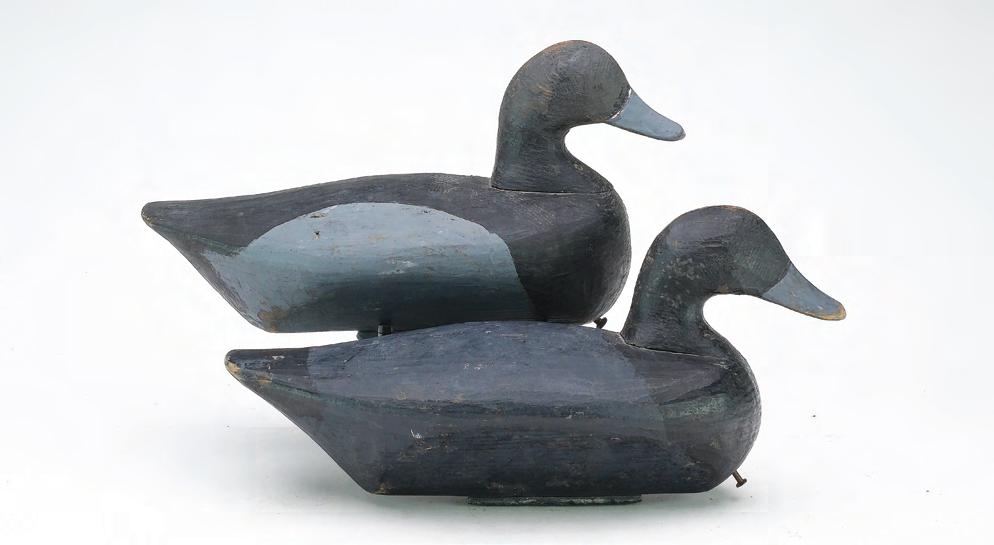
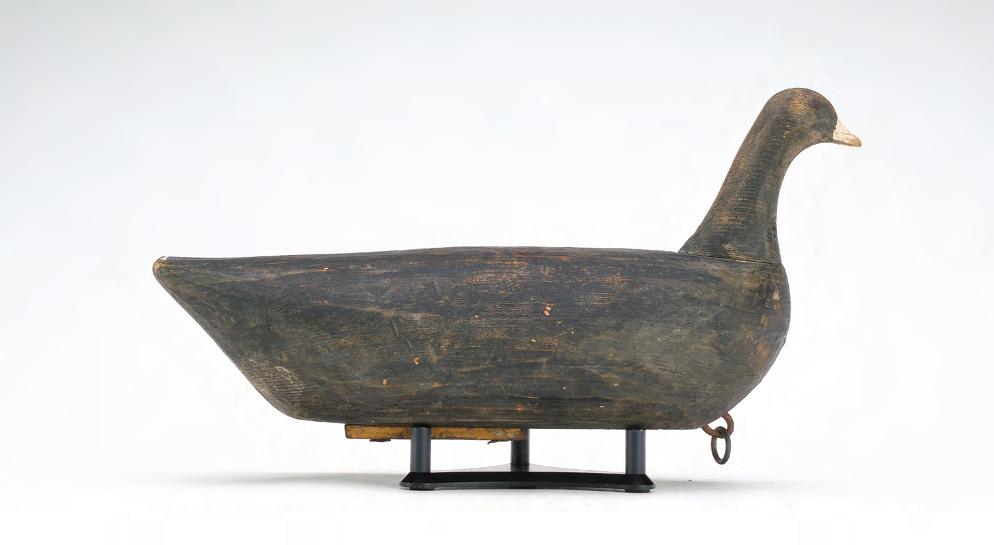
Provenance: Kroghie Andresen collection. Private southern collection.
Literature: “Gunnin’ Birds”, by Kroghie Andresen, page 235, exact decoys pictured. (1,200 - 1,800)
Provenance: Charlie Hunter III collection. Private southern collection.
Literature: “Gunnin’ Birds”, by Kroghie Andresen, page 151, similar decoy pictured. (3,000 - 5,000)
323c Alvin Aydlett (1883-1954), Spot, North Carolina. Pair of bluebills. Measures 15” long. Both show light gunning wear; decoy with lighter gray on sides has had a second coat more recent on the gray areas as well as some restoration and touchup to bill; otherwise both are in original paint. 323d Joe Hayman (1896-1974), Corolla, North Carolina. Swimming coot with forward head pose. Measures 13 1/4” long. Original paint with minor wear; hairline crack in bill, otherwise excellent structurally. 323c 323d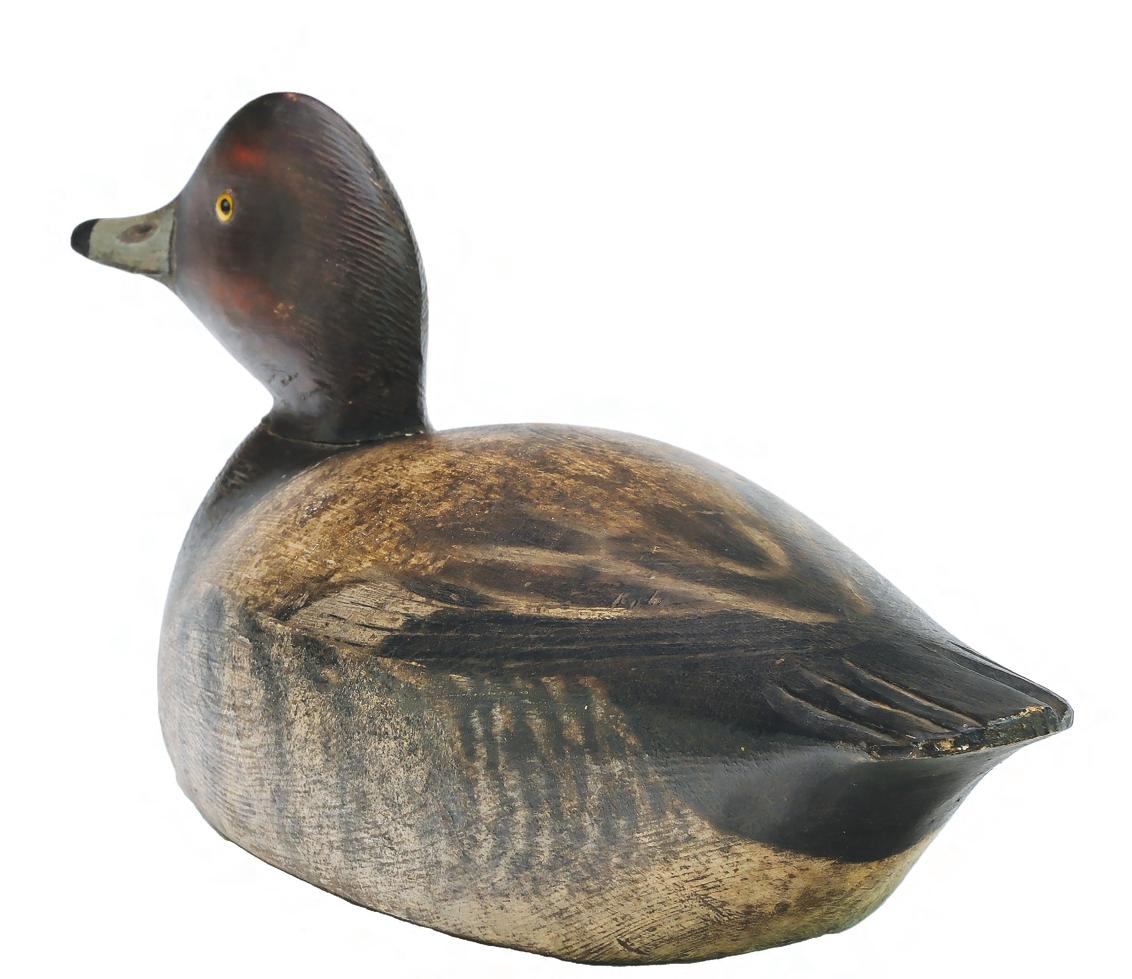
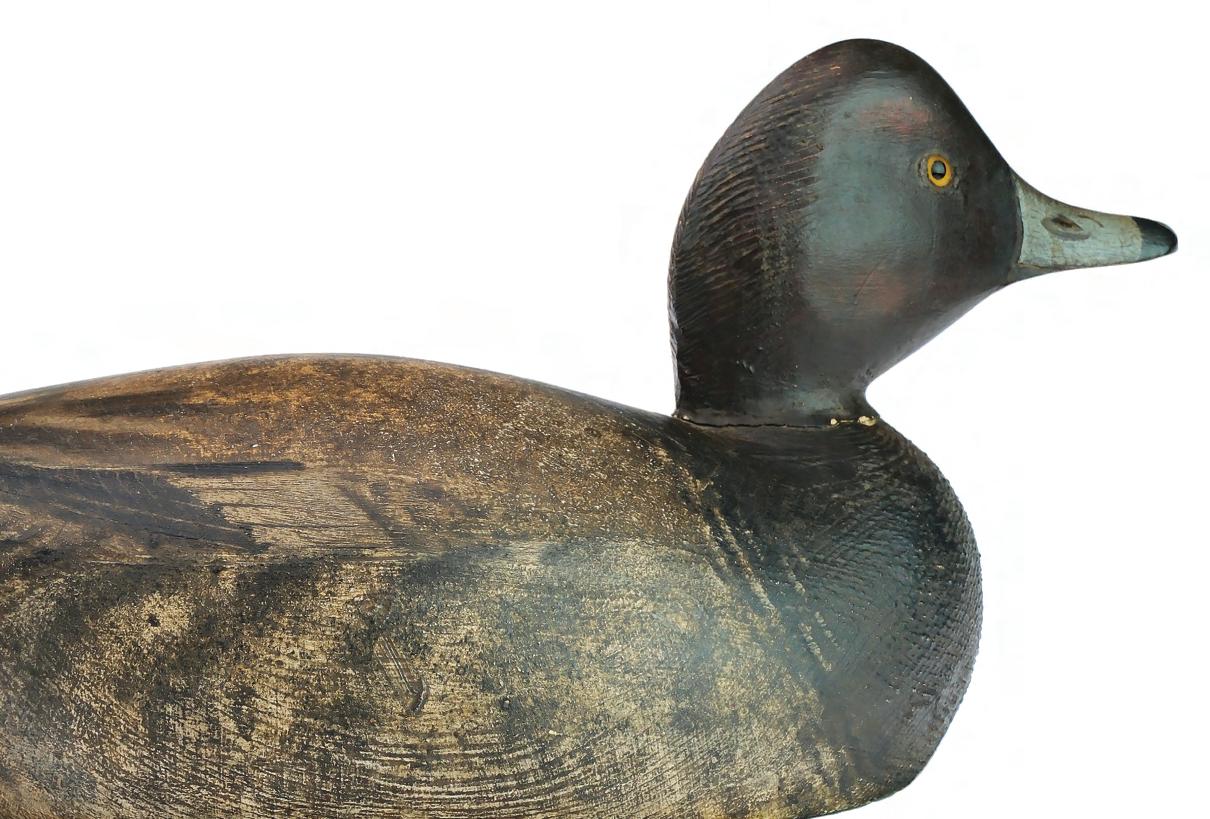
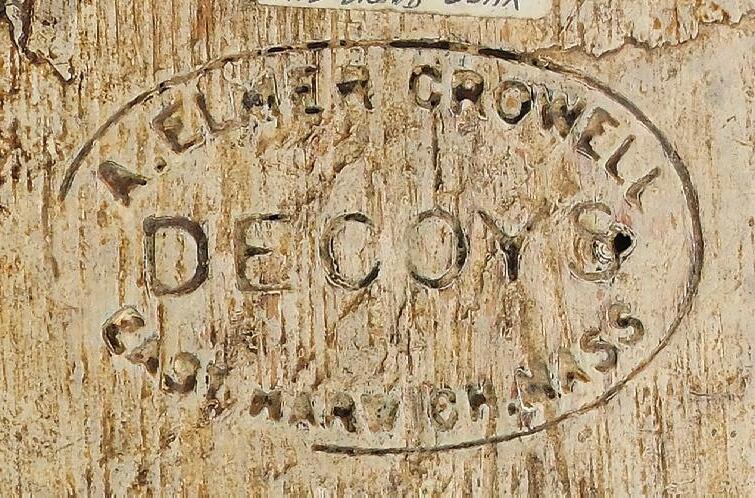
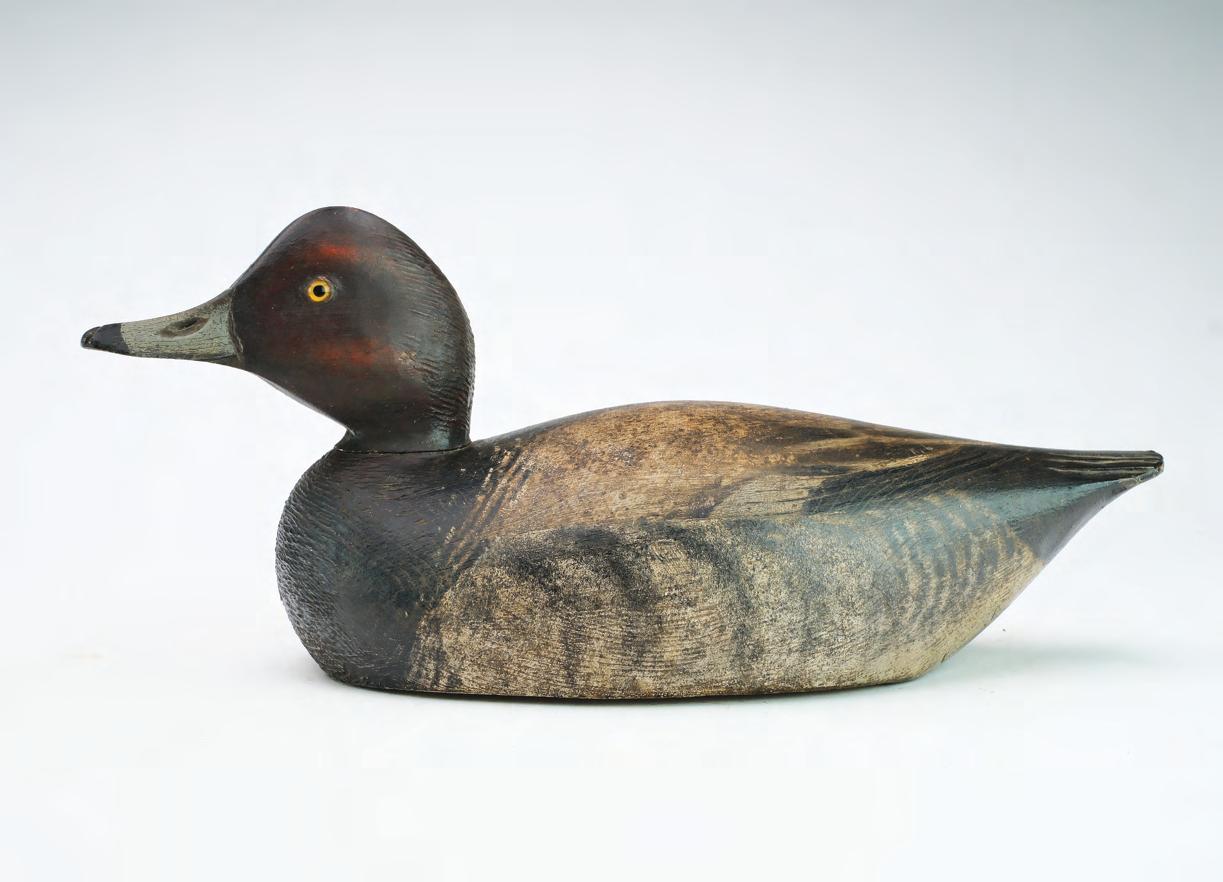
324 A. Elmer Crowell (1862-1952), East Harwich, Massachusetts. Excellent redhead with slightly turned and uplooking head pose. Oval brand. Relief carved tail feathers and feather rasping on back of head. Decoy was never rigged or weighted. Measures 16.25” long. Original paint with almost no wear; protected under a thin coat of early wax that has darkened slightly with age; a few tiny flakes of filler at neck seat, excellent structurally. (18,000 - 22,000)
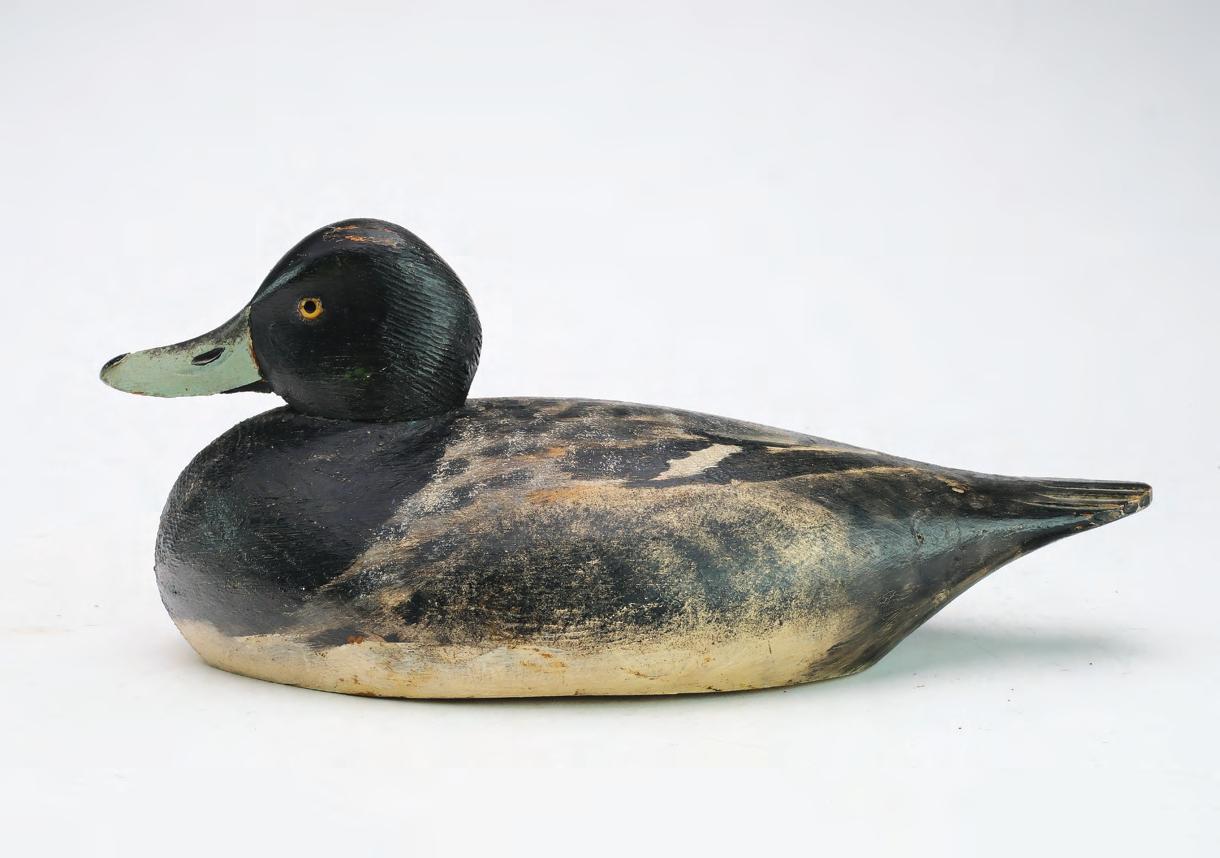

325 A. Elmer Crowell (1862-1952), East Harwich, Massachusetts. Excellent early bluebill with tucked and slightly turned head and relief tail feather carving. Unbranded underside with remnants of early newspaper. “Q” branded on the underside for the Quandy collection. Measures 14” long. Excellent original paint with very minor wear; dent on top of head and very minor roughness at tip of tail, otherwise excellent and original.
Provenance: Quandy collection. Private Massachusetts collection.
Literature: “New England Decoys”, by John and Shirley Delph, page 152, exact decoy pictured. (8,000 - 12,000)


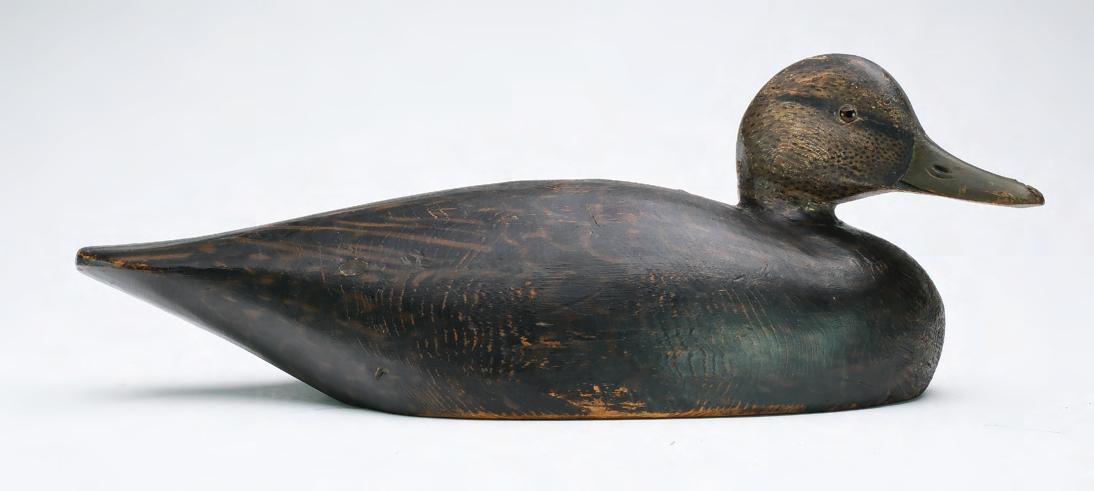
A.
Massachusetts. Black
with slightly turned head. Maker’s oval brand on the underside. Also branded ‘JHD’ for the collection of John Dunham. ‘Hoover’ painted on the underside for the Hoover rig. Measures 16.5” long. Original paint with minor flaking and wear; tight crack along the back; professional restoration to the base of neck.
Provenance: Hunting rig of William H. Hoover, a member at the Toussiant Shooting Club, Port Clinton, Ohio, and founder of The Hoover Company. John Dunham collection. (3,000 - 5,000)

Provenance: Randy Rall collection. (3,000 - 4,000)

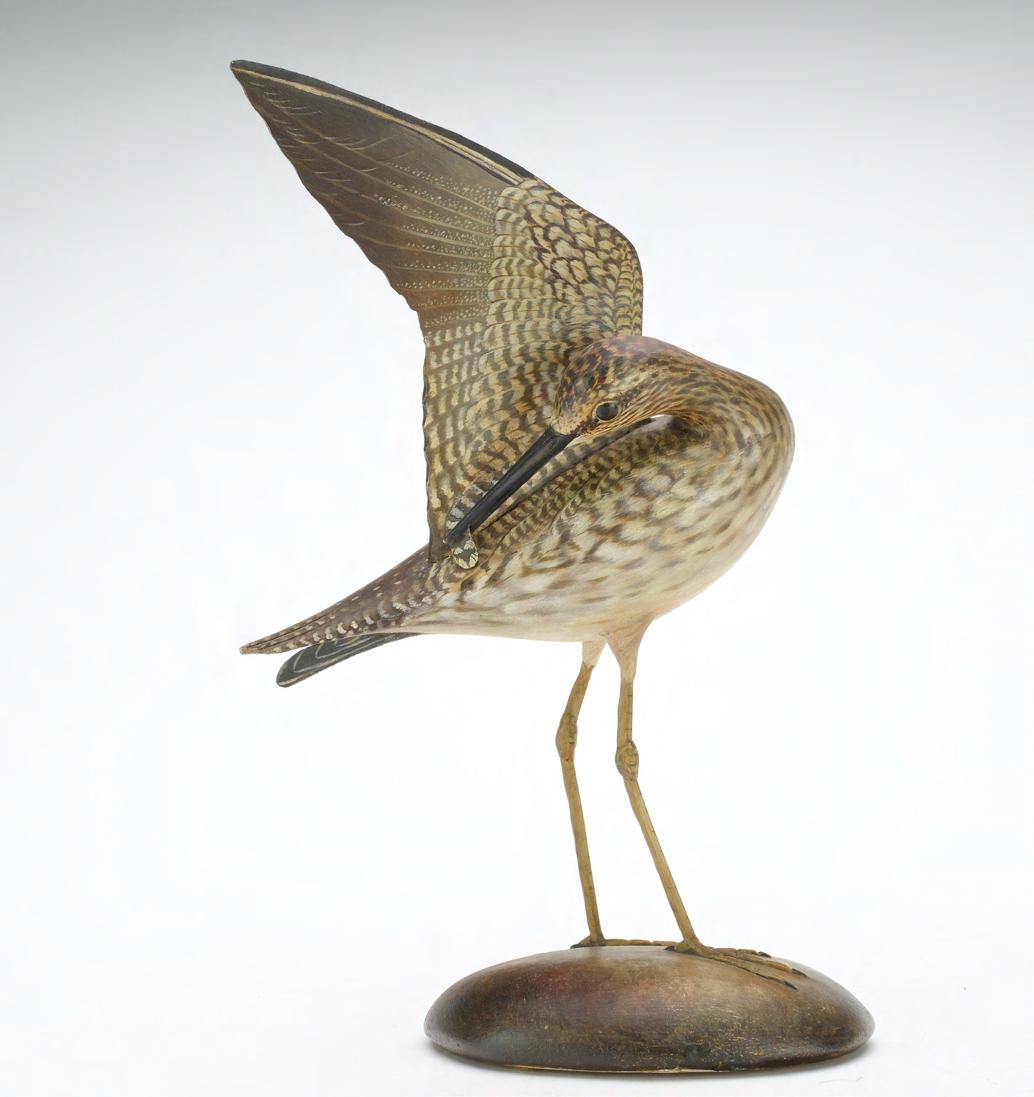

Massachusetts. Preening greater yellowlegs. Wing up model with head turned preening a single metal feather. Relief tail feather carving. Maker’s rectangle stamp on underside of base. Yellowlegs measures 8.25” long, 12.75” including base. Original paint under a thin coat of varnish; restoration to gesso thighs with touchup to paint on underside; thin band of restoration where wing meets the body; some filler and touchup where metal feather attaches to lifted wing; small spot of filler and touchup on breast.
(15,000 - 25,000)


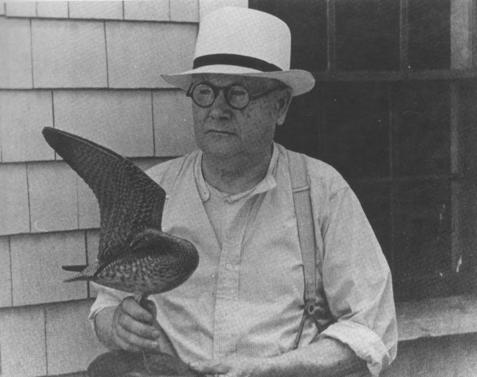


(12,000 - 18,000)
330 A. Elmer Crowell (1862-1952), East Harwich, Massachusetts. Full size preening lesser yellowlegs wth wing extended above head. Relief tail feather carving and excellent paint detail. Maker’s signature on underside of natural wood base. Measures 7” long, 8.75” to the top of wing. Excellent and original. 330331 A. Elmer Crowell (1862-1952), East Harwich, Massachusetts. Very rare wing up model sandpiper in preening pose. Maker’s rectangle stamp on underside of carved clam shell base. Measures 5.5” long, stands 7.75” tall. Excellent original paint with feather blending; professional repair to a small chip on tip and back of raised wing; jesso thighs have been restored.
Provenance: Randy Rall collection. (10,000 - 14,000)

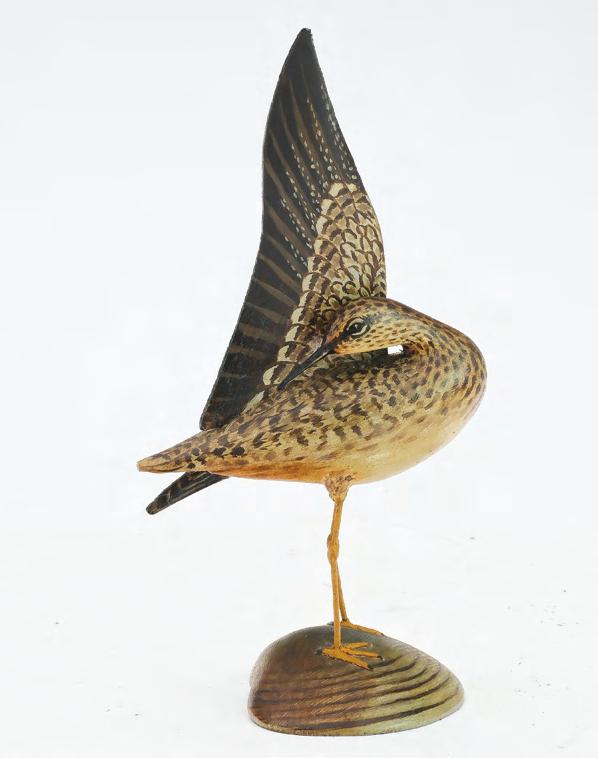
332 A. Elmer Crowell (1862-1952), East Harwich, Massachusetts. Very rare miniature preening yellowlegs with wing extended up over head. Maker’s rectangle stamp on the underside of the carved clam shell base. Measures 6.75” tall. Excellent original paint that has mellowed with age; some discoloration on underside of tail area; jesso thighs were restored at some point.
Provenance: Purchased from Crowell by his friend Arthur Gould. Consigned by a family member. (4,000 - 6,000)
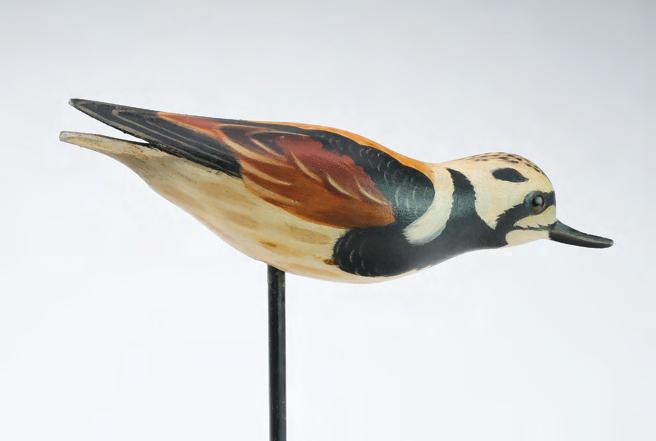
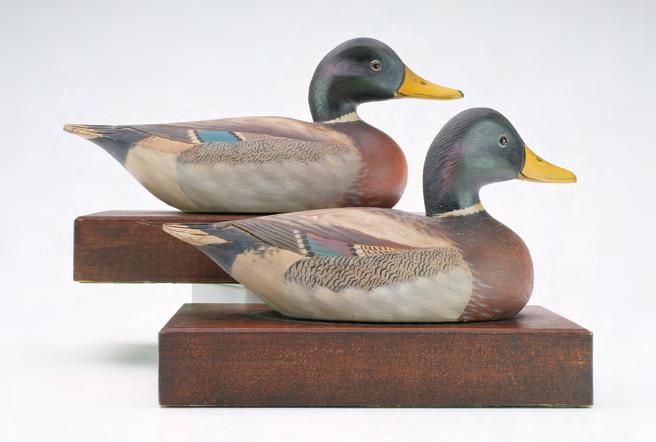

333 Cleon Crowell (1891-1961), East Harwich, Massachusetts. Rare, gunning style ruddy turnstone in running pose with split tail carving and appealing paint pattern. Measures 8” long. Filled shallow chip near stick hole in underside; otherwise near mint. (3,000 - 4,000)
334 A. Elmer Crowell (1862-1952), East Harwich, Massachusetts. Excellent set of 3/4 size mallard bookends. Each with relief wingtip and tail feather carving. Mounted to wooden bases with the maker’s rectangle stamp on one end. Measure 11” and 11.75” long. Minor scratches and rubs on wooden bases; and a small dent in one of mallard’s back, otherwise excellent. (3,000 - 5,000)
335 A. Elmer Crowell (1862-1952) and Cleon Crowell (1891-1961), East Harwich, Massachusetts. 3/4 size mallard wall mount. Slightly turned head and relief tail feather carving. One side is flat with inlayed brass hardware for mounting on wall. Maker’s rectangle stamp on the underside. Measures 12.75” long. Original paint by Cleon with minor flaking and paint rubs; a few shallow dents, otherwise very good structurally. (1,000 - 1,400)
A.
Massachusetts. Excellent pair of miniature hooded mergansers, with extended crests and raised wingtips. Blue paper label on the underside of drake. Hen is identified on the underside. Measure 3” long. A few tiny paint rubs, otherwise mint
Provenance: Purchased from Crowell by his friend Arthur Gould. Consigned by a family member. (3,000 - 4,000)



Pair of miniature running mergansers with extended necks and carved crests. Maker’s blue paper label on the underside of each. Measure 4.75” and 5.75” long. A few tiny paint rubs, otherwise mint.
Provenance: Purchased from Crowell by his friend Arthur Gould. Consigned by a family member. (3,000 - 4,000)

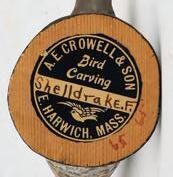
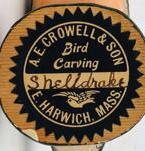
Outstanding pair of miniature redheads with raised wingtips and excellent feather blending. Maker’s blue paper label on the undersides. Measure 4.5” long. A few tiny paint rubs, otherwise mint.
Provenance: Purchased from Crowell by his friend Arthur Gould. Consigned by a family member. (3,000 - 4,000)

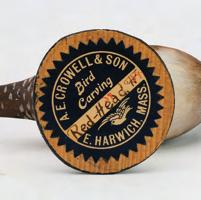
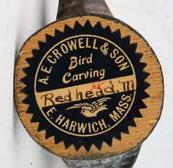 336
Elmer Crowell (1862-1952), East Harwich,
337 A. Elmer Crowell (1862-1952), East Harwich, Massachusetts.
338 A. Elmer Crowell (1862-1952), East Harwich, Massachusetts.
336
337
338
336
Elmer Crowell (1862-1952), East Harwich,
337 A. Elmer Crowell (1862-1952), East Harwich, Massachusetts.
338 A. Elmer Crowell (1862-1952), East Harwich, Massachusetts.
336
337
338



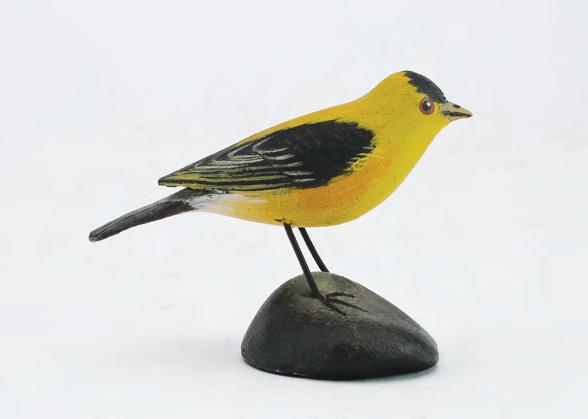


A.
East Harwich, Massachusetts. Miniature red-headed woodpecker. Raised wingtips and excellent paint detail. Maker’s blue paper label on the underside. Measures 3” long. Small spot of touchup near one eye, otherwise excellent and original. (1,500 - 2,500)
A.
East
Massachusetts. Miniature robin with raised wingtips and excellent paint detail. Maker’s blue paper label on underside. Measures 3.5” long. Excellent and original. (1,500 - 2,500)
341 A. Elmer Crowell (1862-1952), East Harwich, Massachusetts. Miniature goldfinch with raised wingtip carving. The number 11 in pencil on the underside. Measures 2.75” long. Excellent and original. (1,200 - 1,800)
342 A. Elmer Crowell (1862-1952), East Harwich, Massachusetts. Miniature scarlet tanager with raised wingtip carving. Underside of base is unmarked. Measures 2.5” long. Surface has darkened slightly; small chip in tip of bill; otherwise very good. (1,000 - 1,400)


343 A. Elmer Crowell (1862-1952), East Harwich, Massachusetts. Miniature owl with relief wing carving and raised head feathers. Maker’s rectangle stamp on the underside. Stands 5.75” tall, including base. Original paint with spot of crazing on tail; old chips on the front of each leg; minor roughness and chipping on the edge of each head feather.
Provenance: Purchased from Crowell by his friend Arthur Gould. Consigned by a family member. (3,000 - 5,000)
344 A. Elmer Crowell (1862-1952), East Harwich, Massachusetts. Full size chickadee on branch with pine cone. In feeding pose with raised wingtips and plump body. Measures 4” long. Small rub on one side of head was darkened, otherwise excellent and original.
(3,000 - 4,000)


345 A. Elmer Crowell (1862-1952), East Harwich, Massachusetts. Half size tern with split tail carving. Signed on the underside of driftwood base. Measures 6.5” long. Excellent and original. (2,000 - 3,000)
346 A. Elmer Crowell (1862-1952), East Harwich, Massachusetts. Miniature gull with tucked head and raised wingtip carving. Signed “A.E. Crowell and Son” on the underside of drift wood base. Measures 5.5” long. Very minor roughness on tip of bill, otherwise excellent and original.
(1,200 - 1,800)

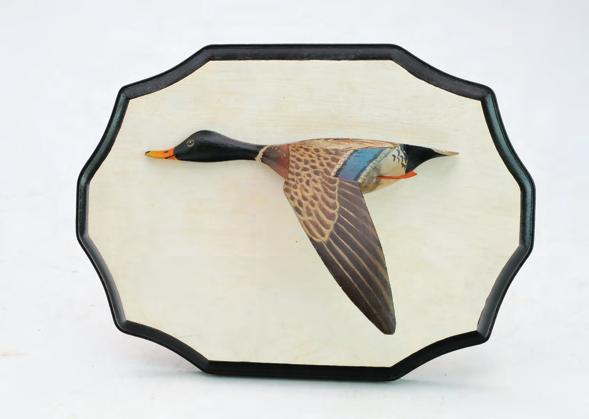

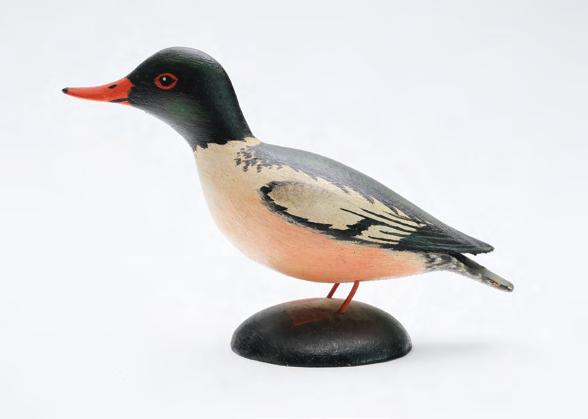
347 A. Elmer Crowell (1862-1952), East Harwich, Massachusetts. Pair of miniature mallards mounted on a single base. Drake in feeding pose, hen with slightly turned head. Maker’s rectangle stamp on the underside. Birds measures 4” and 5.5” long, base measures 6” across. Very small amount of old glue visible on one side of hen’s neck seat, otherwise near mint.
Provenance: Purchased from Crowell by his friend Arthur Gould. Consigned by a family member. (2,000 - 3,000)
348 A. Elmer Crowell (1862-1952), East Harwich, Massachusetts. Larger size miniature mallard with raised wingtips. Maker’s rectangle stamp on the underside. Also signed and identified on the underside. Measures 5.75” long. A few tiny paint rubs and tight crazing on upper breast, otherwise excellent. (1,200 - 1,800)
349 A. Elmer Crowell (1862-1952), East Harwich, Massachusetts. Miniature flying mallard on plaque. Applied wing and foot. Excellent paint detail. Mallard measures 6.5” long. Plaque is 9.5” wide. Very good and original.
(1,200 - 1,800)
350 A. Elmer Crowell (1862-1952), East Harwich, Massachusetts. Miniature American merganser. Maker’s ink stamp is faintly visible on the underside. Measures 5” long. A few tiny paint rubs, otherwise near mint.
(1,200 - 1,800)
Rare 1/3 size swimming Canada goose. Ex Shelburne Museum collection, with ink stamp and red inventory number on the underside. Measures 14” long. Near mint original paint protected under a thin coat of early varnish; two tiny white spots on the back of neck; tiny paint rub on the tip of bill; otherwise excellent.
Literature: “New England Decoys”, Shirley and John Delph, page 138-139, exact one of two geese pictured.
(5,000 - 8,000)
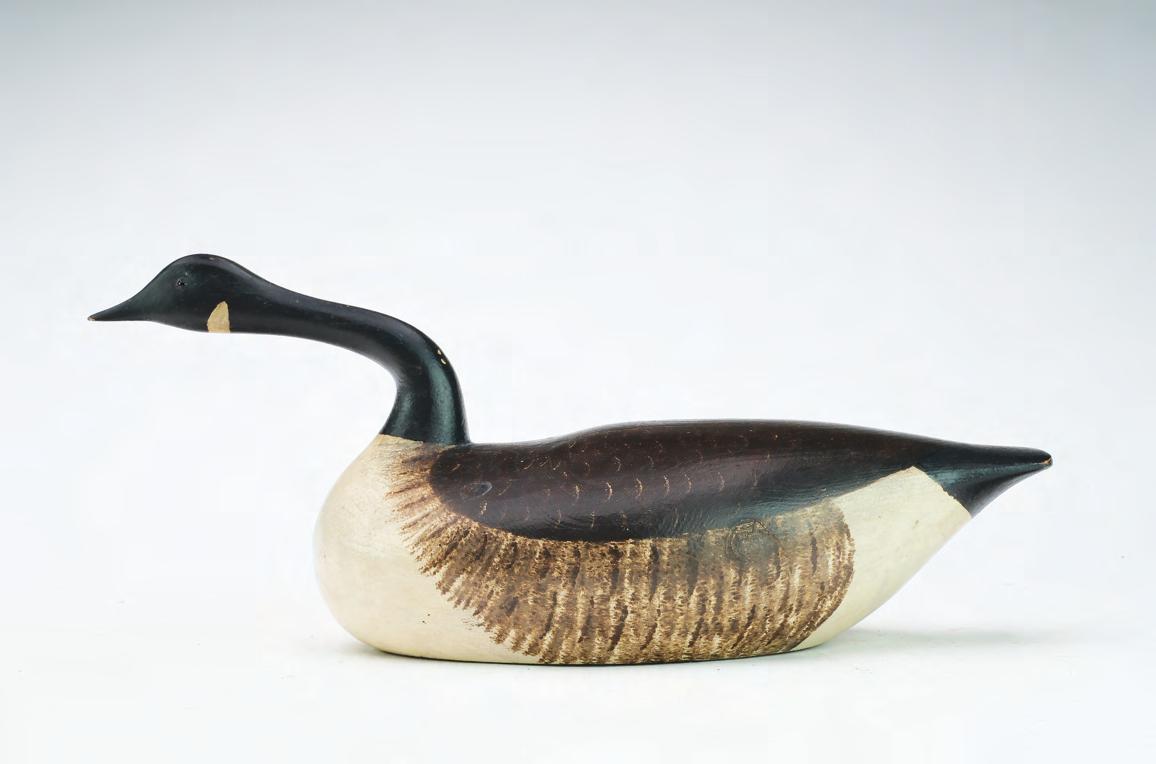

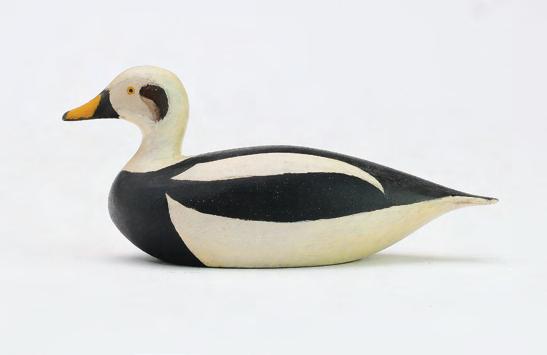
Near mint miniature swimming Canada goose with excellent paint detail. Unmarked underside. Measures 6.5” long. Surface has mellowed slightly with age; near mint. (2,500 - 3,500)
Excellent miniature long tail duck with the maker’s ink stamp on the underside. Measures just under 4” long. Excellent and original. (1,500 - 2,500)
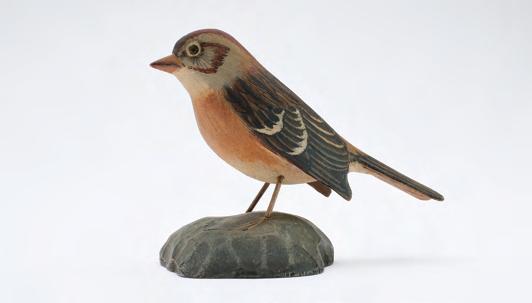

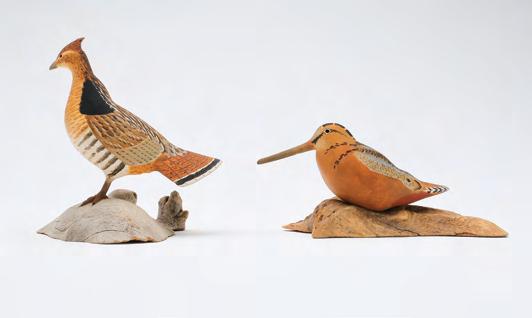
354 Jess Blackstone (1909-1988), Concord, New Hampshire. Miniature field sparrow with dropped wing carving and feather rasping. Identified and number 6526 on the underside. Measures 3.75” long. Very good and original. (600 - 900)
355 Jess Blackstone (1909-1988), Concord, New Hampshire. Miniature kinglet with typical feather rasping. Identified and number 238 on the underside. Measures 3.5” long. Professional bill chip repair, otherwise very good and original. (400 - 600)
356 Harold Gibbs (1886-1970), Barrington, Rhode Island. Miniature ruffed grouse and woodcock. Both are signed on the underside. Grouse with extended head feathers and fanned out tail. Measure 3” long. Excellent and original. (1,000 - 1,400)



357 Jess Blackstone (1909-1988), Concord, New Hampshire. Miniature purple finch with raised wingtips and feather rasping. Identified and numbered 212 on the underside. Measures 3.5” long. Professional bill chip repair, otherwise excellent. (400 - 600)
358 Jess Blackstone (1909-1988), Concord, New Hampshire. Miniature chickadee with feather rasping. Identified and numbered 2113 on the underside. Measures 3.5” long. Excellent and original. (600 - 900)
359 Harold Gibbs (1886-1970), Barrington, Rhode Island. Two miniature owls on natural wooden bases. Signed and dated 1970. Measures 3” and 3.5” to the top of each bird. Larger owl is missing a few toes, otherwise very good and original.
Provenance: Purchased from Crowell by his friend Arthur Gould. Consigned by a family member. (400 - 600)
360 George Bacon (1861-1925), Burlington, Vermont. Rigmate pair of goldeneye with slightly turned heads and appealing paint detail. Wide cheek carving. Measure 13” long. Original paint with moderate gunning wear; excellent structurally; very nice examples of this maker’s work.
Provenance: Randy Rall collection. (1,200 - 1,800)
361 Augustus Aaron Wilson (18641950), South Portland, Maine. Scoter with deep relief wingtip carving and inlaid neck seat. Head is slightly turned with relief bill carving and carved eyes. Measures 19” long. Original paint with moderate gunning wear; some roughness on high points of wings; approximately half the bill is a replacement.
Provenance: Randy Rall collection. (1,000 - 1,500)

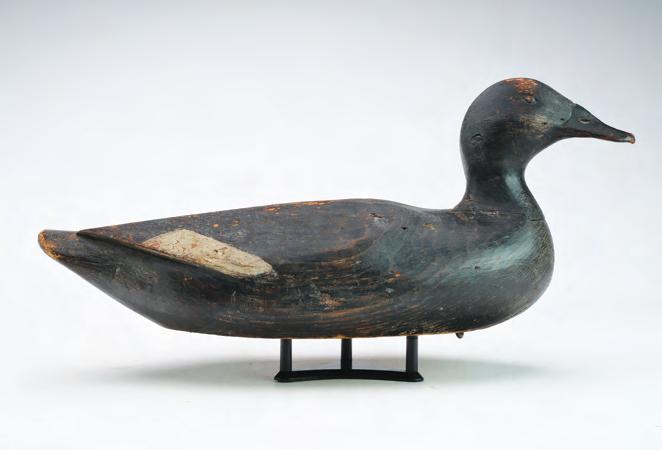
Keyes
Oaks Bluff, Massachusetts. Redhead hen and drake with slightly turned heads. Drake with round inlaid lead weight on the underside. Measure 14.5” long. Original paint with moderate crazing and wear; discoloration at one of hen’s wing patches; both are very good structurally. (800 - 1,200)
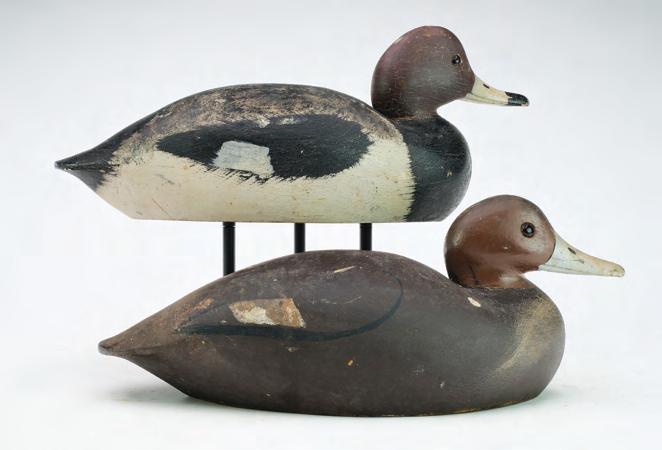
Born in Salem, the son of Captain William Fabens, Samuel made his first ocean voyage when, barely in his teens, he sailed aboard one of his father’s ships, The “Tarquin” as a cabin boy. On the very next voyage, he had advanced to the rank of “Mate” and would spend the remainder of his working life traveling the oceans of the world as a master mariner. In 1848 he married Mary Glover in Salem and the couple had seven children. Between 1834 and 1850 he made 16 voyages aboard the ship “Ariosto” owned by Samuel and F.H. Grey of New York. By 1851, he was part owner of the Bark “Wessacumcon” and in 1852, he supervised the building and outfitting of his ship “Golden Eagle” . In his later years, he commanded the clipper ships “Challenge” and “Ganges” . Beginning with the 1870 census until the time of his death, he is listed as a “retired master mariner” , active in Town affairs, and living on upscale Washington Square, overlooking the harbor, in Marblehead.
There is some discussion as to whether Fabens actually made the decoys attributed to him or were they carved by one of his ship’s carpenters or someone else? Fabens was a known waterfowler. He is documented as gunning during the mid to late 1800’s at the Ives camp in Rowley along with another notable early north shore sea Captain, hunter, and decoy carver, Charles C Osgood (1820 – 1886). We do have documented proof that Fabens was familiar with woodworking and, thus, the skills needed to produce decoys. As mentioned, he oversaw the construction of the “Golden Eagle” and a period article in the Fitchburg (Massachusetts) Sentinel states that one Roby Fletcher, while serving with Captain Fabens aboard the “Golden Eagle” , made, among other items, “a pair of rosewood planes for the Captain”
Like others of his time period on the North Shore and elsewhere, pertinent literature is scant. We may never know if the Captain actually carved the decoys that bear his brand and are attributed to his hand. However, until proven otherwise, we can rest on the long accepted oral tradition which credits Samuel Fabens with these exceptional carvings.
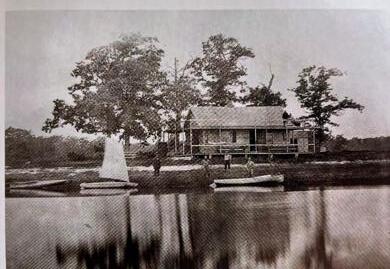

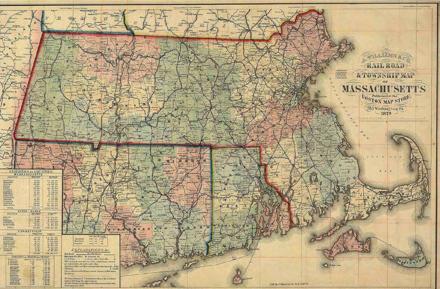



363 Captain Samuel Fabens (1813-1899), Marblehead, Massachusetts. Very rare merganser hen. Hollow carved with extended crest and wooden Marblehead style keel. Measures 17.5” long. Original paint with moderate gunning wear; added feather looping was cleaned off of back; moderately hit by shot; thin line of touchup on back; eyes are professional replacements; wooden crest feather is professionally replaced with touchup in the area; a shot strike in top of bill; has caused a fine hairline crack; wooden keel is a professional replacement by Russ Allen; head was loose and he reglued the neck seat.
(30,000 - 50,000)

“ - - - in the ‘Great Storm of 1898’ a schooner floundered on S eguin Island about five miles off the mouth of the Kennebec River. The keeper of the Seguin Light was - - - Captain Pinkham. By 1900 he had finally s alvaged the schooner’s pine bowsprit and made the eiders - - -.
- Dr George R Starr“Doc Starr was told the above story when he obtained his pair of Pinkham eiders. The actual wreck, however, was the two masted schooner Lavinia Belle which washed up on the southeast side of Seguin, 2 ½ miles off the Maine coast on June 19th, 1898, not in “the great storm” of November that year.
Merritt was born in Southport on the midcoast of Maine and would spend his entire life in that section of the State. At the age of 19 he was living with his parents and working as a fisherman. In 1886, he married Mary C Marr and they had two children while Merritt was beginning his tenure at Seguin Island Light Station, first as a 2nd assistant in 1889, and rapidly advancing to 1st assistant. In 1890, he became head keeper of the station and would remain in that position for the next eight years.
Located two and a half lonely miles off the legendary rocky shore, Seguin Island is considered to be in one of the foggiest sections of the Maine coast, and the sea conditions there are notoriously rough. The light is on an elevated portion of the island and has one of the most powerful beacons and fog horns in the State. For many years, supplies were ferried to the island and laboriously hauled uphill to the station with oxen. This was eased in 1895 when a quarter mile long railway was constructed from the landing to the light.
During Pinkam’s tenure at Seguin, Mary died in 1886 and he remarried in 1900 when he wed Isa C Stinson, eventually having two additional children with her. When he left the Island in late 1900, he assumed a position at Doubling Point Light at the mouth of the Kennebec River and is recorded as being in that position from at least 1910 through 1940. After a noteworthy career of 52 years with the Lighthouse Service and the Coast Guard (who assumed control of the lights in 1939) he retired in 1941 and he and Isa moved to North Berwick where he died at age 85.

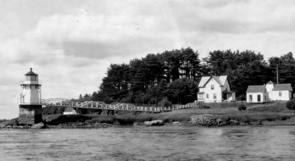
Merritt’s small (and possibly singular rig of only 14 decoys) are icons of Downeast eider design and construction. Rugged birds with simple lines and inlet heads for strength and durability, they were ideally suited to the challenging conditions that the coast presented. They are all that an eider decoy needed to be and nothing more, yet they carry a grace and presence that gives them a universal appeal.
Guyette and Deeter wish to thank The Friends of Seguin Island Light Station for their research assistance.
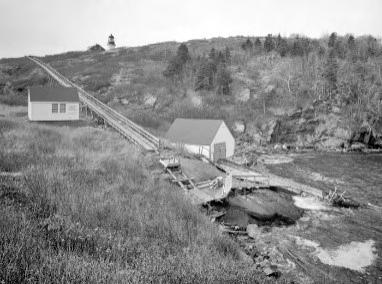

Thought to be Keeper Pinkham & 2nd Keeper Herbert Spinney with their wives and friends
364 Captain Merritt P. Pinkam (1861-1947), Seguin Island, Maine. Oversize eider drake with large inlaid neck seat. Captain Pinkam made a rig of 14 eider decoys from the bowsprit of a schooner that had washed up on Seguin Island in 1898. Measures 23” long. Original paint with moderate flaking and wear, mostly around head and neck seat area; tight drying cracks in body; crack in one side of neck; old chip in the underside of bill.
Provenance: Frank Ash collection. Hal Evans collection. Robinson Bosworth collection. Thompson Bosworth collection. Private Tennessee collection. (5,000 - 8,000)

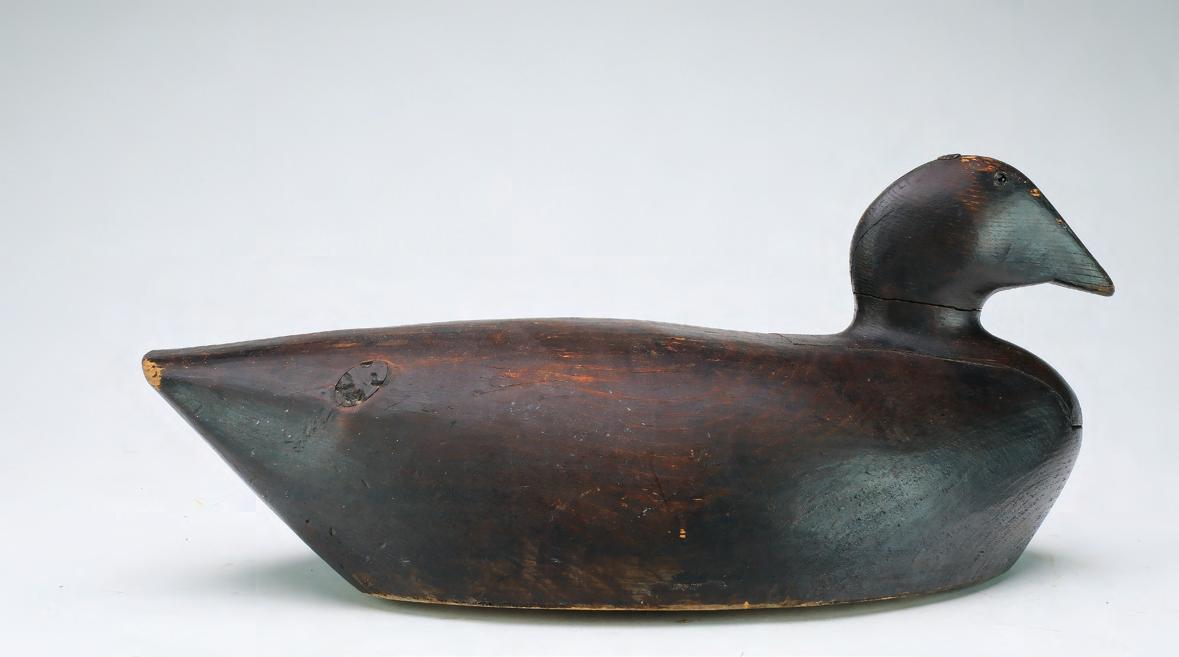
365 Captain Merritt P. Pinkam (1861-1947), Seguin Island, Maine. Very rare oversize eider hen with large inlaid neck seat. Mackey collection ink stamp on underside. Measures 21” long. Decoy had a thin layer of scoter paint cleaned down to the original eider paint showing moderate gunning wear; crack in neck; tight cracks in bill.
Provenance: Mackey collection. Private Tennessee collection.
(3,000 - 5,000)

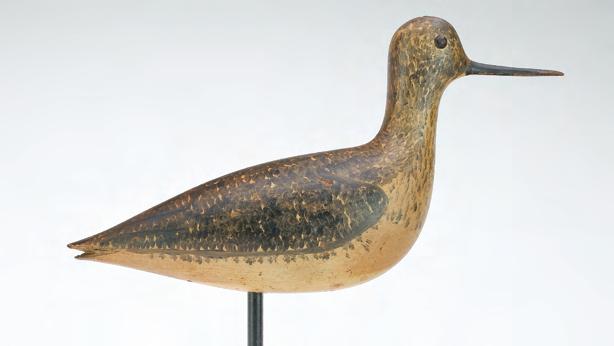


367 George Boyd (1873-1941), Seabrook, New Hampshire. Rare black bellied plover in emerging plumage. Slight running pose and split tail carving. George Ross Starr collection ink stamp on the underside. Measures 11” long. Excellent original paint with almost no wear; heavily hit by shot; repair to a small chip at the very tip of bill with small amount of touchup.
(3,000 - 5,000)
368 George Boyd (1873-1941), Seabrook, New Hampshire. Yellowlegs with split tail carving. George Ross Starr collection ink stamp on underside. Measures 11” long. Original paint with minor wear under an early coat of varnish that has darkened with age; a few small dents, otherwise excellent structurally.
Literature: “Decoys of the Atlantic Flyway”, by Dr. George Ross Starr, page 87, exact decoy pictured. (2,000 - 3,000)
369 Unknown maker, Kingston, Massachusetts, circa 1900. Yellowlegs with relief wing and split tail carving similar to the work of Lothrop Holmes. Carrying hole drilled through the tail. Measures 12” long. Original paint with minor gunning wear; moderately hit by shot; professional neck crack repair; repair to a crack in the bill.
Provenance: Randy Rall collection. (1,000 - 1,500)
370 Unknown maker, Massachusetts, last quarter 19th century. Golden plover with split tail carving. Measures 10.5” long. Original paint with minor flaking and wear under an early coat of varnish; tiny flake where bill meets face; some roughness on wingtips have been darkened.
(1,000 - 1,500)
367 369 368 370
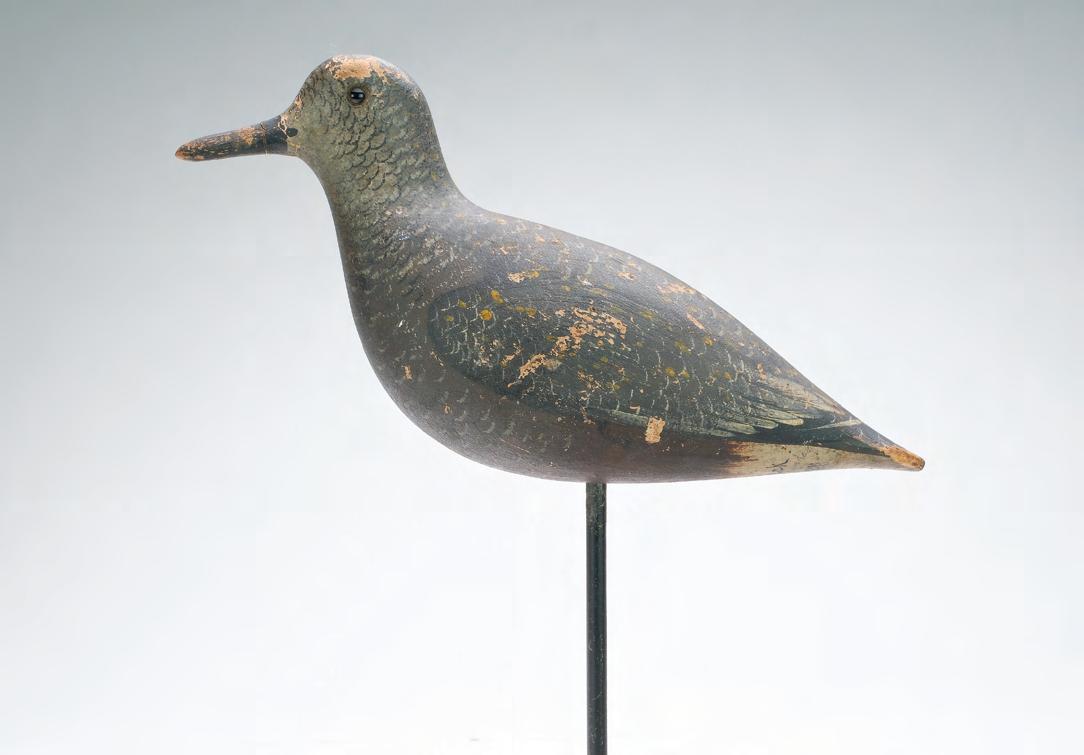
Long Island, New York. Plover with excellent feather paint detail. Green back plover written on the underside. Measures 10” long. Original paint with moderate flaking and wear; fine hairline cracks where hardwood bill meets face, otherwise excellent structurally. (8,000 - 12,000)
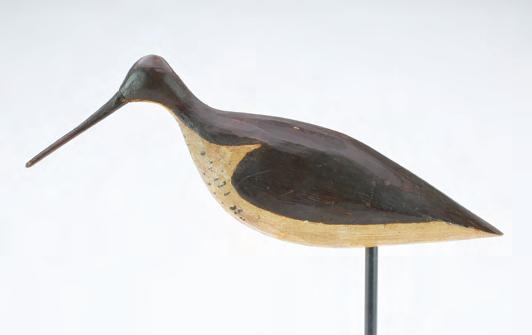

. Yellowlegs. Markings on underside indicate decoy was at one time in Gary Giberson’s collection. Mort Hanson collection stamp on underside as well. Measures 11.25” long. Original paint with minor discoloration and wear.
Provenance: Mort Hanson collection. Gary Giberson collection. Private Texas collection. (4,000 - 6,000)
Small robin snipe. Measures 8” long. Original paint with moderate discoloration and wear; lightly hit by shot; thin wash of black on the original bill and one eye.
(2,500 - 3,500)
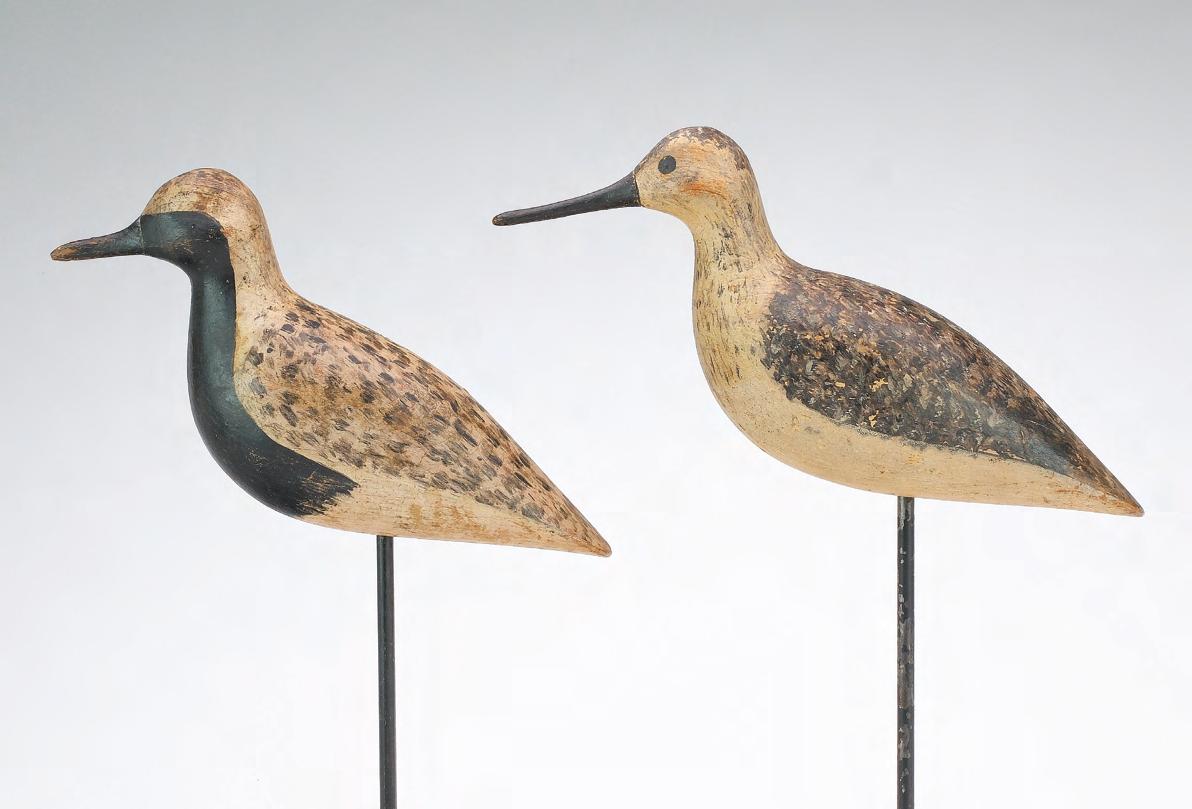
374 Harry V.
(1861-1920), Tuckerton, New Jersey. Black bellied plover in summer plumage. From the personal gunning rig of Harry M. Shourds, son of the maker. Measures 9.5” long. Original paint with very minor wear; lightly hit by shot, otherwise very good structurally.
Provenance: Harry Mitchell Shourds hunting rig. Private Long Island collection. (8,000 - 12,000)

375 Harry V. Shourds (1861-1920), Tuckerton, New Jersey. Yellowlegs from the personal gunning rig of Harry M. Shourds, son of the maker. Measures 10.5” long. Original paint with very minor flaking and wear; under a thin coat of varnish; excellent structurally.
Provenance: Harry Mitchell Shourds hunting rig. Private Long Island collection. (8,000 - 12,000)
 Shourds
Shourds

376 Harry V. Shourds (1861-1920), Tuckerton, New Jersey. Rare black bellied plover in eclipse plumage. A fat body bird with appealing paint pattern. Identified in faint red ink near the stick hole. Measures 9.5” long. Original paint with minor to moderate gunning wear, mostly on each lower side; very fine hairline drying cracks, otherwise excellent structurally.
Provenance: John Hillman collection. Private Long Island collection. (10,000 - 14,000)
377 Harry V. Shourds (1861-1920), Tuckerton, New Jersey. Robin snipe from the hunting rig of Ash Milner. Measures 9” long. Original paint with minor gunning wear; heavily hit by a small shot in one side; otherwise very good structurally.
Provenance: Ash Milner rig. Private Long Island collection. (10,000 - 14,000)



Born in Tuckerton, Harry M (aka “Mitchell”) attended the local schools, attaining a basic 6th grade education. As a young man, he apprenticed under the watchful eye of his father, master decoy carver Harry V Shourds. In 1910, at age 19, he was working as a painter in Tuckerton, living with his parents while his father worked as a carpenter. In 1912, he married Luetta Loder from Ocean City. Unfortunately, Luetta became sickly and eventually, a family friend, Martha Clemenson, was called upon to nurse the ailing young woman. Sadly, Luetta passed away in 1922 and, one year later, Harry married Martha and they would raise a family of four children of their own.
Initially, Shourds did whatever was necessary to provide for the family. He hunted and fished, harvested shellfish, and trapped, both for additional income and food. By 1922 he had established himself as a successful painter in Ocean City. He loved the outdoors, especially enjoying small game and upland birds over his beagles and setters. He had duck hunted with his father and this would eventually lead to his providing guiding services. Obviously, this required decoys and he began to carve his own. As one would expect, his carvings very closely followed the patterns developed so successfully by his father. Harry worked out of a small fisherman’s shack which he had relocated to the rear of his home. Lacking power tools, he would rough out the bodies and use a simple coping saw to fashion the basic head shape. The decoys were then carefully finished, hollowed out and finely painted. Although he made far fewer decoys than did his father, he carved most of the species commonly sought in southern New Jersey. Unlike his mentor, however, he altered the pose of many of his decoys. Of all the decoys he produced, his geese must be considered quite rare. Many familiar with his work suggest that he probably only made a few small rigs (perhaps only 2) of this species.
He is remembered as a social individual who greatly enjoyed time with his wife and children. Unfortunately, he died young, suffering a stroke at the age of 52 (see note 1) .
Notes. 1.Records occasionally refer to his birth as 1891 and his obituary states that he was born in 1892. In both his WWI and WWII draft registration, however, he records (in his own hand) his birth as “Aug. 22, 1890”.
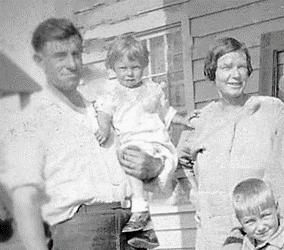

“- - - he left a legacy of finely crafted hunting decoys that will grace the shelves of collectors for all time” (Allen Linkchorst)

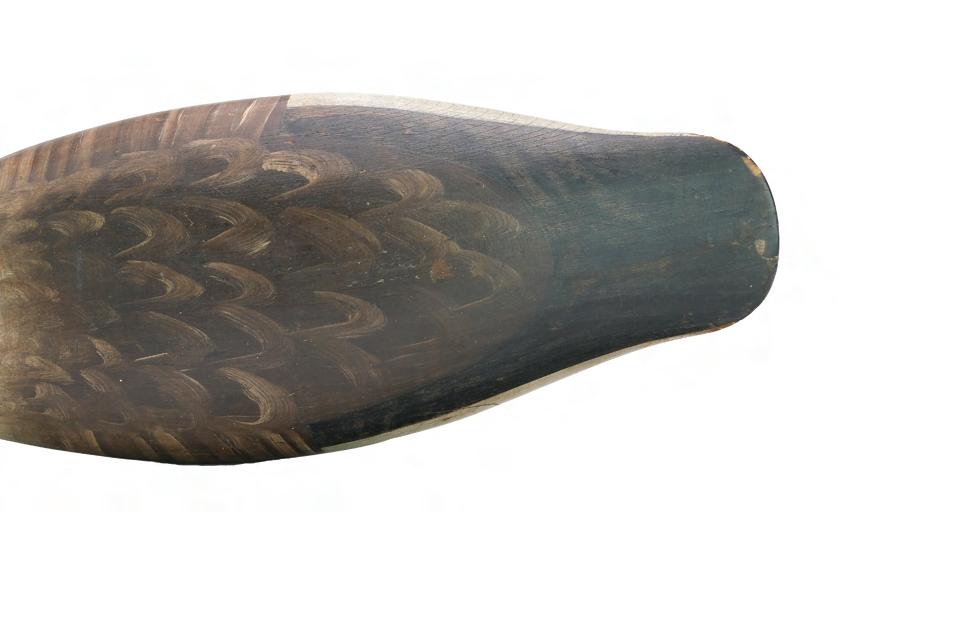

378 Harry M. Shourds (1890-1943), Ocean City, New Jersey. Extremely rare, hollow carved Canada goose with excellent paint detail. Mackey collection ink stamp on the underside. This decoy was part of the Mackey family collection, which were not sold at the Mackey sales in the 1970s, but retained by the family until 2007. Measures 23.75” long. Original paint with minor gunning wear; moderate flaking under tail area and underside; tight crack in bill; cracks in neck were tightened long
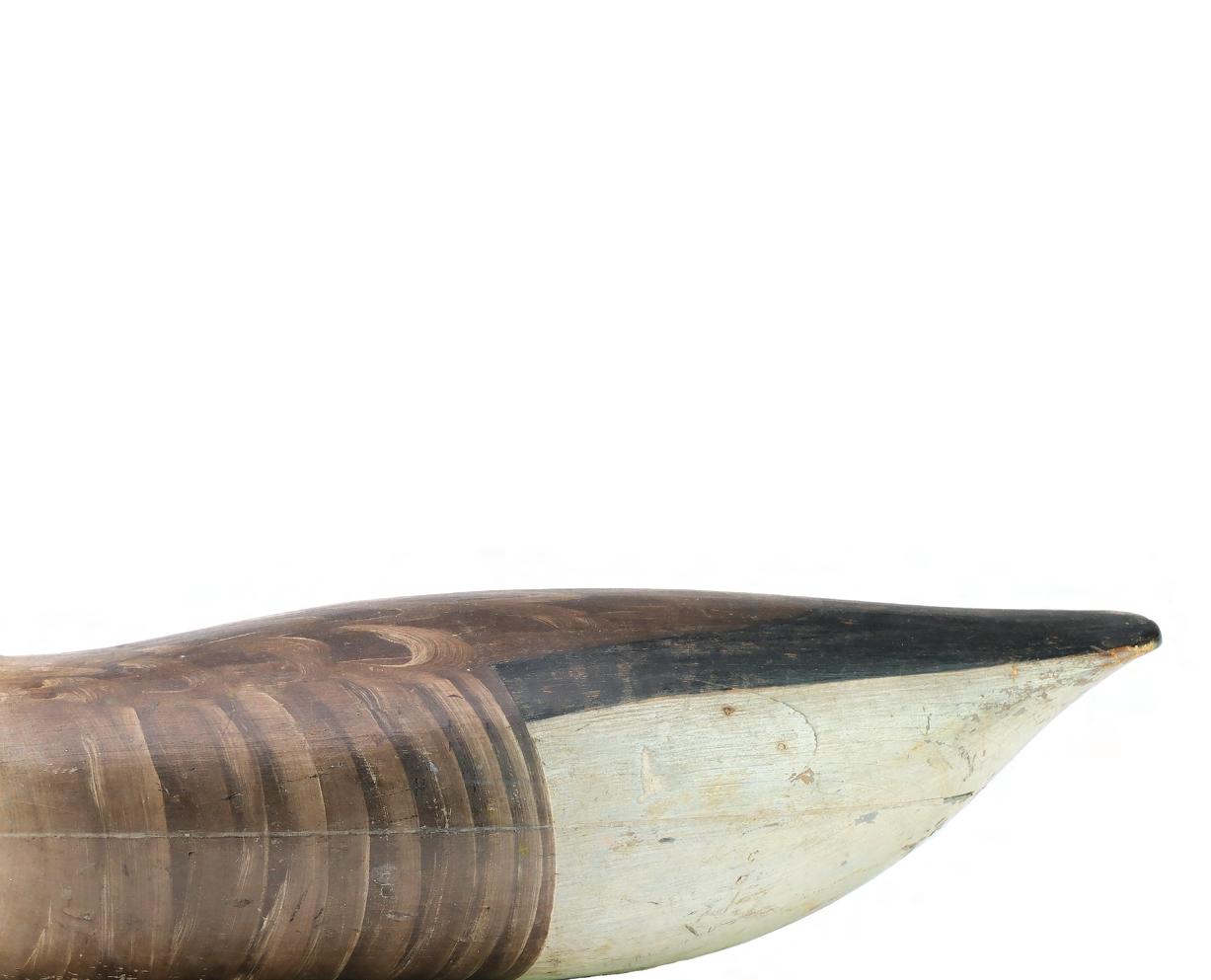
ago with small amount of touch up; among the best known examples.
Provenance: William J. Mackey Jr collection. Mackey family collection. Private southwest collection.
Literature: “Classic New Jersey Decoys”, by James Doherty Jr, page 77, exact decoy pictured.
(40,000 - 60,000)




379 Harry M. Shourds (1890-1943), Ocean City, New Jersey. Hollow carved black duck with scratch feather paint detail and tack eyes. Measures 16” long. Original paint with minor wear; very small amount of touch up on each side of the head; thin surface crack partway down back.
Provenance: Randy Rall collection.
(1,500 - 2,500)
380 Harry V. Shourds (1861-1920), Tuckerton, New Jersey. Hollow carved black duck with scratch feather paint detail and tack eyes. Measures 17” long. Original paint with minor to moderate wear under a thin coat of varnish; early repair to a crack in neck; hairline crack on one side of breast.
Provenance: Kirby Roberts collection. Randy Rall collection. (1,500 - 2,500)
381 Dude Crane, Tuckerton, New Jersey, early 20th century. Hollow carved Canada goose with low breast and high rump. Bill is doweled in through back of head. Brass tack eyes. Measures 24.5” long. Original paint with very minor wear that has darkened slightly under an early coat of varnish; very good structurally.
(3,500 - 4,500)
382 Unknown maker, South Jersey, late 19th century. Diminutive hollow carved bufflehead with raised neck seat. Measures 10” long. Early paint appears original with moderate flaking and wear and a thick coat of varnish that has discolored slightly; old chipping on tip of bill and top of head; minor roughness on tip of tail; body seam has opened slightly; crack in one side of neck seat.
Provenance: Noyes Museum collection. Gary Giberson collection. Al Marzorini collection. (600 - 900)

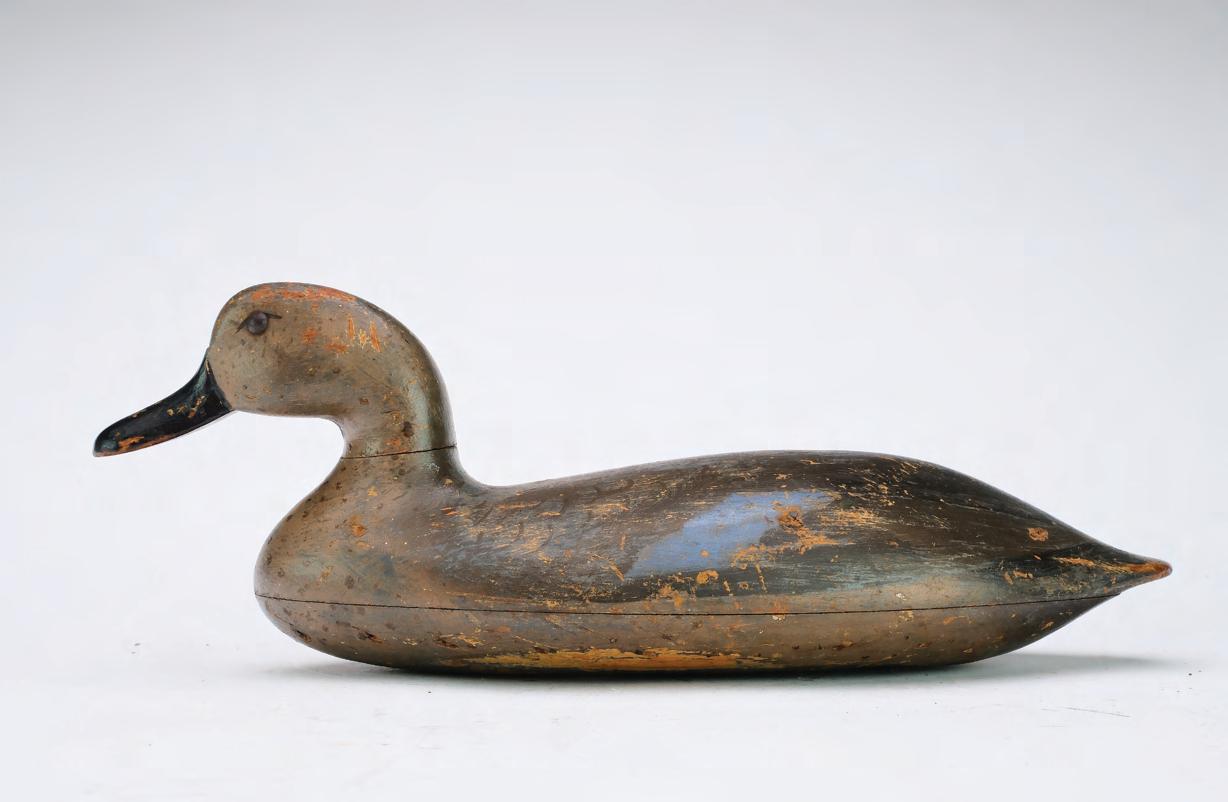
383 John Blair, Sr. (1842-1928), Philadelphia, Pennsylvania. Very rare bluewing teal hen. Hollow carved with two wooden plugs on the underside. “WHP Jr” branded on the underside for the collection of William Purnell. Measures 13.25” long. Original paint with moderate flaking and wear; small amount of early touch up on tip of bill; a few small dents, otherwise excellent structurally.
Provenance: William Purnell Jr collection. James Keegan collection. (15,000 - 25,000)
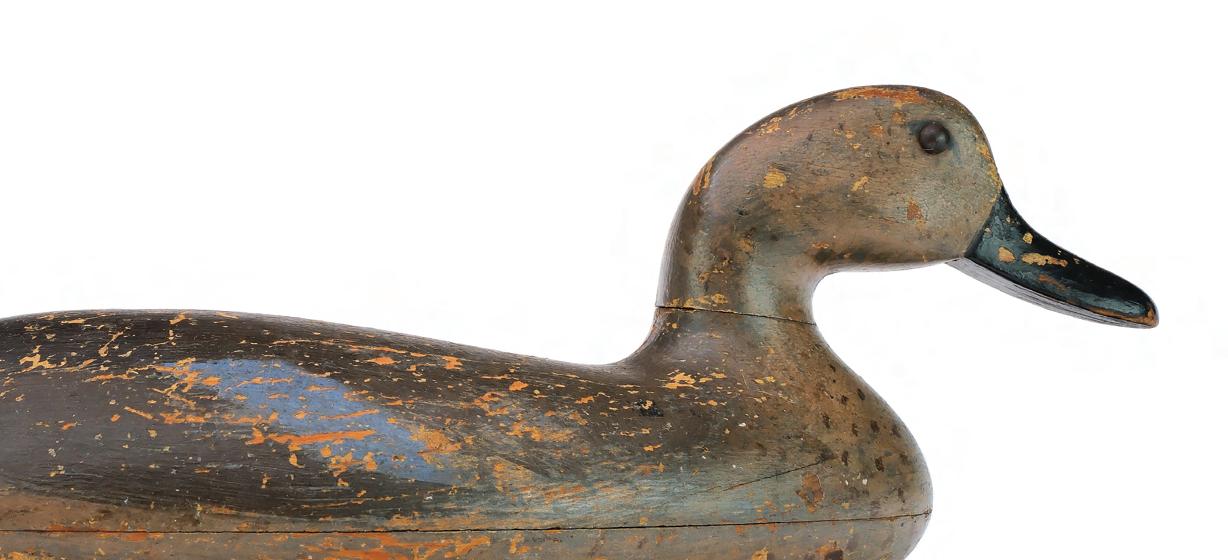
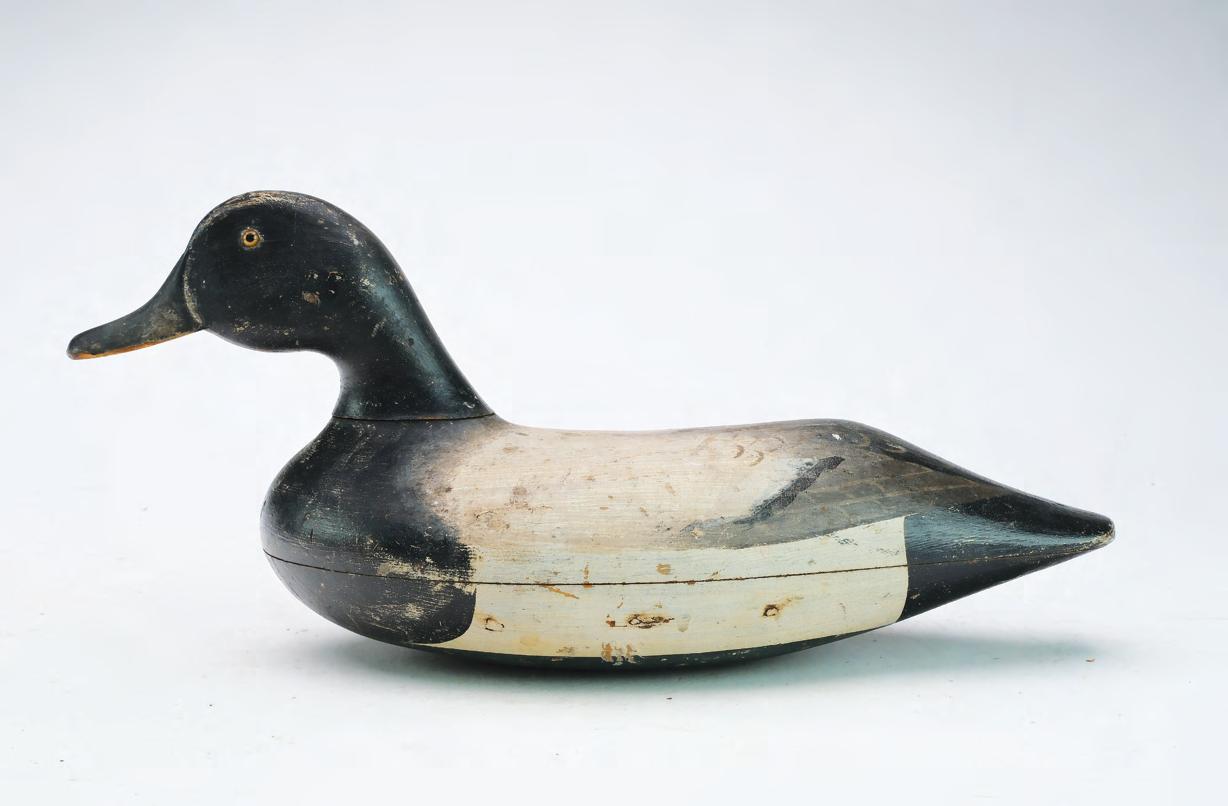

384 John Blair, Jr. (1881-1953), Philadelphia, Pennsylvania. Rare, hollow carved swimming bluebill. Measures 13.5” long. Original paint with minor to moderate wear; minor roughness on edge of bill, otherwise very good structurally. (6,000 - 9,000)


385 William Quinn (1915-1969), Yardley, Pennsylvania.
Excellent hollow carved black duck with raised V wingtips and incised back and tail feathers. Maker’s name in white paint on underside. “DSC” stamped on the underside for the Dave Campbell collection. Measures 16” long. Excellent original paint with almost no wear; very minor roughness on extremities; a very nice example.
Literature: Dave Campbell collection. Private collection. (5,000 - 8,000)
386 William Quinn (1915-1969), Yardley, Pennsylvania.
Excellent hollow carved black duck with tucked head and raised V wingtips. Incised back and tail feathers. Maker’s name in white paint on underside. Measures 16” long. Dent in one side of face; tight crack in the bill was professionally reset with small amount of touch up; otherwise near mint. (5,000 - 8,000)
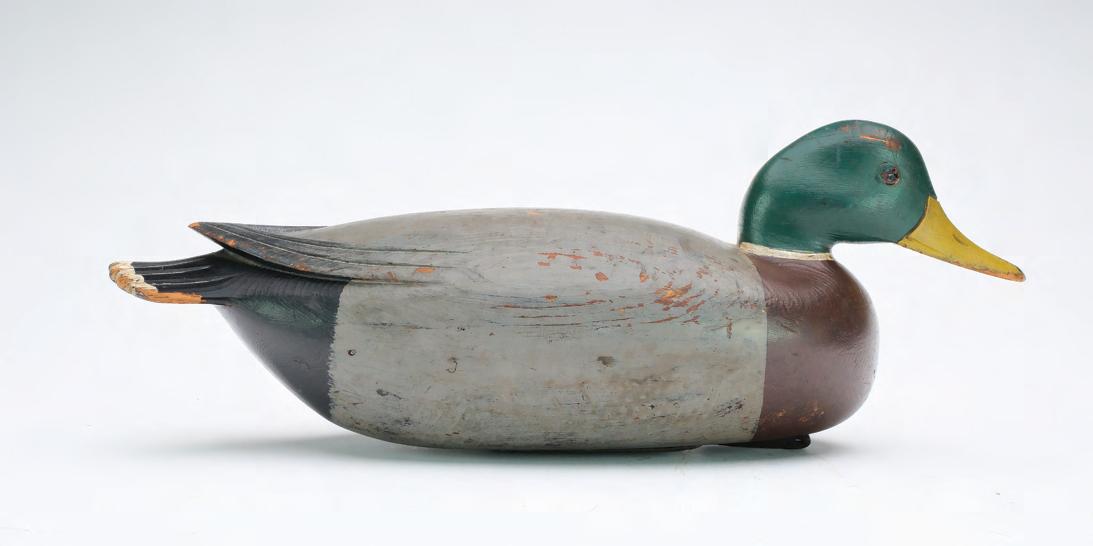

388 Dan English
Florence,
Hollow carved black duck with tucked head and raised V wingtip carving. Measures 15.75” long. Original paint with very minor wear under a thin coat of varnish; very good structurally. (2,000 - 3,000)
and shot marks; minor roughness on edge of bill. (2,000 - 3,000)
389 John McLoughin (1911-1985), Bordentown, New Jersey. Early, hollow carved pintail with comb feather paint detail and upswept tail. Measures 19.75” long. Original paint with very minor gunning wear; hairline crack in bill; very minor separation at body seam; white on breast is an early second coat. (1,200 - 1,800)
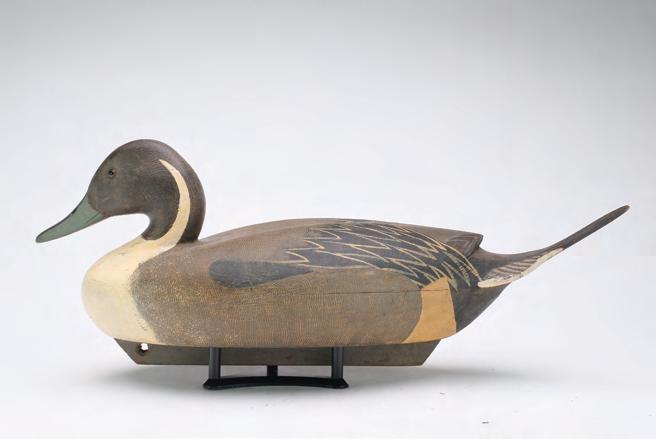
390 John McLoughin
Bordentown, New Jersey. Oversize mallard with comb feather paint detail and relief wing and tail feather carving. Signed on the underside. Measures 18” long. Original paint that has darkened with age; a few tiny paint rubs, otherwise excellent.
Provenance: Jim and Patti Aikin collection. (500 - 800)
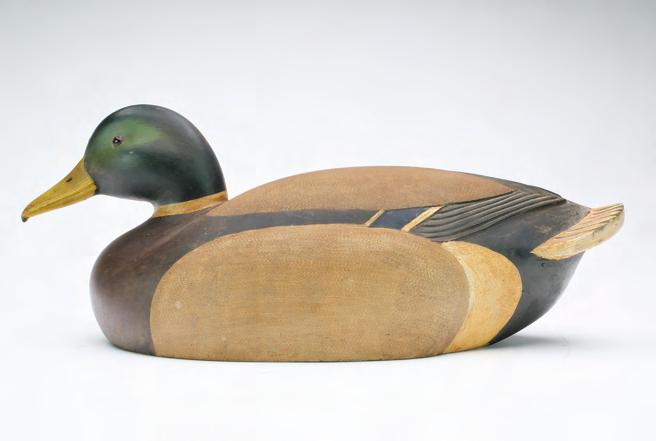
391 John McLoughin (1911-1985), Bordentown, New Jersey. Hollow carved brant with slightly turned head and raised, crossed wingtips. Signed on the underside. Measures 16.5” long. Excellent and original. (1,200 - 1,800)
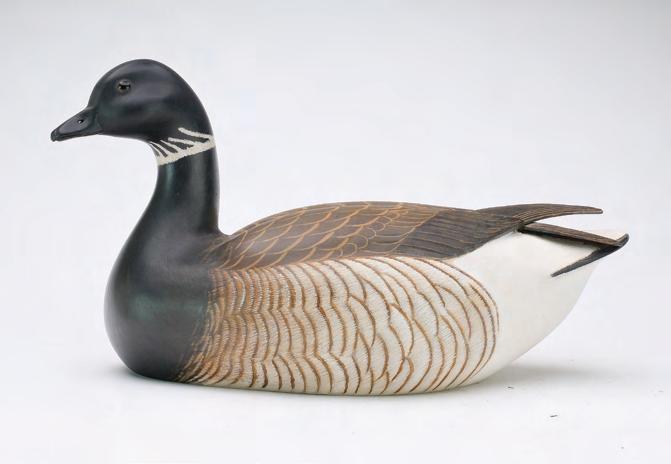

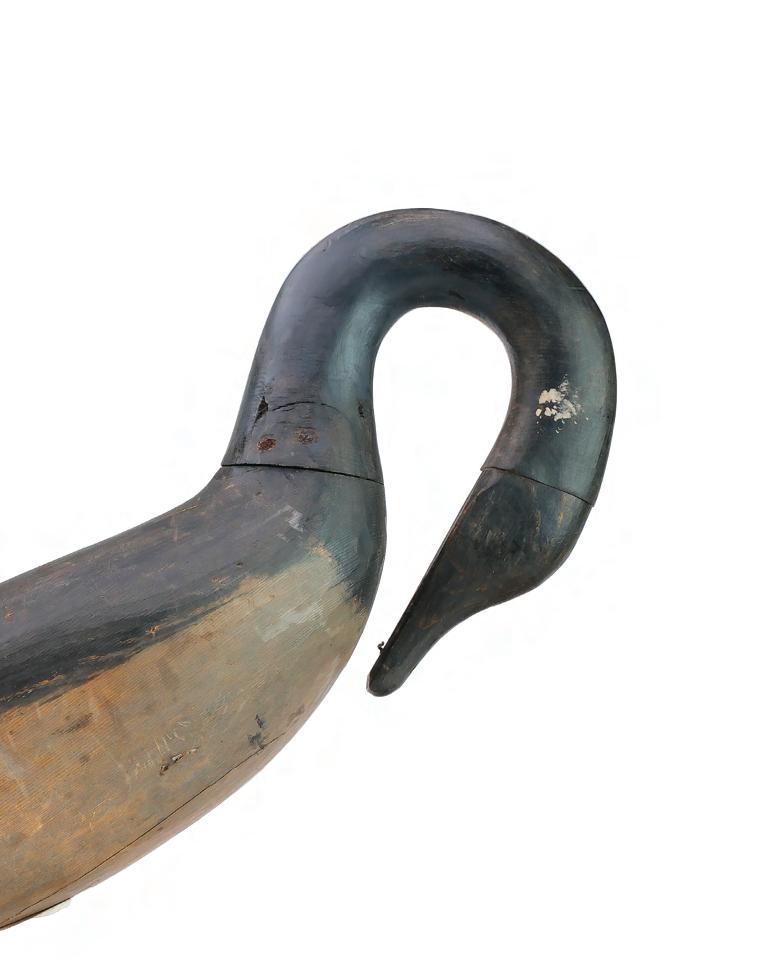
392 Gerald Wagner (early 20th century), Freeland, Prince Edward Island. Excellent breast preening brant made for use as a stick up. Excellent sculptural form. Measures 21.5” long. Original paint with minor gunning wear; scattered dents and hairline cracks; minor roughness near knot on underside; chip in one side of neck seatwas reset long ago; professional neck crack repair with touchup in that area. (8,000 - 12,000)
The Warins were boat builders and decoy makers who hunted extensively on the Toronto waterfront and Lake St. Clair. George travelled to western Canada around the turn of the century arranging and escorting the Duke of York on his royal shoot at the Delta Marsh in Manitoba. They were in business as “G & J Warin Boat Builders” as early as 1873. George and James were very involved in the sport of rowing, more specifically building racing sculls, using innovative seat and oar designs for competition rowing. World champion rower Ned Hanlon was a friend and customer who was mentored and sponsored by the Warins in his pursuit of multiple world titles. The Warins travelled throughout Ontario to regattas including Chatham, St. Catharines, Niagara and Eastern Ontario. George Warin was a founding member of the St. Clair Flats Shooting Company in 1874. The Warins sold boats and decoys to members of the elite duck clubs as well as to individual sportsmen. Warin implemented “shooting rules” to increase the harvest at several clubs at the Flats. At the St. Clair Flats, it was the height of the

market hunting era. Ducks were sold. Warin personally shot over 800 ducks at the Canada Club in 1876. Some of his rules included: only shoot every other day; stop shooting before sundown; feed ponds daily – clearly a recipe for success.
The Warin decoys are an integral part of “The Toronto School of Flats Decoy Makers.” Hollow; lightweight; wonderful diminutive forms – Warins decoys included most species of ducks. Geese were usually very hollow, extremely rare, graceful, again meticulously painted –truly works of art.
392a
George Warin (1830-1904), Toronto, Ontario. Hollow carved Canada goose with quarter inch bottom board and excellent form. “MCC” stamped in the underside. Measures 22” long. Dry original paint with minor crazing and wear; tight crack running from bottom board up the underside of tail; small amount of filler flaked above nail head in one side of neck; an excellent example.
(10,000 - 15,000)

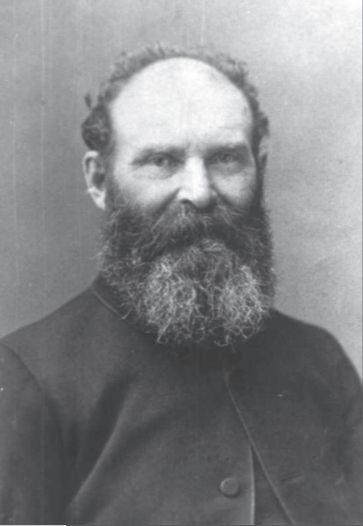


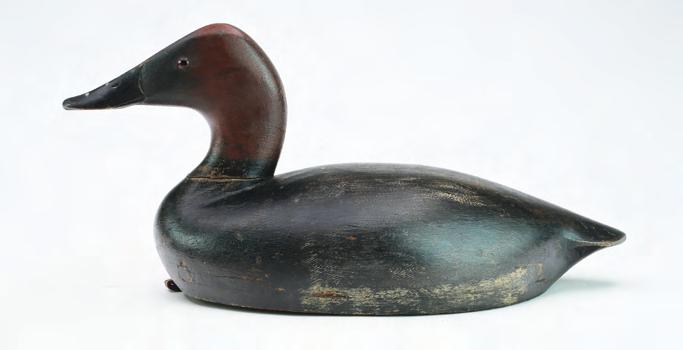

393 Unknown maker, Prince Edward Island, 1st quarter 20th century. Stickup brant with iron stake in underside. Measures 19.75” long. Mix of original and early in use repaint; early wooden patch on top of tail; tight crack in one side of neck seat; tight drying crack along the underside.
(800 - 1,200)
394 Bud Tully (1918-1973), Peterborough, Ontario. Rigmate pair of bluebills with slightly turned heads and significant feather rasping. Each stamped “112x” on the underside. Measure 13.25” long. Original paint with minor wear; excellent structurally.
Provenance: Randy Rall collection. (2,000 - 3,000)
395 Thomas Chambers (1860-1948), Toronto, Ontario. Hollow carved short body canvasback drake. Branded “FTM” for Long Point Club member Fred T. McMillan. Measures 15” long. Original paint with moderate wear, mostly around center of body where the feather combing has worn away; minor separation on one side of neck seat; in the making wooden patch at body seam on one side of breast.
Provenance: Randy Rall collection.
(1,500 - 2,500)
396 Unknown maker, Ontario, 1st quarter 20th century. Solid body hooded merganser hen with extended crest and “JW Wilton” stamped in the underside. Measures 14” long. Mix of original and early in use repaint with moderate to significant flaking and wear; roughness and minor loss to wood on top of crest; lightly hit by shot; hairline crack in one eye; old glue visible around the other eye. (500 - 800)
397 Unknown maker, Ontario, 1st quarter 20th century. Rare, hollow carved ruddy duck. Thinly hollowed with .25” bottom board. A rare species for a working decoy from Canada. Measures 11.75” long. Original paint with moderate flaking and wear; minor roughness on edge of tail; seam in bill where it was cracked down and reset. (800 - 1,200)

398 John R. Wells (1860-1953), Toronto, Ontario. Solid body redhead hen. “CEC” brand in underside for Ernie Candler, a friend of the maker. Measures 15.25” long. Original paint with very minor wear; a few shot strikes; head is slightly loose.
Provenance: Randy Rall collection. (1,000 - 2,000)
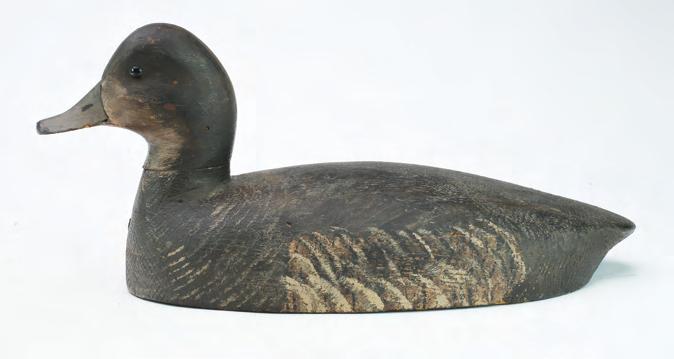
399 Thomas Chambers (1860-1948), Toronto, Ontario. Hollow carved redhead drake. Branded “BS Warren”. Measures 16” long. Original paint with moderate wear; slight separation at knot in one side of tail; a few tiny dents; hairline cracks and minor separation at neck seat; very fine hairline crack in one side of head.
Provenance: Randy Rall collection. (2,000 - 3,000)
400 David W. Nichol (1859-1949), Smiths Falls, Ontario. Rigmate pair of redheads with relief wingtip carving and feather stamping. Measure 14.25” long. Original paint with almost no wear; surface has darkened with age.
Provenance: Randy Rall collection. (1,200 - 1,800)
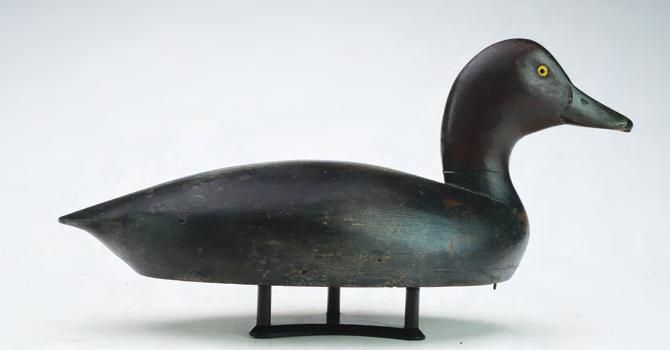
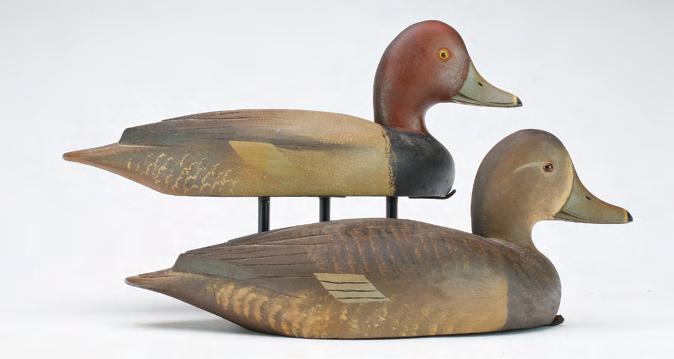


402 Charles Perdew (18741963), Henry, Illinois. Rigmate pair of mallards. Branded “JNZ” on the underside for the John Zering rig. Hollow carved with slightly turned heads. Drake retains the Perdew weight. Measure 16” long. Excellent original paint protected under a thick coat of varnish that has darkened with age; a few tiny paint rubs and flakes; excellent structurally.
Provenance: Zering rig. Joe Tonelli. Bill Hall collection. Herb Wetanson collection.
(7,000 - 10,000)
403 Bert Graves (1880-1956), Peoria, Illinois. Hollow carved mallard with upswept tail. Retains the original Graves weight on underside. 17” long. Original paint with minor to moderate wear under a thin coat of varnish that has darkened slightly; several small dents; tail chip repair.
Provenance: Randy Rall collection. (1,200 - 1,800)

404 Charles Perdew (1874-1963), Henry, Illinois. Hollow carved mallard drake with slightly turned head and comb feather paint detail. Retains the original Perdew weight. Measures 15.75” long. Dry original paint under a thin coat of varnish; shows moderate flaking and wear; tight cracks in neck; minor separation on one side of body seam.
(1,500 - 2,500)

Bureau, Illinois. Mallard drake, circa 1900. Weight on underside reads “F.H. Dunbar”. “F.H.D.” also painted on underside. Two piece hollow construction. Original paint with minor gunning wear; early coat of varnish has darkened with age.
(1,200 - 1,800)
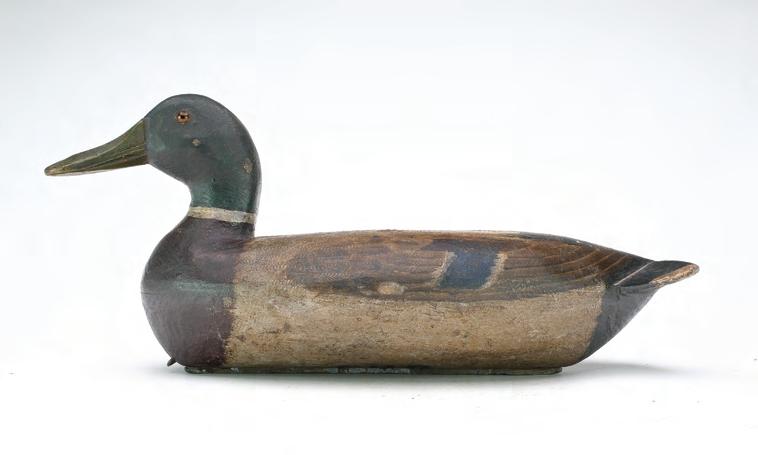


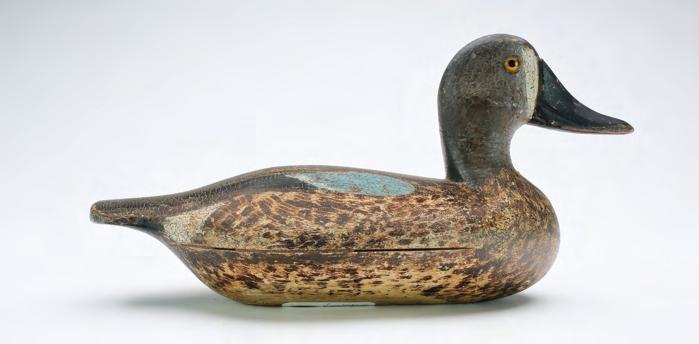

405 Bert Graves (1880-1956), Peoria, Illinois. Canvasback, 1st quarter 20th century. Paint by Catherine Elliston. Two piece hollow body. Measures 17” long. Moderate gunning wear; a few rubs; strong original paint; protected by an old coat of varnish that has mellowed slightly; some line tie marks around the neck and head. (1,800 - 2,200)
406 William Shaw (1849-1927), Lacon, Illinois. Hollow carved bluewing teal hen. Mackey collection ink stamp on the underside. Measures 10.5” long. Original paint with a very thick coat of varnish that has caused some paint shrinkage on sides and head; reset crack in neck; crack along one side of head that runs through eye. (1,500 - 2,500)
407 Judge Glen Cameron (18821958), Chillicothe, Illinois. Hollow carved bluewing teal. Branded “A.L.A.” for the rig of Andy Anderson. Measures 12” long. Very early and appealing in use repaint with fine crazing throughout; more modern touchup to some of the gray on head; fine hairline crack in neck, otherwise very good structurally. (1,000 - 1,400)
407a Michael Vallero (1906-1992), Spring Valley, Illinois. Mallard, 1st quarter 20th century. Two piece hollow body. 17.5” long. Original paint covered by a coat of varnish that is darkened and partially worn away; wear from moderate gunning use; crazing, mostly on back area. (1,200 - 1,500)
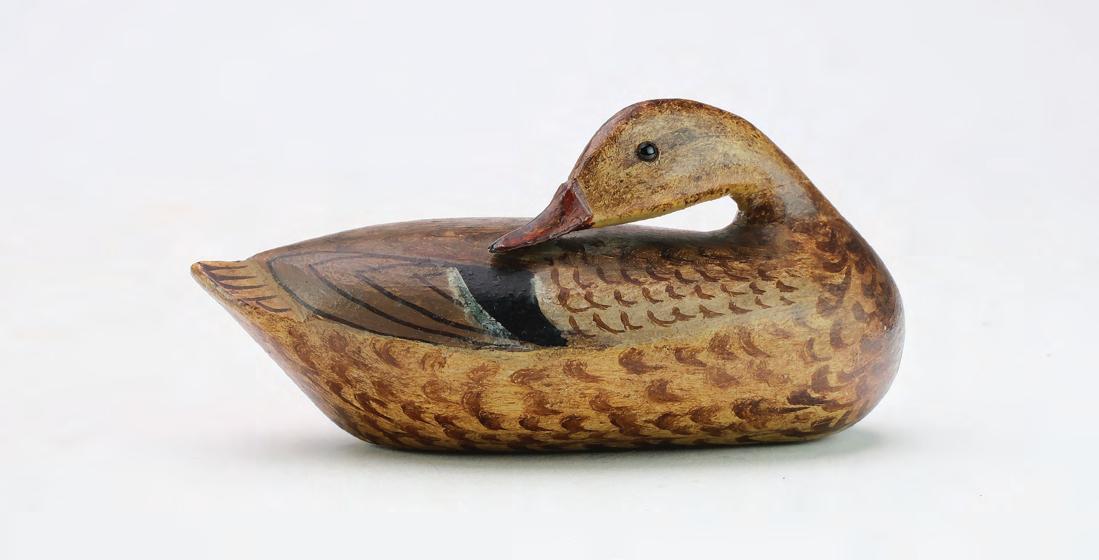

409

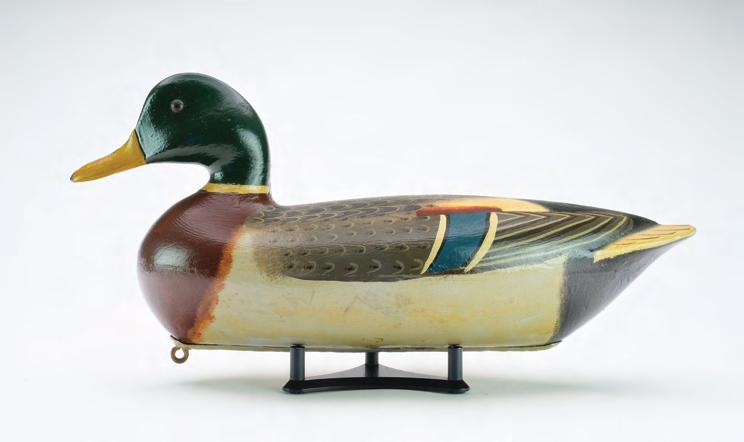
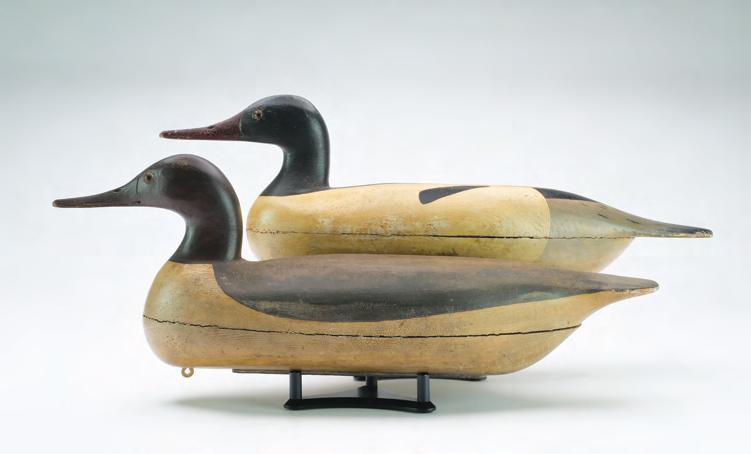
410 Verne Cheesman (1897-1956), Macomb, Illinois. Hollow carved pintail with slightly turned head. Small ‘JF’ stamp on the underside. Measures 14.25” long. Original paint on parts of the back and bill; the rest has old in use repaint; a few small dents.
Provenance: Purchased from Jack Stimson, Carman, Illinois in November 1956. Joe French collection. Carl Nemec collection. Randy Rall collection. (1,500 - 2,500)
411 Charles Perdew (1874-1963), Henry, Illinois. Hollow carved mallard. Measures 16.25” long. Original paint under a thick coat of varnish that has darkened with age; almost no wear; very minor roughness on tip of bill; minor separation on one side of neck seat. (3,000 - 5,000)
412 Charles Schoenheider, Jr. (19212003), Peoria, Illinois. Hollow carved rigmate pair of common mergansers. An early pair, similar to the work of the maker’s father. Measure 19” and 19.75” long. Original paint with minor crazing and wear; slight separation at body seams; tight crack in one of drake’s eyes; seam in drake’s bill where it was reset.
Provenance: Schoenheider family. Will Pennington collection. Byron Cheever collection. Herb Wetanson collection. (2,500 - 3,500)
413 Dodge Decoy Factory (18831893), Detroit, Michigan. Pintail with slightly turned and upswept head. Measures 16.75” long. Original paint with moderate flaking and wear; lightly hit by shot; tight drying cracks in back and breast; retains much of the original neck filler with a small portion being restored.
Provenance: Jim and Patti Aikin collection. (800 - 1,200)
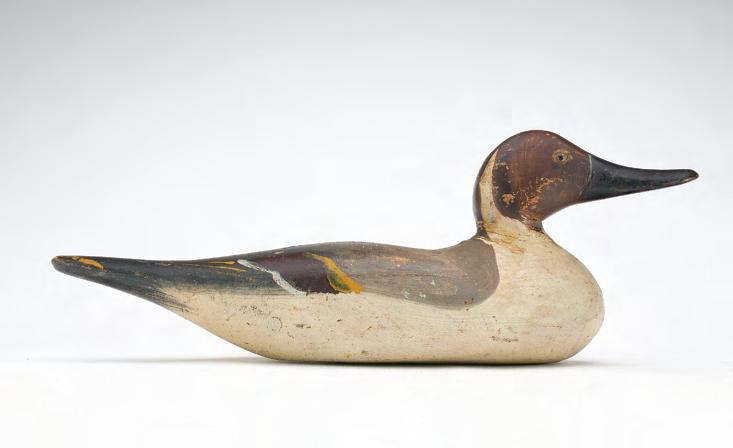
414 Mason Decoy Factory (18961924), Detroit, Michigan. Rare standard grade bufflehead drake. Glass eye model. Measures 11.75” long. Original paint with moderate gunning wear; surface has darkened with age; hairline crack in one eye; The original neck filler is 20% missing and is cracked in one side. (1,500 - 2,500)
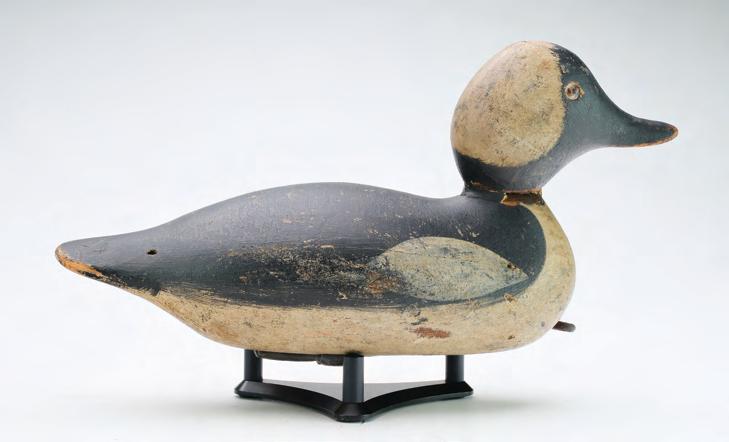
415 Mason Decoy Factory (18961924), Detroit, Michigan. Challenge grade coot with incised bill carving and upswept tail. “IPJ” and “WGH” branded on underside. Measures 11.5” long. Original paint with moderate gunning wear; tight crack along the underside; typical tail chip repair; small chip on tip of bill; filler restoration with touch up at base of neck. (1,500 - 2,500)
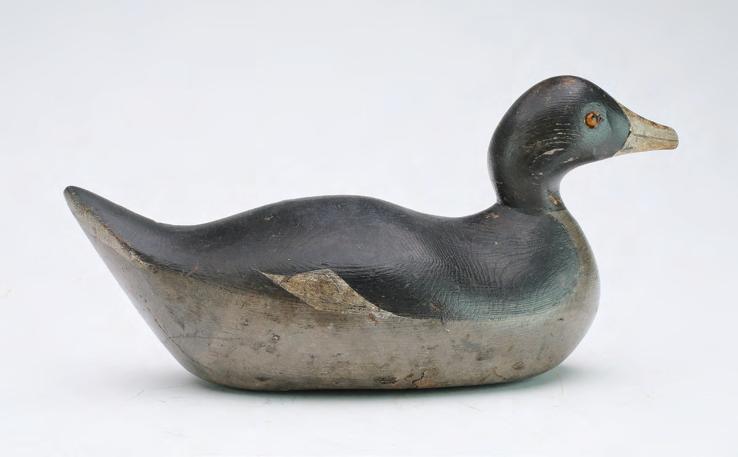



416 Mason Decoy Factory (18961924), Detroit, Michigan. Hollow carved premier grade mallard hen with relief bill carving and glass eyes. Branded ‘Fuller’ on the underside. Measures 17 1/2” long. Strong original paint with minor wear; small dents; very small tail chip repair; minor flaking and a tight crack at neck seat.
Provenance: Randy Rall collection. (1,200 - 1,800)
417 Mason Decoy Factory (18961924), Detroit, Michigan.
Premier grade Seneca Lake model canvasback hen. Measures 16.5” long. Original paint with minor to moderate wear; moderately hit by shot; hairline crack in one eye; neck filler is mostly missing.
Provenance: Randy Rall collection. (600 - 900)
418 Mason Decoy Factory (18961924), Detroit, Michigan. Early challenge grade mallard with early head style. Measures 16” long. Original paint with moderate flaking and wear under a coat of varnish that has darkened with age; small chip in tip of tail; tight crack along one side of back; restored neck filler. (600 - 900)
419 Mason Decoy Factory (18961924), Detroit, Michigan. Challenge grade black duck. Retains the challenge ink stamp on the underside. Measures 17” long. Original paint with minor wear; thick coat of varnish has darkened with age; small tail chip repair; restored neck filler. (600 - 900)
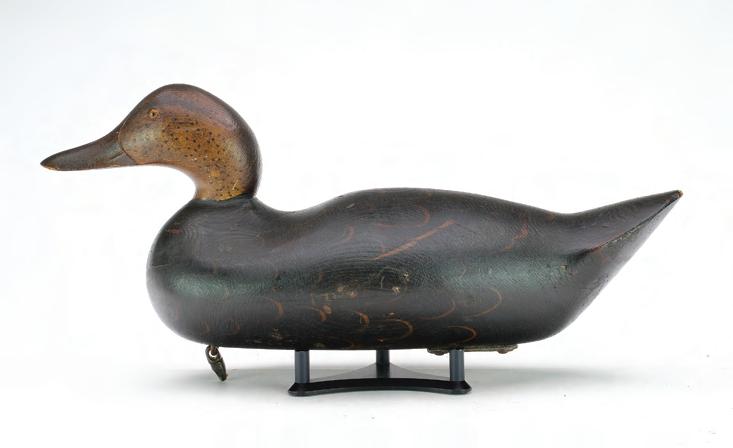
420 Mason Decoy Factory (18961924), Detroit, Michigan. Premier grade black duck with relief bill carving and thick swirl paint. Hollow carved with the initials “J.L.S.” branded twice in underside. Measures 17” long. Original paint with minor to moderate wear under a thin coat of varnish; moderately hit by shot with shot strikes being darkened; professional tail chip and neck crack repair. (800 - 1,200)

421 Mason Decoy Factory (18961924), Detroit, Michigan. Hollow carved premier grade bluebill hen with wide bill carving. Measures 14” long. Thick original paint with very minor wear; fine hairline crack in one side of neck seat; two drips of gray paint on one side near tail.
Provenance: Randy Rall collection. (2,000 - 3,000)

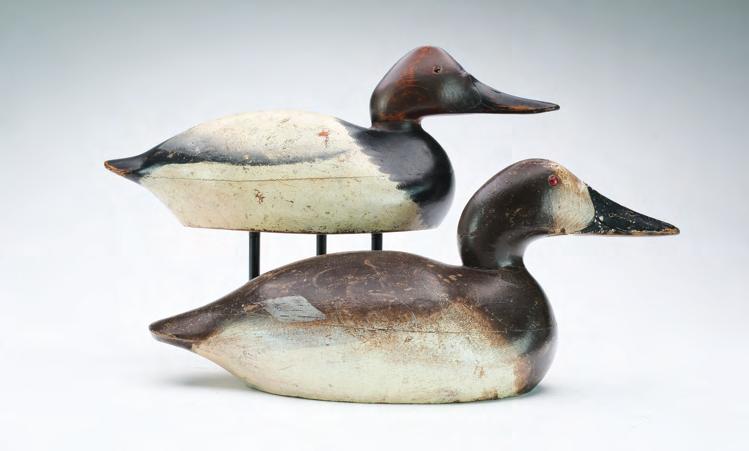
422
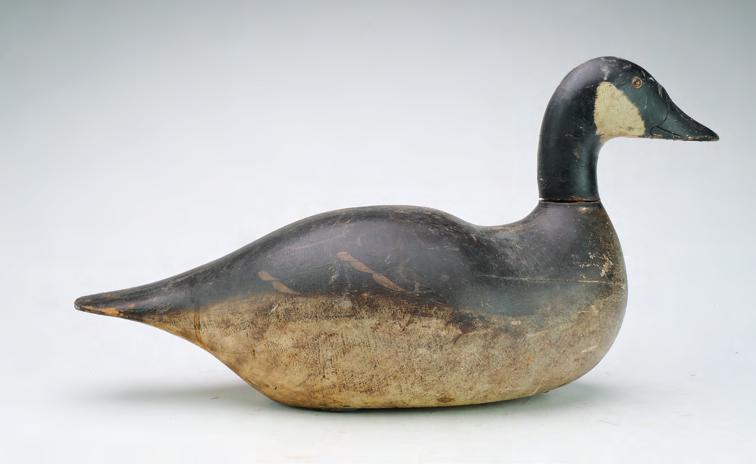

422 Mason Decoy Factory (18961924), Detroit, Michigan. Canvasback hen and drake. Premier grade models. Drake is branded “BWH” on the underside. Measure 14.5” and 15.25” long. Overpaint was taken down to most of the original surface showing moderate wear; lightly hit by shot; repair to a chip at the base of drake’s neck.
(1,000 - 1,400)
423 Mason Decoy Factory (18961924), Detroit, Michigan. Premier grade Canada goose. Measures 25” long. Original paint with moderate flaking and wear; filled drying cracks in body; small chipping and roughness on edge of tail and bill; lower part of bill was cracked and reset with small nails under the bill; fine hairline crack through neck; separation at neck seat with small nails added.
Provenance: Randy Rall collection. (4,000 - 6,000)
424 Mason Decoy Factory (18961924), Detroit, Michigan. Glass eye model yellowlegs with iron bill. Measures 12” long. Dry original paint with minor wear; in-factory filled split in one side; fine hairline cracks in face and head; both eyes were replaced at some point.
Provenance: Randy Rall collection. (1,200 - 1,800)
425 Mason Decoy Factory (18961924), Detroit, Michigan. Hollow carved premier grade bluebill. Measures 14” long. Thick original paint with minor flaking and wear; mostly around neck seat; minor roughness on tip of bill, otherwise very good structurally.
Provenance: Randy Rall collection. (1,500 - 2,500)
426 Mason Decoy Factory (18961924), Detroit, Michigan. Premier grade, Seneca Lake model canvasback. Measures 16.5” long. Original paint with minor gunning wear; a few tiny dents; tight crack on one side of neck seat; small dent on top of head.
Provenance: Randy Rall collection. (1,200 - 1,800)

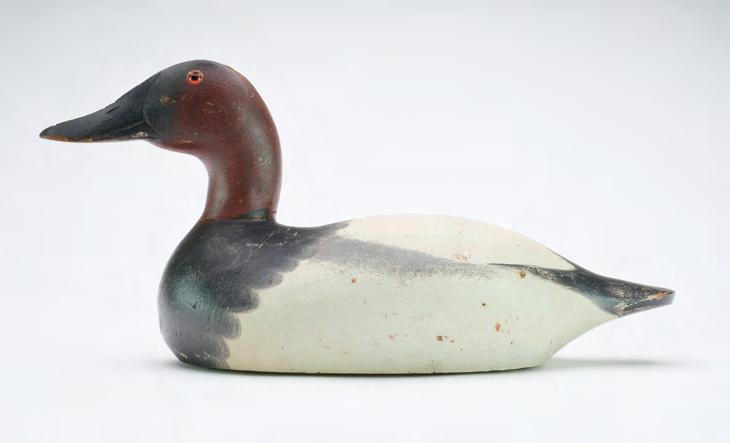
427 Mason Decoy Factory (18961924), Detroit, Michigan. Greenwing teal drake with glass eyes. Measures 12” long. Very strong original paint; very minor gunning wear; one eye appears to be an early replacement. (2,500 - 3,500)

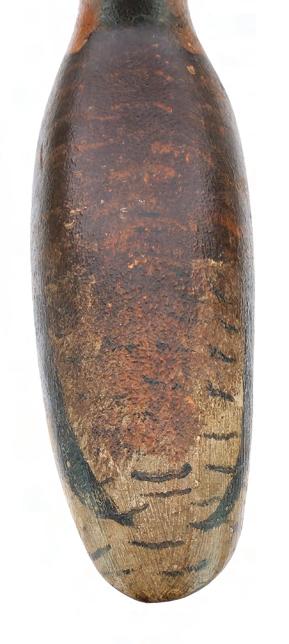
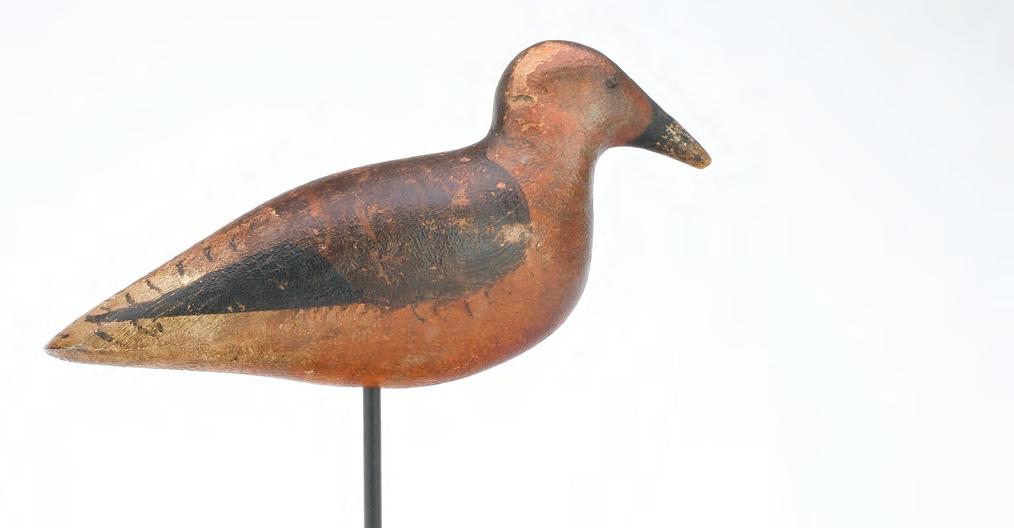
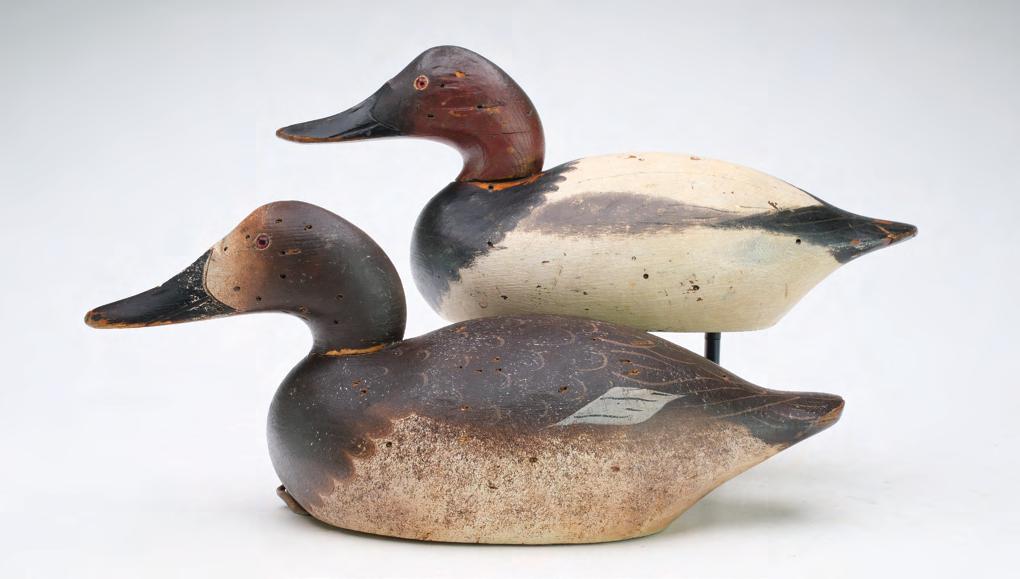
Michigan. Early red knot
small tack eyes. From the collection of Dr. George Ross Starr, Starr collection ink stamp on the underside. Measures 9.75” long. Thick original paint with minor to moderate flaking and wear; filler where bill meets face was professionally restored
Provenance: Dr. George Ross Starr collection. Don Walston collection. Private New England collection. (2,000 - 3,000)
Michigan. Circa 1910. Hollow body premier grade hen has “EG” carved in underside. Drake is stamped “DAS”. Both are in original paint; hen has shot scars, mostly to one side of body and head; light wear around bill; drake has two tight cracks back of body; shot scars and tight crack in neck; wood putty missing at neck seat. (4,000 - 6,000)
430 Ben Schmidt (1884-1968), Detroit, Michigan. Bufflehead drake with slightly turned and tucked head. Two piece body with .5” bottom board. Slight relief wingtip carving. “P Travers” stamped in the underside. Measures 13” long. Original paint with minor discoloration and wear protected under a thin coat of varnish; minor roughness on edge of tail; in the making filled crack along the back.
Provenance: Jim and Patti Aikin collection. (800 - 1,200)

430
431 Ben Schmidt (1884-1968), Detroit, Michigan. Sleeping black duck with relief wingtip carving and feather stamping. Wooden keel was removed. “R Smith” stenciled on the underside. Measures 15” long. Second coat of paint on the underside; a few small shot marks on one side; otherwise very good and original.
Provenance: Jim and Patti Aikin collection. (600 - 900)

432 Ben Schmidt (1884-1968), Detroit, Michigan. Excellent rigmate pair of bluewing teal. Both with feather stamping and relief wingtip carving. Identified, signed, and dated 1963 on the undersides. Measure 13” long. Excellent and original.
Provenance: Jim and Patti Aikin collection. (1,500 - 2,500)
 431
432
431
432


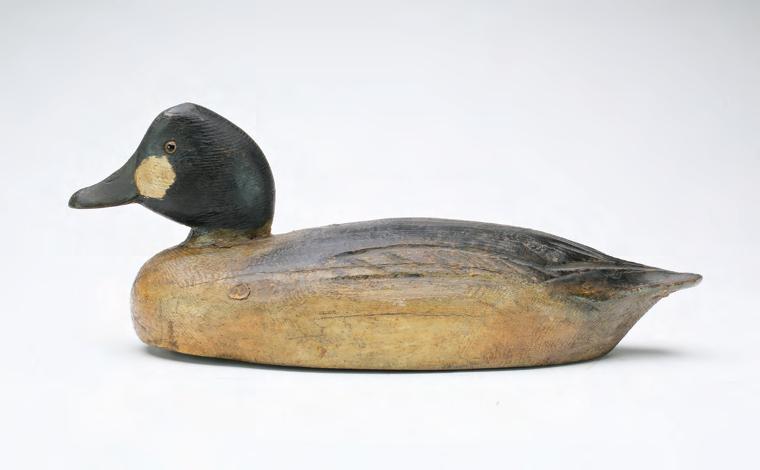
433 Ben Schmidt (1884-1968), Detroit, Michigan. Pintail drake with relief wingtip carving. Measures 18.5” long. Professional bill repair, otherwise excellent and original.
Provenance: Jim and Patti Aikin collection. (1,500 - 2,500)
434 Ben Schmidt (1884-1968), Detroit, Michigan. Oversize mallard hen with extensive feather stamping and relief wing carving. Measures 16.75” long. Two tiny dents on top of head, otherwise excellent and original.
Provenance: Jim and Patti Aikin collection. (600 - 900)
435 Ben Schmidt (1884-1968), Detroit, Michigan. Early goldeneye drake with minimal feather carving at wings and tail. Measures 15.25” long. Original paint with minor wear under an early coat of varnish that has darkened with age; fine drying cracks in breast and along the body.
Provenance: Jim and Patti Aikin collection. (400 - 600)
436 Ben Schmidt (1884-1968), Detroit, Michigan. Black duck with slightly turned head and feather stamping. Keel was removed. “HLR” branded on the underside. Measures 18” long. Original paint with very minor wear; area on one lower side was worn to bare wood and darkened; very minor separation at neck seat.
Provenance: Jim and Patti Aikin collection. (600 - 900)

Ben Schmidt (1884-1968), Detroit, Michigan. Pair of canvasbacks with slight relief wing carving. Hen with slightly turned head. Mike Ellis collection ink stamp on the undersides. Measure 15” and 15.75” long. Original paint with minor flaking and wear; in the making filled cracks in hen’s body.
Provenance: Jim and Patti Aikin collection. (1,200 - 1,800)
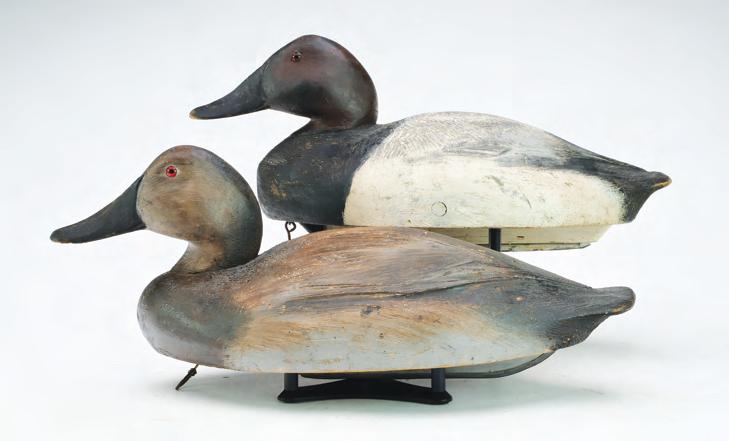
Ben Schmidt (1884-1968), Detroit, Michigan. Smooth body coot with no wing or feather carving. Measures 13.5” long. Original paint with moderate gunning wear; tight crack along one lower side; decoy was made with a separate piece of wood on one side of head.
Provenance: Jim and Patti Aikin collection. (500 - 800)
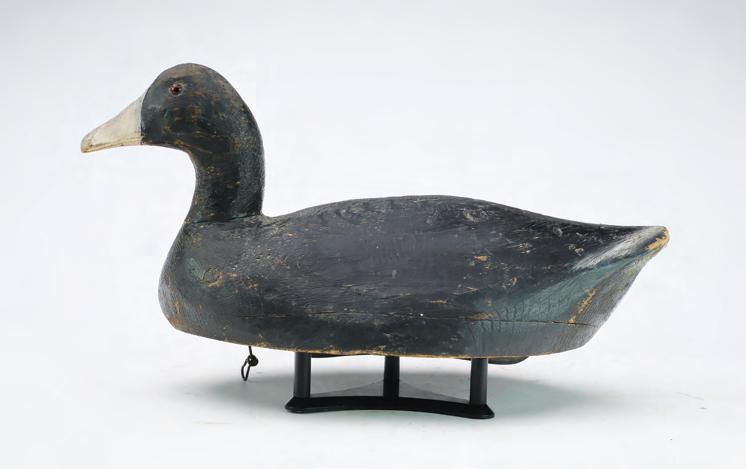


removable
Head can be screwed on and off. Hollowed from the underside. Measures 26” long. Original paint with moderate wear; under an early coat of varnish that has darkened; filled drying crack along the back; some spots of wear on head and bill have been darkened; second coat of paint on the underside.
Provenance: Jim and Patti Aikin collection. (1,000 - 1,400)
Provenance: Jim and Patti Aikin collection. (2,000 - 3,000)
441 Roger Barton, San Francisco, California. Hollow carved pair of cinnamon teal. Hen in sleeping pose with bill buried under relief carved wings. Drake in preening pose with relief wingtip carving. “RWB” carved in lead weights. Measures 9.5” long. Minor hairline separation at drake’s neck seat; otherwise excellent and original.
(1,500 - 2,500)

442
San Francisco, California. Pintail drake with relief wing carving. Weight was removed at some point. Measures 16.5” long. Original paint with minor discoloration and almost no wear.
(1,200 - 1,800)
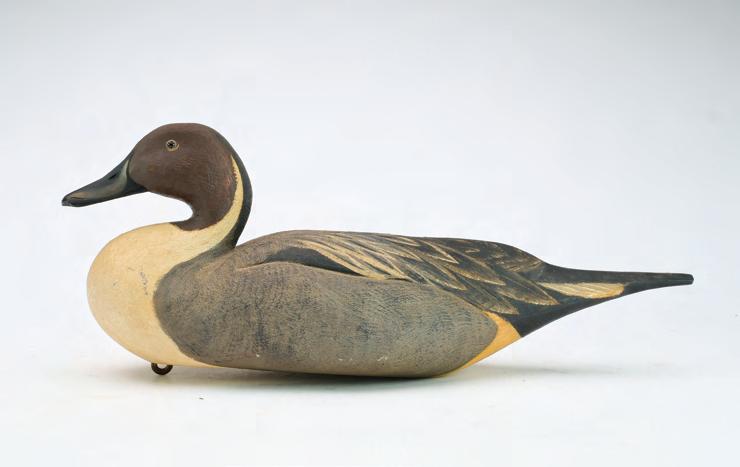
443 Roger Barton, San Francisco, California. Pair of bufflehead with deep relief wing carving and tucked heads. “RWB” carved in lead weights. Measure 11” long. Original paint with very minor rubs; thin layer of varnish has darkened with age; excellent structurally.
(800 - 1,200)



444 Charles Bergman (1856-1946), Astoria, Oregon. Hollow carved pair of greenwing teal with raised neck seats. Scratch feather paint detail on hen. “X” carved in underside of hen. Measure 13” long. Original paint with minor gunning wear; small dents; fine hairline seam in drake’s bill where it was tightly reset; thin coat of varnish on each has darkened with age. (30,000 - 40,000)

445 Charles Bergman (1856-1946), Astoria, Oregon. Hollow carved pintail. Measures 20” long. Original paint with fine crazing and minor wear; tight cracks in lower neck.
(8,000 - 12,000)
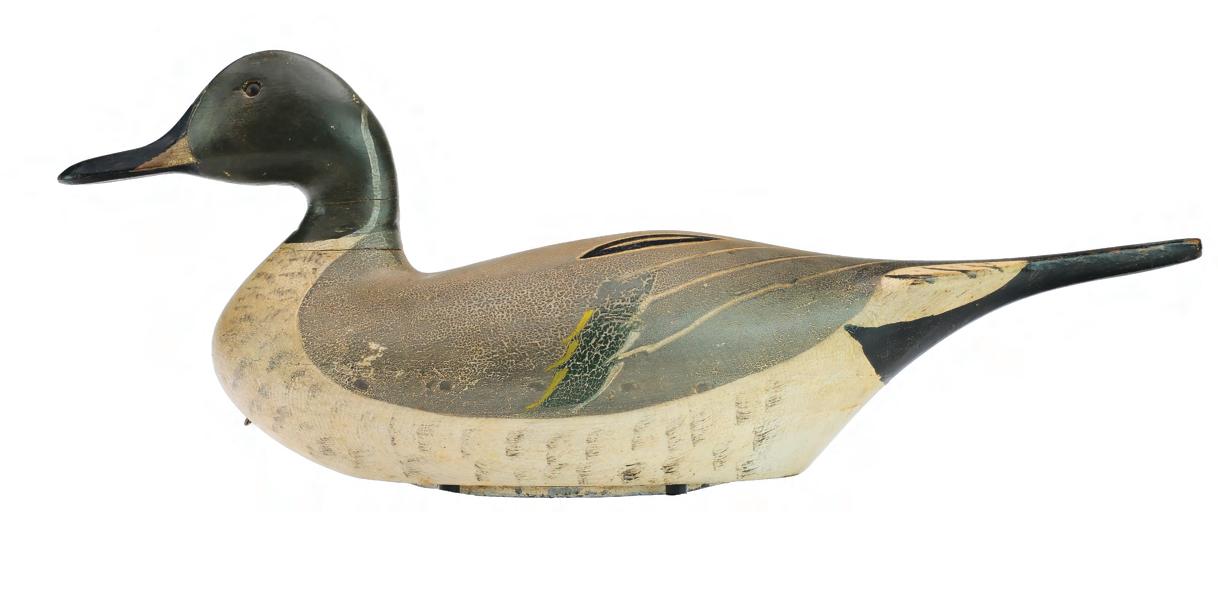
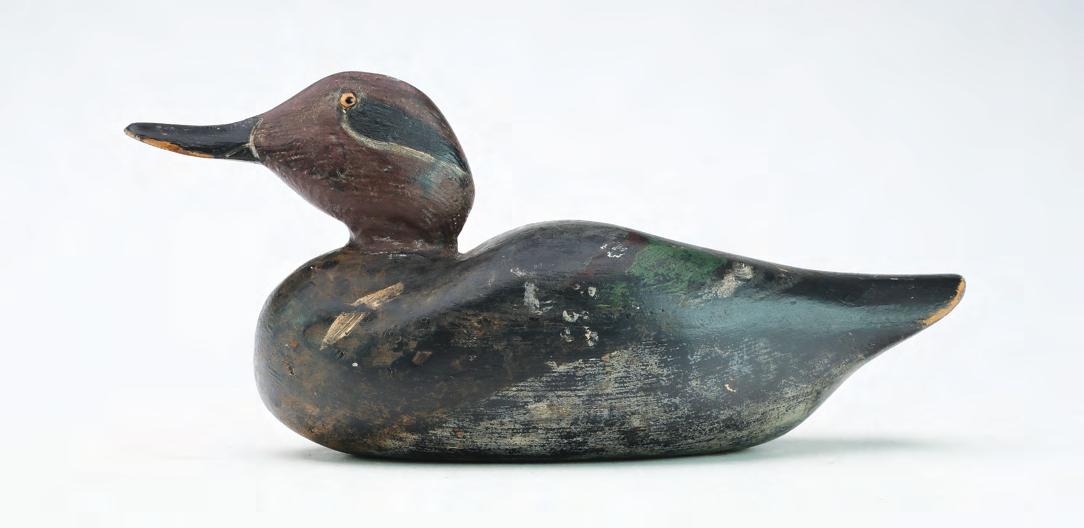

447 Richard Janson (1872-1951), Sonoma, California. Canvasback with wooden skeg keel under tail. Relief wingtip carving. Measures 15.75” long. Original paint with minor wear under a thick coat of varnish that has darkened with age; the white on underside of body and tail is a second coat.
(1,500 - 2,500)
(1,200 - 1,800)


From Galliano, Louisiana, a small community in the southern part of Lafourche Parish, Mr. Brunet is known as the “Cajun Carver.”
Growing up in one of the country’s best duck hunting areas and taking full advantage of the opportunity, he hunted extensively and became very knowledgeable about the waterfowl he pursued. In 1984 at the age of 45, Tan had accomplished legendary achievements including five world championships in less than a decade including many best of shows.
One of Tan’s carving disciplines was taught to him by John Scheeler, “there is power in simplicity.” Tan believes that simple, peaceful and comfortable looking types of decoys remain beautiful forever. Preening and stretching are not comfortable positions, and these acts soon become tiring to the viewer and collector.
Tan’s two sons, Jett and Jude, are also award winning competition carvers. Jett started carving at the age of nine and in that same year he started entering competitions. His father stopped competing when Jett entered the professional categories of competition. At the age of 21, Jett won his first World Championship Decorative Decoy Pairs Competition. Jude Brunet has won the Ward Foundation World Championship Wildfowl Carving Competition, Decorative Decoy Pairs, twice.
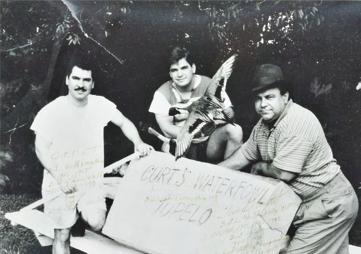


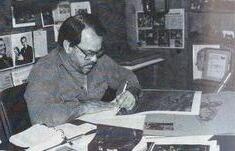
Roger and Carolyn collected decoys for nearly four decades. Participating in the Guyette and Deeter auctions and purchasing at the Ward World Carving Championships over that time. What they enjoyed most was encouraging and supporting new Louisiana carvers by frequenting local shows and auctions in the state.
448 Tan Brunet (1938-2019), Galliano, Louisiana. Extremely rare 3/4 size swan with highly detailed bill carving and slightly turned head. Signed and dated 1991 on the underside. Believed to be one of only two known examples. Measures 24.5” long. Excellent and original.
Provenance: Roger and Carolyn Bourgeois collection. (7,000 - 10,000)
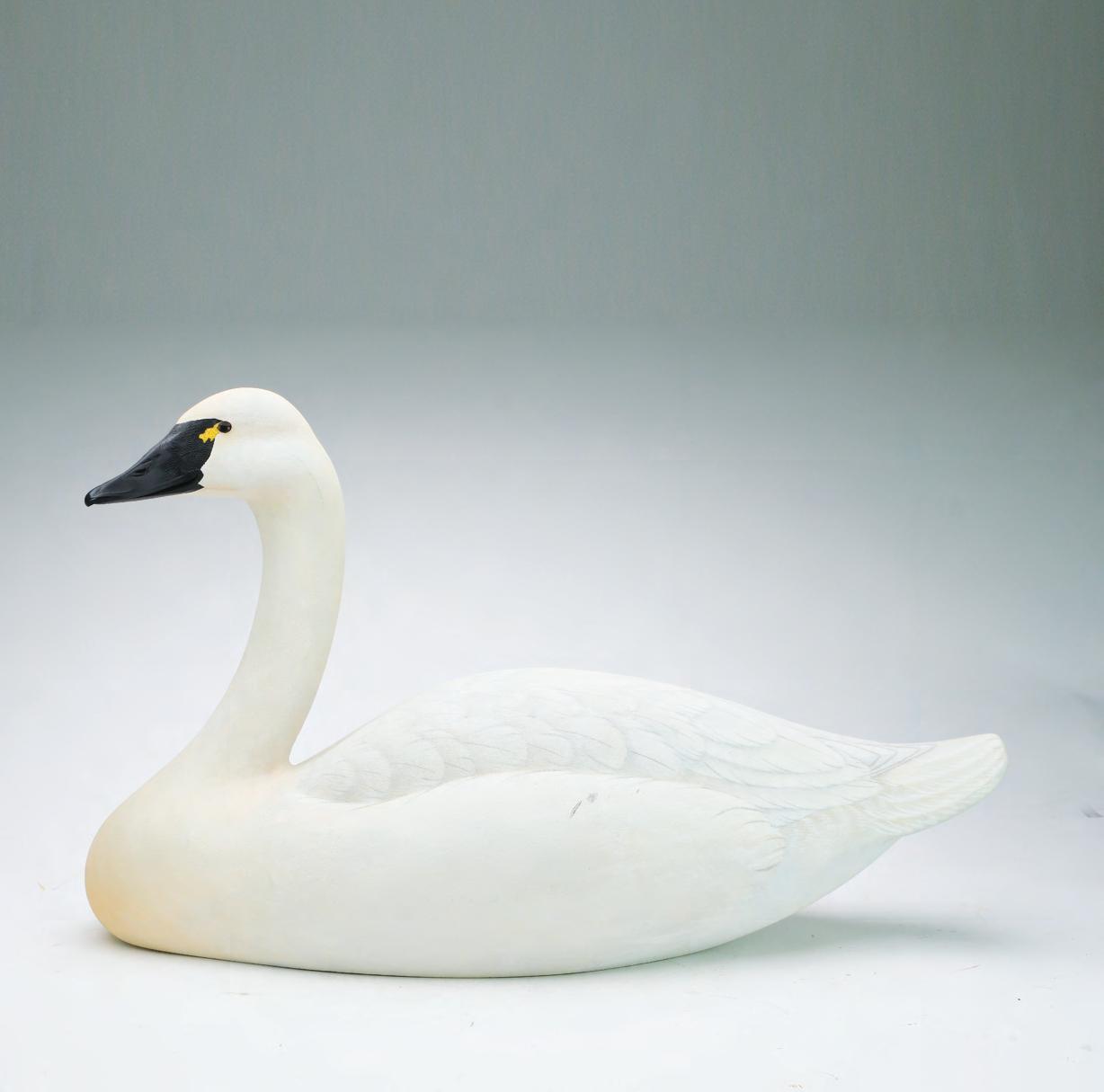


449
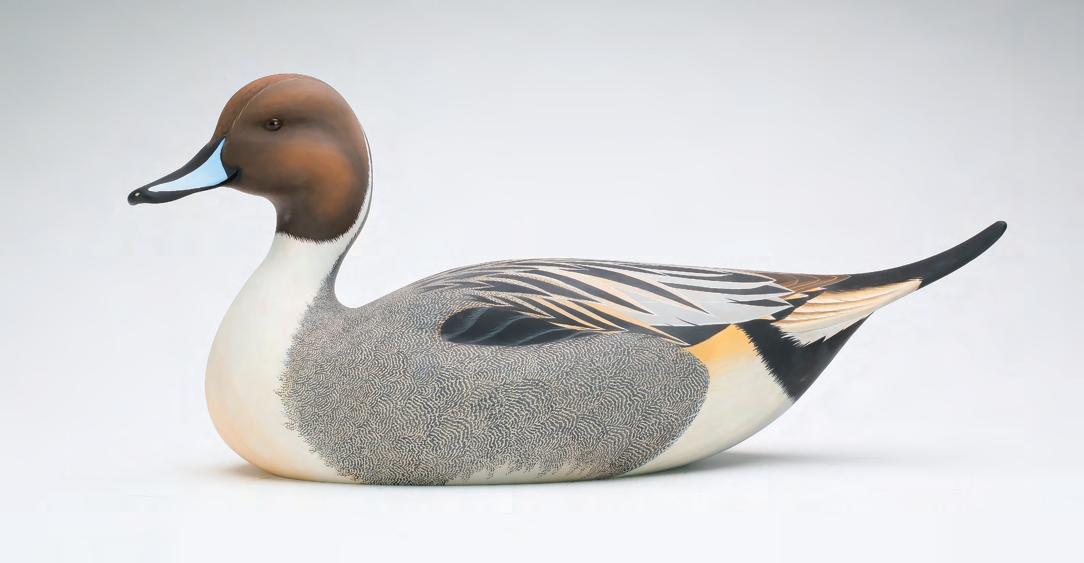
450
449 Tan Brunet (1938-2019), Galliano, Louisiana.
Important goldeneye drake with raised, crossed wingtips and slight relief wing carving. Outstanding color blending on head. Signed and dated 1993 and inscribed “My first American goldeneye drake” on the underside. Measures 14.5” long. A few very minor paint rubs, otherwise excellent.
Provenance: Roger and Carolyn Bourgeois collection. (3,000 - 5,000)
450 Tan Brunet (1938-2019), Galliano, Louisiana. Pintail with slightly turned head and upswept tail. Signed and dated 1992 and inscribed “For Roger and Carolyn Bourgeois”. Measures 19” long. Tiny paint rub on tip of bill, otherwise excellent.
Provenance: Roger and Carolyn Bourgeois collection. (2,000 - 3,000)
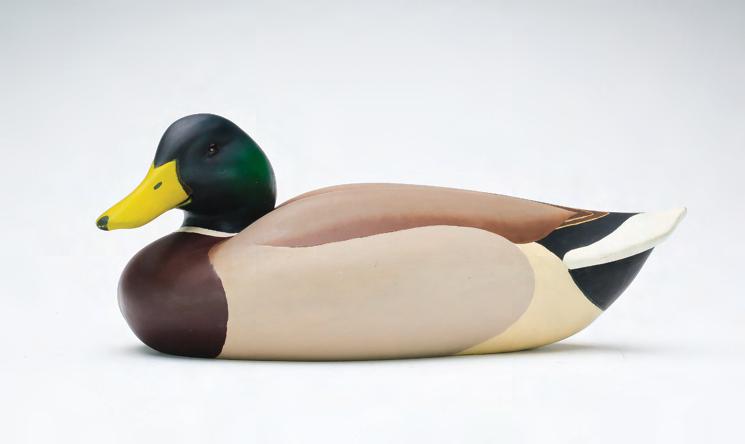

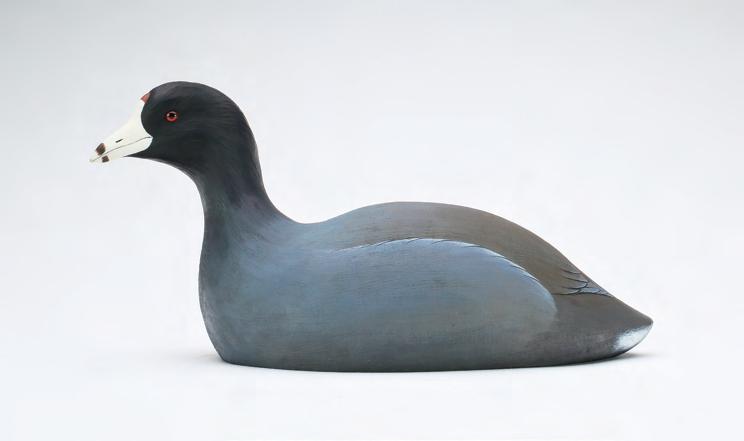
451 Jett Brunet (b.1964), Galliano, Louisiana. Mallard with head tucked and turned 45 degrees. A smoothie with no feather detail carving. Signed and dated ‘82 on the underside. Measures 15” long. A few very minor paint rubs, otherwise excellent.
Provenance: Roger and Carolyn Bourgeois collection. (1,500 - 2,500)
452 Jett Brunet (b.1964), Galliano, Louisiana. Pintail with slightly turned head. Signed and dated ‘90 on the underside. Measures 16.5” long. Excellent and original.
Provenance: Roger and Carolyn Bourgeois collection. (1,500 - 2,500)
453 Jude Brunet (b1969), Galliano, Louisiana. Swimming coot with slightly turned head. “My first coot” inscribed on the underside. Also signed and dated ‘98. Measures 13” long. Tiny paint flake at tip of bill, otherwise excellent.
Provenance: Roger and Carolyn Bourgeois collection. (1,500 - 2,500)
454 Jett Brunet (b.1964), Galiano, Louisiana. Ringneck drake with slighty turned and tucked head. Relief wing and raised, crossed wingtip carving. Signed and dated ‘93. Measures 10.5” long. Excellent and original.
Provenance: Roger and Carolyn Bourgeois collection. (1,500 - 2,500)
455 Jimmie Vizier (1933-2010), Galiano, Louisiana. Pair of red breasted mergansers with extended crests and raised, crossed wingtips. Signed and dated 2002. Measure 16” and 18” long. Hen is excellent; drake with two tiny chips at tips of crest feathers.
Provenance: Roger and Carolyn Bourgeois collection. (1,200 - 1,800)
456 Jimmie Vizier (1933-2010), Galiano, Louisiana. Mallard drake with slightly turned head. Signed and dated 1997. Also with carved inscription “In Memory of William Bill Koelpen. Carved special by Jimmie Vizier for the 1997 Northern National Competition”. Measures 15.5” long. Excellent and original.
Provenance: Roger and Carolyn Bourgeois collection. (1,000 - 1,500)
457 Jimmie Vizier (1933-2010), Galiano, Louisiana. Pair of American mergansers with slightly turned heads, relief wing carving, and extended crests on hen. Competition birds with wooden keels that were never signed. Measure 17.5” and 18” long. Excellent and original.
Provenance: Roger and Carolyn Bourgeois collection. (2,000 - 3,000)


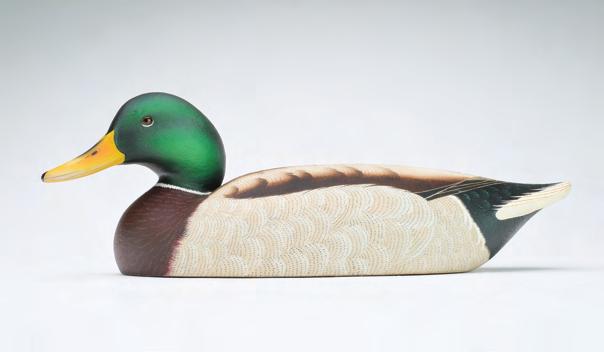

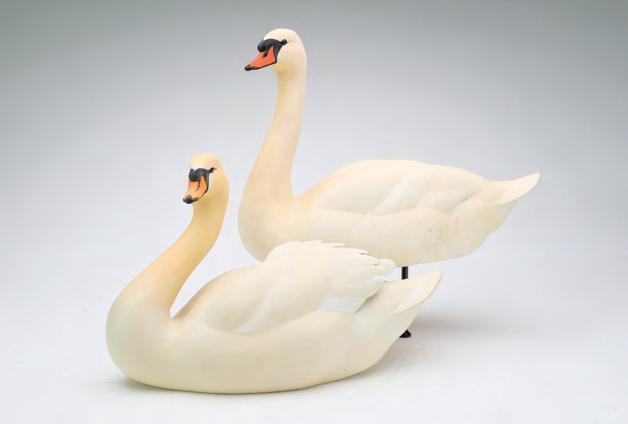
458 Russell Martin, Jr., Chauvin, Louisiana. Two 1/2 size mute swans. One with wing raised off of body. Both with turned heads. Both are signed on the underside. Swan with raised wing dated 2016, the other 2011. Measure 17” and 17.5” long. A few tiny dents and paint rubs, otherwise excellent and original.
Provenance: Roger and Carolyn Bourgeois collection.
(4,000 - 6,000)

458 460


459 Jimmie Vizier (1933-2010), Galiano, Louisiana. Pair of shoveler with tucked and slightly turned heads. Raised, crossed wingtips. Signed and dated 2000. Measure 13.25” and 14” long. Small paint flake on the edge of one of drake’s raised wingtips, otherwise excellent and original.
Provenance: Roger and Carolyn Bourgeois collection. (1,500 - 2,500)
460 Jimmie Vizier (1933-2010), Galiano, Louisiana. Pair of goldeneye with raised crossed wingtips and relief tail feather carving. Both with slightly turned heads. Signed and dated ‘04 on the underside. Measure 12.75” long. Very minor paint rubs on tips of tail feathers, otherwise excellent.
Provenance: Roger and Carolyn Bourgeois collection. (1,200 - 1,800)
461 Jimmie Vizier (1933-2010), Galiano, Louisiana. Pair of pintails with slightly turned heads, relief wingtip carving. Signed and dated 2000 on the underside. Measure 16.25” and 19.5” long. Excellent and original.
Provenance: Roger and Carolyn Bourgeois collection. (1,200 - 1,800)
“I made this male kestrel around 2010, after a couple seasons of close observation in my local dove field. I had a chance to watc h them closely, and they took center stage in my attention whenever they foraged insects in the sunflower fields. They are supreme li ttle acrobats, light and agile. Their colors and sleek profile make t his smallest of falcons pure pleasure to carve and paint. It felt right to display him in flight, giving opportunity to show the flyweight s trength these little falcons exude. This is one of 2 or 3 I have made.”
- Josh Brewer462 Josh Brewer (b.1983), Little Deer Isle, Maine. Flying kestral on figural hardwood backboard. Deep relief wing and tail feather carving. Carved feet are tucked in to body. Signed on the backboard. Measures 11.25” long, with an 11.5” wingspan. Backboard measures 21.25” wide. Excellent and original. (4,000 - 6,000)
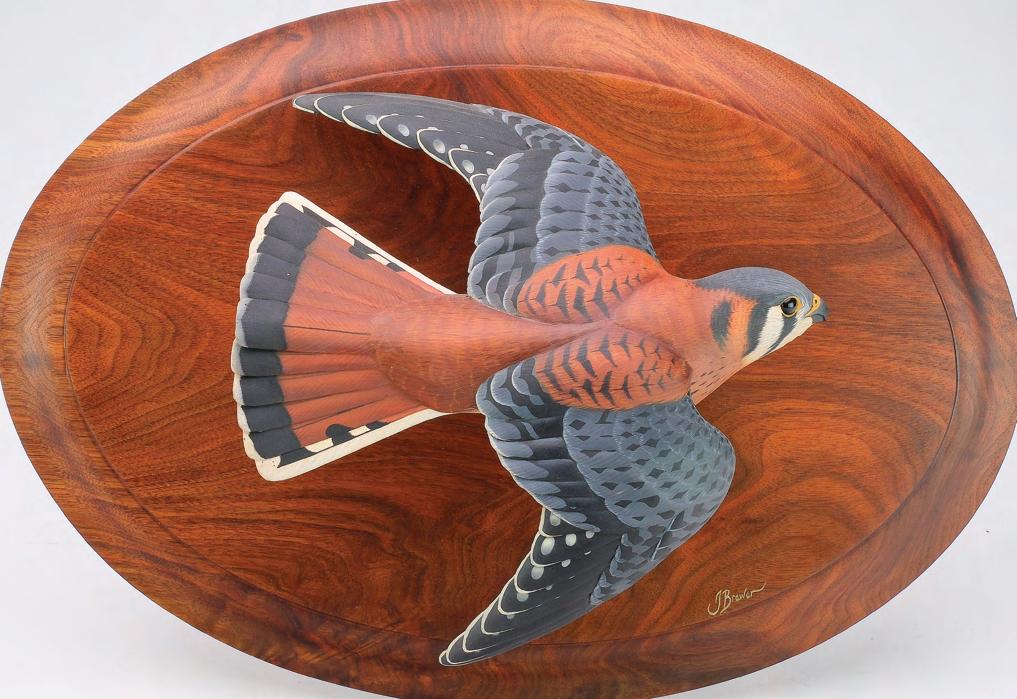
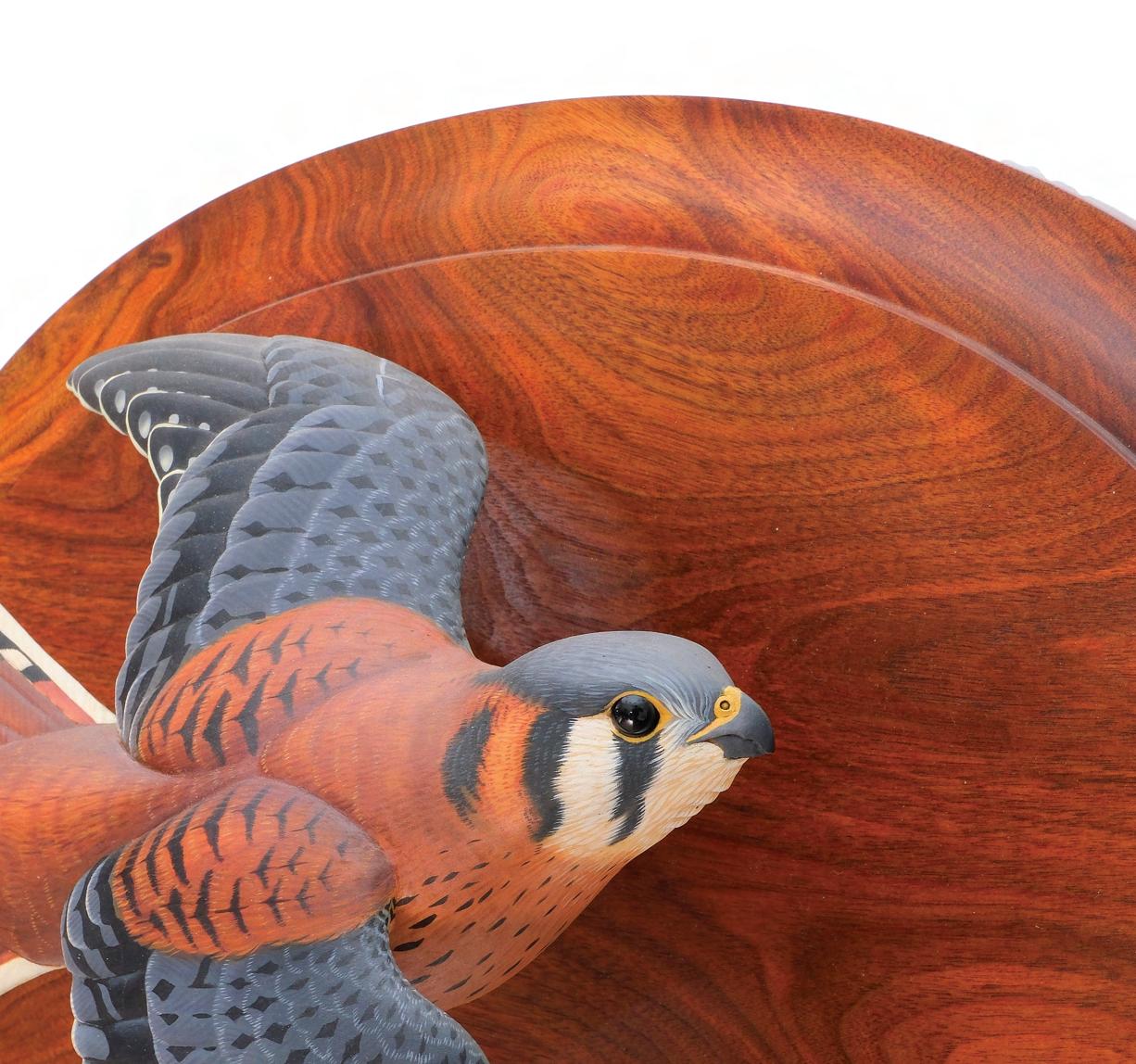
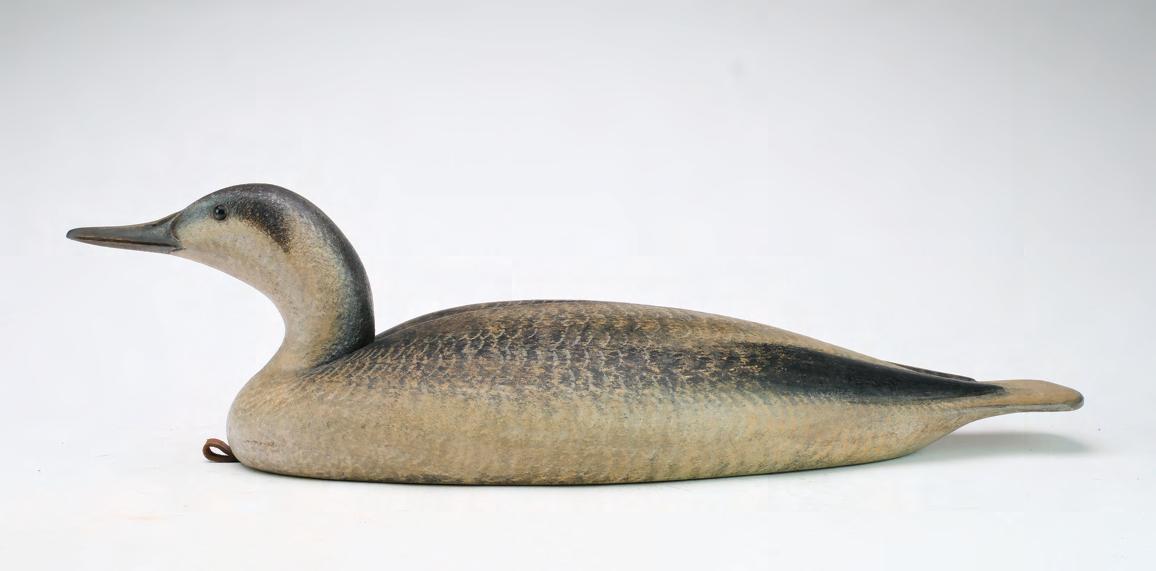
463 464
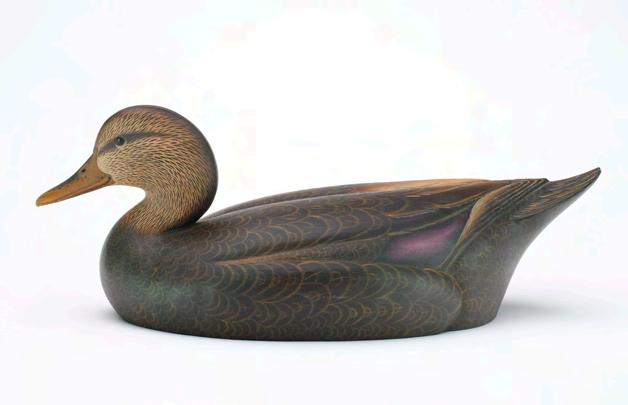

463 David Ward (1947-2020), Essex, Connecticut. Rare hollow carved immature loon. Slightly turned and uplooking head. Relief wingtip carving. “DBW” stamped on underside. Measures 26” long. Excellent and original.
(1,200 - 1,800)
464 Leo McIntosh (1953-2007), Adams, New York. Excellent hollow carved black duck with slightly turned head and relief wing feather carving. Maker’s name carved in the underside. Measures 16.25” long. A few minor paint rubs on edge of tail, otherwise excellent.
Provenance: Randy Rall collection. (500 - 800)
466 David Ward (1947-2020), Essex, Connecticut. Pair of cork black ducks. One in sleeping position and one with slightly turned head. Both with wooden bottom board and inserted tail. Both stamped “DBW” stamped on the underside. Measures 16.5” and 17.75” long. Slightly uneven varnish layer that dripped on one side, otherwise excellent and original.
Provenance: Jim and Patti Aikin collection.
(600 - 900)
467
468
George Strunk (b.1958), Glendora, New Jersey. Pair of full body, standing full size hollow canvasbacks. Each with turned head, raised crossed wingtips, carved tails. Mounted on wooden base. Signed on underside of base. Drake stands 14.5” tall. Near mint. (1,500 - 2,000)

George Strunk (b.1958), Glendora, New Jersey. Stylish pair of woodducks. Drake’s head is turned. Comb is slightly sweeping to one side. Raised crossed wingtips. Carved tail, two piece hollow body. Signed and dated 04 on underside. Measures 15”. Excellent and original.
Provenance: Gordon Mulava collection. (1,000 - 1,500)
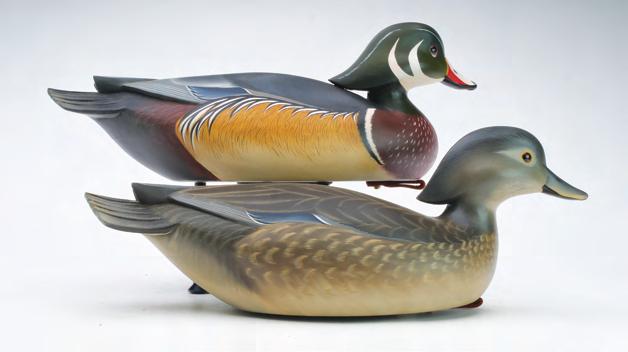
469
470
George Strunk (b.1958), Glendora, New Jersey. Canvasback hen with raised, crossed wingtips and carved tail. Signed by maker on underside. Head is slightly turned. 17” long. Excellent and original. (400 - 600)

George Strunk (b.1958), Glendora, New Jersey. Decorative Sora rail with deep relief wing carving and extended wing tips. Signed on the underside of base. Measures 6.75” long and stands 6.25” tall. Excellent and original. (400 - 600)



John
Decorative bird tree. Contains eight folk art carved birds with split tail and relief wing carving. Mounted on branch and colorful base. Stands 22” tall. One branch had to be reset, otherwise excellent and original.
(800 - 1,200)
(800 - 1,200)
475 Don Briddell (b.1944) Mt. Airy, Maryland. Excellent pair of decorative widgeon with raised, crossed wingtips and deep relief wing carving. Hen in preening pose, drake with tucked and slightly turned head. Both identified, signed, and dated 1990. Measure 12” and 13” long. Tiny paint rubs on one side of each and on tip of drake’s tail, otherwise excellent.
(1,200 - 1,800)

476 Reggie Birch (b.1953), Chincoteague, Virginia. Pair of oversize red-breasted mergansers in the Massachusetts style. With relief wing carving and high heads. Maker’s ink stamp and name carved on the undersides. Measure 22.5” long. Fine hairline crack in one side of hen’s neck, otherwise excellent and original.
(1,000 - 1,400)
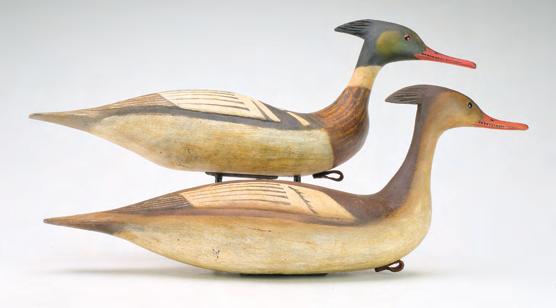
477 Josef Wooster (1934-2008), Buckeye Lake, Ohio. Hollow carved ross goose with relief feather carving and excellent bill detail. Identified and signed on the underside. First place winner at US National Championship 1972. Measures 17.75” long. Very good and original.
Provenance: Jim and Patti Aikin collection.
(800 - 1,200)
478 Josef Wooster (1934-2008), Buckeye Lake, Ohio. Hollow carved greenwing teal with tucked head and relief wing feather carving. Thick comb feather paint detail. Signed and dated ‘72. First place teal Davenport, Iowa 1972. Measures 10.5” long. Discoloration at bottom board on lower 1” of decoy; area of paint shrinkage on breast.
Provenance: Jim and Patti Aikin collection. (400 - 600)
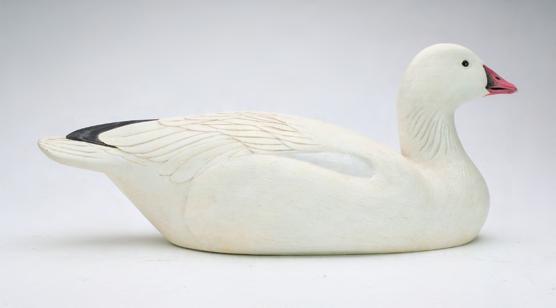
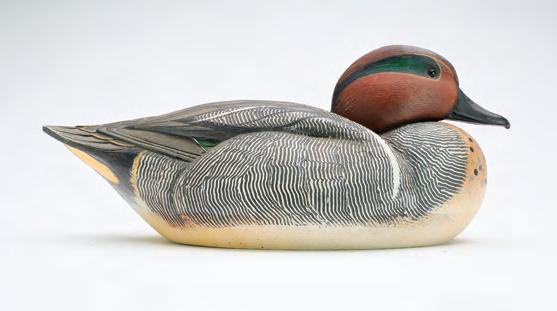
479 Josef Wooster (1934-2008), Buckeye Lake, Ohio. Competition coot with relief wing carving and slightly turned head. Signed and dated ‘72. Writing on underside indicates it won first place at the Ward’s World Championship in May 1972. Measures 10.75” long. A few tiny paint rubs, otherwise excellent.
Provenance: Jim and Patti Aikin collection. (400 - 600)
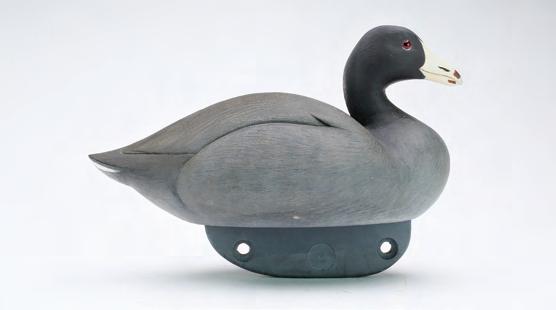 476
475
478
476
475
478
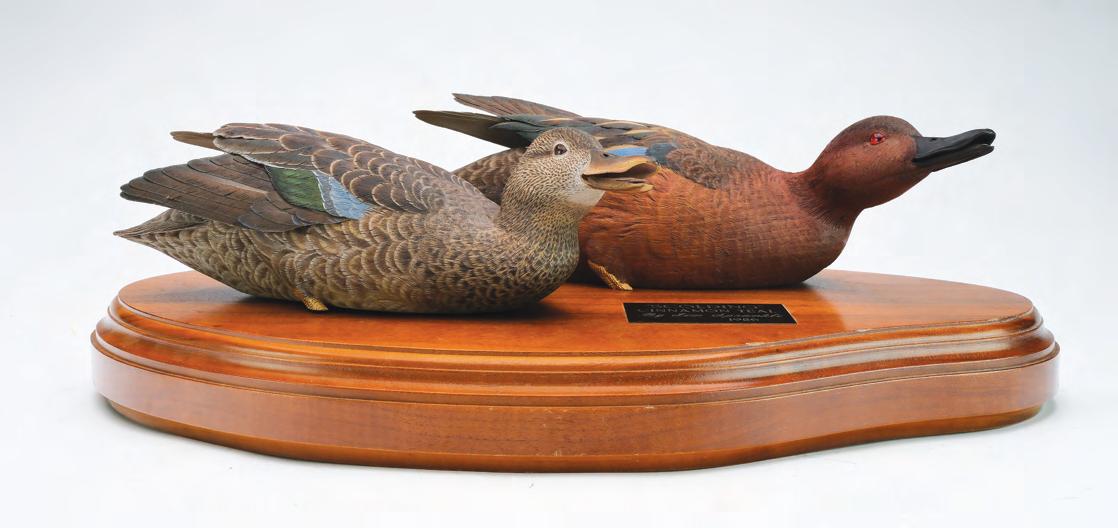

480 Jim Sprankle (b.1934), Sanibel Island, Florida. Excellent pair of decorative cinnamon teal with open bills and raised wings. Highly detailed feather carving. Teal are hollow carved and attached by velcro to a hardwood base. Plaque on base titles the pair “Scolding” Cinnamon Teal. Base measures 22” across. Tiny chip repair on the tip of one raised wing feather on drake, otherwise outstanding. (4,000 - 6,000)
481 Jim Sprankle (b.1934), Sanibel Island, Florida. Outstanding decorative widgeon with open bill and raised wings. Hollow carved with highly detailed feather carving. Identified, signed, and dated 1987 on the underside of bird. Round hardwood base that rotates included. Carving velcros to the base, but is removable. Measures 14.75” long. Very well done professional repair to a few chips on tips of tail feathers, otherwise outstanding. (4,000 - 6,000)
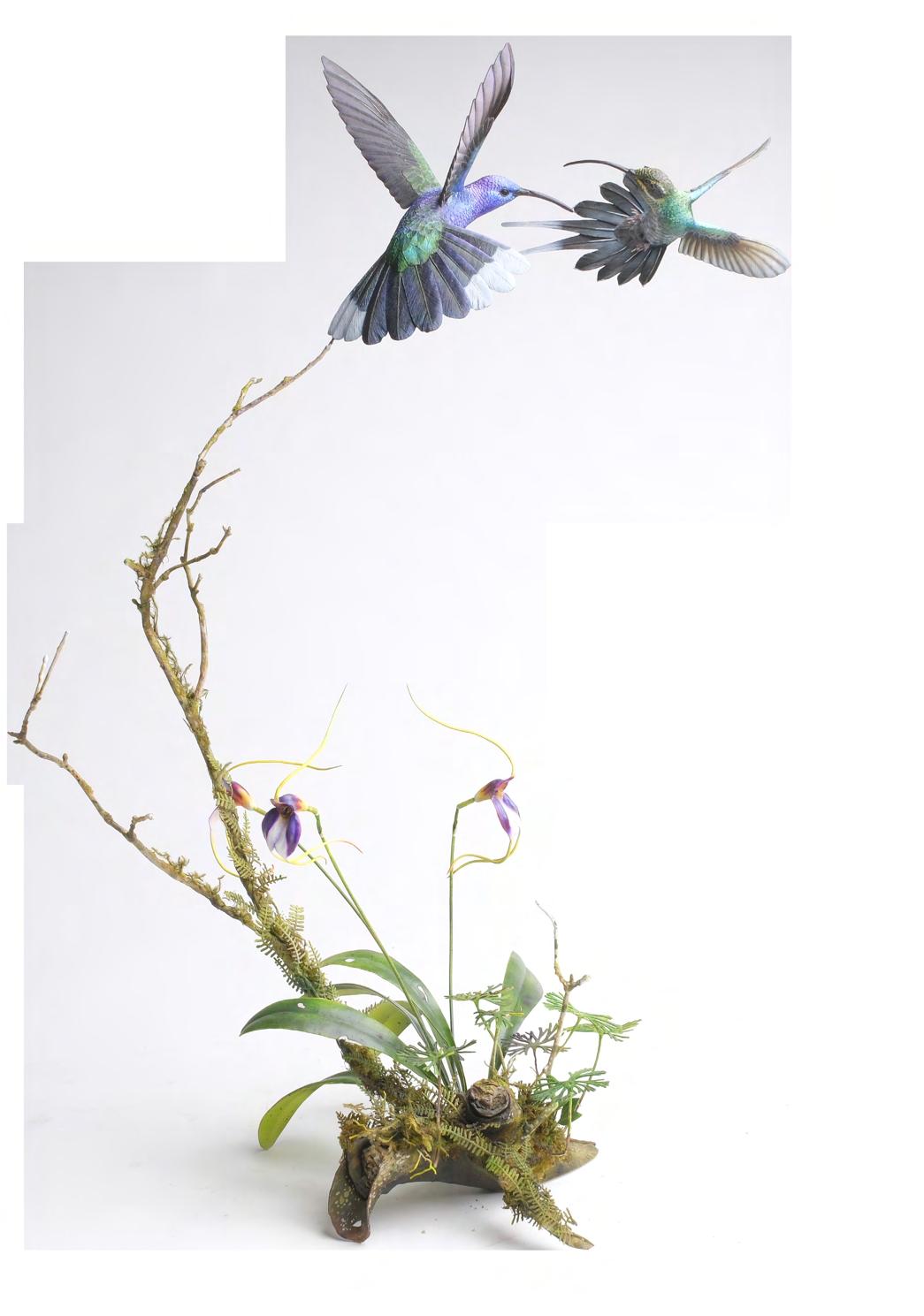

482 An incredibly well carved violet saberwing and green hermit, Thomas Horn, Emmaus, PA, 2012. This exact carving won first place in the Ward World Championship, 2012. Stands 23” tall. Excellent and original. (8,000 - 12,000)

Ontario. Exceptional world championship entry of two least bitterns. One on nest, with wing outstretched. Other clutching cattails. A carved wooden monarch butterfly is resting at top of cattail. Highly detailed feather carving. Glass eyes. Hen that is in nest is covering eggs, one of which is slightly exposed at the bottom of her front breast. Standing 25” tall, and approximately 15” wide. Excellent and original.
(5,000 - 8,000)
(4,000 - 7,000)
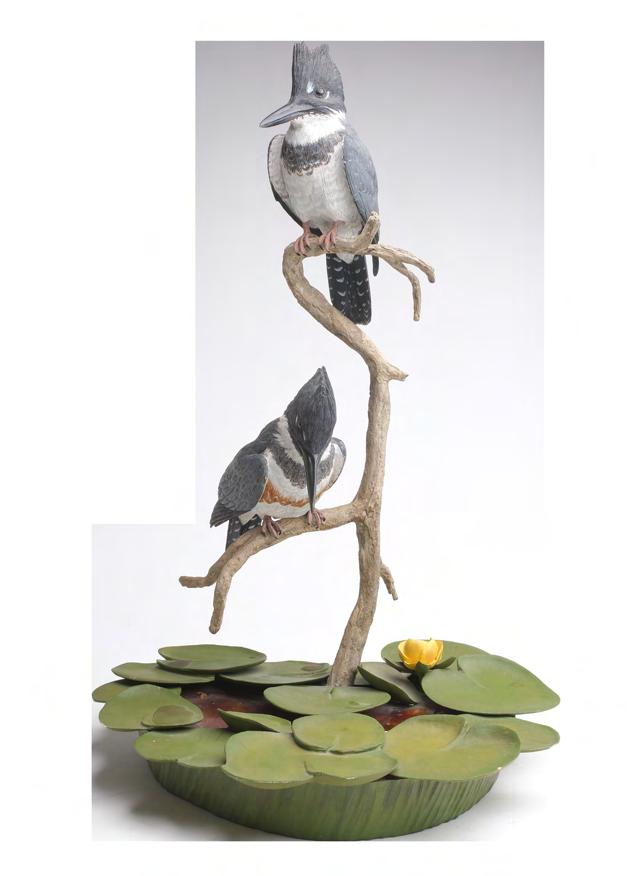
485 E.E. Jarvis, Toronto, Ontario. Pair of decorative woodcock on round base with leaves and moss. Highly detailed feather carving. Dated 1986. Birds measure 7.5” and 9.5” long. Minor chipping at tips of tail feathers were darkened, otherwise excellent and original. (3,000 - 5,000)


486 Gilles Prud’homme, Sudbury, Ontario. “Common Grackle” 2010. Ivy branches made from metal, rocks, post and bird are carved wood. Measures 24” in length, 17.5” tall. Remains excellent and original. (4,000 - 6,000)


Signed and dated ‘88 on underside. Hawk has slightly spread wings and very detailed feather
Glass eyes and open mouth. Perched on a part of a fence post with barb wire. Carved wooden stones and even an acorn tucked in between the post and a rock. Measures 24” tall. Very good and original.
Provenance: Herrington collection. (4,000 - 6,000)


John’s parents, Herbert and Anna, immigrated to the United States in 1920 from Romania. His father was hard working and industrious, employed as an ice and coal delivery driver at the time John was born. By the time John was eleven, his father was the proprietor of a coal and ice delivery business of his own, eliminating the ice portion of the operation by 1950 to concentrate on coal deliveries. This work ethic was instilled in John who, at age 21, was working 54 hours per week as a “filling station attendant”. One record suggests that by 1954 he was working at the Kier Sign Co in the Detroit suburb of Lincoln Park. This may have been the beginning of his artistic leanings for, by 1968, he was a member of the Michigan Consolidated Gas Company’s display department staff.
Zachmann came by his interest in decoys naturally, hunting on Lake St Clair with fellow sportsman and decoy carver Nick Purdo. Another of his shooting companions was James Shea, a naturalist and taxidermist with the Drayton Plains Nature Center. The men enjoyed “sneak shooting”, a method where attention to detail in the decoys was of paramount importance if one expected any degree of success. Apparently, Zachmann caught on quickly and began to carve outstanding decoys for his own use.
He first entered a decoy competition in the early 1960’s at the annual Duck Hunters Tournament held at Pointe Mouille, MI and was awarded a first place in the marsh duck competition. This was to herald the beginning of his long string of carving successes. In 1963, his mallard won first place at the National Decoy Show in Syracuse, NY. Numerous awards quickly followed with a number of “Best in Shows” in contests as distant as Bangor, Maine, and in 1965, both the International Decoy Contest in Davenport, Iowa and the Canadian National competition.
These early victories and accomplishments were to be repeated in succeeding years. Today, his work is prized for its attention to both anatomical detail and his accurately painted plumage. His were working


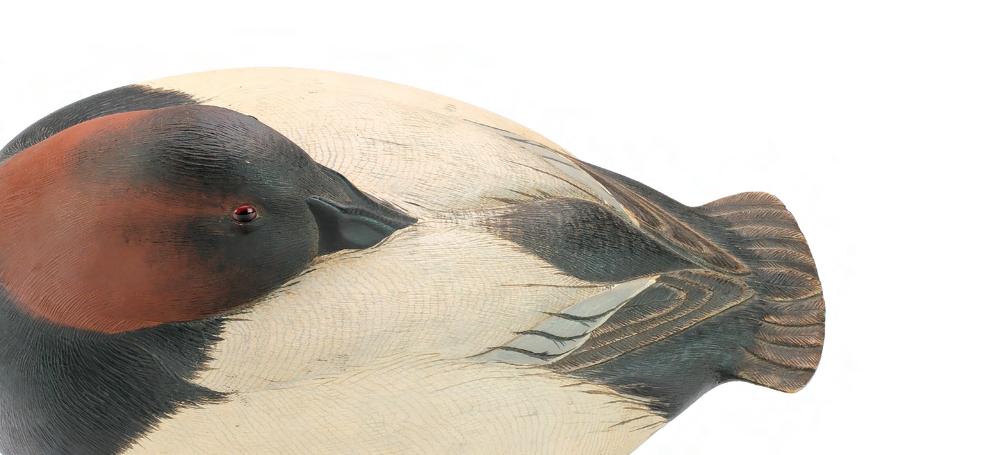
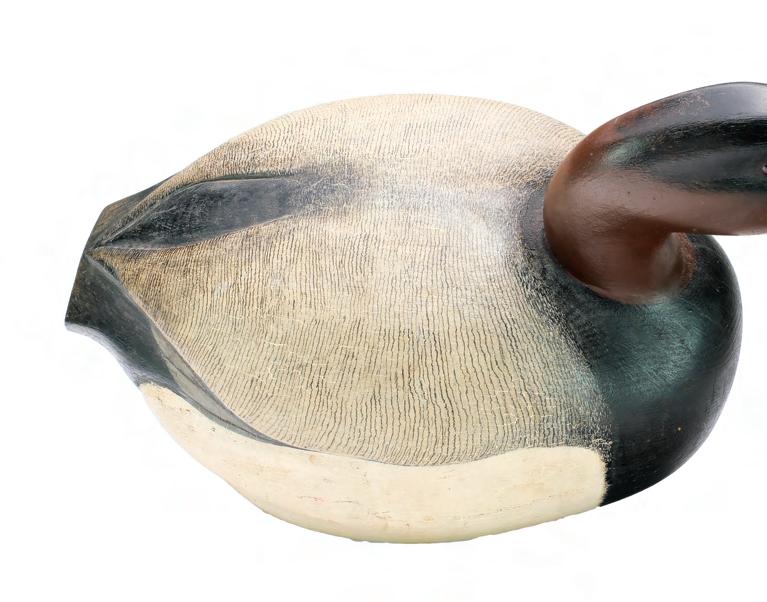
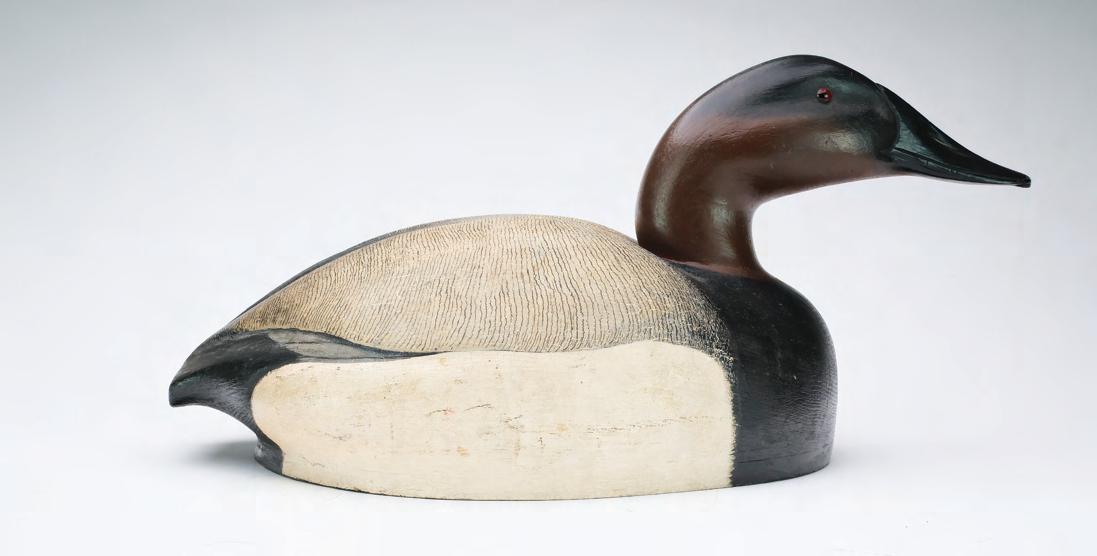

491 John Zachman (20th century), Detroit, Michigan. Oversized canvasback drake with relief wing and detailed bill carving. Hollow carved with .75” bottom board. Was third place at the Midwest Decoy Contest 1960/1961. Measures 20” long, and 11” wide. Original paint with minor wear; thin coat of varnish has caused tight paint shrinkage on much of the back paint; small dent in tip of bill.
Provenance: Jim and Patti Aikin collection. (2,000 - 3,000)
492 John Zachman (20th century), Detroit, Michigan.
Oversize mallard drake with relief wing and incised feather carving. Red felt on underside. Measures 19” long. Thin layer of varnish has darkened slightly; hairline cracks at front of neck seat, otherwise excellent and original.
Provenance: Jim and Patti Aikin collection. (4,000 - 6,000)

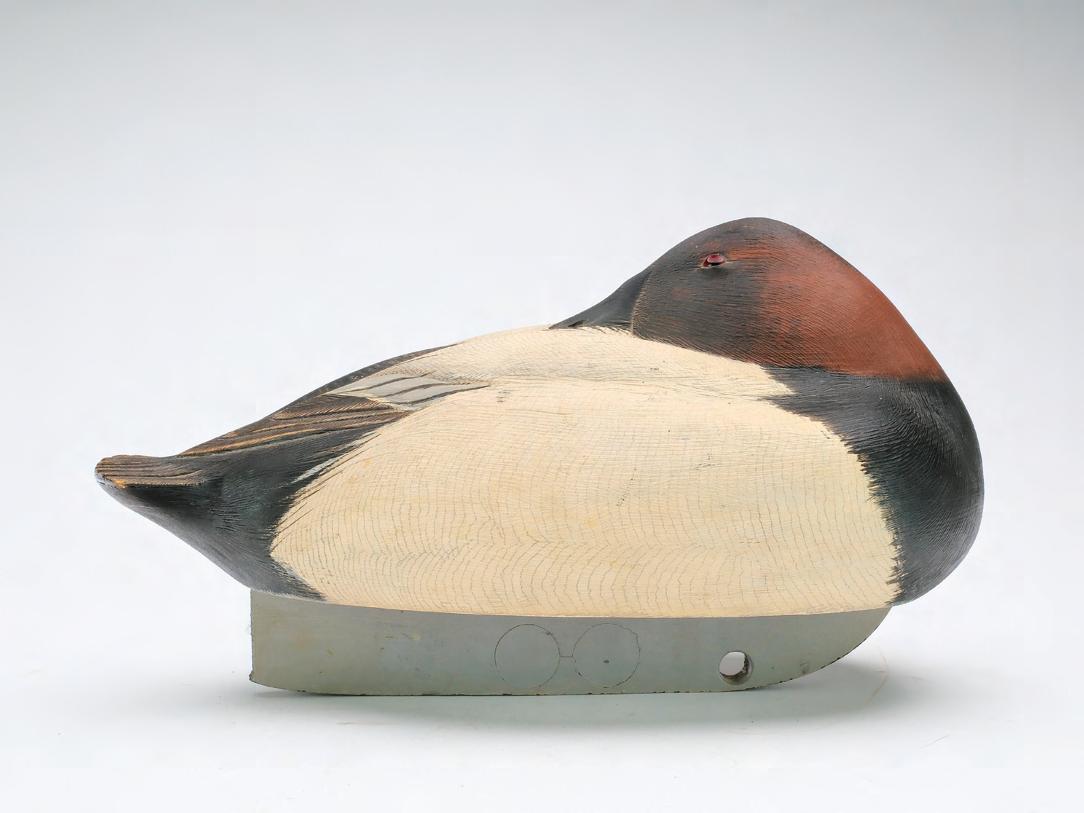
493 John Zachman (20th century), Detroit, Michigan. Hollow carved sleeping canvasback with relief wing and tail feather carving. Scratch feather paint detail on body. Weighted wooden keel on underside. Measures 14” long. Thin layer of varnish has darkened slightly; minor paint flaking on edge of tail, otherwise excellent and original.
Provenance: Jim and Patti Aikin collection. (1,500 - 2,500)
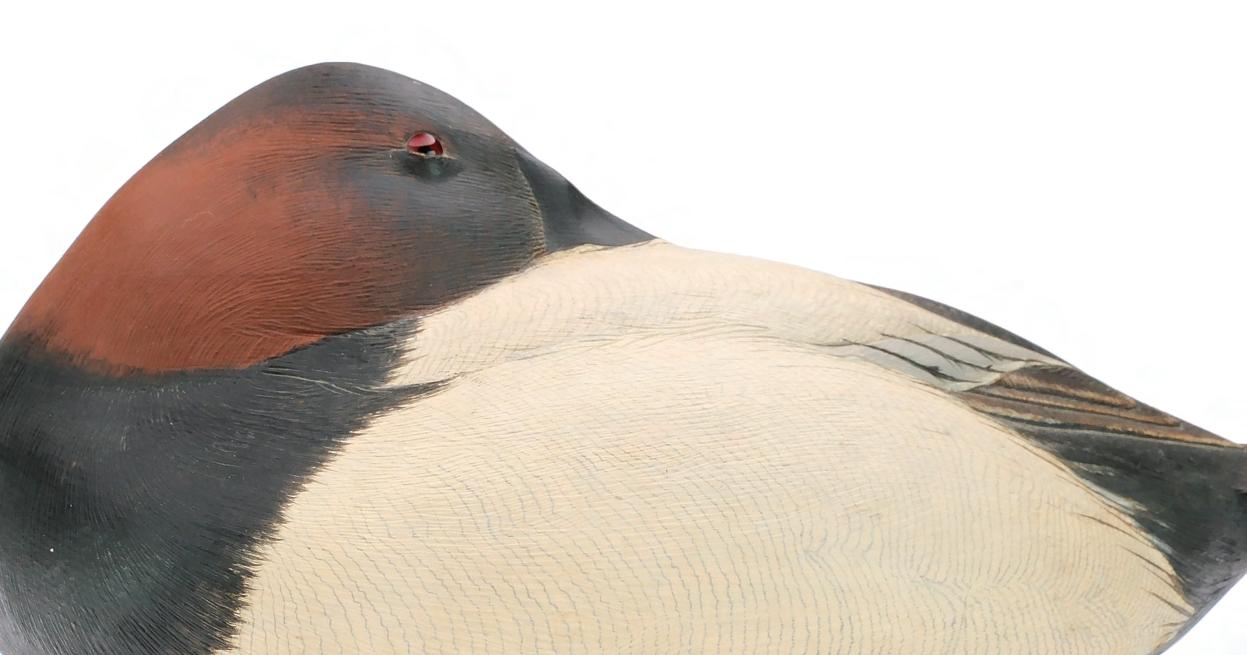

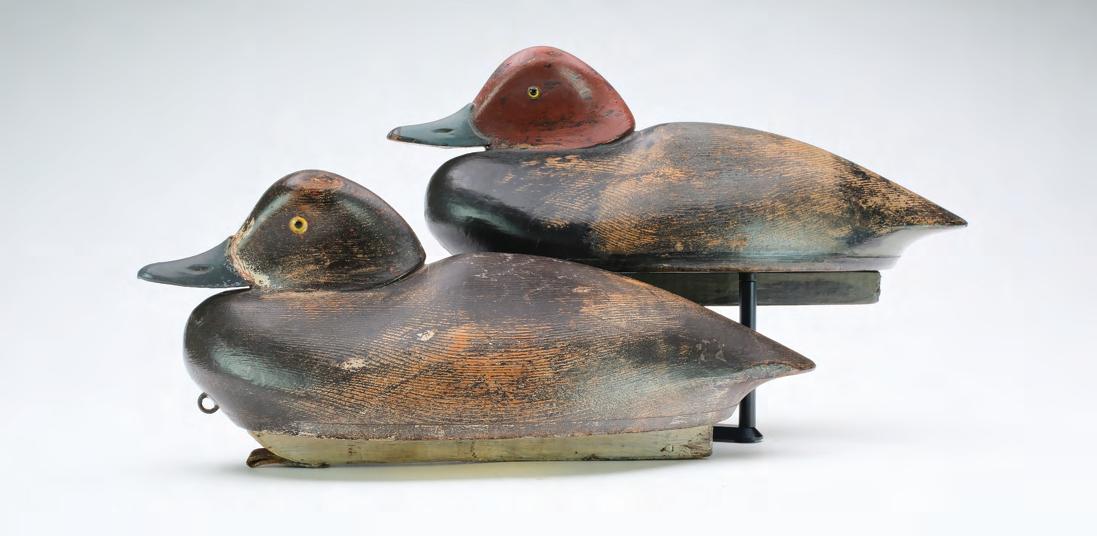
494
Thomas Schroeder (1886-1976), Detroit, Michigan. Redhead pair, 2nd quarter 20th century. Box bottom rig style. Carved bodies and tails. Layer of .25” cork added to bottom. 14” long. Original paint protected by a coat of varnish; light gunning wear.
Provenance: Jim and Patti AIkin collection. (2,000 - 3,000)
495 Nate Quillen (1839-1908), Rockwood, Michigan. Pair of lowhead redheads. Thinly hollowed with .25” bottom boards and inlayed neck seats. Both are branded “J.C.M.” for J. C. Morse, Pointe Mouille Shooting Club member from 1894-1900. Measure 13.25” long. Old overpaint was taken down to an earlier surface showing moderate wear; dents and shot marks, and very minor roughness on edge of one bill.
Literature: “Waterfowl Decoys of Michigan and the Lake St. Clair Region”, by Clune Walsh and Lowell Jackson, plate 10, exact decoys pictured. (2,500 - 3,500)
496 William Finch, Port Huron, Michigan. Rigmate pair of bluebills, 1st quarter 20th century. Solid body with “W.H. Finch” branded in both. Measures 14” long. Original paint with light gunning wear; structurally good.
Provenance: Jim and Patti AIkin collection. (500 - 800)
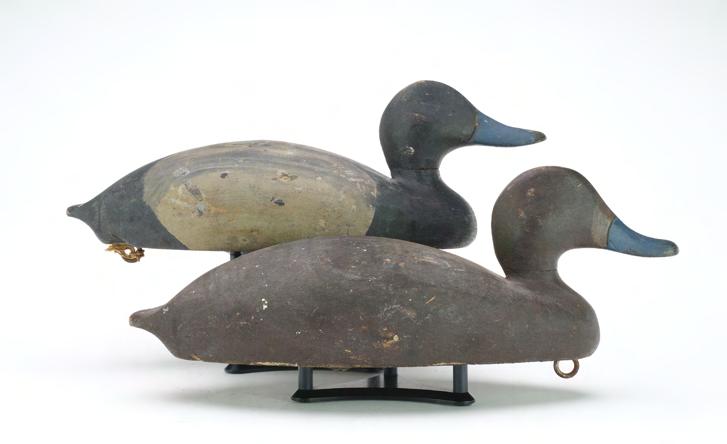
497 William Finkel (20th century), Port Huron, Michigan. Hollow carved black duck with scratch feather paint detail. Measures 16.75” long. Original paint with minor to moderate wear; and fine crazing throughout; minor roughness on edge of bill; a few small dents in one side.
Provenance: Jim and Patti Aikin collection. (800 - 1,200)
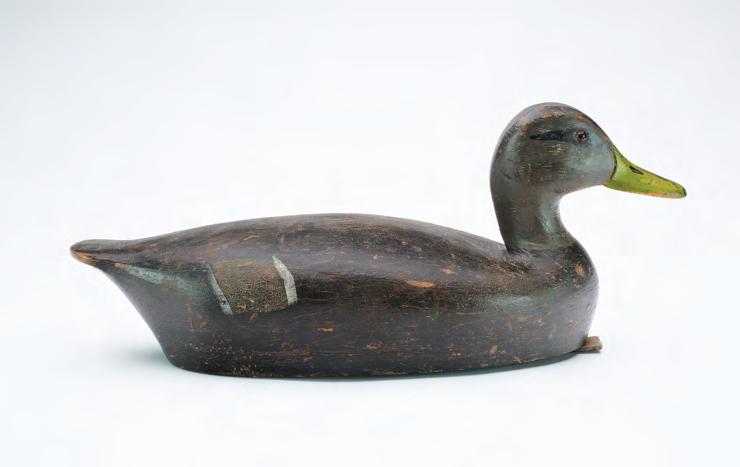
498 Andy Meyer (20th century), Saginaw Bay, Michigan. Hollow carved canvasback drake with Meyers iconic keel. Measures 16” long. Original paint with rubs; marks from discoloration and some paint loss; tight crack in bill. small amount of working repaint to front of head and bill.
Provenance: Jim and Patti Aikin collection. (400 - 600)



499 Chauncey Wheeler (1888-1945), Alexandria Bay, New York. Round body style brant with “thorn in heart” carving on back. Glass eyes. Two piece solid body. Measures 18.5” long. Original paint with edge wear around tail; one chip in that area that has been reglued; two cracks at and below neck seat; fine drops of white paint on back.
Provenance: Randy Rall collection. (3,000 - 4,000)
500 Fairman Davis (1884-1953), Alexandria Bay, New York. Small goldeneye hen with appealing paint pattern. Noyes Museum ink stamp on underside, as well as ink stamps from the Mackey collection and the Scully collection. Measures 12” long. Original paint with minor to moderate wear; lightly hit by shot with two shot strikes colored in; white on lower sides appears to be a thin second coat of paint; small bill chip repair in the underside of the tip of bill.
Provenance: Mackey collection. Robert Congdon collection. Scully collection. Randy Rall collection.
(1,200 - 1,800) 499 500
501 Unknown maker, Alexandria Bay, New York, 2nd quarter 20th century. Goldeneye hen with appealing paint detail and red painted triangle rig mark on underside. Measures 14” long. Original paint with minor crazing and wear; small wooden plugs or knots in underside and back have risen slightly; small dent in one side of face; minor roughness on edge of tail; hairline crack in base of neck.
Provenance: Randy Rall collection. (800 - 1,200)

502 Gus Rogers (1892-1938), Alexandria Bay, New York. Bluebill hen with raised neck seat and carved eye grooves. “Donald B. Baxter, Syracuse, New York” on copper tag nailed to the underside. Measures 14.25” long. Original paint with moderate wear; small chip on one side of bill tip; minor separation at a long knot in back.
Provenance: Randy Rall collection. (1,000 - 1,400)

503 Chauncey Wheeler (1888-1945), Alexandria Bay, New York. Goldeneye hen with raised neck seat and carved eye grooves. Measures 14.25” long. Original paint with minor flaking and wear; hit by shot with many filled; some repaint to flaking on head; black on tail area is repainted.
Provenance: Randy Rall collection. (1,200 - 1,800)
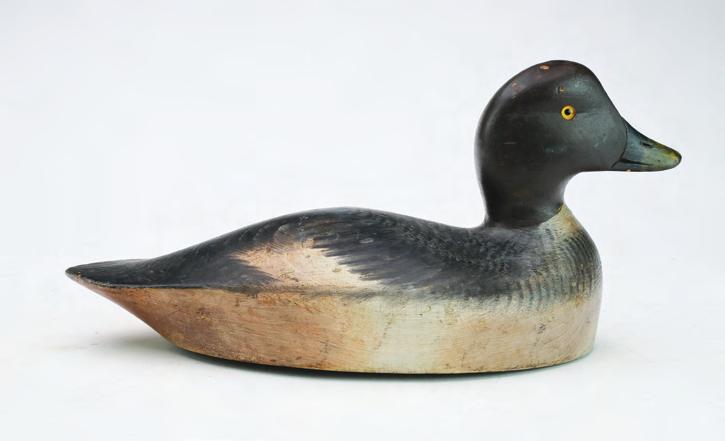


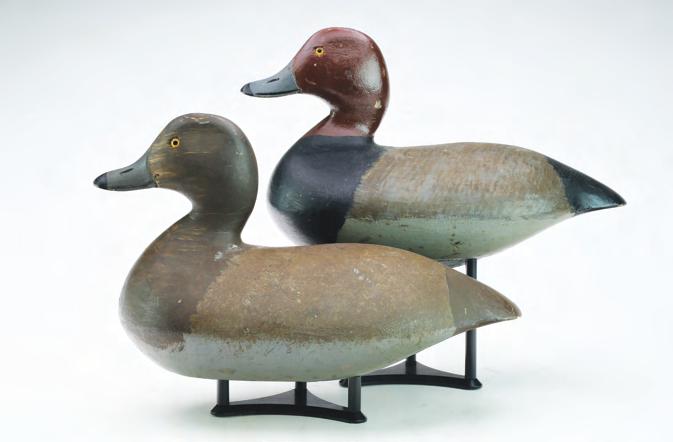
504 Cyril Heath (20th century), Alexandria Bay, New York. Goldeneye hen. 14” long. Original paint protected by a light coat of varnish; minor gunning wear; a few small shot scars.
(500 - 800)
505 Fairman Davis (1884-1953), Alexandria Bay, New York. Rigmate pair of black ducks with typical hard chine line carving on the sides. Measure 17.25” long. Original paint with minor to moderate gunning wear; hairline crack in one bill; the other has been cracked and tightly reset.
(1,500 - 2,500)
506 Seymour Smith. Excellent rigmate pair of redheads with reared back heads. Measure 12.75” long. Original paint with very minor gunning wear; under a thin coat of varnish that has darkened slightly; drying crack along the underside of hen; hen also has a small chip in underside of tail and dent on top of head.
Provenance: Randy Rall collection. (800 - 1,200)
507 Julius Mittelstaedt, Buffalo, New York. Black duck with tack eyes and “JEM” carved in underside for Julius Mittldestadt. Measures 17” long. Very light gunning wear; original paint; tight crack in neck; one shot mark in head.
Provenance: Randy Rall collection. (600 - 900)

508 Ken Harris (1905-1981), Woodville, New York. Mallard pair, 2nd quarter 20th century. Made from pine. “Harris” stamp on underside of drake. Minimal shelf wear. Measures 14.5” long. Unused. (400 - 600)

Ken Harris (1905-1981), Woodville, New York. Canvasback hen. Stamped on underside. Cedar body. 16” long. Excellent original paint; very light gunning wear; rough edge at one side of bill; possible puppy chew at tip of bil.
Provenance: Randy Rall collection. (400 - 600)

Provenance: Randy Rall collection. (600 - 900)
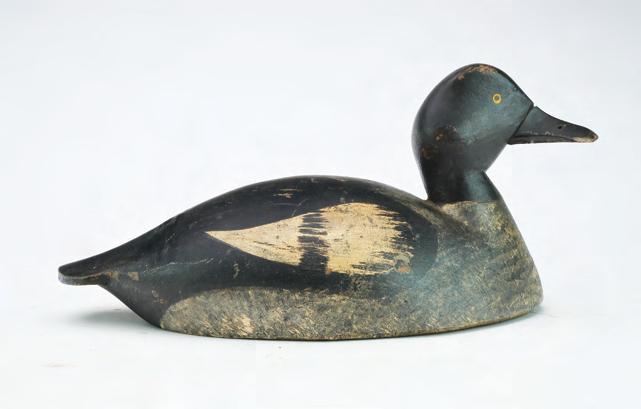 509
510 Ed Dingman. Goldeney hen. Measures 13.25” long. Original paint with very minor discoloration and wear; filler at a long knot in back near tail was touched up at some point.
507
509
509
510 Ed Dingman. Goldeney hen. Measures 13.25” long. Original paint with very minor discoloration and wear; filler at a long knot in back near tail was touched up at some point.
507
509

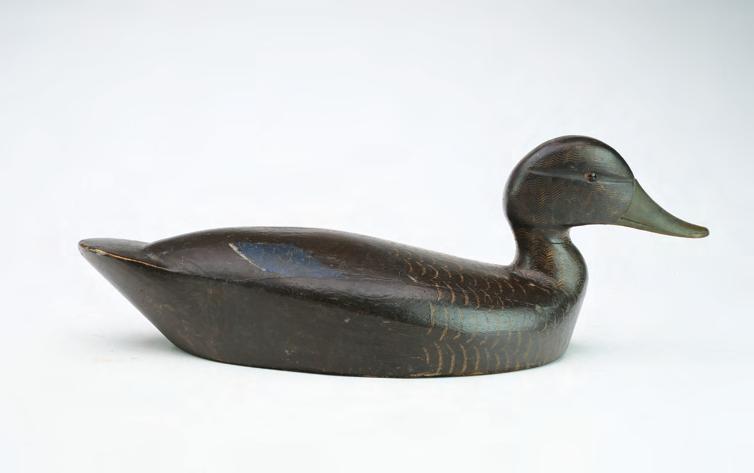
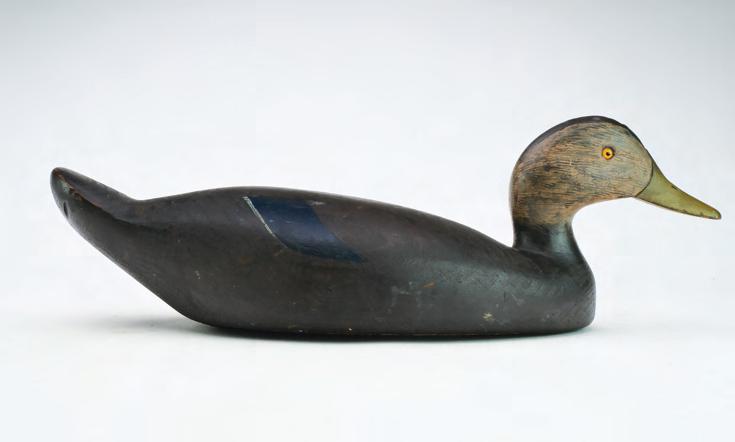
511 Rosh Douglas (1878-1962), Ogdensburg, New York. Pair of goldeneye with reared back heads. Measure 13” long. Original paint with minor flaking and wear; tight drying cracks in back; tight crack in hen’s bill was reset with the early touchup.
Provenance: Randy Rall collection. (600 - 900)
512 Ed McNeil. Black duck with scratch feather paint detail and sharp eye groove carving. Measures 17.75” long. Original paint with minor to moderate wear under a thin coat of varnish; filled drying cracks in body; slight separation at raised neck seat.
Provenance: Randy Rall collection. (800 - 1,200)
513 Frank Coombs (1882-1958), Alexandria Bay, New York. Black duck with scratch feather paint detail on head. Measures 18” long. Original paint with very minor wear; small tail chip repair; professional bill crack repair.
Provenance: Randy Rall collection. (1,500 - 2,500)
514 Ken Harris (1905-1981), Woodville, New York. Pintail drake with pine body and fine comb feather paint detail. Measures 17.5” long. Excellent and original.
Provenance: Randy Rall collection. (400 - 600)

515 Ken Harris (1905-1981), Woodville, New York. Two black ducks with comb feather paint detail. An early style with slightly turned down looking head and deeply inset eyes. “C.D.” stenciled on the underside. The other shorter body style with slightly tucked head. Measure 16.25” long. Original paint with minor to moderate gunning wear; tucked head bird with a hairline crack in one eye; earlier bird with half the bill professionally replaced.
Provenance: Randy Rall collection. (500 - 800)

516 Ken Harris (1905-1981), Woodville, New York. Redhead hen with cedar body. With Harris’s large stamp on underside. So called Sockeye model. Measures 16” long. Excellent original paint; small amount of wear around the bill and one tiny mark at top of back.
Provenance: Randy Rall collection. (500 - 700)
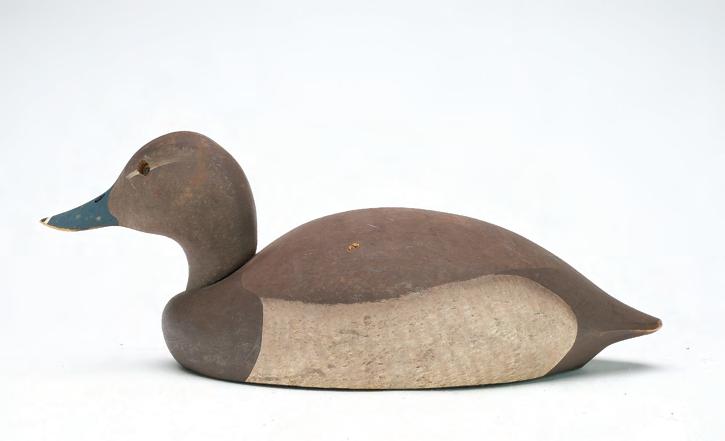
517

517 Ken Anger (1905-1961), Dunnville, Ontario. Decorative wood duck with extended crest carving and upswept tail. Green felt was removed from the underside at some point. Measures 13” long. Excellent and original. (3,000 - 4,000)

518
518 Art Chilton (1920-), Toronto, Ontario. Rare bluewing teal hen with relief wing carving and slightly turned head. Branded “AC” and stamped “ARC” on the underside. Measures 12.25” long. Excellent original paint with very minor discoloration and wear; excellent structurally.
Provenance: Randy Rall collection. (500 - 800)
519 Art Chilton (1920-), Toronto, Ontario. Rigmate pair of black ducks with relief wing carving and feather rasping. Scratch feather paint detail on heads. One in high head pose, and one in slight swimming pose. “AC” branded and “ARC” stamped on the underside. Measure 17” and 18” long. Excellent and original.
Provenance: Randy Rall collection. (1,200 - 1,800)

519a Art Chilton (1920-), Toronto, Ontario. Rigmate pair of canvasbacks with relief wing carving and feather rasping. “AC” branded and “ARC” stamped on the undersides. Measure 17.75” long. Very fine hairline crack in each of drake’s eyes, otherwise excellent and original.
Provenance: Randy Rall collection. (800 - 1,200)
519b Harold Wilkens (1877-1965), Owen Sound, Ontario. Rigmate pair of bluebills with heads turned 90 degrees. Measure 13” long. Excellent and original.
Provenance: Randy Rall collection. (600 - 900)

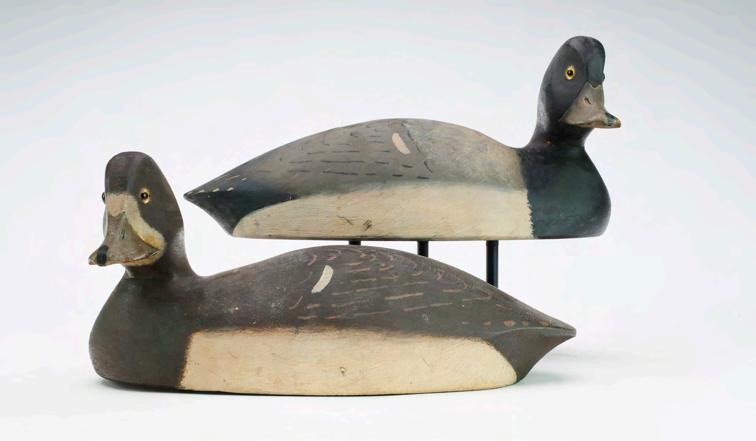
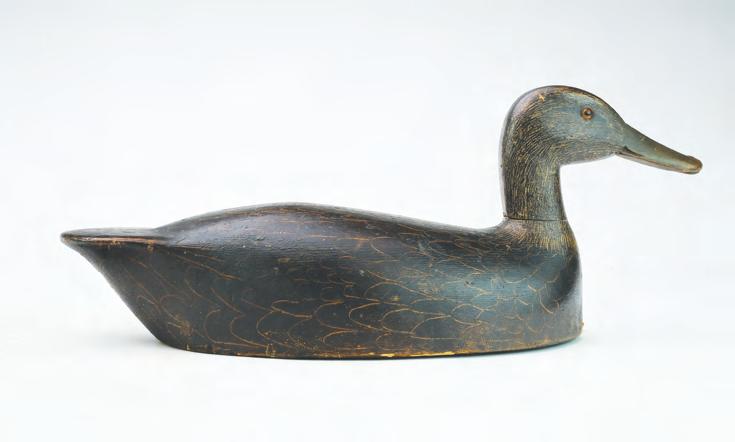


520 William Chrysler (1870-1940), Bellville, Ontario. Solid body model black duck with detailed scratch feather painting. Measures 17.5” long. Original paint with minor gunning wear under a thin coat of varnish; small dents and shot marks; minor separation at a filled defect in wood on one side from when the decoy was made.
Provenance: Preston Lowe collection. Randy Rall collection. (1,500 - 2,500)
521 Fred Croft (1880-1963), Belleville, Ontario. Hollow carved black duck with .25” bottom board and scratch feather paint detail. Slightly turned head. “FC” stamped four times on underside. Measures 14.75” long. Original paint with minor to moderate wear; very lightly hit by shot; second coat of paint on underside.
Provenance: Randy Rall collection. (1,500 - 2,500)
522 Unknown maker, Ontario, 1st quarter 20th century. Three rigmate black ducks with scratch feather paint detail and different head positions. Original paint with very minor wear; one with minor separation at neck seat; one with replaced eyes.
Provenance: Randy Rall collection. (1,500 - 2,500)
Ray
Gananoque, Ontario. Pair of goldeneye. Measure 12” long. Original paint with minor gunning wear; a few small dents, otherwise very good structurally.
Provenance: Randy Rall collection. (1,200 - 1,800)

Dunnville, Ontario. Early style pair of bluebills. Measures 14.5” long. Minimal to light gunning wear; original paint. (400 - 600)

525 Unknown maker, Ontario, 2nd quarter 20th century. Three piece flying black duck with applied wooden wings that swivels. Measures 22” long, with a 29.5” wingspan. Mix of original and early in use touchup with moderate wear; small dents cover much of the bird; old chip in underside of bill tip was reshaped; minor roughness on edges and tip of wings.
Provenance: Charlie Hunter, III collection. (500 - 800)
End of session two


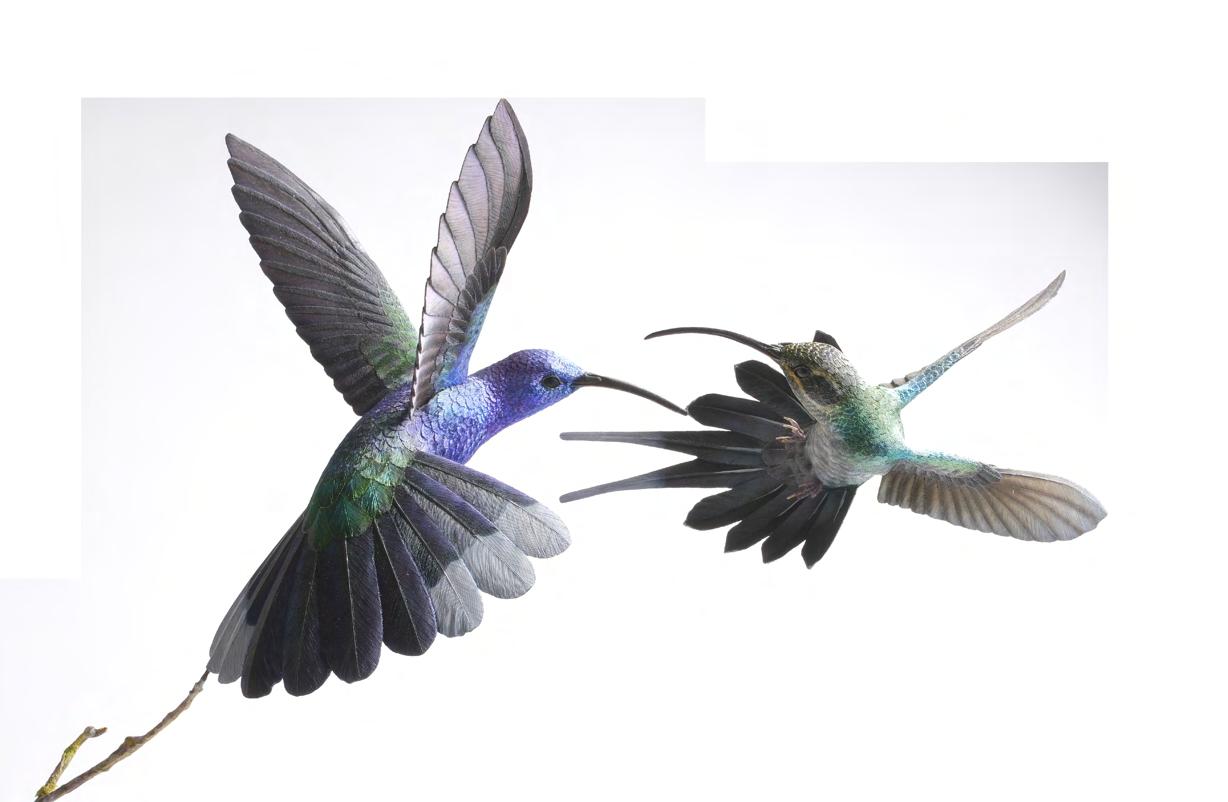
Lot 1
1.French, Joseph B. 1988. “Tracking the Elliston Decoy”. Wildfowl Carving and Collecting Magazine, Summer. Harrisburg, PA.
2.Koehler, Gary. 2006. “Duck Towns” Ducks Unlimited, May. www.ducks.org/
3.Parmalee, Paul W and F. D. Loomis. 1969. “Decoys and Decoy Carvers of Illinois”. Northern Illinois University Press. DeKalb, IL.
4.Resetich, Mike. 2007. “Illinois Valley Duck Clubs”. Outdoor Illinois Journal, October. Springfield. IL.
5.Tonelli, Donna. 1998. “Top of the Line Hunting Collectibles”. Schiffer Pub. Atglen, PA.
1.Tonelli, Donna. 1992. “Charles Walker – A Classic Decoy Maker From The Illinois River”. Decoy Magazine, Nov./Dec.. Burtonsville, MD.
2.Zetterberg, Zac and B Drake (eds). 2019. “American Decoy – The Invention”. Privately published by Peoria Riverfront Museum. Peoria, IL.
Lot 2
1.French, Joseph B. 1988. “Tracking The Elliston Decoy”. Wildfowl Carving and Colleting magazine, Summer. Harrisburg, PA.
2.Tonelli, Dona. 2020. “Robert and Catherine Elliston – Forerunners of the Illinois River Style”. Decoy Magazine Jan/Feb. Lewes DE.
Lot 34
3.Mackey, William J Jr. 1965. “Harry Van Nuckson Shourds”. Decoy Collectors Guide Jan./Feb./March. Hal Sorenson Publisher. Burlington, Iowa.
4.Starr, George Ross Jr, MD. 1974. “Decoys of the Atlantic Flyway”. Winchester Press, New York, NY.
1.Crandall, Bernard W. 1976. “George Peterson and Jasper Dodge – Two Early Detroit Decoy Makers”. North American Decoys, Spring. Hillcrest Pub. Spanish Fork, UT.
2.Delph, John and Shirley. 1980. “Factory Decoys of Mason, Stevens, Dodge and Peterson”. Schiffer Publishing Ltd. Exton, PA
3.Dodge, Bill. 1991. “The Factory Decoys of Jasper Newton Dodge”. Decoy Magazine July/August. Burtonsville, MD.
4.Sharp, Ron and B. Dodge. 2009. “Detroit Decoy Dynasty – The Factory Decoys of Peterson, Dodge and Mason”. Hunting and Fishing Collectibles Magazine Pub. Lawsonville, NC.
Lot 6
1.Haid, Alan G. “The Allure of the Decoy”. Privately printed, The Historic Charleston Foundation. Charleston, SC.
2.Parmalee, Paul W and F.D. Loomis. 1969. “Decoys and Decoy Carvers of Illinois”. Northern Illinois University Press. DeKalb, IL.
3.Tonelli, Donna. 1993. “Charles Schoenheider Sr. – The Maker of Magnificent Standing Ice Decoys”. Decoy Magazine May/June. Burtonsvulle, MD.
4.Tonelli, Donna. 1998. “Top of the Line Hunting Collectibles. Schiffer Pub Ltd. Atglen, PA.
5.Zetterberg, Zac and Barbara Drake (eds). 2019. “American Decoy – The Invention”. Privately printed Peoria Riverfront Museum. Peoria, IL.
Lot 35
1.Cheever, Byron. 1974. “Mason Decoys”. Hillcrest Publications. Heber City, UT.
2.Delph, John and Shirley. 1980. “Factory Decoys of Mason, Stevens, Dodge and Peterson”, Schiffer Pub Co. Exton, PA.
3.Fleckenstein, Henry A Jr. 1981. “American Factory Decoys”. Schiffer Pub Co. Exton, PA.
4.Goldberger, Russ J and A. G. Haid. 1993. “Mason Decoys – A complete Pictorial Guide”. Decoy Magazine Pub. Burtonsville, MD.
5.Hemming, Kingdom B. 1963. “More Mason Shorebirds”. Decoys Collectors Guide No 3. Hal Sorenson Pub. Burlington, IO.
6.Sharp, Ron and Bill Dodge. 2009. “Detroit Decoy Dynasty – The Factory Decoys of Peterson, Dodge, and Mason”. Hunting and Fishing Collectibles Magazine Pub. Lawsonville, NC.
7.Trayer, Kenneth L. 2003. “North American Factory Decoys – A Pictorial Identification and Reference Guide”. Decoy Magazine Pub. Lewes, DE.
Lot 7
1.Haid, Alan G and B.S. Culp. 2013. “The Allure of the Decoy”. Privately printed by the Historic Charleston Foundation. Charleston, SC.
2.Haid, Alan G. “Decoys of the Mississippi Flyway”. Schiffer Publishing Ltd. Exton, PA.
3.Husar, John. 1998. “Perdew- An Illinois Treasure” Chicago Tribune, Aug23. Chicago,IL.
4.Lacey, Ann T. 1993. “Perdew – An Illinois RiverTradition”. David A Galliher Pub. Muncie, Indiana
5.Schurter, Holly. 2006. “Charles and Edna Perdew Museum”. Outdoor Illinois, September. Illinois Dept. Natural Resources, Springfield, IL.
6.Zetterberg, Zac and B Drake (eds). 2019. “American Decoy – The Invention”. Privately published by Peoria Riverfront Museum. Peoria, IL.
Lot 37
1.Cheever, Byron. 1974. “Mason Decoys” Hillcrest Pub.
2.Goldberger, Russ J and A.G. Haid. 1993. “Mason Decoys – A Complete Pictorial Guide”. Decoy Magazine Pub. Burtonsville, MD.
3.Sharp, Ron and B Dodge. 2009. “Detroit Decoy Dynasty – The Factory Decoys od Peterson, Dodge and Mason”. Hunting and Fishing Collectibles Magazine. Lawsonville, NC.
Lot 44
1.Tonelli, Donna. 2010. “John R Wells and the Decoys of the Oak Lake Shooting Club”. Decoy Magazine, Jan/Feb. Lewes, DE.
2.. 1941. “J.B. Whitehead of Brandon Is Dead”. The Windsor Star, Sept 13. Windsor, Ontario, Canada.
Lot 61
Lot 10
1.Tonelli, Donna. 1997. “G. Bert Graves – Decoy Maker and Canvasback Hunter Extraordinaire”. Decoy Magazine March/April. Burtonsville, MD.
Lot 15
1.Barber, Joel. 1934. “Wildfowl Decoys” Garden City Publishing. Garden City, NY.
2.Baldwin, Richard P. 2000. “The Verity Family of Log Island, New York. Privately printed. Patchoque, N.Y.
3.French, Joe. 1994. “The Dilley Shorebirds – A Collectors Journey of Discovery”. Decoy Magazine Jan./Feb. Burtonsville, MD.
4.Mackey William J Jr. 1967. “Bill Bowman’s Decoys” 1966/67/Decoy Collectors Guide. Hal Sorenson Pub. Burlington, IO.
5.Reason, Jamie. 2004. “Charles Sumner Bunn – The True Maker of the Bowman Decoys”. Decoy Magazine, Jan./Feb. Decoy Magazine. Lewes, DE. 6.Shaw, Robert. 2010. “Bird Decoys of North America – Nature, History, and Art” Sterling Publishing. New York and London.
7.Sieger, Timothy et al. 2010. “The Decoys of Long Island”. Privately printed. Long Island Decoy Collectors Association. Water Mill, NY.
8.Townsend, E. Jane. 1979. “Gunners Paradise; Wildfowling and Decoys on Long Island”. The Museums at Stony Brook. Stony Brook, NY.
9.Weeks, George L. 1969. “Recollections of Seaford”. The Long Island Forum. Long Island.
10. 1982. “Obediah Verity – Classic Long Island Decoy Maker”. Decoy Magazine, Fall. Ocean City, MD.
Lot 73
Lot 91
1.Deeter, Jon and K Cole. 2009. “Frank or Ben Schmidt? – Distinguishing the Differences Between The Two Brothers”. Decoy magazine Nov./Dec. Lewes, DE.
2.Jackson, Lowell (ed). 1970. “Ben Schmidt – A Michigan Decoy Carver 1884 – 1966”. Privately printed Lowell Jackson, Birmingham, MI.
3.. 1955. “Spring Inspires Wood Carver”. The Detroit News, April 10. Detroit, MI.
1.Kangas, Gene and Linda. 1983. “Decoys – A North American Survey”. Hillcrest Publications. Spanish Fork, UT.
2.Walsh, Clune Jr and L.G. Jackson. 1983. “Waterfowl Decoys of Michigan and The Lake St. Clair Region”. Printed in Detroit, MI.
1.Avann, Keith. 2012 (Fall) and 2013 (Spring). “Walker T Morley and The Markham Rig”. Privately printed. Canadian Decoy and Outdoor Collectibles Association. Ontario,Canada.
2.Personal correspondence Mr. Paul Brisco
Lot 23
1.Beckerman, Kate. 2018. “Celebrating Cape Cod’s Master Carver”. Antiques and the Arts Weekly, August 7. Newtown, CT.
2.Connett, Eugene V (ed). 1947. “Duck Shooting Along The Atlantic Tidewater”. 1952. William Morrow and Co Inc. (Chapter on “Cape Cod Memories” by Elmer Crowell). New York, NY.
3.Cullity, Brian (curator).1992. “The Songless Aviary – The World of A. E. Crowell & Son”. Privately printed, Heritage Plantation of Sandwich. Sandwich, MA. 4.duMont, John S. 1987. “Elmer Crowell’s Decoys”. Reprinted in “The John S duMont Collection”. Privately printed. Northeast Auctions. Portsmouth, NH.
1.Kangas, Linda and Gene. 2010. “Connecting the Dots – Exploring the Provenance Of Elmer Crowell’s Decoys”. Decoy Magazine, March/April. Lewes, DE.
Lot 363 Lot 170 Lot 364
Lot 378
1.Cheramie, Brian et al.1997. “Louisiana Lures and Legends”. Rem Corporation Pub. Golden Meadow, LA.
2.Frank, Charles W Jr. 1985. “Wetland Heritage – The Louisiana Duck Decoy”. Pelican Publishing Co. Gretna, LA.
3.Frank, Charles W. 2003. “Voices From the Bayou – An Oral History”. Garity printing. Louisiana.
1.Hopkins, Gladys. 2016. “Massachusetts Masters – The Decoy as Art”. Privately printed. Massachusetts Audubon Society. Lincoln, MA.
2.Lindsey, Benjamin J. 1981. (reprint) “Old Marblehead Sea Captains and the Ships They Sailed On”. Marblehead Historical Society. Marblehead, MA.
3.Shaw, Robert. 2010. “Bird Decoys of North America – Nature, History and Art”. Sterling Publishing. New York and London.
1.Starr, George Ross Jr M.D. 1974. “Decoys of the Atlantic Flyway”. Winchester Press. New York, NY
1.Doherty, James R. 2011. “Classic New Jersey Decoys”. Privately printed. Philadelphia, PA.
Lot 29
1.Chitwood, Henry C. 1987. “Connecticut Decoys – Carvers and Gunners”. Schiffer Pub. West Chester. PA.
2.Connett, Eugene V. 1965. “Duck Shooting Along the Atlantic Tidewater”. Bonanza Books. New York.
3.Kangas, Gene. 2021. “The Milford Point Hotel & The Smith Family Decoys”. Decoy Magazine, May/June. Lewes, DE.
4.Merkt, Dixon MacD. 1984. “Shang – A Biography of Charles E. Wheler”. Hillcrest Publications. Spanish Fork, UT.
2.Fleckenstein, Henry A Jr. 1983. “New Jersey Decoys”. Schiffer Publishing. Exton, PA.
3.Gosner, Kenneth L. 1985. “Working Decoys of the Jersey Coast and Delaware Valley”. The Art Alliance Press. Philadelphia. PA.
4.Linkchorst, Allen. 2021. “Harry M Shourds – A Talented Chip Off the Old Block”. Decoy Magazine, Nov/Dec. Lewes DE.
5.Personal correspondence J.P. “Jamie” Hand
6.Personal correspondence Russell Allen
Lot 31
1.Doherty, James R. 2011. “Classic New Jersey Decoys”. Privately printed Philadelphia, PA.
2.French, Joe. 1996. Harry V Shourds – New Jersey’s Greatest Professional Decoy Maker”. Decoy Magazine, May/June. Burtonsville, MD
Lot 491
1.Smits, Lee. 1968. “John Zachmann – A Michigan Winner”, North American Decoys, Oct/Nov/Dec. Privately published Byron and Maureen Cheever. Herber City UT.

While you continue to enjoy collecting today, you can rely on Guyette & Deeter to collaborate with you on your estate planning and collection management needs. Whether it’s for tax purposes, estate planning, gifting, charitable giving, or insurance, we can develop and periodically update a comprehensive written appraisal of your collection. We have extensive experience working closely with banks, attorneys, trustees, estate officers, probate court, private clients and family members responsible for the dispersal of collections as part of larger estat es.
O ur unmatched market understanding allows us to more accurately document the value and description of each item in your collection. We know that working together to ensure that your wishes are established now will make it easier to administer your estate lat er.
Co ntact Jon or Zac to discuss our Legacy Planning Program today.
Jon Deeter | 440-610-1768
jdeeter@guyetteanddeeter.com
Zac Cote | 207-321-8091
zcote@guyetteanddeeter.com
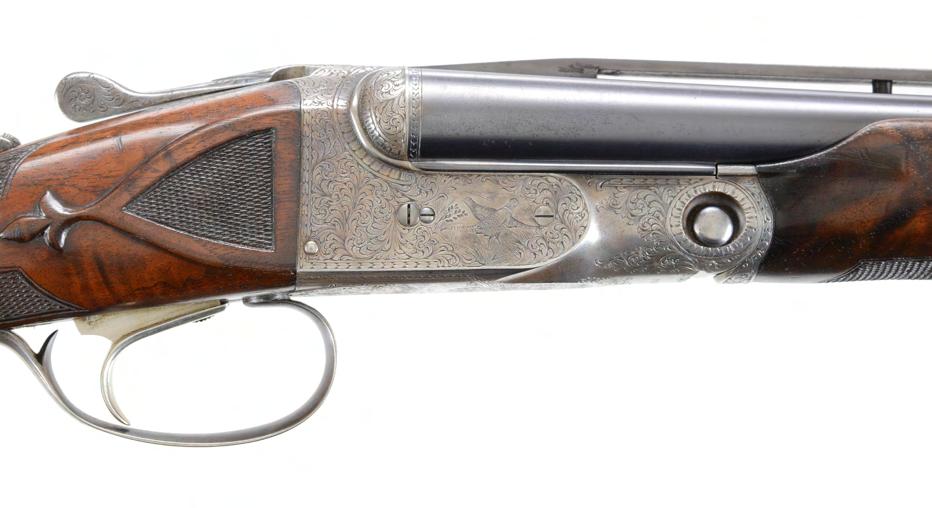
Outstanding Parker BHE Grade 28 gauge
Sold for $126,000

Fabulous Parker VHE 410 gauge skeet gun
Sold for $120,000
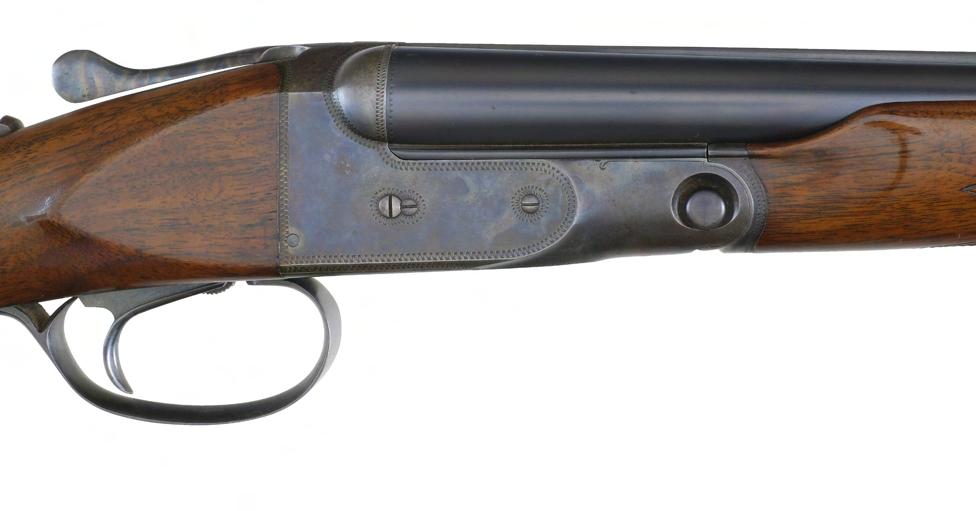
Investment quality
Parker VHE Grade 28 gauge
Sold for $108,000

Exceptional Parker VHE 410 gauge
Sold for $102,000
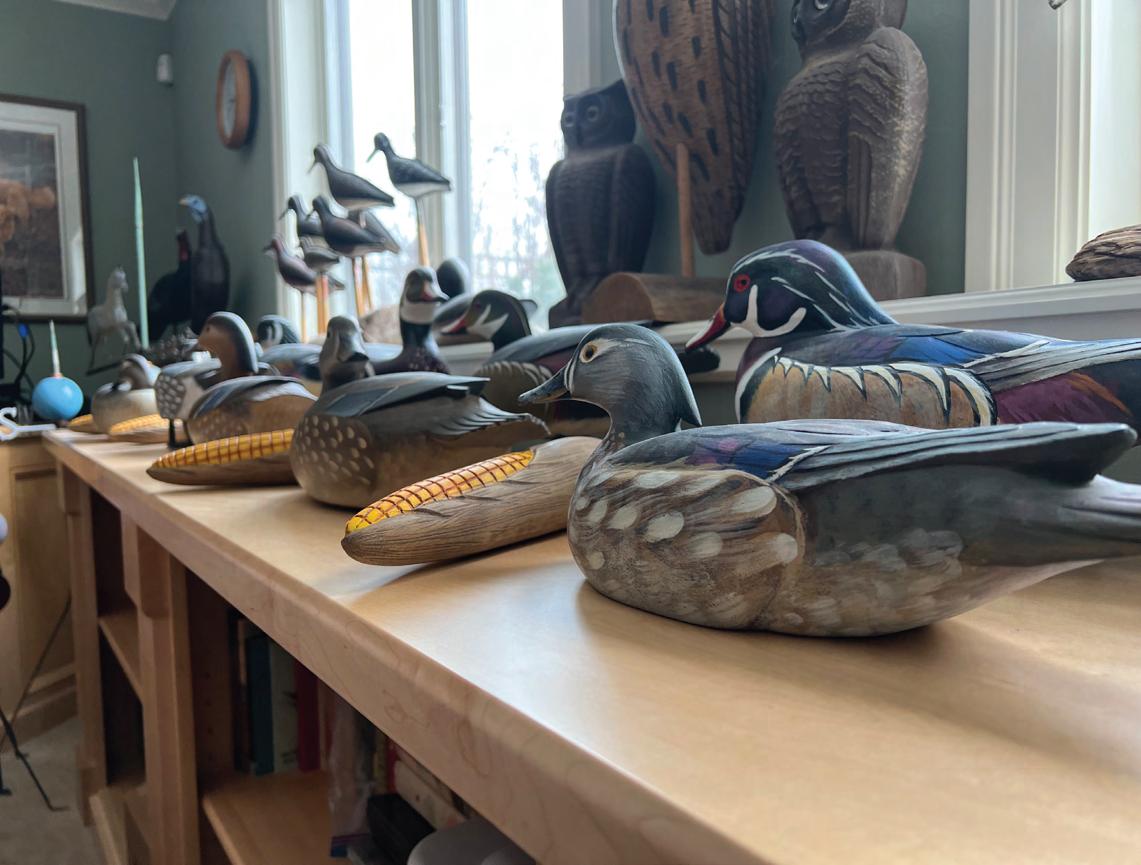
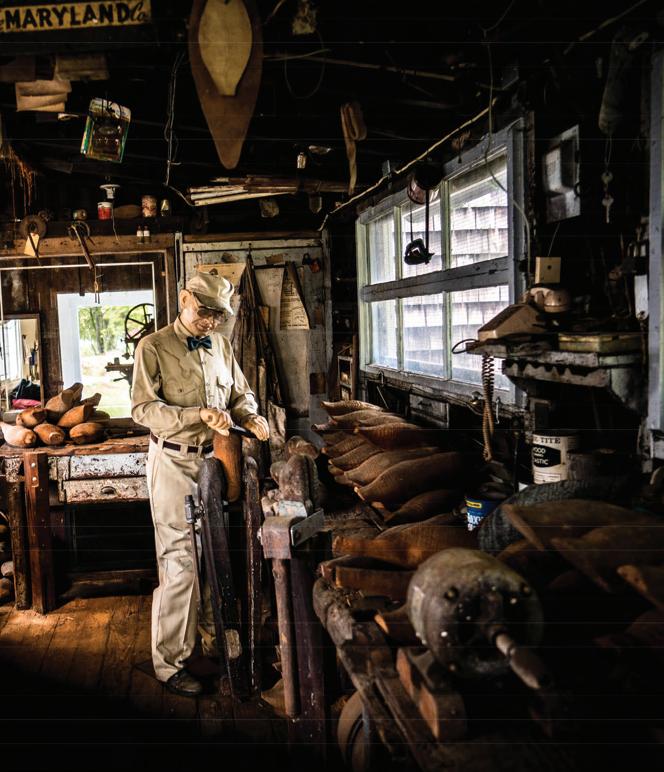
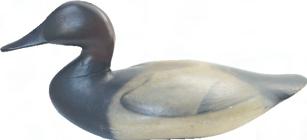



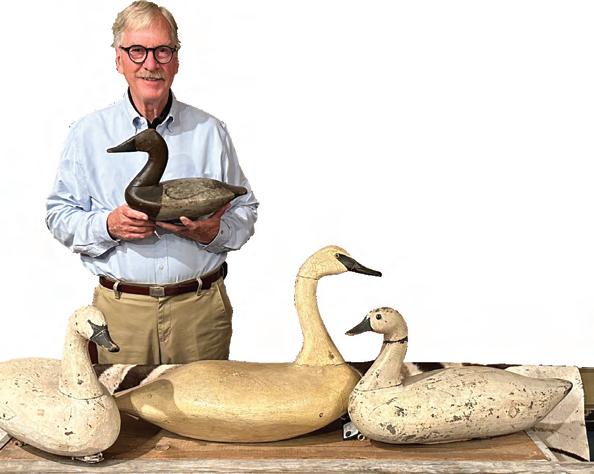











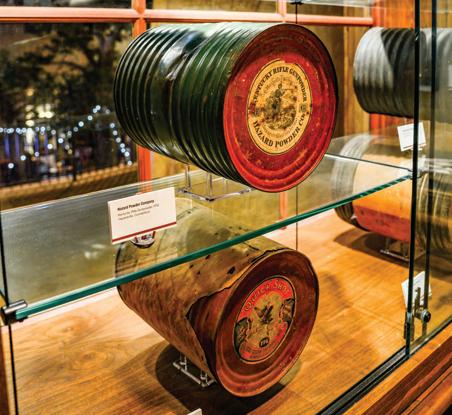








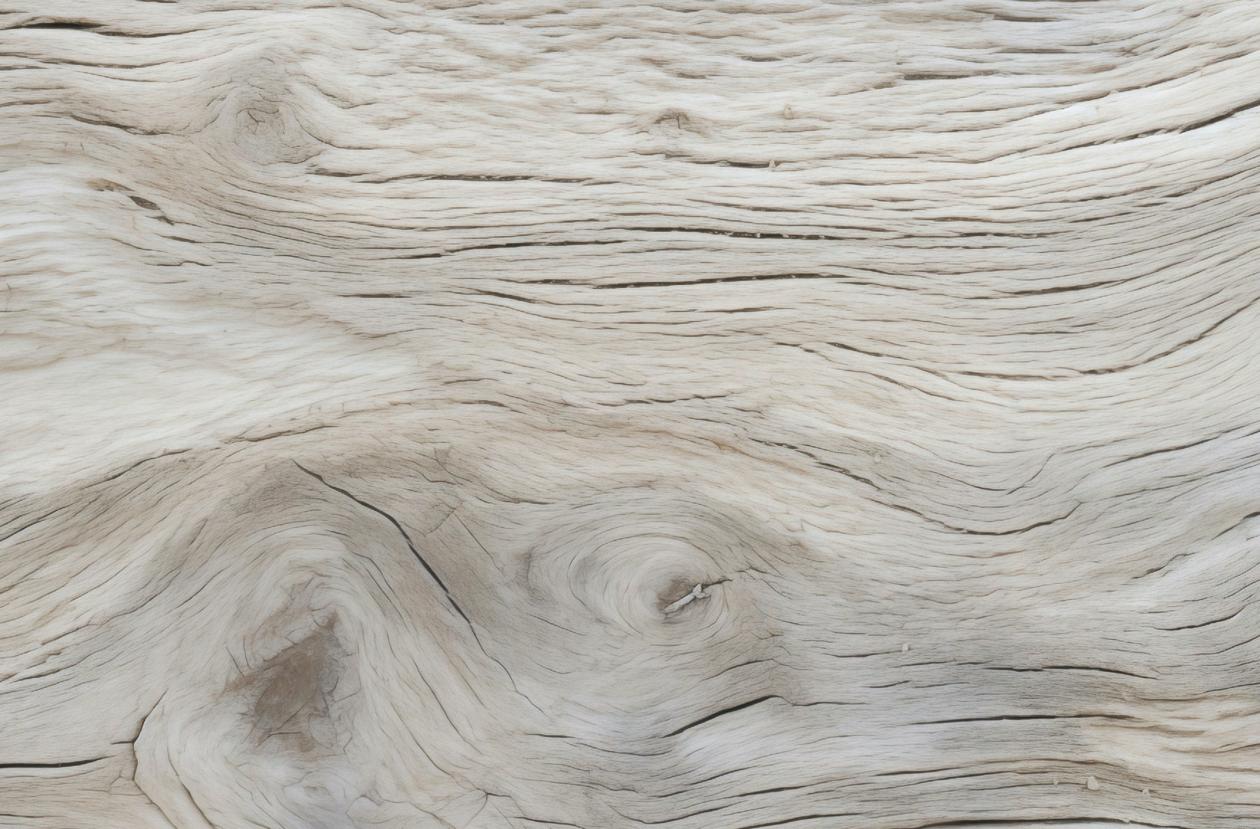







1. GUARANTEE ‑ We have made a concerted effort to accurately catalog and describe the property to be sold. The decoys and paintings have guaranteed condition reports. Should the need arise, the auctioneer reserves the right to make verbal corrections and provide additional information from the block at the time of the sale. Absentee bids will not be executed on items that are found to be other than described in the catalog. Since opinions can differ, particularly in the matter of condition, the auctioneer will be sole judge in the matter of refunds. If we fail to identify a flaw that has an impact on the value, you can return the decoy.
2. DURATION OF GUARANTEE ‑ Request for a refund for items purchased IN PERSON at the auction must be made within 3 days of the sale. If you bid absentee, by phone, or on the internet, it is your responsibility to examine the lot immediately upon receipt and notify us of any issues. The guarantee will end 5 days from the date of delivery. Therefore, all guarantees on items purchased will become null and void 10 calendar days from the date of shipment. IT IS VERY IMPORTANT TO NOTE THAT IF YOU PAY LATE, YOU WILL NOT BE ELIGIBLE FOR THE GUARANTEE. Payment must be postmarked no later than 30 days after the auction.
3. PROTESTED BIDS ‑ In the case of a disputed bid, the auctioneer is the sole determinant as to who the successful bidder is, and at his discretion, may reoffer and resell the article in dispute. If a dispute arises after the sale, the auctioneer’s sales records shall be conclusive as to who the purchaser was, and the purchase price.
4. BIDDING Bidding usually starts below the low estimate and advances in increments of approximately 10% of the open ing bid subject to the auctioneer’s discretion. The auctioneer reserves the right, at his sole discretion, to refuse any bids that he deems unreasonable. The minimum bid increment guideline is as follows:
$500 to $1000 $25 $10,000 to $20,000 $500 $100,000 and above $2,000 $1000 to $10,000 $100 $20,000 to $100,000 $1,000
5. ABSENTEE BIDS ‑ Phone or mail bids, at the discretion of the Auctioneer, will be accepted with a 20% deposit. In such case, the bookkeeper will execute such bids competitively. Absentee bids are executed by the bookkeeper on behalf of the bidder in accordance with the bid increment policy shown above. Please review the rules governing both absentee and phone bids in the back of the catalog.
6. TERMS ‑ All items are to be paid for in U.S. funds on the day of the auction. No items will be released until they are paid for. Those who have not established an account with us and wish to pay by check, must do so prior to the beginning of the auction, by presenting a current letter of reference from their bank, or by providing references, that are suitable to the Auctioneer. The Auctioneer reserves the right to hold merchandise purchased by personal check, until the check has cleared the bank. Phone and absentee bidders ‑ You will be notified one week after the auction of your bids/results.
A late charge will be accessed on all balances not paid, at the rate of 12% A.P.R. commencing 30 days after the auction. If any accounts become more than 60 days overdue, the consignor will be given the name of the buyer who is responsible for holding up their funds. Guyette & Deeter will not carry insurance on items that are not paid for within 35 days of the auction. Also, the auctioneer may retain and/or recover the deposit specified as liquidated damages. In addition, the property can be resold at public or private sale without further notice. Any defi ciency resulting from such resale shall be paid to the auctioneer by the defaulting buyer, together with all charges, fees, and expenses incurred by such resale, or the enforcement of the obligation hereunder. Buyer agrees to pay all charges and expenses incurred by reason of any breach of the Terms and Conditions of Sale, including without limitation, reasonable attorney fees.
7. PAYMENT FOR PURCHASES CAN BE MADE WITH CREDIT CARD (VISA, MasterCard, American Express, or Discover), CASH, CHECK, OR WIRE TRANSFER.
8. BUYERS PREMIUM The buyer’s premium, assessed on each selling lot, is 20% of the hammer price up to and includ ing $1,000,000, plus 10% on any amount in excess of $1,000,000. For payments made using a credit card, the buyer’s premium is 23% up to and including $1,000,000, plus 13% on any amount in excess of $1,000,000.
9. TAX ‑ THERE IS AN 8% SALES TAX IN ILLINOIS. TAX IS WAIVED IF BUYER PRESENTS A VALID RESALE CERTIFICATE FROM ANY STATE OR HAS PURCHASES SHIPPED OUTSIDE OF MARYLAND.
10. ACCEPTANCE OF CONDITIONS ‑ Bidding on any articles in this catalog indicates your acceptance of all the above items.
11. BIDDING AGENT RESPONSIBILITY ‑ If you are registering for someone or if you execute a bid for someone else under your number, you are responsible for the settlement of that account. You are also responsible for examining the decoy(s) for your client regarding the guarantee.
12. WITHDRAWAL ‑ We reserve the right to withdraw any property before the sale and shall have no liability whatsoever for such withdrawal.
13. TITLE ‑ Title passes upon the fall of the auctioneer’s hammer. It will then be the responsibility of the buyer to make full payment prior to removing the goods from the premises. Removal is at both the buyer’s risk and expense, and must be made at the conclusion of the sale, unless other arrangements are made with the Guyette & Deeter staff. Any lots we might make arrangements for moving or storing are solely at the risk of the owner, and any damage or loss occurring after the fall of the hammer becomes that of the buyer.
14. LEGAL DISPUTE ‑ Any legal disputes arising from this auction shall be settled in the court system of the State of Maine. UNIFORM COMMERCIAL CODE The Maine Uniform Commercial Code, Title II, Section 2328 applies to this auction.
15. Cases are not included with shotgun shell boxes. All dimensions are approximate and are not guaranteed. All calls are sold “As Is”.
1. Absentee bids are a service provided to our customers free of charge. Every effort is made to execute all absentee bids, however, in the event of an error or omission, or failure to properly execute absentee bids, the Auctioneer shall not be held liable.
2. All absentee bids must be accompanied by a 20% deposit, which will be refunded immediately after the auction if your bid is unsuccessful. If your bid is successful, the deposit will be applied to the purchase price and the balance due upon presentation of your bill. All absentee bidders are notified by mail, whether successful or unsuccessful.
3. Visa and Mastercard numbers can be given in place of a check deposit, if your bid is submitted by phone. Your card number will not be used to make payments for purchases, it is only used as collateral. Your card number will only be used to make payment for purchases if you default on payment.
4. To execute an absentee bid, fill out the enclosed form listing catalog number, description, and your top bid price (not including the 20% buyer’s premium). Send this together with your deposit as soon as possible. If your bids are sent seven days or less prior to the auction, you should call our office three days prior to the auction, to confirm that we have received your bids. If they have not been received at that point in time, we will take your bid over the phone. We cannot guarantee that bids received after the auction has started will be executed.
5. If two or more bids are received on the same item from different people, the bidding will open at the next logical raise above the second highest bid. If two absentee bids are received with the exact same amount, the first one received will take precedence.
6. All bids must be in even dollar amounts. Bids in fractions of dollars will be considered the next lower even dollar amount.
7. Bid increments: The bid increment policy, which also applies to both absentee and phone bidders, is listed under “CONDITIONS OF SALE” (item #4), in the front of the catalog.
8. Open bids, bids with no set top amount, or orders to just simply buy the lot, cannot be accepted. You must have a definite top limit before we can execute your bid. Alternatives to this are as follows:
a. To bid over the telephone. This can be done by simply sending a 20% deposit for what you wish to bid on the object. This will bind whatever bid amount you wish to bid over the telephone. (NOTE: There are only 8 phone lines into the auction room and phone bids will be handled on a first come, first serve basis.)
b. Some bidders concerned that a lot might just go for one bid above their top limit, leave a top bid plus one bid. This works as follows: the top bid submitted might be $1,000, but not wishing to lose the lot for simply $25 more, the party might bid $1,000 + 1 bid if they definitely don’t want to go over a certain price, they would indicate $1,000 +1 ($1,025) (NOTE: One possible problem that occasionally arises with absentee bids is when someone in the audience bids exactly the amount, which you specify is your limit. In such a case, we would not go one extra bid unless your bid sheet indicates “plus one” bid.).
9. If you are a successful bidder, a bill will be sent a few days after the auction. Purchasers should indicate their desired method of shipment, if such is necessary. There is a charge for shipping, labor, materials, and insurance. Please provide notice in writing if items are covered under your own insurance policy. Shipping is done on a first come, first serve basis, and can take up to 4 weeks Please note that a certified check, Visa, Mastercard, or any other form of guaranteed funds will expedite shipping.
10. For expensive oil paintings and delicate carvings, we need a written statement from the purchaser, assuming the responsibility of pursuing any claims, in the event of damage incurred during shipping. Valuable lots need to be sent 2nd day air UPS due to values. Under no circumstances will we be liable for damage to glass or frames, or fragile decoratives, regardless of cause.
11. TERMS Phone and absentee bidders You will be notified one week after the auction of your results. Payment is due upon receipt. Interest will be charged on all balances not paid within 30 days after the bill is sent at the rate of 12% APR. If any accounts become more than 60 days overdue, the consignor will be given the name of the buyer who is responsible for holding up their funds. If an account is 75 days overdue, the items may be returned to the consignor and overdue buyer will pay the buyers premium and commission from the sale, if they wish to participate in future Guyette and Deeter auctions.
12. Bidding on any article(s) indicates your acceptance of these terms above.
13. If you would like any additional information on any of the lots, please contact: Jon Deeter at (440) 610-1768, Zac Cote at (207) 321-8091, or Gary Guyette at (410) 745-0485.
If you have any questions concerning absentee bids, please call us.

OFFICE:
OFFICE:
PO Box 1170
PO Box 1170
St. Michaels, MD 21663
St. Michaels, MD 21663
410-745-0485
410-745-0485
Fax 410-745-0487
Fax 410-745-0487
decoys@guyetteanddeeter.com
michael@guyetteanddeeter.com
I desire to bid on the following items in the sale. The bids are to be executed by Guyette & Deeter, up to but not exceeding the amount(s) specified on the below bids. All bids will be executed and accepted subject to the Terms of Sale and Absentee Bids Procedure outlined in the catalog. (Please be sure that you understand our procedures before using this Absentee and Phone Bid Form.) Office will not be open until Wednesday after the auction.


